Fein ABS_18C: инструкция
Раздел: Электроинструменты
Тип:
Инструкция к Fein ABS_18C
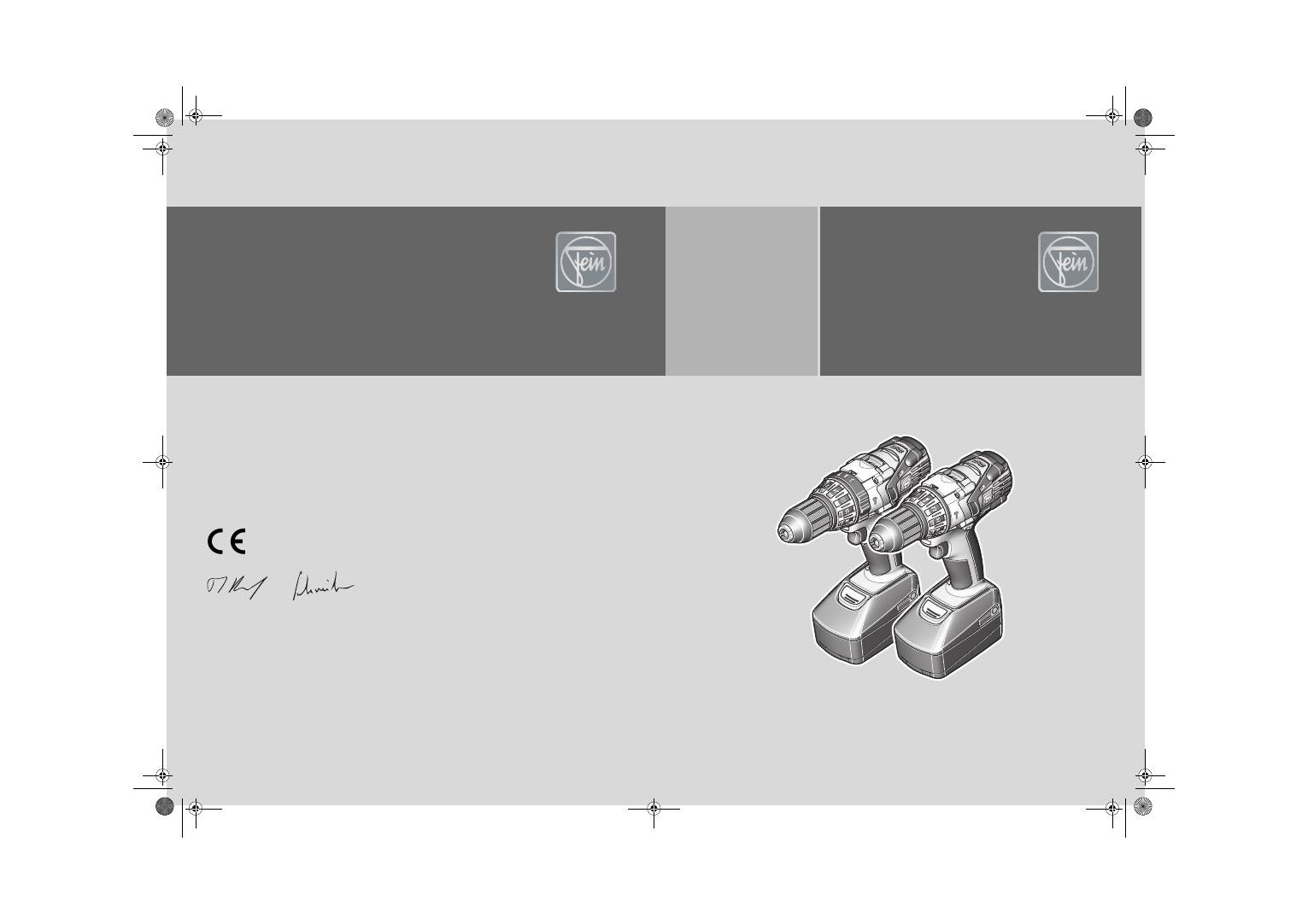
©
C.
& E
. FEIN
Gm
bH.
Pr
in
te
d i
n
Ger
m
an
y.
Abb
ild
u
n
gen
un
verb
in
d
lic
h.
T
ec
h
n
isc
h
e Änd
er
unge
n
vo
rb
eha
lt
en.
3 4
1
0
1
1
89 0
6
0
BY
20
1
3.
04 D
E
.
EN 60745, EN 55014
2011/65/EU, 2006/42/EG, 2004/108/EG
FEIN Service
C. & E. FEIN GmbH
Hans-Fein-Straße 81
D-73529 Schwäbisch Gmünd-Bargau
www.fein.com
ABS14
7 113 18 61
ABS14C
7 113 18 62
ASB14
7 104 05 61
ASB14C
7 104 05 62
ABS18
7 113 19 61
ABS18C
7 113 19 62
ASB18
7 104 06 61
ASB18C
7 104 06 62
Hammersdorf
Quality Manager
Dr. Schreiber
Manager of R&D department
OBJ_DOKU-0000002759-001.fm Page 1 Thursday, April 4, 2013 10:23 AM
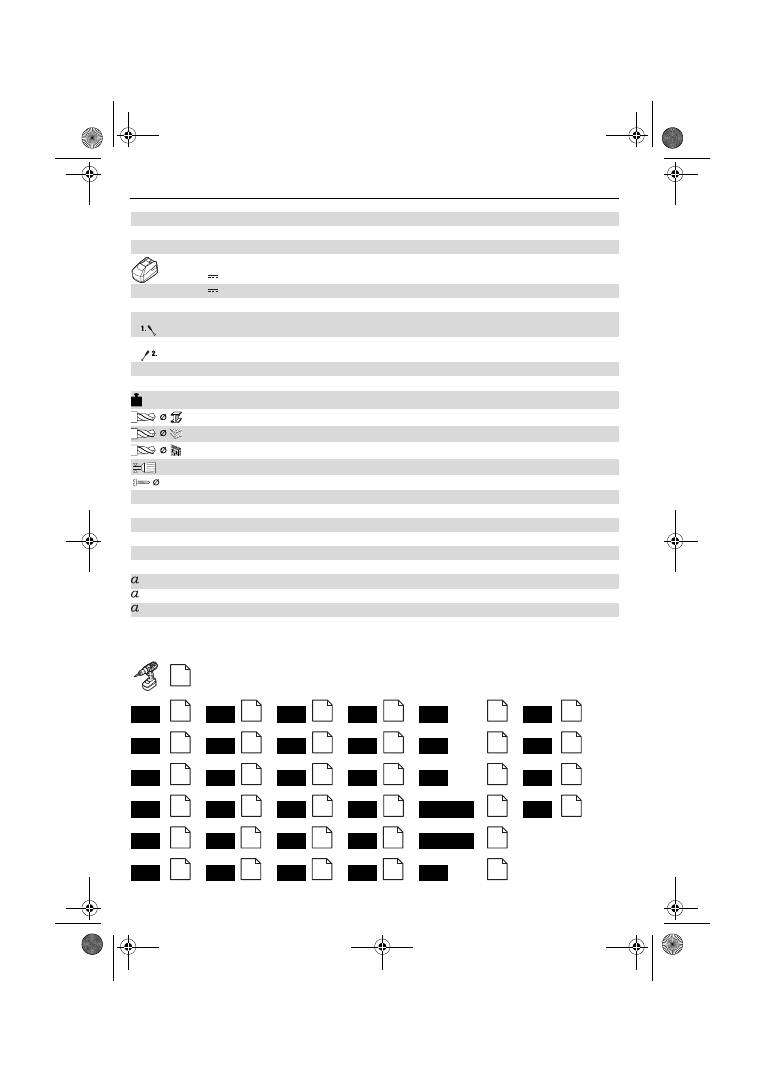
2
ABS14
ABS14C
ASB14
ASB14C
ABS18
ABS18C
ASB18
ASB18C
71131861
71040561
71131961
71040661
71131862
71040562
71131962
71040662
V
14,4
14,4
18
18
U
V
14,4
14,4
18
18
n
0
/min, min
-1
,
rpm, r/min
0 – 450
0 – 450
0 – 550
0 – 550
/min, min
-1
,
rpm, r/min
0 – 1600
0 – 1600
0 – 1600
0 – 1600
n
S
/min, min
-1
–
0 –29000
–
0 –29000
M...
Nm
30/55
27/50
30/55
27/50
35/60
32/55
35/60
32/55
kg
2,0
1,8
2,1
1,9
2,1
1,8
2,2
2,0
mm
13
13
13
13
mm
35
35
50
50
mm
–
13
–
14
mm
1,5 – 13
1,5 – 13
1,5 – 13
1,5 – 13
mm
8
8
8
8
L
pA
dB
80
85
76
87
K
pA
dB
3
3
3
3
L
wA
dB
91
96
87
98
K
wA
dB
3
3
3
3
L
pCpeak
dB
91
104
90
106
K
pCpeak
dB
3
3
3
3
h
m/s
2
0,5
0,5
0,6
0,6
h,D
m/s
2
1,5
1,5
1,8
1,8
h,ID
m/s
2
–
10,5
–
12,1
K
a
m/s
2
1,5
1,5
1,5
1,5
Fe
3
de
10
pt
34
tr
59
sl
83
et
109
th
133
en
14
el
38
hu
63
sr
87
lt
113
ja
138
fr
18
da
43
cs
67
hr
91
lv
117
hi
142
it
22
no
47
sk
71
ru
95
zh(CM)
121
ar
149
nl
26
sv
51
pl
75
uk
100
zh(CK)
125
es
30
fi
55
ro
79
bg
104
ko
129
OBJ_DOKU-0000002760-001.fm Page 2 Tuesday, April 16, 2013 9:27 AM
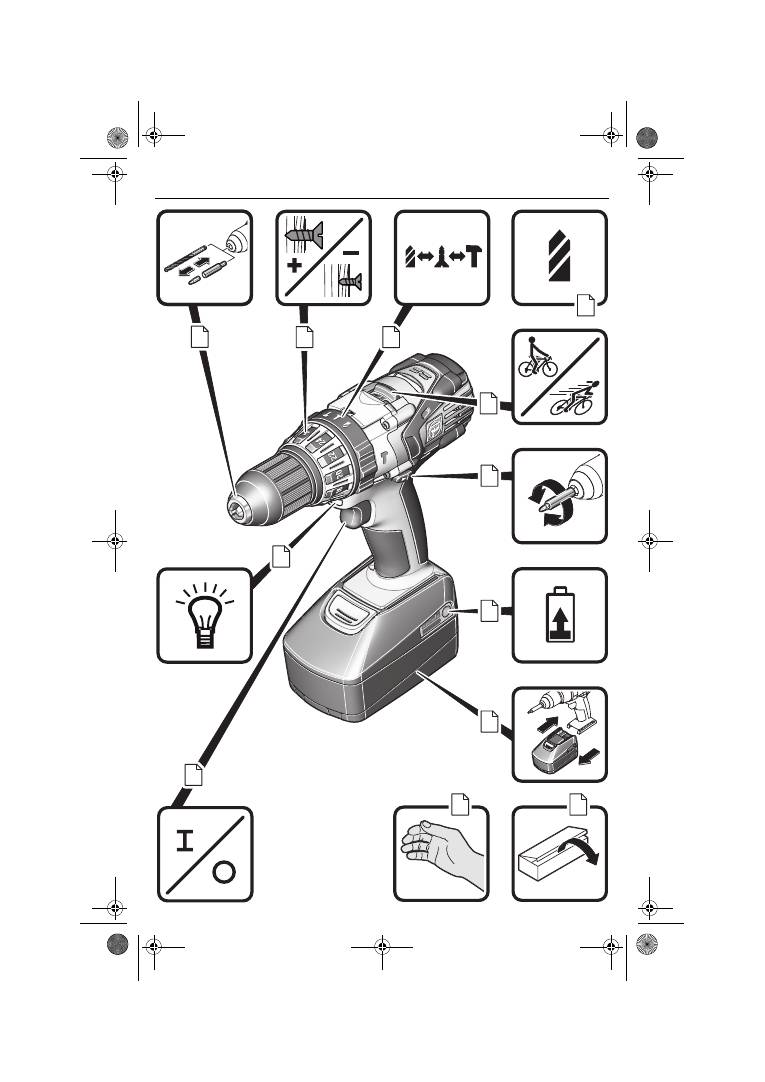
3
4
5
6
7
6
4
8
5
8
7
9
7
ASB14/18
ABS14/18
OBJ_BUCH-0000000105-001.book Page 3 Thursday, April 4, 2013 10:23 AM
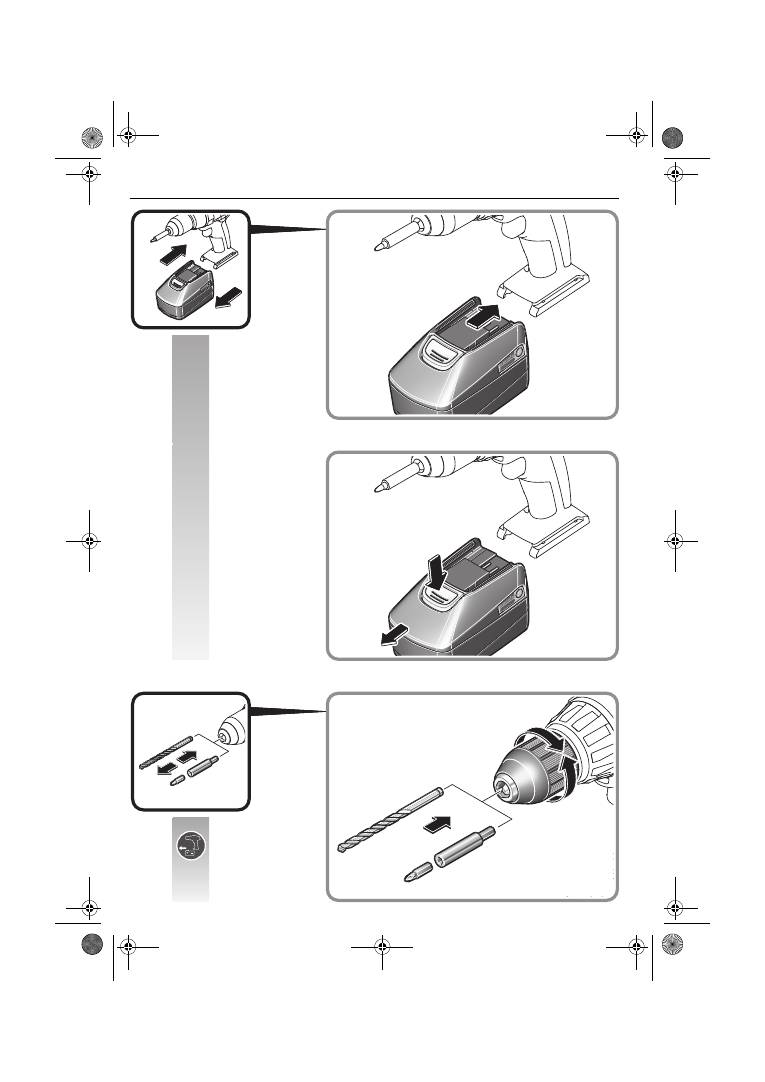
4
1.
3.
2.
1.
2.
OBJ_BUCH-0000000105-001.book Page 4 Thursday, April 4, 2013 10:23 AM
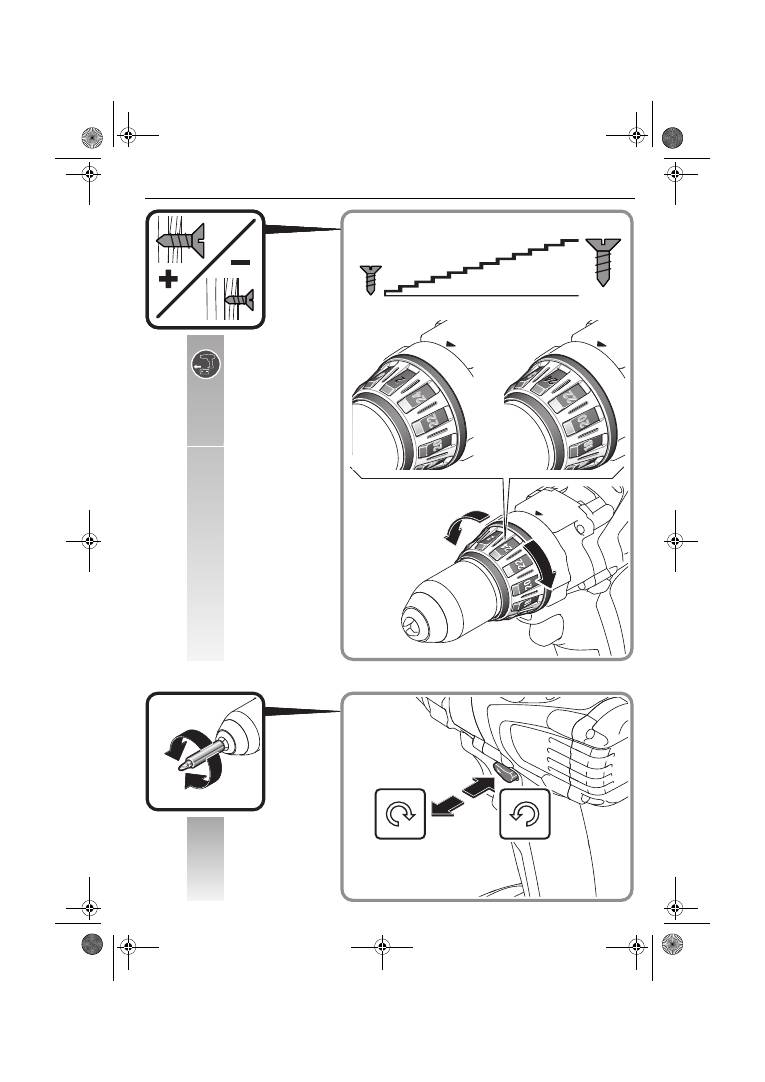
5
2
24
4
6
8
10 12
14 16
18 20
22
OBJ_BUCH-0000000105-001.book Page 5 Thursday, April 4, 2013 10:23 AM
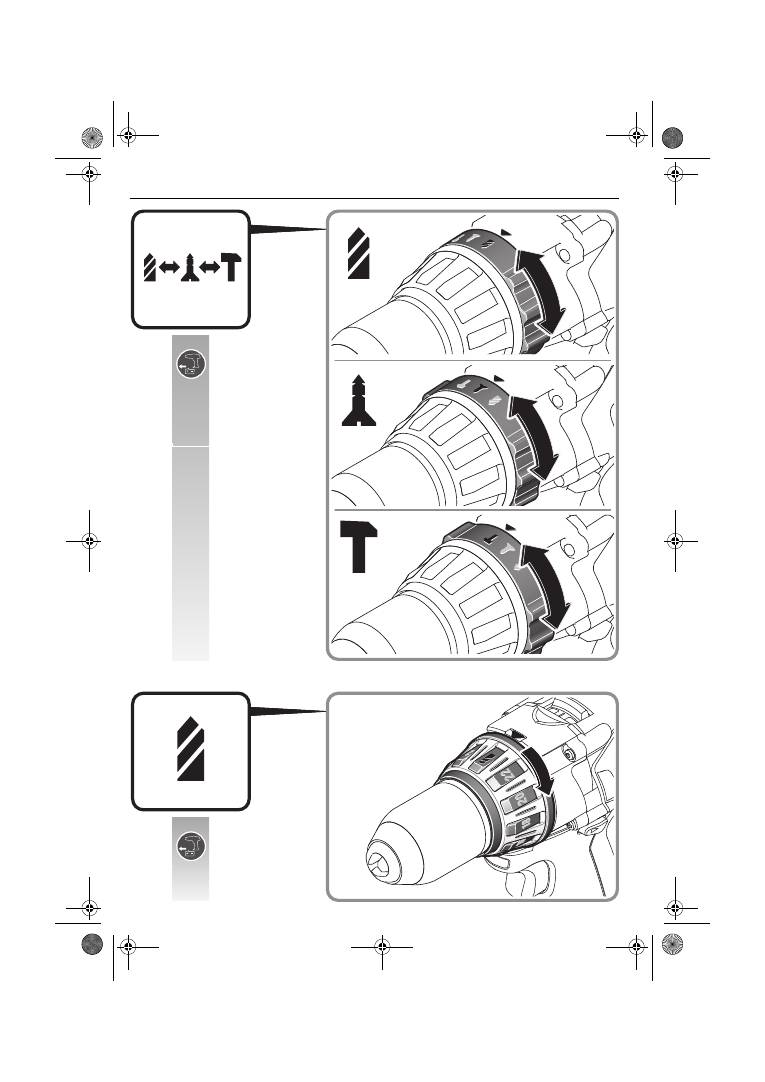
6
ASB14/18
ABS14/18
OBJ_BUCH-0000000105-001.book Page 6 Thursday, April 4, 2013 10:23 AM
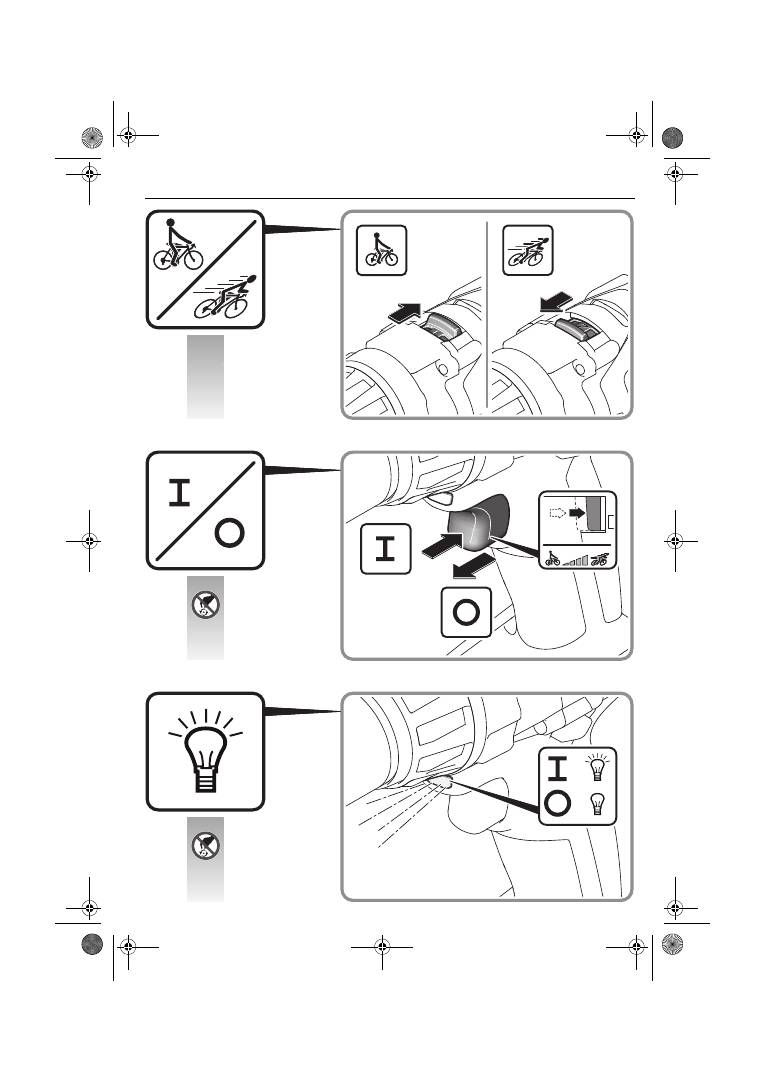
7
= =
1.
2.
OBJ_BUCH-0000000105-001.book Page 7 Thursday, April 4, 2013 10:23 AM
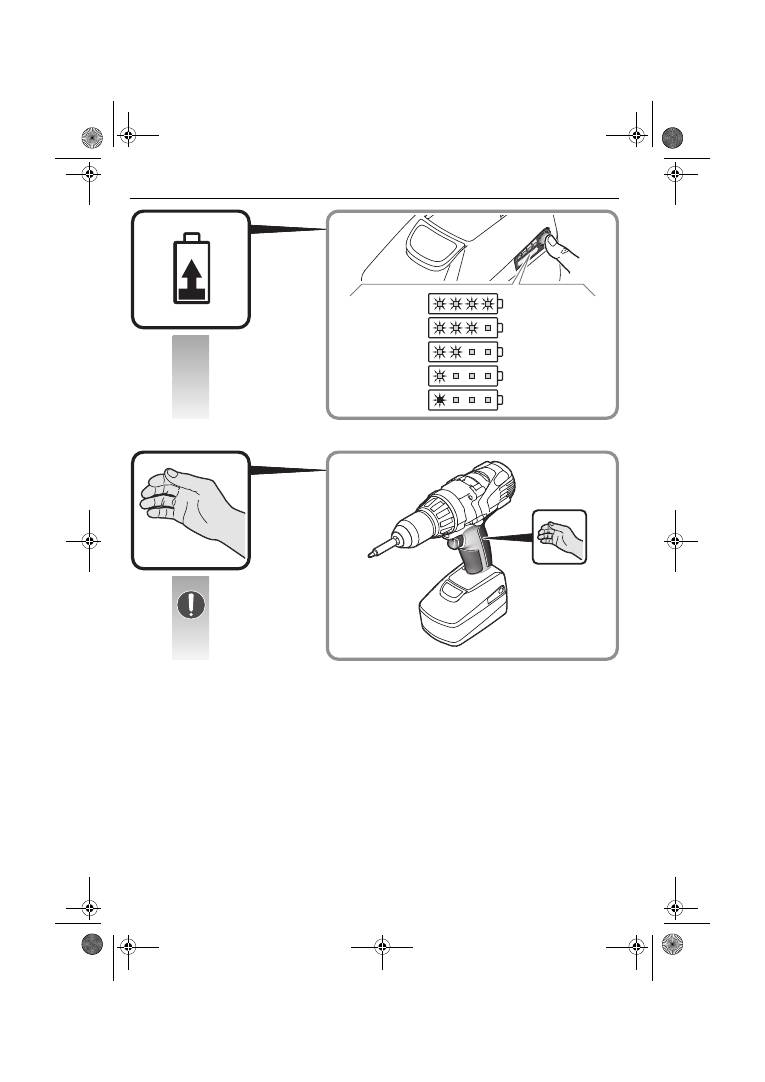
8
100 %
75 %
50 %
25 %
0 %
OBJ_BUCH-0000000105-001.book Page 8 Thursday, April 4, 2013 10:23 AM
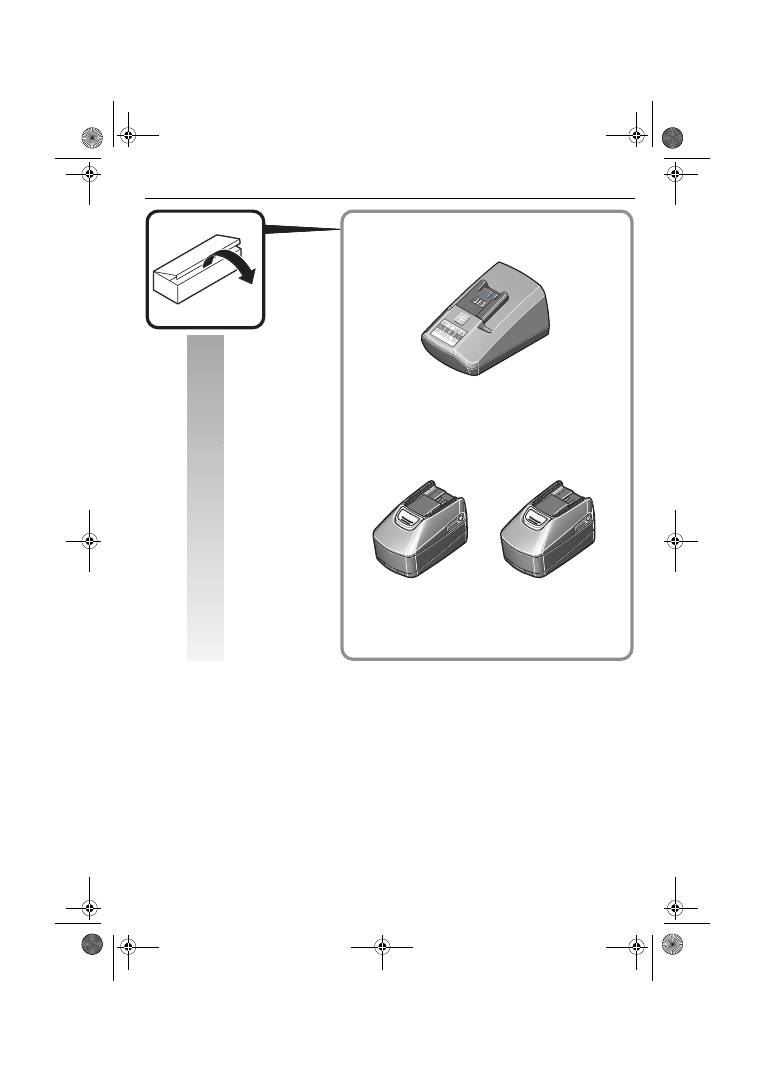
9
OBJ_BUCH-0000000105-001.book Page 9 Thursday, April 4, 2013 10:23 AM

10
de
de
Originalbetriebsanleitung.
Verwendete Symbole, Abkürzungen und Begriffe.
Symbol, Zeichen
Erklärung
Rotierende Teile des Elektrowerkzeugs nicht berühren.
Die beiliegenden Dokumente wie Betriebsanleitung und Allgemeine Sicherheitshinweise
unbedingt lesen.
Den Anweisungen im nebenstehenden Text oder Grafik folgen!
Vor diesem Arbeitsschritt den Akku aus dem Elektrowerkzeug entfernen. Sonst besteht
Verletzungsgefahr durch unbeabsichtigtes Anlaufen des Elektrowerkzeugs.
Beim Arbeiten Augenschutz benutzen.
Beim Arbeiten Gehörschutz benutzen.
Beim Arbeiten Handschutz benutzen.
Laden Sie keine beschädigten Akkus.
Setzen Sie den Akku nicht dem Feuer aus. Schützen Sie den Akku vor Hitze, z. B. auch
vor dauernder Sonneneinstrahlung.
Die Hinweise im nebenstehenden Text beachten!
Zusatzinformation.
Griffbereich
Bestätigt die Konformität des Elektrowerkzeugs mit den Richtlinien der Europäischen
Gemeinschaft.
Dieses Symbol bestätigt die Zertifizierung dieses Produkts in USA und Kanada.
Dieser Hinweis zeigt eine möglicherweise gefährliche Situation an, die zu ernsten Verlet-
zungen oder zum Tod führen kann.
Recycling-Zeichen: kennzeichnet wiederverwertbare Materialien
Ausgemusterte Elektrowerkzeuge und andere elektrotechnische und elektrische Erzeug-
nisse getrennt sammeln und einer umweltgerechten Wiederverwertung zuführen.
Akkutyp
1. Gang/2. Gang
Bohrdurchmesser Stahl
Bohrdurchmesser Holz
Bohrdurchmesser Stein
Bohrfutterspannbereich
Schraubendurchmesser
Gewicht entsprechend EPTA-Procedure 01/2003
Kleine Drehzahl
Große Drehzahl
WARNUNG
Fe
OBJ_BUCH-0000000105-001.book Page 10 Thursday, April 4, 2013 10:23 AM
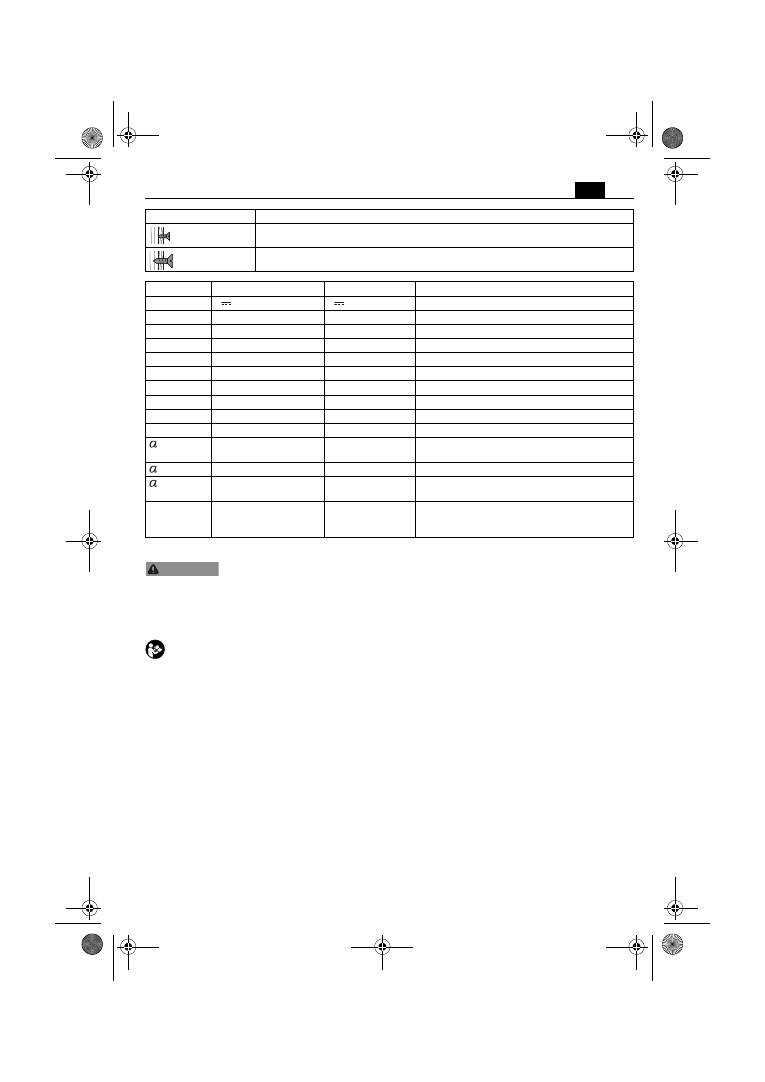
11
de
Zu Ihrer Sicherheit.
Lesen Sie alle Sicherheitshinweise
und Anweisungen.
Versäumnisse bei
der Einhaltung der Sicherheitshinweise und Anweisungen
können elektrischen Schlag, Brand und/oder schwere
Verletzungen verursachen.
Bewahren Sie alle Sicherheitshinweise und Anweisungen
für die Zukunft auf.
Verwenden Sie dieses Elektrowerkzeug nicht,
bevor Sie diese Betriebsanleitung sowie die beilie-
genden „Allgemeinen Sicherheitshinweise“ (Schrif-
tennummer 3 41 30 054 06 1) gründlich gelesen und
vollständig verstanden haben. Bewahren Sie die genann-
ten Unterlagen zum späteren Gebrauch auf und überrei-
chen Sie diese bei einer Weitergabe oder Veräußerung
des Elektrowerkzeugs.
Beachten Sie ebenso die einschlägigen nationalen
Arbeitsschutzbestimmungen.
Bestimmung des Elektrowerkzeugs:
ABS14, ABS18:
handgeführter Bohrschrauber zum Ein- und Ausdrehen
von Schrauben und Muttern und zum Bohren und
Schrauben in Metall, Holz, Kunststoff und Keramik sowie
zum Gewindeschneiden mit den von FEIN zugelassenen
Einsatzwerkzeugen und Zubehör ohne Wasserzufuhr in
wettergeschützter Umgebung.
ASB14, ASB18:
handgeführter Schlagbohrschrauber zum Ein- und Aus-
drehen von Schrauben und Muttern und zum Bohren
und Schrauben in Metall, Holz, Kunststoff und Keramik
sowie zum Gewindeschneiden und Schlagbohren in
Beton, Gestein und Ziegel mit den von FEIN zugelas-
senen Einsatzwerkzeugen und Zubehör ohne Wasserzu-
fuhr in wettergeschützter Umgebung.
Spezielle Sicherheitshinweise.
Halten Sie das Gerät an den isolierten Griffflächen, wenn
Sie Arbeiten ausführen, bei denen die Schraube verbor-
gene Stromleitungen treffen kann.
Der Kontakt der
Schraube mit einer spannungsführenden Leitung kann
auch metallene Geräteteile unter Spannung setzen und
zu einem elektrischen Schlag führen.
Achten Sie auf verdeckt liegende elektrische Leitungen, Gas-
und Wasserrohre.
Kontrollieren Sie vor Arbeitsbeginn den
Arbeitsbereich z. B. mit einem Metallortungsgerät.
Tragen Sie persönliche Schutzausrüstung. Verwenden Sie
je nach Anwendung Vollgesichtsschutz, Augenschutz oder
Schutzbrille. Soweit angemessen, tragen Sie Staub-
maske, Gehörschutz, Schutzhandschuhe oder Spezial-
schürze, die kleine Schleif- und Materialpartikel von
Ihnen fernhält.
Die Augen sollen vor herumfliegenden
Fremdkörpern geschützt werden, die bei verschiedenen
Anwendungen entstehen. Staub- oder Atemschutzmaske
müssen den bei der Anwendung entstehenden Staub fil-
tern. Wenn Sie lange lautem Lärm ausgesetzt sind, kön-
nen Sie einen Hörverlust erleiden.
Tragen Sie Gehörschutz beim Schlagbohren.
Die Einwir-
kung von Lärm kann Gehörverlust bewirken.
Sichern Sie das Werkstück.
Ein mit einer Spannvorrich-
tung gehaltenes Werkstück ist sicherer gehalten als in
Ihrer Hand.
Drehmoment verkleinern
Drehmoment vergrößern
Zeichen
Einheit international
Einheit national
Erklärung
U
V
V
elektrische Gleichspannung
f
Hz
Hz
Frequenz
n
0
/min, min
-1
, rpm, r/min
/min
Leerlaufdrehzahl (bei voll geladenem Akku)
n
S
/min, min
-1
/min
Schlagzahl
M...
Nm
Nm
Drehmoment (harter/weicher Schraubfall)
Ø
mm
mm
Durchmesser eines runden Teils
L
pA
dB
dB
Schalldruckpegel
L
wA
dB
dB
Schallleistungspegel
L
pCpeak
dB
dB
Spitzenschalldruckpegel
K...
Unsicherheit
m/s
2
m/s
2
Schwingungsemissionswert nach EN 60745
(Vektorsumme dreier Richtungen)
h,D
m/s
2
m/s
2
mittlerer Schwingungswert für Bohren in Metall
h,ID
m/s
2
m/s
2
mittlerer Schwingungswert für Schlagbohren in
Beton
m, s, kg, A, mm, V,
W, Hz, N, °C, dB,
min, m/s
2
m, s, kg, A, mm, V,
W, Hz, N, °C, dB,
min, m/s
2
Basis- und abgeleitete Einheiten aus dem Internati-
onalen Einheitensystem
SI
.
Symbol, Zeichen
Erklärung
WARNUNG
OBJ_BUCH-0000000105-001.book Page 11 Thursday, April 4, 2013 10:23 AM

12
de
Halten Sie das Elektrowerkzeug gut fest.
Es können kurz-
zeitig hohe Reaktionsmomente auftreten.
Bearbeiten Sie kein asbesthaltiges Material.
Asbest gilt
als krebserregend.
Es ist verboten Schilder und Zeichen auf das Elektrowerk-
zeug zu schrauben oder zu nieten.
Eine beschädigte Iso-
lierung bietet keinen Schutz gegen elektrischen Schlag.
Verwenden Sie Klebeschilder.
Verwenden Sie kein Zubehör, das nicht speziell vom Elek-
trowerkzeughersteller entwickelt oder freigegeben
wurde.
Sicherer Betrieb ist nicht alleine dadurch gegeben,
dass ein Zubehör auf Ihr Elektrowerkzeug passt.
Reinigen Sie regelmäßig die Lüftungsöffnungen des Elek-
trowerkzeugs mit nichtmetallischen Werkzeugen.
Das
Motorgebläse zieht Staub in das Gehäuse. Dies kann bei
übermäßiger Ansammlung von Metallstaub elektrische
Gefährdungen verursachen.
Schauen Sie niemals aus kleinen Entfernungen in das
Licht der Lampe des Elektrowerkzeugs. Richten Sie das
Lampenlicht niemals auf die Augen von anderen Per-
sonen, die sich in der Nähe befinden.
Die Strahlung, wel-
che vom Leuchtmittel erzeugt wird, kann für das Auge
schädlich sein.
Richten Sie das Elektrowerkzeug nicht gegen sich selbst,
andere Personen oder Tiere.
Es besteht Verletzungsge-
fahr durch scharfe oder heiße Einsatzwerkzeuge.
Verwendung und Behandlung des Akkus
(Akkublocks).
Um Gefährdungen wie Verbrennungen, Brand, Explosion,
Hautverletzungen und andere Verletzungen beim Umgang
mit den Akkus zu vermeiden, beachten Sie folgende Hin-
weise:
Akkus dürfen nicht zerlegt, geöffnet oder zerkleinert wer-
den. Setzen Sie die Akkus keinen mechanischen Stößen
aus.
Bei Beschädigung und unsachgemäßem Gebrauch
des Akkus können schädliche Dämpfe und Flüssigkeiten
austreten. Die Dämpfe können die Atemwege reizen.
Austretende Akkuflüssigkeit kann zu Hautreizungen-
oder Verbrennungen führen.
Falls aus dem beschädigten Akku ausgetretene Flüssig-
keit angrenzende Gegenstände benetzt hat, überprüfen
Sie die betroffenen Teile, reinigen Sie diese oder tau-
schen Sie sie gegebenenfalls aus.
Setzen Sie den Akku nicht der Hitze oder dem Feuer aus.
Lagern Sie den Akku nicht im direkten Sonnenlicht.
Entnehmen Sie den Akku erst dann aus seiner Original-
verpackung, wenn er verwendet werden soll.
Nehmen Sie den Akku vor Arbeiten am Elektrowerkzeug
aus dem Elektrowerkzeug.
Läuft das Elektrowerkzeug
unbeabsichtigt an, besteht Verletzungsgefahr.
Nehmen Sie den Akku nur bei ausgeschaltetem Elek-
trowerkzeug ab.
Halten Sie Akkus von Kindern fern.
Halten Sie den Akku sauber und geschützt vor Feuchtig-
keit und Wasser.
Reinigen Sie die verschmutzten
Anschlüsse des Akkus und des Elektrowerkzeugs mit
einem trockenen, sauberen Tuch.
Verwenden Sie nur intakte original FEIN-Akkus, die für Ihr
Elektrowerkzeug bestimmt sind.
Beim Arbeiten mit und
Laden von falschen, beschädigten, reparierten oder auf-
gearbeiteten Akkus, Nachahmungen und Fremdfabri-
katen besteht Brandgefahr und/oder Explosionsgefahr.
Befolgen Sie die Sicherheitshinweise in der Betriebsanlei-
tung des Akku-Ladegeräts.
Hand-Arm-Vibrationen
Der in diesen Anweisungen angegebene Schwingungspe-
gel ist entsprechend einem in EN 60745 genormten
Messverfahren gemessen worden und kann für den Ver-
gleich von Elektrowerkzeugen miteinander verwendet
werden. Er eignet sich auch für eine vorläufige Einschät-
zung der Schwingungsbelastung.
Der angegebene Schwingungspegel repräsentiert die
hauptsächlichen Anwendungen des Elektrowerkzeugs.
Wenn allerdings das Elektrowerkzeug für andere
Anwendungen, mit abweichenden Einsatzwerkzeugen
oder ungenügender Wartung eingesetzt wird, kann der
Schwingungspegel abweichen. Dies kann die Schwin-
gungsbelastung über den gesamten Arbeitszeitraum
deutlich erhöhen.
Für eine genaue Abschätzung der Schwingungsbelastung
sollten auch die Zeiten berücksichtigt werden, in denen
das Gerät abgeschaltet ist oder zwar läuft, aber nicht
tatsächlich im Einsatz ist. Dies kann die Schwingungs-
belastung über den gesamten Arbeitszeitraum deutlich
reduzieren.
Legen Sie zusätzliche Sicherheitsmaßnahmen zum Schutz
des Bedieners vor der Wirkung von Schwingungen fest
wie zum Beispiel: Wartung von Elektrowerkzeug und
Einsatzwerkzeugen, Warmhalten der Hände, Organisa-
tion der Arbeitsabläufe.
Umgang mit gefährdenden Stäuben
Bei Werkstoff abtragenden Arbeitsvorgängen mit diesem
Werkzeug entstehen Stäube, die gefährlich sein können.
Berühren oder Einatmen von einigen Stäuben z. B. von
Asbest und asbesthaltigen Materialien, bleihaltigem
Anstrich, Metall, einigen Holzarten, Mineralien, Silikat-
partikeln von gesteinshaltigen Werkstoffen, Farblösemit-
teln, Holzschutzmitteln, Antifouling für Wasserfahrzeuge
kann bei Personen allergische Reaktionen und/oder
Atemwegserkrankungen, Krebs, Fortpflanzungsschäden
auslösen. Das Risiko durch das Einatmen von Stäuben
hängt von der Exposition ab. Verwenden Sie eine auf den
entstehenden Staub abgestimmte Absaugung sowie per-
sönliche Schutzausrüstungen und sorgen Sie für eine gute
Belüftung des Arbeitsplatzes. Überlassen Sie das Bearbei-
ten von asbesthaltigen Material nur den Fachleuten.
Holzstaub und Leichtmetallstaub, heiße Mischungen aus
Schleifstaub und chemischen Stoffen können sich unter
ungünstigen Bedingungen selbst entzünden oder eine
Explosion verursachen. Vermeiden Sie Funkenflug in
Richtung Staubbehälter sowie Überhitzung des Elek-
trowerkzeugs und des Schleifguts, leeren Sie rechtzeitig
den Staubbehälter, beachten Sie die Bearbeitungshinweise
des Werkstoffherstellers sowie die in Ihrem Land gültigen
Vorschriften für die zu bearbeitenden Materialien.
OBJ_BUCH-0000000105-001.book Page 12 Thursday, April 4, 2013 10:23 AM
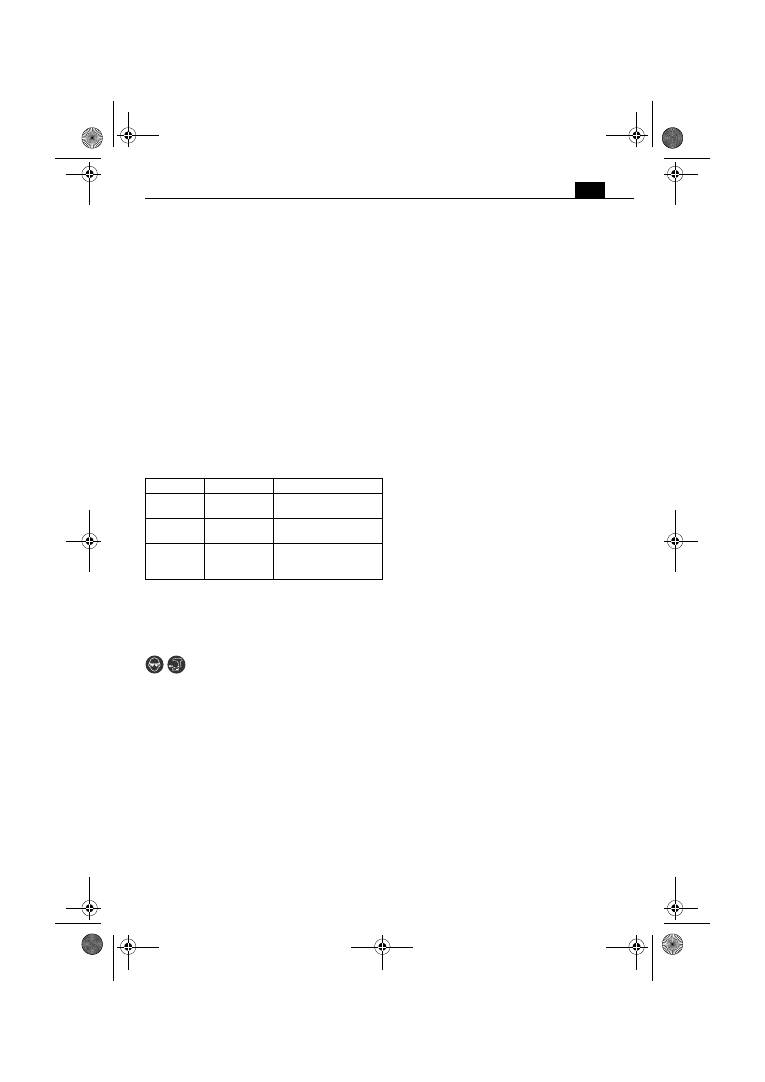
13
de
Bedienungshinweise.
Betätigen Sie den Drehrichtungsumschalter und den
Gangwahlschalter nur bei Stillstand des Motors.
Schieben Sie den Gangwahlschalter bzw. drehen Sie den
Betriebsartenwahlschalter (ASB14/18) immer bis zum
Anschlag. Das Elektrowerkzeug kann sonst beschädigt
werden.
Bei Überlastung schaltet das Elektrowerkzeug ab.
Bringen Sie den Drehrichtungsumschalter in Mittelstel-
lung, um eine unbeabsichtigte Inbetriebnahme, z. B. beim
Transport, zu vermeiden.
Drehmoment einstellen
Die Werkseinstellung entspricht dem Bereich für
kleinere bis mittelgroße Schrauben.
Das Anzugsdrehmoment ist auch von der Kraft abhängig,
mit der das Elektrowerkzeug gegen die Schraube
gedrückt wird.
Umgang mit dem Akku.
Betreiben und laden Sie den Akku nur im Akku-Betriebs-
temperaturbereich von 0 °C – 45 °C (32 °F – 113 °F). Die
Akku-Temperatur muss am Anfang des Ladevorgangs im
Akku-Betriebstemperaturbereich sein.
Der echte prozentuale Ladezustand des Akkus wird nur
bei gestopptem Motor des Elektrowerkzeugs angezeigt.
Bei einer bevorstehenden Akku-Tiefentladung stoppt die
Elektronik automatisch den Motor.
Instandhaltung und Kundendienst.
Bei extremen Einsatzbedingungen kann sich
bei der Bearbeitung von Metallen leitfähiger
Staub im Innern des Elektrowerkzeugs abset-
zen. Blasen Sie häufig den Innenraum des Elektrowerk-
zeugs durch die Lüftungsschlitze mit trockener und
ölfreier Druckluft aus.
Die aktuelle Ersatzteilliste dieses Elektrowerkzeuges fin-
den Sie im Internet unter www.fein.com.
Folgende Teile können Sie bei Bedarf selbst austauschen:
Einsatzwerkzeuge, Akku
Gewährleistung und Garantie.
Die Gewährleistung auf das Erzeugnis gilt gemäß den
gesetzlichen Regelungen im Lande des Inverkehrbrin-
gens. Darüber hinaus leistet FEIN Garantie entsprechend
der FEIN-Hersteller-Garantieerklärung.
Im Lieferumfang Ihres Elektrowerkzeugs kann auch nur
ein Teil des in dieser Betriebsanleitung beschriebenen
oder abgebildeten Zubehörs enthalten sein.
Konformitätserklärung.
Die Firma FEIN erklärt in alleiniger Verantwortung, dass
dieses Produkt den auf der letzten Seite dieser Betriebs-
anleitung angegebenen einschlägigen Bestimmungen ent-
spricht.
Technische Unterlagen bei: C. & E. FEIN GmbH,
C-DB_IA, D-73529 Schwäbisch Gmünd
Umweltschutz, Entsorgung.
Verpackungen, ausgemusterte Elektrowerkzeuge und
Zubehör einer umweltgerechten Wiederverwertung
zuführen.
Akkus nur im entladenen Zustand einer geordneten Ent-
sorgung zuführen.
Bei nicht vollständig entladenen Akkus zur Vorsorge
gegen Kurzschlüsse den Steckverbinder mit Klebestrei-
fen isolieren.
LED-Anzeige Bedeutung
Aktion
1 – 4 grüne
LED
prozentualer
Ladezustand
Betrieb
rotes
Dauerlicht
Akku ist fast
leer
Akku aufladen
rotes
Blinklicht
Akku ist nicht
betriebsbereit
Akku in Akku-Betriebs-
temperaturbereich brin-
gen, danach aufladen
OBJ_BUCH-0000000105-001.book Page 13 Thursday, April 4, 2013 10:23 AM
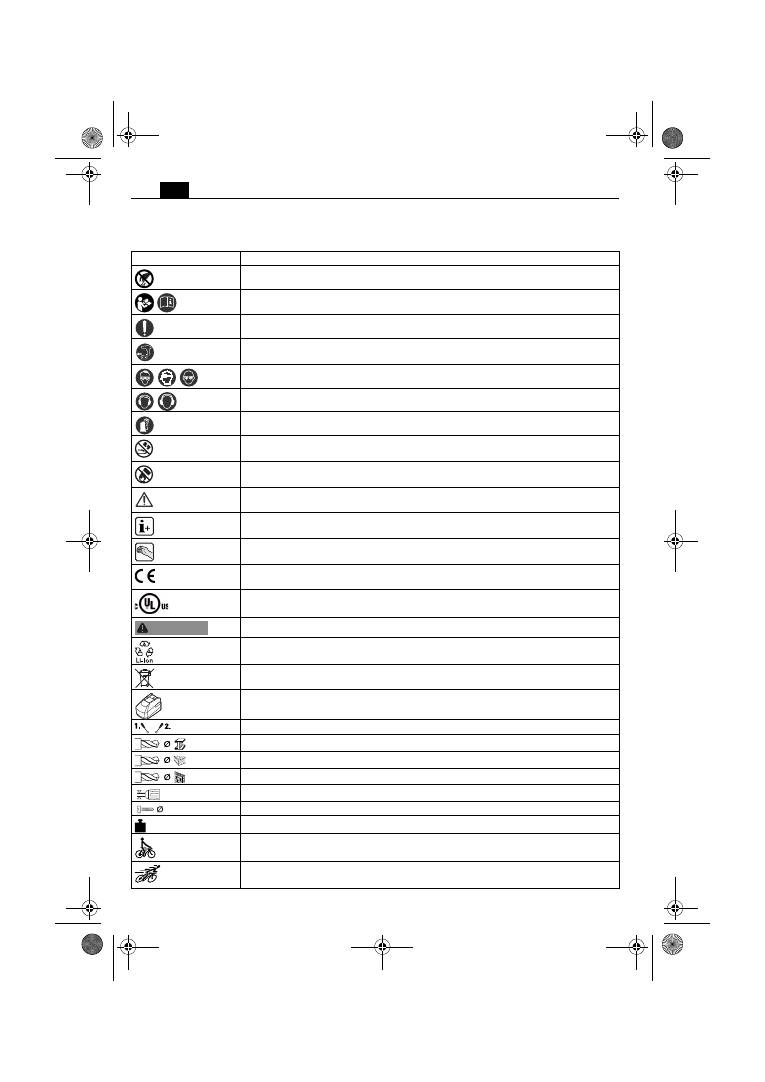
14
en
en
Original Instructions.
Symbols, abbreviations and terms used.
Symbol, character
Explanation
Do not touch the rotating parts of the power tool.
Make sure to read the enclosed documents such as the Instruction Manual and the General
Safety Instructions.
Observe the instructions in the text or graphic opposite!
Before commencing this working step, remove the battery from the power tool. Other-
wise there may be danger of injury caused by unintentional starting of the power tool.
Use eye protection during operation.
Use ear protection during operation.
Use protective gloves during operation.
Do not charge damaged batteries.
Keep the battery away from fire. Protect the battery against heat, e. g. against continuous
intense sunlight.
Observe the information in the adjacent text!
Additional information.
Gripping surface
Confirms the conformity of the power tool with the directives of the European Commu-
nity.
This symbol confirms the certification of this product for the USA and Canada.
This sign indicates a possible dangerous situation that could cause severe or fatal injury.
Recycling symbol: designates recyclable materials
Worn out power tools and other electrotechnical and electrical products should be
sorted separately for environmental-friendly recycling.
Battery type
1st gear/2nd gear
Drilling diameter, steel
Drilling diameter, wood
Drilling diameter, stone
Chuck clamping range
Screw diameter
Weight according to EPTA-Procedure 01/2003
Low speed
High speed
WARNING
Fe
OBJ_BUCH-0000000105-001.book Page 14 Thursday, April 4, 2013 10:23 AM
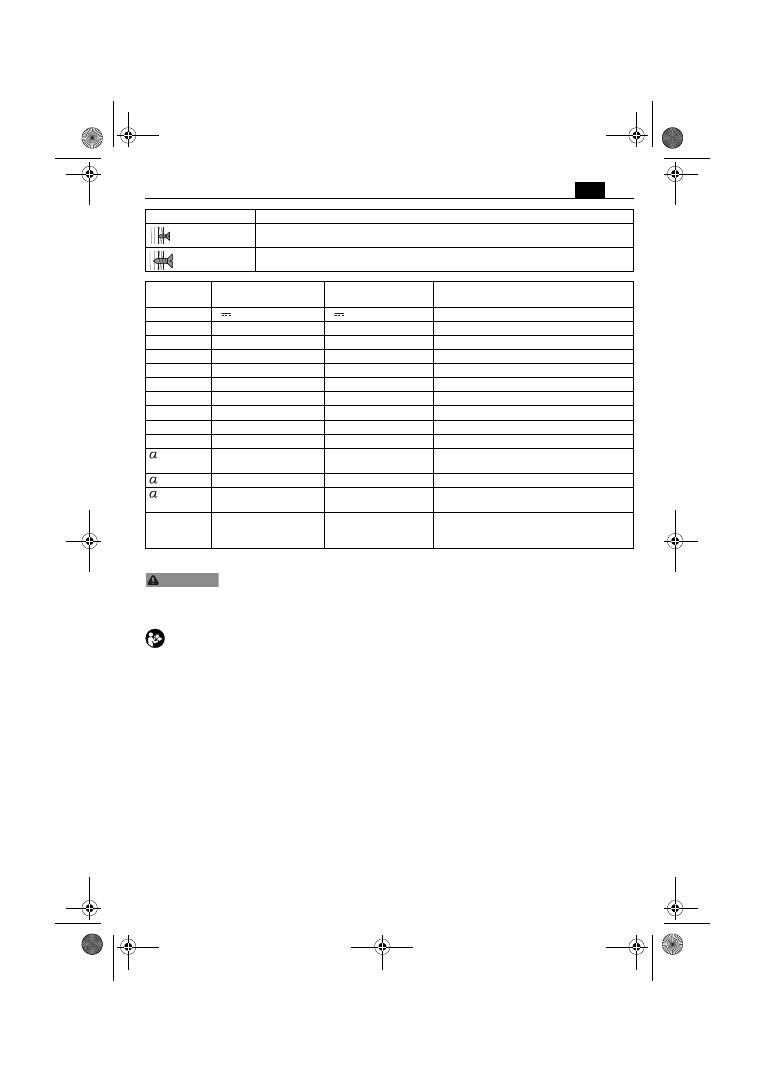
15
en
For your safety.
Read all safety warnings and all
instructions.
Failure to follow the
warnings and instructions may result in electric shock,
fire and/or serious injury.
Save all warnings and instructions for future reference.
Do not use this power tool before you have thor-
oughly read and completely understood this
Instruction Manual and the enclosed “General
Safety Instructions” (document number
3 41 30 054 06 1). The documents mentioned should be
kept for later use and enclosed with the power tool,
should it be passed on or sold.
Please also observe the relevant national industrial safety
regulations.
Intended use of the power tool:
ABS14, ABS18:
Hand-held cordless drill/driver for screwing in and
unscrewing screws and nuts, and for drilling and screw-
driving in metal, wood, plastic, ceramics, as well as for
tapping in weather-protected environments without
water supply using the application tools and accessories
recommended by FEIN.
ASB14, ASB18:
Hand-held cordless hammer drill for screwing in and
unscrewing screws and nuts, and for drilling and screw-
driving in metal, wood, plastic, ceramics, as well as for
tapping and impact drilling in concrete, stone and bricks
in weather-protected environments without water sup-
ply using the application tools and accessories recom-
mended by FEIN.
Special safety instructions.
Hold power tool by insulated gripping surfaces, when
performing an operation where the fastener may contact
hidden wiring.
Fasteners contacting a “live” wire may
make exposed metal parts of the power tool “live” and
could give the operator an electric shock.
Beware of any concealed electric cables, gas or water
conduits.
Check the working area before commencing
work, e.g. with a metal detector.
Wear personal protective equipment. Depending on appli-
cation, use face shield, safety goggles or safety glasses.
Where appropriate, wear dust mask, hearing protectors,
gloves and workshop apron capable of stopping small
abrasive or workpiece fragments.
The eye protection
must be capable of stopping flying debris generated by
various operations. The dust mask or respirator must be
capable of filtrating particles generated by your opera-
tion. Prolonged exposure to high intensity noise may
cause hearing loss.
Wear ear protectors when impact drilling.
Exposure to
noise can cause hearing loss.
Secure the work piece firmly.
A work piece that is
gripped tightly in a clamping device or vice, is more
secure than if held by hand.
Hold the power tool firmly.
High reaction torque can
briefly occur.
Reduce torque
Increase torque
Character
Unit of measurement,
international
Unit of measurement,
national
Explanation
U
V
V
DC voltage
f
Hz
Hz
Frequency
n
0
/min, min
-1
, rpm, r/min
rpm
No-load speed (with fully charged battery)
n
S
/min, min
-1
/min
Impact rate
M...
Nm
Nm
Torque (hard/soft screwdriving application)
Ø
mm
mm
Diameter of a round part
L
pA
dB
dB
Sound pressure level
L
wA
dB
dB
Sound power level
L
pCpeak
dB
dB
Peak sound pressure level
K...
Uncertainty
m/s
2
m/s
2
Vibrational emission value according to
EN 60745 (vector sum of three directions)
h,D
m/s
2
m/s
2
Mean vibrational value for drilling in metal
h,ID
m/s
2
m/s
2
Mean vibrational value for impact drilling in
concrete
m, s, kg, A, mm, V,
W, Hz, N, °C, dB,
min, m/s
2
m, s, kg, A, mm, V,
W, Hz, N, °C, dB,
min, m/s
2
Basic and derived units of measurement from
the international system of units
SI
.
Symbol, character
Explanation
WARNING
OBJ_BUCH-0000000105-001.book Page 15 Thursday, April 4, 2013 10:23 AM

16
en
Do not machine any material containing asbestos.
Asbes-
tos is cancerogenic.
Do not rivet or screw any name-plates or signs onto the
power tool.
If the insulation is damaged, protection
against an electric shock will be ineffective. Adhesive
labels are recommended.
Do not use accessories which are not specifically
designed and recommended by the power tool manufac-
turer.
Safe operation is not ensured merely because an
accessory fits your power tool.
Clean the ventilation openings on the power tool at regu-
lar intervals using non-metal tools.
The blower of the
motor draws dust into the housing. An excessive accu-
mulation of metallic dust can cause an electrical hazard.
Never look or stare into the light of the power tool’s lamp
from a short distance. Never point the light of the lamp
into the eyes of other persons in close vicinity.
The radi-
ation produced by the lamp can be harmful for the eye.
Do not direct the power tool against yourself, other per-
sons or animals.
Danger of injury from sharp or hot
application tools.
Use and handling of the battery (battery pack).
To avoid hazardous situations such as burns, fire, explo-
sion, skin injuries, and other injuries when handling the
battery, observe the following instructions:
Batteries must not be disassembled, opened or reduced
in size. Do not subject batteries to mechanical impact or
shock.
Hazardous vapours and fluid can escape in case of
damage and improper use of the battery. The vapours can
irritate the respiratory system. Liquid ejected from the
battery may cause skin irritations or burns.
When battery fluid from a damaged battery has come into
contact with objects close by, check the respective com-
ponents, clean them or replace them as required.
Keep the battery away from heat and fire. Do not store the
battery in direct sunlight.
Do not remove the battery from its original packaging
until it is going to be used.
Before any work on the machine itself, remove the bat-
tery from the power tool.
If the power tool accidentally
starts, there is danger of injury.
Remove the battery only when the power tool is switched
off.
Keep the battery away from children.
Keep the battery clean and protect it against moisture
and water.
Clean contaminated battery terminals and
power tool connections with a dry, clean cloth.
Use only intact original FEIN batteries that are intended
for your power tool.
When working with and charging
incorrect, damaged, repaired or reconditioned batteries,
imitations or other brands, there is danger of fire and/or
explosion.
Follow the safety warnings in the operating instructions
of the battery charger.
Hand/arm vibrations
The vibration emission level given in this information
sheet has been measured in accordance with a standard-
ised test given in EN 60745 and may be used to compare
one tool with another. It may be used for a preliminary
assessment of exposure.
The declared vibration emission level represents the
main applications of the tool. However, if the tool is used
for different applications, with different accessories or
poorly maintained, the vibration emission may differ.
This may significantly increase the exposure level over
the total working period.
An estimation of the level of exposure to vibration
should also take into account the times when the tool is
switched off or when it is running but not actually doing
the job. This may significantly reduce the exposure level
over the total working period.
Identify additional safety measures to protect the opera-
tor from the effects of vibration such as: maintain the tool
and the accessories, keep the hands warm, organisation
of work patterns.
Handling hazardous dusts
For work procedures with this power tool where mate-
rial is removed, dusts develop that can be hazardous to
one’s health.
Contact with or inhaling some dust types, e. g. asbestos
and asbestos-containing materials, lead-containing coat-
ings, metal, some wood types, minerals, silicate particles
from materials containing stone, paint solvents, wood
preservatives, antifouling paints for vessels, can trigger
allergic reactions to the operator or bystanders and/or
lead to respiratory infections, cancer, birth defects or
other reproductive harm. The risk from inhaling dusts
depends on the exposition. Use dust extraction matched
appropriately for the developing dust, as well as personal
protective equipment and provide for good ventilation of
the workplace. Leave the processing of asbestos-contain-
ing materials to specialists.
Wood and light-metal dust, hot mixtures of sanding dust
and chemical materials can self-ignite under unfavourable
conditions or cause an explosion. Avoid sparking in the
direction of the dust collector as well as overheating of
the power tool and the materials being sanded, empty the
dust collector/container in time, observe the material
manufacturer’s working instructions, as well as the rele-
vant regulations in your country for the materials being
worked.
Operating Instructions.
Adjust the rotational direction switch and the gear switch
only when the machine is at a complete stop.
Always push the gear selector and turn the operating
mode selector switch (ASB14/18) through to the stop.
Otherwise, the machine can become damaged.
In case of overload, the machine switches off.
To avoid accidental starting, e. g., during transport, set
the rotation selector switch to the centre position.
Setting the torque
The factory setting is for the small to mid-size screw
range.
The tightening torque also depends on the force with
which the power tool is pressed against the screw.
OBJ_BUCH-0000000105-001.book Page 16 Thursday, April 4, 2013 10:23 AM
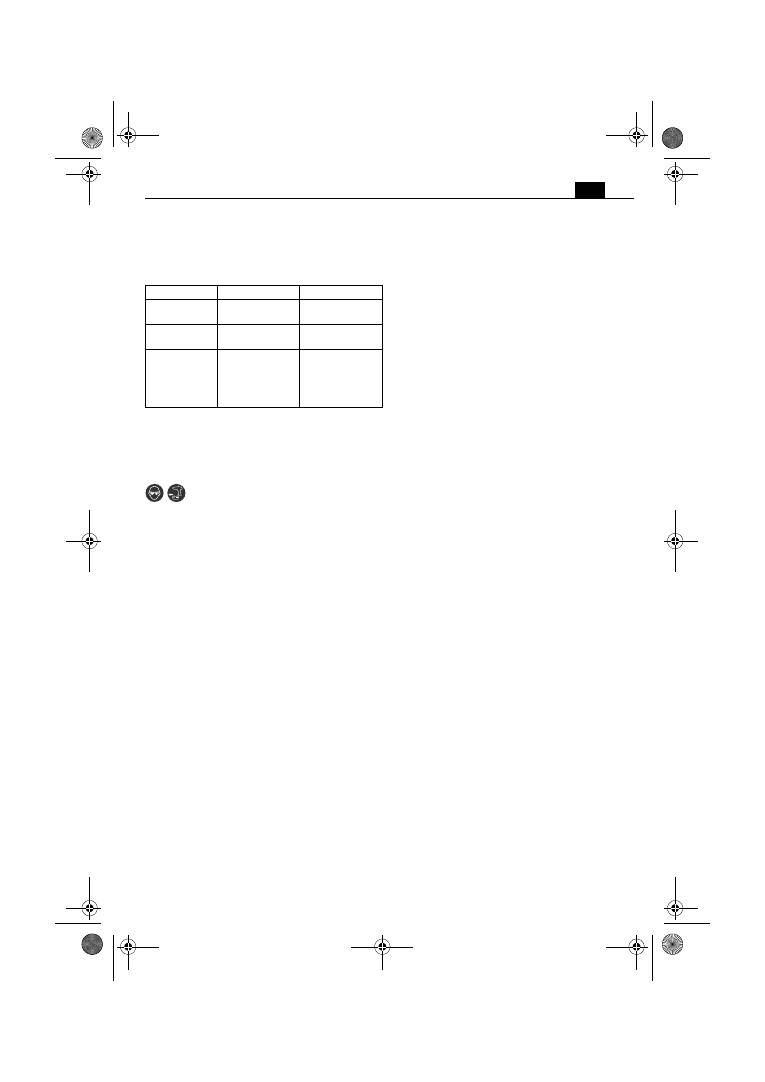
17
en
Handling the battery.
Operate and charge the battery only within the battery
operating-temperature range of 0°C – 45°C (32°F –
113°F). At the beginning of the charging procedure, the
battery temperature must be within the battery operat-
ing-temperature range.
The real percentage of the battery charge condition is
only indicated when the power tool motor is stopped.
The electronics automatically switch off the motor prior
to the battery being deep discharged.
Repair and customer service.
When working metal under extreme operat-
ing conditions, it is possible for conductive
dust to settle in the interior of the power tool.
Blow out the interior of the power tool via the ventila-
tion slots frequently with dry and oil-free compressed air.
The current spare parts list for this power tool can be
found in the Internet at www.fein.com.
If required, you can change the following parts yourself:
application tools, battery
Warranty and liability.
The warranty for the product is valid in accordance with
the legal regulations in the country where it is marketed.
In addition, FEIN also provides a guarantee in accordance
with the FEIN manufacturer’s warranty declaration.
The delivery scope of your power tool may include only
a part of the accessories described or shown in this
Instruction Manual.
Declaration of conformity.
FEIN declares itself solely responsible for this product
conforming with the relevant provisions given on the last
page of this Instruction Manual.
Technical documents at: C. & E. FEIN GmbH, C-DB_IA,
D-73529 Schwäbisch Gmünd
Environmental protection, disposal.
Packaging, worn out power tools and accessories should
be sorted for environmental-friendly recycling.
Dispose of batteries only when discharged.
For batteries that are not completely discharged, insulate
the terminals with tape as a protective measure against
short-circuiting.
LED indicator
Meaning
Activity
1 – 4 green
LED
Percentage of
charge condition
Operation
Continuous
red light
Battery is almost
empty
Charge battery
Red flashing
light
Battery is not
ready for opera-
tion
Bring the battery
into the battery
operating-tem-
perature range,
then charge
OBJ_BUCH-0000000105-001.book Page 17 Thursday, April 4, 2013 10:23 AM
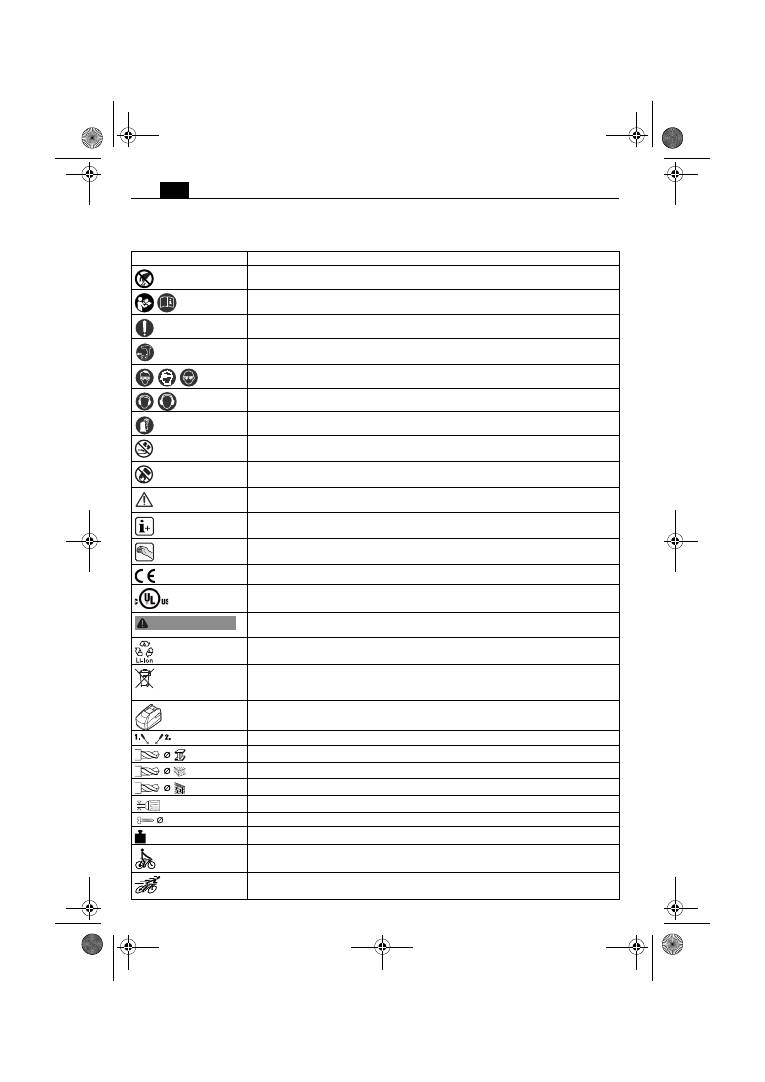
18
fr
fr
Notice originale.
Symboles, abréviations et termes utilisés.
Symbole, signe
Explication
Ne pas toucher les éléments en rotation de l’outil électrique.
Lire impérativement les documents ci-joints tels que la notice d’utilisation et les instruc-
tions générales de sécurité.
Suivre les indications données dans le texte ou la représentation graphique ci-contre !
Avant d’effectuer ce travail, retirer l’accumulateur de l’outil électrique. Sinon, il y a des
risques de blessures dues à un démarrage non intentionné de l’outil.
Lors des travaux, porter une protection oculaire.
Lors des travaux, porter une protection acoustique.
Lors des travaux, utiliser un protège-main.
Ne pas charger des accus endommagés.
Ne pas exposer ou jeter l’accumulateur au feu. Protéger l’accumulateur des sources de
chaleur, comme par ex. l’exposition directe au soleil.
Suivre les indications données dans le texte ci-contre !
Information supplémentaire.
Poignée
Confirme la conformité de l’outil électrique aux directives de l’Union Européenne.
Ce symbole confirme la certification de ce produit aux Etats-Unis et au Canada.
Cette indication indique une situation éventuellement dangereuse pouvant entraîner de
graves blessures ou la mort.
Signalisation de recyclage : indique les matériaux recyclables
Trier les outils électriques ainsi que tout autre produit électrotechnique et électrique et
les déposer à un centre de recyclage respectant les directives relatives à la protection de
l’environnement.
Type d’accu
Première vitesse/2ième vitesse
Diamètre de perçage acier
Diamètre de perçage bois
Diamètre de perçage pierre
Plage de serrage du mandrin
Diamètre vis
Poids suivant EPTA-Procedure 01/2003
Faible vitesse de rotation
Vitesse de rotation élevée
AVERTISSEMENT
Fe
OBJ_BUCH-0000000105-001.book Page 18 Thursday, April 4, 2013 10:23 AM
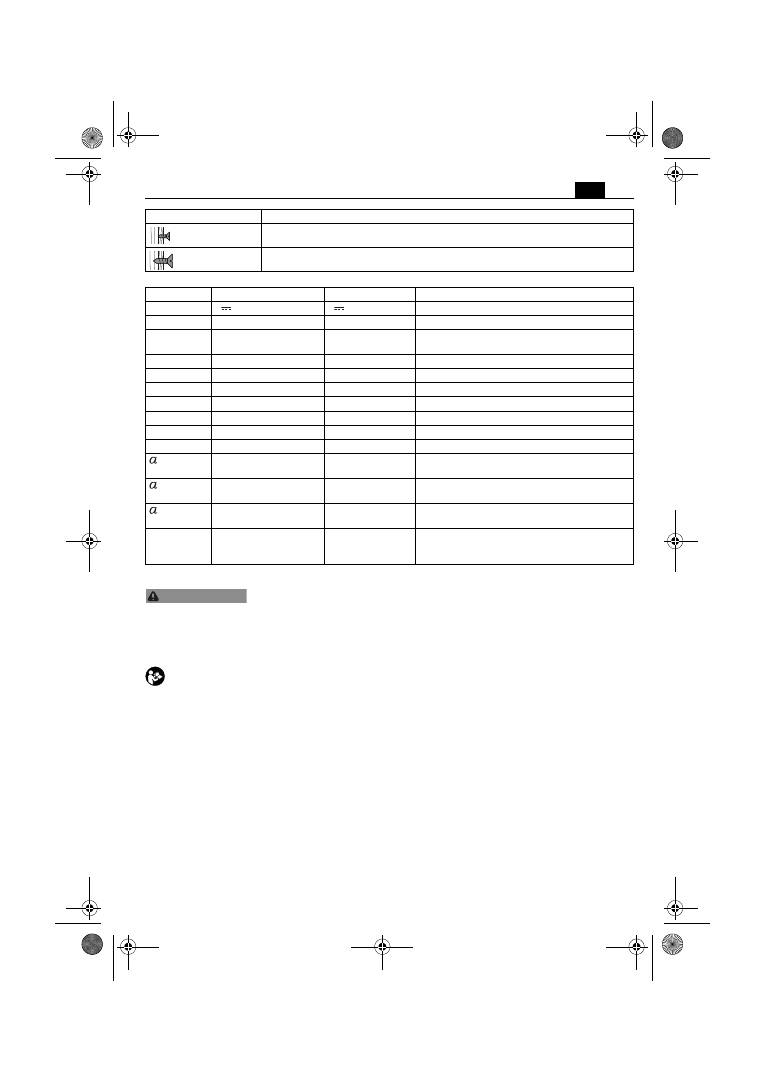
19
fr
Pour votre sécurité.
Lisez tous les avertissements
de sécurité et toutes les ins-
tructions.
Ne pas suivre les avertissements et instructions
peut donner lieu à une électrocution, un incendie et/ou
une blessure sérieuse.
Conservez tous les avertissements et toutes les instruc-
tions pour pouvoir vous y reporter ultérieurement.
N’utilisez pas cet outil électrique avant d’avoir soi-
gneusement lu et compris à fond cette notice d’uti-
lisation ainsi que les « Instructions générales de
sécurité » (réf. documents 3 41 30 054 06 1). Conservez
ces documents pour une utilisation ultérieure et joignez-
les à l’outil électrique en cas de transmission ou de vente
à une tierce personne.
De même, respectez les dispositions concernant la pré-
vention des accidents du travail en vigueur dans le pays en
question.
Conception de l’outil électrique :
ABS14, ABS18 :
perceuse-visseuse électroportative, conçu pour le ser-
rage et le desserrage à sec de vis et écrous et pour le per-
çage et le vissage à sec dans le métal, le bois, les matières
plastiques et la céramique ainsi que pour le taraudage à
l’abri des intempéries avec les outils de travail et les acces-
soires autorisés par FEIN.
ASB14, ASB18 :
perceuse-visseuse à percussion électroportative, conçu
pour le serrage et le desserrage à sec de vis et écrous et
pour le perçage et le vissage à sec dans le métal, le bois,
les matières plastiques et la céramique ainsi que pour le
taraudage à l’abri des intempéries avec les outils de travail
et les accessoires autorisés par FEIN.
Instructions particulières de sécurité.
Tenir l’outil par les surfaces de préhension isolées, lors
de la réalisation d’une opération au cours de laquelle le
dispositif de serrage peut entrer en contact avec un
câblage non apparent.
Le contact avec un fil « sous ten-
sion » peut également mettre « sous tension » les parties
métalliques exposées de l’outil électrique et provoquer
un choc électrique sur l’opérateur.
Faites attention aux câbles électriques, conduites de gaz
et d’eau éventuellement cachés.
Avant de commencer le
travail, contrôlez la zone de travail à l’aide d’un détecteur
de métaux par exemple.
Porter un équipement de protection individuelle. En fonc-
tion de l’application, utiliser un écran facial, des lunettes
de sécurité ou des verres de sécurité. Le cas échéant, uti-
liser un masque antipoussières, des protections auditi-
ves, des gants et un tablier capables d’arrêter les petits
fragments abrasifs ou des pièces à usiner.
La protection
oculaire doit être capable d’arrêter les débris volants pro-
duits par les diverses opérations. Le masque antipoussiè-
res ou le masque respiratoire doit être capable de filtrer
les particules produites par vos travaux. L’exposition
prolongée aux bruits de forte intensité peut provoquer
une perte de l’audition.
Diminuer le couple
Augmenter le couple
Signe
Unité internationale
Unité nationale
Explication
U
V
V
Tension en courant continu
f
Hz
Hz
Fréquence
n
0
/min, min
-1
, rpm, r/min
tr/min
Vitesse à vide (pour accumulateur complètement
chargé)
n
S
/min, min
-1
/min
Fréquence de frappe
M...
Nm
Nm
Couple (vissage dur/tendre)
Ø
mm
mm
Diamètre d’un élément
L
pA
dB
dB
Niveau de pression acoustique
L
wA
dB
dB
Niveau d’intensité acoustique
L
pCpeak
dB
dB
Niveau max. de pression acoustique
K...
Incertitude
m/s
2
m/s
2
Valeur d’émission vibratoire suivant EN 60745
(somme vectorielle des trois axes directionnels)
h,D
m/s
2
m/s
2
Valeur de vibration moyenne pour le perçage dans
le métal
h,ID
m/s
2
m/s
2
Valeur de vibration moyenne pour le perçage à
percussion dans le béton
m, s, kg, A, mm, V,
W, Hz, N, °C, dB,
min, m/s
2
m, s, kg, A, mm, V,
W, Hz, N, °C, dB,
min, m/s
2
Unités de base et unités dérivées du système inter-
national
SI
.
Symbole, signe
Explication
AVERTISSEMENT
OBJ_BUCH-0000000105-001.book Page 19 Thursday, April 4, 2013 10:23 AM

20
fr
Porter des protecteurs d’oreilles lors du perçage avec des
perceuses à percussion.
L’exposition aux bruits peut
provoquer une perte de l’audition.
Bloquez la pièce à travailler.
Une pièce à travailler serrée
par un dispositif de serrage est fixée de manière plus sûre
que si elle est seulement tenue de la main.
Tenez fermement l’outil électrique.
Il pourrait avoir des
réactions inattendues.
Ne travaillez pas de matériaux contenant de l’amiante.
L’amiante est considérée comme cancérigène.
Il est interdit de visser ou de riveter des plaques ou des
repères sur l’outil électrique.
Une isolation endommagée
ne présente aucune protection contre une électrocution.
Utilisez des autocollants.
N’utilisez pas des accessoires qui n’ont pas été spéciale-
ment conçus ou autorisés par le fabricant de l’outil élec-
trique.
Le seul fait qu’un accessoire puisse être monté sur
votre outil électrique ne garantit pas une utilisation sans
risque.
Nettoyez régulièrement les ouïes de ventilation de l’outil
électrique avec des outils non-métalliques.
La ventilation
du moteur aspire la poussière à l’intérieur du carter. Une
trop grande quantité de poussière de métal accumulée
peut provoquer des incidents électriques.
Ne regardez jamais de très près directement dans la
lumière de la lampe de l’outil électrique. Ne dirigez pas la
lumière de la lampe vers les yeux d’autres personnes se
trouvant à proximité.
Les rayons générés par la lampe
peuvent être dangereux pour les yeux.
Ne dirigez pas l’outil électrique vers vous-même ou vers
d’autres personnes ou des animaux.
Il y a un danger de
blessure causé par des outils de travail tranchants ou
chauds.
Utilisation et entretien de l’accumulateur
(blocs d’accu).
Afin d’éviter des dangers tels que brûlures, incendie,
explosion, blessures de la peau et d’autres blessures lors
du maniement de l’accumulateur, respectez les indica-
tions suivantes :
Ne pas ouvrir, ni démonter les accumulateurs. Ne pas
exposer les accus à des chocs mécaniques.
En cas
d’endommagement et d’utilisation non conforme de
l’accu, des vapeurs et liquides nuisibles peuvent s’échap-
per. Les vapeurs peuvent irriter les voies respiratoires.
Le liquide qui sort de l’accumulateur peut provoquer des
irritations de la peau ou causer des brûlures.
Au cas où le liquide contenu dans les accumulateurs
aurait contaminé des objets se trouvant à proximité,
contrôlez les parties touchées, nettoyez-les ou, le cas
échéant, remplacez-les.
N’exposez pas l’accumulateur à la chaleur ni au feu. Ne
stockez pas l’accumulateur dans un endroit directement
exposé au soleil.
Ne retirez l’accumulateur de son emballage d’origine que
lorsqu’il doit être utilisé.
Avant tous travaux sur l’outil électrique, retirez l’accumu-
lateur de l’outil.
Risque de blessures en cas de démarrage
non intentionnel de l’outil électrique.
Ne retirez l’accumulateur que lorsque l’outil électrique
est à l’arrêt.
Maintenez les accumulateurs hors de la portée des
enfants.
Tenez toujours l’accumulateur propre et protégez-le de
l’humidité et de l’eau.
Nettoyez les raccords encrassés de
l’accumulateur et de l’outil électrique a l’aide d’un chiffon
sec et propre.
N’utilisez que des accumulateurs intacts d’origine FEIN
conçus pour votre outil électrique.
Lors du travail avec et
lors du chargement d’accumulateurs d’un type ne conve-
nant pas à l’outil, d’accumulateurs endommagés, réparés
ou modifiés, d’accumulateurs contrefaits ou d’autres
fabricants, il y a danger d’incendie et/ou d’explosion.
Respectez les indications de sécurité de la notice d’utili-
sation du chargeur d’accumulateurs.
Vibrations mains-bras
L’amplitude d’oscillation indiquée dans ces instructions
d’utilisation a été mesurée conformément à la norme
EN 60745 et peut être utilisée pour une comparaison
d’outils électriques. Elle est également appropriée pour
une estimation préliminaire de la sollicitation vibratoire.
L’amplitude d’oscillation indiquée correspond aux utilisa-
tions principales de l’outil électrique. Si, toutefois, l’outil
électrique était utilisé pour d’autres applications, avec
d’autres outils de travail ou en cas d’un entretien insuffi-
sant, l’amplitude d’oscillation pourrait être différente.
Ceci peut augmenter considérablement la sollicitation
vibratoire pendant toute la durée du travail.
Pour une estimation précise de la sollicitation vibratoire,
il est recommandé de prendre aussi en considération les
espaces de temps pendant lesquels l’appareil est éteint ou
allumé, mais pas vraiment utilisé. Ceci peut réduire consi-
dérablement la sollicitation vibratoire pendant toute la
durée du travail.
Déterminez des mesures de protection supplémentaires
pour protéger l’utilisateur des effets des vibrations, tels
que par exemple : entretien de l’outil électrique et des
outils de travail, maintenir les mains chaudes, organisation
des opérations de travail.
Emanation de poussières nocives
Lors du travail avec enlèvement de matière, des poussiè-
res pouvant être dangereuses sont générées.
Toucher ou aspirer certaines poussières, par ex.
d’amiante et de matériaux contenant de l’amiante, de
peintures contenant du plomb, du métal, de certains bois,
de minéraux, des particules de silicate contenues dans les
matériaux contenant de la roche, de solvants de peinture,
de lasures, de produits antifouling pour bateaux peut cau-
ser des réactions allergiques et/ou des maladies des voies
respiratoires, un cancer ou des problèmes de fécondité.
Le risque causé par l’inhalation de poussières dans les
poumons dépend de l’exposition aux poussières. Utilisez
une aspiration adaptée à la poussière générée ainsi que
des équipements de protection personnels et veiller à
bien aérer la zone de travail. Ne confiez le travail sur des
matériaux contenant de l’amiante qu’à des spécialistes.
OBJ_BUCH-0000000105-001.book Page 20 Thursday, April 4, 2013 10:23 AM

21
fr
Les poussières de bois et les poussières de métaux légers,
les mélanges chauds de poussières de ponçage et de pro-
duits chimiques peuvent s’enflammer dans certaines
conditions ou causer une explosion. Evitez une projec-
tion d’étincelles vers le bac de récupération des poussiè-
res ainsi qu’une surchauffe de l’outil électrique et des
matériaux travaillés, videz à temps le bac de récupération
des poussières et respectez les indications de travail du
fabricant du matériau ainsi que les règlements en vigueur
dans votre pays spécifiques aux matériaux à traiter.
Instructions d’utilisation.
N’actionnez le commutateur du sens de rotation et le
commutateur de vitesse qu’à l’arrêt total du moteur.
Poussez toujours le commutateur de vitesse ou tournez
le commutateur du mode de fonctionnement
(ASB14/18) jusqu’à la butée. L’outil électroportatif ris-
querait d’être endommagé.
En cas de surcharge, l’outil électroportatif s’arrête.
Mettez le commutateur du sens de rotation en position
médiane pour éviter un déclenchement intempestif, par
ex. lors du transport.
Réglage du couple
Le réglage par défaut correspond à la plage pour vis
petites et moyennes.
Le couple de serrage dépend aussi de la force avec
laquelle l’outil électrique est pressé contre la vis.
Maniement de l’accumulateur.
N’utilisez et ne chargez l’accumulateur que dans la plage
de température de service admissible de l’accu de 0 °C –
45 °C (32 °F – 113 °F). Au début du processus de charge,
la température de l’accumulateur doit se situer dans la
plage de température de service de l’accu.
L’état de charge actuel en pourcentage de l’accumulateur
n’est indiqué que lorsque le moteur de l’outil électropor-
tatif est à l’arrêt.
L’électronique stoppe automatiquement le moteur pour
éviter toute décharge avancée de l’accumulateur.
Travaux d’entretien et service après-
vente.
En cas de conditions d’utilisation extrêmes,
lors du travail de matériaux métalliques, des
poussières conductrices pourraient se déposer
à l’intérieur de l’outil électrique. Soufflez souvent de l’air
comprimé sec et sans huile dans l’intérieur de l’outil élec-
trique à travers les fentes de ventilation.
Vous trouverez la liste actuelle des pièces de rechange
pour cet outil électroportatif sur notre site
www.fein.com.
Si nécessaire, vous pouvez vous-même remplacer les élé-
ments suivants :
outils de travail, accu
Garantie.
La garantie du produit est valide conformément à la régle-
mentation légale en vigueur dans le pays où le produit est
mis sur le marché. Outre les obligations de garantie léga-
le, les appareils FEIN sont garantis conformément à notre
déclaration de garantie de fabricant.
Il se peut que seule une partie des accessoires décrits ou
représentés dans cette notice d’utilisation soit fournie
avec l’outil électrique.
Déclaration de conformité.
L’entreprise FEIN déclare sous sa propre responsabilité
que ce produit est en conformité avec les réglementa-
tions en vigueur indiquées à la dernière page de la présen-
te notice d’utilisation.
Dossier technique auprès de : C. & E. FEIN GmbH,
C-DB_IA, D-73529 Schwäbisch Gmünd
Protection de l’environnement, recyclage.
Rapportez les emballages, les outils électriques hors
d’usage et les accessoires dans un centre de recyclage res-
pectant les directives concernant la protection de l’envi-
ronnement.
N’éliminez les accumulateurs que lorsqu’ils sont déchar-
gés.
Si les accumulateurs ne sont pas complètement déchar-
gés, isolez par précaution le connecteur électrique a l’aide
d’un ruban adhésif pour les protéger contre les courts-
circuits.
Affichage
LED
Explication
Action
1 – 4 LED
vertes
Etat de charge
en pourcentage
Machine prête à l’emploi
Voyant
rouge per-
manent
L’accumulateur
est presque
vide
Charger l’accumulateur
Voyant
rouge cli-
gnotant
L’accumulateur
n’est pas prêt à
fonctionner
Mettre l’accumulateur
dans la plage de tempé-
rature de service de
l’accu, le charger ensuite
OBJ_BUCH-0000000105-001.book Page 21 Thursday, April 4, 2013 10:23 AM
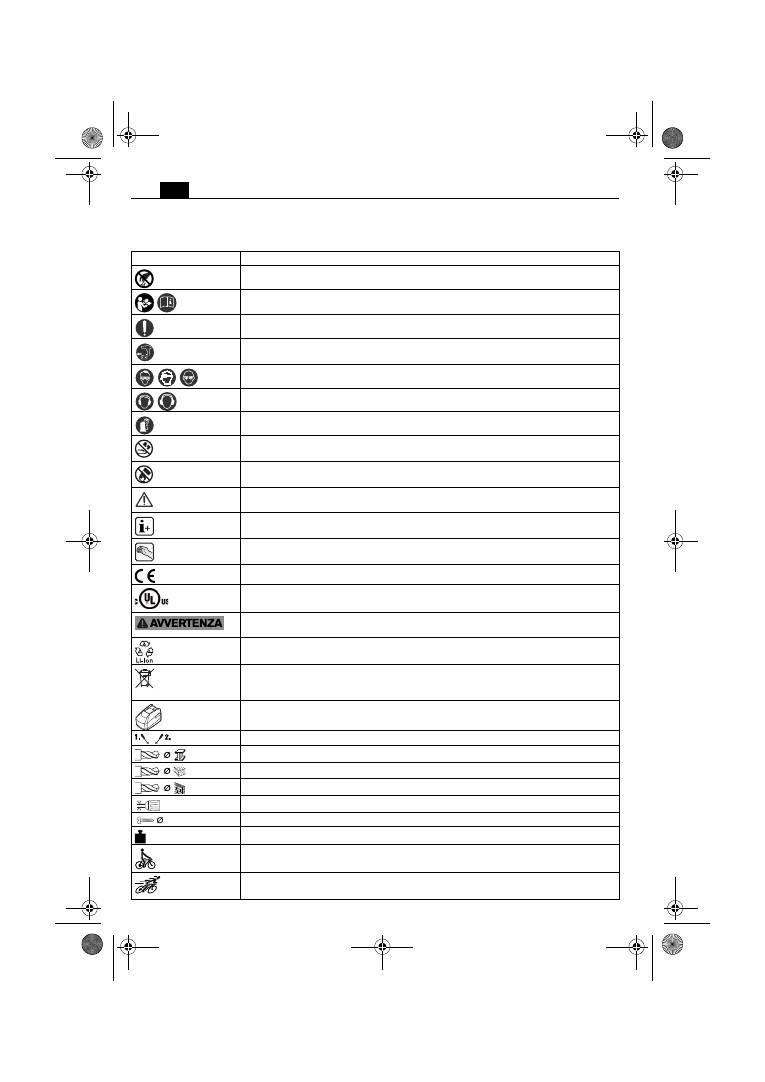
22
it
it
Istruzioni originali.
Simboli, abbreviazioni e termini utilizzati.
Simbolo
Descrizione
Non toccare mai parti in rotazione dell’elettroutensile.
La documentazione allegata, come le istruzioni per l’uso e le indicazioni generali di sicu-
rezza devono essere lette assolutamente.
Osservare le istruzioni nel testo o nel grafico riportato a lato!
Prima di questa operazione rimuovere la batteria ricaricabile dall’elettroutensile. Altri-
menti esiste pericolo di lesioni dovute all’accensione accidentale dell’elettroutensile.
Durante la fase operativa utilizzare la protezione per gli occhi.
Durante la fase operativa utilizzare la protezione acustica.
Durante la fase operativa utilizzare la protezione per le mani.
Non ricaricare batterie ricaricabili danneggiate.
Non esporre la batteria ricaricabile al fuoco. Proteggere la batteria ricaricabile dal calore,
p. es. anche dall’irradiamento solare continuo.
Attenersi alle indicazioni contenute nel testo accanto!
Informazione supplementare.
Settore di presa
Conferma la conformità dell’elettroutensile con le direttive della Comunità europea.
Questo simbolo conferma la certificazione del presente prodotto in USA e Canada.
Questa avvertenza mette in guardia dallo sviluppo di una possibile situazione pericolosa
che può comportare il pericolo di incidenti gravi oppure anche mortali.
Simbolo riciclaggio: contrassegna materiali riutilizzabili
Una volta che un elettroutensile o un qualunque altro prodotto elettrotecnico sarà diven-
tato inservibile, portarlo ad un centro di raccolta adibito ad un riciclaggio eseguito secondo
criteri ecologici.
Tipo di batteria ricaricabile
1
a
marcia/2
a
marcia
Ø foratura acciaio
Ø foratura legno
Ø foratura pietra
Campo di serraggio del mandrino
Diametro delle viti
Peso conforme alla EPTA-Procedure 01/2003
Numero di giri minimo
Numero di giri massimo
Fe
OBJ_BUCH-0000000105-001.book Page 22 Thursday, April 4, 2013 10:23 AM
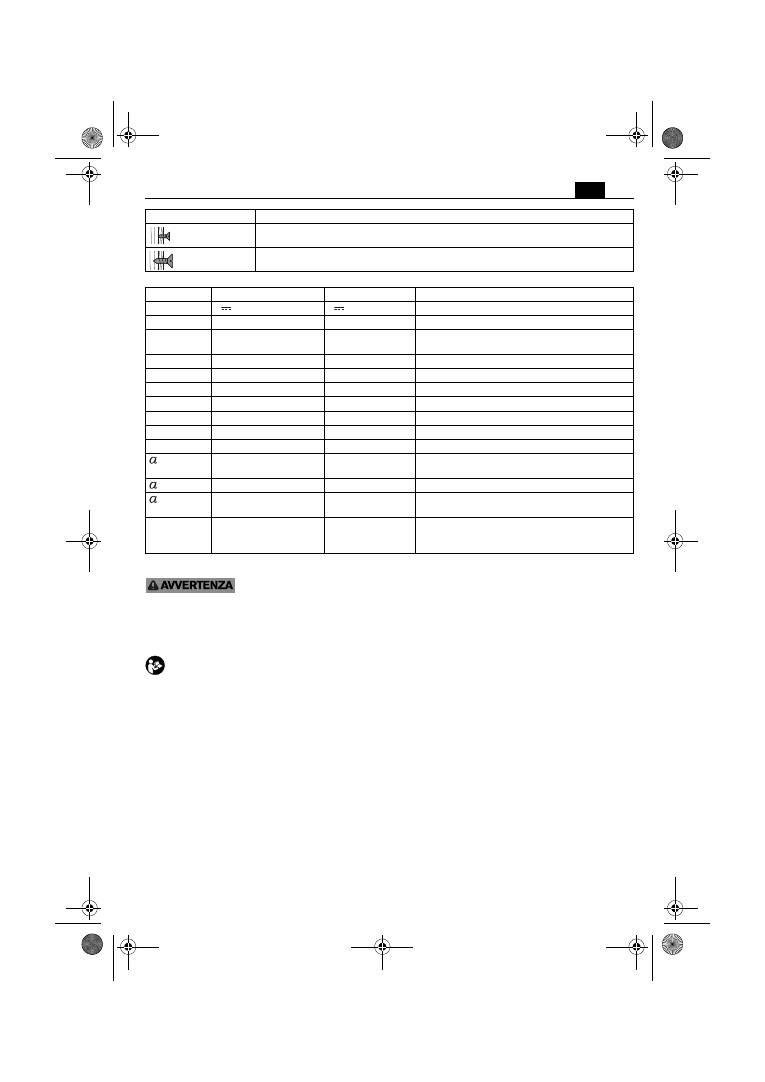
23
it
Per la Vostra sicurezza.
Leggere tutte le avvertenze di
pericolo e le istruzioni operative.
In caso di mancato rispetto delle avvertenze di pericolo e
delle istruzioni operative si potrà creare il pericolo di
scosse elettriche, incendi e/o incidenti gravi.
Conservare tutte le avvertenze di pericolo e le istruzioni
operative per ogni esigenza futura.
Non utilizzare il presente elettroutensile prima di
aver letto e compreso accuratamente e completa-
mente queste istruzioni per l’uso e le «Indicazioni
generali di sicurezza» allegate (numero di documenta-
zione 3 41 30 054 06 1). Conservare la documentazione
indicata per un eventuale uso futuro ed allegarla in caso
di inoltro oppure di vendita dell’elettroutensile.
Attenersi anche alle norme nazionali in vigore concer-
nenti la sicurezza sul lavoro.
Utilizzo previsto per l’elettroutensile:
ABS14, ABS18:
avvitatore per l’utilizzo manuale per avvitamento e svita-
mento di viti e dadi e per la foratura ed avvitamento in
metallo, legno, plastica e ceramica nonché per la filettatura
con inserti ed accessori consigliati dalla FEIN senza l’impiego
di acqua in ambiente protetto dagli agenti atmosferici.
ASB14, ASB18:
avvitatore per l’utilizzo manuale per avvitamento e svita-
mento di viti e dadi e per la foratura ed avvitamento in
metallo, legno, plastica e ceramica nonché per la filettatura
e foratura battente in calcestruzzo, pietra e mattoni con
inserti ed accessori consigliati dalla FEIN senza l’impiego di
acqua in ambiente protetto dagli agenti atmosferici.
Norme speciali di sicurezza.
Tenere l’apparecchio per le superfici isolate dell’impu-
gnatura qualora venissero effettuati lavori durante i quali
la vite potrebbe venire a contatto con cavi elettrici nasco-
sti.
Il contatto con un cavo sotto tensione può mettere
sotto tensione anche parti metalliche dell’apparecchio,
causando una scossa elettrica.
Fare sempre attenzione a cavi elettrici, tubazioni
dell’acqua e del gas posati in maniera non visibile.
Prima
di iniziare a lavorare, controllare la zona di operazione
utilizzando p. es. un rilevatore di metalli.
Indossare abbigliamento di protezione. A seconda
dell’applicazione in corso utilizzare una visiera completa,
maschera di protezione per gli occhi oppure occhiali di
sicurezza. Per quanto necessario, portare maschere per
polveri, protezione acustica, guanti di protezione oppure
un grembiule speciale in grado di proteggervi da piccole-
particelle di levigatura o di materiale.
Gli occhi dovreb-
bero essere protetti da corpi estranei espulsi in aria nel
corso di diverse applicazioni. La maschera antipolvere e la
maschera respiratoria devono essere in grado di filtrare la
polvere provocata durante l’applicazione. Esponendosi
per lungo tempo ad un rumore troppo forte vi è il peri-
colo di perdere l’udito.
Usare la protezione acustica impiegando trapani battenti.
L’azione del rumore può causare la perdita dell’udito.
Ridurre la coppia
Aumentare la coppia
Simbolo
Unità internazionale
Unità nazionale
Descrizione
U
V
V
Tensione elettrica continua
f
Hz
Hz
Frequenza
n
0
/min, min
-1
, rpm, r/min
g/min
Numero di giri al minimo (con batteria ricaricabile
completamente carica)
n
S
/min, min
-1
/min
Numero di colpi
M...
Nm
Nm
Coppia (avvitamento più rigido/più morbido)
Ø
mm
mm
Diametro di un componente rotondo
L
pA
dB
dB
Livello di pressione acustica
L
wA
dB
dB
Livello di potenza acustica
L
pCpeak
dB
dB
Livello di pressione acustica picco
K...
Non determinato
m/s
2
m/s
2
Valore di emissione delle vibrazioni secondo
EN 60745 (somma vettori delle tre direzioni)
h,D
m/s
2
m/s
2
valore di oscillazioni medio per foratura in metallo
h,ID
m/s
2
m/s
2
valore di oscillazioni medio per foratura battente
nel calcestruzzo
m, s, kg, A, mm, V,
W, Hz, N, °C, dB,
min, m/s
2
m, s, kg, A, mm, V,
W, Hz, N, °C, dB,
min, m/s
2
Unità di base ed unità derivanti dal sistema unità
internazionale
SI
.
Simbolo
Descrizione
OBJ_BUCH-0000000105-001.book Page 23 Thursday, April 4, 2013 10:23 AM
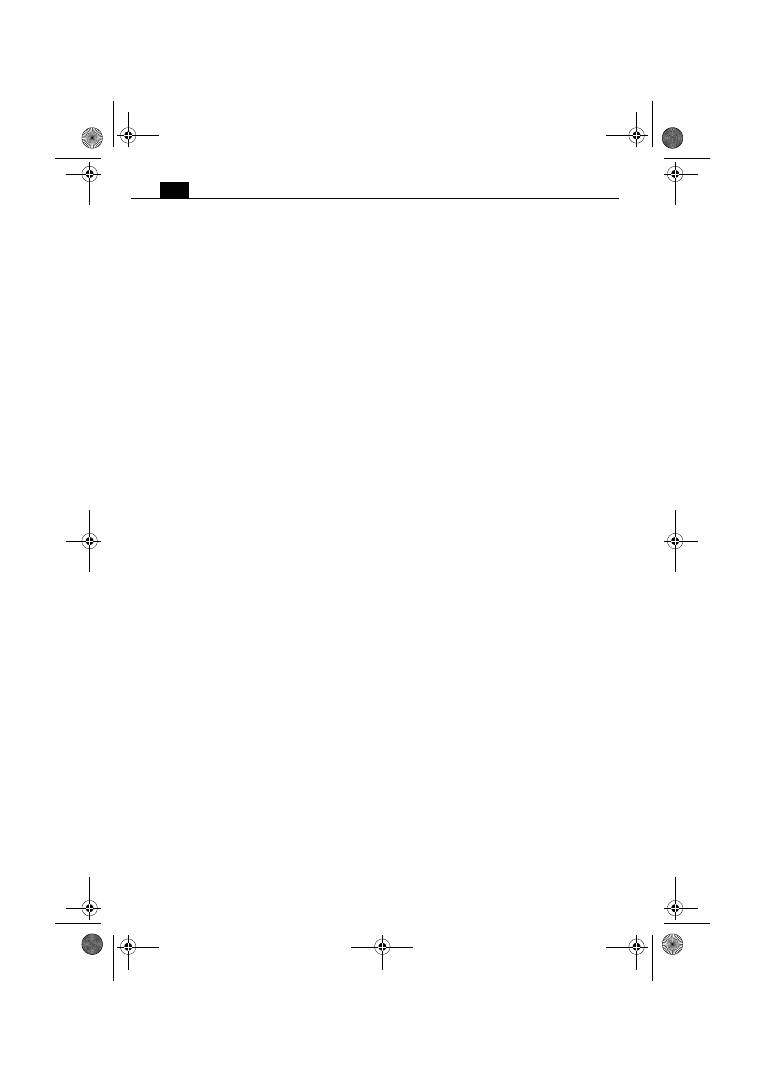
24
it
Assicurare il pezzo in lavorazione.
Un pezzo in lavora-
zione tenuto fermo con un dispositivo di bloccaggio è più
sicuro che se tenuto con la semplice mano.
Impugnare saldamente l’elettroutensile.
Possono verifi-
carsi brevemente elevati momenti di reazione.
Non lavorare mai materiali contenenti amianto.
L’amianto
è ritenuto materiale cancerogeno.
È vietato applicare targhette e marchi sull’elettroutensile
avvitandoli oppure fissandoli tramite rivetti.
In caso di
danno dell’isolamento viene a mancare ogni protezione
contro scosse elettriche. Utilizzare targhette autoadesive.
Non utilizzare nessun tipo di accessorio che non sia stato
appositamente sviluppato oppure esplicitamente appro-
vato dalla casa costruttrice dell’elettroutensile.
Un fun-
zionamento sicuro non è assicurato dal semplice fatto che
le misure di un accessorio combacino con il Vostro elet-
troutensile.
Pulire regolarmente le fessure di ventilazione dell’elet-
troutensile con attrezzi non metallici.
La ventola del
motore attira polvere nella carcassa. Questo può causare,
in caso di accumulo eccessivo di polvere metallica, peri-
coli elettrici.
Non guardare mai da distanze ridotte nella luce della
lampada dell’elettroutensile. Non dirigere mai la luce
della lampada negli occhi di altre persone che si trovano
nelle vicinanze.
La radiazione che viene generata da appa-
recchi luminosi può essere dannosa per gli occhi.
Non dirigere mai l’elettroutensile verso sé stessi, altre
persone o animali.
Esiste il pericolo di lesioni dovute a
accessori taglienti o bollenti.
Impiego e trattamento della batteria ricaricabile
(blocco della batteria ricaricabile).
Per evitare pericoli come ustioni, incendio, esplosione,
lesioni della pelle ed altre lesioni durante l’impiego della
batteria ricaricabile osservare le seguenti istruzioni:
Le batterie ricaricabili non devono essere smontate,
aperte oppure sminuzzate. Non sottoporre le batterie
ricaricabili ad alcun urto meccanico.
In caso di danneg-
giamento ed un uso non corretto della batteria ricarica-
bile possono fuoriuscire vapori e liquidi dannosi. I vapori
possono irritare le vie respiratorie. Il liquido della batteria
ricaricabile che fuoriesce può causare irritazioni della
pelle o ustioni.
Se il liquido fuoriuscito dalla batteria ricaricabile dan-
neggiata ha bagnato oggetti attigui, controllare le parti
interessate, pulirle oppure, se necessario, sostituirle.
Non esporre la batteria ricaricabile al calore o al fuoco.
Non immagazzinare la batteria ricaricabile sottoponen-
dola alla luce solare diretta.
Togliere la batteria ricaricabile dal suo imballo originale
solamente se la stessa deve essere utilizzata.
Togliere la batteria ricaricabile dall’elettroutensile prima
di ogni lavoro all’elettroutensile stesso.
Se l’elettrouten-
sile si mette in funzione accidentalmente esiste il pericolo
di lesioni.
Rimuovere la batteria ricaricabile esclusivamente ad
elettroutensile spento.
Tenere le batterie ricaricabili lontane dai bambini.
Tenere pulita la batteria ricaricabile e proteggerla da
umidità ed acqua.
Pulire i contatti sporchi della batteria
ricaricabile e dell’elettroutensile con un panno asciutto e
pulito.
Utilizzare esclusivamente batterie ricaricabili originali
FEIN intatte adatte per l’elettroutensile.
In caso di lavori
con e di ricarica di batterie ricaricabili non corrette, dan-
neggiate riparate oppure rigenerate, di imitazioni e pro-
dotti di terzi, esiste il pericolo di incendio e/o di
esplosione.
Seguire le indicazioni di sicurezza indicate nelle istruzioni
per l’uso del caricabatteria.
Vibrazione mano-braccio
Il livello di oscillazioni indicato nelle presenti istruzioni è
stato misurato conformemente ad una procedura di
misurazione normalizzata contenuta nel EN 60745 e può
essere impiegato per la comparazione con altri elettrou-
tensili. Lo stesso è adatto anche per una valutazione tem-
poranea della sollecitazione da vibrazioni.
Il livello di oscillazioni indicato rappresenta le applicazioni
principali dell’elettroutensile. Se tuttavia l’elettroutensile
viene utilizzato per altri impieghi, con accessori differenti
oppure non viene effettuata una sufficiente manuten-
zione è possibile che il livello di oscillazioni sia differente.
Questo può aumentare sensibilmente la sollecitazione da
vibrazioni per l’intero periodo di lavoro.
Per la precisa valutazione della sollecitazione da vibra-
zioni dovrebbero essere considerati anche i tempi in cui
l’apparecchio è spento oppure è acceso ma non effettiva-
mente in funzione. Questo può ridurre considerevol-
mente la sollecitazione da vibrazioni per l’intero periodo
di lavoro.
Stabilire ulteriori misure di sicurezza per la protezione
dell’operatore dall’azione delle vibrazioni, come ad
esempio: manutenzione dell’elettroutensile e degli acces-
sori, mantenimento mani calde, organizzazione delle pro-
cedure operative.
Modo di procedere con polveri pericolose
Nelle procedure operative di asporto materiale con il
presente utensile si formano polveri che possono essere
pericolose.
Il contatto oppure l’inalazione di alcune polveri p. es. di
amianto e materiali contenenti amianto, vernici conte-
nenti piombo, metallo, alcuni tipi di legno, minerali, par-
ticelle di silicato di materiali contenenti minerali, solventi
per vernici, sostanze protettive per legno, vernice antive-
getativa per imbarcazioni possono causare reazioni aller-
giche e/o malattie delle vie respiratorie, cancro, danni
riproduttivi alle persone. Il rischio dovuto all’inalazione di
polveri dipende dall’esposizione. Utilizzare un’aspira-
zione adatta alla polvere che si forma nonché equipaggia-
menti protettivi personali e provvedere per una buona
aerazione del posto di lavoro. Lasciare effettuare la lavo-
razione di materiale contenente amianto esclusivamente
a personale specializzato.
OBJ_BUCH-0000000105-001.book Page 24 Thursday, April 4, 2013 10:23 AM
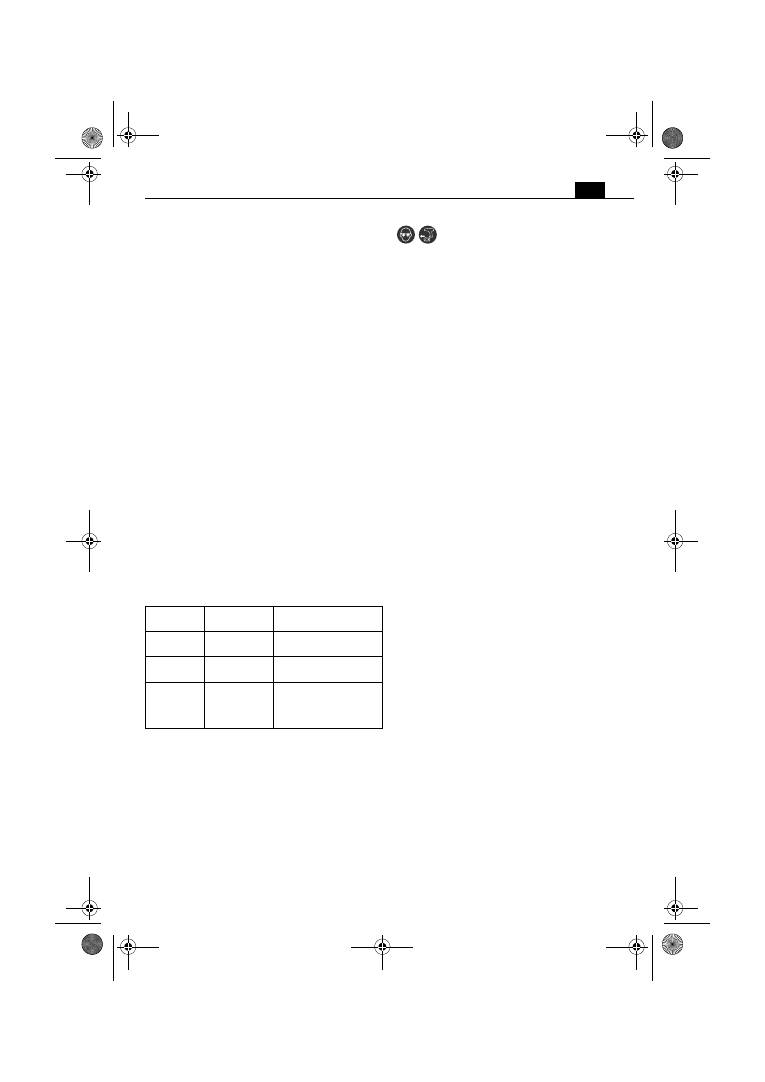
25
it
Polvere di legname e polvere di metallo leggero, miscele
bollenti da polvere di levigatura e sostanze chimiche pos-
sono, in caso di condizioni sfavorevoli, prendere fuoco o
causare un’esplosione. Evitare la fuga di scintille in dire-
zione del contenitore per la polvere nonché il sovrariscal-
damento dell’elettroutensile e del materiale abrasivo,
svuotare per tempo il contenitore per la polvere, osser-
vare le istruzioni di lavorazione del produttore del mate-
riale e le norme valide nel Vostro paese relativamente ai
materiali da lavorare.
Istruzioni per l’uso.
Azionare il commutatore del senso di rotazione ed il
selettore di marcia esclusivamente a motore fermo.
Spingere il selettore di marcia oppure ruotare il selettore
dei modi operativi (ASB14/18) sempre fino all’arresto. In
caso contrario l’elettroutensile potrebbe venire danneg-
giato.
In caso di sovraccarico l’elettroutensile si spegne.
Posizionare il commutatore del senso di rotazione in
posizione centrale per evitare una messa in funzione acci-
dentale, ad. es. durante il trasporto.
Regolazione della coppia
La regolazione della fabbrica corrisponde al campo per
viti dalle più piccole a quelle di grandezza media.
La coppia di serraggio dipende anche dalla forza con cui
l’elettroutensile viene premuto contro la vite.
Uso della batteria ricaricabile.
Far funzionare e ricaricare la batteria ricaricabile esclusi-
vamente in un campo di temperatura d’esercizio della
batteria di 0 °C – 45 °C (32 °F – 113 °F). All’inizio
dell’operazione di ricarica la temperatura della batteria
ricaricabile deve essere nel campo di temperatura d’eser-
cizio della batteria stessa.
L’effettivo stato di carica percentuale della batteria ricari-
cabile viene indicato esclusivamente con motore fermo
dell’elettroutensile.
In caso di imminente scarico totale della batteria ricarica-
bile, l’elettronica dell’elettroutensile arresta automatica-
mente il motore.
Manutenzione ed Assistenza Clienti.
In caso di condizioni di impiego estreme
durante la lavorazione di metallo è possibile
che polvere conduttrice si depositi all’interno
dell’elettroutensile. Soffiare spesso la parte interna
dell’elettroutensile, attraverso le fessure di ventilazione,
con aria compressa asciutta e priva di olio.
L’attuale lista dei pezzi di ricambio del presente elettrou-
tensile è presente in Internet sul sito www.fein.com.
In caso di necessità è possibile sostituire da soli le
seguenti parti:
accessori, batteria ricaricabile
Responsabilità per vizi e garanzia.
La prestazione di garanzia sul prodotto è valida secondo
la relativa normativa vigente nel Paese in cui avviene
l’immissione sul mercato. Inoltre la FEIN riconosce la
garanzia conformemente alla dichiarazione di garanzia
produttore FEIN.
Nel modello di fornitura del Vostro elettroutensile può
essere contenuta anche solo una parte degli accessori
descritti o illustrati nelle presenti istruzioni per l’uso.
Dichiarazione di conformità.
La Ditta FEIN dichiara sotto la propria responsabilità che
il presente prodotto corrisponde alle norme applicabili
riportate sull’ultima pagina delle presenti istruzioni per
l’uso.
Documentazione tecnica presso: C. & E. FEIN GmbH,
C-DB_IA, D-73529 Schwäbisch Gmünd
Misure ecologiche, smaltimento.
Portare ad un centro di raccolta adibito ad un riciclaggio
eseguito secondo criteri ecologici gli imballaggi, gli elet-
troutensili e gli accessori scartati.
Smaltire correttamente batterie ricaricabili esclusiva-
mente scariche.
In caso di batterie ricaricabili non completamente scari-
che, isolare con nastro adesivo il connettore a spina per
precauzione contro corto circuiti.
Indicatore
LED
Significato
Azione
1 – 4 LED
verde
stato di carica
percentuale
Funzionamento
luce conti-
nua rossa
La batteria è
quasi scarica
Ricaricare la batteria
luce lam-
peggiante
rossa
La batteria non
è pronta per il
funziona-
mento
Portare la batteria nel
campo di temperatura
d’esercizio e successiva-
mente ricaricare
OBJ_BUCH-0000000105-001.book Page 25 Thursday, April 4, 2013 10:23 AM
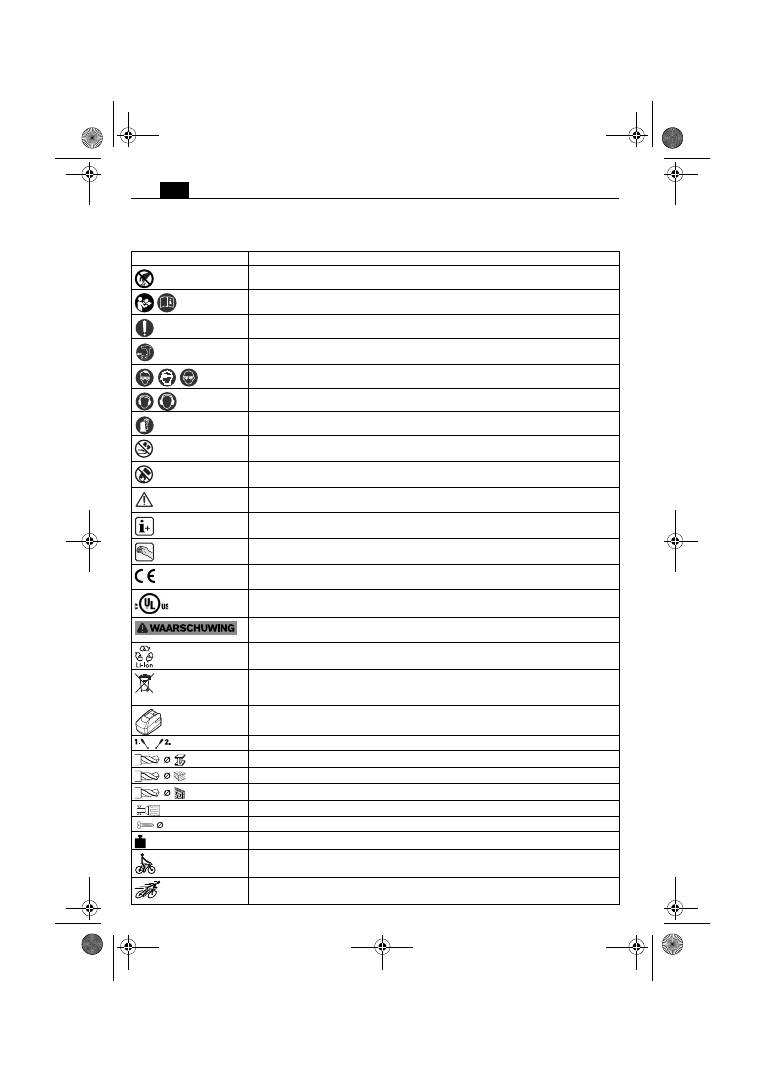
26
nl
nl
Oorspronkelijke gebruiksaanwijzing.
Gebruikte symbolen, afkortingen en begrippen.
Symbool, teken
Verklaring
Raak ronddraaiende delen van het elektrische gereedschap niet aan.
Lees beslist de meegeleverde documenten, zoals de gebruiksaanwijzing en de algemene
veiligheidsvoorschriften.
Volg de aanwijzingen in de nevenstaande tekst of afbeelding op.
Verwijder voor deze handeling de accu uit het elektrische gereedschap. Anders bestaat
er verwondingsgevaar door onbedoeld starten van het elektrische gereedschap.
Gebruik tijdens de werkzaamheden een oogbescherming.
Gebruik tijdens de werkzaamheden een gehoorbescherming.
Gebruik tijdens de werkzaamheden een handbescherming.
Laad geen beschadigde accu’s op.
Stel de accu niet bloot aan vuur. Bescherm de accu tegen hitte, bijvoorbeeld ook tegen
aanhoudend zonlicht.
Neem de vermelde aanwijzingen in acht!
Extra informatie.
Greepoppervlak
Bevestigt de conformiteit van het elektrische gereedschap met de richtlijnen van de
Europese Gemeenschap.
Met dit symbool wordt de certificering van dit product in de Verenigde Staten en
Canada bevestigd.
Dit is een waarschuwing voor een mogelijk gevaarlijke situatie die tot ernstig letsel of
de dood kan leiden.
Recyclingsymbool: duidt recyclebare materialen aan
Versleten elektrische gereedschappen en andere elektrotechnische en elektrische pro-
ducten moeten apart worden ingezameld en op een voor het milieu verantwoorde
wijze worden hergebruikt.
Accutype
Stand 1/Stand 2
Boordiameter staal
Boordiameter hout
Boordiameter steen
Boorhouderspanbereik
Schroefdiameter
Gewicht volgens EPTA-Procedure 01/2003
Laag toerental
Hoog toerental
Fe
OBJ_BUCH-0000000105-001.book Page 26 Thursday, April 4, 2013 10:23 AM
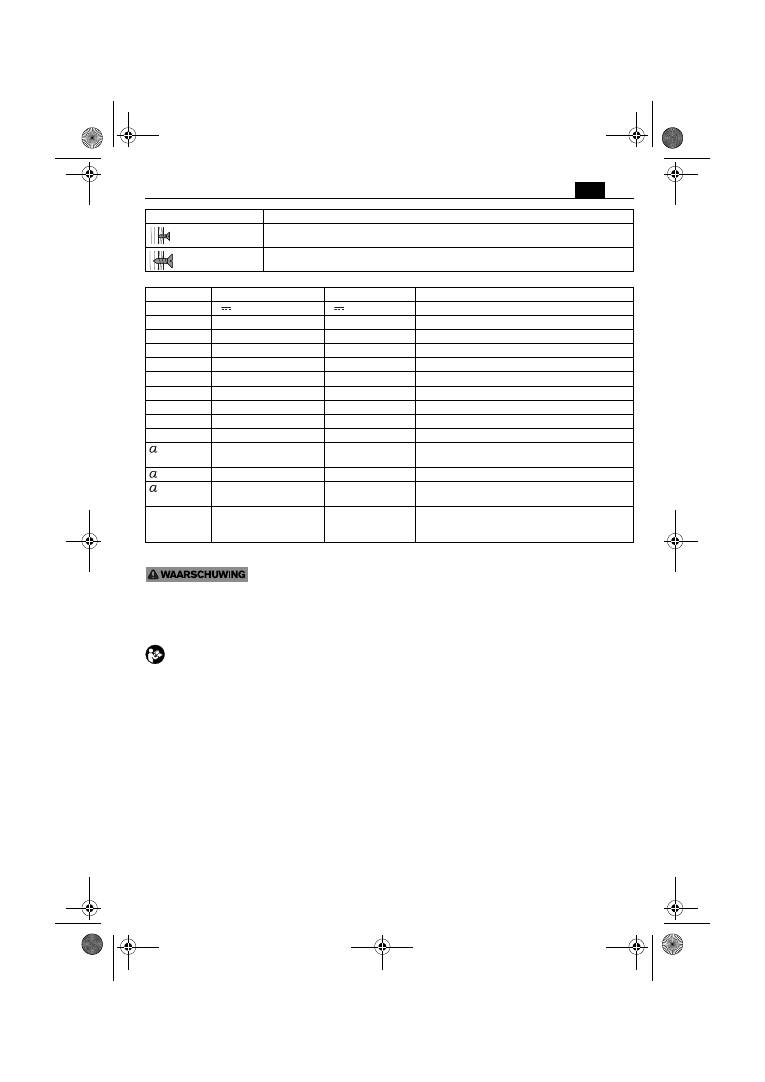
27
nl
Voor uw veiligheid.
Lees alle veiligheidswaar-
schuwingen en alle voor-
schriften.
Als de waarschuwingen en voorschriften niet
worden opgevolgd, kan dit een elektrische schok, brand
of ernstig letsel tot gevolg hebben.
Bewaar alle waarschuwingen en voorschriften voor toe-
komstig gebruik.
Gebruik dit elektrische gereedschap niet voordat u
deze gebruiksaanwijzing en de meegeleverde
„Algemene veiligheidsvoorschriften” (document-
nummer 3 41 30 054 06 1) grondig heeft gelezen en vol-
ledig heeft begrepen. Bewaar deze documentatie voor
later gebruik en geef ze mee wanneer u het elektrische
gereedschap doorgeeft of verkoopt.
Neem ook de geldende nationale arbeidsveiligheidsregels
in acht.
Bestemming van het elektrische gereedschap:
ABS14, ABS18:
handgevoerde boorschroevendraaier voor het in- en uit-
draaien van schroeven, het vast- en losdraaien van moe-
ren, het boren en schroeven in metaal, hout, kunststof en
keramiek en het snijden van schroefdraad met de door
FEIN goedgekeurde inzetgereedschappen en het door
FEIN goedgekeurde toebehoren zonder toevoer van
water in een tegen weersinvloeden beschermde omge-
ving.
ASB14, ASB18:
handgevoerde klopboorschroevendraaier voor het in-
en uitdraaien van schroeven, het vast- en losdraaien van
moeren, het boren en schroeven in metaal, hout, kunst-
stof en keramiek, het snijden van schroefdraad en het
klopboren in beton, steen en metselwerk met de door
FEIN goedgekeurde inzetgereedschappen en het door
FEIN goedgekeurde toebehoren zonder toevoer van
water in een tegen weersinvloeden beschermde omge-
ving.
Bijzondere veiligheidsvoorschriften.
Houd het gereedschap aan de geïsoleerde greepvlakken
vast als u werkzaamheden uitvoert waarbij de schroef
verborgen stroomleidingen kan raken.
Contact met een
onder spanning staande leiding kan ook metalen delen
van het gereedschap onder spanning zetten en tot een
elektrische schok leiden.
Let op verborgen liggende elektrische leidingen en buizen
voor gas en water.
Controleer de werkomgeving voor
het begin van de werkzaamheden, bijvoorbeeld met een
metaaldetector.
Draag persoonlijke beschermende uitrusting. Gebruik
afhankelijk van de toepassing een volledige gezichtsbe-
scherming, oogbescherming of veiligheidsbril. Draag voor
zover van toepassing een stofmasker, een gehoorbe-
scherming, werkhandschoenen of een speciaal schort
dat kleine slijp- en materiaaldeeltjes tegenhoudt.
Uw
ogen moeten worden beschermd tegen wegvliegende
deeltjes die bij verschillende toepassingen ontstaan. Een
stof- of adembeschermingsmasker moet het bij de toe-
passing ontstaande stof filteren. Als u lang wordt blootge-
steld aan luid lawaai, kan uw gehoor worden beschadigd.
Draaimoment verkleinen
Draaimoment vergroten
Teken
Eenheid internationaal
Eenheid nationaal
Verklaring
U
V
V
Elektrische gelijkspanning
f
Hz
Hz
Frequentie
n
0
/min, min
-1
, rpm, r/min
min
-1
Onbelast toerental (bij volledig opgeladen accu)
n
S
/min, min
-1
/min
Aantal slagen
M...
Nm
Nm
Draaimoment (harde/zachte schroefverbinding)
Ø
mm
mm
Diameter van een rond deel
L
pA
dB
dB
Geluidsdrukniveau
L
wA
dB
dB
Geluidsvermogenniveau
L
pCpeak
dB
dB
Piekgeluidsdrukniveau
K...
Onzekerheid
m/s
2
m/s
2
Trillingsemissiewaarde volgens EN 60745
(vectorsom van drie richtingen)
h,D
m/s
2
m/s
2
Gemiddelde trillingswaarde voor boren in metaal
h,ID
m/s
2
m/s
2
Gemiddelde trillingswaarde voor klopboren in
beton
m, s, kg, A, mm, V,
W, Hz, N, °C, dB,
min, m/s
2
m, s, kg, A, mm, V,
W, Hz, N, °C, dB,
min, m/s
2
Basiseenheden en afgeleide eenheden uit het inter-
nationale eenhedenstelsel
SI
.
Symbool, teken
Verklaring
OBJ_BUCH-0000000105-001.book Page 27 Thursday, April 4, 2013 10:23 AM
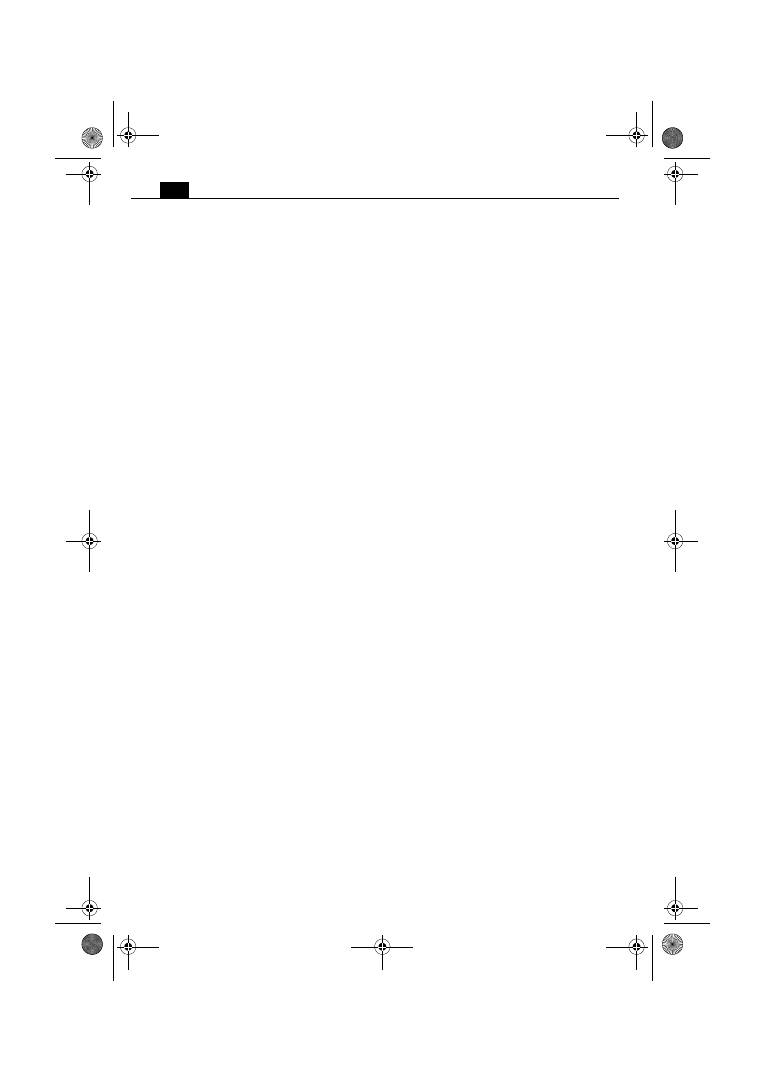
28
nl
Draag een gehoorbescherming bij klopboorwerkzaamhe-
den.
De blootstelling aan lawaai kan gehoorverlies tot
gevolg hebben.
Zet het werkstuk vast.
Een in een spanvoorziening vast-
gezet werkstuk wordt steviger vastgehouden dan in uw
hand.
Houd het elektrische gereedschap goed vast.
Er kunnen
gedurende korte tijd grote reactiemomenten optreden.
Bewerk geen asbesthoudend materiaal.
Asbest geldt als
kankerverwekkend.
Er mogen geen plaatjes of symbolen op het elektrische
gereedschap worden geschroefd of geniet.
Een bescha-
digde isolatie biedt geen bescherming tegen een elektri-
sche schok. Gebruik stickers.
Gebruik geen toebehoren dat niet speciaal door de fabri-
kant van het elektrische gereedschap is ontwikkeld of
vrijgegeven.
Een veilig gebruik is niet alleen gegeven door
het feit dat een toebehoren op uw elektrische gereed-
schap past.
Reinig de ventilatieopeningen van het elektrische gereed-
schap regelmatig met een niet-metalen gereedschap.
De
motorventilator zuigt stof in het machinehuis. Dit kan bij
overmatige ophoping van metaalstof elektrische gevaren
veroorzaken.
Kijk nooit van een korte afstand in het licht van de lamp
van het elektrische gereedschap. Richt het licht van de
lamp nooit op de ogen van andere personen die zich in de
buurt bevinden.
De straling van de lamp kan schadelijk
zijn voor het oog.
Richt het elektrische gereedschap nooit op uzelf, andere
personen of dieren.
Er bestaat verwondingsgevaar door
scherpe of hete inzetgereedschappen.
Gebruik en behandeling van de accu (accublok).
Ter voorkoming van gevaren, zoals brandwonden, brand,
explosie, huidletsel en ander letsel bij de omgang met de
accu, dient u de volgende aanwijzingen in acht te nemen:
Accu’s mogen niet gedemonteerd, geopend of gefrag-
menteerd worden. Stel de accu’s niet bloot aan mechani-
sche schokken.
Bij beschadiging en onjuist gebruik van de
accu kunnen er schadelijke dampen en vloeistoffen vrij-
komen. De dampen kunnen de luchtwegen irriteren.
Gelekte accuvloeistof kan tot huidirritaties en brandwon-
den leiden.
Als de uit de accu gelekte vloeistof naburige voorwerpen
heeft bevochtigd, dient u de desbetreffende delen te con-
troleren, te reinigen en indien nodig te vervangen.
Stel de accu niet bloot aan hitte of vuur. Bewaar de accu
niet in fel zonlicht.
Verwijder de accu pas uit de originele verpakking als
deze moet worden gebruikt.
Neem de accu vóór werkzaamheden aan het elektrische
gereedschap uit het gereedschap.
Als het elektrische
gereedschap onbedoeld begint te lopen, bestaat er ver-
wondingsgevaar.
Verwijder de accu alleen als het elektrische gereedschap
uitgeschakeld is.
Houd kinderen uit de buurt van accu’s.
Houd de accu schoon en bescherm deze tegen vocht en
water.
Reinig de vuil geworden aansluitingen van de accu
en van het elektrische gereedschap met een droge,
schone doek.
Gebruik alleen intacte, originele FEIN-accu’s, die voor uw
elektrische gereedschap bestemd zijn.
Bij het werken
met en het opladen van verkeerde, beschadigde, gerepa-
reerde of opgeknapte accu’s, nabootsingen en accu’s van
andere merken bestaat brandgevaar en/of explosiegevaar.
Volg de veiligheidsvoorschriften in de gebruiksaanwijzing
van de acculader op.
Hand- en armtrillingen
Het in deze gebruiksaanwijzing vermelde trillingsniveau is
gemeten met een volgens EN 60745 genormeerde meet-
methode en kan worden gebruikt om elektrische gereed-
schappen met elkaar te vergelijken. Deze is ook geschikt
voor een voorlopige inschatting van de trillingsbelasting.
Het aangegeven trillingsniveau representeert de hoofdza-
kelijke toepassingen van het elektrische gereedschap. Als
echter het elektrische gereedschap wordt gebruikt voor
andere toepassingen, met afwijkende inzetgereedschap-
pen of onvoldoende onderhoud, kan het trillingsniveau
afwijken. Dit kan de trillingsbelasting gedurende de
gehele arbeidsperiode duidelijk verhogen.
Voor een nauwkeurige schatting van de trillingsbelasting
moet ook rekening worden gehouden met de tijd waarin
het gereedschap uitgeschakeld is, of waarin het gereed-
schap wel loopt, maar niet werkelijk wordt gebruikt. Dit
kan de trillingsbelasting gedurende de gehele arbeidspe-
riode duidelijk verminderen.
Leg extra veiligheidsmaatregelen ter bescherming van de
bediener tegen het effect van trillingen vast, zoals: onder-
houd van elektrische gereedschappen en inzetgereed-
schappen, warm houden van de handen, organisatie van
het arbeidsproces.
Omgang met gevaarlijke stoffen
Bij werkzaamheden voor materiaalafname met dit
gereedschap ontstaat stof dat gevaarlijk kan zijn.
Aanraken of inademen van sommige soorten stof, bij-
voorbeeld van asbest en asbesthoudende materialen,
loodhoudende verf, metaal, sommige houtsoorten,
mineralen, silicaatdeeltjes van steenhoudende materialen,
verfoplosmiddelen, houtbeschermingsmiddelen en aan-
groeiwering voor watervoertuigen kan bij personen
allergische reacties, ademwegziekten, kanker en/of
voortplantingsdefecten tot gevolg hebben. Het risico
door de inademing van stof is afhankelijk van de bloot-
stelling. Gebruik een op de vrijkomende stofsoort afge-
stemde afzuiging en persoonlijke veiligheidsuitrusting en
zorg voor een goede ventilatie van de werkplek. Laat de
bewerking van asbesthoudend materiaal over aan een
vakman.
Houtstof en lichtmetaalstof, hete mengsels van schuur-
stof en chemische stoffen kunnen onder ongunstige
omstandigheden zelf tot ontsteking komen of een explo-
sie veroorzaken. Voorkom wegvliegende vonken in de
richting van het stofreservoir en oververhitting van het
elektrische gereedschap en het schuurmateriaal. Maak het
stofreservoir op tijd leeg. Neem de bewerkingsvoor-
schriften van de fabrikant van het materiaal en de in uw
land geldige voorschriften voor de te bewerken materia-
len in acht.
OBJ_BUCH-0000000105-001.book Page 28 Thursday, April 4, 2013 10:23 AM
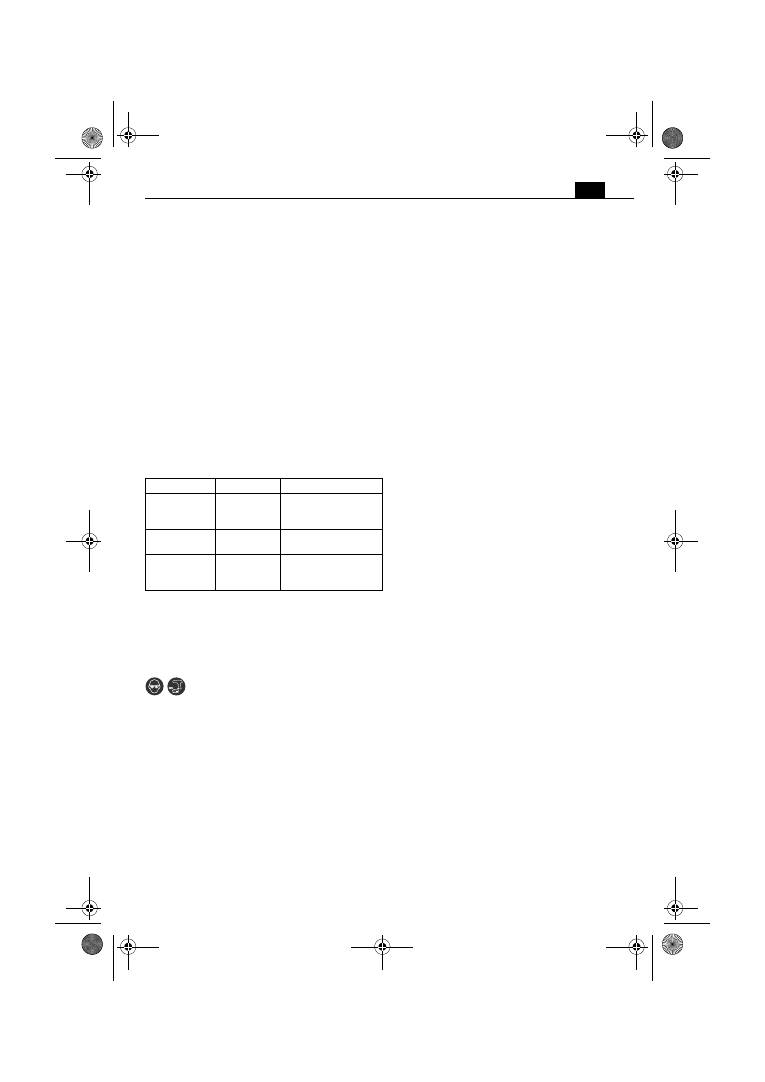
29
nl
Bedieningsvoorschriften.
Bedien de draairichtingomschakelaar en de toerental-
schakelaar alleen als de motor stilstaat.
Duw de toerentalschakelaar of draai de functieschakelaar
(ASB14/18) altijd tot deze niet meer verder kan. Anders
kan het elektrische gereedschap beschadigd worden.
Bij overbelasting wordt het elektrische gereedschap uit-
geschakeld.
Breng de draarichtingomschakelaar in de middelste stand
ter voorkoming van onbedoelde inbedrijfstelling, bijv. tij-
dens het vervoer.
Draaimoment instellen
De fabrieksinstelling komt overeen met het bereik voor
kleine tot middelgrote schroeven.
Het aandraaimoment is ook afhankelijk van de kracht
waarmee het elektrische gereedschap tegen de schroef
wordt geduwd.
Omgang met de accu.
De accu mag alleen worden gebruikt en opgeladen in
het bedrijfstemperatuurbereik van 0 °C – 45 °C (32 °F –
113 °F). De accutemperatuur moet bij het begin van het
opladen binnen het bedrijfstemperatuurbereik liggen.
Het werkelijke oplaadpercentage van de accu wordt
alleen weergegeven als de motor van het elektrische
gereedschap stilstaat.
Voordat de accu helemaal leeg is, stopt de elektronica
automatisch de motor.
Onderhoud en klantenservice.
Onder extreme gebruiksomstandigheden kan
bij het bewerken van metalen geleidend stof in
het elektrische gereedschap terechtkomen.
Blaas het inwendige van het elektrische gereedschap via
de ventilatieopeningen met droge en olievrije perslucht
uit.
De actuele onderdelenlijst van dit elektrische gereed-
schap vindt u op www.fein.com.
De volgende delen kunt u indien nodig zelf vervangen:
inzetgereedschappen, accu
Wettelijke garantie en fabrieksgarantie.
De wettelijke garantie op het product geldt overeenkom-
stig de wettelijke regelingen in het land waar het product
wordt verkocht. Bovendien biedt FEIN garantie overeen-
komstig de FEIN-fabrieksgarantieverklaring.
Het is mogelijk dat bij het elektrische gereedschap slechts
een deel van het in deze gebruiksaanwijzing beschreven
en afgebeelde toebehoren wordt meegeleverd.
Conformiteitsverklaring.
De firma FEIN verklaart als alleen verantwoordelijke dat
dit product overeenstemt met de geldende bepalingen
die op de laatste pagina van deze gebruiksaanwijzing ver-
meld staan.
Technische documentatie bij: C. & E. FEIN GmbH,
C-DB_IA, D-73529 Schwäbisch Gmünd
Milieubescherming en afvoer van afval.
Voer verpakkingen, versleten elektrische gereedschap-
pen en toebehoren op een voor het milieu verant-
woorde wijze af.
Accu’s alleen in lege toestand naar een daarvoor aange-
wezen verwerkingsplaats brengen.
Accu’s die niet helemaal leeg zijn, moeten ter voorko-
ming van kortsluiting van de insteekverbindingen met
plakband worden geïsoleerd.
LED-indicatie
Betekenis
Actie
1 – 4 groene
LED’s
Oplaadtoe-
stand in pro-
centen
Gebruik
Rood perma-
nent licht
Accu is bijna
leeg
Accu opladen
Rood knipper-
licht
Accu is niet
gereed voor
gebruik
Accu in bedrijfstempe-
ratuurbereik brengen
en vervolgens opladen
OBJ_BUCH-0000000105-001.book Page 29 Thursday, April 4, 2013 10:23 AM
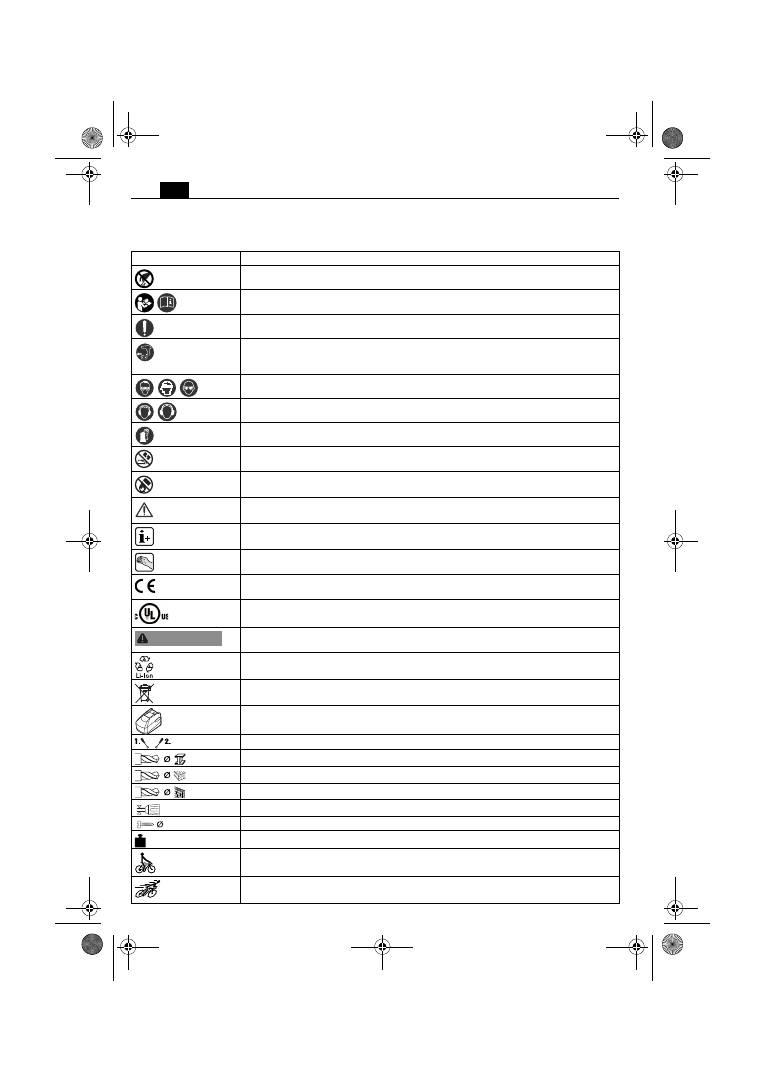
30
es
es
Manual original.
Simbología, abreviaturas y términos empleados.
Símbolo
Definición
No tocar las piezas en rotación de la herramienta eléctrica.
Es imprescindible leer los documentos que se adjuntan, como las instrucciones de servicio
y las instrucciones generales de seguridad.
¡Seguir las instrucciones indicadas al margen!
Antes de efectuar el trabajo descrito retire primero el acumulador de la herramienta eléc-
trica. De lo contrario, podría accidentarse al ponerse en marcha fortuitamente la herra-
mienta eléctrica.
Al trabajar protegerse los ojos.
Al trabajar utilizar un protector acústico.
Al trabajar utilizar una protección para las manos.
No cargue baterías defectuosas.
No exponga el acumulador al fuego. Proteja el acumulador del calor, p. ej., de una expo-
sición prolongada al sol.
¡Seguir las instrucciones indicadas al margen!
Información complementaria.
Área de agarre
Atestigua la conformidad de la herramienta eléctrica con las directivas de la Comunidad
Europea.
Este símbolo confirma que este producto ha sido certificado en USA y Canadá.
Este símbolo advierte sobre una situación peligrosa que puede comportar lesiones graves
o mortales.
Símbolo de reciclaje: identifica los materiales reutilizables
Acumular por separado las herramientas eléctricas y demás productos electrotécnicos y
eléctricos inservibles y someterlos a un reciclaje ecológico.
Tipo de acumulador
1
a
velocidad/2
a
velocidad
Diámetro de taladro en acero
Diámetro de taladro en madera
Diámetro de taladro en piedra
Capacidad de sujeción del portabrocas
Diámetro del tornillo
Peso según EPTA-Procedure 01/2003
Bajas revoluciones
Altas revoluciones
ADVERTENCIA
Fe
OBJ_BUCH-0000000105-001.book Page 30 Thursday, April 4, 2013 10:23 AM
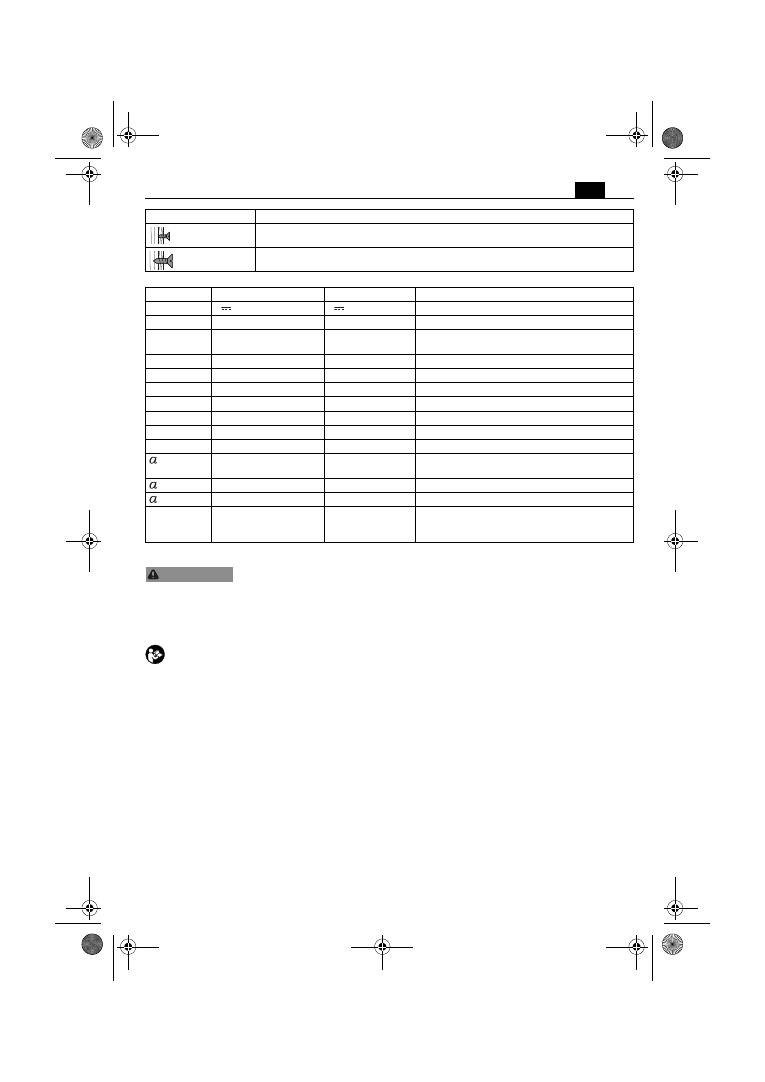
31
es
Para su seguridad.
Lea íntegramente estas adverten-
cias de peligro e instrucciones.
En
caso de no atenerse a las advertencias de seguridad
siguientes, ello puede ocasionar una descarga eléctrica, un
incendio y/o lesión grave.
Guardar todas las advertencias de peligro e instrucciones
para futuras consultas.
No utilice esta herramienta eléctrica sin haber leído
con detenimiento y haber entendido íntegramente
estas instrucciones de servicio, así como las “Ins-
trucciones generales de seguridad” (nº de documento
3 41 30 054 06 1) adjuntas. Guarde la documentación
citada para posteriores consultas y entrégueselas al usua-
rio en caso de prestar o vender la herramienta eléctrica.
Observe también las respectivas prescripciones contra
accidentes de trabajo vigentes en su país.
Utilización reglamentaria de la herramienta
eléctrica:
ABS14, ABS18:
taladro atornillador portátil para uso con útiles y acceso-
rios homologados por FEIN sin aportación de agua en
lugares cubiertos para enroscar y desenroscar tornillos y
tuercas y para taladrar y atornillar en metal, madera, plás-
tico y cerámica, así como para roscar.
ASB14, ASB18:
taladro percutor atornillador portátil para uso con útiles
y accesorios homologados por FEIN sin aportación de
agua en lugares cubiertos para enroscar y desenroscar
tornillos y tuercas y para taladrar y atornillar en metal,
madera, plástico y cerámica, así como para roscar y tala-
drar con percusión en hormigón, piedra y ladrillo.
Instrucciones de seguridad especiales.
Sujete la herramienta eléctrica por las superficies de
agarre aisladas al realizar trabajos en los que el tornillo
pueda llegar a tocar conductores eléctricos ocultos.
El
contacto con conductores bajo tensión puede hacer que
las partes metálicas del aparato le provoquen una des-
carga eléctrica.
Preste atención a los conductores eléctricos y a las tube-
rías de agua y gas ocultas.
Antes de comenzar a trabajar
explore la zona de trabajo, p. ej., con un detector de
metales.
Utilice un equipo de protección personal. Dependiendo
del trabajo a realizar use una careta, una protección para
los ojos, o unas gafas de protección. Si procede, emplee
una mascarilla antipolvo, protectores auditivos, guantes
de protección o un mandil especial adecuado para prote-
gerle de los pequeños fragmentos que pudieran salir pro-
yectados al desprenderse del útil o pieza.
Las gafas de
protección deberán ser indicadas para protegerle de los
fragmentos que pudieran salir despedidos al trabajar. La
mascarilla antipolvo o respiratoria deberá ser apta para fil-
trar las partículas producidas al trabajar. La exposición
prolongada al ruido puede provocar sordera.
Colóquese un protector acústico al percutir.
El efecto del
ruido le puede provocar sordera.
Asegure la pieza de trabajo.
Una pieza de trabajo queda
sujeta de forma mucho más segura con un dispositivo de
fijación que con la mano.
Reducción del par de apriete
Aumento del par de apriete
Símbolo
Unidad internacional
Unidad nacional
Definición
U
V
V
Tensión continua
f
Hz
Hz
Frecuencia
n
0
/min, min
-1
, rpm, r/min
rpm
Revoluciones en vacío (con acumulador plena-
mente cargado)
n
S
/min, min
-1
/min
Frecuencia de percusión
M...
Nm
Nm
Par de giro (unión atornillada rígida/blanda)
Ø
mm
mm
Diámetro de una pieza redonda
L
pA
dB
dB
Nivel de presión sonora
L
wA
dB
dB
Nivel de potencia acústica
L
pCpeak
dB
dB
Valor máx. de nivel sonoro
K...
Inseguridad
m/s
2
m/s
2
Valor de vibraciones emitidas según EN 60745
(suma vectorial de tres direcciones)
h,D
m/s
2
m/s
2
promedio de vibraciones al taladrar en metal
h,ID
m/s
2
m/s
2
promedio de vibraciones al percutir en hormigón
m, s, kg, A, mm, V,
W, Hz, N, °C, dB,
min, m/s
2
m, s, kg, A, mm, V,
W, Hz, N, °C, dB,
min, m/s
2
Unidades básicas y unidades derivadas del sistema
internacional de unidades
SI
.
Símbolo
Definición
ADVERTENCIA
OBJ_BUCH-0000000105-001.book Page 31 Thursday, April 4, 2013 10:23 AM
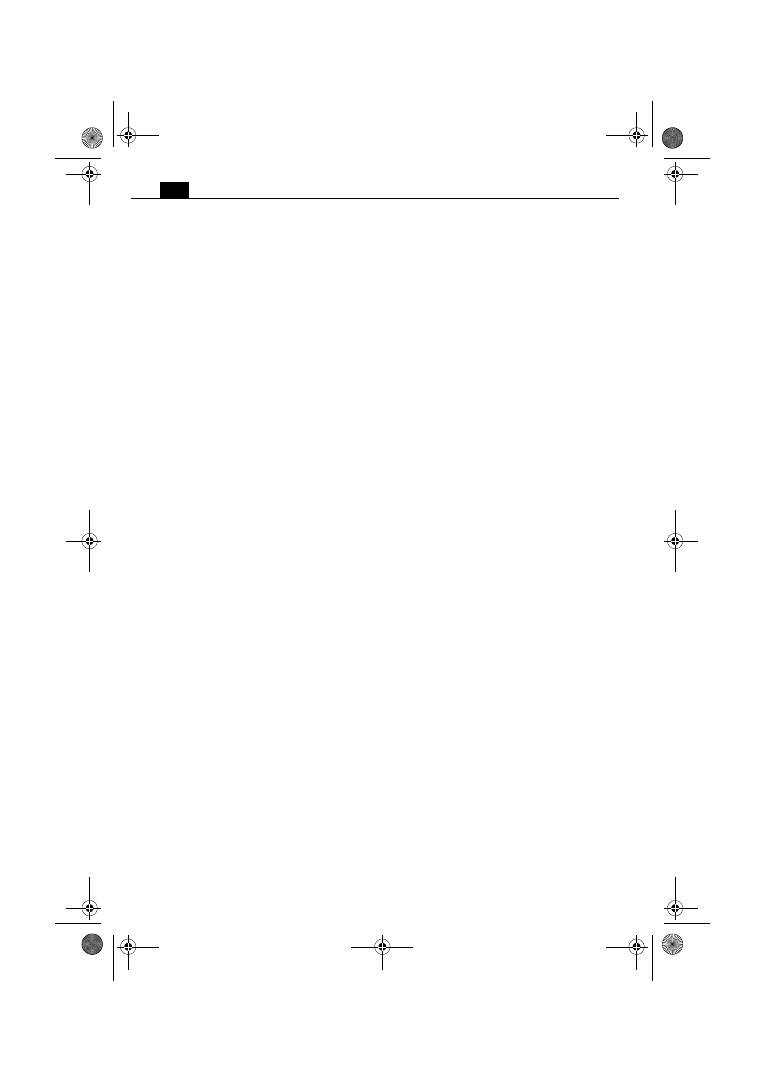
32
es
Sujete firmemente la herramienta eléctrica.
Pueden pre-
sentarse súbitamente unos altos pares de reacción.
No trabaje materiales que contengan amianto.
El amianto
es cancerígeno.
Esta prohibido fijar rótulos o señales a la herramienta
eléctrica con tornillos o remaches.
Un aislamiento daña-
do no le protege de una electrocución. Emplee etiquetas
autoadhesivas.
No use accesorios que no hayan sido especialmente
desarrollados u homologados por el fabricante de la
herramienta eléctrica.
El mero hecho de que sea monta-
ble un accesorio en su herramienta eléctrica no es garan-
tía de que su funcionamiento sea seguro.
Limpie periódicamente las rejillas de refrigeración de la
herramienta eléctrica empleando herramientas que no
sean de metal.
El ventilador del motor aspira polvo hacia
el interior de la carcasa. En caso de acumularse polvo de
metal en exceso, ello puede provocar al usuario una des-
carga eléctrica.
Jamás mire a poca distancia hacia la luz de la lámpara de
la herramienta eléctrica. Nunca dirija la luz de la lámpara
contra los ojos de otras personas que se encuentren
cerca.
La radiación que emite la lámpara puede ser dañina
para la vista.
No oriente la herramienta eléctrica contra Ud. mismo,
contra otras personas, ni contra animales.
Podría acci-
dentarse con los útiles afilados o muy calientes.
Utilización y trato de acumuladores
(conjunto acumulador).
Para no exponerse a un riesgo de quemadura, incendio,
explosión, lesiones de la piel o de otro tipo, al manipular
acumuladores, aténgase a las siguientes indicaciones:
Los acumuladores no deben desarmarse, abrirse, ni frac-
cionarse. Evite golpear los acumuladores.
Si el acumula-
dor se daña o usa de forma inapropiada puede que se
emanen vapores nocivos o se fugue líquido. Los vapores
pueden irritar las vías respiratorias. El líquido del acumu-
lador puede irritar la piel o producir quemaduras.
Si el líquido que se ha fugado del acumulador ha conta-
minado las piezas adyacentes, controle dichas piezas y
límpielas o sustitúyalas, si procede.
No exponga el acumulador ni al calor ni al fuego. No
exponga el acumulador directamente al sol.
Únicamente saque el acumulador del embalaje original
en el momento que desee utilizarlo.
Desmonte el acumulador antes de manipular en la herra-
mienta eléctrica.
La puesta en marcha fortuita de la herra-
mienta eléctrica puede causar un accidente.
Solamente desmonte el acumulador estando desconec-
tada la herramienta eléctrica.
Mantenga los acumuladores fuera del alcance de los
niños.
Mantenga limpio el acumulador y protéjalo de la hume-
dad y del agua.
Si los contactos del acumulador y de la
herramienta eléctrica están sucios límpielos con un paño
seco y limpio.
Solamente use los acumuladores originales FEIN previs-
tos para su herramienta eléctrica.
Si se utilizan o recar-
gan acumuladores incorrectos, dañados, reparados,
recuperados, imitaciones o de otra marca, existe el riesgo
de incendio y/o de explosión.
Aténgase a las instrucciones de seguridad mencionadas
en las instrucciones de uso del cargador del acumulador.
Vibraciones en la mano/brazo
El nivel de vibraciones indicado en estas instrucciones ha
sido determinado según el procedimiento de medición
fijado en la norma EN 60745 y puede servir como base
de comparación con otras herramientas eléctricas. Tam-
bién es adecuado para estimar provisionalmente la emi-
sión de vibraciones.
El nivel de vibraciones indicado ha sido determinado para
las aplicaciones principales de la herramienta eléctrica.
Por ello, el nivel de vibraciones puede ser diferente si la
herramienta eléctrica se utiliza en otras aplicaciones, con
útiles diferentes, o si el mantenimiento de la misma fuese
deficiente. Ello puede suponer un aumento drástico de la
emisión de vibraciones durante el tiempo total de trabajo.
Para determinar con exactitud la emisión de las vibracio-
nes, es necesario considerar también aquellos tiempos en
los que el aparato esté desconectado, o bien, esté en fun-
cionamiento, pero sin ser utilizado realmente. Ello puede
suponer una disminución drástica de la emisión de vibra-
ciones durante el tiempo total de trabajo.
Fije unas medidas de seguridad adicionales para proteger
al usuario de los efectos por vibraciones, como por ejem-
plo: Mantenimiento de la herramienta eléctrica y de los
útiles, conservar calientes las manos, organización de las
secuencias de trabajo.
Manipulación con materiales peligrosos
Al trabajar con esta herramienta en desbaste de material
se genera polvo que puede ser peligroso.
El contacto o inspiración de ciertos materiales en polvo
como, p. ej., el amianto o los materiales que lo conten-
gan, pinturas con plomo, metales, ciertos tipos de
madera, minerales, partículas de sílice de materiales a base
de mineral, disolventes de pintura, conservadores de la
madera y antifouling para embarcaciones puede provocar
en las personas reacciones alérgicas y/o enfermedades
respiratorias, cáncer, daños congénitos o trastornos
reproductivos. El riesgo derivado de la inspiración de
material en polvo depende de la frecuencia de exposición
al mismo. Utilice un sistema de aspiración apropiado para
el polvo producido en combinación con un equipo de
protección personal y cuide que esté bien ventilado el
puesto de trabajo. Se recomienda que los materiales que
contengan amianto sean procesados por especialistas.
El polvo de madera y el de aleaciones ligeras, así como la
mezcla de sustancias químicas con material en polvo
caliente pueden llegar a autoinflamarse o provocar una
explosión. Evite el salto de chispas en dirección al depó-
sito de polvo así como el sobrecalentamiento de la herra-
mienta eléctrica y de la pieza a lijar, vacíe con suficiente
antelación el depósito de polvo, respete las instrucciones
de trabajo del fabricante del material y las prescripciones
vigentes en su país sobre los materiales a trabajar.
OBJ_BUCH-0000000105-001.book Page 32 Thursday, April 4, 2013 10:23 AM

33
es
Indicaciones para el manejo.
Únicamente accione los selectores del sentido de giro y
de velocidad con el motor detenido.
Siempre empuje a fondo el selector de velocidad o gire
hasta el tope el selector del modo de operación
(ASB14/18). De lo contrario podría dañarse la herra-
mienta eléctrica.
La herramienta eléctrica se desconecta en caso de sobre-
cargarla.
Coloque el selector de sentido de giro en la posición cen-
tral para evitar una puesta en marcha accidental, p. ej.,
durante el transporte.
Ajuste del par de giro
El ajuste de fábrica corresponde al margen para tornillos
pequeños a medianos.
El par de apriete alcanzado depende además de la fuerza
de aplicación con la que es presionada la herramienta
eléctrica contra el tornillo.
Trato del acumulador.
Únicamente utilice y cargue el acumulador si su tempera-
tura se encuentra dentro del margen de operación de
0 °C – 45 °C (32 °F – 113 °F). Al comenzar a cargar el acu-
mulador su temperatura deberá estar dentro del margen
especificado para su operación.
El porcentaje del estado de carga real del acumulador
solamente se indica estando detenido el motor de la
herramienta eléctrica.
Antes de que el acumulador llegue a descargarse excesi-
vamente, el sistema electrónico desconecta el motor de
forma automática.
Reparación y servicio técnico.
En caso de trabajar metales bajo unas condicio-
nes extremas puede llegar a depositarse polvo
conductor de corriente en el interior de la
herramienta eléctrica. Sople con frecuencia desde afuera
aire comprimido seco y exento de aceite por las rejillas
de refrigeración para limpiar el interior de la herramienta
eléctrica.
La lista de piezas de refacción actual para esta herramienta
eléctrica la encuentra en internet bajo www.fein.com.
Si fuese preciso, puede sustituir Ud. mismo las piezas
siguientes:
útiles, acumulador
Garantía.
La garantía del producto se realiza de acuerdo a las regu-
laciones legales vigentes en el país de adquisición. Adicio-
nalmente, FEIN ofrece una garantía ampliada de acuerdo
con la declaración de garantía del fabricante FEIN.
El material de serie suministrado con su herramienta eléc-
trica puede que no corresponda en su totalidad al mate-
rial descrito o mostrado en estas instrucciones de
servicio.
Declaración de conformidad.
La empresa FEIN declara bajo su propia responsabilidad
que este producto cumple con las disposiciones pertinen-
tes detalladas en la última página de estas instrucciones de
servicio.
Expediente técnico en: C. & E. FEIN GmbH, C-DB_IA,
D-73529 Schwäbisch Gmünd
Protección del medio ambiente,
eliminación.
Los embalajes, y las herramientas eléctricas y accesorios
inservibles deberán entregarse a los puntos de recogida
correspondientes para que puedan ser sometidos a un
reciclaje ecológico.
Únicamente entregue acumuladores que estén descarga-
dos a un punto de recogida regularizado.
Si los acumuladores no estuviesen totalmente descarga-
dos aisle sus contactos con cinta adhesiva para prevenir
un posible cortocircuito.
Indicador
LED
Significado
Acción
1 – 4 LED
verdes
Nivel porcen-
tual de carga
Operación
Luz roja
permanente
Acumulador
casi vacío
Cargar acumulador
Luz roja
intermi-
tente
El acumulador
no está listo
para funcionar
Procure que la tempera-
tura del acumulador se
encuentre dentro del
margen de operación, y
cárguelo a continuación
OBJ_BUCH-0000000105-001.book Page 33 Thursday, April 4, 2013 10:23 AM

34
pt
pt
Manual de instruções original.
Símbolos utilizados, abreviações e termos.
Símbolo, sinal
Explicação
Não entrar em contacto com as peças em rotação da ferramenta eléctrica.
É imprescindível ler os documentos em anexo, portanto a instrução de serviço e as indi-
cações gerais de segurança.
Trabalhar de acordo com as indicações dos textos ou dos gráficos ao lado!
Remover o acumulador da ferramenta eléctrica antes desta etapa de trabalho. Caso con-
trário, há risco de lesões, devido a um arranque involuntário da ferramenta eléctrica.
Usar protecção para os olhos durante o trabalho.
Usar protecção auricular durante o trabalho.
Usar luvas durante o trabalho.
Não carregar acumuladores danificados.
Não expor o acumulador ao fogo. Proteger o acumulador contra calor, p. ex. também
contra uma permanente radiação solar.
Observar as notas no texto adjacente!
Informação adicional
Superfície de preensão
Autentica a conformidade da ferramenta eléctrica em relação às directivas da Comunidade
Européia.
Este símbolo confirma o certificação deste produto nos EUA e no Canadá.
Esta nota indica uma situação possivelmente perigosa, que pode levar a graves lesões ou
até à morte.
Símbolo de reciclagem: Materiais marcados como reutilizáveis
Ferramentas eléctricas velhas e outros produtos electrotécnicos e eléctricos devem ser
separados e reciclados de forma ecológica.
Tipo de acumulador
1. marcha/2ª marcha
Diâmetro de perfuração em aço
Diâmetro de perfuração em madeira
Diâmetro de perfuração em pedra
Faixa de aperto do mandril
Diâmetro do parafuso
Peso conforme EPTA-Procedure 01/2003
Pequeno n° de rotações
Grande n° de rotações
Fe
OBJ_BUCH-0000000105-001.book Page 34 Thursday, April 4, 2013 10:23 AM
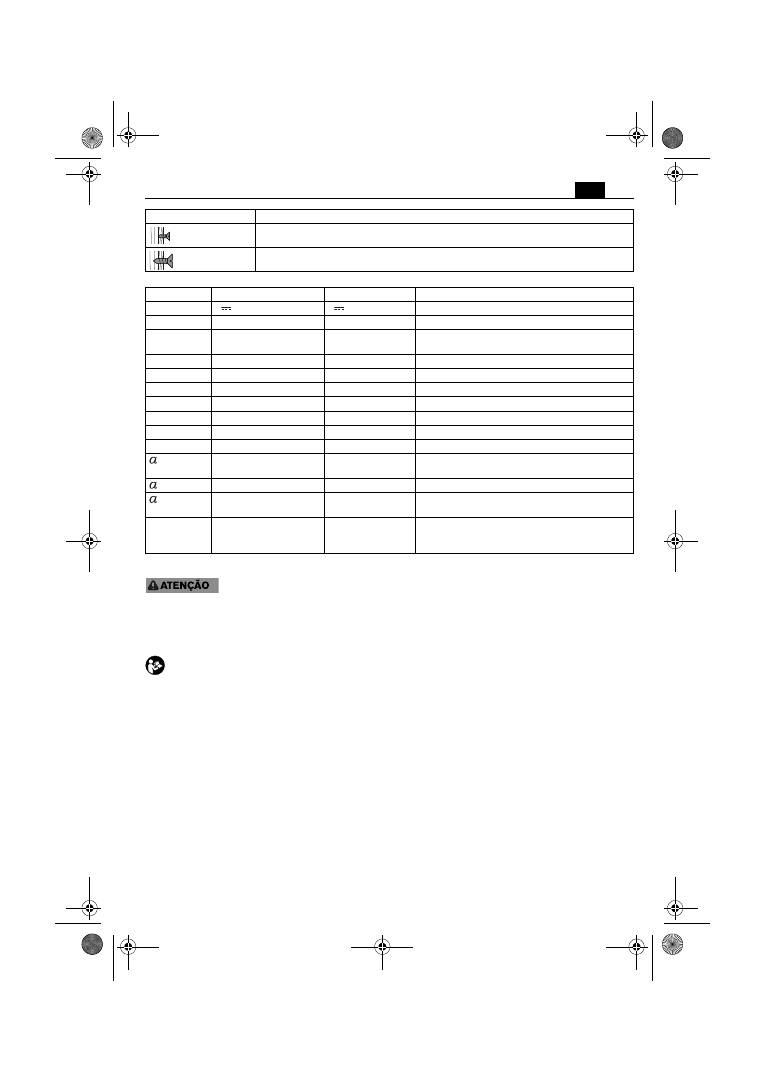
35
pt
Para a sua segurança.
Devem ser lidas todas as indicações
de advertência e todas as instruções.
O desrespeito às advertências e instruções apresentadas
abaixo pode causar choque eléctrico, incêndio e/ou gra-
ves lesões.
Guarde bem todas as advertências e instruções para
futura referência.
Não utilizar esta ferramenta eléctrica antes de ter
lido atentamente e compreendido a Instrução de
serviço e as “Indicações gerais de segurança”
(número de documento 3 41 30 054 06 1) fornecidas
com o aparelho. A documentação mencionada deve ser
guardada para futura referência e deve ser entregue com
a ferramenta eléctrica caso esta for passada a diante ou
vendida.
Observar também as respectivas directivas de protecção
de trabalho.
Finalidade da ferramenta:
ABS14, ABS18:
Berbequim manual para atarraxar e desatarraxar parafu-
sos e porcas e para furar e aparafusar em metal, madeira,
plástico e cerâmica, assim como para abrir roscas com as
ferramentas de trabalho e acessórios autorizados pela
FEIN, sem adução de água, em áreas protegidas contra
intempéries.
ASB14, ASB18:
Berbequim de percussão manual para atarraxar e desatar-
raxar parafusos e porcas e para furar e aparafusar em
metal, madeira, plástico e cerâmica, assim como para abrir
roscas e para furar com percussão em betão com as fer-
ramentas de trabalho e acessórios autorizados pela FEIN,
sem adução de água, em áreas protegidas contra intempé-
ries.
Indicações especiais de segurança.
Tenere l’apparecchio per le superfici isolate dell’impug-
natura qualora venissero effettuati lavori durante i quali
la vite potrebbe venire a contatto con cavi elettrici nas-
costi.
O contacto com um cabo sob tensão também pode
colocar sob tensão as peças metálicas do aparelho e levar
a um choque eléctrico.
Tenha atenção com cabos eléctricos, tubos de gás e de
água escondidos.
Controlar a área de trabalho com p. ex.
um detector de metal, antes de iniciar o trabalho.
Utilizar um equipamento de protecção pessoal. De acordo
com a aplicação, deverá utilizar uma protecção para todo
o rosto, protecção para os olhos ou um óculos protector.
Se for necessário, deverá utilizar uma máscara contra pó,
protecção auricular, luvas de protecção ou um avental
especial, para proteger-se de pequenas partículas de
amoladura e de material.
Os olhos devem ser protegidos
contra partículas a voar, produzidas durante as diversas
aplicações. A máscara contra pó ou a máscara de respira-
ção deve ser capaz de filtrar o pó produzido durante a
respectiva aplicação. Se for sujeito durante longo tempo
a fortes ruídos, poderá sofrer a perda da capacidade audi-
tiva.
Usar protecção auricular ao furar com percussão.
Ruídos
podem provocar a perda da audição.
Reduzir o binário
Aumentar o binário
Sinal
Unidade internacional
Unidade nacional
Explicação
U
V
V
Tensão eléctrica contínua
f
Hz
Hz
Frequência
n
0
/min, min
-1
, rpm, r/min
rpm
Número de rotações em vazio (com o acumulador
completamente carregado)
n
S
/min, rpm
/min
N° de percussões
M...
Nm
Nm
Binário (Aparafusamento duro/suave)
Ø
mm
mm
Diâmetro para uma peça redonda
L
pA
dB
dB
Nível de pressão acústica
L
wA
dB
dB
Nível da potência acústica
L
pCpeak
dB
dB
Máximo nível de pressão acústica
K...
Aceleração
m/s
2
m/s
2
Valor de emissão de oscilações conforme
EN 60745 (soma dos vectores das três direcções)
h,D
m/s
2
m/s
2
Médio valor de vibrações para furar em metal
h,ID
m/s
2
m/s
2
Médio valor de vibrações para furar com percussão
em betão
m, s, kg, A, mm, V,
W, Hz, N, °C, dB,
min, m/s
2
m, s, kg, A, mm, V,
W, Hz, N, °C, dB,
min, m/s
2
Unidades básicas e deduzidas do sistema de unida-
des internacional
SI
.
Símbolo, sinal
Explicação
OBJ_BUCH-0000000105-001.book Page 35 Thursday, April 4, 2013 10:23 AM
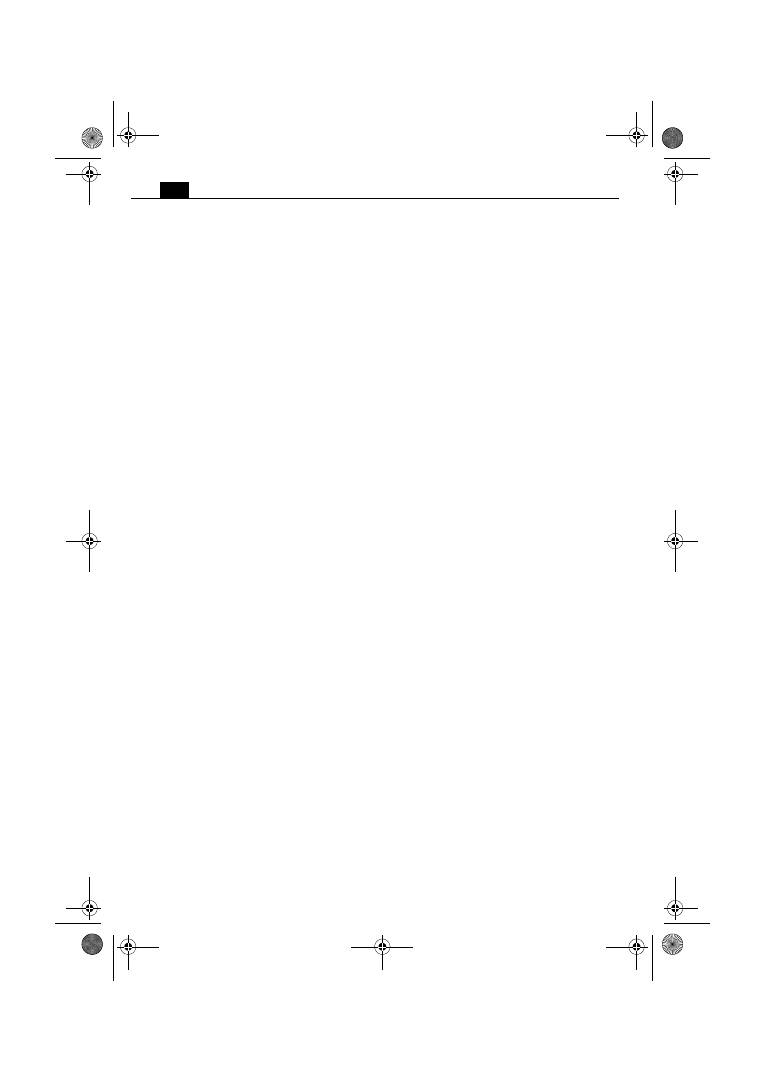
36
pt
Fixar a peça a ser trabalhada.
Uma peça a ser trabalhada
fixa através de um dispositivo de fixação está mais firme
do que segurado com as mãos.
Segurar a ferramenta eléctrica com firmeza.
Podem
ocorrer por instantes altos momentos de reacção.
Não processar material que contenha asbesto.
Asbesto é
considerado como sendo cancerígeno.
É proibido aparafusar ou rebitar placas e símbolos na fer-
ramenta eléctrica.
Um isolamento danificado não ofe-
rece qualquer protecção contra choques eléctricos.
Utilizar placas adesivas.
Não utilizar acessórios que não foram especialmente
desenvolvidos ou homologados pelo fabricante da ferra-
menta eléctrica.
Um funcionamento seguro não é asse-
gurado apenas por um acessório apropriado para a sua
ferramenta eléctrica.
Limpar em intervalos regulares as aberturas de ventila-
ção da ferramenta eléctrica com ferramentas não-metá-
licas.
O ventilador do motor puxa pó para dentro da
caixa da máquina. Um acúmulo excessivo de pó de metal
pode causar perigos eléctricos.
Jamais olhar directamente na luz da lâmpada da ferra-
menta eléctrica a partir de curtas distâncias. Jamais
apontar a luz da lâmpada na direcção dos olhos de outras
pessoas, que se encontrem nas proximidades.
A radiação
produzida pela lâmpada prejudica os olhos.
Não apontar a ferramenta eléctrica na sua direcção, nem
na direcção de outras pessoas ou animais.
Há perigo de
lesões devido a ferramentas de trabalho afiadas ou quen-
tes.
Utilização e tratamento do acumulador
(bloco de acumulador).
Para evitar perigos como queimaduras, incêndio, explo-
são, lesões na pele e outras lesões durante o manuseio
do acumulador, devem ser observados as seguintes indi-
cações:
Os acumuladores não devem ser desmontados, abertos
nem decompostos. Os acumuladores não devem ser
expostos a golpes mecânicos.
Em caso de danos e de uti-
lização incorrecta do acumulador, podem escapar vapo-
res e líquidos nocivos. É possível que os vapores irritem
as vias respiratórias. Líquido do acumulador a escapar
pode levar a irritações da pele ou queimaduras.
Se o líquido que escapa do acumulador danificado entrar
em contacto com objectos que se encontrem por perto,
deverá controlar os devidos objectos e, se necessário,
limpá-los ou substituí-los.
Não expor o acumulador a calor nem a fogo. Não armaze-
nar o acumulador sob directa incidência de raios solares.
Só retirar o acumulador da embalagem original quando
ele for utilizado.
Antes de trabalhos na ferramenta eléctrica, deverá reti-
rar o acumulador da ferramenta eléctrica.
Há risco de
lesões, se a ferramenta eléctrica arrancar involuntaria-
mente.
Só retirar o acumulador com a ferramenta eléctrica des-
ligada.
Mantenha os acumuladores fora do alcance de crianças.
Manter o acumulador limpo e protegido contra humidade
e água.
Limpar as conexões sujas do acumulador e da fer-
ramenta eléctrica com um pano seco e limpo.
Só utilizar acumuladores FEIN originais intactos, destina-
dos para a sua ferramenta eléctrica.
Ao trabalhar ou ao
carregar com acumuladores falsos, danificados, reparados
ou restaurados, imitações e produtos de outras marcas há
perigo de incêndio e/ou de explosão.
Seguir as indicações de segurança que se encontram na
instrução de serviço do carregador do acumulador.
Vibração da mão e do braço
O nível de oscilações indicado nestas instruções de servi-
ço foi medido de acordo com um processo de medição
normalizado pela norma EN 60745 e pode ser utilizado
para a comparação de aparelhos. Ele também é apro-
priado para uma avaliação preliminar da carga de vibra-
ções.
O nível de vibrações indicado representa as aplicações
principais da ferramenta eléctrica. Se a ferramenta eléctri-
ca for utilizada para outras aplicações, com outras ferra-
mentas de trabalho ou com manutenção insuficiente, é
possível que o nível de vibrações seja diferente. Isto pode
aumentar nitidamente o impacto de vibrações durante o
completo período de trabalho.
Para uma avaliação exacta do impacto de vibrações, tam-
bém deveriam ser considerados os períodos nos quais o
aparelho está desligado ou funciona sem estar realmente
a ser empregado. Isto pode reduzir nitidamente o
impacto de vibrações durante o completo período de tra-
balho.
Como medidas de segurança adicionais para a protecção
do operador contra o efeito das vibrações, deveria deter-
minar por exemplo: Manutenção de ferramentas eléctri-
cas e de ferramentas de trabalho, manter as mãos quentes
e organização dos processos de trabalho.
Manuseio de pós nocivos
Durante processos de desbaste de material são produzi-
dos pós que podem ser nocivos à saúde.
O contacto ou a inalação de alguns pós, como p. ex. de
asbesto ou materiais que contêm asbesto, de pinturas que
contêm chumbo, de metal, de alguns tipos de madeira, de
minerais, de partículas de silicato de substâncias minerais,
de solventes de tintas, de preservantes de madeira e de
antifouling para veículos aquáticos, podem provocar reac-
ções alérgicas em pessoas e/ou doenças das vias respira-
tórias, cancro e danos de reprodução. O risco devido à
inalação de pós depende da exposição. Utilize uma aspi-
ração apropriada para os pó produzido, assim como um
equipamento de protecção pessoal e assegure uma boa
ventilação do local de trabalho. O processamento de
materiais que contêm asbesto só deve ser realizado por
pessoal especializado.
Em condições desfavoráveis é possível que pó de madeira
e pó de metal leve, misturas quentes de pó de lixa e subs-
tâncias químicas possam se inflamar ou causar uma explo-
são. Evite voo de faíscas na direcção do contentor de pó,
assim como o sobreaquecimento da ferramenta eléctrica
e do material a ser lixado, esvaziar o contentor de pó a
tempo e observe as indicações de trabalho do fabricante
do material, assim como as directivas para os materiais a
serem trabalhados, vigentes no seu país.
OBJ_BUCH-0000000105-001.book Page 36 Thursday, April 4, 2013 10:23 AM

37
pt
Instruções de serviço.
Só accionar o comutador do sentido de rotação e o selec-
tor de marcha com o motor parado.
Sempre deslocar o selector de marcha ou ou girar o
selector de tipo de funcionamento (ASB14/18) até o fim.
Caso contrário, é possível que a ferramenta eléctrica seja
danificada.
A ferramenta eléctrica desliga-se automaticamente no
caso de uma sobrecarga.
Colocar o comutador do sentido de rotação na posição
central, para evitar uma colocação em funcionamento
involuntária, por exemplo durante o transporte.
Ajustar o binário
O ajuste de fábrica corresponde à faixa para parafusos
pequenos a médios.
O binário de aperto também depende da força com a qual
a ferramenta eléctrica é pressionada contra o parafuso.
Manuseio com o acumulador.
O acumulador só deve ser utilizado e carregado numa
faixa de temperatura operacional de 0 °C – 45 °C (32 °F –
113 °F). Antes do processo de carga é necessário que a
temperatura do acumulador esteja na faixa de tempera-
tura operacional do acumulador.
O verdadeiro porcentual do estado de carga do acumula-
dor só é indicado quando o motor da ferramenta electrica
está parado.
Se houver uma descarga total do acumulador, a electró-
nica pára automaticamente o motor.
Manutenção e serviço pós-venda.
No caso de aplicações extremas, é possível que
durante o processamento de metais se depo-
site pó condutivo no interior da ferramenta
eléctrica. Soprar frequentemente o interior da ferra-
menta eléctrica, pelas aberturas de ventilação, com ar
comprimido seco e livre de óleo.
A actual lista de peças sobressalentes desta ferramenta
eléctrica se encontra na internet em www.fein.com.
As seguintes peças podem ser substituídas pelo utente:
ferramentas de trabalho, acumulador
Garantia de evicção e garantia.
A garantia de evicção para este produto é válida con-
forme as regras legais no país onde é colocado em funcio-
namento. Além disso, a FEIN oferece uma garantia
conforme a declaração de garantia do fabricante FEIN.
É possível que o volume de fornecimento da sua ferra-
menta eléctrica só contenha uma parte dos acessórios
descritos ou ilustrados nesta instrução de serviço.
Declaração de conformidade.
A firma FEIN declara, em responsabilidade exclusiva, que
este produto corresponde às respectivas especificações
indicadas na última página desta instrução de serviço.
Documentação técnica em: C. & E. FEIN GmbH,
C-DB_IA, D-73529 Schwäbisch Gmünd
Protecção do meio ambiente, eliminação.
Embalagens, ferramentas eléctricas a serem deitadas fora
e acessórios velhos devem ser encaminhados a uma reci-
clagem ecológica.
Os acumuladores só devem ser eliminados correcta-
mente se estiverem completamente descarregados.
No caso de acumuladores que não estiverem completa-
mente descarregados, os contactos deverão ser isolados
preventivamente com fitas adesivas de modo que não
ocorram curto-circuitos.
Indicação
LED
Significado
Ação
1 – 4 LEDs
verdes
Estado de carga
porcentual
Funcionamento
Luz contínua
vermelha
O acumulador
está quase
vazio
Carregar o acumulador
Luz verme-
lha intermi-
tente
O acumulador
não está
pronto para
funcionar
O acumulador deve
estar na sua faixa de
temperatura operacio-
nal antes de ser carre-
gado
OBJ_BUCH-0000000105-001.book Page 37 Thursday, April 4, 2013 10:23 AM
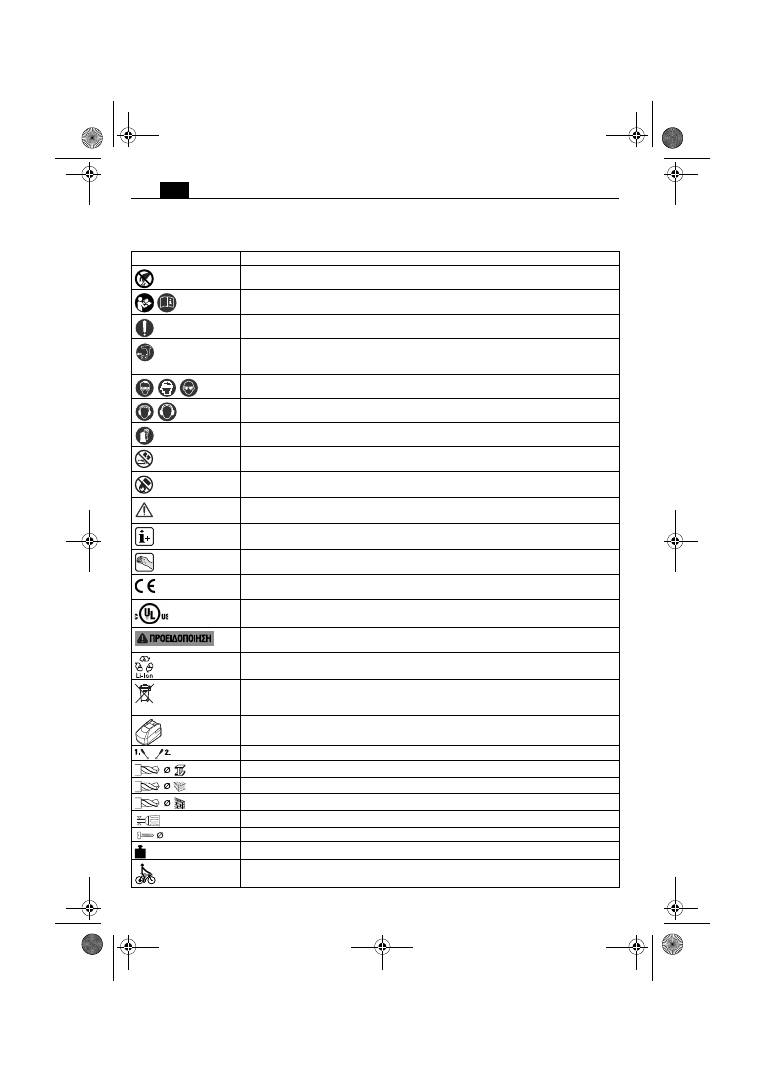
38
el
el
Πρωτότυπες οδηγίες χρήσης.
Σύμβολα που χρησιμοποιούνται, συντμήσεις και όροι.
Σύμβολο, χαρακτήρας
Ερμηνεία
Μην αγγίζετε τα περιστρεφόμενα μέρη του ηλεκτρικού εργαλείου.
Να διαβάσετε οπωσδήποτε τα συνημμένα έγγραφα, τις οδηγίες χρήσης και τις
υποδείξεις ασφαλείας.
Ακολουθήστε τις οδηγίες στο διπλανό κείμενο ή στα γραφικά!
Αφαιρέστε την μπαταρία από το ηλεκτρικό εργαλείο πριν εκτελέσετε αυτό το βήμα
εργασίας. Διαφορετικά δημιουργείται κίνδυνος τραυματισμού από μια ενδεχόμενη
κατά λάθος εκκίνηση του ηλεκτρικού εργαλείου.
Φοράτε προστατευτικά γυαλιά κατά τη διάρκεια της εργασίας σας.
Φοράτε ωτασπίδες κατά τη διάρκεια της εργασίας σας.
Όταν εργάζεστε να φοράτε προστατευτικά γάντια.
Μην φορτίσετε χαλασμένες μπαταρίες.
Μην εκθέσετε την μπαταρία σε φωτιά. Να προστατεύετε την μπαταρία από υψηλές
θερμοκρασίας, π. χ. ακόμη και από συνεχή ηλιακή ακτινοβολία.
Προσέξτε τις υποδείξεις στο διπλανό κείμενο!
Συμπληρωματική πληροφορία.
Επιφάνεια συγκράτησης
Βεβαιώνει τη συμμόρφωση του ηλεκτρικού εργαλείου με τις οδηγίες της
Ευρωπαϊκής Κοινότητας.
Το σύμβολο αυτό βεβαιώνει την Πιστοποίηση αυτού του προϊόντος στις ΗΠΑ και
τον Καναδά.
Η υπόδειξη αυτή επισημαίνει μια πιθανή επικίνδυνη κατάσταση που μπορεί να
οδηγήσει σε σοβαρούς τραυματισμούς ή στο θάνατο.
Χαρακτηριστικό ανακύκλωσης: Χαρακτηρίζει ανακυκλώσιμα υλικά
Άχρηστα ηλεκτρικά εργαλεία και άλλα ηλεκτροτεχνικά και ηλεκτρικά προϊόντα
πρέπει να συλλέγονται ξεχωριστά και να ανακυκλώνονται με τρόπο φιλικό προς το
περιβάλλον.
Τύπος μπαταρίας
1η ταχύτητα/2η ταχύτητα
Διάμετρος τρύπας σε χάλυβα
Διάμετρος τρύπας σε ξύλο
Διάμετρος τρύπας σε πέτρωμα
Περιοχή σύσφιξης του τσοκ
Διάμετρος βιδών
Βάρος σύμφωνα με EPTA-Procedure 01/2003
Μικρός αριθμός στροφών
Fe
OBJ_BUCH-0000000105-001.book Page 38 Thursday, April 4, 2013 10:23 AM
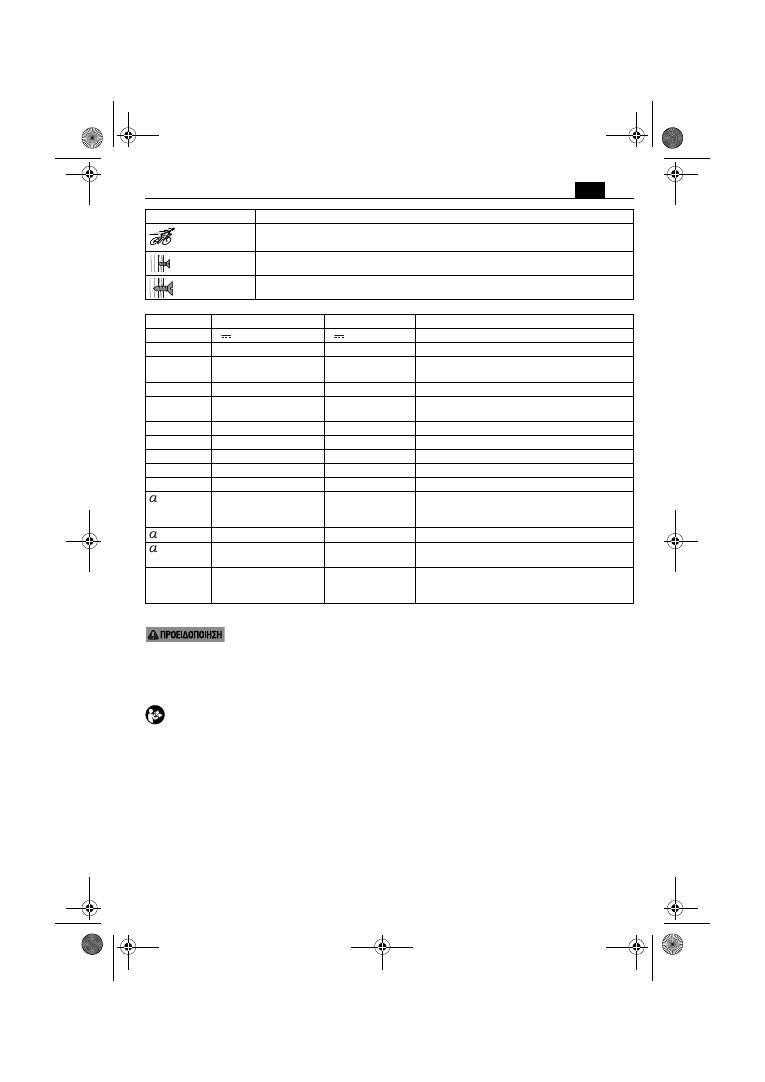
39
el
Για την ασφάλειά σας.
Διαβάστε όλες τις υποδείξεις
ασφαλείας και τις οδηγίες.
Αμέλειες
κατά την τήρηση των προειδοποιητικών υποδείξεων
και οδηγιών μπορεί να προκαλέσουν ηλεκτροπληξία,
πυρκαγιά ή/και σοβαρούς τραυματισμούς.
Φυλάξτε όλες τις προειδοποιητικές υποδείξεις και οδηγίες
για κάθε μελλοντική χρήση.
Να μην χρησιμοποιήσετε το παρόν ηλεκτρικό
εργαλείο πριν διαβάσετε επιμελώς και
κατανοήσετε αυτές τις οδηγίες χρήσης καθώς
και τις συνημμένες «Γενικές υποδείξεις ασφαλείας»
(Αριθμός εγγράφου 3 41 30 054 06 1). Να
διαφυλάξετε τα παραπάνω έγγραφα για κάθε
ενδεχόμενη μελλοντική χρήση και να τα επισυνάψετε
στο ηλεκτρικό εργαλείο όταν το παραδώσετε ή το
πουλήσετε σε τρίτο άτομο.
Να τηρείτε επίσης και τις σχετικές εθνικές διατάξεις
για την προστασία της εργασίας.
Προορισμός του ηλεκτρικού εργαλείου:
ABS14, ABS18:
με το χέρι οδηγούμενο δραπανοκατσάβιδο για το
βίδωμα και το ξεβίδωμα βιδών και παξιμαδιών και το
τρύπημα και βίδωμα σε μέταλλο, ξύλο και πλαστικά
και κεραμικά υλικά καθώς και για το άνοιγμα
σπειρωμάτων με εργαλεία και εξαρτήματα εγκριμένα
από τη FEIN σε περιβάλλον μη εκτεθειμένο στις
καιρικές συνθήκες, χωρίς την προσαγωγή νερού.
ASB14, ASB18:
με το χέρι οδηγούμενο κρουστικό μπουλονόκλειδο
για το βίδωμα και το ξεβίδωμα βιδών και παξιμαδιών
και το τρύπημα και βίδωμα σε μέταλλο, ξύλο και
πλαστικά και κεραμικά υλικά καθώς και για το
άνοιγμα σπειρωμάτων και το τρύπημα με κρούση σε
μπετόν, πετρώματα και τουβλα με εργαλεία και
εξαρτήματα εγκριμένα από τη FEIN σε περιβάλλον μη
εκτεθειμένο στις καιρικές συνθήκες, χωρίς την
προσαγωγή νερού.
Ειδικές υποδείξεις ασφαλείας.
Να πιάνετε τη συσκευή από τις μονωμένες επιφάνειες
πιασίματος όταν διεξάγετε εργασίες κατά τις οποίες
υπάρχει κίνδυνος η βίδα να έρθει σε επαφή με μη ορατούς
ηλεκτροφόρους αγωγούς.
Η επαφή με έναν
ηλεκτροφόρο αγωγό μπορεί να θέσει τα μεταλλικά
μέρη της συσκευής επίσης υπό τάση και να
προκαλέσει έτσι ηλεκτροπληξία.
Να προσέχετε μήπως υπάρχουν μη ορατοί ηλεκτρικοί
αγωγοί και σωλήνες φωταερίου (γκαζιού) ή νερού.
Πριν
αρχίσετε την εργασία σας ελέγξτε την περιοχή που
πρόκειται να εργαστείτε π. χ. με μια συσκευή
εντοπισμού μετάλλων.
Μεγάλος αριθμός στροφών
Μείωση ροπής στρέψης
Αύξηση ροπής στρέψης
Χαρακτήρας
Διεθνής μονάδα
Εθνική μονάδα
Ερμηνεία
U
V
V
συνεχής ηλεκτρική τάση
f
Hz
Hz
Συχνότητα
n
0
/min, min
-1
, rpm, r/min
min
-1
Αριθμός στροφών στο ρελαντί (όταν η
μπαταρία είναι εντελώς φορτισμένη)
n
S
/min, min
-1
/min
Αριθμός κρούσεων
M...
Nm
Nm
Ροπή στρέψης (περίπτωση σκληρού/μαλακού
βιδώματος)
Ø
mm
mm
Διατομή ενός στρογγυλού εξαρτήματος
L
pA
dB
dB
Στάθμη ακουστικής πίεσης
L
wA
dB
dB
Στάθμη ακουστικής ισχύος
L
pCpeak
dB
dB
Ύψιστη στάθμη ακουστικής πίεσης
K...
Ανασφάλεια
m/s
2
m/s
2
Τιμή εκπομπής κραδασμών σύμφωνα με
EN 60745 (άθροισμα ανυσμάτων τριών
κατευθύνσεων)
h,D
m/s
2
m/s
2
μέση τιμή κραδασμών για τρύπημα σε μέταλλο
h,ID
m/s
2
m/s
2
μέση τιμή κραδασμών για τρύπημα με κρούση
σε μπετόν
m, s, kg, A, mm, V,
W, Hz, N, °C, dB,
min, m/s
2
m, s, kg, A, mm, V,
W, Hz, N, °C, dB,
min, m/s
2
Θεμελιώδεις και παράγωγες μονάδες από το
Διεθνές Σύστημα Μονάδων
SI
.
Σύμβολο, χαρακτήρας
Ερμηνεία
OBJ_BUCH-0000000105-001.book Page 39 Thursday, April 4, 2013 10:23 AM
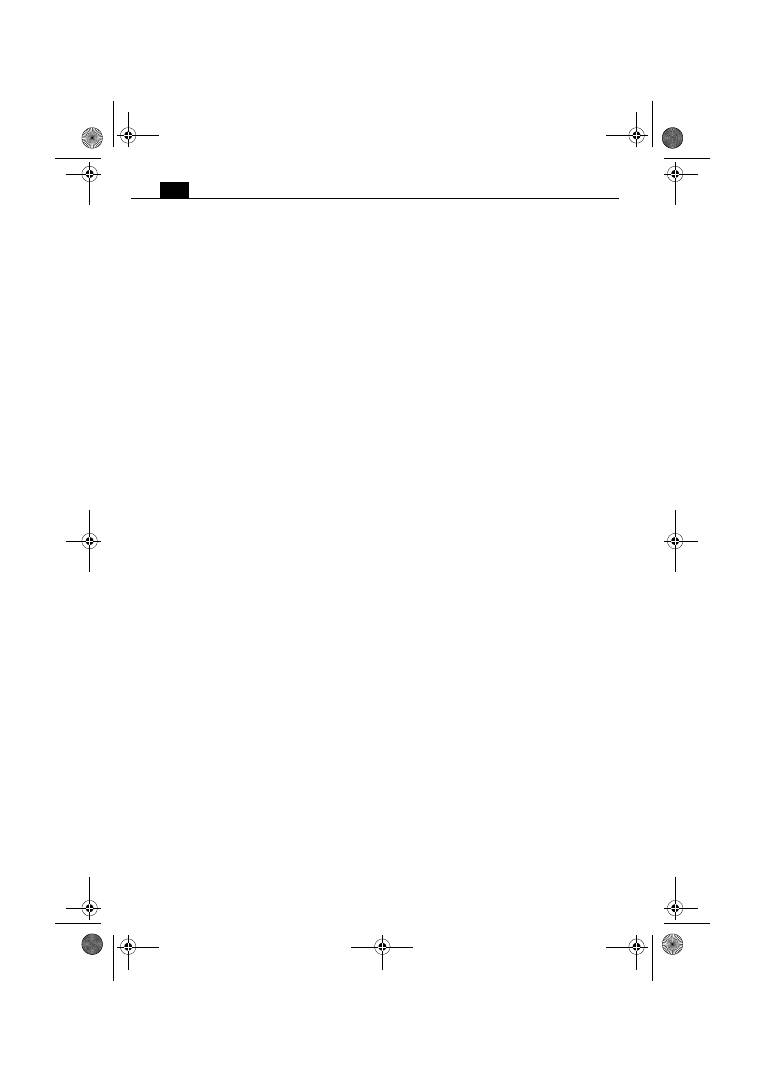
40
el
Να φοράτε πάντοτε τη δική σας, ατομική προστατευτική
ενδυμασία. Να χρησιμοποιείτε επίσης, ανάλογα με την
εκάστοτε εργασία που εκτελείτε, προστατευτικές μάσκες,
προστατευτικές διατάξεις ματιών ή προστατευτικά γυαλιά.
Αν χρειαστεί, φορέστε και μάσκα προστασίας από σκόνη,
ωτασπίδες, προστατευτικά γάντια ή μια ειδική
προστατευτική ποδιά, που θα σας προστατεύει από τυχόν
εκσφενδονιζόμενα λειαντικά σωματίδια ή θραύσματα
υλικού.
Τα μάτια πρέπει να προστατεύονται από τυχόν
αιωρούμενα σωματίδια που μπορεί δημιουργηθούν
κατά την εκτέλεση των διάφορων εργασιών. Οι
αναπνευστικές και οι προστατευτικές μάσκες πρέπει
να φιλτράρουν τον αέρα και να συγκρατούν τη σκόνη
που δημιουργείται κατά την εργασία. Σε περίπτωση
που θα εκτεθείτε για πολύ χρόνο σε ισχυρό θόρυβο
μπορεί να απωλέσετε την ακοή σας.
Να φοράτε ωτασπίδες όταν τρυπάτε με κρούση.
Η έκθεση
στο θόρυβο μπορεί να προκαλέσει απώλεια της
ακοής.
Ασφαλίζετε το υπό κατεργασία τεμάχιο.
Ένα υπό
κατεργασία τεμάχιο που στερεώνεται με τη βοήθεια
μιας διάταξης σύσφιξης είναι στερεωμένο με
μεγαλύτερη ασφάλεια από ένα που συγκρατείται με το
χέρι.
Να κρατάτε γερά το ηλεκτρικό εργαλείο.
Μπορεί να
εμφανιστούν απότομες αντιδραστικές ροπές.
Μην κατεργάζεστε υλικά που περιέχουν αμίαντο.
Το
αμίαντο θεωρείται σαν καρκινογόνο υλικό.
Απαγορεύεται το πριτσίνωμα ή/και το βίδωμα πινακίδων και
συμβόλων επάνω στο ηλεκτρικό εργαλείο.
Μια τυχόν
χαλασμένη μόνωση δεν προσφέρει πλέον καμιά
προστασία κατά της ηλεκτροπληξίας.
Χρησιμοποιείτε αυτοκόλλητες πινακίδες.
Μη χρησιμοποιήσετε ποτέ εξαρτήματα που δεν έχουν
εξελιχτεί ή εγκριθεί από τον κατασκευαστή του
ηλεκτρικού εργαλείου ειδικά γι΄ αυτό.
Η ασφαλής
λειτουργία δεν εξασφαλίζεται μόνο και μόνο επειδή
ένα εξάρτημα ταιριάζει στο ηλεκτρικό σας εργαλείο.
Να καθαρίζετε τακτικά τα ανοίγματα αερισμού του
ηλεκτρικού εργαλείου με μη μεταλλικά εργαλεία.
Ο
ανεμιστήρας του κινητήρα αναρροφά σκόνη μέσα στο
περίβλημα. Η υπερβολική συσσώρευση μεταλλικής
σκόνης μπορεί να δημιουργήσει κίνδυνο
ηλεκτροπληξίας.
Μην κοιτάξετε ποτέ κατευθείαν από μικρή απόσταση στο
φως της λάμπας του ηλεκτρικού εργαλείου. Μην
κατευθύνετε ποτέ το φως της λάμπας επάνω στα μάτια
άλλων, παρευρισκόμενων προσώπων.
Η ακτινοβολία που
παράγει το μέσο φωτισμού μπορεί να βλάψει τα μάτια.
Μην κατευθύνετε το ηλεκτρικό εργαλείο ούτε επάνω στον
εαυτό σας ούτε επάνω σε άλλα άτομα ή ζώα.
Προκαλείται
κίνδυνος τραυματισμού από κοφτερά ή καυτά
εξαρτήματα.
Χρήση και μεταχείριση της μπαταρίας
(του μπλοκ μπαταριών).
Κατά τη μεταχείριση της μπαταρίας να τηρείτε τις
επόμενες υποδείξεις για να μη ριψοκινδυνέψετε, π. χ.
εγκαύματα, πυρκαγιά, έκρηξη, εκδορές και άλλους
τραυματισμούς:
Δεν επιτρέπεται ο διαμελισμός, το άνοιγμα ή ο τεμαχισμός
των μπαταριών. Να μην εκθέσετε τις μπαταρίες σε
μηχανικές κρούσεις.
Όταν η μπαταρία υποστεί βλάβη
καθώς και όταν χρησιμοποιηθεί αντικανονικά μπορεί
να διαφύγουν βλαβερές αναθυμιάσεις. Οι
αναθυμιάσεις μπορεί να ερεθίσουν τις αναπνευστικές
οδούς. Τυχόν διαρρέοντα υγρά μπαταρίας μπορεί να
προκαλέσουν ερεθισμούς του δέρματος ή εγκαύματα.
Σε περίπτωση που τα διαρρέοντα υγρά της χαλασμένης
μπαταρίας υγράνουν τυχόν γειτονικά αντικείμενα, τότε
ελέγξτε τα αντίστοιχα εξαρτήματα και, αν χρειαστεί,
αντικαταστήστε τα.
Να μην εκθέσετε την μπαταρία σε υψηλές θερμοκρασίες ή
σε φωτιά. Να μην αποθηκεύσετε την μπαταρία υπό άμεση
ηλιακή ακτινοβολία.
Να αφαιρέσετε την μπαταρία από τη συσκευασία του
κατασκευαστή μόνο όταν πρόκειται να την
χρησιμοποιήσετε άμεσα.
Να αφαιρείτε την μπαταρία από το ηλεκτρικό εργαλείο πριν
από οποιαδήποτε εργασία σ’ αυτό.
Δημιουργείται
κίνδυνος τραυματισμών σε περίπτωση που το
ηλεκτρικό εργαλείο μπει κατά λάθος σε λειτουργία.
Να αφαιρείτε την μπαταρία από το ηλεκτρικό εργαλείο
μόνο όταν αυτό είναι απενεργοποιημένο (off).
Να κρατάτε τα παιδιά μακριά από τις μπαταρίες.
Να διατηρείτε την μπαταρία καθαρή και να την
προστατεύετε από υγρασία και νερά.
Να καθαρίζετε τις
λερωμένες συνδέσεις της μπαταρίας και του
ηλεκτρικού εργαλείου με ένα στεγνό, καθαρό πανί.
Να χρησιμοποιείτε μόνο αβλαβείς γνήσιες μπαταρίες της
FEIN που προορίζονται για το ηλεκτρικό σας εργαλείο.
Όταν χρησιμοποιήσετε ή φορτώσετε αντικανονικές,
χαλασμένες, επισκευασμένες, μεταποιημένες
μπαταρίες ή μπαταρίες ξένων κατασκευαστών και
απομιμήσεις δημιουργείται κίνδυνος πυρκαγιά ή/και
έκρηξης.
Να τηρείτε τις οδηγίες ασφαλείας στις οδηγίες χρήσης του
φορτιστή της μπαταρίας.
Κραδασμοί χεριού-μπράτσου
Η στάθμη κραδασμών που αναφέρεται σ΄ αυτές τις
οδηγίες έχει μετρηθεί σύμφωνα με μια διαδικασία
μέτρησης τυποποιημένη στο πλαίσιο του προτύπου
EN 60745 και μπορεί να χρησιμοποιηθεί στη
σύγκριση των διάφορων ηλεκτρικών εργαλείων. Είναι
επίσης κατάλληλη για τον προσωρινό υπολογισμό
της επιβάρυνσης από τους κραδασμούς.
Όταν, όμως, το ηλεκτρικό εργαλείο χρησιμοποιηθεί
με εργαλεία και παρελκόμενα που δεν προβλέπονται
γι’ αυτό ή χωρίς να έχει συντηρηθεί επαρκώς, η
στάθμη κραδασμών μπορεί να αποκλίνει. Αυτό μπορεί
να αυξήσει σημαντικά την επιβάρυνση από τους
κραδασμούς κατά τη διάρκεια του συνόλου του
χρονικού διαστήματος της εργασίας.
OBJ_BUCH-0000000105-001.book Page 40 Thursday, April 4, 2013 10:23 AM
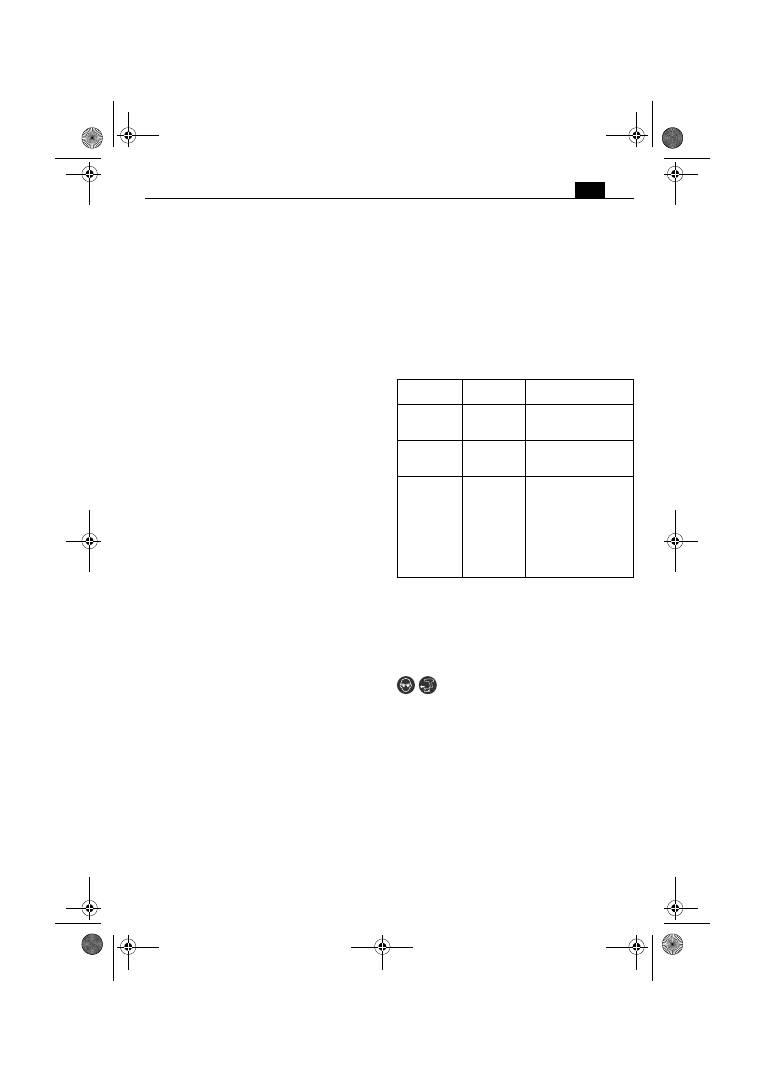
41
el
Για την ακριβή εκτίμηση της επιβάρυνσης από τους
κραδασμούς, κατά τη διάρκεια ενός ορισμένου
χρονικού διαστήματος εργασίας, θα πρέπει να
ληφθούν επίσης υπόψη και οι χρόνοι κατά τη διάρκεια
των οποίων το μηχάνημα βρίσκεται εκτός
λειτουργίας ή λειτουργεί χωρίς όμως στην
πραγματικότητα να χρησιμοποιείται. Αυτό μπορεί να
μειώσει σημαντικά την επιβάρυνση από τους
κραδασμούς κατά τη διάρκεια του συνόλου του
χρονικού διαστήματος της εργασίας.
Να καθορίζετε συμπληρωματικά μέτρα ασφαλείας για
την προστασία του χειριστή/της χειρίστριας από την
επίδραση των κραδασμών, για παράδειγμα:
συντήρηση των ηλεκτρικών εργαλείων και
παρελκομένων, ζέσταμα των χεριών, οργάνωση των
διαδικασιών εργασίας.
Αντιμετώπιση επικίνδυνων σκονών
Όταν αφαιρείτε υλικό μ’ αυτό το εργαλείο
δημιουργείται σκόνη η οποία μπορεί να είναι
επικίνδυνη.
Το άγγιγμα και η εισπνοή σκόνης από διάφορα υλικά,
π. χ. από αμίαντο και αμιαντούχα υλικά, από
μολυβδομπογιές, από μέταλλα κι από μερικά είδη
ξύλων, από ορυκτά υλικά καθώς και το άγγιγμα και η
εισπνοή σωματιδίων από πυριτικά άλατα υλικών που
περιέχουν πετρώματα, διαλυτών χρωμάτων,
ξυλοπροστατευτικών, Antifouling για θαλάσσια
οχήματα, μπορεί να προκαλέσουν αλλεργικές
αντιδράσεις και/ή ασθένειες των αναπνευστικών
οδών, καρκίνο ή/και βλάβη της γεννητικότητας. Ο
κίνδυνος από την εισπνοή σκόνης εξαρτάται από την
εκάστοτε έκθεση σ’ αυτήν. Να χρησιμοποιείτε
αναρρόφηση κατάλληλη για την εκάστοτε
δημιουργουμένη σκόνη, να φοράτε επίσης έναν
κατάλληλο προσωπικό προστατευτικό εξοπλισμό και
να φροντίζετε για τον καλό αερισμό του χώρου
εργασίας. Να αναθέτετε την κατεργασία αμιαντούχων
υλικών πάντοτε σε ειδικώς εκπαιδευμένα άτομα.
Η σκόνη από ξύλα και ελαφρά μέταλλα, καυτά μίγματα
από λειαντική σκόνη και χημικές ουσίες μπορούν, υπό
δυσμενείς συνθήκες, να αυτοαναφλεχθούν και να
εκραγούν. Να αποφεύγετε τη δημιουργία
σπινθηρισμού με φορά προς το δοχείο σκόνης καθώς
και την υπερθέρμανση του ηλεκτρικού εργαλείου και
των υπό λείανση αντικειμένων, να αδειάζετε τακτικά
το δοχείο σκόνης, να τηρείτε τις υποδείξεις
κατεργασίας του παραγωγού του υλικού καθώς και
τις διατάξεις που ισχύουν στη χώρα σας για τα υπό
κατεργασία υλικά.
Υποδείξεις χειρισμού.
Να χειρίζεστε το διακόπτη αλλαγής φοράς
περιστροφής μόνο όταν το μηχάνημα είναι
ακινητοποιημένο.
Να ωθείτε το διακόπτη επιλογής ταχυτήτων και να
γυρίζετε το διακόπτη επιλογής τρόπου λειτουργίας
(ASB14/18) πάντοτε τέρμα. Διαφορετικά μπορεί να
υποστεί βλάβη το ηλεκτρικό εργαλείο.
Σε περίπτωση υπερφόρτισης το ηλεκτρικό εργαλείο
διακόπτει τη λειτουργία του.
Για να αποφύγετε μια ακούσια εκκίνηση, π. χ. κατά τη
μεταφορά, να θέτετε το διακόπτη αλλαγής φοράς
περιστροφής στη μεσαία θέση.
Ρύθμιση ροπής στρέψης
Η ρύθμιση του κατασκευαστή αντιστοιχεί στην
περιοχή βιδών μικρού έως μέτριου μεγέθους.
Η ροπή σύσφιξης εξαρτάται από τη δύναμη με την
οποία πιέζεται το ηλεκτρικό εργαλείο επάνω στη
βίδα.
Μεταχείριση της μπαταρίας.
Να χρησιμοποιείτε και να φορτίζετε την μπαταρία
μόνο εντός της εγκεκριμένης περιοχής θερμοκρασίας
λειτουργίας της μπαταρίας από 0 °C – 45 °C (32 °F –
113 °F). Όταν αρχίζει η φόρτιση η θερμοκρασία της
μπαταρίας πρέπει να βρίσκεται εντός της
εγκεκριμένης περιοχής θερμοκρασίας λειτουργίας
της μπαταρίας.
Η πραγματική ποσοστιαία στάθμη φόρτισης της
μπαταρίας δείχνεται μόνο όταν ο κινητήρας του
ηλεκτρικού εργαλείου είναι σταματημένος.
Όταν επίκειται η πλήρης εκφόρτιση της μπαταρίας η
ηλεκτρονική διακόπτει αυτόματα τη λειτουργία του
κινητήρα.
Συντήρηση και Service.
Υπό εξαιρετικά δυσμενείς συνθήκες
εργασίας μπορεί, όταν κατεργάζεστε
μέταλλα, να σχηματιστεί αγώγιμη σκόνη
στο εσωτερικό του ηλεκτρικού εργαλείου. Να
καθαρίζετε συχνά το εσωτερικό του ηλεκτρικού
εργαλείου με φύσημα ξηρού πεπιεσμένου αέρα χωρίς
λάδια μέσω των σχισμών αερισμού.
Τον τρέχοντα κατάλογο ανταλλακτικών γι’ αυτό το
ηλεκτρικό εργαλείο θα βρείτε στην ηλεκτρονική
σελίδα www.fein.com.
Αν χρειαστεί, μπορείτε να αντικαταστήσετε οι ίδιοι τα
παρακάτω εξαρτήματα:
εργαλεία, μπαταρία
Ένδειξη
φωτοδιόδου
Σημασία
Ενέργεια
πράσινες
φωτοδίοδοι
1 – 4
ποσοστιαία
κατάσταση
φόρτισης
Λειτουργία
διαρκές
κόκκινο φως
Η μπαταρία
είναι σχεδόν
άδεια
Φορτίστε την
μπαταρία
κόκκινο
αναβόσβημα
Η μπαταρία
δεν είναι
έτοιμη για
λειτουργία
Αφήστε τη
θερμοκρασία της
μπαταρίας να
περιέλθει στην
εγκεκριμένη περιοχή
θερμοκρασίας
λειτουργίας της
μπαταρίας και
ακολούθως φορτίστε
OBJ_BUCH-0000000105-001.book Page 41 Thursday, April 4, 2013 10:23 AM
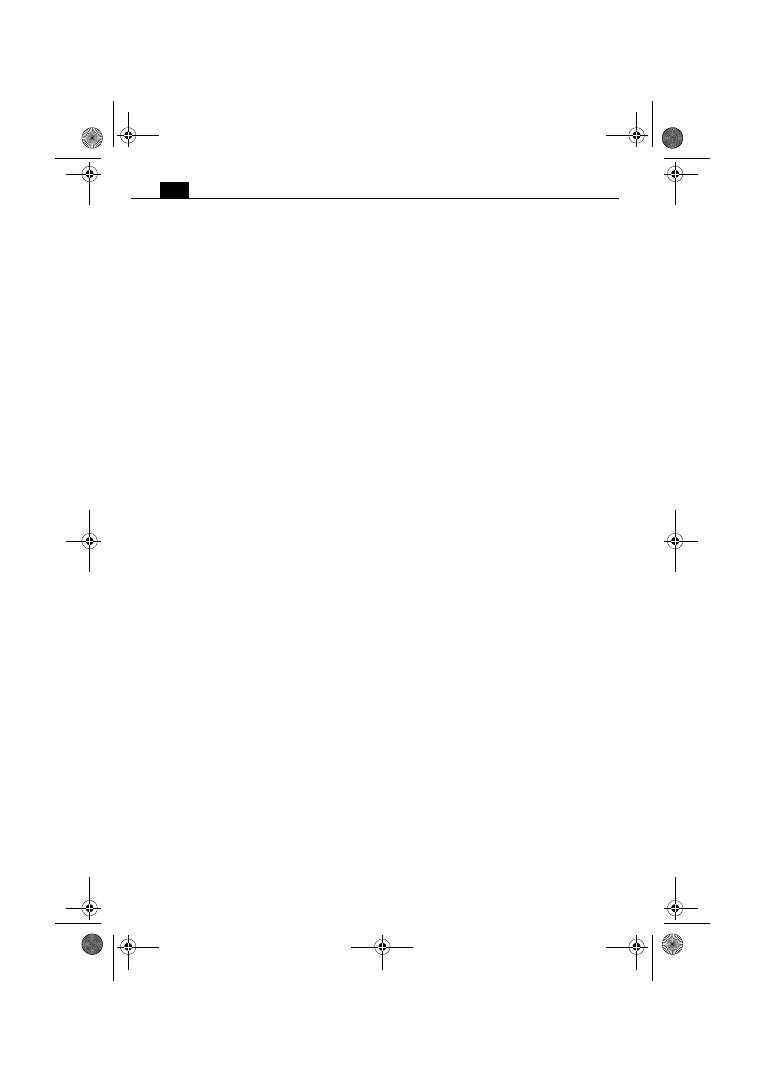
42
el
Εγγύηση.
Η εγγύηση για το προϊόν ισχύει σύμφωνα με τις
νομικές διατάξεις της χώρας στην οποία κυκλοφορεί.
Εκτός αυτού η FEIN σας παρέχει και μια επί πλέον
εγγύηση, ανάλογα με την εκάστοτε δήλωση
κατασκευαστή της FEIN.
Στη συσκευασία του ηλεκτρικού σας εργαλείου
μπορεί να περιέχεται μόνο ένα μέρος των
εξαρτημάτων που περιγράφονται ή απεικονίζονται σ’
αυτές τις οδηγίες χρήσης.
Δήλωση συμμόρφωσης.
Η εταιρία FEIN δηλώνει με αποκλειστική ευθύνη της
ότι αυτό το προϊόν ανταποκρίνεται πλήρως στους
σχετικούς κανονισμούς που αναφέρονται στην
τελευταία σελίδα αυτών των οδηγιών χρήσης.
Τεχνικά έγγραφα από: C. & E. FEIN GmbH, C-DB_IA,
D-73529 Schwäbisch Gmünd
Προστασία του περιβάλλοντος, απόσυρση.
Οι συσκευασίες, τα άχρηστα ηλεκτρικά εργαλεία και
τα εξαρτήματα πρέπει να ανακυκλώνονται με τρόπο
φιλικό προς το περιβάλλον.
Να αποσύρετε κανονικά τις μπαταρίες, μόνο όταν
αυτές είναι εκφορτισμένες.
Όταν οι μπαταρίες δεν είναι τελείως άδειες να τις
προστατεύετε από βραχυκυκλώματα μονώνοντας το
βύσμα με κολλητική ταινία. Διαβάστε όλες τις
προειδοποιητικές υποδείξεις.
OBJ_BUCH-0000000105-001.book Page 42 Thursday, April 4, 2013 10:23 AM
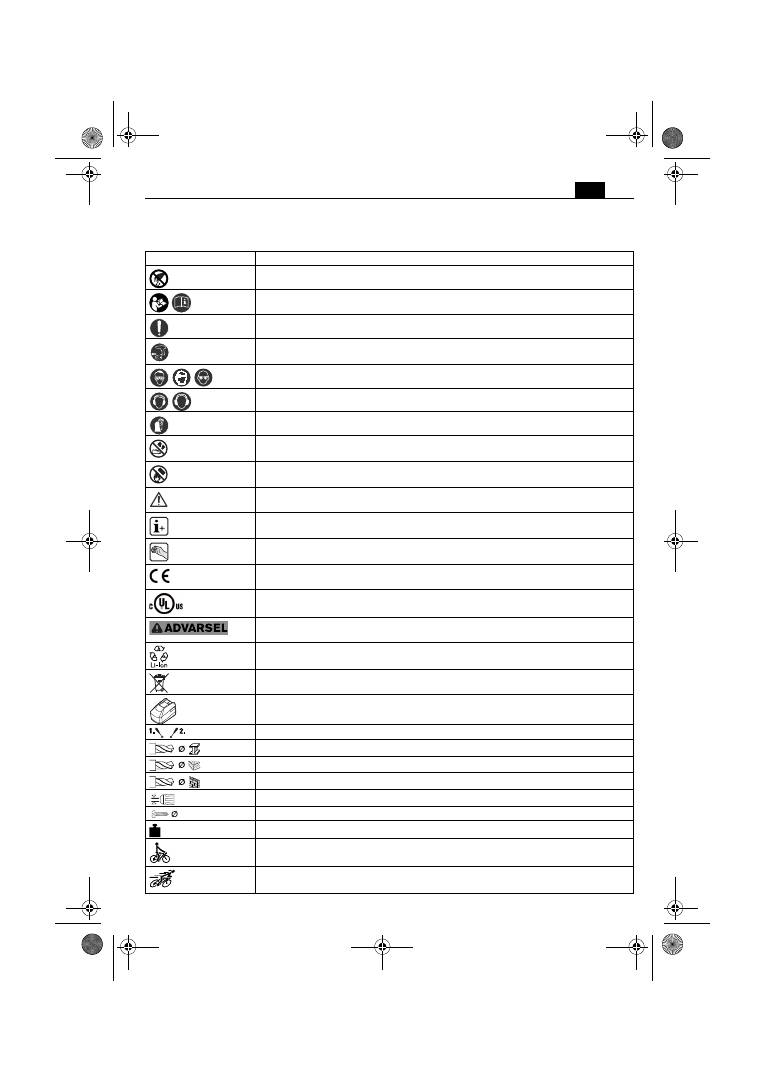
43
da
da
Original betjeningsvejledning.
Anvendte symboler, forkortelser og begreber.
Symbol, tegn
Forklaring
Berør ikke roterende dele på el-værktøjet.
Læs ubetinget vedlagte dokumenter som f.eks. brugsanvisning og almindelige sikkerheds-
råd.
Følg instruktionerne i efterfølgende tekst eller grafik!
Fjern akkuen fra el-værktøjet, før dette arbejdsskridt udføres. Ellers er der fare for kvæ-
stelser som følge af utilsigtet start af el-værktøjet.
Brug øjenbeskyttelse under arbejdet.
Brug høreværn under arbejdet.
Brug håndbeskyttelse under arbejdet.
Oplad ikke beskadigede akkuer.
Udsæt ikke akkuen for ild. Beskyt akkuen mod varme f.eks. også mod vedvarende solstrå-
ler.
Overhold henvisningerne i teksten ved siden af!
Ekstra information.
Grebområde
Bekræfter at el-værktøjet er i overensstemmelse med gældende direktiver inden for det
europæiske fællesskab.
Dette symbol bekræfter certificeringen af dette produkt i USA og Canada.
Denne henvisning viser en mulig farlig situation, der kan føre til alvorlige kvæstelser evt.
med døden til følge.
Genbrugstegn: Kendetegner materialer, der kan genbruges
Gammelt el-værktøj og andre elektrotekniske og elektriske produkter skal samles og afle-
veres separat til miljøvenlig genbrug.
Akkutype
1. Gear/2. Gear
Borediameter stål
Borediamter træ
Borediameter sten
Borepatron-spændeområde
Skruediameter
Vægt iht. EPTA-Procedure 01/2003
Lille omdrejningstal
Stort omdrejningstal
Fe
OBJ_BUCH-0000000105-001.book Page 43 Thursday, April 4, 2013 10:23 AM
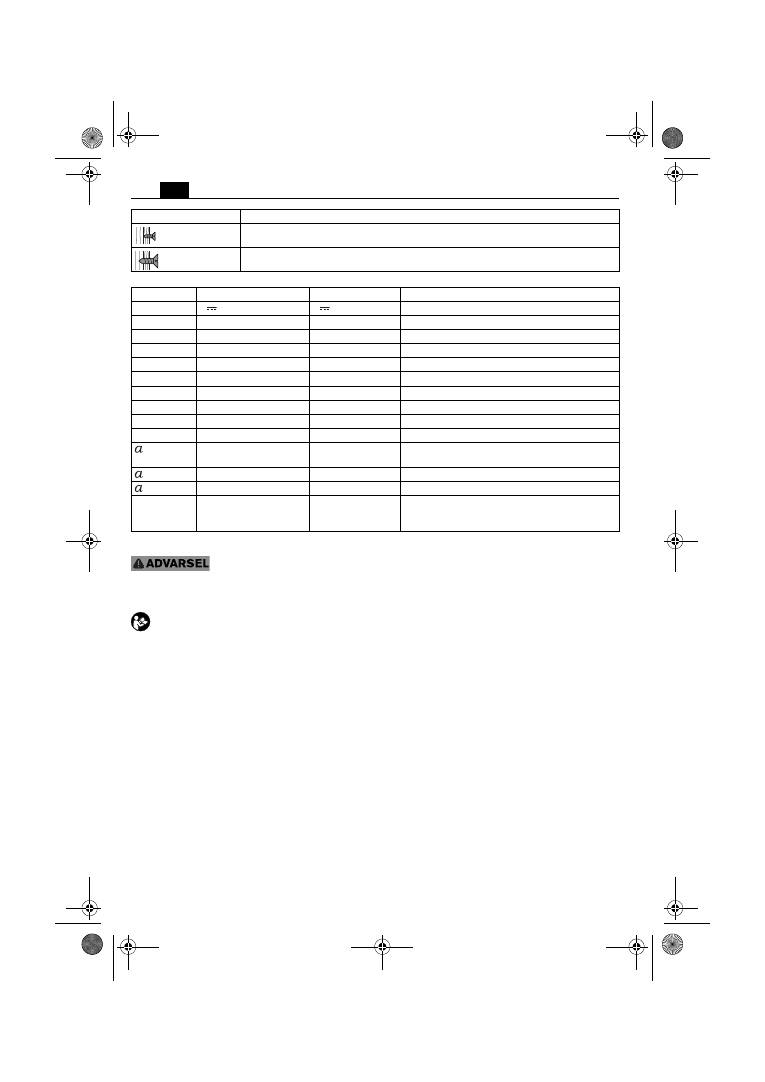
44
da
For din egen sikkerheds skyld.
Læs alle sikkerhedsråd og instruk-
ser.
I tilfælde af manglende overhol-
delse af sikkerhedsråd og instrukser er der risiko for
elektrisk stød, brand og/eller alvorlige kvæstelser.
Opbevar alle sikkerhedsråd og instrukser til senere brug.
Anvend ikke dette el-værktøj, før du har læst nær-
værende brugsanvisning samt vedlagte „Almindelige
sikkerhedsråd“ (skriftnummer 3 41 30 054 06 1)
nøje igennem og forstået det hele. Opbevar nævnte mate-
riale til senere brug og giv det videre til en evt. ny ejer.
Læs og overhold ligeledes de gældende nationale arbejds-
beskyttende bestemmelser.
El-værktøjets formål:
ABS14, ABS18:
Håndført boreskruemaskine til iskruning og uddrejning af
skruer og møtrikker og til skruning i metal, træ, kunststof
og keramik samt til gevindskæring med det af FEIN tilladte
tilbehør uden vandtilførsel i vejrbeskyttede omgivelser.
ASB14, ASB18:
Håndført slagboreskruemaskine til iskruning og uddrej-
ning af skruer og møtrikker og til boring og skruning i
metal, træ, kunststof og keramik samt til gevindskæring
og slagboring i beton, sten og tegl med det af FEIN tilladte
tilbehør uden vandtilførsel i vejrbeskyttede omgivelser.
Specielle sikkerhedsforskrifter.
Hold el-værktøjet i de isolerede gribeflader, når du udfø-
rer arbejde, hvor skruen kan ramme bøjede strømlednin-
ger.
Kontakten med en spændingsførende ledning kan
også sætte metalholdige værktøjsdele under spænding,
hvilket kan føre til elektrisk stød.
Hold øje med skjult liggende elektriske ledninger, gas- og
vandrør.
Kontrollér arbejdsområdet (f.eks. med en metal-
pejler), før arbejdet påbegyndes.
Brug personligt beskyttelsesudstyr. Brug helmaske til
ansigtet, øjenværn eller beskyttelsesbriller, afhængigt af
det udførte arbejde. Brug afhængigt af arbejdets art støv-
maske, høreværn, beskyttelseshandsker eller specialfor-
klæde, der beskytter dig mod små slibe- og
materialepartikler.
Øjnene skal beskyttes mod frem-
mede genstande, der flyver rundt i luften og som opstår i
forbindelse med forskelligt arbejde. Støv- eller ånde-
drætsmaske skal filtrere det støv, der opstår under arbej-
det. Udsættes du for høj støj i længere tid, kan du lide
høretab.
Brug høreværn under slagboring.
Støj kan forringe høre-
evnen.
Sikre emnet.
Et emne, der holdes med en spændeanord-
ning, holdes mere sikkert end i hånden.
Hold godt fast i el-værktøjet.
Der kan opstå høje reakti-
onsmomenter for en kort tid.
Sav ikke i asbestholdigt materiale.
Asbest er registreret
som kræftfremkaldende.
Det er forbudt at skrue eller nitte skilte og tegn på el-
værktøjet.
En beskadiget isolering beskytter ikke mod
elektrisk stød. Anvend klæbeetiketter.
Anvend ikke tilbehør, hvis det ikke er udviklet eller frigi-
vet specielt af el-værktøjets fabrikant.
Sikker drift er ikke
kun givet ved, at tilbehøret passer til dit el-værktøj.
Drejningsmoment reduceres
Drejningsmoment øges
Tegn
Enhed international
Enhed national
Forklaring
U
V
V
Elektrisk jævnspænding
f
Hz
Hz
Frekvens
n
0
/min, min
-1
, rpm, r/min
/min
Omdrejningstal i tomgang (med helt ladet akku)
n
S
/min, min
-1
/min
Slagtal
M...
Nm
Nm
Drejningsmoment (hårdt/blødt skruearbejde)
Ø
mm
mm
Diameter på en rund del
L
pA
dB
dB
Lydtrykniveau
L
wA
dB
dB
Lydeffektniveau
L
pCpeak
dB
dB
Top lydtrykniveau
K...
Usikkerhed
m/s
2
m/s
2
Svingningsemissionsværdi iht. EN 60745
(vektorsum for tre retninger)
h,D
m/s
2
m/s
2
gennemsn. svingningsværdi for boring i metal
h,ID
m/s
2
m/s
2
gennemsn. svingningsværdi for slagboring i beton
m, s, kg, A, mm, V,
W, Hz, N, °C, dB,
min, m/s
2
m, s, kg, A, mm, V,
W, Hz, N, °C, dB,
min, m/s
2
Basisenheder og afledte enheder fra det internatio-
nale enhedssystem
SI
.
Symbol, tegn
Forklaring
OBJ_BUCH-0000000105-001.book Page 44 Thursday, April 4, 2013 10:23 AM
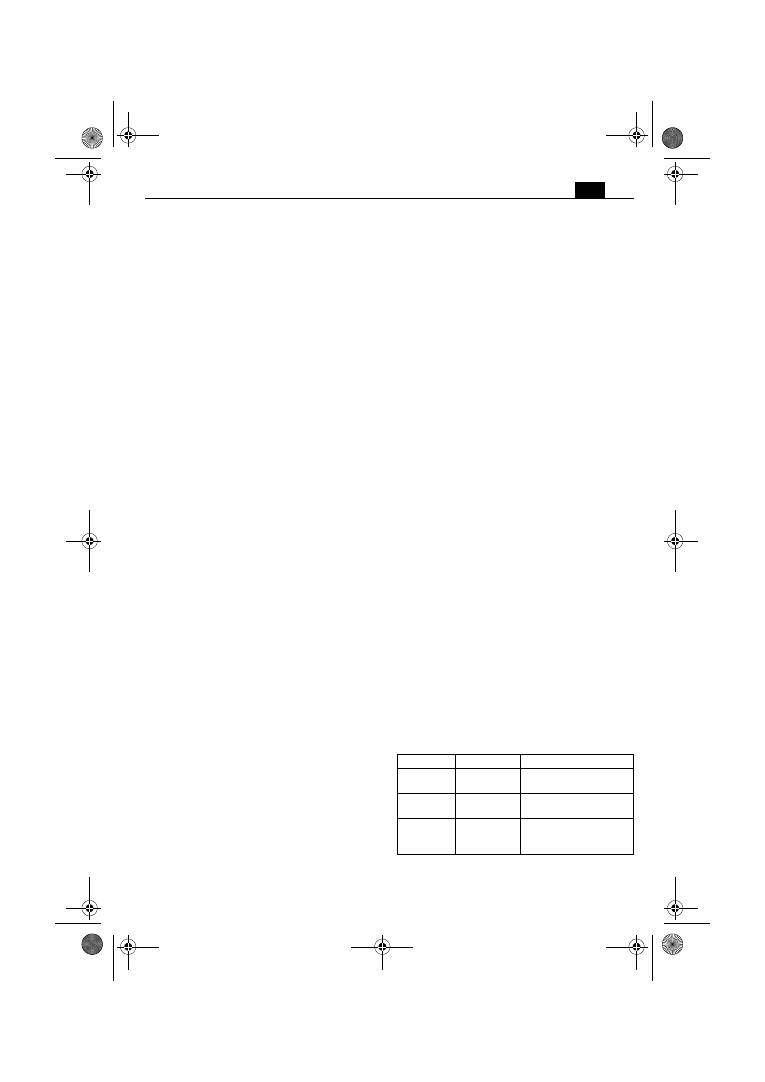
45
da
Rengør ventilationsåbningerne på el-værktøjet med
regelmæssige mellemrum med ikke-metallisk værtøj.
Motorblæseren trækker støv ind i huset. Dette kan føre
til elektrisk fare, hvis store mængder metalstøv opsamles.
Ret aldrig blikket ind i el-værktøjets lampelys fra kort
afstand. Ret aldrig lampelyset ind i øjnene på andre per-
soner, der befinder sig i nærheden.
Lysstrålen kan være
skadeligt for øjet.
Ret ikke el-værktøjet mod dig selv, andre personer eller
dyr.
Skarpt eller varmt tilbehør kan føre til kvæstelser.
Brug og behandling af akkuen (akkublokke).
Overhold følgende henvisninger for at undgå farer som
forbrænding, brand, eksplosion, hudkvæstelser og andre
kvæstelser som følge af håndtering med akkuerne:
Akkuer må ikke skilles ad, åbnes eller hakkes itu. Udsæt
ikke akkuerne for mekaniske stød.
Beskadiges akkuen
eller anvendes den forkert, kan skadelige dampe og
væsker strømme ud. Dampene kan irritere luftvejene.
Udstrømmende akkuvæske kan føre til hudirritation eller
forbrændinger.
Hvis væske strømmer ud af den beskadigede akku og
fugter nærliggende genstande, kontroller da de pågæl-
dende dele, rengør dem eller udskift dem efter behov.
Udsæt ikke akkuen for varme eller ild. Opbevar ikke
akkuen i direkte solstråler.
Tag først akkuen ud af den originale emballage, når den
skal bruges.
Tag akkuen ud af el-værktøjet, før arbejde udføres på el-
værktøjet.
Går el-værktøjet utilsigtet i gang, kan man blive
kvæstet.
Fjern kun akkuen, når el-værktøjet er slukket.
Hold akkuer uden for børns rækkevidde.
Hold akkuen ren og beskyt den mod fugtighed og vand.
Rengør akkuens og el-værktøjets snavsede tilslutninger
med en tør, ren klud.
Brug kun intakte originale FEIN akkuer, der er beregnet til
dit el-værktøj.
Arbejde med og opladning af forkerte,
beskadigede eller reparerede akkuer, efterligninger og
fremmede fabrikater er forbundet med fare for brand
og/eller fare for eksplosion.
Følg sikkerhedsrådene i brugsanvisningen til akku-lade-
ren.
Hånd-arm-vibrationer
Vibrationsniveauet angivet i disse instruktioner er målt
jævnfør en måleprocedure, normeret i EN 60745, og kan
benyttes til indbyrdes sammenligning af el-værktøj. Den
egner sig desuden til en foreløbig vurdering af vibrations-
belastningen.
Det angivne vibrationsniveau repræsenterer el-værktø-
jets vigtigste anvendelsesformer. Men hvis el-værktøjet
benyttes på anden måde med ikke formålsbestemt tilbe-
hør eller ved utilstrækkelig vedligeholdelse, kan vibrati-
onsniveauet afvige. Derved kan vibrationsbelastningen i
hele arbejdsperioden forøges betydeligt.
Ved en nøjagtig vurdering af vibrationsbelastningen bør
der også tages højde for den tid, hvor værktøjet enten er
slukket eller fortsat er tændt, men ikke er i egentlig brug.
Det kan reducere vibrationsbelastningen i hele arbejds-
perioden betydeligt.
Fastlæg yderligere sikkerhedsforanstaltninger til beskyt-
telse af brugeren mod vibrationernes effekt som f.eks.:
Vedligeholdelse af el-værktøj og tilbehør, hold hænderne
varme, organisation af arbejdsprocedurer.
Håndtering med farligt støv
Bruges dette værktøj til materialeafslibende arbejdspro-
cesser, opstår der støv, der kan være farligt.
Berøring eller indånding af nogle former for støv som f.eks.
fra asbest og asbestholdige materialer, blyholdig maling,
metal, nogle træsorter, mineraler, silikatpartikler med sten-
holdige materialer, farveopløsende midler, træbeskyttel-
sesmidler, antifouling til vandkøretøjer kan udløse
allergiske reaktioner og/eller luftvejssygdomme, kræft og
forplantningsskader hos personer med allergiske reaktio-
ner. Risikoen for at indånde støv afhænger af ekspositio-
nen. Brug en opsugningsmåde, der er afstemt efter det
støv, der opstår, samt personligt beskyttelsesudstyr og sørg
for god udluftning/ventilation på arbejdspladsen. Overlad
altid behandling af asbestholdigt materiale til fagfolk.
Træstøv og letmetalstøv, varme blandinger af slibestøv og
kemiske stoffer kan under ugunstige betingelser antæn-
des af sig selv og føre til eksplosion. Undgå gnistregn hen
imod støvbeholder samt overophedning af el-værktøjet
og slibegodset, tøm rettidigt støvbeholderen, følg bear-
bejdningshenvisningerne fra materialeproducenten samt
de forskrifter, der gælder i brugslandet for de materialer,
der skal bearbejdes.
Betjeningsforskrifter.
Tryk kun på retningsomskifteren og gearvælgeren, når
motoren står stille.
Skub gearvælgeren eller drej funktionskontakten
(ASB14/18) altid helt i bund. Ellers kan el-værktøjet blive
beskadiget.
El-værktøjet slukker, hvis det overbelastes.
Stil retningsomskifteren i midten for at undgå utilsigtet
ibrugtagning f.eks. under transporten.
Drejningsmoment indstilles
Fabriksindstillingen svarer til området for små og middel-
store skruer.
Tilspændingsmomentet afhænger også af den kraft, med
hvilken el-værktøjet trykkes mod skruen.
Håntering med akkuen.
Brug og lad kun akkuen i et akku-driftstemperatur-
område mellem 0 °C – 45 °C (32 °F – 113 °F). Akku-tem-
peraturen skal befinde sig i akku-
driftstemperaturområdet, når opladningen går i gang.
Akkuens ægte procentuelle ladetilstand vises kun, når el-
værktøjets motor er stoppet.
Ved en forestående dyb afladning af akkuen stopper elek-
tronikken automatisk motoren.
LED-lampe
Betydning
Aktion
1 – 4 grøn
LED-lampe
Procentuel
ladetilstand
Drift
rødt kon-
stant lys
Akku er
næsten tom
Akku lades
rødt blin-
kende lys
Akku er ikke
klar til drift
Akku stilles i akku-drifts-
temperaturområde, her-
efter lades den
OBJ_BUCH-0000000105-001.book Page 45 Thursday, April 4, 2013 10:23 AM
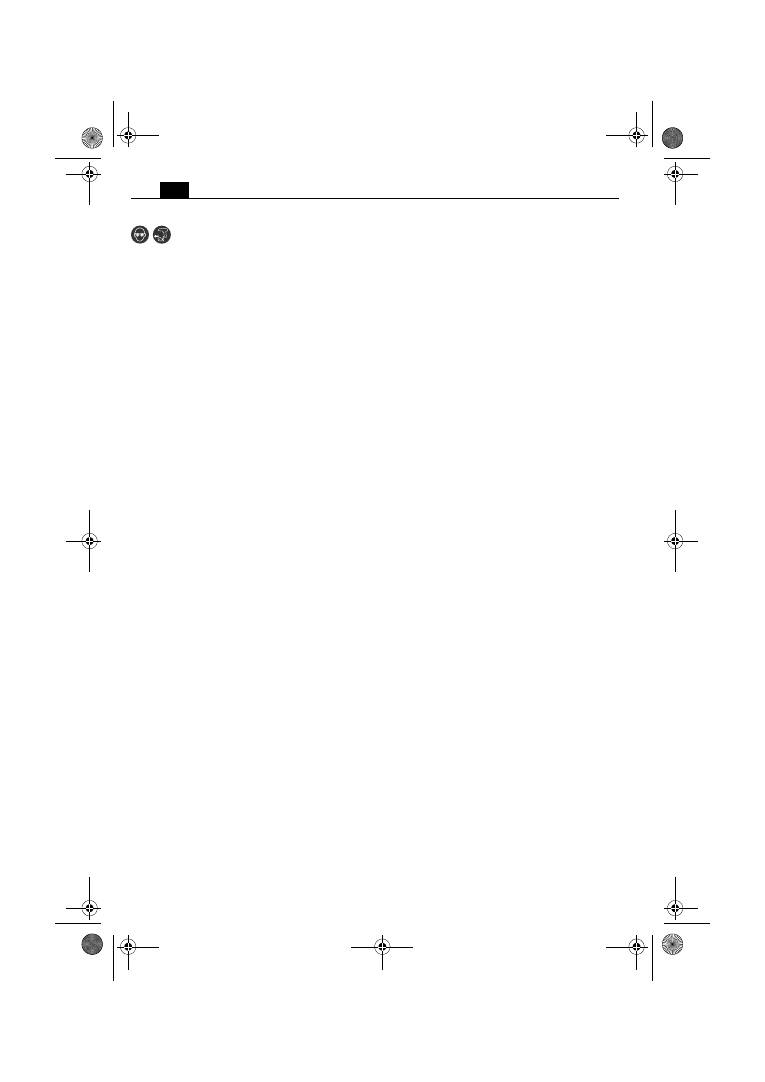
46
da
Vedligeholdelse og kundeservice.
Under ekstreme brugsbetingelser kan bear-
bejdning af metal føre til aflejring af ledende
støv inde i el-værktøjet. Blæs hyppigt den ind-
vendige del af el-værktøjet med tør og oliefri trykluft gen-
nem ventilationsåbningerne.
Den aktuelle reservedelsliste til dette el-værktøj findes på
internettet under www.fein.com.
Følgende dele kan du selv udskifte efter behov:
tilbehør, akku
Mangelsansvar/reklamationsret og
garanti.
Mangelsansvaret/reklamationsretten er fastlagt i de lovbe-
stemmelser, der gælder i det land, hvor maskinen mar-
kedsføres. Derudover yder FEIN garanti iht. FEIN
fabrikantens garantierklæring.
Det kan være, at el-værktøjet kun leveres med en del af
det tilbehør, der beskrives eller illustreres i brugsanvis-
ning.
Overensstemmelseserklæring.
Firmaet FEIN erklærer på eget ansvar, at dette produkt er
i overensstemmelse med de gældende bestemmelser, der
findes på den sidste side i denne brugsanvisning.
Teknisk materiale hos: C. & E. FEIN GmbH, C-DB_IA,
D-73529 Schwäbisch Gmünd
Miljøbeskyttelse, bortskaffelse.
Emballage, udtjent el-værktøj og tilbehør bedes afleveret
til miljøvenlig genbrug.
Akkuer skal være afladet, før de bortskaffes.
Ved ikke fuldstændigt afladede akkuer isoleres stikforbin-
delsen med tape for at beskytte mod kortslutning.
OBJ_BUCH-0000000105-001.book Page 46 Thursday, April 4, 2013 10:23 AM
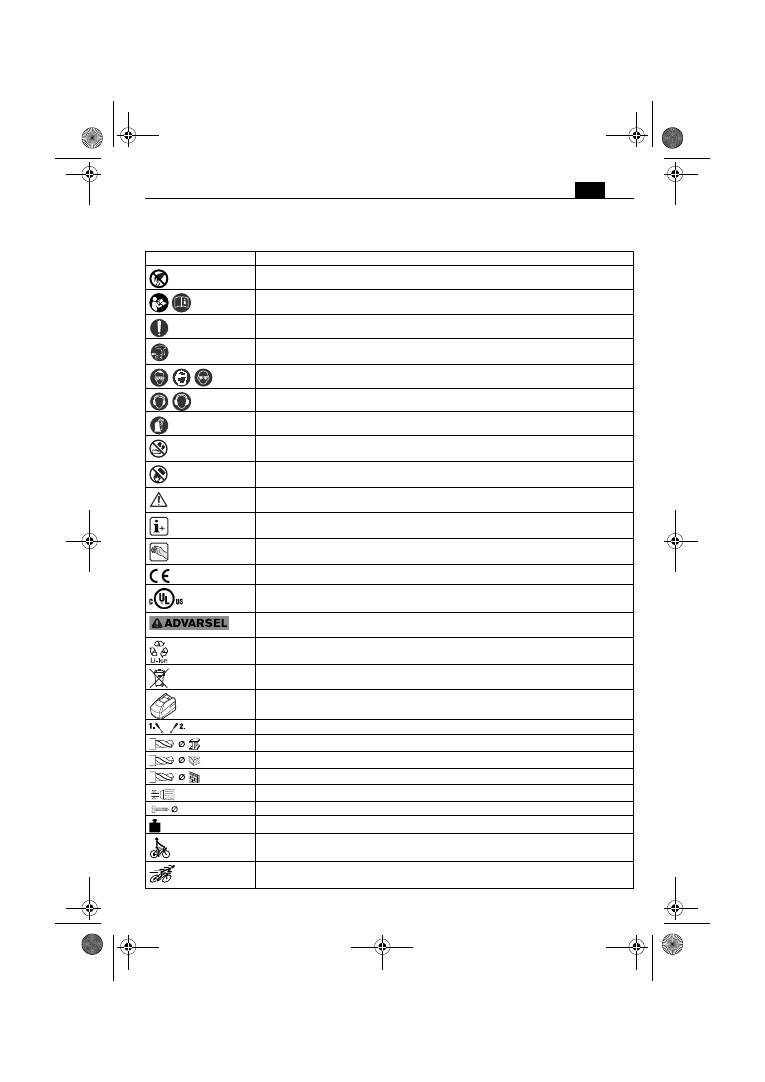
47
no
no
Original driftsinstruks.
Anvendte symboler, forkortelser og uttrykk.
Symbol, tegn
Forklaring
Ikke berør de roterende delene til elektroverktøyet.
Vedlagte dokumenter som driftsinstruks og generelle sikkerhetsinformasjoner må abso-
lutt leses.
Følg anvisningene i teksten eller bildet ved siden av!
Før dette gjøres må batteriet tas ut av elektroverktøyet. Ellers er det fare for skader ved
utilsiktet starting av elektroverktøyet.
Bruk øyebeskyttelse ved arbeid.
Bruk hørselvern ved arbeid.
Bruk håndbeskyttelse ved arbeid.
Ikke lad opp skadede batterier.
Ikke utsett batteriene for ild. Beskytt batteriet mot varme, f.eks. også mot permanent lag-
ring i direkte sollys.
Følg informasjonene i teksten ved siden av!
Ekstra informasjon.
Gripeflate
Bekrefter at elektroverktøyet er i samsvar med direktivene til det Europeiske Forbund.
Dette symbolet bekrefter sertifiseringen av dette produktet i USA og Canada.
Denne informasjonen henviser til en mulig farlig situasjon som kan medføre alvorlige ska-
der eller død.
Resirkulerings-tegn: merker resirkulerbare materialer
Vrakede elektroverktøy og andre elektrotekniske og elektriske produkter må samles inn
hver for seg og leveres inn til en miljøvennlig resirkulering.
Batteritype
1. gir/2. gir
Bordiameter stål
Bordiameter tre
Bordiameter stein
Spennområde chuck
Skruediameter
Vekt tilsvarende EPTA-Procedure 01/2003
Lavt turtall
Høyt turtall
Fe
OBJ_BUCH-0000000105-001.book Page 47 Thursday, April 4, 2013 10:23 AM

48
no
For din egen sikkerhet.
Les gjennom alle advarslene og
anvisningene.
Unnlatelse av å over-
holde advarslene og nedenstående anvisninger kan med-
føre elektriske støt, brann og/eller alvorlige skader.
Ta godt vare på alle advarslene og informasjonene.
Ikke bruk dette elektroverktøyet før du har lest og
forstått denne driftsinstruksen og de vedlagte
“Generelle sikkerhetsinformasjonene” (doku-
mentnummer 3 41 30 054 06 1). Oppbevar de angitte
papirene til senere bruk og overrekk disse sammen med
elektroverktøyet hvis det lånes bort eller selges videre.
Følg også de vanlige nasjonale arbeidsmiljøbestemmelse-
ne.
Elektroverktøyets formål:
ABS14, ABS18:
håndført borskrutrekker for å skru skruer og mutrer inn
og ut og for boring i metall, tre, kunststoff og keramikk
samt for gjengeskjæring med innsatsverktøy og tilbehør
godkjent av FEIN uten vanntilførsel i værbeskyttede
omgivelser.
ASB14, ASB18:
håndført slagbormaskin + skrutrekker for å skru skruer
og mutrer inn og ut for boring i metall, tre, kunststoff og
keramikk samt for gjengeskjæring og slagboring i betong,
stein og tegl med innsatsverktøy og tilbehør godkjent av
FEIN uten vanntilførsel i værbeskyttede omgivelser.
Spesielle sikkerhetsinformasjoner.
Hold elektroverktøyet på de isolerte gripeflatene, hvis du
utfører arbeid der skruen kan treffe på skjulte strømled-
ninger.
Kontakt mellom skruen og en spenningsførende
ledning kan også sette elektroverktøyets metalldeler
under spenning og føre til elektriske støt.
Pass på skjulte elektriske ledninger, gass- og vannrør.
Kontroller arbeidsområdet f. eks. med et metallsøkeap-
parat før arbeidet påbegynnes.
Bruk personlig beskyttelsesutstyr. Avhengig av typen
bruk må du bruke visir, øyebeskyttelse eller vernebriller.
Om nødvendig må du bruke støvmaske, hørselvern, ver-
nehansker eller spesialforkle som holder små slipe- og
materialpartikler unna kroppen din.
Øynene bør beskyt-
tes mot fremmedlegemer som kan fly rundt ved visse
typer bruk. Støv- eller pustevernmasker må filtrere den
typen støv som oppstår ved den aktuelle bruken. Hvis du
er utsatt for sterk støy over lengre tid, kan det medføre
skader på hørselen.
Bruk hørselvern ved slagboring.
Innvirkning av støy kan
føre til at man mister hørselen.
Sikre arbeidsstykket.
Et arbeidsstykke som holdes fast
med spenninnretninger, holdes sikrere enn med hånden.
Hold elektroverktøyet godt fast.
Det kan oppstå høye
reaksjonsmomenter i korte perioder.
Ikke bearbeid asbestholdig material.
Asbest kan frem-
kalle kreft.
Det er forbudt å skru eller nagle skilt eller tegn på elek-
troverktøyet.
En skadet isolasjon gir ingen beskyttelse
mot elektriske støt. Bruk klebeskilt.
Reduksjon av dreiemomentet
Øking av dreiemomentet
Tegn
Enhet internasjonalt
Enhet nasjonalt
Forklaring
U
V
V
elektrisk likespenning
f
Hz
Hz
Frekvens
n
0
/min, min
-1
, rpm, r/min
min
-1
Tomgangsturtall (ved fullt oppladet batteri)
n
S
/min, min
-1
/min
Slagtall
M...
Nm
Nm
Dreiemoment (hard/myk skruing)
Ø
mm
mm
Diameter til en rund del
L
pA
dB
dB
Lydtrykknivå
L
wA
dB
dB
Lydeffektnivå
L
pCpeak
dB
dB
Maksimalt lydtrykknivå
K...
Usikkerhet
m/s
2
m/s
2
Svingningsemisjonsverdi iht. EN 60745
(vektorsum fra tre retninger)
h,D
m/s
2
m/s
2
gjennomsnittlig svingningsverdi for boring i metall
h,ID
m/s
2
m/s
2
gjennomsnittlig svingningsverdi for slagboring i
betong
m, s, kg, A, mm, V,
W, Hz, N, °C, dB,
min, m/s
2
m, s, kg, A, mm, V,
W, Hz, N, °C, dB,
min, m/s
2
Basis- og avledede enheter fra det internasjonale
enhetssystemet
SI
.
Symbol, tegn
Forklaring
OBJ_BUCH-0000000105-001.book Page 48 Thursday, April 4, 2013 10:23 AM
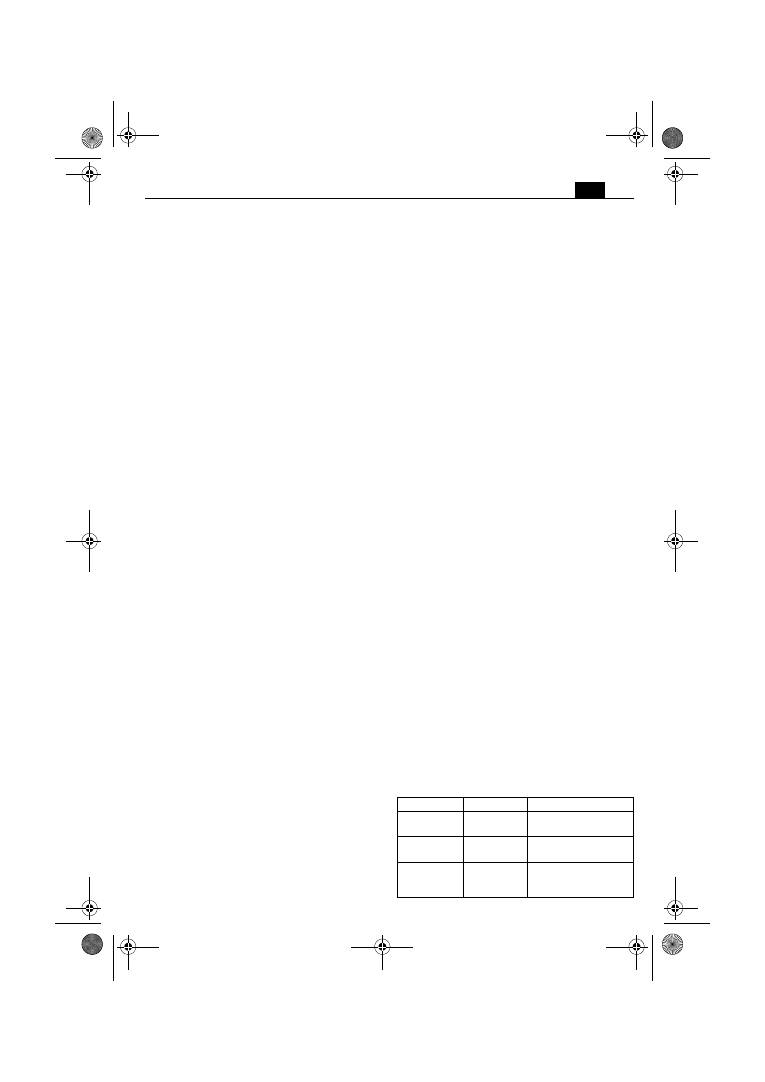
49
no
Bruk kun reservedeler eller tilbehør som er levert og god-
kjent av produsenten.
En sikker bruk kan ikke garanteres
selv om annet tilbehør som passer til elektroverktøyet
blir benyttet.
Rengjør ventilasjonsåpningene til elektroverktøyet med
ikke-metalliske verktøy med jevne mellomrom.
Motorvif-
ten trekker støv inn i motorhuset. Dette kan forårsake
elektrisk fare når det samles for mye metallstøv.
Se aldri fra små avstander inn i lampen til elektroverktøy-
et. Rett lampelyset aldri mot øynene til andre personer
som befinner seg i nærheten.
Strålingen som genereres
av lampen kan være skadelig for øyet.
Rett ikke el-verktøyet mot deg selv, andre personer eller
dyr.
Det er fare for skader pga. skarpe eller varme innsats-
verktøy.
Bruk og behandling av batteriet (batteriblokken).
Ta hensyn til følgende informasjoner for å unngå farer
som forbrenning, brann, eksplosjon, hudskader og andre
skader ved bruk av batteriet:
Batterier må ikke tas fra hverandre, åpnes eller hakkes
opp. Ikke utsett batteriene for mekaniske støt.
Ved ska-
der og usakkyndig bruk av batteriet kan det slippe ut ska-
delig damp og væske. Dampen kan irritere
åndedrettsorganene. Batterivæske som renner ut kan
føre til irritasjoner på huden eller forbrenninger.
Hvis det er kommet batterivæske på gjenstander, må
disse rengjøres eller eventuelt skiftes ut.
Ikke utsett batteriene for varme eller ild. Batteriene må
ikke lagres i direkte sol.
Ta batteriet først ut av originalemballasjen når det skal
brukes.
Ta batteriet ut av elektroverktøyet før det utføres arbeid
på elektroverktøyet.
Hvis elektroverktøyet starter utilsik-
tet, er det fare for skader.
Ta batteriet kun ut når elektroverktøyet er slått av.
Hold batteriet unna barn.
Hold batteriet rent og beskyttet mot fuktighet og vann.
Rengjør de tilsmussede kontaktene på batteriet og el-
verktøyet med en tørr, ren klut.
Bruk kun intakte originale FEIN-batterier, som er bereg-
net for dette el-verktøyet.
Ved arbeid eller opplading av
uoriginale, skadede, reparerte eller modifiserte batterier,
etterligninger og batterier fra andre produsenter er det
fare for brann og/eller eksplosjonsfare.
Følg sikkerhetsinformasjonene i driftsinstruksen for bat-
teri-laderen.
Hånd-arm-vibrasjoner
Vibrasjonsnivået som er angitt i disse anvisningene er
målt iht. en målemetode som er standardisert i EN 60745
og kan brukes til sammenligning av elektroverktøy med
hverandre. Den egner seg også til en foreløpig vurdering
av svingningsbelastningen.
Det angitte svingningsnivået representerer de vanlige
anvendelsene til elektro-verktøyet. Men hvis elektro-
verktøyet brukes til andre anvendelser, med avvikende
innsatsverktøy eller utilstrekkelig vedlikehold, kan sving-
ningsnivået avvike. Dette kan øke vibrasjonsbelastningen
tydelig for hele arbeidstiden.
Til en nøyaktig vurdering av vibrasjonsbelastningen bør
det også tas hensyn til tidene når maskinen var utkoblet
eller går, men ikke virkelig brukes. Dette kan redusere
vibrasjonsbelastningen tydelig for hele arbeidstiden.
Bestem ekstra sikkerhetstiltak for å beskytte brukeren
mot svingningsvirkninger som for eksempel: Vedlikehold
av elektroverktøy og innsatsverktøy, holde hendene
varme, organisere arbeidsforløpene.
Håndtering av farlig støv
I arbeidsprosesser der dette verktøyet fjerner deler av
materialer kan det oppstå støv som kan være farlig.
Berøring eller innånding av noen typer støv som f. eks. av
asbest og asbestholdige materialer, blyholdig maling,
metall, noen tresorter, mineraler, silikatpartikler av stein-
holdige materialer, løsemidler for maling, trebeskyttel-
sesmidler, bunnstoff for båter kan utløse allergiske
reaksjoner og/eller åndedrettssykdommer, kreft, for-
plantningsskader hos mennesker. Risikoen ved innånding
av støv er avhengig av eksponeringen. Bruk en avsuging
som passer til støvet som oppstår, bruk personlig beskyt-
telsesutstyr og sørg for en god ventilasjon av arbeidsplas-
sen. Overlat bearbeidelsen av asbestholdig material kun
til fagfolk.
Trestøv og lettmetallstøv, varme blandinger av slipestøv
og kjemiske stoffer kan ved ugustige vilkår antenne seg
selv og forårsake en eksplosjon. Unngå gnistsprut i ret-
ning av støvbeholderen og en overoppheting av el-verk-
tøyet og slipematerialet, tøm støvbeholderen i tide, følg
bearbeidelsesinstruksene til materialprodusenten og de
gyldige nasjonale forskriftene for materialene som skal
bearbeides.
Bruksinformasjon.
Betjen dreieretningsbryteren og girvalgbryteren kun når
motoren står stille.
Skyv girvalgbryteren eller drei valgbryteren driftsart
(ASB14/18) alltid inn til anslaget. Elektroverktøyet kan
ellers bli skadet.
Ved overbelastning utkoples elektroverktøyet.
Sett høyre-/venstre-bryteren i midtstilling for å unngå en
utilsiktet start, f. eks. ved transport.
Innstilling av dreiemomentet
Fabrikkinnstillingen tilsvarer området for mindre til mid-
dels store skruer.
Tiltrekkingsmomentet er også avhengig av kraften elek-
troverktøyet trykkes mot skruen med.
Håndtering av batteriet.
Bruk og lad batteriet kun opp i et batteri-driftstempera-
turomårde på 0 °C – 45 °C (32 °F – 113 °F). Batteri-tem-
peraturen må være i batteri-driftstemperaturområdet når
oppladingen påbegynnes.
LED-indikator
Betydning
Aksjon
1 – 4 grønne
LED
Prosentual
ladetilstand
Drift
Rødt konti-
nuerlig lys
Batteriet er
nesten tomt
Lad opp batteriet
Rødt blinklys
Batteriet er
ikke drifts-
klart
Få batteriet inn i batteri-
driftstemperaturområ-
det, lad deretter opp
OBJ_BUCH-0000000105-001.book Page 49 Thursday, April 4, 2013 10:23 AM
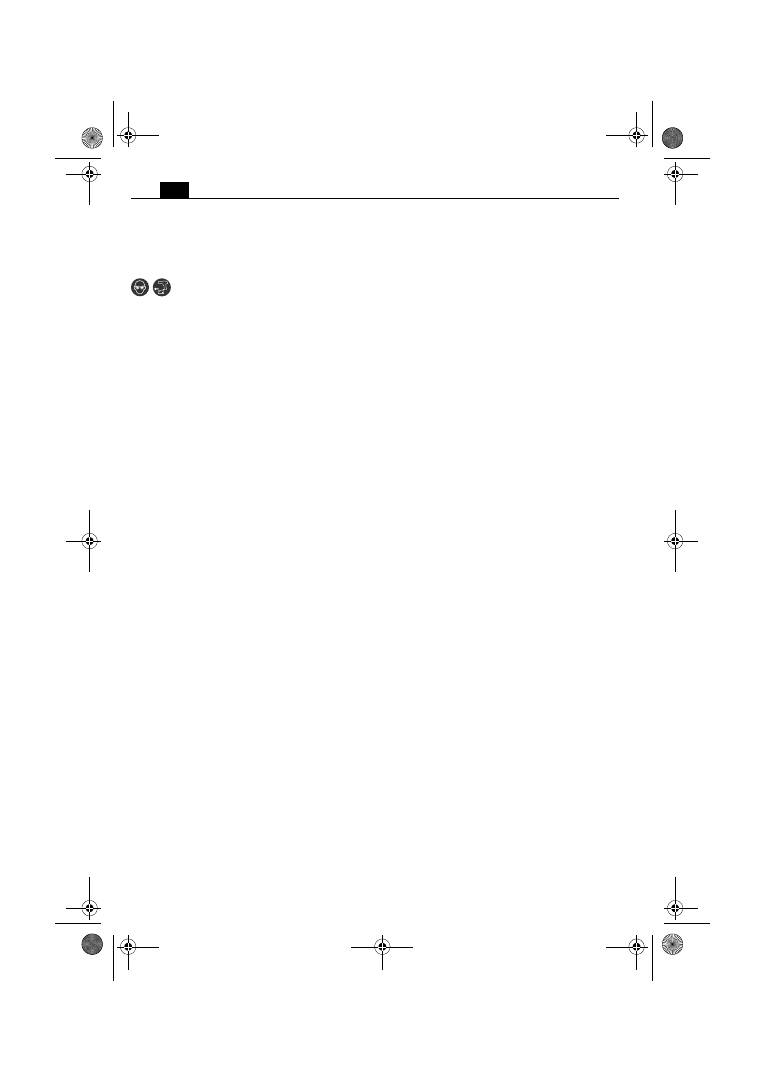
50
no
Den ekte prosentuale ladetilstanden til batteriet anvises
kun når motoren på elektroverktøyet er stanset.
Motoren stoppes automatisk av elektronikken når batte-
riet er utladet.
Vedlikehold og kundeservice.
Ved ekstreme bruksvilkår kan det ved bearbei-
delse av metall sette seg metallstøv inne i elek-
troverktøyet. Dette kan forårsake kortslutning
eller overslag. Blås ofte gjennom de innvendige delene av
elektroverktøyet gjennom ventilasjonsspaltene med tørr
og oljefri trykkluft.
Den aktuelle reservedelslisten for dette elektroverktøyet
finner du på internettet under www.fein.com.
Følgende deler kan du skifte ut selv etter behov:
innsatsverktøy, batteri
Reklamasjonsrett og garanti.
Reklamasjonsretten for produktet gjelder jf. de lovmes-
sige bestemmelsene i det landet produktet selges i. Ut
over dette yter FEIN garanti i henhold til FEIN-produsen-
tens garantierklæring.
Denne driftsinstruksen kan inneholde beskrivelser
og/eller illustrasjoner av tilbehør som ikke inngår i din
leveranse.
Samsvarserklæring.
Firmaet FEIN erklærer som eneansvarlig at dette produk-
tet stemmer overens med de vanlige bestemmelsene som
er oppført på siste side i denne driftsinstruksen.
Tekniske underlag hos: C. & E. FEIN GmbH, C-DB_IA,
D-73529 Schwäbisch Gmünd
Miljøvern, deponering.
Emballasjer, gammelt elektroverktøy og tilbehør må leve-
res inn til miljøvennlig resirkulering.
Batterier må kun leveres inn til korrekt deponering i utla-
det tilstand.
Hvis batteriene ikke er helt utladet må kontaktene isole-
res med tape, slik at det ikke oppstår en kortslutning.
OBJ_BUCH-0000000105-001.book Page 50 Thursday, April 4, 2013 10:23 AM
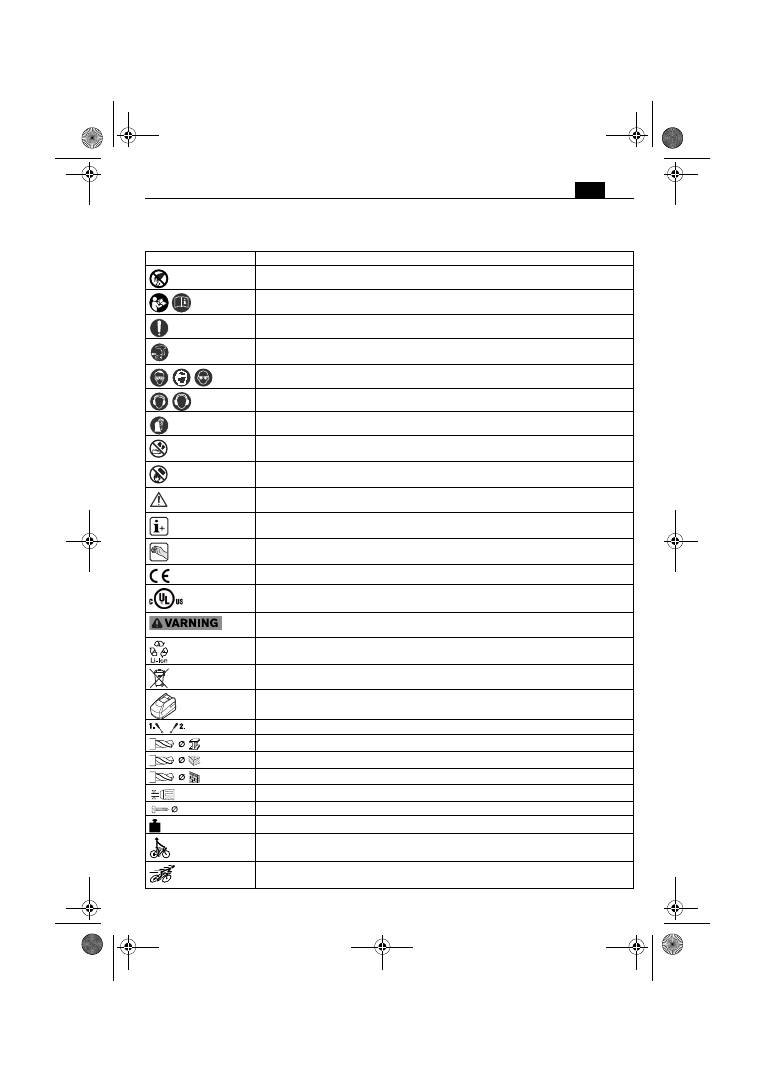
51
sv
sv
Bruksanvisning i original.
Använda symboler, förkortningar och begrepp.
Symbol, tecken
Förklaring
Berör inte elverktygets roterande delar.
Bifogad dokumentation som t.ex. bruksanvisningen och Allmänna säkerhetsanvisningarna
ska ovillkorligen läsas.
Följ anvisningarna i texten eller grafiken!
Före detta arbetsmoment ska batteriet tas ur elverktyget. I annat fall finns risk för att
elverktyget vid oavsiktlig start orsakar kroppsskada.
Vid arbetet ska ögonskydd användas.
Vid arbetet ska hörselskydd användas.
Vid arbetet ska handskydd användas.
Ladda inte batterier av främmande fabrikat.
Utsätt inte batteriet för eld. Skydda batteriet mot hög värme som t. ex. långtids solbestrål-
ning.
Beakta anvisningarna i intilliggande text!
Tilläggsinformation.
Greppområde
Försäkrar om att elverktyget överensstämmer med Europeiska gemenskapens direktiv.
Denna symbol bekräftar produktens certifiering i USA och Canada.
Denna anvisning hänvisar till en eventuellt farlig situation som kan leda till allvarliga per-
sonskador eller till död.
Återvinningsmärke: märket anger att materialet är återanvändbart
Kasserade elverktyg och andra elektrotekniska och elektriska produkter ska omhändertas
och hanteras på miljövänligt sätt.
Batterityp
1. Växelläget/2. Växelläget
Borrdiameter stål
Borrdiameter trä
Borrdiameter sten
Borrchuckens inspänningsområde
Skruvdiameter
Vikt enligt EPTA-Procedure 01/2003
Lågt varvtal
Högt varvtal
Fe
OBJ_BUCH-0000000105-001.book Page 51 Thursday, April 4, 2013 10:23 AM
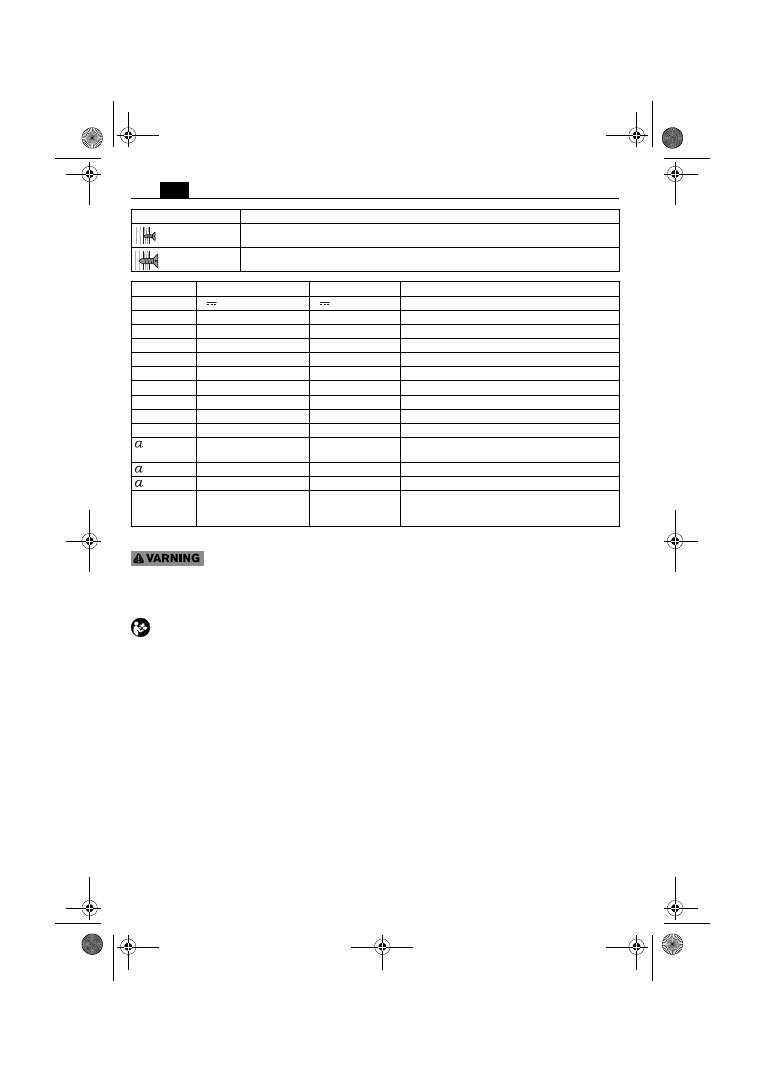
52
sv
För din säkerhet.
Läs noga igenom alla säkerhetsanvis-
ningar och instruktioner.
Fel som upp-
står till följd av att säkerhetsanvisningarna och
instruktionerna inte följts kan orsaka elstöt, brand
och/eller allvarliga personskador.
Förvara alla varningar och anvisningar för framtida bruk.
Använd inte detta elverktyg innan du noggrant läst
och fullständigt förstått denna instruktionsbok
samt bifogade „Allmänna säkerhetsanvisningar“
(publikationsnummer 3 41 30 054 06 1). Dessa underlag
bör förvaras för senare användning och ska bifogas
elverktyget vid överlåtelse eller försäljning.
Beakta även tillämpliga nationella arbetarskyddsbestäm-
melser.
Avsedd användning av elverktyget:
ABS14, ABS18:
handhållen borrskruvdragare för i- och urdragning av
skruvar och muttrar, för borrning och skruvdragning i
metall, trä, plast och keramik och för gängskärning med
av FEIN godkända insatsverktyg och tillbehör utan vatten-
tillförsel i väderskyddad omgivning.
ASB14, ASB18:
handhållen slagborrskruvdragare för i- och urdragning av
skruvar och muttrar, för borrning och skruvdragning i
metall, trä, plast och keramik och för gängskärning och
slagborrning i betong, sten och tegel med av FEIN god-
kända insatsverktyg och tillbehör utan vattentillförsel i
väderskyddad omgivning.
Speciella säkerhetsanvisningar.
Håll i elverktyget endast vid de isolerade greppytorna när
arbeten utförs på ställen där skruven kan skada dolda
elledningar.
Kontakt med en spänningsförande ledning
kan sätta elverktygets metalldelar under spänning och
leda till elstöt.
Se upp för dolt liggande elledningar, gas- och vattenrör.
Kontrollera arbetsområdet t. ex. med en metalldetektor
innan arbetet påbörjas.
Använd personlig skyddsutrustning. Använd alltefter
avsett arbete ansiktsskärm, ögonskydd eller skyddsglas-
ögon. Om så behövs, använd dammfiltermask, hörsel-
skydd, skyddshandskar eller skyddsförkläde som
skyddar mot små utslungade slip- och materialpartiklar.
Ögonen ska skyddas mot utslungade främmande partiklar
som kan uppstå under arbetet. Damm- och andnings-
skydd måste kunna filtrera bort det damm som eventuellt
uppstår under arbetet. Risk finns för hörselskada under
en längre tids kraftigt buller.
Använd hörselskydd vid slagborrning.
Buller kan orsaka
hörselskada.
Säkra arbetsstycket.
Arbetsstycket ligger säkrare i en
uppspänningsanordning än i handen.
Håll stadigt tag i elverktyget.
Höga reaktionsmoment kan
kortvarigt uppstå.
Asbesthaltigt material får inte bearbetas.
Asbest anses
vara cancerframkallande.
Det är förbjudet att med skruvar eller nitar fästa brickor
och märken på elverktyget.
En skadad isolering skyddar
inte längre mot elstöt. Använd dekaler.
Reducera vridmomentet
Öka vridmomentet
Tecken
Internationell enhet
Nationell enhet
Förklaring
U
V
V
Elektrisk likspänning
f
Hz
Hz
Frekvens
n
0
/min, min
-1
, rpm, r/min
r/min
Tomgångsvarvtal (med fulladdat batteri)
n
S
/min, min
-1
rpm
Slagfrekvens
M...
Nm
Nm
Vridmoment (hårt/mjukt skruvförband)
Ø
mm
mm
Diameter för en rund komponent
L
pA
dB
dB
Ljudtrycksnivå
L
wA
dB
dB
Ljudeffektnivå
L
pCpeak
dB
dB
Toppljudtrycksnivå
K...
Onoggrannhet
m/s
2
m/s
2
Vibrationsemissionsvärde enligt EN 60745
(vektorsumma i tre riktningar)
h,D
m/s
2
m/s
2
Medelvibrationsvärde för borrning i metall
h,ID
m/s
2
m/s
2
Medelvibrationsvärde för slagborrning i betong
m, s, kg, A, mm, V,
W, Hz, N, °C, dB,
min, m/s
2
m, s, kg, A, mm, V,
W, Hz, N, °C, dB,
min, m/s
2
Bas- och härledda enheter från det Internationella
enhetssystemet
SI
.
Symbol, tecken
Förklaring
OBJ_BUCH-0000000105-001.book Page 52 Thursday, April 4, 2013 10:23 AM
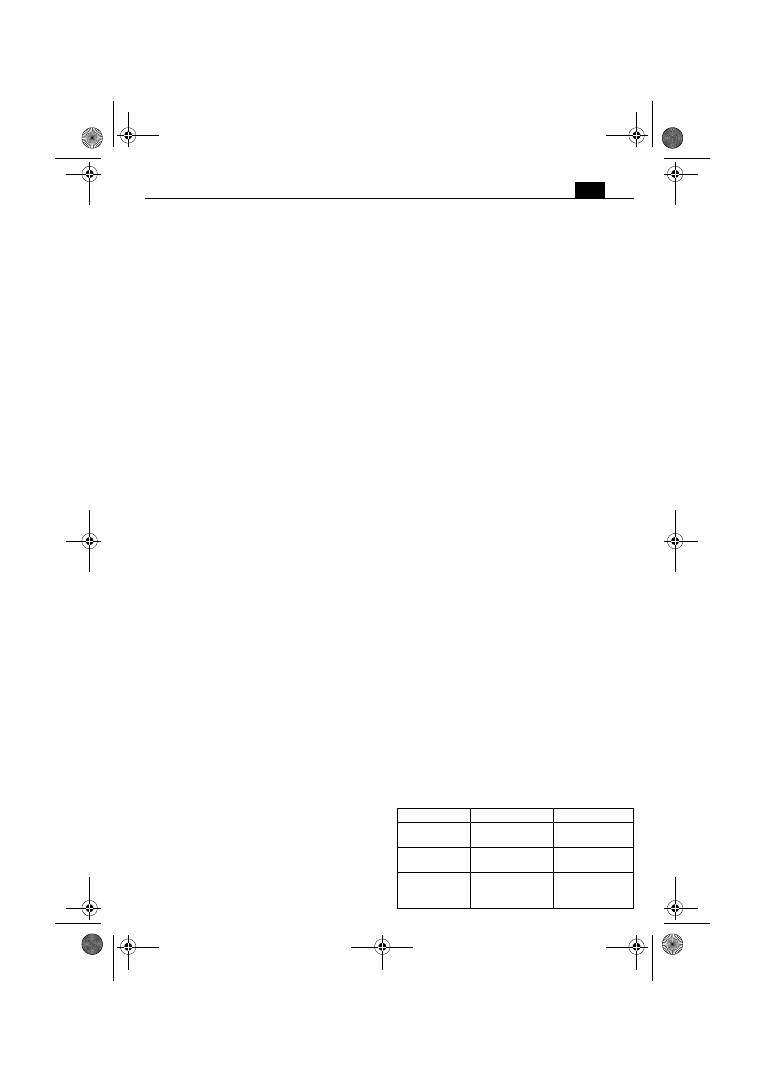
53
sv
Använd endast tillbehör som speciellt tagits fram eller
godkänts av elverktygets tillverkare.
Användningen
behöver inte vara säker bara för att tillbehöret passar till
elverktyget.
Rengör regelbundet elverktygets ventilationsöppningar
med verktyg som inte består av metall.
Motorns fläkt drar
in damm till motorhuset. Vid kraftig koncentration kan
metalldammet orsaka elektrisk fara.
Rikta inte på nära håll blicken mot ljuset från elverkty-
gets lampa. Rikta inte lampans ljus mot ögonen på perso-
ner som befinner sig i närheten.
Lampans strålning kan
skada ögat.
Rikta inte elverktyget mot dig själv, andra personer eller
djur.
Risk finns att vassa eller heta elverktyg orsakar per-
sonskada.
Användning och hantering av batterier
(batterimoduler).
För undvikande av faror som t. ex. brandskador, explo-
sion, hudskador och andra personskador vid hantering
med batterierna ska följande anvisningar följas:
Batterierna får inte tas isär och inte heller krossas. Utsätt
inte batterierna för mekaniska stötar.
Ett skadat eller
felanvänt batteri kan orsaka hälsovådliga ångor och väts-
kor. Ångorna kan leda till irritation i andningsvägarna.
Batterivätskan kan medföra hudirritation eller brännska-
da.
Om batterivätskan vätt intilliggande föremål, kontrollera
berörda delar, rengör eller byt dem vid behov.
Utsätt inte batteriet för hetta eller eld. Låt inte batteriet
ligga i solljus.
Plocka upp batteriet ur originalförpackningen först när
det ska användas.
För alla åtgärder på elverktyget ta batteriet ur elverkty-
get.
Om elverktyget startar oavsiktligt finns risk för
kroppsskada.
Frånkoppla först elverktyget innan batteriet tas ut.
Håll barn på betryggande avstånd från batterier.
Håll batteriet rent och skydda det mot fukt och vatten.
Rengör batteriets och elverktygets nedsmutsade anslut-
ningar med en torr, ren trasa.
Använd endast felfria original FEIN-batterier som är
avsedda för elverktyget.
Vid åtgärder på och laddning av
felaktiga, skadade, reparerade, renoverade, kopierade
batterier eller batterier av främmande fabrikat finns risk
för brand och/eller explosion.
Följ säkerhetsanvisningarna i batteriladdarens bruksan-
visning.
Hand-arm-vibrationer
Mätningen av den vibrationsnivå som anges i denna anvis-
ning har utförts enligt en mätmetod som är standardise-
rad i EN 60745 och kan användas vid jämförelse av olika
elverktyg. Den kan även tillämpas för preliminär bedöm-
ning av vibrationsbelastningen.
Den angivna vibrationsnivån representerar elverktygets
huvudsakliga användningsområden. Om däremot elverk-
tyget används för andra ändamål och med andra insats-
verktyg eller inte underhållits ordentligt kan
vibrationsnivån avvika. Detta kan öka vibrationsbelast-
ningen väsentligt under den totala tidsperioden.
För exakt värdering av vibrationsbelastningen under en
bestämd tidsperiod bör hänsyn även tas till den tid
elverktyget har varit avstängt eller gått utan att vara i
verkligt ingrepp. Detta kan minska vibrationsbelastningen
väsentligt under den totala tidsperioden.
Bestäm extra säkerhetsåtgärder för att skydda operatö-
ren mot vibrationernas inverkan, t. ex.: underhåll av
elverktyget och insatsverktygen, att hålla händerna
varma, organisera arbetsförloppen.
Hantering av hälsovådligt damm
Om verktyget används för sågning av vissa material kan
hälsovådligt damm uppstå.
Beröring eller inandning av vissa damm som t. ex. asbest
och asbesthaltigt material, blyhaltig målning, metall, vissa
trädslag, mineraler, silikatpartiklar från stenhaltigt mate-
rial, färglösningsmedel, träskyddsmedel, antifouling för
vattenfordon kan hos personer utlösa allergiska reaktio-
ner och/eller andningsbesvär, cancer, fortplantnings-
skada. Risken vid inandning av damm är beroende av
expositionen. Använd en utsugning som är lämplig för det
damm som bildas, personlig skyddsutrustning och se till
att arbetsplatsen är väl ventilerad. Låt en fackman bear-
beta asbesthaltigt material.
Trädamm och lättmetallsdamm, het blandning av slip-
damm och kemiska ämnen kan under ogynnsamma för-
hållanden antändas eller explodera. Undvik gnistor i
riktning mot dammbehållaren samt överhettning av
elverktyget och slipmaterialet, töm i god tid dammbehål-
laren, beakta materialtillverkarens anvisningar för bear-
betning samt de föreskrifter för bearbetat material som
gäller i ditt land.
Användningsinstruktioner.
Påverka riktningsomkopplaren och växelomkopplaren
endast på frånkopplad motor.
Skjut växellägesomkopplaren resp. vrid funktionsom-
kopplaren (ASB14/18) alltid mot anslag. I annat fall kan
elverktyget skadas.
Vid överbelastning kopplar elverktyget från.
Ställ riktningsomkopplaren i mittläge för att undvika oav-
siktlig driftstart, t. ex. vid transport.
Inställning av vridmoment
Vid fabriken har skruvdragaren ställts in i läge för mindre
och medelstora skruvar.
Åtdragningsmomentet är även beroende av den kraft
med vilken elverktyget trycks mot skruven.
Hantering av batterier.
Använd och ladda batteriet endast inom temperaturom-
rådet 0 °C – 45 °C (32 °F – 113 °F). Batteriets temperatur
måste vid start av laddning ligga inom driftstemperatur-
området.
LED-indikering
Betydelse
Aktion
1 – 4 gröna LED procentuellt ladd-
ningstillstånd
Drift
kontinuerligt
rött ljus
Batteriet är nästan
urladdat
Ladda batteriet
rött blinkljus
Batteriet är inte
driftklart
Låt batteriet anta
driftstemperatur
innan det laddas
OBJ_BUCH-0000000105-001.book Page 53 Thursday, April 4, 2013 10:23 AM
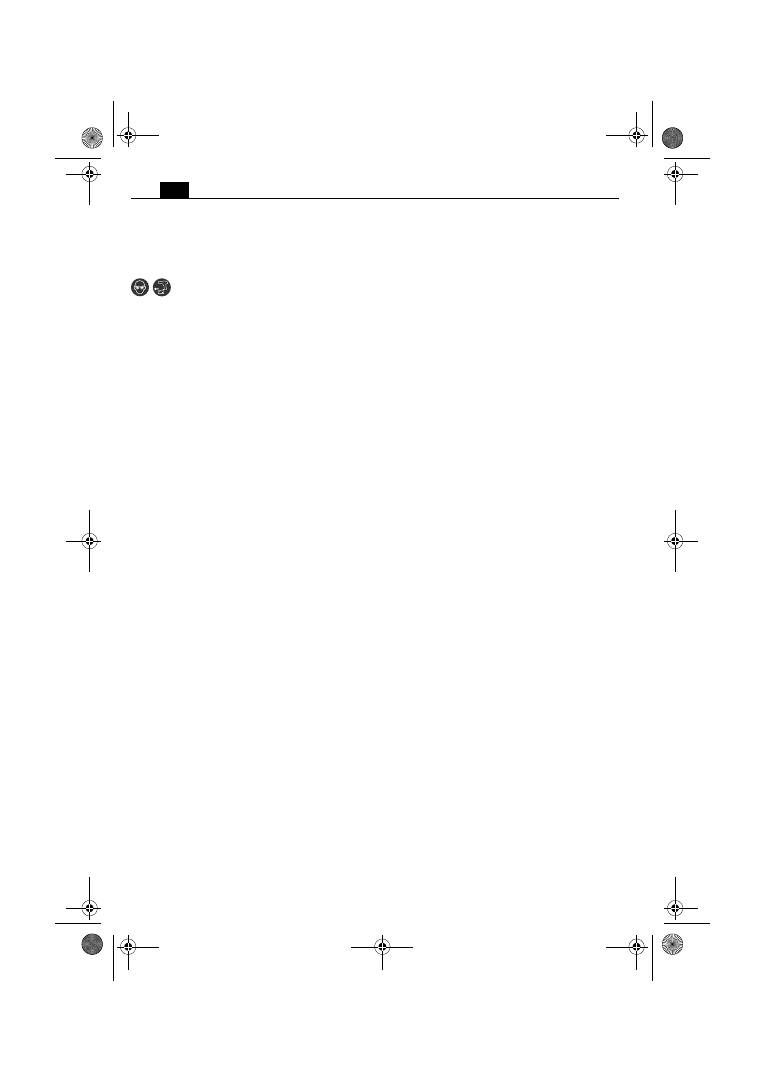
54
sv
Batteriets faktiska laddningstillstånd indikeras endast när
elverktygets motor stängts av.
När en djupurladdning av batteriet hotar, stannar elektro-
niken automatiskt motorn.
Underhåll och kundservice.
Vid bearbetning av metall kan under extrema
betingelser ledande damm samlas i elverkty-
gets inre. Renblås ofta elverktygets inre genom
ventilationsöppningarna med torr och oljefri tryckluft.
Den aktuella reservdelslistan för detta elverktyg hittar du
i Internet på adress: www.fein.com.
Följande delar kan du vid behov själv byta ut:
insatsverktyg, batteri
Garanti och tilläggsgaranti.
Garanti lämnas på produkten enligt de lagbestämmelser
som gäller i aktuellt användningsland. Dessutom lämnar
FEIN en tilläggsgaranti enligt FEIN-tillverkargaranti-
förklaring.
Vid leverans av aktuellt elverktyg kan vissa delar saknas av
de tillbehör som beskrivs eller visas i bruksanvisningen.
Försäkran om överensstämmelse.
FEIN försäkrar under exklusivt ansvar att denna produkt
överensstämmer med de normativa dokument som anges
på instruktionsbokens sista sida.
Tekniska publikationer finns hos: C. & E. FEIN GmbH,
C-DB_IA, D-73529 Schwäbisch Gmünd
Miljöskydd, avfallshantering.
Förpackning, skrotade elverktyg och tillbehör ska hante-
ras på miljövänligt sätt.
Avfallshantera batterier endast i urladdat tillstånd.
Om batteriet inte är fullständigt urladdat, isolera stick-
kontakten med tejp för att undvika kortslutning.
OBJ_BUCH-0000000105-001.book Page 54 Thursday, April 4, 2013 10:23 AM
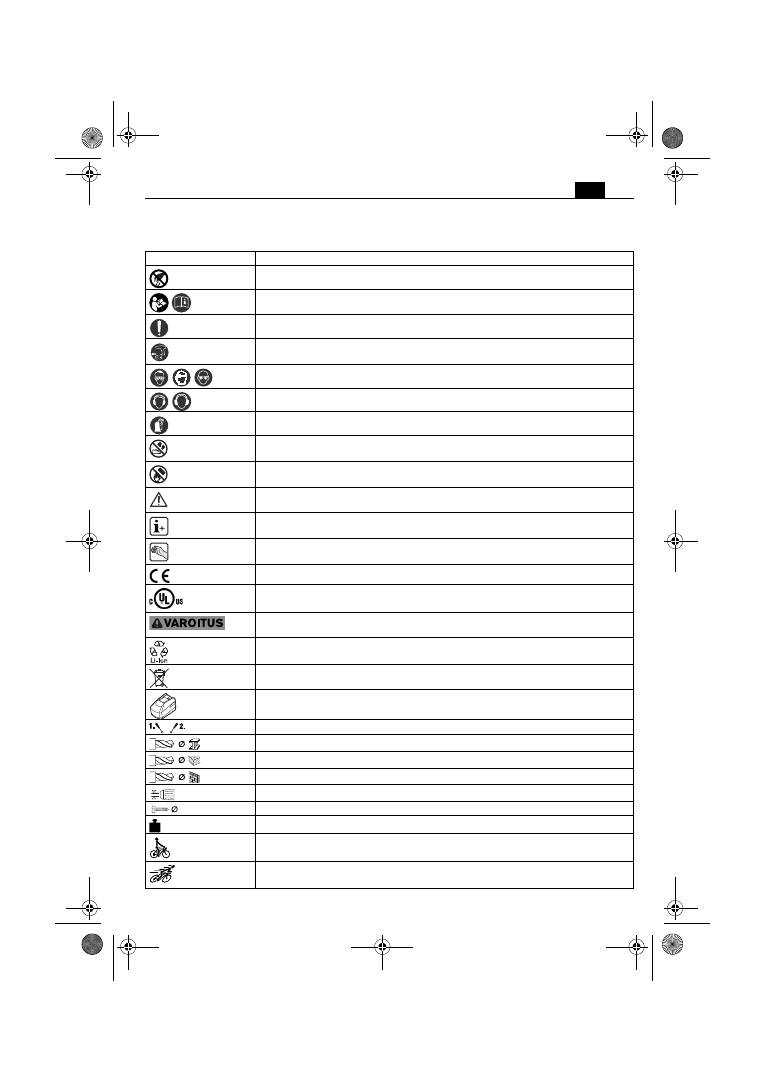
55
fi
fi
Alkuperäinen käyttöohje.
Symbolit, lyhenteet ja erikoissanasto.
Piktogrammit
Selitys
Sähkötyökalun pyöriviin osiin ei saa koskea.
Oheisiin dokumentteihin sekä käyttöohjeisiin ja yleisiin turvaohjeisiin on ehdottomasti
perehdyttävä.
Noudata viereisen tekstin tai grafiikan ohjeita!
Ennen tätä työvaihetta akku on otettava irti sähkötyökalusta. Muutoin sähkötyökalu voi
käynnistyä itsestään ja aiheuttaa tapaturman.
Työstön aikana silmät on suojattava laseilla.
Työstön aikana on käytettävä kuulosuojainta.
Työstön aikana on käytettävä suojakäsineitä.
Vioittunutta akkua ei saa ladata.
Akkua ei saa viedä lähelle avotulta. Akku on suojattava kuumuudelta, esim. suoralta aurin-
gonpaisteelta.
Noudata viereisen tekstin ohjeita!
Lisätietoja.
Kahvapinta
Vahvistaa, että sähkötyökalun rakenne vastaa EU-direktiivien suosituksia.
Tämä symboli vahvistaa tuotteen sertifioinnin USA:ssa ja Kanadassa.
Teksti varoittaa mahdollisesta vaarallisesta tilanteesta, joka voi johtaa vakavaan työtapatur-
maan tai jopa hengenvaaraan.
Kierrätysmerkki: uusiokäyttöön kelpaavien materiaalien tunnistukseen
Vanhat, käytöstä poistetut sähkötyökalut ja muut sähkökäyttöiset laitteet on hävitettävä
ympäristöystävällisesti johtamalla ne kierrätykseen.
Akkutyyppi
1. vaihde/2. vaihde
Poranterän läpimitta: teräs
Poranterän läpimitta: puu
Poranterän läpimitta: kivi
Poraistukan kiristysalue
Ruuvin halkaisija
Paino vastaa EPTA-Procedure 01/2003-tietoja
Alhainen kierroslukualue
Korkea kierroslukualue
Fe
OBJ_BUCH-0000000105-001.book Page 55 Thursday, April 4, 2013 10:23 AM
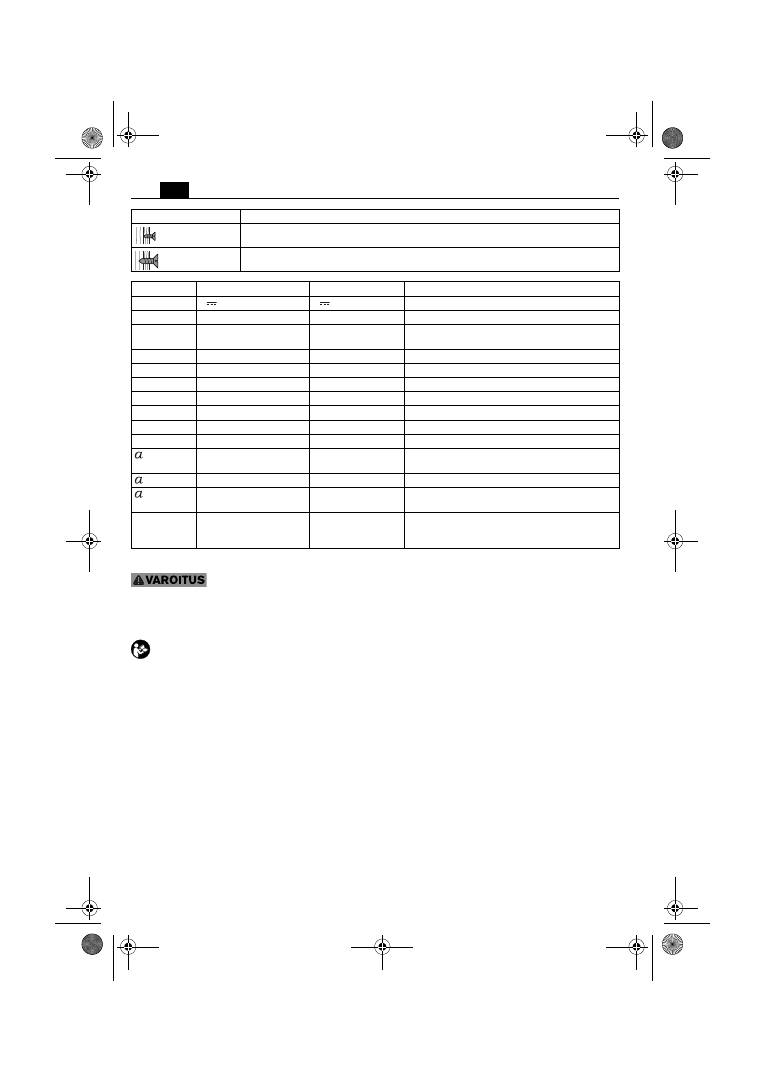
56
fi
Työturvallisuus.
Lue kaikki turvallisuus- ja muut
ohjeet.
Turvallisuusohjeiden laimin-
lyönti saattaa johtaa sähköiskuun, tulipaloon ja/tai vaka-
vaan loukkaantumiseen.
Säilytä kaikki turvallisuus- ja muut ohjeet tulevaisuutta
varten.
Sähkötyökalun saa ottaa käyttöön vasta sitten, kun
ensin on perehdytty käyttöohjeeseen sekä oheisiin
yleisiin turvaohjeisiin (julkaisunumero
3 41 30 054 06 1) niin, että niissä annetut ohjeet tulevat
ymmärretyiksi. Säilytä kyseiset dokumentit vastaisuuden
varalta ja anna ne mukaan, mikäli laite luovutetaan toisen
käyttöön tai myydään eteenpäin.
Niiden ohella on noudatettava voimassa olevia lakisäätei-
siä työturvallisuusmääräyksiä.
Sähkötyökalun käyttökohteet:
ABS14, ABS18:
porakone ruuvien ja mutterien käsivaraiseen kiinnityk-
seen ja irrotukseen, porausten ja ruuvausten tekoon
metalliin, puuhun, muoviin ja keramiikkaan sekä kiertei-
den leikkaukseen ilman vesijäähdytystä. Sähkötyökalu on
suunniteltu käytettäväksi säältä suojatuissa tiloissa ja siinä
saa käyttää vain FEIN:in hyväksymiä työkaluja ja lisätarvik-
keita.
ASB14, ASB18:
iskuporakone ruuvien ja mutterien käsivaraiseen kiinni-
tykseen ja irrotukseen, porausten ja ruuvausten tekoon
metalliin, puuhun, muoviin ja keramiikkaan sekä kiertei-
den leikkaukseen ilman vesijäähdytystä. Sähkötyökalu on
suunniteltu käytettäväksi säältä suojatuissa tiloissa ja siinä
saa käyttää vain FEIN:in hyväksymiä työkaluja ja lisätarvik-
keita.
Erityiset varotoimenpiteet.
Pidä sähkötyökalua eristetyistä pinnoista, tehdessäsi
työtä, jossa ruuvi saattaisi osua piilossa olevaan sähkö-
johtoon.
Jos laite osuu jännitteelliseen johtoon, sen metal-
liset osat saattavat johtaa sähköä, mistä on seurauksena
sähköisku.
Varo rakenteissa olevia sähköjohtoja ja kaasu- ja vesi-
putkia.
Tarkasta ennen töiden aloittamista työkohde
esim. metallinilmaisimella.
Muista henkilökohtaiset suojavarusteet. Käytä työstöti-
lanteesta riippuen kasvosuojainta, silmäsuojainta tai
suojalaseja. Jos mahdollista, käytä pölysuojainta, kuulo-
suojainta, suojakäsineitä tai erikoisvaatetusta, joka
antaa suojan ilmaan sinkoilevilta hioma- ja materiaali-
hiukkasilta.
Varsinkin silmät on suojattava eri työstöta-
voilla ilmaan sinkoilevilta hiukkasilta. Pöly- ja
hengityssuojainten täytyy pystyä suodattamaan työstössä
syntyvä pöly. Pitkäaikainen altistuminen melulle saattaa
heikentää kuuloa.
Iskuporauksessa on käytettävä kuulosuojainta.
Meluhai-
tat voivat huonontaa kuuloa.
Varmista työkappaleen asento.
Kun työkappale kiinnite-
tään sopivaan työpenkkiin, sitä on parempi käsitellä kuin
käsin kiinni pidettäessä.
Pidä työkalua tukevassa otteessa.
Reaktiomomentit voi-
vat lyhytaikaisesti olla erittäin korkeat.
Kiristysmomentti pienemmälle
Kiristysmomentti suuremmalle
Merkki
Kansainvälinen yksikkö
Kansallinen yksikkö
Selitys
U
V
V
Tasajännite
f
Hz
Hz
Taajuus
n
0
/min, min
-1
, rpm, r/min
min
-1
Kierrosluku tyhjäkäynnillä (akku täydessä varauk-
sessa)
n
S
/min, min
-1
/min
Iskuluku
M...
Nm
Nm
Vääntömomentti (kova/pehmeä materiaali)
Ø
mm
mm
Pyöreän kappaleen läpimitta
L
pA
dB
dB
Äänen painetaso
L
wA
dB
dB
Äänitaso
L
pCpeak
dB
dB
Äänen painetason huippuarvo
K...
Epävarmuustekijä
m/s
2
m/s
2
Tärinäarvo vastaa standardia EN 60745 (vektori-
summa, kolmiulotteinen)
h,D
m/s
2
m/s
2
Keskimääräinen tärinäarvo metalliin porattaessa
h,ID
m/s
2
m/s
2
keskimääräinen värähtelyarvo betonin iskupora-
uksella
m, s, kg, A, mm, V,
W, Hz, N, °C, dB,
min, m/s
2
m, s, kg, A, mm, V,
W, Hz, N, °C, dB,
min, m/s
2
Kansainväliseen
SI
-järjestelmään sisältyvät perus-
yksiköt ja sen johdannaisyksiköt.
Piktogrammit
Selitys
OBJ_BUCH-0000000105-001.book Page 56 Thursday, April 4, 2013 10:23 AM

57
fi
Asbestipitoista materiaalia ei saa työstää.
Asbesti voi
aiheuttaa syöpää.
Sähkötyökaluun ei saa kiinnittää kilpiä tms. poraamalla
tai niittaamalla.
Jos koneen eristystä vioitetaan, seurauk-
sena voi olla sähköiskun vaara. Suositamme tarrakiinnit-
teisiä kilpiä.
Käytä ainoastaan lisävarusteita, jotka ovat joko sähkö-
työkalun valmistajan alkuperäisosia tai muutoin valmis-
tajan hyväksymiä.
Vaikka jokin vierasvalmisteinen
lisävaruste sopisikin sähkökoneeseen, se ei välttämättä
ole turvallinen käyttää.
Työkalun ilmanottoaukot on puhdistettava säännöllisesti
sopivin apuvälinein (metallisia työkaluja ei saa käyttää).
Puhallin imee pölyä moottorin rungon sisään.
Jos metalli-
pitoista pölyä pääsee kerääntymään liikaa, siitä koituu säh-
köiskun vaara.
Suoraan sähkötyökalun lampun valoon ei koskaan pidä
katsoa pieneltä etäisyydeltä. Lampun valoa ei myöskään
pidä suunnata suoraan toisten lähellä olevien silmiin.
Lampusta tuleva säteily voi olla vahingollista silmille.
Sähkötyökalua ei saa suunnata suoraan itseen, muihin
henkilöihin tai eläimiin päin.
Terävistä tai kuumentu-
neista työkaluista aiheutuu tapaturman vaara.
Akkujen käyttö ja käsittely.
Jotta akkuja käsiteltäessä vältetään vaarat ja riskit –
palon- tai räjähdyksen vaara, palovammat, ihovammat ja
muut tapaturmat –, on noudatettava seuraavia ohjeita:
Akkuja ei saa purkaa, avata eikä pilkkoa. Akkuihin ei saa
kohdistaa mekaanisia iskuja.
Väärän käsittelyn seurauk-
sena vioittuneesta akusta voi purkautua haitallista höyryä
ja akkunestettä. Akkunestehöyryt voivat ärsyttää hengi-
tysteitä. Iholle päässyt akkuneste voi ärstyttää tai syövyt-
tää ihoa.
Jos viallisesta akusta on virrannut ulos akkunestettä vie-
ressä olevien esineiden päälle, tarkista kyseiset kohdat
ja pese ne, tarvittaessa osat on vaihdettava uusiin.
Akkua ei saa viedä lähelle lämpölähteitä tai avotulta.
Akkua ei saa varastoida paikassa, mihin osuu auringon-
valo.
Ota akku ulos alkuperäispakkauksesta vasta sitten, kun
se otetaan käyttöön.
Irrota akku aina ensin sähkötyökalusta, ennen kuin ryh-
dyt valmistelemaan töitä.
Jos sähkötyökalu käynnistyy
vahingossa, se voi aiheuttaa tapaturman.
Sähkötyökalu on kytkettävä pois päältä, ennen kuin akku
irrotetaan.
Pidä akut poissa lasten ulottuvilta.
Akku on pidettävä puhtaana ja suojattava kosteudelta ja
vedeltä.
Puhdista lika akun ja sähkötyökalun liitännöistä
kuivalla, puhtaalla liinalla.
Käytä aina vain ehjiä, alkuperäisiä FEIN-akkuja, jotka on
suunniteltu kyseiseen sähkötyökaluun.
Mikäli koneessa
käytetään vääräntyyppisiä, vioittuneita, kunnostetttuja tai
kierrätettyjä akkuja, piraattituotteita tai vieraan valmista-
jan akkuja, ja tällaisia akkuja ladattaessa on olemassa tuli-
palon ja/tai räjähdyksen vaara.
Noudata latauslaitteen käyttöohjeessa annettuja turva-
ohjeita.
Käsiin ja käsivarsiin kohdistuva tärinä
Tässä ohjeessa ilmoitettu tärinätaso on mitattu standardin
EN 60745 mukaista mittausmenetelmää noudattaen ja
sitä voidaan soveltaa verrattaessa sähkötyökalujen arvoja
keskenään. Arvoa voidaan soveltaa myös arvioitaessa
alustavasti värinästä aiheutuvaa kuormitusta.
Ilmoitettu tärinätaso vastaa sähkötyökalun pääasiallisia
käyttösovelluksia. Mikäli sähkötyökalua käytetään muihin
tarkoituksiin tai siinä käytetään muita lisätarvikkeita tai
mikäli työkalun huolto on puutteellinen, tärinätaso saat-
taa poiketa tässä ilmoitetusta. Siinä tapauksessa tärinätaso
voi nousta selvästi koko työkohteessa.
Tärinätason tarkan arvioinnin kannalta on tärkeää ottaa
huomioon myös ne ajat, jolloin sähkötyökalu on kytketty
pois päältä sekä ajat, jolloin työkalu on käynnissä, mutta
sillä ei työstetä materiaalia. Siinä tapauksessa tärinätaso
voi nousta selvästi koko työkohteessa.
Jotta koneen käyttäjä välttyisi tärinän aiheuttamilta hai-
toilta, on hyvä sopia ylimääräisistä turvajärjestelyistä,
esim. laatia ohjeet sähkökoneen ja sen työkalujen huol-
losta, työvaiheiden organisoinnista ja työturvallisuudesta.
Terveydelle vaarallisten pölyjen käsittely
Työvaiheissa, joissa työkalulla lastutaan materiaalia, voi
syntyä vaarallista pölyä.
Tietyntyyppisen pölyn koskettaminen tai hengittäminen
voi aiheuttaa allergisia reaktioita ja/tai hengitysteiden sai-
rauksia, syöpää tai hedelmällisyyteen vaikuttavia vauri-
oita. Tällaista pölyä voi erittyä esim. asbestista ja
asbestipitoisista materiaaleista, lyijypitoisista maaleista,
metallista, eräistä puulaaduista, mineraaleista, kivipitoi-
sista materiaaleista erittyvistä silikaateista, maalinpoistoai-
neista, puunsuoja-aineista sekä eliöntorjunta-aineista.
Riskin suuruus pölyjä hengitettäessä riippuu niiden mää-
rästä. Suositamme käyttämään tarkoitukseen sopivaa
poistoimuria sekä henkilökohtaista suojavarustusta ja
huolehtimaan työpaikan riittävästä tuuletuksesta. Asbesti-
pitoisen materiaalin työstö on paras jättää ammattihenki-
lökunnan hoidettavaksi.
Puupöly ja kevytmetallipöly sekä hionnassa syntyvä pöly
yhdessä kemiallisten aineiden kanssa voivat epäsuotuisis-
sa olosuhteissa syttyä itsestään palamaan tai aiheuttaa
räjähdyksen. Kipinöintiä pölysäiliön läheisyydessä on väl-
tettävä, samoin sähkötyökalun ja hiottavan esineen yli-
kuumenemista. Pölysäiliö on hyvä tyhjentää ajoissa.
Materiaalin valmistajan työstöohjeita on noudatettava,
samoin kuin maakohtaisesti voimassa olevia, kyseisten
materiaalien työstöön liittyviä määräyksiä.
Työstöohjeita.
Pyörimissuunnan ja vaihdealueen saa vaihtaa ko. kytkimil-
lä vasta kun moottori on pysähtynyt.
Työnnä vaihdealueen valitsin ja kierrä käyttötavan valitsin
(ASB14/18) aina ääriasentoon saakka. Muutoin sähkötyö-
kalu voi vioittua.
Ylikuormituksella sähkötyökalu kytkeytyy pois päältä.
Jotta kone ei voi epähuomiossa käynnistyä (esim. kulje-
tuksen aikana), pyörimissuunnan valitsin on hyvä asettaa
keskiasentoon.
OBJ_BUCH-0000000105-001.book Page 57 Thursday, April 4, 2013 10:23 AM
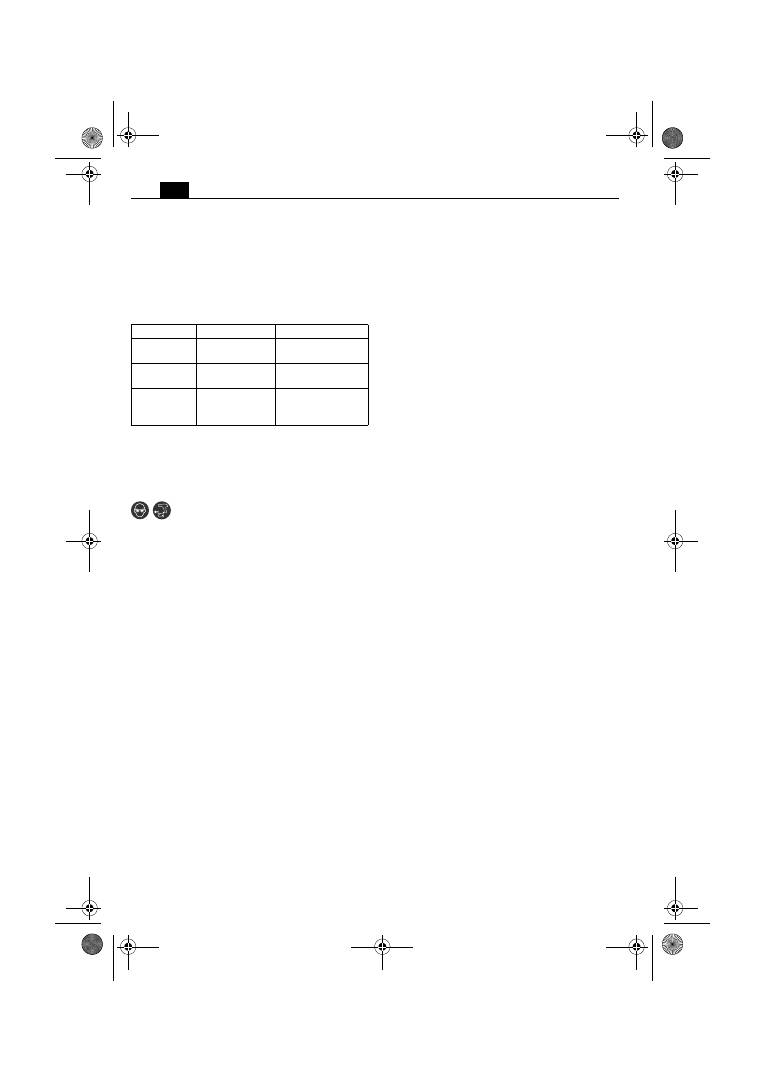
58
fi
Kiristysmomentin säätö
Tehdasasetus vastaa aluetta pienikokoisista keskikokoi-
siin ruuveihin.
Kiristysmomenttiin vaikuttaa myös voima, jolla työkalua
painetaan ruuvia vasten.
Akkujen asianmukainen käsittely.
Akkua saa käyttää ja ladata sen vain käyttölämpötiloissa
0 °C – 45 °C (32 °F – 113 °F). Latausta aloitettaessa on
akun lämpötilan oltava sallitulla käyttölämpötila-alueella.
Akun prosentuaalinen latausaste näkyy vain silloin, kun
sähkökoneen moottori on pysäytetty.
Jos akun varaustila laskee liikaa, elektroninen valvontapiiri
pysäyttää moottorin automaattisesti.
Kunnossapito, huolto.
Raskaissa käyttöolosuhteissa voi metalleja
työstettäessä koneen sisään kerääntyä sähköä
johtavaa metallipölyä. Sähkökone on siksi hyvä
puhdistaa sisältä säännöllisin välein puhaltamalla kuivaa,
öljytöntä paineilmaa koneen ilmanvaihtoaukkoihin.
Tähän sähkötyökaluun kuuluvan varaosaluettelon voi
hakea internet-osoitteesta www.fein.com.
Seuraavat osat voi tarvittaessa vaihtaa itse:
työkalut, akku.
Takuu.
Tuotteeseen pätee takuu, joka vaaditaan sen tuonti-
maassa. Sen ohella pätee FEINin takuuehdoissa määrittä-
mä valmistajakohtainen takuu.
Kaikki tässä käyttöohjeessa mainitut tai kuvissa esitetyt
lisätarvikkeet eivät välttämättä kuulu sähkötyökalun toi-
mitussisältöön.
EU-vastaavuus.
Tmi. FEIN vakuuttaa ja vastaa yksin siitä, että tämä tuote
on käyttöohjeen viimeisellä sivulla mainittujen määräys-
ten ja standardien mukainen.
Teknisen dokumentaation laatinut: C. & E. FEIN GmbH,
C-DB_IA, D-73529 Schwäbisch Gmünd
Ympäristönsuojelu, jätehuolto.
Pakkausmateriaalit, käytöstä poistetut sähkötyökalut sekä
lisävarusteet on johdettava kierrätykseen.
Käytettyjen akkujen on oltava purkautuneessa tilassa, kun
ne hävitetään.
Jos akku ei ole täysin tyhjä, sen liitin on eristettävä tarra-
nauhalla oikosulkujen välttämiseksi.
LED-valo
Merkitys
Toimenpide
1 – 4 vihreä
LED
prosentuaalinen
varaustila
Käyttötila
punainen
jatkuva valo
Akku on lähes
tyhjä
Akku ladattava
punainen
vilkkuvalo
Akku ei ole käyt-
tövalmiudessa
Anna akun lämmetä
käyttölämpötilaan ja
lataa se sitten
OBJ_BUCH-0000000105-001.book Page 58 Thursday, April 4, 2013 10:23 AM
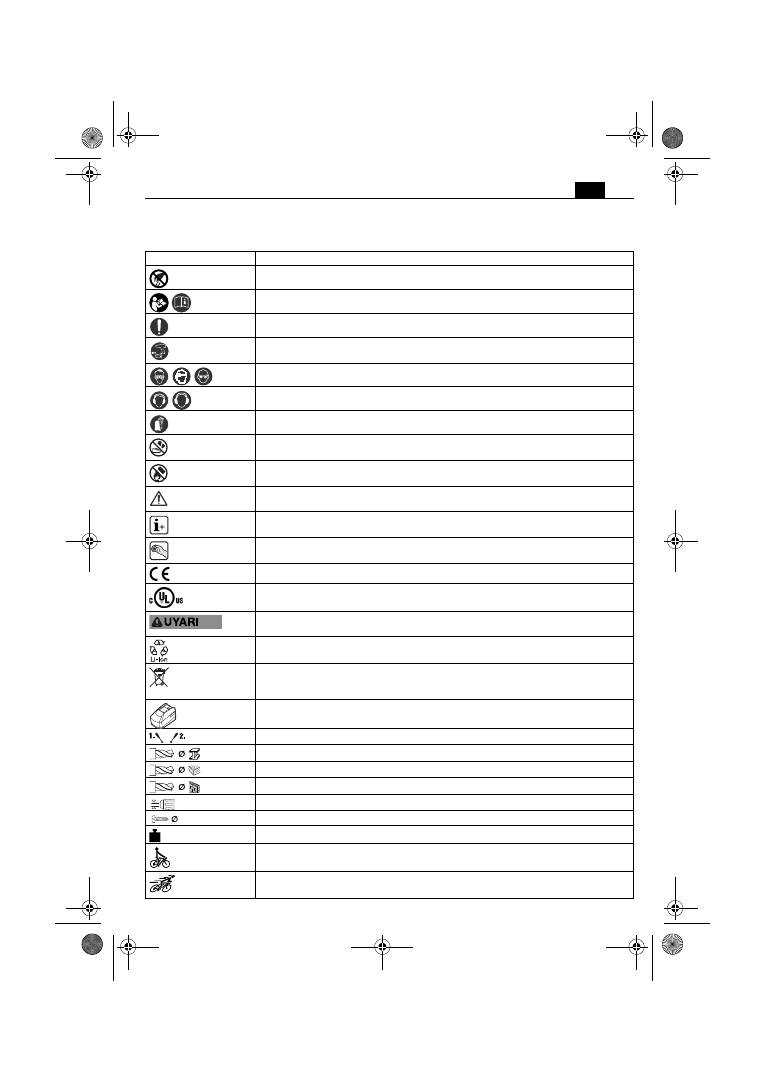
59
tr
tr
Orijinal kullanım kılavuzu.
Kullanılan semboller, kısaltmalar ve kavramlar.
Sembol, işaret
Açıklama
Elektrikli el aletinin dönen parçalarına dokunmayın.
Kullanma kılavuzu ve genel güvenlik talimatı gibi ekteki belgeleri mutlaka okuyun.
Yandaki metin veya grafikteki talimata uyun!
Bu iş aşamasına başlamadan önce aküyü elektrikli el aletinden çakarın. Aksi takdirde
elektrikli el aletinin istenmeden çalışması durumunda yaralanma tehlikesi vardır.
Çalışırken koruyucu gözlük kullanın.
Çalışırken koruyucu kulaklık kullanın.
Çalışırken koruyucu eldiven kullanın.
Hasarlı aküleri şarj etmeyin.
Aküyü ateşe yaklaştırmayın. Aküyü aşırı sıcağa, örneğin sürekli gelen güneş ışınına karşı
koruyun.
Yandaki metinde bulunan uyarılara uyun!
Ek bilgiler.
Tutma yüzeyi
Elektrikli el aletinin Avrupa Birliği yönetmeliklerine uyumlu olduğunu onaylar.
Bu sembol bu ürünün ABD ve Kanada’da sertifikalandırılmış olduğunu onaylar.
Bu uyarı, ciddi yaralanmalara veya ölüme neden olabilecek muhtemel tehlikeli bir durumu
gösterir.
Recycling işareti: Tekrar kullanılabilen malzemeyi gösterir
Kullanım ömrünü tamamlamış elektrikli el aletleri ve diğer elektro teknik ve elektrikli
ürünler ayrı ayrı toplanmak ve çevre dostu geri kazanım merkezlerine gönderilmek
zorundadır.
Akü tipi
1. Vites/2. Vites
Çelikte delme çapı
Ahşapta delme çapı
Taşta delme çapı
Mandren sıkma kapasitesi
Vida çapı
Ağırlığı EPTA-Procedure 01/2003’e uygun
Düşük devir sayısı
Yüksek devir sayısı
Fe
OBJ_BUCH-0000000105-001.book Page 59 Thursday, April 4, 2013 10:23 AM
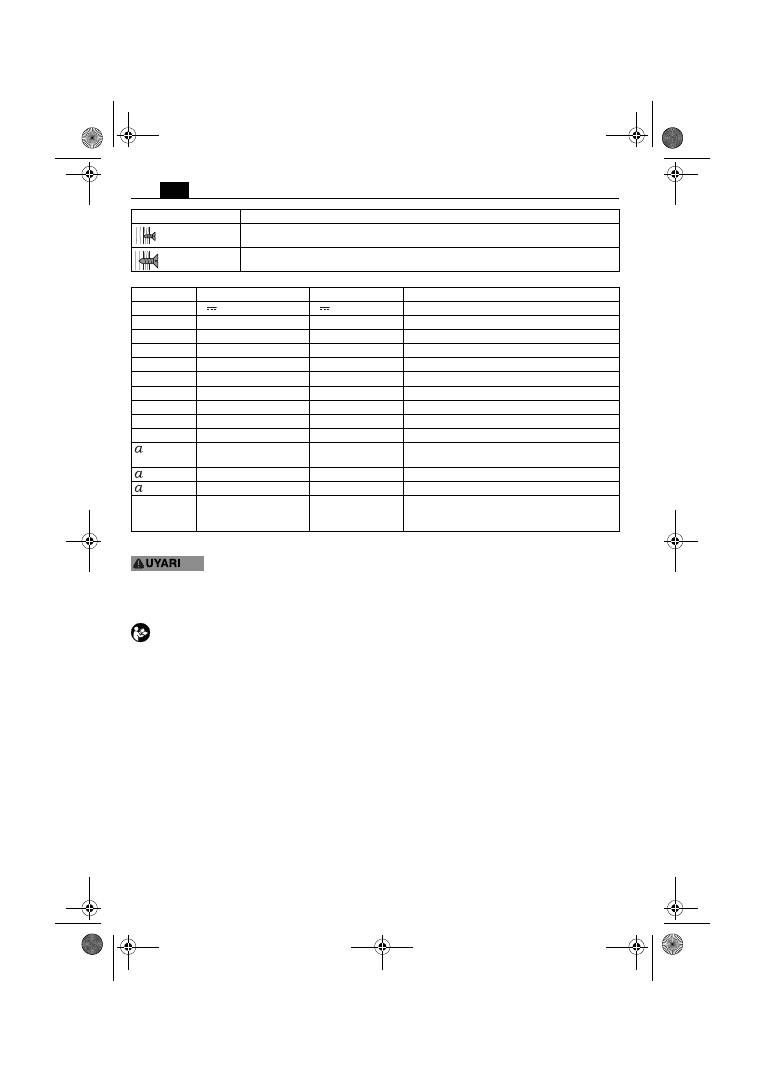
60
tr
Güvenliğiniz için.
Bütün güvenlik talimat ve uyarılarını
okuyun.
Güvenlik talimat ve
uyarılarına uyulmadığı takdirde elektrik çarpması, yangın
ve/veya ağır yaralanmalara neden olunabilir.
Bütün güvenlik talimatı ve uyarılarını ilerde kullanmak
üzere saklayın.
Bu kullanma kılavuzunu ve ekteki “Genel güvenlik
talimatı” ’nı (ürün kodu 3 41 30 054 06 1) esaslı
biçimde okuyup tam olarak anlamadan bu elektrikli
el aletini kullanmayın. Anılan belgeleri ileride kullanmak
üzere saklayın ve elektrikli el aletini başkalarına
verdiğinizde veya devrettiğinizde bu belgeleri de verin.
İlgili ulusal çalışma hükümlerine de uyun.
Elektrikli el aletinin tanımı:
ABS14, ABS18:
Hava koşullarına karşı korunmalı ortamlarda, FEIN
tarafından izin verilen uçlar ve aksesuarla metal, ahşap,
plastik ve seramik malzemede vidaların ve somunların
takılıp sökülmesi ve delme ve vidalama ve diş açmak için
tasarlanan elle yönlendirilen delme/vidalama makinesi.
ASB14, ASB18:
Hava koşullarına karşı korunmalı ortamlarda, FEIN
tarafından izin verilen uçlar ve aksesuarla metal, ahşap,
plastik ve seramik malzemede vidaların ve somunların
takılıp sökülmesi ve delme ve vidalama ve diş açmak,
beton, taş ve tuğlada su beslemesi olmadan darbeli delme
için tasarlanan elle yönlendirilen darbeli delme/vidalama
makinesi.
Özel güvenlik talimatı.
Vidan n görünmeyen elektrik kablolar na veya aletin
kendi şebeke bağlant kablosuna rastlama olası lı ğı
bulunan işleri yaparken elektrikli el aletini izolasyonlu
tutamağı ndan tutun.
Aletin ucu gerilim altındaki
kablolara temas edecek olursa aletin metal parçaları da
gerilime maruz kalabilir ve kullanıcı elektrik çarpma
tehlikesi ile karşı karşıya kalabilir.
Görünmeyen elektrik kablolarına, gaz ve su borularına
dikkat edin.
Çalışmaya başlamadan önce delme
yapacağınız alanı örneğin bir metal tarama cihazı ile
kontrol edin.
Kişisel koruyucu donanım kullanın. Yaptığınız işe göre
tam yüz siperliği, göz koruma donanımı veya koruyucu
gözlük kullanın. Eğer uygunsa küçük taşlama ve malzeme
parçacıklarına karşı koruma sağlayan toz maskesi,
koruyucu kulaklık, koruyucu iş eldivenleri veya özel iş
önlüğü kullanın.
Gözler çeşitli uygulamalarda etrafa
savrulan parçacıklardan korunmalıdır. Toz veya soluma
maskesi çalışma sırasında ortaya çıkan tozları filtre eder.
Uzun süre yüksek gürültü altında çalışırsanız işitme
kaybına uğrayabilirsiniz.
Darbeli delme işleri yaparken koruyucu kulaklık kullanın.
Gürültü nedeniyle işitme kayıpları olabilir.
İş parçasını emniyete alın.
Bir germe donanımı ile
emniyete alınmış iş parçası elle tutmaya oranla daha
güvenli işlenir.
Çalışırken elektrikli el aletini sıkıca tutun.
Kısa süreli
reaksiyon momentleri ortaya çıkabilir.
Asbest içeren malzemeyi işlemeyin.
Asbest kanserojen
madde kabul edilir.
Tork küçültme
Tork büyütme
Sembol
Uluslar arası birim
Ulusal birim
Açıklama
U
V
V
Elektriksel doğru akım
f
Hz
Hz
Frekans
n
0
/min, min
-1
, rpm, r/min
/dak
Boştaki devir sayısı (akü tam şarjlı durumda)
n
S
/min, min
-1
/dak
Darbe sayısı
M...
Nm
Nm
Tork(sert/yumuşak vidalama)
Ø
mm
mm
Yuvarlak bir parçanın çapı
L
pA
dB
dB
Ses basıncı seviyesi
L
wA
dB
dB
Gürültü emisyonu seviyesi
L
pCpeak
dB
dB
En yüksek ses basıncı seviyesi
K...
Tolerans
m/s
2
m/s
2
Titreşim emisyon değeri EN 60745’e göre
(üç yönün vektör toplamı)
h,D
m/s
2
m/s
2
Metalde delmeye ait orta titreşim değeri
h,ID
m/s
2
m/s
2
Betonda darbeli delmeye ait orta titreşim sayısı
m, s, kg, A, mm, V,
W, Hz, N, °C, dB,
min, m/s
2
m, s, kg, A, mm, V,
W, Hz, N, °C, dB,
dak, m/s
2
Temel ve türetilen değerler uluslar arası birimler
sistemi
SI
’den alınmıştır.
Sembol, işaret
Açıklama
OBJ_BUCH-0000000105-001.book Page 60 Thursday, April 4, 2013 10:23 AM
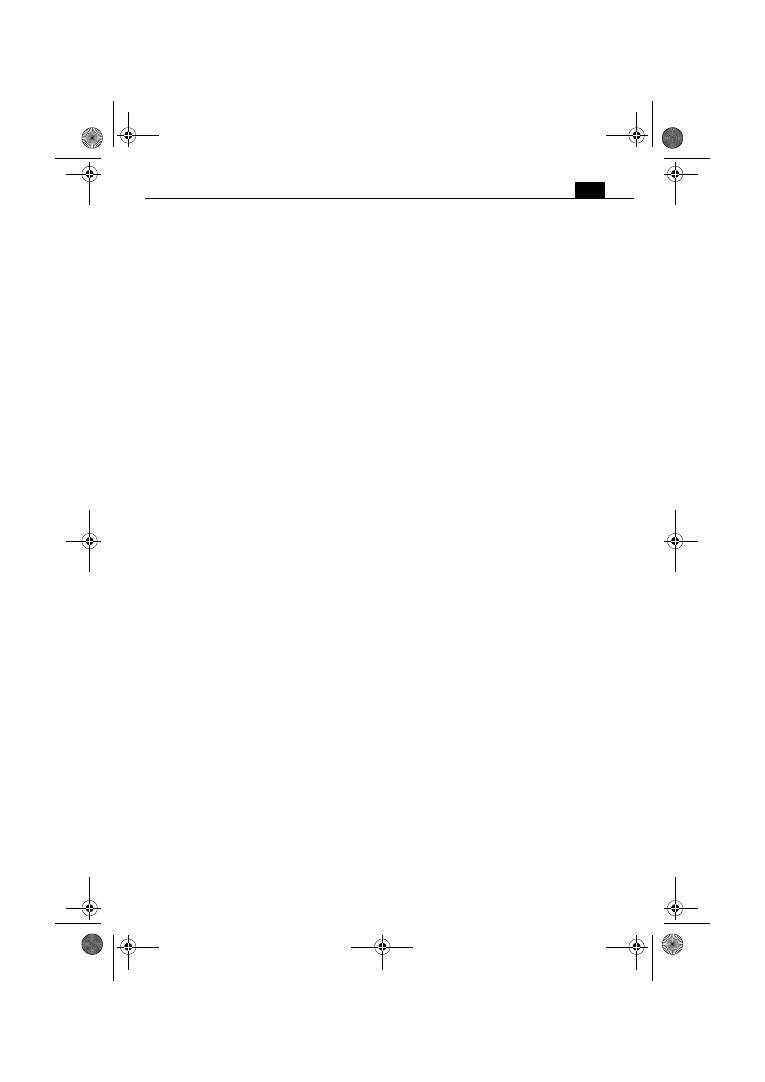
61
tr
Elektrikli el aletinin üstüne etiket ve işaretlerin
vidalanması veya perçinlenmesi yasaktır.
Hasar gören
izolasyon elektrik çarpmasına karşı koruma sağlamaz.
Yapışıcı etiketler kullanın.
Elektrikli el aletinin üreticisi tarafından özel olarak
geliştirilmemiş veya onaylanmamış aksesuar
kullanmayın.
Herhangi bir aksesuarın elektrikli el aletinize
uyması güvenli işletme için tek başına yeterli değildir.
Elektrikli el aletinin havalandırma aralıklarını metal
olmayan araçlarla düzenli aralıklarla temizleyin.
Motor
fanı tozu gövdenin içine çeker. Metal tozunun aşırı ölçüde
birikmesi elektriksel tehlike yaratır.
Hiçbir zaman yakın mesafelerden elektrikli el aletinin
lambasının ışığına bakmayın. Lambanın ışığını hiçbir
zaman yakınınızdaki kişilerin gözlerine doğrultmayın.
Işık
kaynağının yaydığı ışın gözlere zarar verebilir.
Elektrikli el aletini kendinize, başkalarına veya
hayvanlara doğrultmayın.
Keskin veya ısınmış uçlar
nedeniyle yaralanma tehlikesi vardır.
Akünün (akü bloğu) kullanımı ve bakımı.
Akü ile çalışırken yanma, yangın, patlama, cilt
yaralanması veya benzeri yaralanmalardan kaçınmak
için aşağıdaki uyarılara uyun:
Aküler açılmamalı, dağıtılmamalı veya kırılmamalıdır.
Aküleri mekanik çarpma ve darbelere karşı koruyun.
Aküler hasar gördüğü veya usulüne aykırı biçimde
kullanıldığı takdirde zararlı buhar veya sıvılar dışarı
çıkarabilirler. Bu buharlar solunum yollarını tahriş
edebilir. Dışarı çıkan akü sıvısı cilt tahrişlerine veya
yanmalara neden olabilir.
Aküden dışarı sızan sıvı yakınınızdaki nesnelere ulaşacak
olursa, bunları kontrol edin ve sıvının temas ettiği yüzeyi
temizleyin ve gerektiğinde nesneyi değiştirin.
Aküyü sıcağa veya ateşe maruz bırakmayın. Aküyü
doğrudan güneş ışını alan yerlerde saklamayın.
Aküyü ancak kullanacağınız zaman orijinal ambalajından
çıkarın.
Elektrikli el aletinin kendinde bir çalışma yapmadan önce
aküyü aletten çıkarın.
Elektrikli el aleti yanlışlıkla çalışacak
olursa yaralanma tehlikesi ortaya çıkar.
Aküyü sadece elektrikli el aleti kapalı durumda iken
çıkarın.
Aküyü çocuklardan uzak tutun.
Aküyü temiz tutun ve neme ve suya karşı koruyun.
Akünün ve elektrikli el aletinin kirlenen bağlantı yerlerini
kuru ve temiz bir bezle temizleyin.
Sadece elektrikli el aletiniz için tasarlanmış sağlam ve
çalışır durumdaki FEIN akülerini kullanın.
Yanış, hasarlı,
onarım görmüş, modifike edilmiş, taklit veya değişik
marka akülerle çalışmak ve bunları şarj etmek yangın
ve/veya patlamalara neden olabilir.
Akü şarj cihazının kullanım kılavuzundaki güvenlik
talimatı hükümlerine uyun.
El kol titreşimi
Bu talimatta belirtilen titreşim seviyesi EN 60745’e uygun
bir ölçme yöntemi ile belirlenmiş olup, elektrikli el
aletlerinin mukayesesinde kullanılabilir. Bu değer ayrıca
kullanıcıya binen titreşim yükünün geçici olarak tahmin
edilmesine de uygundur.
Belirtilen titreşim seviyesi elektrikli el aletinin temel
kullanımlarına aittir. Ancak elektrikli el aleti farklı uçlar
veya yetersiz bakımla farklı işlerde kullanılacak olursa,
titreşim seviyesinde farklılıklar ortaya çıkabilir. Bu da
toplam çalışma süresinde kullanıcıya binen titreşim
yükünü önemli ölçüde artırabilir.
Kullanıcıya binen titreşim yükünü tam olarak tahmin
edebilmek için, aletin kapalı veya açık olduğu halde
gerçekten kullanımda olmadığı süreler de dikkate
alınmalıdır. Bu, toplam çalışma süresinde kullanıcıya binen
titreşim yükünü önemli ölçüde azaltabilir.
Kullanıcıyı titreşim etkilerine karşı korumak üzere ek
güvenlik önlemleri tespit edin; örneğin: Elektrikli el
aletinin ve uçların bakımı, ellerin sıcak tutulması, iş
süreçlerinin organize edilmesi.
Tehlikeli tozlarda çalışma
Bu aletle malzemelerin kazındığı işlerde tehlikeli
olabilecek tozlar ortaya çıkar.
Örneğin asbest, asbest içeren malzemeler, kurşun içeren
boyalar, metaller, bazı ahşap türleri, mineraller, taş içerikli
malzemelere ait silikat parçacıkları, boya incelticiler, ahşap
koruyucu maddeler, su araçlarında kullanılan zehirli
koruyucu maddelere dokunmak veya bunları solumak
kullanıcılarda alerjik reaksiyonlara ve/veya solunum yolu
hastalıklarına, üreme rahatsızlıklarına neden olabilir.
Tozların solunma tehlikesi yayılımla ilgilidir. Yaptığınız
işte ortaya çıkan toza uygun bir emme tertibatı ve kişisel
koruyucu donanım kullanın ve çalıştığınız yerin iyice
havalandırılmasını sağlayın. Asbest içeren malzemelerin
işlenmesini uzmanlara bırakın.
Ahşap tozu ve hafif metal tozu, kızgın malzeme tozu ile
kimyasal maddelerin karışımı elverişsiz koşullarda
kendiliğinden tutuşabilir ve patlamaya neden olabilir.
Çalışırken ortaya çıkan kıvılcımların toz haznelerine
yönelmesini, elektrikli aletinin ve malzeme kazıma işlemi
esnasında ortaya çıkan malzemenin aşırı ölçüde ısınmasını
önleyin, toz haznelerini zamanında boşaltın, malzeme
üreticisinin talimatlarına ve ülkenizdeki malzeme işleme
yönetmeliklerine uyun.
Çalışırken dikkat edilmesi gereken
hususlar.
Dönme yönü değiştirme şalterini ve vites seçme şalterini
sadece motor dururken kullanın.
Vites seçme şalterini veya işletim türü seçme şalterini
(ASB14/18) daima sonuna kadar itin veya çevirin. Aksi
takdirde elektrikli el aleti hasar görebilir.
Aşırı zorlanma durumunda elektrikli el aleti kapanır.
Örneğin taşıma esnasında yanlışlıkla çalıştırmayı önlemek
için dönme yönü değiştirme şalterini orta konuma getirin.
Tork ayarı
Aletin fabrikasyon ayarı küçük ve orta büyüklükte
vidalara göredir.
Sıkma torku aynı zamanda elektrikli el aletinin vidaya
doğru bastırılma kuvvetine de bağlıdır.
OBJ_BUCH-0000000105-001.book Page 61 Thursday, April 4, 2013 10:23 AM
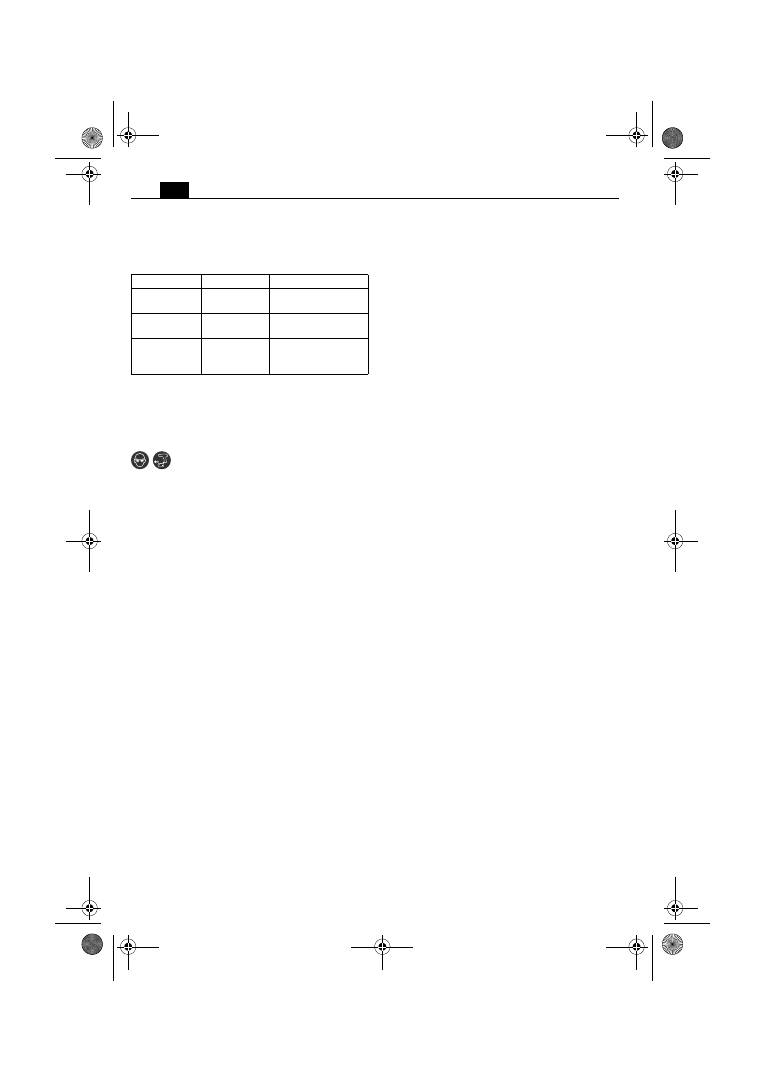
62
tr
Akünün bakımı.
Aküyü sadece 0 °C – 45 °C (32 °F – 113 °F) arasındaki
akü işletme sıcaklığı arasında çalıştırın ve şarj edin. Akü
sıcaklığı şarj işlemi başladığında akü işletme sıcaklığı
arasında olmalıdır.
Akünün yüzde olarak gerçek şarj durumu sadece
elektrikli el aletinin motoru dorurken gösterilir.
Akü derin deşarj durumunda ise elektronik sistem
motoru otomatik olarak durdurur.
Bakım ve müşteri servisi.
Aşırı kullanım koşullarında metaller işlenirken
elektrikli el aletinin içinde iletken toz
birikebilir. Havalandırma aralıklarından kuru ve
yağsız basınçlı hava ile elektrikli el aletinin iç kısmını sık sık
temizleyin.
Bu elektrikli el aletinin güncel yedek parça listesini
İnternette www.fein.com. sayfasında bulabilirsiniz.
Aşağıdaki parçaları gerektiğinde kendiniz de
değiştirebilirsiniz:
uçlar, akü
Teminat ve garanti.
Ürüne ilişkin teminat piyasaya sunulduğu ülkenin yasal
düzenlemeleri çerçevesinde geçerlidir. Ayrıca FEIN, FEIN
üretici garanti beyanına uygun bir garanti sağlar.
Elektrikli el aletinizin teslimat kapsamında bu kullanma
kılavuzunda tanımlanan veya şekli gösterilen aksesuarın
sadece bir parçası da bulunabilir.
Uyumluluk beyanı.
FEIN firması tek sorumlu olarak bu ürünün bu kullanım
kılavuzunun son sayfasında belirtilen ilgili koşullara uygun
olduğunu beyan eder.
Teknik belgelerin bulunduğu merkez: C. & E. FEIN
GmbH, C-DB_IA, D-73529 Schwäbisch Gmünd
Çevre koruma, tasfiye.
Ambalaj malzemesi, kullanım ömrünü tamamlamış
elektrikli el aletleri ve aksesuar çevre dostu geri kazanım
merkezine gönderilmelidir.
Aküleri sadece deşarj olmuş durumda ve çevre koruma
hükümlerine uygun olarak tasfiye yapacak bir merkeze
gönderin.
Tam olarak deşarj olmamış akülerde kısa devre tehlikesini
önlemek üzere bağlantı fişini yapışkan bantla izole edin.
LED gösterge
Anlamı
İşlem
1 – 4 yeşil LED Yüzde olarak
şarj durumu
İşletme
Sürekli kırmızı
ışık
Akü hemen
hemen boş
Aküyü şarj edin
Yanıp sönen
kırmızı ışık
Akü işletmeye
hazır değil
Aküyü akü işletme
sıcaklığı aralağına
getirin, sonra şarj edin
OBJ_BUCH-0000000105-001.book Page 62 Thursday, April 4, 2013 10:23 AM
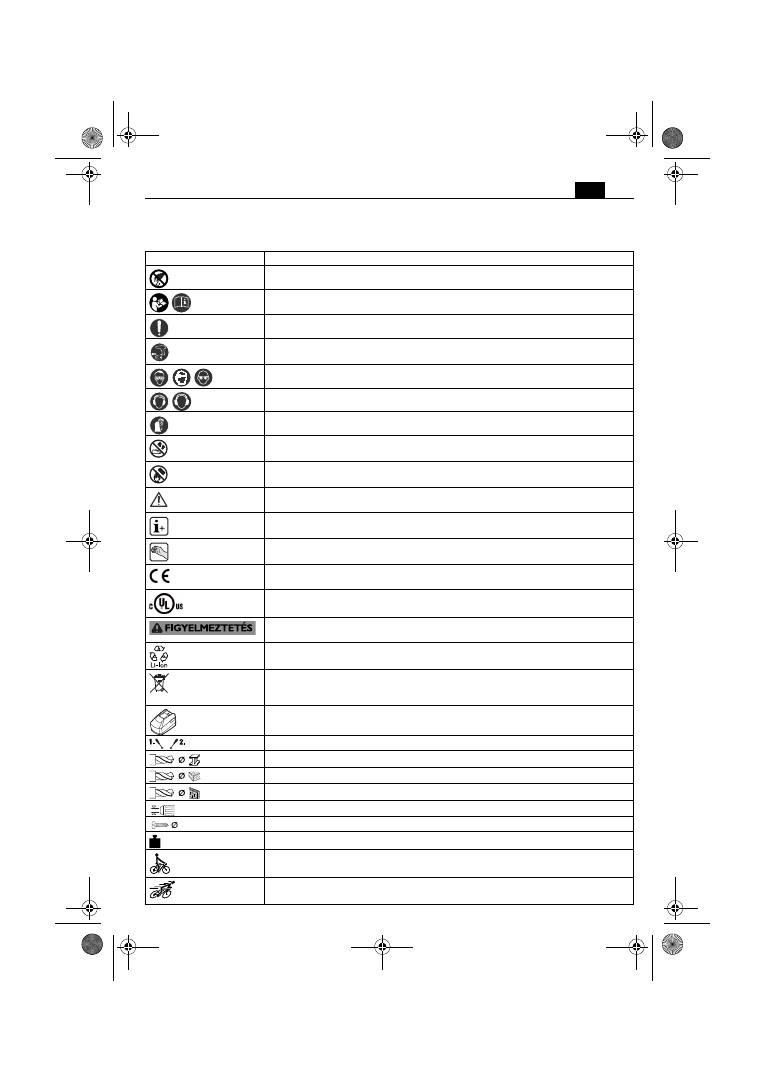
63
hu
hu
Eredeti használati utasítás.
A használt jelölések és fogalmak.
Szimbólumok, jelek
Magyarázat
Ne érjen hozzá az elektromos kéziszerszám forgó alkatrészeihez.
Mindenképpen olvassa el a mellékelt dokumentációt, mint például a kezelési útmutatót
és a biztonsági tájékoztatót.
Tartsa be az oldalsó szövegben vagy ábrán található utasításokat!
Ezelőtt a lépés előtt távolítsa el az akkumulátort az elektromos kéziszerszámból.
Ellenkező esetben az elektromos kéziszerszám akaratlan elindulása sérüléseket okozhat.
A munkák közben használjon védőszemüveget.
A munkák közben használjon zajtompító fülvédőt.
A munkák közben használjon kézvédőt.
Ne töltsön fel megrongálódott akkumulátorokat.
Ne tegye ki az akkumulátort tűz hatásának. Óvja meg az akkumulátort a forróságtól,
például a tartós napsugárzástól.
Ügyeljen a jel mellett álló szövegben található tájékoztatásra!
Kiegészítő információ.
Fogantyú-felület
A CE-jel igazolja, hogy az elektromos kéziszerszám megfelel az Európai Unió
irányelveinek.
Ez a jel igazolja ezen termék igazolásának meglétét az Egyesült Államokban és
Kanadában.
Ez a tájékozató egy lehetséges veszélyes helyzetre figyelmeztet, amely súlyos vagy
halálos sérüléshez vezethet.
Újrafeldolgozás jel: az újraértékesíthető anyagokat jelöli
A használaton kívül helyezett elektromos kéziszerszámokat és egyéb elektrotechnikai
és elektromos termékeket külön össze kell gyűjteni és a környezetvédelmi
szempontoknak megfelelő újrafelhasználásra kell leadni.
Akkumulátor típus
1. Fokozat/2. Fokozat
Furatátmérő acélban
Furatátmérő fában
Furatátmérő kőben
Tokmányba befogható méretek
Csavarátmérő
Súly az „EPTA-Procedure 01/2003” (2003/01 EPTA-szabvány) szerint
Alacsony fordulatszám
Magas fordulatszám
Fe
OBJ_BUCH-0000000105-001.book Page 63 Thursday, April 4, 2013 10:23 AM
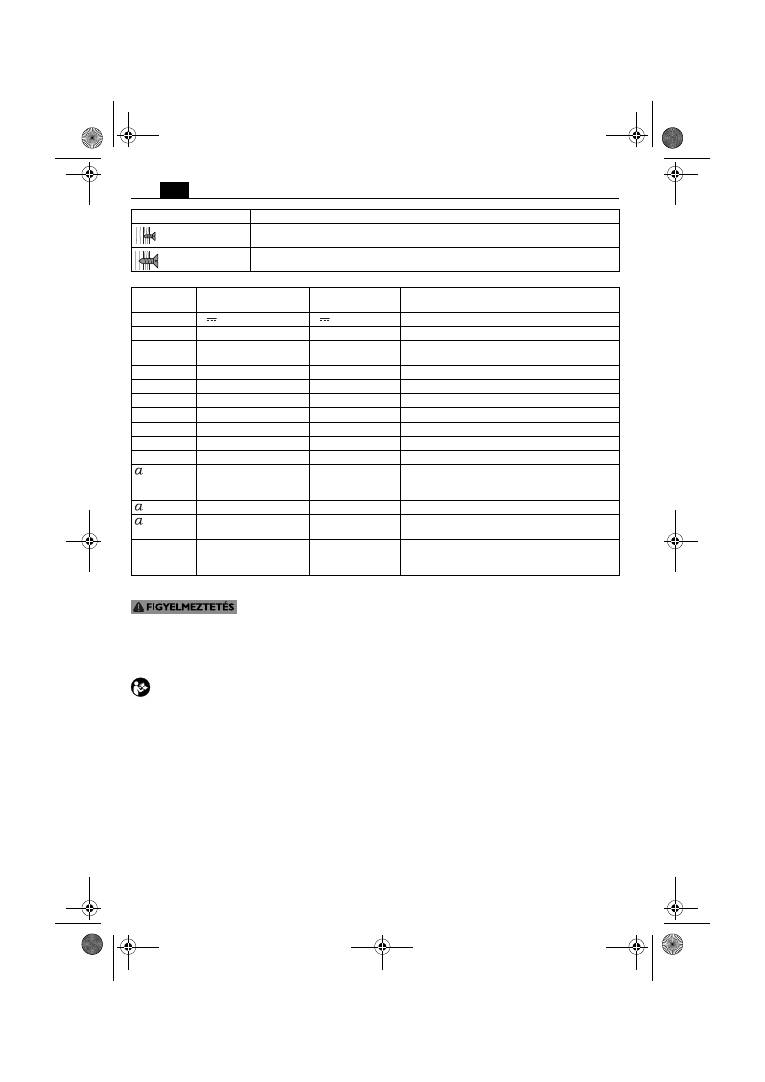
64
hu
Az Ön biztonsága érdekében.
Olvassa el az összes
biztonsági figyelmeztetést és
előírást.
A következőkben leírt előírások betartásának
elmulasztása áramütésekhez, tűzhöz és/vagy súlyos testi
sérülésekhez vezethet.
Kérjük a későbbi használatra gondosan őrizze meg ezeket
az előírásokat.
Ne használja ezt az elektromos kéziszerszámot,
mielőtt gondosan el nem olvasta és meg nem
értette ezt a kezelési útmutatót és a mellékelt
„Általános biztonsági tájékoztatót” (dokumentáció
száma: 3 41 30 054 06 1). A fent megnevezett
dokumentációt a későbbi használathoz őrizze meg és az
elektromos kéziszerszám továbbadása vagy eladása
esetén adja tovább az új tulajdonosnak.
Ugyanígy tartsa be az idevonatkozó helyi munkavédelmi
rendelkezéseket.
Az elektromos kéziszerszám rendeltetése:
ABS14, ABS18:
fúró-csavarozógép az időjárás hatásaitól védett helyen a
FEIN cég által engedélyezett szerszámokkal és
tartozékokkal, kézzel vezetett berendezésként, csavarok
és anyák ki- és behajtására és fémekben, fában,
műanyagokban és kerámiában való vízhozzávezetés
nélküli fúrásra és csavarozásra, valamint menetmetszésre
szolgál.
ASB14, ASB18:
ütvefúró-csavarozógép az időjárás hatásaitól védett
helyen a FEIN cég által engedélyezett szerszámokkal és
tartozékokkal, kézzel vezetett berendezésként, csavarok
és anyák ki- és behajtására és fémekben, fában,
műanyagokban és kerámiában való vízhozzávezetés
nélküli fúrásra és csavarozásra, valamint menetfúrásra és
betonban, kövekben és téglában való ütvefúrásra szolgál.
Biztonsági információk.
Az elektromos kéziszerszámot csak a szigetelt
fogantyúfelületeknél fogva tartsa, ha olyan munkát
végez, amelynek során a csavar feszültség alatt álló,
kívülről nem látható vezetékekhez érhet.
Ha a
berendezés egy feszültség alatt álló vezetékhez ér, az
elektromos kéziszerszám fémrészei szintén feszültség alá
kerülhetnek és áramütéshez vezethetnek.
Ügyeljen a munkaterület alatt fekvő rejtett elektromos
vezetékekre, gáz- és vízcsövekre.
Ellenőrizze a munka
megkezdése előtt a munkaterületet, használjon ehhez
például egy fémkereső készüléket.
Viseljen személyi védőfelszerelést. Használjon az
alkalmazásnak megfelelő teljes védőálarcot,
szemvédőt vagy védőszemüveget. Amennyiben célszerű,
viseljen porvédő álarcot, zajtompító fülvédőt,
védő kesztyűt vagy különleges kötényt, amely távol tartja
a csiszolószerszám- és anyagrészecskéket.
A forgatónyomaték csökkentése
A forgatónyomaték növelése
Jel
Nemzetközi egység
Magyarországon
használatos egység
Magyarázat
U
V
V
Elektromos egyenfeszültség
f
Hz
Hz
Frekvencia
n
0
/min, min
-1
, rpm, r/min
/perc
Üresjárati fordulatszám (teljesen feltöltött
akkumulátor mellett)
n
S
/min, min
-1
/perc
Ütésszám
M...
Nm
Nm
Forgatónyomaték (kemény/lágy csavarozás)
Ø
mm
mm
Egy körkeresztmetszetű alkatrész átmérője
L
pA
dB
dB
Hangnyomás szint
L
wA
dB
dB
Hangteljesítmény szint
L
pCpeak
dB
dB
Hangnyomásszint csúcsérték
K...
Szórás
m/s
2
m/s
2
A rezgéskibocsátási összérték (a három irányban
mért rezgés vektorösszege) az EN 60745
szabványnak megfelelően
h,D
m/s
2
m/s
2
átlagos rezgésérték fémben végzett fúrás esetén
h,ID
m/s
2
m/s
2
átlagos rezgésérték betonban végzett ütvefúrás
esetén
m, s, kg, A, mm, V,
W, Hz, N, °C, dB,
min, m/s
2
m, s, kg, A, mm, V,
W, Hz, N, °C, dB,
perc, m/s
2
Az
SI
nemzetközi egységrendszer alapegységei és
levezetett egységei.
Szimbólumok, jelek
Magyarázat
OBJ_BUCH-0000000105-001.book Page 64 Thursday, April 4, 2013 10:23 AM
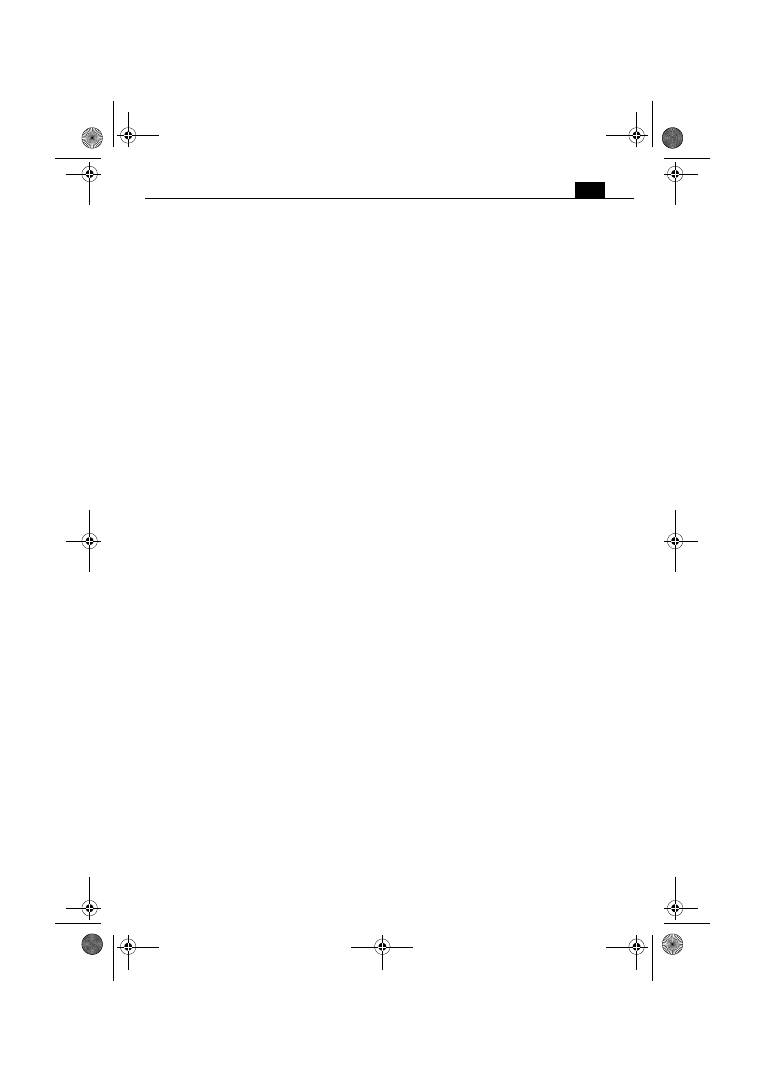
65
hu
Mindenképpen védje meg a szemét a kirepülő idegen
anyagoktól, amelyek a különböző alkalmazások során
keletkeznek. A por- vagy védőálarcnak meg kell szűrnie
a használat során keletkező port. Ha hosszú ideig ki van
téve az erős zaj hatásának, elvesztheti a hallását.
Ütvefúráshoz viseljen fülvédőt.
A zaj a hallóképesség
elvesztéséhez vezethet.
A megmunkálásra kerülő munkadarabot megfelelően
rögzítse.
Egy befogó szerkezettel rögzített munkadarab
biztonságosabban van rögzítve, mintha csak a kezével
tartaná.
Tartsa szorosan az elektromos kéziszerszámot.
Rövid
időre igen nagy nyomaték léphet fel.
Ne munkáljon meg a berendezéssel azbesztet tartalmazó
anyagokat.
Az azbesztnek rákkeltő hatása van.
Az elektromos kéziszerszámra táblákat és jeleket
csavarokkal vagy szegecsekkel felerősíteni tilos.
Egy
megrongálódott szigetelés már nem nyújt védelmet az
áramütés ellen. Használjon öntapadós matricákat.
Ne használjon olyan tartozékokat, amelyeket nem az
elektromos kéziszerszámot gyártó cég fejlesztett ki, vagy
amelynek használatát az nem engedélyezte.
Biztonságos
üzemelést csak úgy lehet elérni, ha a tartozék pontosan
hozzáillik az Ön elektromos kéziszerszámához.
Rendszeresen tisztítsa ki egy fémmentes tárggyal az
elektromos kéziszerszám szellőzőnyílásait.
A motor-
ventilátor behúzza a port a házba. Ez túlságosan sok
fémpor felgyülemlése esetén villamos zárlatot okozhat.
Sohase nézzen bele közelről az elektromos kéziszerszám
lámpája által kibocsátott fénybe. Sohase irányítsa a
lámpa fényét a közelben tartózkodó más személyek
szemébe.
A lámpa által kibocsátott sugárzás káros lehet a
szemre.
Sohase irányítsa az elektromos kéziszerszámot saját
magára, vagy a közelben tartózkodó más személyekre,
vagy állatokra.
Ez az éles vagy forró szerszámok által
okozott sérülésekhez vezethet.
Az akkumulátor (akkumulátor-blokk)
felhasználása és kezelése.
Az akkumulátor kezelése során a veszélyeztetések, mint
égési sérülések, tűz, robbanás, bőrsérülések és egyéb
sérülések elkerülésére vegye tekintetbe az alábbi
előírásokat:
Az akkumulátorokat nem szabad szétszerelni, kinyítani
vagy feldarabolni. Ne tegye ki az akkumulátort
mechanikus lökéseknek.
Az akkumulátor
megrongálódása és szakszerűtlen használata esetén abból
káros gőzők és folyadékok léphetnek ki. A gőzök
ingerelhetik a légzőutakat. A kilépő akkumulátorfolyadék
bőrirritációkat vagy égéses bőrsérüléseket okozhat.
Ha az akkkumulátorból kilépő folyadék a szomszédos
tárgyakat benedvesíti, ellenőrizze és tisztítsa meg, illetve
szükség esetén cserélje ki ezeket a tárgyakat.
Ne tegye ki az akkumulátort héhatásnak, illetve tűz
behatásának. Ne tárolja az akkumulátort közvetlen
napsütésben.
Az akkumulátort csak akkor vegye ki az eredeti
csomagolásból, ha használni akarja.
Az elektromos kéziszerszámon végzendő bármely munka
megkezdése előtt vegye ki az akkumulátort az
elektromos kéziszerszámból.
Ha az elektromos
kéziszerszám akaratlanul elindul, sérülésveszély áll fenn.
Az akkumulátort csak kikapcsolt állapotú elektromos
kéziszerszámból vegye ki.
Tartsa távol az akkumulátort a gyerekektől.
Tartsa tisztán és folyadékoktól és víztől védve az
akkumulátort.
Az akkumulátor és az elektromos
kéziszerszám elszennyeződött csatlakozásait egy tiszta,
száraz kendővel tisztítsa meg.
Csak kifogástalan állapotú, eredeti FEIN akkumulátorokat
használjon, amelyek az Ön elektromos kéziszerszámához
vannak előirányzova.
A nem az elektromos
kéziszerszámhoz való, megrongálódott, javított vagy
újrafeldolgozott akkumulátorokkal, utánzatokkal és
idegen gyártmányú akkumulátorokkal végzett munka,
illetve az ilyen akkumulátorok feltöltése tűz- és/vagy
robbanásveszélyes.
Tartsa be az akkumulátor töltőkészülék kezelési
utasításában található biztonsági előírásokat.
Kéz-kar vibráció
Az ezen előírásokban megadott rezgésszint az EN 60745
szabványban rögzített mérési módszerrel került
meghatározásra és a készülékek összehasonlítására ez az
érték felhasználható. Az érték a rezgési terhelés
ideiglenes megbecsülésére is alkalmazható.
A megadott rezgésszint az elektromos kéziszerszám fő
alkalmazási területeire vonatkozik. Ha az elektromos
kéziszerszámot más célokra, eltérő szerszámokkal, vagy
nem kielégítő karbantartás mellett használják, a rezgésszint a
fenti értékektől eltérhet. Ez az egész munkaidőre vonatkozó
rezgési terhelést lényeges mértékben megnövelheti.
A rezgési terhelés pontos megbecsüléséhez figyelembe
kell venni azokat az időszakokat is, amikor a berendezés
kikapcsolt állapotban van, vagy amikor be van ugyan
kapcsolva, de nem kerül ténylegesen használatra. Ez az
egész munkaidőre vonatkozó rezgési terhelést lényeges
mértékben csökkentheti.
Hozzon kiegészítő biztonsági intézkedéseket a
kezelőnek a rezgések hatása elleni védelmére, például: az
elektromos kéziszerszám és a szerszámok megfelelő
karbantartása, a kezek melegen tartása, a
munkafolyamatok átgondolt megszervezése.
A veszélyes porfajták kezelése
Az ezzel a szerszámmal végzett anyaglemunkáló
folyamatok során olyan porok keletkeznek, amelyek
veszélyesek lehetnek.
Egyes porfajták (például azbeszt és azbeszt tartalmú
anyagok, ólomtartalmú festékrétegek, fémek, egyes
fafajták, ásványok, követ tartalmazó anyagok szilikát
részecskéi, festék oldószerek, favédőszerek, a vízi
járművek védelmére használt rohadás gátló anyagok)
megérintése vagy belélegzése allergiás reakciókat, légúti
betegségeket, rákos megbetegedéseket és a szaporodási
szervek károsodását válthatják ki. A porok belélegzésével
kapcsolatos kockázat az expozíció mértékétől függ.
Alkalmazzon a keletkező poroknak megfelelő
porelszívást, viseljen személyi védőfelszereléseket és
gondoskodjon a munkahely jó szellőzéséről. Az azbeszt
tartalmú anyagok megmunkálását bízza szakemberekre.
OBJ_BUCH-0000000105-001.book Page 65 Thursday, April 4, 2013 10:23 AM
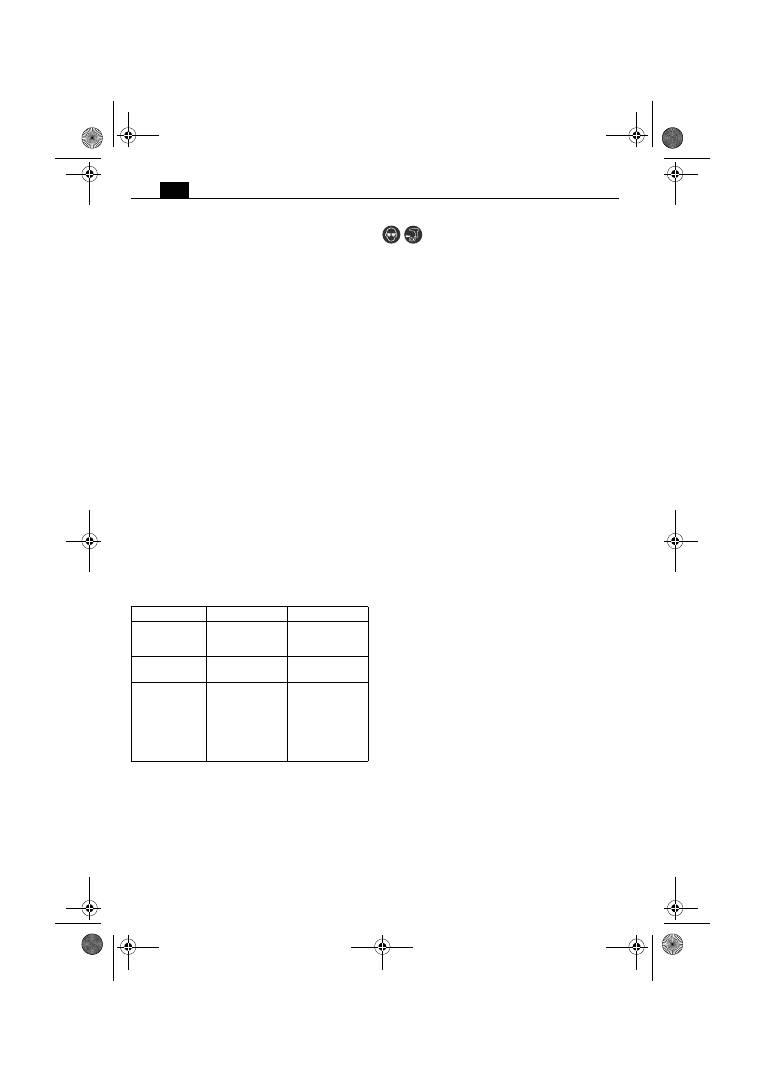
66
hu
Fa és könnyűfémporok, valamint a csiszolás során
keletkező porok és vegyszerek forró keverékei bizonyos
körülmények között saját maguktól meggyulladhatnak,
vagy robbanást okozhatnak. Gondoskodjon arról, hogy a
szikrák ne a portartály felé repüljenek, kerülje el az
elektromos kéziszerszám és a csiszolásra kerülő
munkadarab túlhevülését, vegye figyelembe az anyag
gyártójának megmunkálási előírásait, valamint az adott
országban a megmunkálásra kerülő anyagokra vonatkozó
érvényes előírásokat.
Kezelési tájékoztató.
A forgásirány-átkapcsolót és a fokozatváltó kapcsolót
csak álló motor mellett szabad átkapcsolni.
A fokozatváltó kapcsolót mindig ütközésig tolja el, illetve
az üzemmódkapcsolót (ASB14/18) mindig ütközésig
fordítsa el. Ellenkező esetben az elektromos
kéziszerszám megrongálódhat.
Túlterhelés esetén az elektromos kéziszerszám
kikapcsol.
Állítsa a forgásirány-átkapcsolót a középső helyzetbe,
hogy például egy szállításnál elkerülje az akaratlan
üzembe helyezést.
A nyomaték beállítása
A gyári beállítás a kisebbtől közepesig terjedő
csavarokhoz szükséges tartománynak felel meg.
A meghúzási nyomaték attól az erőtől is függ, amellyel az
elektromos kéziszerszámot rányomja a csavarra.
Az akkumulátor kezelése.
Az akkumulátort csak a 0 °C – 45 °C (32 °F – 113 °F)
hőmérséklet tartományban szabad üzemeltetni és tárolni.
Az akkumulátor hőmérsékletének a töltési folyamat
kezdetén az akkumulátor megengedett üzemeltetési
hőmérséklet tartományában kell lennie.
Az akkumulátor tényleges, százalékban megadott
feltöltési szintje csak az elektromos kéziszerszám álló
motorja mellett kerül kijelzésre.
Mielőtt az akkumulátor mélykisülése bekövetkezne, az
elektronika automatikusan kikapcsolja az elektromos
kéziszerszámot.
Üzemben tartás és vevőszolgálat.
Különösen hátrányos körülmények fennállása
esetén fémek megmunkálásakor az
elektromos kéziszerszám belsejébe
elektromosan vezetőképes por rakódhat le. Fújja ki
gyakran az elektromos kéziszerszám belső terét a
szellőzőnyíláson keresztül száraz és olajmentes
préslevegővel.
Ennek az elektromos kéziszerszámnak a pillanatnyilag
érvényes pótalkatrész-listáját az Internetből a
www.fein.com címen találhatja meg.
A következő alkatrészeket szükség esetén Ön saját maga
is kicserélheti:
tartozékok, akkumulátor
Jótállás és szavatosság.
A termékre vonatkozó jótállás a forgalomba hozási
országban érvényes törvényes rendelkezéseknek
megfelelően érvényes. Termékeinket ezen túlmenően a
FEIN jótállási nyilatkozatában leírtaknak megfelelő
kiterjesztett garanciával szállítjuk.
Az elektromos kéziszerszám szállítási terjedelmében
lehet, hogy az ezen kezelési útmutatóban leírásra vagy
ábrázolásra került tartozékoknak csak egy része található
meg.
Megfelelőségi nyilatkozat.
A FEIN egyedüli felelőséggel kijelenti, hogy ez a termék
megfelel az ezen kezelési útmutató utolsó oldalán
megadott idevonatkozó előírásoknak.
A műszaki dokumentáció a következő helyen található:
C. & E. FEIN GmbH, C-DB_IA,
D-73529 Schwäbisch Gmünd
Környezetvédelem, hulladékkezelés.
A csomagolásokat, a selejtes elektromos
kéziszerszámokat és tartozékokat a környezetvédelmi
szempontoknak megfelelően kell újra felhasználni.
Az akkumulátorokat csak kisütött állapotban adja le a
megfelelő mentesítésre.
Nem teljesen kisütött akkumulátorok esetén ragassza le
elővigyázatosságból, a rövidzárlatok megakadályozására a
dugós csatlakozó érintkezőit.
LED-kijelző
Magyarázat
Művelet
1 – 4 zöld LED
Töltési szint
kijelzés
százalékban
Üzemeltetés
piros tartós fény Az akkumulátor
majdnem üres
Töltse fel az
akkumulátort
piros villogó
fény
Az akkumulátor
nem üzemkész
Hozza az
akkumulátort a
megengedett
üzemeltetési
hőmérséklet
tartományba,
majd töltse fel
OBJ_BUCH-0000000105-001.book Page 66 Thursday, April 4, 2013 10:23 AM

67
cs
cs
Původní návod k obsluze.
Použité symboly, zkratky a pojmy.
Symbol, značka
Vysvětlení
Nedotýkejte se rotujících dílů elektronářadí.
Nezbytně čtěte přiložené dokumenty jako návod k obsluze a všeobecná bezpečnostní
upozornění.
Uposlechněte pokynů ve vedle stojícím textu nebo grafice!
Před tímto pracovním krokem odstraňte z elektronářadí akumulátor. Jinak existuje
nebezpečí poranění dané neúmyslným rozběhem elektronářadí.
Při práci použijte ochranu očí.
Při práci použijte ochranu sluchu.
Při práci použijte ochranu rukou.
Nenabíjejte žádné poškozené akumulátory.
Nevystavujte akumulátor ohni. Akumulátor chraňte před horkem, např. i před trvalým
slunečním zářením.
Dbejte upozornění ve vedlejším textu!
Doplňková informace.
Oblast uchopení
Potvrzuje shodu elektronářadí se směrnicemi evropského společenství.
Tento symbol potvrzuje certifikaci tohoto výrobku v USA a Kanadě.
Toto upozornění ukazuje možnou nebezpečnou situaci, která může vést k vážným
poraněním nebo smrti.
Značka recyklace: označuje recyklovatelné materiály
Vyřazené elektronářadí a další elektrotechnické a elektrické výrobky rozebrané
shromážděte a dodejte k opětovnému zhodnocení nepoškozujícímu životní prostředí.
Typ akumulátoru
1. Stupeň/2. Stupeň
Průměr vrtání do oceli
Průměr vrtání do dřeva
Průměr vrtání do kamene
Upínací rozsah vrtacího sklíčidla
Průměr šroubu
Hmotnost podle EPTA-Procedure 01/2003
Malý počet otáček
Velký počet otáček
Fe
OBJ_BUCH-0000000105-001.book Page 67 Thursday, April 4, 2013 10:23 AM
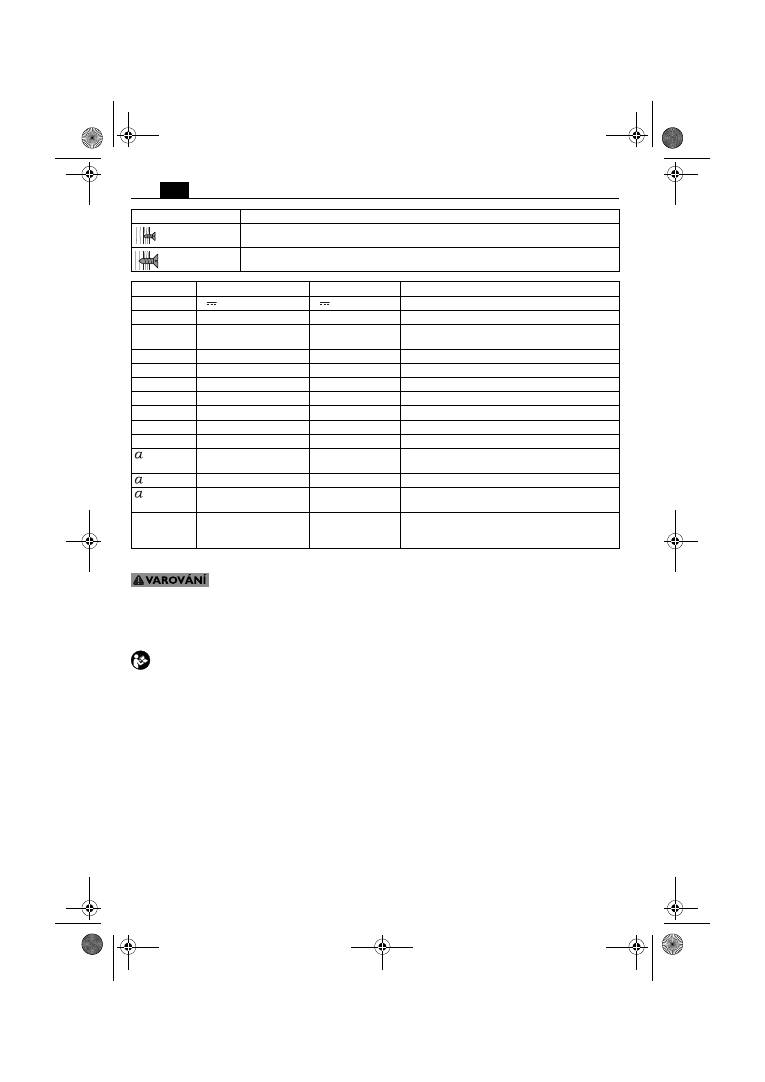
68
cs
Pro Vaši bezpečnost.
Čtěte všechna varovná upozornění a
pokyny.
Zanedbání při dodržování
varovných upozornění a pokynů mohou mít za následek
zásah elektrickým proudem, požár a/nebo těžká
poranění.
Všechna varovná upozornění a pokyny do budoucna
uschovejte.
Toto elektronářadí nepoužívejte, dokud jste si
důkladně nepřečetli a zcela neporozuměli tomuto
návodu k obsluze a též přiloženým „Všeobecným
bezpečnostním upozorněním“ (číslo spisu
3 41 30 054 06 1). Uchovejte uvedené podklady k
pozdějšímu použití a předejte je při zapůjčení nebo
prodeji elektronářadí.
Dbejte rovněž příslušných národních ustanovení ochrany
při práci.
Určení elektronářadí:
ABS14, ABS18:
ruční vrtací šroubovák pro zašroubování a vyšroubování
šroubů a matic a pro vrtání a šroubování do kovu, dřeva,
umělé hmoty a keramiky a též pro řezání závitů pomocí
firmou FEIN schválených pracovních nástrojů a
příslušenství bez přívodu vody v prostředí chráněném
před povětrnostními vlivy.
ASB14, ASB18:
ruční příklepový vrtací šroubovák pro zašroubování a
vyšroubování šroubů a matic a pro vrtání a šroubování do
kovu, dřeva, umělé hmoty a keramiky a též pro řezání
závitů a pro příklepové vrtání do betonu, kamene a cihel
pomocí firmou FEIN schválených pracovních nástrojů a
příslušenství bez přívodu vody v prostředí chráněném
před povětrnostními vlivy.
Speciální bezpečnostní předpisy.
Pokud provádíte práce, při kterých může šroub zasáhnout
skrytá elektrická vedení, pak držte elektronářadí na
izolovaných plochách rukojeti.
Kontakt s elektrickým
vedením pod napětím může přivést napětí i na kovové
části stroje a vést k zásahu elektrickým proudem.
Dbejte na skrytě položené elektrické vedení, plynové a
vodovodní potrubí.
Před začátkem práce zkontrolujte
pracovní oblast např. přístrojem na zjišťování kovů.
Noste osobní ochranné vybavení. Podle aplikace použijte
ochranu celého obličeje, ochranu očí nebo ochranné
brýle. Taktéž adekvátně noste ochrannou masku proti
prachu, ochranu sluchu, ochranné rukavice nebo
speciální zástěru, jež Vás ochrání před malými částicemi
brusiva a materiálu.
Oči mají být chráněny před
odletujícími cizími tělísky, jež vznikají při různých
aplikacích. Protiprachová maska či respirátor musejí při
používání vznikající prach odfiltrovat. Pokud jste dlouho
vystaveni silnému hluku, můžete utrpět ztrátu sluchu.
Při příklepovém vrtání noste ochranu sluchu.
Působení
hluku může způsobit ztrátu sluchu.
Zajistěte obrobek.
Obrobek držený upínacím přípravkem
je držen bezpečněji než ve Vaší ruce.
Držte elektronářadí dobře a pevně.
Krátkodobě mohou
nastat vysoké reakční momenty.
Zmenšení kroutícího momentu
Zvětšení kroutícího momentu
Značka
Jednotka mezinárodní
Jednotka národní
Vysvětlení
U
V
V
Elektrické stejnosměrné napětí
f
Hz
Hz
Frekvence
n
0
/min, min
-1
, rpm, r/min
min
-1
Počet otáček při běhu naprázdno (u plně nabitého
akumulátoru)
n
S
/min, min
-1
/min
Počet úderů
M...
Nm
Nm
Kroutící moment (tvrdý/měkký šroubový spoj)
Ø
mm
mm
Průměr kulatého dílu
L
pA
dB
dB
Hladina akustického tlaku
L
wA
dB
dB
Hladina akustického výkonu
L
pCpeak
dB
dB
Špičková hladina akustického tlaku
K...
Nepřesnost
m/s
2
m/s
2
Hodnota emise vibrací podle EN 60745
(vektorový součet tří os)
h,D
m/s
2
m/s
2
Střední hodnota vibrací pro vrtání do kovu
h,ID
m/s
2
m/s
2
Střední hodnota vibrací pro příklepové vrtání do
betonu
m, s, kg, A, mm, V,
W, Hz, N, °C, dB,
min, m/s
2
m, s, kg, A, mm, V,
W, Hz, N, °C, dB,
min, m/s
2
Základní a odvozené jednotky z mezinárodní
soustavy jednotek
SI
.
Symbol, značka
Vysvětlení
OBJ_BUCH-0000000105-001.book Page 68 Thursday, April 4, 2013 10:23 AM
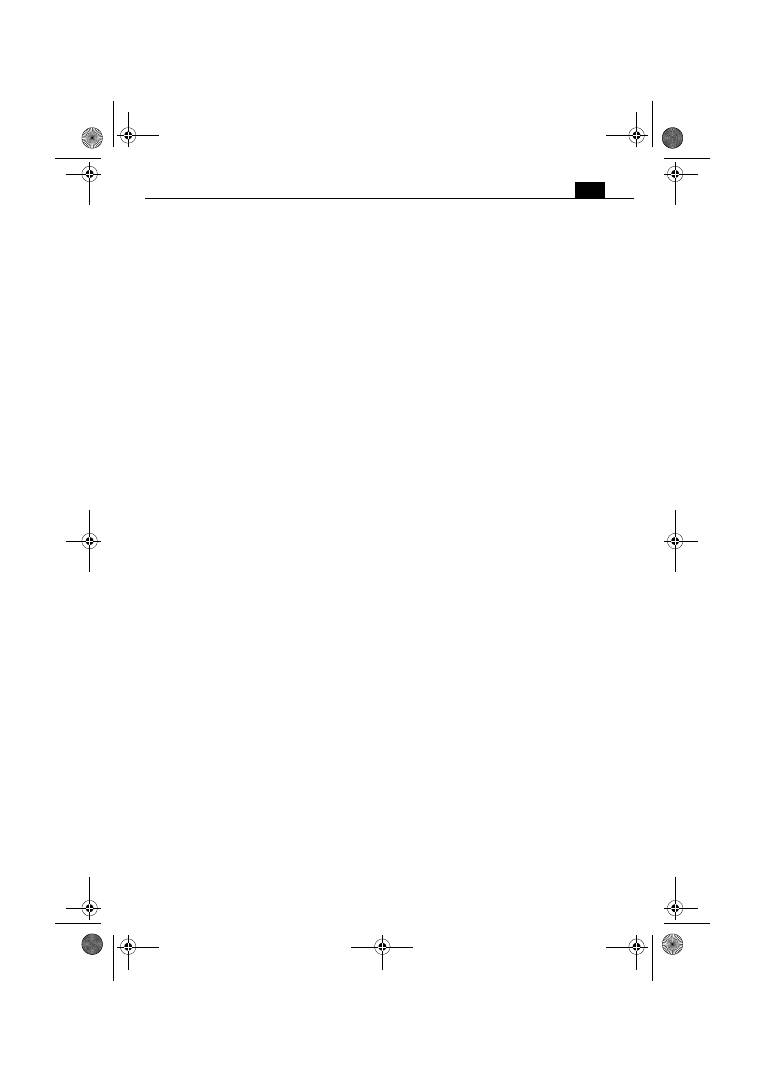
69
cs
Neopracovávejte žádný materiál obsahující azbest.
Azbest je karcinogenní.
Je zakázáno šroubovat nebo nýtovat na elektronářadí
štítky nebo značky.
Poškozená izolace nenabízí žádnou
ochranu proti úderu elektrickým proudem. Použijte
nalepovací štítky.
Nepoužívejte žádné příslušenství, které nebylo speciálně
vyvinuto nebo povoleno výrobcem elektronářadí.
Bezpečný provoz není dán sám od sebe tím, že
příslušenství lícuje na Vaše elektronářadí.
Pravidelně čistěte větrací otvory elektronářadí
nekovovými nástroji. Ventilátor motoru vtahuje prach do
tělesa.
To může způsobit při nadměrném nahromadění
kovového prachu elektrické ohrožení.
Nikdy se z malé vzdálenosti nedívejte do světla svítilny
elektronářadí. Nikdy nemiřte světlem svítilny na oči
jiných osob, jež se nacházejí v blízkosti.
Záření, které je
vytvářeno osvětlovacím prostředkem, může být pro oči
škodlivé.
Nesměrujte elektronářadí proti sobě ani jiným osobám či
zvířatům.
Existuje nebezpečí zranění od ostrých nebo
horkých pracovních nástrojů.
Používání a zacházení s akumulátorem
(akumulátorovým blokem).
Pro zabránění rizikům, jako spáleniny, požár, výbuch,
poranění kůže a další zranění, dbejte při zacházení s
akumulátory následujících upozornění:
Akumulátory nesmějí být rozebírány, otevírány nebo
rozdrcovány. Nevystavujte akumulátory žádným
mechanickým rázům.
Při poškození a neurčeném použití
akumulátoru mohou vystupovat škodlivé výpary a
vytékat kapaliny. Výpary mohou dráždit dýchací cesty.
Vytékající kapalina akumulátoru může vést k
podrážděním kůže nebo popáleninám.
Pokud kapalina vytékající z poškozeného akumulátoru
potřísnila sousední předměty, zkontrolujte dotčené díly,
vyčistěte je nebo je popř. vyměňte.
Akumulátor nevystavujte horku ani ohni. Neuskladňujte
akumulátor na přímém slunečním světle.
Akumulátor vyjměte z originálního obalu až tehdy, když se
má použít.
Před prací na elektronářadí vyjměte z elektronářadí
akumulátor.
Pokud se elektronářadí neúmyslně
rozeběhne, existuje nebezpečí zranění.
Akumulátor odejměte pouze při vypnutém elektronářadí.
Udržujte akumulátory daleko od dětí.
Udržujte akumulátor čistý a chráněný před vlhkostí a
vodou.
Znečištěné přípojky akumulátoru a elektronářadí
vyčistěte pomocí suchého, čistého hadříku.
Používejte pouze neporušené, originální akumulátory
FEIN, jež jsou určeny pro Vaše elektronářadí.
Při nabíjení
a práci s nesprávným, poškozeným, opravovaným nebo
dotvářeným akumulátorem, s napodobeninami a cizími
výrobky existuje nebezpečí požáru a/nebo výbuchu.
Uposlechněte bezpečnostní upozornění v návodu k
obsluze nabíječky akumulátoru.
Vibrace rukou či paží
V těchto pokynech uvedená úroveň vibrací byla změřena
podle měřících metod normovaných v EN 60745 a může
být použita pro vzájemné porovnání elektronářadí. Hodí
se i pro předběžný odhad zatížení vibracemi.
Uvedená úroveň vibrací reprezentuje hlavní použití
elektronářadí. Pokud ovšem bude elektronářadí
nasazeno pro jiná použití, s odlišnými nasazovacími
nástroji nebo s nedostatečnou údržbou, může se úroveň
vibrací lišit. To může zatíženi vibracemi po celou
pracovní dobu zřetelně zvýšit.
Pro přesný odhad zatížení vibracemi by měly být
zohledněny i doby, v nichž je stroj vypnutý nebo sice
běží, ale fakticky není nasazen. To může zatíženi
vibracemi po celou pracovní dobu zřetelně zredukovat.
Stanovte dodatečná bezpečnostní opatření k ochraně
obsluhy před účinkem vibrací jako např.: údržba
elektronářadí a nasazovacích nástrojů, udržování teplých
rukou, organizace pracovních procesů.
Zacházení s nebezpečným prachem
Při pracovních procesech s úběrem materiálu pomocí
tohoto nářadí vzniká prach, který může být škodlivý.
Dotyk nebo vdechnutí některého prachu jako např.
azbestu a materiálů s obsahem azbestu, olovnatých
nátěrů, kovu, některých druhů dřeva, minerálů, částeček
křemičitanů z materiálů s obsahem kamene,
rozpouštědel barev, prostředků na ochranu dřeva,
antivegetativních nátěrů plavidel, může u osob vyvolat
alergické reakce a/nebo onemocnění dýchacích cest,
rakovinu, poruchy reprodukce. Riziko dané vdechnutím
prachu závisí na expozici. Použijte odsávání určené na
vznikající prach a též osobní ochranné pomůcky a
postarejte se o dobré větrání pracovního místa.
Opracovávání materiálů s obsahem azbestu přenechte
pouze odborníkům.
Dřevěný prach a prach lehkých kovů, horké směsi z
brusného prachu a chemických látek se mohou za
nepříznivých podmínek samy vznítit nebo způsobit
výbuch. Zabraňte odletu jisker ve směru zásobníku
prachu a též přehřátí elektronářadí a broušeného
materiálu, nádobu na prach včas vyprazdňujte, dbejte
upozornění výrobce materiálů k opracovávání a též ve
Vaší zemi platných předpisů pro opracovávané materiály.
Pokyny k obsluze.
Přepínač směru otáčení a přepínač volby stupně převodu
ovládejte pouze za stavu klidu motoru.
Přepínač volby stupně převodu posuňte resp. přepínač
volby druhu provozu (ASB14/18) otočte vždy až na
doraz. Elektronářadí se jinak může poškodit.
Při přetížení se elektronářadí vypne.
Aby se zabránilo neúmyslnému uvedení do provozu,
např. při přepravě, dejte přepínač směru otáčení do
střední polohy.
Nastavení kroutícího momentu
Nastavení z výroby odpovídá rozsahu pro menší až
středně velké šrouby.
Utahovací moment je závislý i na síle, kterou je
elektronářadí tlačeno proti šroubu.
OBJ_BUCH-0000000105-001.book Page 69 Thursday, April 4, 2013 10:23 AM

70
cs
Zacházení s akumulátorem.
Provozujte a nabíjejte akumulátor pouze v rozsahu
provozní teploty akumulátoru 0 °C – 45 °C (32 °F –
113 °F). Teplota akumulátoru musí být na začátku
procesu nabíjení v rozsahu provozní teploty.
Skutečný procentuální stav nabití akumulátoru se zobrazí
pouze při zastaveném motoru elektronářadí.
Při blížícím se hlubokém vybití akumulátoru zastaví
elektronika automaticky motor.
Údržba a servis.
Při extrémních podmínkách nasazení se může
při opracování kovů usazovat uvnitř
elektronářadí vodivý prach. Často vyfukujte
vnitřní prostor elektronářadí skrz větrací otvory suchým
tlakovým vzduchem bez oleje.
Aktuální seznam náhradních dílů tohoto elektronářadí
naleznete na internetu na www.fein.com.
Následující díly můžete, je-li třeba, vyměnit sami:
pracovní nástroje, akumulátor
Záruka a ručení.
Záruka na výrobek platí podle zákonných ustanovení
země uvedení do provozu. Nad to navíc poskytuje firma
FEIN záruku podle prohlášení o záruce výrobce FEIN.
V obsahu dodávky Vašeho elektronářadí může být
obsažen i jen jeden díl příslušenství popsaného nebo
zobrazeného v tomto návodu k obsluze.
Prohlášení o shodě.
Firma FEIN prohlašuje ve výhradní zodpovědnosti, že
tento výrobek odpovídá příslušným ustanovením
uvedeným na poslední straně tohoto návodu k obsluze.
Technické podklady u: C. & E. FEIN GmbH, C-DB_IA,
D-73529 Schwäbisch Gmünd
Ochrana životního prostředí, likvidace.
Obaly, vyřazené elektronářadí a příslušenství dodejte k
opětovnému zhodnocení nepoškozujícímu životní
prostředí.
Akumulátory odevzdejte k řádné likvidaci pouze ve
vybitém stavu.
U ne zcela vybitých akumulátorů zaizolujte konektor
preventivně proti zkratu pomocí lepící pásky.
Ukazatel LED
Význam
Akce
1 – 4 zelené
LED
Procentuální
stav nabití
Provoz
Červené
trvalé světlo
Akumulátor je
téměř prázdný
Akumulátor nabijte
Červené
blikající světlo
Akumulátor
není připravený
k provozu
Akumulátor uveďte
do rozsahu provozní
teploty akumulátoru,
poté nabijte
OBJ_BUCH-0000000105-001.book Page 70 Thursday, April 4, 2013 10:23 AM
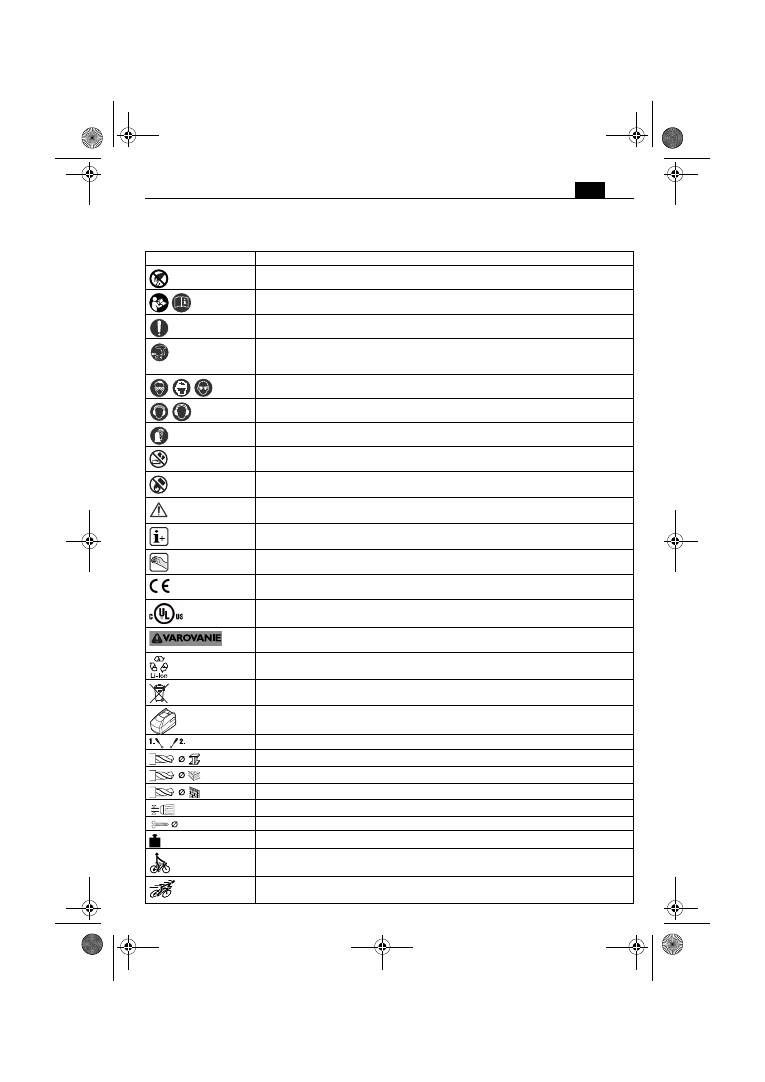
71
sk
sk
Originálny návod na použitie.
Používané symboly, skratky a pojmy.
Symbol, značka
Vysvetlenie
Nedotýkajte sa rotujúcich súčiastok ručného elektrického náradia.
Bezpodmienečne si prečítajte priloženú dokumentáciu ako Návod na použitie a
Všeobecné bezpečnostné predpisy.
Dodržiavajte pokyny uvedené v priloženom texte alebo na obrázkoch!
Pred týmto pracovným úkonom vyberte z ručného elektrického náradia akumulátor.
Inak hrozí následkom neúmyselného rozbehnutia ručného elektrického náradia
nebezpečenstvo poranenia.
Pri práci používajte pomôcku na ochranu zraku.
Pri práci používajte chrániče sluchu.
Pri práci používajte pracovné rukavice.
Nenabíjajte žiadne akumulátory, ktoré sú poškodené.
Nevystavujte akumulátor ohňu. Chráňte akumulátor pred horúčavou, napr. aj pred
trvalým slnečným žiarením.
Dodržiavajte upozornenia uvedené vo vedľajšom texte!
Dodatočná informácia.
Uchopovacia časť náradia
Potvrdzuje konformitu ručného elektrického náradia so smernicami Európskeho
spoločenstva.
Tento symbol potvrdzuje certifikáciu tohto výrobku v USA a v Kanade.
Toto upozornenie poukazuje na možnú nebezpečnú situáciu, ktorá môže viesť k vážnym
poraneniam alebo môže spôsobiť smrť.
Recyklovacia značka: označuje opätovne použiteľné materiály
Vyradené ručné elektrické náradie a iné elektrické a elektrotechnické výrobky zbierajte
ako triedený odpad a dajte ich na recykláciu zodpovedajúcu ochrane životného prostredia.
Typ akumulátora
1. Stupeň/2. Stupeň
Vŕtací priemer do ocele
Vŕtací priemer do dreva
Vŕtací priemer do kameňa
Upínací rozsah skľučovadla
Priemer skrutky
Hmotnosť podľa EPTA-Procedure 01/2003
Nízky počet obrátok
Vysoký počet obrátok
Fe
OBJ_BUCH-0000000105-001.book Page 71 Thursday, April 4, 2013 10:23 AM

72
sk
Pre Vašu bezpečnosť.
Prečítajte si všetky Výstražné
upozornenia a bezpečnostné pokyny.
Zanedbanie dodržiavania Výstražných upozornení a
pokynov uvedených v nasledujúcom texte môže mať za
následok zásah elektrickým prúdom, spôsobiť požiar
a/alebo ťažké poranenie.
Tieto Výstražné upozornenia a bezpečnostné pokyny
starostlivo uschovajte na budúce použitie.
Nepoužívajte toto ručné elektrické náradie
predtým, ako si dôkladne prečítate tento Návod na
používanie ako aj priložené „Všeobecné
bezpečnostné pokyny“ (spisové číslo 3 41 30 054 06 1)
a kým úplne neporozumiete ich obsahu. Uvedené
podklady si dobre uschovajte na neskoršie použitie a v
prípade odovzdania ručného elektrického náradia alebo
predaja inej osobe ich odovzdajte s náradím.
Rovnako dodržiavajte aj príslušné národné ustanovenia o
ochrane zdravia pri práci.
Určenie ručného elektrického náradia:
ABS14, ABS18:
ručný vŕtací skrutkovač na zaskrutkovávanie a
vyskrutkovávanie skrutiek a matíc a na vŕtanie a
skrutkovanie do kovov, dreva, plastov a keramiky, taktiež
na rezanie závitov s pracovnými nástrojmi a
príslušenstvom schválenými firmou FEIN na používanie
bez prívodu vody a v prostredí chránenom pred vplyvmi
vonkajšieho podnebia a počasia.
ASB14, ASB18:
ručný príklepový vŕtací skrutkovač na zaskrutkovávanie a
vyskrutkovávanie skrutiek a matíc a na vŕtanie a
skrutkovanie do kovov, dreva, plastov a keramiky, taktiež
na rezanie závitov a vŕtanie s príklepom do betónu,
kameňa a tehly s pracovnými nástrojmi a príslušenstvom
schválenými firmou FEIN na používanie bez prívodu
vody a v prostredí chránenom pred vplyvmi vonkajšieho
podnebia a počasia.
Špeciálne bezpečnostné pokyny.
Držte ručné elektrické náradie len za izolované plochy
rukovätí, ak vykonávate takú prácu, pri ktorej by mohla
skrutka natrafiť na skryté elektrické vedenia.
Kontakt s
elektrickým vedením, ktoré je pod napätím, môže dostať
pod napätie aj kovové súčiastky náradia a spôsobiť zásah
elektrickým prúdom.
Dávajte pozor na skryté elektrické vedenia, plynové a
vodovodné potrubia.
Pred začiatkom práce
prekontrolujte priestor práce napr. pomocou hľadača
kovov.
Používajte osobné ochranné prostriedky. Podľa druhu
použitia náradia používajte ochranný štít na celú tvár, štít
na oči alebo ochranné okuliare. Pokiaľ je to primerané,
používajte ochrannú dýchaciu masku, chrániče sluchu,
pracovné rukavice alebo špeciálnu zásteru, ktorá Vás
uchráni pred odletujúcimi drobnými čiastočkami brusiva
a obrábaného materiálu.
Predovšetkým oči treba chrániť
pred odletujúcimi cudzími telieskami, ktoré vznikajú pri
rôznom spôsobe používania náradia. Ochrana proti
Zmenšiť krútiaci moment
Zväčšiť krútiaci moment
Značka
Medzinárodná jednotka
Národná jednotka
Vysvetlenie
U
V
V
Jednosmerné elektrické napätie
f
Hz
Hz
Frekvencia
n
0
/min, min
-1
, rpm, r/min
min
-1
Počet voľnobežných obrátok (pri úplne nabitom
akumulátore)
n
S
/min, min
-1
/min
Frekvencia príklepu
M...
Nm
Nm
Krútiaci moment (tvrdý/mäkký skrutkový spoj)
Ø
mm
mm
Priemer okrúhlej súčiastky
L
pA
dB
dB
Hladina zvukového tlaku
L
wA
dB
dB
Hladina akustického tlaku
L
pCpeak
dB
dB
Špičková hodnota hladiny akustického tlaku
K...
Nepresnosť merania
m/s
2
m/s
2
Hodnota emisie vibrácií podľa normy EN 60745
(súčet vektorov troch smerov)
h,D
m/s
2
m/s
2
stredná hodnota kmitov pre vŕtanie do kovu
h,ID
m/s
2
m/s
2
stredná hodnota kmitov pre vŕtanie s príklepom do
betónu
m, s, kg, A, mm, V,
W, Hz, N, °C, dB,
min, m/s
2
m, s, kg, A, mm, V,
W, Hz, N, °C, dB,
min, m/s
2
Základné a odvodené jednotky Medzinárodného
systému jednotiek
SI
.
Symbol, značka
Vysvetlenie
OBJ_BUCH-0000000105-001.book Page 72 Thursday, April 4, 2013 10:23 AM

73
sk
prachu alebo ochranná dýchacia maska musia
predovšetkým odfiltrovať konkrétny druh prachu, ktorý
vzniká pri danom druhu použitia náradia. Keď je človek
dlhšiu dobu vystavený hlasnému hluku, môže utrpieť
stratu sluchu.
Pri vŕtaní s príklepom používajte chrániče sluchu.
Pôsobenie hluku môže mať za následok stratu sluchu.
Zabezpečte obrobok.
Obrobok upnutý pomocou
upínacieho zariadenia je bezpečnejší ako ten, ktorý
pridržiavate rukou.
Pri práci ručné elektrické náradie dobre držte.
Krátkodobo môžu vznikať veľké reakčné momenty.
Neobrábajte žiaden materiál, ktorý obsahuje azbest.
Azbest sa považuje za rakovinotvorný.
Je zakázané skrutkovať alebo nitovať na ručné elektrické
náradie nejaké štítky alebo značky.
Poškodená izolácia
neposkytuje žiadnu ochranu pred zásahom elektrickým
prúdom. Používajte samolepiace štítky.
Nepoužívajte žiadne príslušenstvo, ktoré nebolo
špeciálne vyvinuté alebo schválené výrobcom ručného
elektrického náradia.
Bezpečná prevádzka nie je
zaručená iba tým, že sa určité príslušenstvo na Vaše ručné
elektrické náradie hodí.
Pravidelne čistite vetracie otvory ručného elektrického
náradia pomocou nejakých nekovových nástrojov.
Ventilátor elektromotora vťahuje do telesa náradia prach.
V prípade nadmierneho nahromadenia kovového prachu
to môže spôsobiť ohrozenie elektrickým prúdom.
Nikdy nepozerajte z malej vzdialenosti do svetla
pracovnej lampy ručného elektrického náradia. Nikdy
nesmerujte svetlo lampy do očí iných osôb, ktoré sa
nachádzajú v blízkosti pracoviska.
Žiarenie, ktoré vydáva
lampa, môže spôsobiť poškodenie zraku.
Nesmerujte ručné elektrické náradie proti sebe samému,
ani na iné osoby alebo na zvieratá.
Hrozí nebezpečenstvo
poranenia ostrými alebo horúcimi pracovnými nástrojmi.
Používanie akumulátorov (akumulátorových
blokov) a manipulácia s nimi.
Aby ste sa pri zaobchádzaní s akumulátormi vyhli
nebezpečenstvám ohrozenia zdravia ako popáleniny,
požiar, výbuch, poranenia kože a iné poranenia,
dodržiavajte nasledujúce pokyny:
Akumulátory sa nesmú rozoberať, otvárať ani deliť na
menšie kusy. Nevystavujte akumulátory žiadnym
mechanickým nárazom.
V prípade poškodenia alebo
neodborného používania akumulátora môžu z neho
vystupovať zdraviu škodlivé výpary alebo unikať
kvapaliny. Tieto výpary môžu podráždiť dýchacie cesty.
Unikajúca kvapalina z akumulátora môže mať za následok
podráždenie pokožky alebo spôsobiť popáleniny.
Ak kvapalina vytečená z akumulátora zasiahla aj okolité
predmety a súčiastky, zasiahnuté súčiastky skontrolujte
a v prípade potreby ich vyčistite alebo vymeňte.
Nevystavujte akumulátor horúčave alebo ohňu.
Neskladujte akumulátor na priamom slnečnom svetle.
Akumulátor vyberte z originálneho obalu až vtedy, keď ho
bude treba použiť.
Pred každou prácou na ručnom elektrickom náradí
vyberte z náradia akumulátor.
Ak by sa ručné elektrické
náradie nekontrolovane rozbehlo, hrozí nebezpečenstvo
poranenia.
Akumulátor vyberajte z ručného elektrického náradia iba
vtedy, keď je náradie vypnuté.
Akumulátory uschovávajte tak, aby k nim nemali prístup
deti.
Akumulátor udržiavajte v čistote a uschovávajte tak, aby
bol chránený pred vlhkosťou a vodou.
Znečistené prívody
(kontakty) akumulátora a ručného elektrického náradia
vyčistite suchou a čistou handričkou.
Používajte len originálne akumulátory firmy FEIN, ktoré sú
určené do Vášho ručného elektrického náradia.
V prípade
používania a nabíjania nevhodných, poškodených,
opravovaných alebo upravovaných akumulátorov,
rôznych napodobnenín alebo výrobkov iných firiem,
hrozí nebezpečenstvo požiaru a/alebo výbuchu.
Dodržiavajte bezpečnostné pokyny uvedené v Návode na
používanie nabíjačky akumulátorov.
Vibrácie ruky a predlaktia
Úroveň vibrácií uvedená v týchto pokynoch bola
nameraná podľa meracieho postupu uvedeného v norme
EN 60745 a možno ju používať na vzájomné porovnávanie
rôznych typov ručného elektrického náradia. Hodí sa aj na
predbežný odhad zaťaženia vibráciami.
Uvedená hladina zaťaženia vibráciami reprezentuje
hlavné druhy používania tohto ručného elektrického
náradia. Avšak v takých prípadoch, keď sa toto ručné
elektrické náradie využíva na iné druhy použitia, s
odlišnými pracovnými nástrojmi, alebo ak sa podrobuje
nedostatočnej údržbe, môže sa hladina zaťaženia
vibráciami od týchto hodnôt odlišovať. To môže výrazne
zvýšiť zaťaženie vibráciami počas celej pracovnej doby.
Na presný odhad zaťaženia vibráciami počas určitého
časového úseku práce s náradím treba zohľadniť doby,
počas ktorých je ručné elektrické náradie vypnuté alebo
doby, keď je náradie síce zapnuté a beží, ale v skutočnosti
nepracuje. Táto okolnosť môže výrazne redukovať
zaťaženie vibráciami počas celej pracovnej doby.
Na ochranu osoby pracujúcej s náradím pred účinkami
zaťaženia vibráciami vykonajte ďalšie bezpečnostné
opatrenia, ako sú napríklad: Údržba ručného
elektrického náradia a používaných pracovných
nástrojov, zabezpečenie zachovania teploty rúk,
organizácia jednotlivých pracovných úkonov.
Zaobchádzanie so zdraviu škodlivým prachom
Pri pracovných činnostiach s týmto náradím, pri ktorých
dochádza k úberu materiálu, vzniká prach, ktorý môže
byť zdraviu škodlivý.
Dotyk alebo vdychovanie niektorých druhov prachu,
napr. z azbestu a z materiálov obsahujúcich azbest, z
náteru obsahujúceho olovo, z kovov, niektorých druhov
dreva, minerálov, silikátových častíc materiálov
obsahujúcich kamenivo, z rozpúšťadiel farieb, z
prostriedkov na ochranu dreva, z ochranných náterov
pre vodné dopravné prostriedky môže vyvolať u
niektorých osôb alergické reakcie a/alebo spôsobiť
ochorenie dýchacích ciest, rakovinu a vyvolávať poruchy
plodnosti. Riziko vyvolané nadýchaním sa prachu je
závislé od doby zotrvania v ohrozenom priestore.
OBJ_BUCH-0000000105-001.book Page 73 Thursday, April 4, 2013 10:23 AM
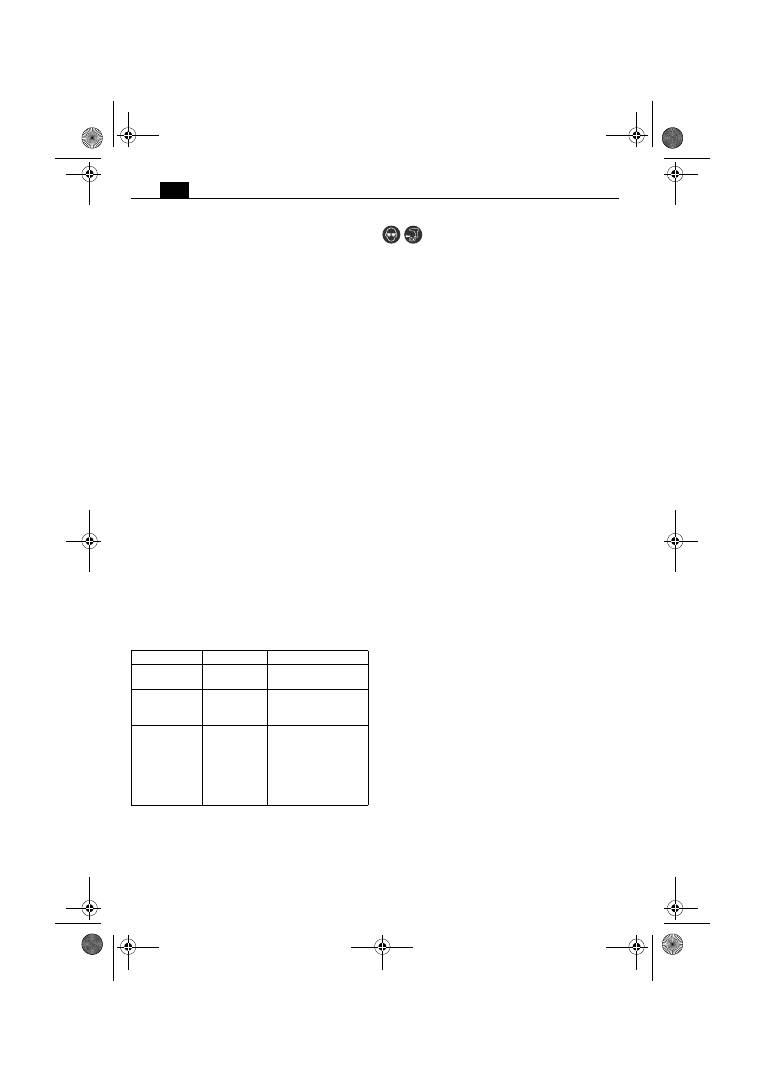
74
sk
Používajte odsávacie zariadenie zodpovedajúce
vznikajúcemu druhu prachu ako aj osobné ochranné
pomôcky a postarajte sa o dobré vetranie pracoviska.
Obrábanie materiálov, ktoré obsahujú azbest,
prenechajte výlučne na odborníkov.
Drevený prach, prach z ľahkých kovov, horúce zmesi
brúsneho prachu a chemických látok sa môžu za
nepriaznivých podmienok samovznietiť, alebo môžu
spôsobiť výbuch. Vyhýbajte sa tomu, aby prúd iskier
smeroval k zásobníku na prach, a zabráňte prehrievaniu
ručného elektrického náradia a brúseného materiálu,
zavčasu vyprázdňujte zásobník na prach, dodržiavajte
pokyny výrobcu materiálu aj predpisy o obrábaní
príslušného materiálu platné vo Vašej krajine.
Návod na používanie.
S prepínačom smeru otáčania manipulujte len vtedy, keď
je motor náradia vypnutý.
Posúvajte prepínač rýchlostných stupňov, resp. otáčajte
prepínač pracovných režimov vždy až na doraz. V
opačnom prípade by sa mohlo toto ručné elektrické
náradie poškodiť.
Pri preťažení sa toto ručné elektrické náradie
automaticky vypne.
Nastavte prepínač smeru otáčania do strednej polohy,
aby ste zabránili prípadnému neúmyselnému zapnutiu
ručného elektrického náradia, napríklad pri transporte.
Nastavenie krútiaceho momentu
Nastavenie z výrobného závodu zodpovedá rozsahu pre
malé až stredne veľké skrutky.
Uťahovací moment závisí aj od sily, ktorou je ručné
elektrické náradie pritláčané na skrutku.
Manipulácia s akumulátorom.
Akumulátor používajte a nabíjajte len v pri teplotách
v rámci rozsahu prevádzkových teplôt akumulátora
0 °C – 45 °C (32 °F – 113 °F). Na začiatku nabíjania musí
byť teplota akumulátora v rámci rozsahu prevádzkových
teplôt akumulátora.
Skutočný stav nabitia akumulátora v percentách sa
zobrazí iba pri zastavenom motore ručného elektrického
náradia.
Ak by malo nastať hlboké vybitie akumulátora,
integrovaná elektronika motor automaticky zastaví.
Údržba a autorizované servisné stredisko.
Pri extrémnych prevádzkových podmienkach
sa môže pri obrábaní kovov vo vnútri ručného
elektrického náradia usádzať jemný dobre
vodivý prach. Vnútorný priestor ručného elektrického
náradia často pravidelne prefúkajte cez vetracie otvory
suchým tlakovým vzduchom, ktorý neobsahuje olej.
Aktuálny zoznam náhradných súčiastok pre toto ručné
elektrické náradie nájdete na Internete na domovskej
stránke www.fein.com.
V prípade potreby vymeňte nasledujúce súčiastky:
pracovné nástroje, akumulátory
Zákonná záruka a záruka výrobcu.
Zákonná záruka na produkt platí podľa zákonných
predpisov v krajine uvedenia do prevádzky. Firma FEIN
okrem toho poskytuje záruku podľa vyhlásenia výrobcu
FEIN o záruke.
V základnej výbave Vášho ručného elektrického náradia
sa môže nachádzať len časť príslušenstva popísaného
alebo zobrazeného v tomto Návode na používanie.
Vyhlásenie o konformite.
Firma FEIN vyhlasuje na svoju výlučnú zodpovednosť, že
tento produkt sa zhoduje s príslušnými normatívnymi
dokumentmi uvedenými na poslednej strane tohto
Návodu na používanie.
Technické podklady sa nachádzajú na adrese:
C. & E. FEIN GmbH, C-DB_IA,
D-73529 Schwäbisch Gmünd
Ochrana životného prostredia, likvidácia.
Obaly, výrobky, ktoré doslúžili, a príslušenstvo dajte na
recykláciu zodpovedajúcu ochrane životného prostredia.
Akumulátory dávajte na predpísanú likvidáciu len vo
vybitom stave.
V takom prípade, keď nie sú akumulátory úplne vybité, na
zabránenie proti skratom zaizolujte ich kontakty
pomocou izolačnej pásky.
Indikácia LED
Význam
Akcia
1 – 4 Zelené
diódy LED
percentuálny
stav nabitia
Používanie
(prevádzka)
Trvalé červené
svetlo
Akumulátor
je takmer
prázdny
Akumulátor nabíjajte
Červené
blikajúce svetlo
Akumulátor
nie je
pripravený na
používanie
Zabezpečte teplotu
akumulátora v
rámci teplotách v
rámci rozsahu
prevádzkových teplôt
akumulátora, potom
ho nabíjajte
OBJ_BUCH-0000000105-001.book Page 74 Thursday, April 4, 2013 10:23 AM
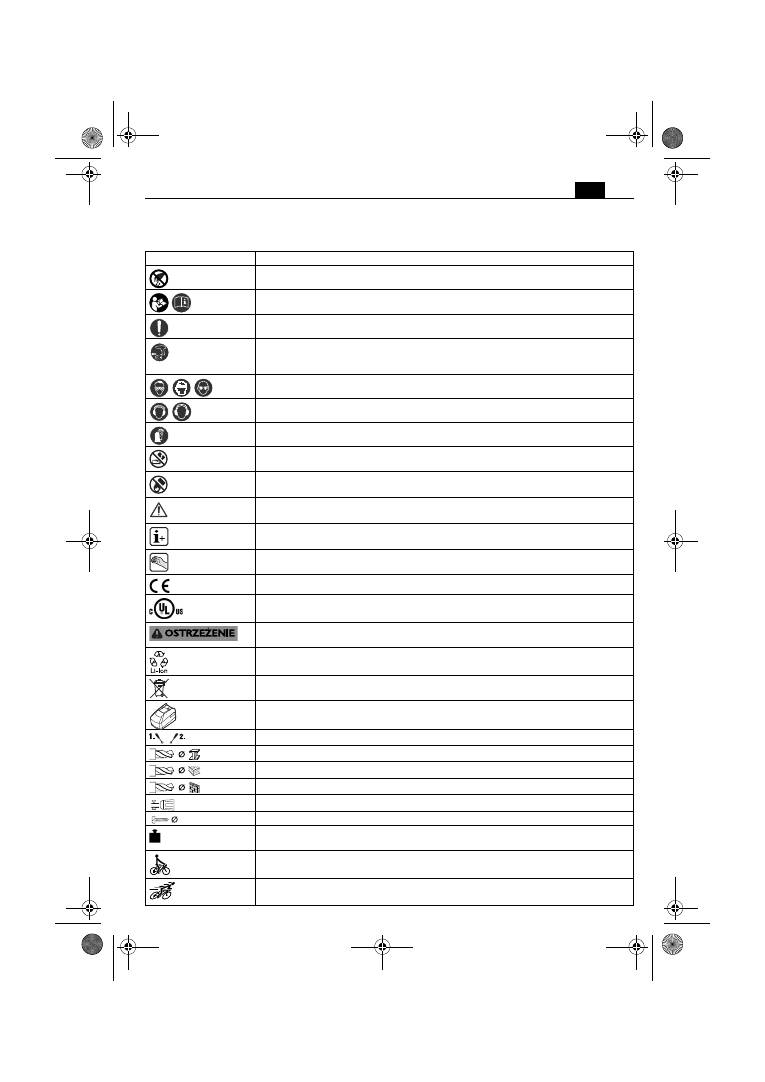
75
pl
pl
Oryginalna instrukcja eksploatacji.
Użyte symbole, skróty i pojęcia.
Symbol, znak
Objaśnienie
Nie należy dotykać części elektronarzędzia będących w ruchu.
Załączone dokumenty, tzn. instrukcję eksploatacji i ogólne wskazówki bezpieczeństwa
należy koniecznie przeczytać.
Należy stosować się do zaleceń zawartych w znajdującym się obok tekście lub na rysunku!
Przed przystąpieniem do tych czynności należy usunąć akumulator z elektronarzędzia. W
przeciwnym wypadku istnieje niebezpieczeństwo obrażeń przez niezamierzony rozruch
elektronarzędzia.
Podczas pracy należy używać środków ochrony oczu.
Podczas pracy należy używać środków ochrony słuchu.
Podczas pracy należy używać środków ochrony rąk.
Nie wolno ładować uszkodzonych akumulatorów.
Nie wolno zbliżać akumulatora do ognia. Akumulatory należy chronić przed wysokimi
temperaturami, np. przed stałym nasłonecznieniem.
Należy przestrzegać wskazówek w tekście obok!
Informacja dodatkowa.
Zakres chwytania
Potwierdza zgodność budowy elektronarzędzia z wytycznymi Wspólnoty Europejskiej.
Niniejszy symbol potwierdza certyfikację produktu na rynku USA i Kanady.
Nieprzestrzeganie tej wskazówki może doprowadzić do poważnych urazów ciała lub
nawet utraty życia.
Znaczek recyklingu: oznacza przydatność materiałów do ponownego przetwórstwa
Wyeliminowane elektronarzędzia i inne produkty elektrotechniczne i elektryczne należy
zbierać oddzielnie i poddać utylizacji zgodnie z zasadami ochrony środowiska.
Rodzaj akumulatora
1. Bieg/2. Bieg
Średnica wiercenia w stali
Średnica wiercenia w drewnie
Średnica wiercenia w kamieniu
Zakres mocowania uchwytu wiertarskiego
Średnica śrub i wkrętów
Ciężar zgodny z EPTA-Procedure 01/2003 (= z metodą Europejskiej Parlamentarnej
Weryfikacji Technologii)
Niska prędkość obrotowa
Wysoka prędkość obrotowa
Fe
OBJ_BUCH-0000000105-001.book Page 75 Thursday, April 4, 2013 10:23 AM
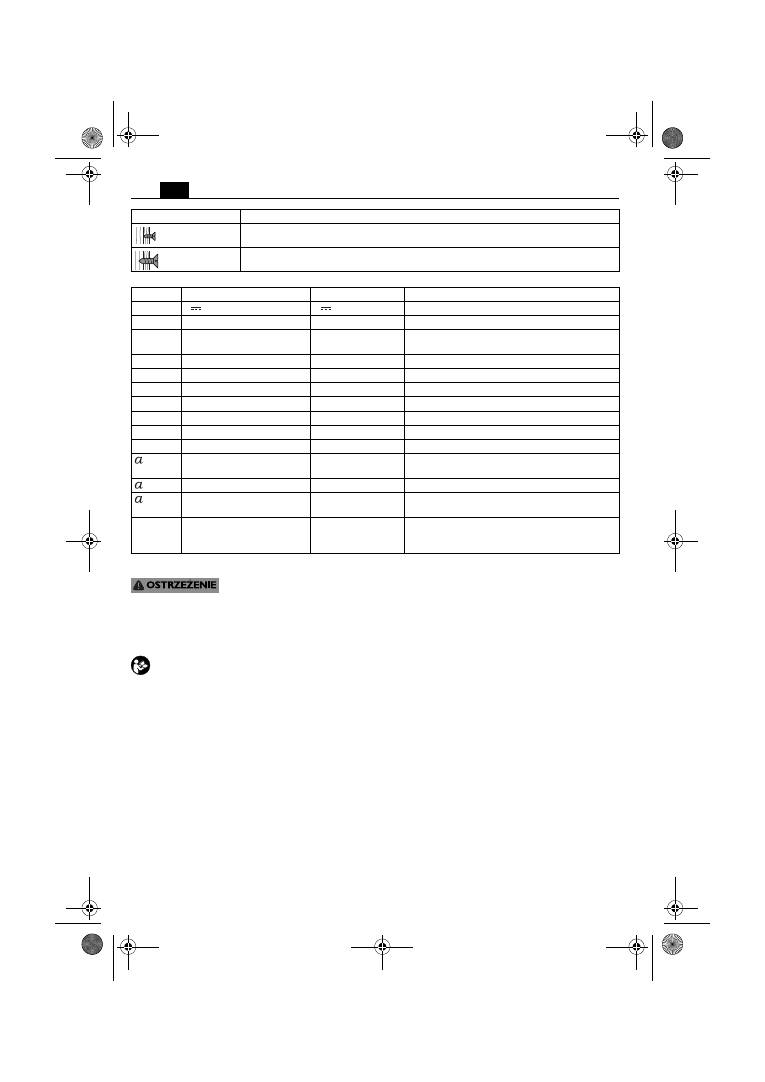
76
pl
Dla własnego bezpieczeństwa.
Należy przeczytać wszystkie
wskazówki i przepisy.
Błędy w
przestrzeganiu poniższych wskazówek mogą
spowodować porażenie prądem, pożar i/lub ciężkie
obrażenia ciała.
Należy starannie przechowywać wszystkie przepisy i
wskazówki bezpieczeństwa dla dalszego zastosowania.
Nie należy używać elektronarzędzia przed
uważnym przeczytaniem i zrozumieniem niniejszej
instrukcji eksploatacji, jak również załączonych
„Ogólnych wskazówek bezpieczeństwa“ (numer
3 41 30 054 06 1). Dokumenty te należy zachować do
dalszych zastosowań i przekazać je oddając lub
sprzedając elektronarzędzie.
Należy przestrzegać również odpowiednich przepisów
krajowych w zakresie bezpieczeństwa elektrycznego i
higieny pracy.
Przeznaczenie elektronarzędzia:
ABS14, ABS18:
ręcznie prowadzona wiertarko-wkrętarka przeznaczona
do wkręcania i wykręcania śrub, wkrętów i nakrętek, do
wkręcania i wiercenia w metalu, drewnie, tworzywach
sztucznych i ceramice, jak również do gwintowania, w
odpowiednich warunkach atmosferycznych i przy
zastosowaniu zatwierdzonych przez firmę FEIN narzędzi
roboczych i osprzętu.
ASB14, ASB18:
ręcznie prowadzona wiertarko-wkrętarka udarowa
przeznaczona do wkręcania i wykręcania śrub, wkrętów
i nakrętek, do wkręcania i wiercenia w metalu, drewnie,
tworzywach sztucznych i ceramice, jak również do
gwintowania i do wiercenia z udarem w betonie,
kamieniu i cegle, w odpowiednich warunkach
atmosferycznych, bez użycia wody i przy zastosowaniu
zatwierdzonych przez firmę FEIN narzędzi roboczych i
osprzętu.
Szczególne przepisy bezpieczeństwa.
Podczas wykonywania prac, przy których śruba mogłaby
natrafić na ukryte przewody elektryczne,
elektronarzędzie należy trzymać wyłącznie za izolowane
powierzchnie rękojeści.
Kontakt z przewodem sieci
zasilającej może spowodować przekazanie napięcia na
części metalowe urządzenia, co mogłoby spowodować
porażenie prądem elektrycznym.
Należy uważać na leżące w ukryciu przewody
elektryczne, rury gazowe i wodociągowe.
Przed
rozpoczęciem pracy należy skontrolować zakres pracy,
np. używając urządzenia do wykrywania metalu.
Należy nosić osobiste wyposażenie ochronne. W
zależności od rodzaju pracy, należy nosić maskę
ochronną pokrywającą całą twarz, ochronę oczu lub
okulary ochronne. W razie potrzeby należy użyć maski
przeciwpyłowej, ochrony słuchu, rękawic ochronnych
lub specjalnego fartucha, chroniącego przed małymi
cząstkami ścieranego i obrabianego materiału.
Zmniejszanie momentu obrotowego
Zwiększanie momentu obrotowego
Znak
Jednostka międzynarodowa
Jednostka lokalna
Objaśnienie
U
V
V
Elektryczne napięcie stałe
f
Hz
Hz
Częstotliwość
n
0
/min, min
-1
, rpm, r/min
/min
Prędkość obrotowa biegu jałowego (przy
całkowicie naładowanym akumulatorze)
n
S
/min, min
-1
/min
Liczba udarów
M...
Nm
Nm
Moment obrotowy (wkręcanie twarde/miękkie)
Ø
mm
mm
Średnica okrągłego elementu
L
pA
dB
dB
Poziom hałasu
L
wA
dB
dB
Poziom mocy akustycznej
L
pCpeak
dB
dB
Szczytowy poziom emisji ciśnienia akustycznego
K...
Niepewność
m/s
2
m/s
2
Wartości łączne drgań (suma wektorowa z trzech
kierunków) oznaczone zgodnie z EN 60745
h,D
m/s
2
m/s
2
Średnia wartość drgań dla wiercenia w metalu
h,ID
m/s
2
m/s
2
Średnia wartość drgań dla wiercenia udarowego
w betonie
m, s, kg, A, mm, V,
W, Hz, N, °C, dB,
min, m/s
2
m, s, kg, A, mm, V,
W, Hz, N, °C, dB,
min, m/s
2
Jednostki podstawowe i jednostki pochodne wg
Międzynarodowego Układu Jednostek Miar
SI
.
Symbol, znak
Objaśnienie
OBJ_BUCH-0000000105-001.book Page 76 Thursday, April 4, 2013 10:23 AM
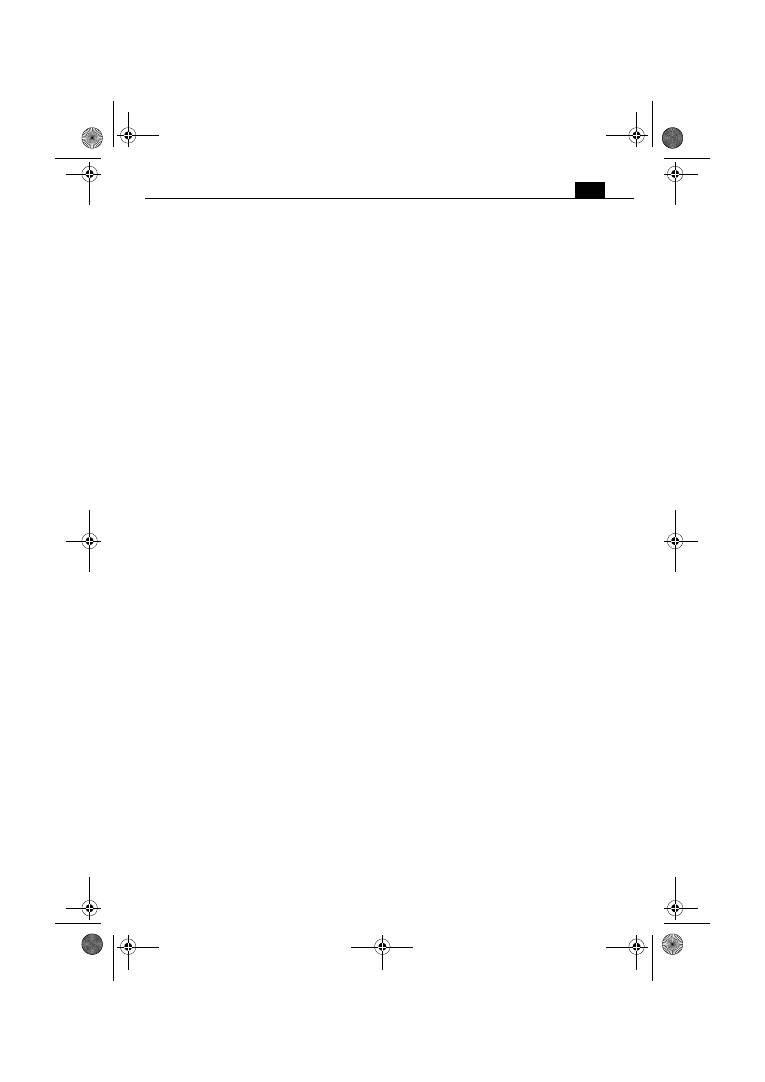
77
pl
Należy chronić oczy przed unoszącymi się w powietrzu
ciałami obcymi, powstałymi w czasie pracy. Maska
przeciwpyłowa i ochronna dróg oddechowych muszą
filtrować powstający podczas pracy pył. Oddziaływanie
hałasu przez dłuższy okres czasu, możne doprowadzić
do utraty słuchu.
Podczas pracy wiertarką udarową należy stosować
ochronniki słuchu.
Oddziaływanie hałasu może
spowodować utratę słuchu.
Należy używać urządzeń mocujących lub imadła do
zamocowania obrabianego przedmiotu.
W przypadku,
gdy obrabiany przedmiot trzymany jest w ręku,
bezpieczna obsługa urządzenia jest niemożliwa.
Elektronarzędzie należy mocno trzymać.
Możliwe jest
wystąpienie krótkotrwałych wysokich momentów odrzutu.
Nie należy obrabiać materiału zawierającego azbest.
Azbest jest rakotwórczy.
Zabronione jest przykręcanie lub nitowanie tabliczek i
znaków na elektronarzędziu.
Uszkodzona izolacja nie
daje żadnej ochrony przed porażeniem prądem. Należy
używać naklejek.
Nie należy używać osprzętu, który nie został
wyprodukowany lub dopuszczony przez producenta
elektronarzędzia.
Fakt, iż dany osprzęt pasuje na
elektronarzędzie nie gwarantuje bezpieczeństwa pracy.
Regularnie należy czyścić otwory wentylacyjne
elektronarzędzia, używając do tego celu narzędzi
niemetalowych. Dmuchawa silnika wciąga kurz do
obudowy.
Duże nagromadzenie pyłu metalowego może
spowodować zagrożenie elektryczne.
Nie wolno patrzeć z bliska w światło lampy
elektronarzędzia. Nie wolno w żadnym wypadku świecić
lampą w oczy osb, ktre znajdują się w pobliżu.
Promieniowanie wytwarzane przez źrdło światła może
uszkodzić wzrok.
Nie wolno kierować elektronarzędzia ani w swoim
kierunku, ani w kierunku innych osób lub zwierząt.
Istnieje niebezpieczeństwo skaleczenia przez ostre lub
gorące narzędzia robocze.
Zastosowanie i obsługa akumulatora
(akumulatora blokowego).
Aby uniknąć zagrożeń takich jak pożar, wybuch, obrażenia
skóry lub inne skaleczenia, należy obchodzić się z
akumulatorem przestrzegając następujących wskazówek:
Nie wolno rozkładać, otwierać lub przycinać
akumulatorów. Należy chronić akumulatory przed
mechanicznymi uderzeniami.
Uszkodzenie akumulatora
lub zastosowanie go w sposób niezgodny z
przeznaczeniem może doprowadzić do wystąpienia
niebezpiecznych oparów lub wycieku niebezpiecznych
substancji. Opary mogą podrażnić drogi oddechowe.
Wyciekający elektrolit może doprowadzić do
podrażnienia skóry lub oparzeń.
Jeżeli wyciekający elektrolit zamoczył znajdujące się w
pobliżu elementy, należy skontrolować zamoczone
elementy, oczyścić je lub w razie potrzeby wymienić.
Akumulator należy chronić przed wysokimi
temperaturami i przed ogniem. Akumulatora nie wolno
przechowywać w nasłonecznionym miejscu.
Akumulator należy wyjmować z oryginalnego
opakowania krótko przed przystąpieniem do jego
eksploatacji.
Przed przystąpieniem do jakichkolwiek prac przy
elektronarzędziu należy wyjąć z niego akumulator.
Niezamierzone uruchomienie elektronarzędzia niesie za
sobą niebezpieczeństwo skaleczenia.
Akumulator wyjmować wolno wyłącznie przy wyłączonym
elektronarzędziu.
Akumulatory należy trzymać z dala od dzieci.
Akumulator należy utrzymywać w czystości i chronić go
przed wilgocią i kontaktem z wodą.
Zabrudzone styki
akumulatora i elektronarzędzia należy czyścić suchą i
czystą szmatką.
Stosować należy wyłącznie oryginalne akumulatory firmy
FEIN, przeznaczone do danego rodzaju elektronarzędzia.
Podczas pracy z niewłaściwymi, uszkodzonymi,
reperowanymi lub przerabianymi akumulatorami, a także
z podróbkami lub akumulatorami innych producentów,
oraz podczas ich ładowania może dojść do pożaru lub
eksplozji.
Należy stosować się do wskazówek bezpieczeństwa
znajdujących się w instrukcji użytkowania ładowarki
akumulatorów.
Drgania działające na organizm człowieka przez
kończyny górne
Podany w niniejszej instrukcji poziom drgań pomierzony
został zgodnie z określoną przez normę EN 60745
procedurą pomiarową i może zostać użyty do
porównywania elektronarzędzi. Można go też użyć do
wstępnej oceny ekspozycji na drgania.
Podany poziom drgań jest reprezentatywny dla
podstawowych zastosowań elektronarzędzia. Jeżeli
elektronarzędzie użyte zostanie do innych zastosowań
lub z innymi narzędziami roboczymi, a także, jeśli nie
będzie wystarczająco konserwowane, poziom drgań
może odbiegać od podanego. Podane powyżej
przyczyny mogą spowodować podwyższenie ekspozycji
na drgania podczas całego czasu pracy.
Aby dokładnie ocenić ekspozycję na drgania, trzeba
wziąć pod uwagę także okresy, gdy urządzenie jest
wyłączone lub, gdy jest wprawdzie włączone, ale nie jest
używane do pracy. W ten sposób łączna (obliczana na
pełny wymiar czasu pracy) ekspozycja na drgania może
okazać się znacznie niższa.
Należy wprowadzić dodatkowe środki bezpieczeństwa,
mające na celu ochronę operatora przed skutkami
ekspozycji na drgania, np.: konserwacja elektronarzędzia
i narzędzi roboczych, zabezpieczenie odpowiedniej
temperatury rąk, ustalenie kolejności operacji roboczych.
Obchodzenie się z niebezpiecznymi pyłami
Podczas obróbki ubytkowej za pomocą niniejszego
narzędzia powstają pyły, które mogą stanowić
zagrożenie.
Dotykanie lub wdychanie niektórych rodzajów pyłów,
np. pyłów azbestowych lub z materiałów zawierających
azbest, z powłok zawierających ołów, z metalu, z
niektórych rodzajów drewna, minerałów, cząsteczek
silikatu z materiałów zawierających kamień, środków
zawierających rozpuszczalnik, substancji do ochrony
OBJ_BUCH-0000000105-001.book Page 77 Thursday, April 4, 2013 10:23 AM
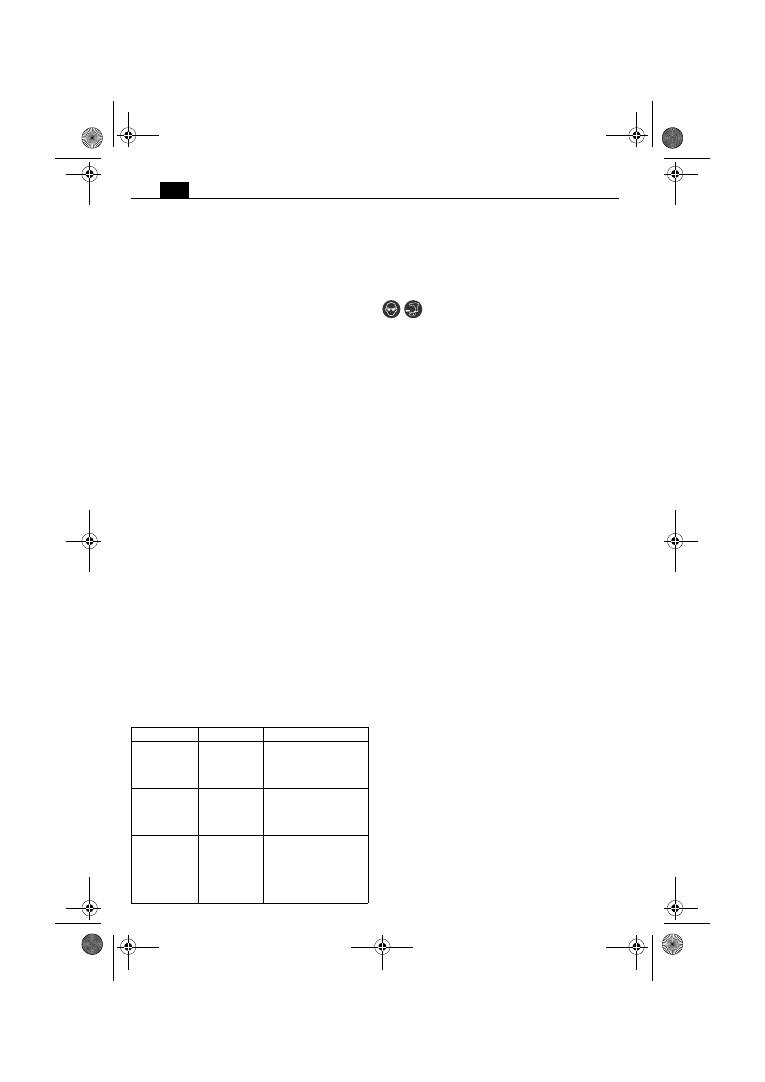
78
pl
drewna, farb przeciwporostowych może wywołać
reakcje alergiczne i/lub choroby dróg oddechowych,
raka i zaburzenia związane z płodnością. Ryzyko
spowodowane wdychaniem pyłów zależy od stopnia
ekspozycji. Zaleca się użycie systemu odsysania,
dostosowanego do rodzaju pyłu jak również osobistego
wyposażenia ochronnego, a także zadbanie o dobrą
wentylację stanowiska pracy. Obróbkę materiałów
zawierających azbest należy zlecić odpowiednim
fachowcom.
W niesprzyjających warunkach może dojść do
samozapalenia pyłów drewnianych i pyłów z metali
lekkich, gorących mieszanek z pyłów szlifierskich i
substancji chemicznych lub wręcz do eksplozji. Należy
zapobiec, aby iskry powstające podczas obróbki spadały
na pojemnik na pył; należy też unikać przegrzania się
elektronarzędzia i obrabianego materiału. Należy
regularnie opróżniać pojemnik na pył, przestrzegając
przy tym wskazówki producenta obrabianego materiału,
jak również obowiązujących przepisów danego kraju.
Wskazówki dotyczące obsługi.
Przełącznik kierunku obrotów i przełącznik biegów
uruchamiać wolno wyłącznie przy wyłączonym silniku.
Przełącznik biegów należy zawsze przesuwać do końca,
a przełącznik trybów pracy (ASB14/18) obracać do
oporu. W przeciwnym wypadku elektronarzędzie może
ulec uszkodzeniu.
W przypadku przeciążenia elektronarzędzie wyłącza się
samoczynnie.
Ustawić przełącznik kierunku obrotów w położeniu
środkowym, aby uniknąć niezamierzonego
uruchomienia narzędzia, np. podczas transportu.
Ustawianie momentu obrotowego
Elektronarzędzie zostało ustawione fabrycznie do
wkręcania mniejszych i średniej wielkości śrub.
Moment obrotowy jest uzależniony też od siły, z jaką
elektronarzędzie przyciśnięte zostanie do śruby.
Obchodzenie się z akumulatorami.
Użytkowanie i ładowanie akumulatora dozwolone jest
tylko wówczas, gdy akumulator znajduje się w zakresie
temperatur roboczych leżącym między 0 °C – 45 °C
(32 °F – 113 °F). Temperatura akumulatora na początku
ładowania musi znajdować się w zakresie temperatur
roboczych akumulatora.
Prawdziwy stan naładowania akumulatora ukazany
zostanie w procentach tylko przy wyłączonym silniku
elektronarzędzia.
Przed zbliżającym się głębokim wyładowaniem się
akumulatora, układ elektroniczny elektronarzędzia
automatycznie wyłącza silnik.
Konserwacja i serwisowanie.
Obróbka metali w ekstremalnych warunkach
może spowodować osadzenie się wewnątrz
elektronarzędzia pyłu metalicznego, będącego
w stanie przewodzić prąd. Należy często przedmuchiwać
wnętrze elektronarzędzia (przez otwory wentylacyjne)
za pomocą suchego i bezolejowego powietrza
sprężonego.
Aktualna lista części zamiennych dla niniejszego
elektronarzędzia znajduje się pod adresem
internetowym www.fein.com.
W razie potrzeby możliwa jest wymiana we własnym
zakresie następujących elementów:
narzędzia robocze, akumulator
Rękojmia i gwarancja.
Rękojmia na produkt jest ważna zgodnie z ustawowymi
przepisami regulującymi w kraju, w którym produkt
został wprowadzony do obrotu. Oprócz tego produkt
objęty jest gwarancją firmy FEIN, zgodnie z deklaracją
gwarancyjną producenta.
W zakres dostawy nabytego elektronarzędzia może
wchodzić tylko część ukazanego na rysunkach lub
opisanego w instrukcji eksploatacji osprzętu.
Oświadczenie o zgodności.
Firma FEIN oświadcza z pełną odpowiedzialnością, że
niniejszy produkt zgodny jest z odpowiednimi
postanowieniami podanymi na ostatniej stronie niniejszej
instrukcji eksploatacji.
Dokumentacja techniczna: C. & E. FEIN GmbH,
C-DB_IA, D-73529 Schwäbisch Gmünd
Ochrona środowiska, usuwanie odpadów.
Opakowanie, zużyte elektronarzędzia i osprzęt należy
dostarczyć do utylizacji zgodnie z przepisami z ochrony
środowiska.
Akumulatory należy oddawać do punktu utylizacji w
stanie rozładowanym.
Jeżeli akumulator nie rozładował się całkowicie, styki
należy zakleić taśmą izolującą, w celu uniknięcia zwarcia.
Wskaźnik LED
Znaczenie
Akcja
1 – 4 zielone
diody LED
Procentualny
stan stopnia
naładowania
akumulatora
Eksploatacja
Czerwone
światło ciągłe
Akumulator
jest prawie
całkowicie
rozładowany
Naładować akumulator
Czerwone
światło
migające
Akumulator
nie jest
gotowy do
eksploatacji
Przed przystąpieniem
do ładowania
akumulator musi
mieścić się w zakresie
temperatur roboczych
akumulatora
OBJ_BUCH-0000000105-001.book Page 78 Thursday, April 4, 2013 10:23 AM

79
ro
ro
Instrucţiuni de utilizare originale.
Simboluri, prescurtări şi termeni utilizaţi.
Simbol, semn
Explicaţie
Nu atingeţi componentele sculei electrice care se rotesc.
Citiţi neapărat documentele alăturate precum instrucţiunile de utilizare şi indicaţiile de
ordin general privind siguranţa şi potecţia muncii.
Respectaţi instrucţiunile din textul sau schiţa alăturată!
Înaintea acestei etape de lucru, scoateţi acumulatorul de pe maşina electrică. În caz
contrar pornirea accidentală a sculei electrice poate provoca leziuni.
În timpul lucrului folosiţi ochelari de protecţie.
În timpul lucrului folosiţi protecţie auditivă.
În timpul lucrului folosiţi mănuşi de protecţie.
Nu puneţi la încărcat acumulatori defecţi.
Nu expuneţi acumulatorul la foc. Protejaţi acumulatorul împotriva căldurii, de exemplu
împotriva expunerii permanente la radiaţii solare.
Respectaţi indicaţiile din textul alăturat!
Informaţie suplimentară.
Suprafaţă de prindere
Certifică conformitatea sculei electrice cu Normele Comunităţii Europene.
Acest simbol confirmă certificarea produsului în SUA şi Canada.
Această indicaţie avertizează asupra posibilităţii de producere a unei situaţii periculoase
care poate duce la accidentare.
Simbol pentru reciclare: marchează materialele reciclabile
Colectaţi separat sculele electrice şi alte produse electronice şi electrice scoase din uz şi
direcţionaţi-le către o staţie de reciclare ecologică.
Tip acumulator
Treapta 1-a/2-a
Diametru maxim de găurire oţel
Diametru maxim de găurire lemn
Diametru de găurire piatră
Domeniu de prindere în mandrină
Diametru şuruburi
Greutate conform EPTA-Procedure 01/2003
Turaţie mică
Turaţie mare
Fe
OBJ_BUCH-0000000105-001.book Page 79 Thursday, April 4, 2013 10:23 AM
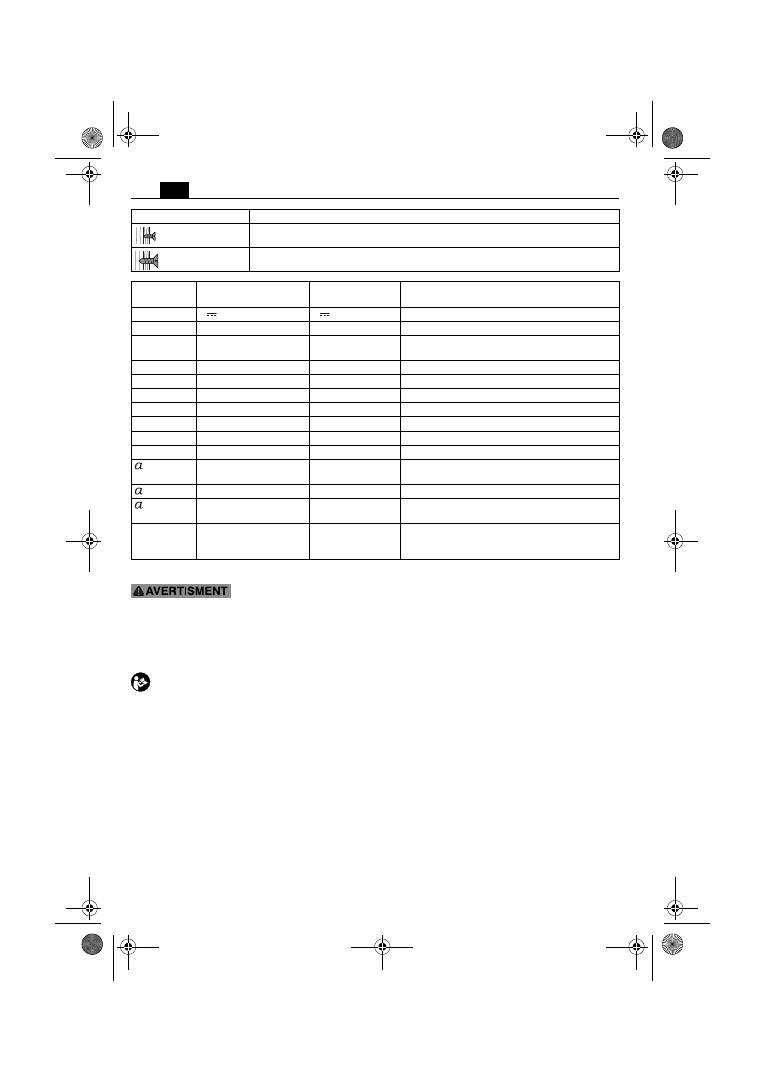
80
ro
Pentru siguranţa dumneavoastră.
Citiţi toate instrucţiunile şi
indicaţiile privind siguranţa şi
protecţia muncii.
Nerespectarea instrucţiunilor şi
indicaţiilor privind siguranţa şi protecţia muncii poate duce
la electrocutare, incendiu şi/sau provoca leziuni grave.
Păstraţi în vederea unei utilizări viitoare toate
instrucţiunile şi indicaţiile privind siguranţa şi protecţia
muncii.
Nu folosiţi această sculă electrică înainte de a citi
temeinic şi a înţelege în întregime prezentele
instrucţiuni de utilizare cât şi „Instrucţiunile de
ordin general privind siguranţa şi protecţia muncii“
(număr document 3 41 30 054 06 1) alăturate. Păstraţi
documentaţia amintită în vederea unei utilizări ulterioare
şi transmiteţi-le mai departe în cazul predării sau
înstrăinării sculei electrice.
Respectaţi deasemenea normele naţionale de protecţia
muncii.
Destinaţia sculei electrice:
ABS14, ABS18:
maşină de găurit şi înşurubat pentru înşurubarea şi
deşurubarea de şuruburi şi piuliţe, pentru găurire în
metal, lemn, material plastic şi ceramică cât şi pentru
filetare cu accesorii admise de FEIN, fără alimentare cu
apă, în mediu protejat la intemperii.
ASB14, ASB18:
maşină de înşurubat şi găurit cu percuţie pentru
înşurubarea şi deşurubarea de şuruburi şi piuliţe, pentru
găurire în metal, lemn, material plastic şi ceramică cât şi
pentru filetare şi găurire cu percuţie în beton, piatră şi
cărămidă cu accesorii admise de FEIN, fără alimentare cu
apă, în mediu protejat la intemperii.
Instrucţiuni speciale privind siguranţa şi protecţia
muncii.
Prindeţi scula electrică de mânerele izolate atunci când
executaţi operaţii în cursul cărora dispozitivul de fixare
poate atinge conductori ascunşi.
Contactul cu un
conductor aflat sub tensiune poate pune sub tensiune şi
componentele metalice ale sculei electrice şi provoca
electrocutare.
Aveţi grijă la conductorii electrici ascunşi, conductele de
gaz şi de apă ascunse.
Înainte de a începe lucrul
controlaţi, de ex. cu un detector de metale, sectorul de
lucru.
Purtaţi echipament personal de protecţie. În funcţie de
utilizare, purtaţi o protecţie completă a feţei, protecţie
pentru ochi sau ochelari de protecţie. Dacă este cazul,
purtaţi mască de protecţie împotriva prafului, protecţie
auditivă, mănuşi de protecţie sau şorţ special care să vă
ferească de micile aşchii şi particule de material.
Ochii
trebuie protejaţi de corpurile străine aflate în zbor,
apărute în cursul diferitelor aplicaţii. Masca de protecţie
împotriva prafului sau masca de protecţie a respiraţiei
trebuie să filtreze praful degajat în timpul utilizării. Dacă
sunteţi expuşi timp îndelungat zgomotului puternic, vă
puteţi pierde auzul.
Reduceţi momentul de torsiune
Măriţi momentul de torsiune
Simbol
Unitate de măsură
internaţională
Unitate de măsură
naţională
Explicaţie
U
V
V
Curent electric continuu
f
Hz
Hz
Frecvenţă
n
0
/min, min
-1
, rpm, r/min
rot/min
Turaţie de mers în gol (cu acumulatorul complet
încărcat)
n
S
/min, min
-1
bătăi/min
Număr percuţii
M...
Nm
Nm
Moment de torsiune (înşurubare dură/moale)
Ø
mm
mm
Diametrul unei piese rotunde
L
pA
dB
dB
Nivel presiune sonoră
L
wA
dB
dB
Nivel putere sonoră
L
pCpeak
dB
dB
Nivel maxim putere sonoră
K...
Incertitudine
m/s
2
m/s
2
Valoarea vibraţiilor emise conform EN 60745
(suma vectorială a trei direcţii)
h,D
m/s
2
m/s
2
Valoare medie a vibraţiilor pentru găurire în metal
h,ID
m/s
2
m/s
2
Valoare medie a vibraţiilor pentru găurire cu
percuţie în beton
m, s, kg, A, mm, V,
W, Hz, N, °C, dB,
min, m/s
2
m, s, kg, A, mm, V,
W, Hz, N, °C, dB,
min, m/s
2
Unităţi de măsură de bază sau derivate din Sistemul
Internaţional
SI
.
Simbol, semn
Explicaţie
OBJ_BUCH-0000000105-001.book Page 80 Thursday, April 4, 2013 10:23 AM
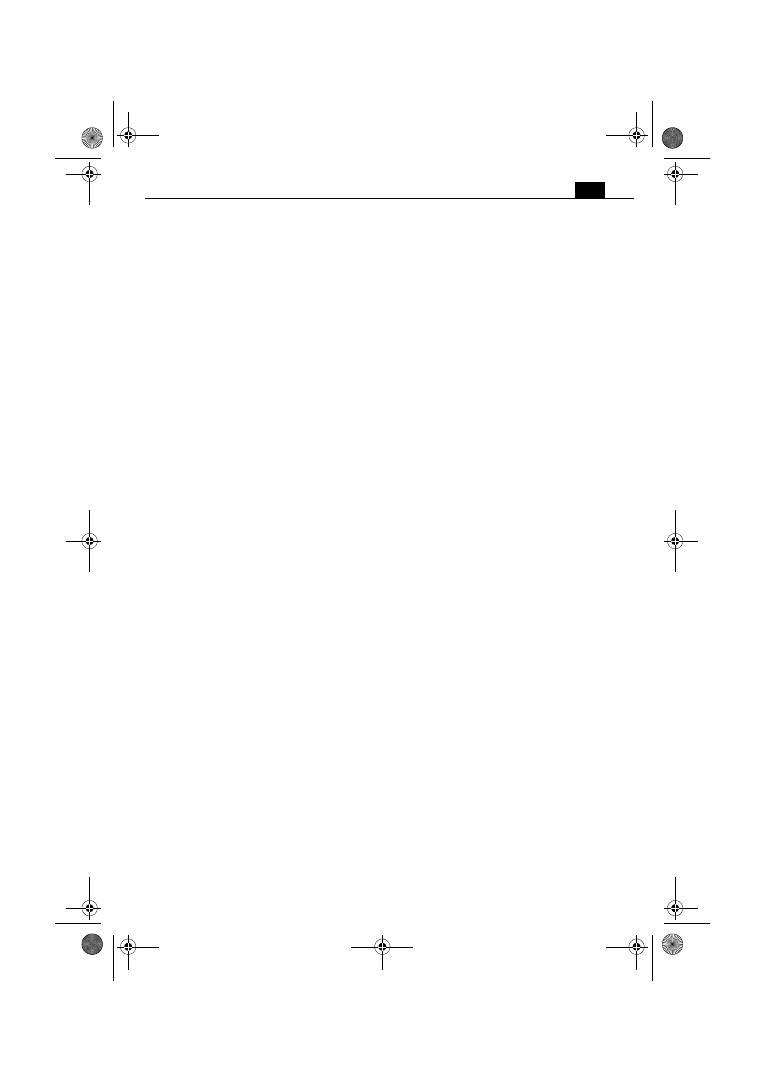
81
ro
Purtaţi echipament de protecţie auditivă la găurirea cu
percuţie.
Expunerea la zgomot poate provoca pierderea
auzului.
Asiguraţi piesa de lucru.
O piesă de lucru fixată cu un
dispozitiv de prindere este ţinută mai sigur decât atunci
când o prindeţi numai cu mâna.
Prindeţi strâns scula electrică.
Pentru scurt timp pot
apărea forţe de reacţie puternice.
Nu prelucraţi materiale care conţin azbest.
Azbestul se
consideră a fi cancerigen.
Este interzisă înşurubarea sau nituirea de plăcuţe şi
embleme pe scula electrică.
O izolaţie deteriorată nu
oferă protecţie împotriva electrocutării. Folosiţi etichete
autocolante.
Nu folosiţi accesorii care nu au fost realizate sau
autorizate în mod special de fabricantul sculei electrice.
Utilizarea în condiţii de siguranţă nu este garantată numai
prin faptul că accesoriul resprectiv se potriveşte la scula
dumneavoastră electrică.
Curăţaţi regulat orificiile de aerisire ale sculei electrice
cu unelte nemetalice.
Ventilatorul trage praful în carcasă.
Acest fapt poate cauza pericole electrice în cazul
acumulării excesive de pulberi metalice, generând
pericole electrice.
Nu priviţi niciodată de la distanţe mici în lumina lămpii
sculei electrice. Nu îndreptaţi niciodată lumina lămpii
spre ochii altor persoane, aflate în preajmă.
Radiaţia
emisă de sursa de lumină poate fi dăunătoare pentru ochi.
Nu îndreptaţi scula electrică spre dumneavoastră, spre
alte persoane sau animale.
Există pericol de rănire din
cauza accesoriilor ascuţite sau fierbinţi.
Utilizarea şi manevrarea acumulatorului
(pachetului de acumulatori).
Pentru evitarea situaţiilor periculoase cum ar fi arsurile,
incendiul, explozia, răniri ale pielii şi alte răniri în timpul
manipulării acumulatorilor, vă rugăm să respectaţi
următoarele indicaţii:
Nu este permisă demontarea, deschiderea şi
dezasamblarea acumulatorilor. Nu expuneţi acumulatorii
şocurilor mecanice.
În caz de deteriorare a
acumulatorului şi utilizare neconformă destinaţiei, din
acesta se pot degaja vapori şi se pot scurge lichide nocive.
Vaporii pot irita căile respiratorii. Lichidul scurs din
acumulator poate duce la iritaţii sau arsuri ale pielii.
În cazul în care lichidul scurs din acumulatorul deteriorat
a umectat obiectele învecinate, verificaţi piesele
respective, curăţaţi-le sau, dacă este necesar, înlocuiţi-le.
Nu expuneţi acumulatorul la căldură sau la foc. Nu
depozitaţi acumulatorul în lumina directă a soarelui.
Înainte de a-l utiliza, extrageţi acumulatorul din
ambalajul său original.
Înaintea oricăror intervenţii asupra sculei electrice,
detaşaţi acumulatorul de pe aceasta.
În cazul în care
scula electrică porneşte accidental, există pericol de
rănire.
Detaşaţi acumulatorul de pe scula electrică numai după
ce în prealabil aţi oprit-o.
Ţineţi acumulatorii la loc inaccesibil copiilor.
Păstraţi acumulatorul curat şi protejaţi-l de umezeală şi
apă.
Curăţaţi contactele murdare ale acumulatorului şi ale
sculei electrice cu o lavetă uscată, curată.
Folosiţi numai acumulatori intacţi, originali FEIN, destinaţi
sculei dumneavoastră electrice.
În timpul lucrului şi la
încărcarea unor acumulatori deterioraţi, reparaţi sau
modificaţi, a unor produse contrafăcute şi de fabricaţie
străină, există pericol de incendiu şi/sau explozie.
Respectaţi indicaţiile privind siguranţa cuprinse în
instrucţiunile de utilizare ale încărcătorului.
Vibraţii mână-braţ
Nivelul vibraţiilor specificat în prezentele instrucţiuni a
fost măsurat conform unei proceduri de măsurare
standardizate în EN 60745 şi poate fi utilizat la
compararea sculelor electrice între ele.
Nivelul specificat al vibraţiilor se referă la utilizările
principale ale sculei electrice. Desigur în cazul în care
scula electrică va fi folosită pentru alte utilizări, cu
dispozitive de lucru neautorizate sau nu va beneficia de o
întreţinere corespunzătoare, nivelul vibraţiilor poate fi
diferit. Aceasta poate mări considerabil expunerea la
vibraţii calculată pe tot intervalul de lucru.
Pentru o evaluare precisă a expunerii la vibraţii ar trebui
luate în considerare şi perioadele de timp în care scula
electrică este oprită sau este în funcţiune dar nu este
folosită efectiv. Aceasta ar putea reduce semnificativ
expunerea la vibraţii calculată cumulativ pe întregul
interval de lucru.
Adoptaţi măsuri suplimentare privind siguranţa, pentru a
proteja operatorul împotriva efectelor vibraţiilor, ca de
exemplu: întreţinerea sculei electrice şi a dispozitivelor
de lucru, menţinerea la cald a mâinilor, organizarea
raţională a proceselor de lucru.
Manipularea pulberilor periculoase
În timpul operaţiilor de îndepărtare a materialului cu
această unealtă, se degajă pulberi care pot fi periculoase.
Atingerea sau inhalarea anumitor pulberi ca de exemplu
azbest şi materiale care conţin azbest, vopsele pe bază de
plumb, metale, anumite tipuri de lemn, minerale,
particule de silicaţi provenind din materiale de construcţii
din piatră, solvenţi, agenţi de protecţie a lemnului,
vopsele antifouling pentru cisterne, pot provoca reacţii
alergice şi/sau afecţiuni ale căilor respiratorii, cancer,
infertilitate. Riscul generat de inhalarea acestor pulberi
depinde de gradul de expunere la acestea. Folosiţi o
instalaţie de aspirare adecvată tipului de praf degajat
precum şi echipamente personale de protecţie şi asiguraţi
o bună ventilare a locului de muncă. Nu permiteţi
prelucrarea materialelor care conţin azbest decât de către
personal corespunzător calificat.
În condiţii nefavorabile, praful de lemn şi de metale
uşoare, amestecurile fierbinţi de praf de şlefuire şi
substanţe chimice se pot autoaprinde sau provoca
explozii. Împiedicaţi zborul scânteilor în direcţia
recipientului colector de praf precum şi încălzirea
excesivă a sculei electrice şi a materialului şlefuit, goliţi din
timp recipientul colector de praf, respectaţi instrucţiunile
de prelucrare ale producătorului materialului respectv cât
şi prescripţiile în vigoare în ţara dumneavoastră cu privire
la materialele de prelucrat.
OBJ_BUCH-0000000105-001.book Page 81 Thursday, April 4, 2013 10:23 AM
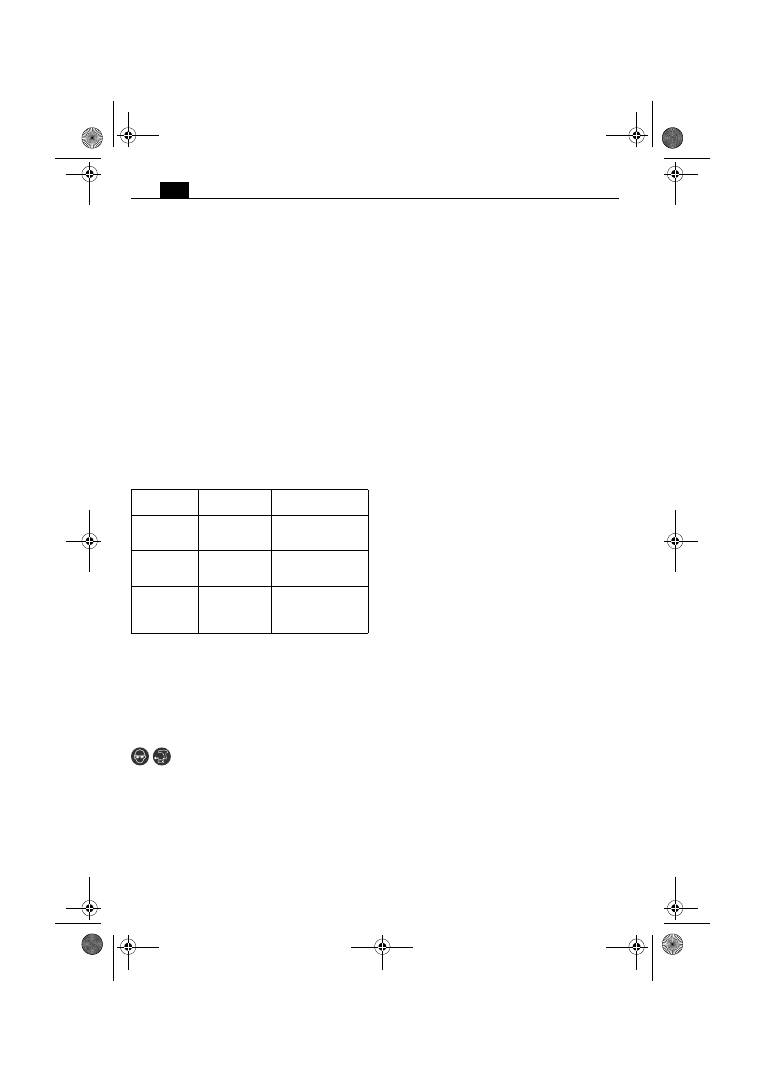
82
ro
Instrucţiuni de utilizare.
Acţionaţi comutatorul sensului de rotaţie şi comutatorul
de selecţie a treptelor de putere numai cu motorul oprit.
Împingeţi comutatorul de selecţie a treptelor de putere
respectiv rotiţi comutatorul modurilor de funcţionare
(ASB14/18) întotdeauna până la punctul de oprire. În caz
contrar scula electrică se poate defecta.
În caz de suprasolicitare scula electrică se opreşte din
funcţionare.
Aduceţi comutatorul sensului de rotaţie în poziţia din
mijloc pentru a evita pornirea involuntară a sculei
electrice, de exemplu în timpul transportului.
Reglarea momentului de torsiune
Reglajul din fabrică corespunde domeniului adecvat
şuruburilor de dimensiuni mai mici până la medii.
Momentul de strângere depinde şi de forţa cu care se
apasă scula electrică pe şurub.
Manipularea acumulatorului.
Folosiţi şi încărcaţi acumulatorul numai în domeniul
temperaturiloir de lucru de 0 °C – 45 °C (32 °F – 113 °F).
În momentul începerii procesului de încărcare,
temperatura acumulatorului trebuie să fie în domeniul
temperaturilor de lucru ale acumulatorului.
Nivelul procentual real de încărcare a acumulatorului este
afişat numai atunci când motorul sculei electrice este
oprit.
Înainte de a se ajunge la descărcarea profundă a
acumulatorului, sistemul electronic opreşte automat
motorul.
Întreţinere şi asistenţă service post-
vânzări.
În cazul unor condiţii de utilizare extrem de
grele, la prelucrarea metalelor, în interiorul
sculei electrice se poate depune praf bun
conducător electric. Suflaţi frecvent aer comprimat uscat
şi fără ulei prin orificiile de aerisire în interiorul sculei
electrice.
Găsiţi lista actuală de piese de schimb pentru această sculă
electrică pe internet, la www.fein.com.
Puteţi schimba şi singuri, dacă este necesar, următoarele
piese:
scule, acumulator
Garanţia legală de conformitate şi
garanţia comercială.
Garanţia legală de conformitate a produsului se acordă
conform reglementărilor legale din ţara punerii în
circulaţie a acestuia. În plus, FEIN acordă o garanţie
comercială conform certificatului de garanţie al
producătorului FEIN.
Setul de livrare al sculei dumneavoastră electrice poate să
cuprindă numai o parte a accesoriilor descrise sau
ilustrate în prezentele instrucţiuni de folosire.
Declaraţie de conformitate.
Firma FEIN declară pe proprie răspundere că acest
produs corespunde prevederilor specificate la ultima
pagină a prezentelor instrucţiuni de utilizare.
Documentaţie tehnică la: C. & E. FEIN GmbH, C-DB_IA,
D-73529 Schwäbisch Gmünd
Protecţia mediului înconjurător,
eliminare.
Ambalajele, sculele electrice şi accesoriile scoase din uz
trebuie direcţionate către o staţie de reciclare ecologică.
După ce mai întâi i-aţi descărcat, direcţionaţi acumulatorii
către un punct de colectare a deşeurilor sortate.
În cazul în care acumulatorii nu sunt complet descărcaţi,
ca o măsură preventivă, izolaţi conectorii acestuia cu
bandă adezivă.
Indicator cu
LED-uri
Semnificaţie
Acţiune
LED verde
1 – 4
nivel de
încărcare în
procente
Funcţionare
lumină roşie
continuă
Acumulatorul
este aproape
descărcat
Încărcaţi
acumulatorul
lumină roşie
intermitentă
Acumulatorul
nu este pregătit
de funcţionare
Aduceţi acumulatorul
în domeniul
temperaturilor de
lucru, apoi încărcaţi-l
OBJ_BUCH-0000000105-001.book Page 82 Thursday, April 4, 2013 10:23 AM
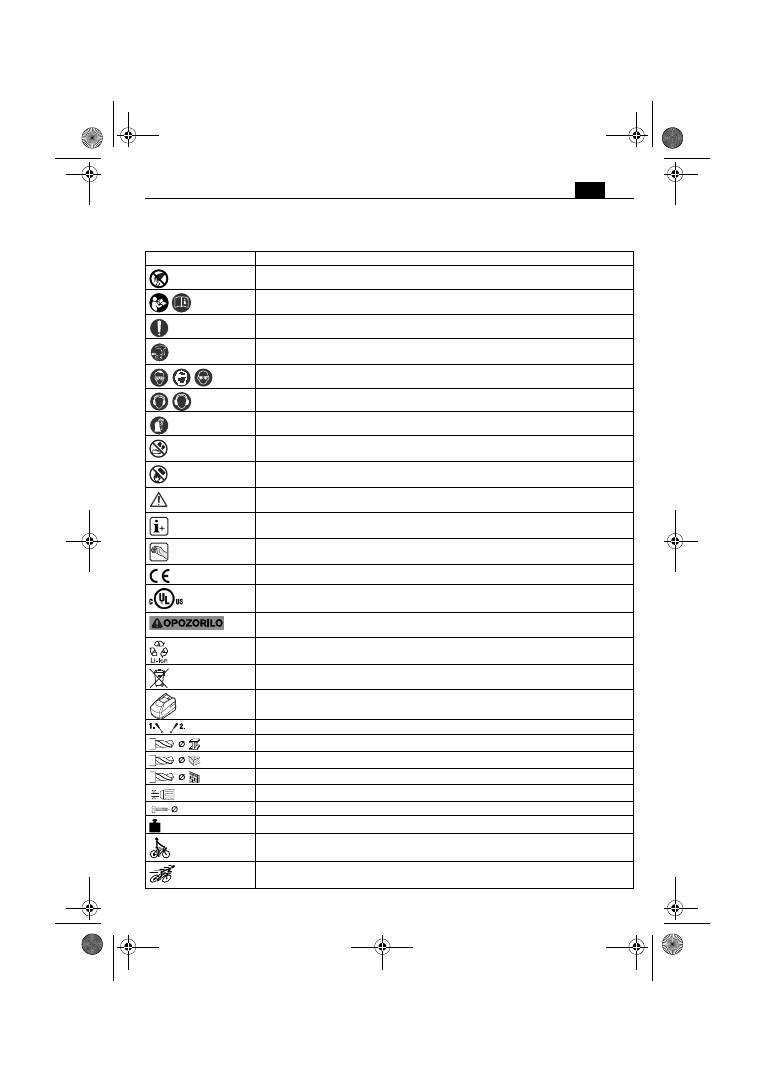
83
sl
sl
Originalno navodilo za obratovanje.
Uporabljeni simboli, kratice in pojmi.
Simbol, znaki
Razlaga
Ne dotikajte se rotirajočih delov električnega orodja.
Nujno preberite priloženo dokumentacijo, kot je to Navodilo za obratovanje in Splošna
varnostna navodila.
Sledite navodilom bližnjega besedila ali slike!
Pred tem delovnim korakom odstranite akumulatorsko baterijo iz električnega orodja.
Sicer obstaja nevarnost poškodb zaradi nenamernega vklopa električnega orodja.
Pri delu morate uporabljati zaščito za oči.
Pri delu morate uporabljati zaščito sluha.
Pri delu morate uporabljati zaščito za roke.
Ne smete polniti poškodovanih akumulatorskih baterij.
Zavarujte akumulatorsko baterijo pred ognjem. Zaščitite akumulatorsko baterijo pred
vročino, npr. tudi pred stalno izpostavljenostjo soncu.
Upoštevajte opozorila, ki se nahajajo zraven!
Dodatna informacija.
Področje držala
Potrdilo o skladnosti električnega orodja z direktivami Evropske skupnosti.
Ta simbol potrjuje certificiranje tega izdelka v ZDF in Kanadi.
To opozorilo prikazuje možno nevarno situacijo, ki lahko privede do resnih poškodb ali
smrti.
Znak za reciklažo: označuje materiale, ki jih je možno reciklirati.
Ločeno zbirajte električna orodja in druge elektrotehnične in električne proizvode in
poskrbite za njihovo okolju prijazno recikliranje.
Tip akumulatorske baterije
1. stopnja/2. stopnja
Vrtalni premer jekla
Vrtalni premer lesa
Vrtalni premer kamen
Območje vpenjanja vpenjalne glave
Premer vijaka
Teža v skladu z EPTA-Procedure 01/2003
Majhno število vrtljajev
Veliko število vrtljajev
Fe
OBJ_BUCH-0000000105-001.book Page 83 Thursday, April 4, 2013 10:23 AM
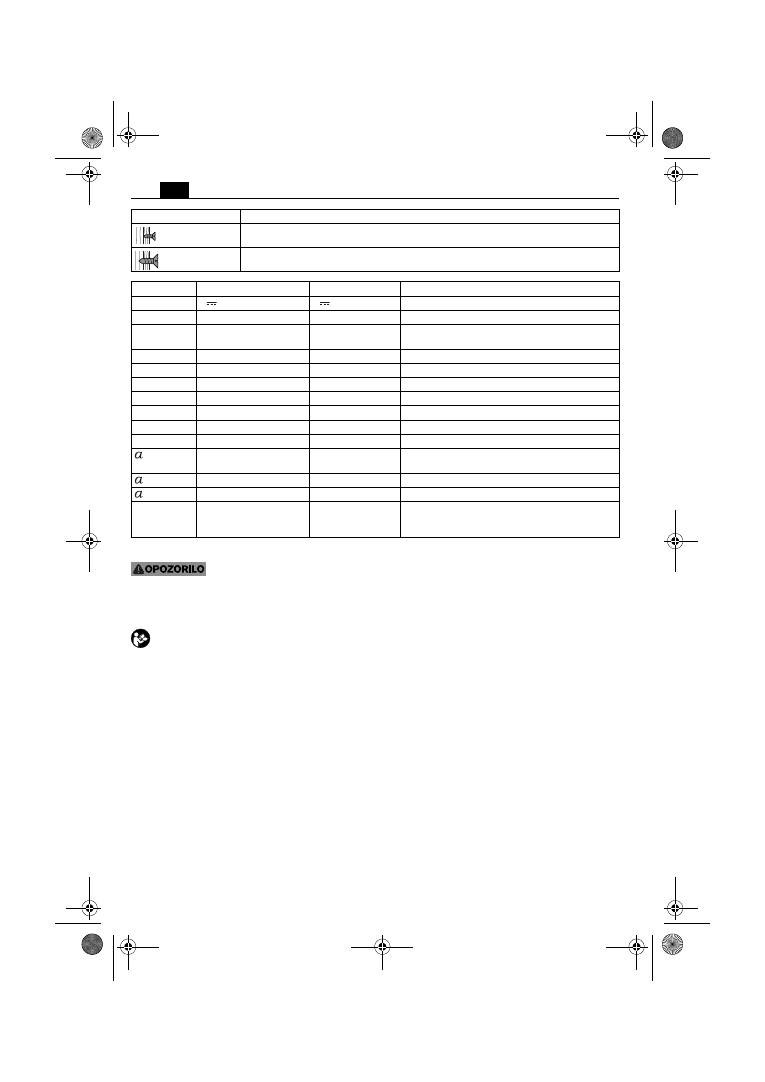
84
sl
Za vašo varnost.
Preberite vsa varnostna opozorila in
navodila.
Neupoštevanje varnostnih
navodil in napotkov lahko povzroči električni udar, požar
in/ali težke poškodbe.
Shranite vsa varnostna opozorila in navodila za
prihodnost.
Tega električnega orodja ne uporabljajte tako
dolgo, preden niste temeljito prebrali tega navodila
za uporabo ter priloženih „Splošnih varnostnih
opozoril“ (številka spisa 3 41 30 054 06 1) in jih v celoti
razumeli. Navedeno dokumentacijo shranite za kasnejšo
uporabo in jo izročite naprej pri posredovanju ali
odsvojitvi električnega orodja.
Prav tako upoštevajte zadevne nacionalne predpise
varstva pri delu.
Namembnost električnega orodja:
ABS14, ABS18:
ročno voden vrtalni vijačnik za privijanje in odvijanje
vijakov in matic in za vrtanje in vijačenje v kovino, les,
umetne mase, keramiko ter za rezanje navojev z
vstavnimi orodji, ki so odobreni s strani FEIN in priborom
brez dovoda vode v vremensko zaščitenem okolju.
ASB14, ASB18:
ročno voden udarni vrtalni vijačnik za privijanje in
odvijanje vijakov in matic in za vrtanje in vijačenje v
kovino, les, les, umetne mase, keramiko, ter za rezanje
navojev in udarno vrtanje v beton, kamnine in opeko, z
vstavnimi orodji, ki so odobreni s strani FEIN in priborom
brez dovoda vode v vremensko zaščitenem okolju.
Posebna varnostna navodila.
Električno orodje smete držati le na izoliranem ročaju, če
delate na območju, kjer lahko vijak pride v stik s skritimi
omrežnimi napeljavami.
Stik z napeljavo pod napetostjo
povzroči, da so tudi kovinski deli naprave pod napetostjo
in to posledično povzroči električni udar.
Pazite na skrite električne vodnike, plinski in vodovodni
cevovod.
Pred pričetkom dela kontrolirajte delovno
območje npr. z lokatorjem kovine.
Uporabljajte osebno zaščitno opremo. Odvisno od vrste
uporabe si nataknite zaščitno masko čez cel obraz,
zaščito za oči ali zaščitna očala. Če je potrebno, nosite
zaščitno masko proti prahu, zaščitne glušnike, zaščitne
rokavice ali specialni predpasnik, ki Vas bo zavaroval
pred manjšimi delci materiala, ki nastajajo pri brušenju.
Oči je treba zavarovati pred tujki, ki nastajajo pri različnih
vrstah uporabe naprave in letijo naokrog. Zaščitna maska
proti prahu ali dihalna maska morata filtrirati prah, ki
nastaja pri uporabi. Predolgo izpostavljanje glasnemu
hrupu ima lahko za posledico izgubo sluha.
Pri udarnem vrtanju nosite zaščito sluha.
Vpliv hrupa
lahko povzroči izgubo sluha.
Zavarujte obdelovanec.
Varneje je, da držite obdelovanec
z vpenjalno napravo, kot pa z roko.
Električno orodje morate trdno držati v roki.
Kratkoročno
lahko pride do visokih reakcijskih momentov.
Ne obdelujte materiala, ki vsebuje azbest.
Azbest je
kancerogen.
Zmanjšanje vrtilnega momenta
Povečanje vrtilnega momenta
Znaki
Mednarodna enota
Nacionalna enota
Razlaga
U
V
V
Električna enosmerna napetost
f
Hz
Hz
Frekvenca
n
0
/min, min
-1
, rpm, r/min
/min
Število vrtljajev v prostem teku (pri napolnjeni
akum. bateriji)
n
S
/min, min
-1
/min
Število udarcev
M...
Nm
Nm
Vrtilni moment (trd/mehki primer vijačenja)
Ø
mm
mm
Premer okroglega dela
L
pA
dB
dB
Nivo hrupa
L
wA
dB
dB
Moč hrupa
L
pCpeak
dB
dB
Najvišji nivo hrupa
K...
Negotovost
m/s
2
m/s
2
Emisijske vrednosti vibracij v skladu z EN 60745
(vektorska vsota treh smeri)
h,D
m/s
2
m/s
2
Srednja nihajna vrednost za vrtanje v kovino
h,ID
m/s
2
m/s
2
Srednja nihajna vrednost za udarno vrtanje v beton
m, s, kg, A, mm, V,
W, Hz, N, °C, dB,
min, m/s
2
m, s, kg, A, mm, V,
W, Hz, N, °C, dB,
min, m/s
2
Osnovne in izpeljane enote iz mednarodnega
merskega sestava
SI
.
Simbol, znaki
Razlaga
OBJ_BUCH-0000000105-001.book Page 84 Thursday, April 4, 2013 10:23 AM

85
sl
Prepovedano je privijačenje ali kovičenje ploščic in
znakov na električno orodje.
Poškodovana izolacija ne
nudi zaščite proti električnemu udaru. Uporabljajte
lepilne ploščice.
Ne uporabljajte pribora, ki ga proizvajalec električnega
orodja ni razvil in sprostil.
Varno obratovanje ne morete
zagotoviti s tem, da se pribor prilega električnemu orodju.
Z nekovinskimi orodji morate redno čistititi odprtine za
zračenje električnega orodja.
Ventilator motorja potegne
prah v ohišje. To lahko pri preveliki koncentraciji
kovinskega prahu pozvroči električno ogrožanje.
Nikoli ne glejte od blizu v luč svetilke električnega orodja.
Nikoli ne usmerjajte luč svetilke v oči drugih oseb, ki se
nahajajo v bližini.
Žarčenje svetilnega sredstva je lahko za
oči škodljivo.
Električnega orodja ne obračajte proti svojemu telesu ali
telesu drugih oseb ali živali.
Obstaja nevarnost poškodb
zaradi ostrih ali vročih vstavnih orodij.
Uporaba akumulatorske baterije
(akumulatorskega bloka) in način ravnanja z njo.
Da bi preprečili nevarnosti kot opekline, požar,
eksplozije, poškodbe kože in druge poškodbe pri
rokovanju z akumulatorskimi baterijami, prosimo
upoštevajte naslednja opozorila:
Akumulatorskih baterij ne smete razstaviti, odpreti ali
razkosati. Akumulatorskih baterij ne smete izpostavljati
mehanskim udarcem.
Pri poškodbi in nepravilni uporabi
akumulatorske baterije lahko izstopijo škodljive pare in
tekočine. Te pare lahko povzročijo draženje dihalnih
poti. Izstopajoča tekočina akumulatorske baterije lahko
povzroči draženje kože ali opekline.
V primeru, da bi tekočina, ki bi izstopila iz poškodovane
akumulatorske baterije, oškropila predmete v okolici,
morate te predmete preveriti, jih očistiti in jih po potrebi
zamenjati.
Zavarujte akumulatorsko baterijo pred vročino ali
ognjem. Akumulatorske baterije ne hranite na direktni
sončni svetlobi.
Akumulatorsko baterijo vzemite šele takrat iz originalne
embalaže, ko jo želite uporabiti.
Pred pričetkom del, ki jih opravljate neposredno na
električnem orodju, vzemite akumulatorsko baterijo iz
električnega orodja.
Če se električno orodje nenamerno
zažene, obstaja nevarnost poškodb.
Akumulatorsko baterijo snemite le, ko je električno
orodje izklopljeno.
Poskrbite, da otroci ne bodo prišli v stik z akumulatorsko
baterijo.
Poskrbite za čistočo akumulatorske baterije in jo
zaščitite pred vlago in vodo.
Očistite umazane priključke
akumulatorske baterije in električnega orodja s suho,
čisto krpo.
Uporabljajte le brezhibne originalne akumulatorske
baterije FEIN, ki so primerne za vaše električno orodje.
Pri
polnjenju in delu z neustreznimi, poškodovanimi,
popravljenimi ali predelanimi akumulatorskimi baterijami,
ponaredki in akumulatorskimi baterijami tujih znamk
obstaja nevarnost požara in/ali eksplozije.
Upoštevajte varnostna navodila, ki so opisana v navodilu
za obratovanje akumulatorske polnilne naprave.
Vibracije rok
Podane vrednosti nivoja vibracij v teh navodilih so se
izmerile v skladu s standardiziranim merilnim postopkom
po EN 60745 in se lahko uporabljajo za primerjavo
električnih orodij med seboj. Primeren je tudi za začasno
oceno obremenjenosti z vibracijami.
Naveden nivo vibracij reprezentira glavne uporabe
električnega orodja. Če pa električno orodje uporabljate
še v druge namene, z odstopajočimi vstavnimi orodji ali
pri nezadostnem vzdrževanju, lahko nivo vibracij
odstopa. To lahko obremenjenosti z vibracijami med
določenim obdobjem uporabe občutno poveča.
Za natančnejšo oceno obremenjenosti z vibracijami
morate upoštevati tudi tisti čas, ko je naprava izklopljena
in sicer teče, vendar dejansko ni v uporabi. To lahko
ombremenjenost z vibracijami preko celotnega obdobja
dela občutno zmanjša.
Določite dodatne varnostne ukrepe za zaščito
uporabnika pred vpljivi vibracij, npr. vzdrževanje
električnega orodja in vstavnih orodij, segrevanje rok,
organizacija delovnih postopkov.
Rokovanje z nevarnimi prahovi
Pri delovnih postopkih, kjer se odstranjuje material,
nastajajo pri delu s tem orodjem prahovi, ki so lahko
nevarni.
Dotik ali vdihavanje nekaterih prahov, npr. azbesta in
materialov, ki vsebujejo azbest, svinčenega premaza,
kovin, nekaterih vrst lesa, mineralov, silikatnih delcev
kameninskih materialov, barvnih topil, sredstev za zaščito
lesa, antivegetativnih premazov za plovila lahko pri
osebah povzročijo alergične reakcije in/ali obolenja dihal,
rak, okvare plodnosti. Tveganje zaradi vdihavanja prahov
je odvisno od ekspozicije. Uporabite primeren način
odsesovanja, ki je usklajen z vrsto nastalega prahu ter
osebno zaščitno opremo in poskrbite za dobro
odzračevanje delovnega mesta. Obdelavo materialov, ki
vsebujejo azbest prepustite le strokovnjakom.
Lesni prah in prah lahkih kovin, vroče mešanice brusnega
prahu in kemične snovi se lahko pod neugodnimi pogoji
samostojno vnamejo ali povzročijo eksplozijo. Preprečite
iskrenje v smeri zbiralnikov prahu ter pregrevanje
električnega orodja in brusnega materiala, pravočasno
izpraznite zbiralnike prahov, upoštevajte opozorila za
obdelavo, ki so od proizvajalca materiala ter predpise, ki
so za obdelavo materialov veljavni v vaši državi.
Navodila za uporabo.
Stikalo za preklop smeri vrtenja in stikalo za izbiro
stopnje pritisnite samo pri mirovanju motorja.
Potisnite stikalo za izbiro stopnje oz. zasukajte stikalo za
izbiro obratovalnih programov (ASB14/18) vselej do
omejevala. V nasprotnem primeru lahko poškodujete
električno orodje.
Pri preobremenitvi se električno orodje izklopi.
Nastavite preklopno stikalo smeri vrtenja v srednji
položaj in s tem zavarujte pred nenamernim vklopom,
npr. med transportom.
OBJ_BUCH-0000000105-001.book Page 85 Thursday, April 4, 2013 10:23 AM
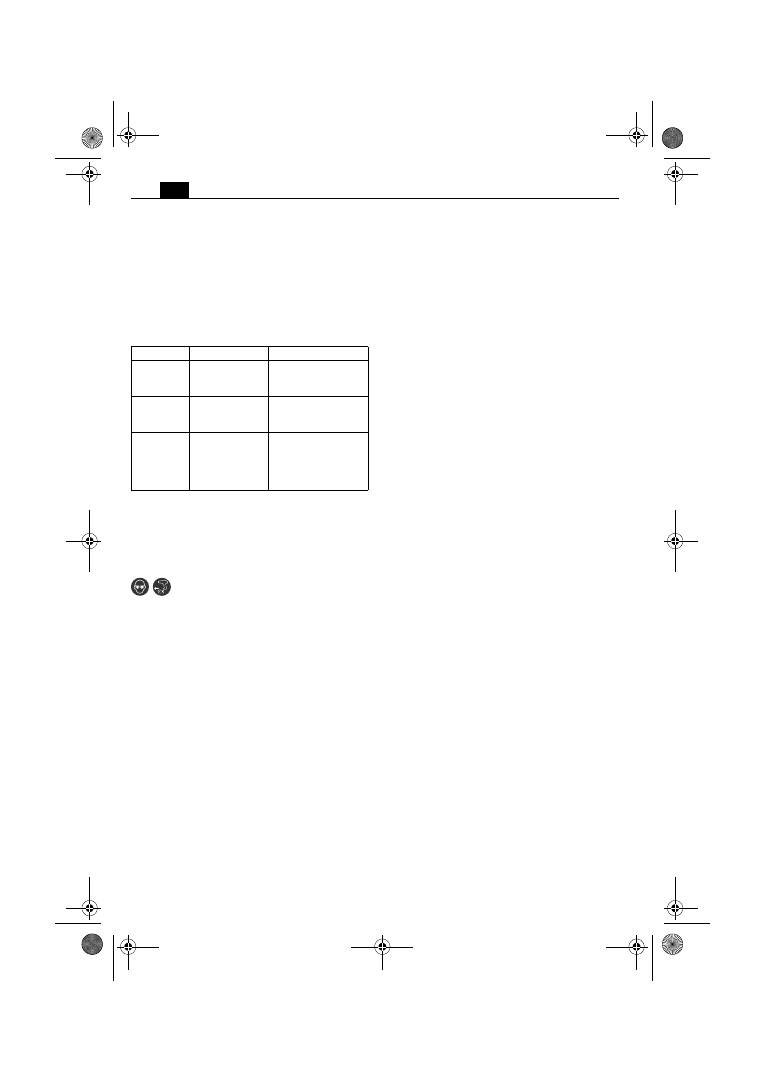
86
sl
Nastavitev vrtilnega momenta
Tovarniška nastavitev ustreza območju za majhne do
srednje velike vijake.
Pritezni moment je odvisen tudi od moči, s katero
pritisnete električno orodje na vijak.
Rokovanje z akumulatorsko baterijo.
Uporabljajte in polnite akumulatorsko baterijo izključno
v območju delovne temperature 0 °C – 45 °C (32 °F –
113 °F). Temperatura akumulatorske baterije se mora na
začetku polnilnega postopka nahajati v območju delovne
temperature.
Le ko je motor električnega orodja ustavljen, se bo
prikazal pravilni delež napolnjenosti akum. baterije v
odstodkih.
Ko se bliža globinska izpraznitev akumulatorske baterije,
elektronika avtomatsko ustavi motor.
Vzdrževanje in servis.
Pri ekstremnih pogojih uporabe se lahko
prevodni prah, ki nastane pri obdelavi kovin,
usede v notranjosti električnega orodja. Iz
notranjosti električnega orodja pogosto izpihavajte
prezračevalne zareze s suhim in neoljnatim stisnjenim
zrakom.
Aktualni seznam nadomestnih delov se nahaja na spletni
strani pod www.fein.com.
Naslednje dele lahko po potrebi samostojno zamenjajte:
vstavna orodja, akumulatorska baterija
Jamstvo in garancija.
Jamstvo za izdelek velja v skladu z zakonskimi pravili v
državi, kjer se je izdelek dal v promet. Poleg tega vam daje
FEIN garancijo v skladu z izjavo proizvajalca FEIN.
V obsegu dobave električnega orodja se lahko nahaja tudi
le del pribora, ki je opisan ali naslikan v tem navodilu za
obratovanje.
Izjava o skladnosti.
Podjetje FEIN izjavlja pod izključno odgovornostjo, da ta
izdelek ustreza navedenim zadevnim določilom, ki so
opisana na zadnji strani tega navodila za obratovanje.
Tehnična dokumentacija se nahaja pri:
C. & E. FEIN GmbH, C-DB_IA,
D-73529 Schwäbisch Gmünd
Varstvo okolja, odstranitev odpadkov.
Embalaže, odpadna električnega orodja in pribor morate
reciklirati v skladu z varstvom okolja.
Akumulatorske baterije smete samo v praznem stanju
odvreči med recikliran odpad.
Pri nepopolno izpraznjenih akumulatorskih baterijah
zaradi preprečevanja kratkega stika izolirajte povezovalni
vtič z lepilnim trakom.
LED-prikaz
Pomen
Akcija
1 – 4 zelena
LED
Stanje
napolnjenosti v
odstotkih
Delovanje
Rdeča trajna
luč
Akumulatorska
baterija je skoraj
prazna
Napolnite
akumulatorsko
baterijo
Rdeča
utripajoča
luč
Akumulatorska
baterija ni
pripravljeno za
uporabo
Akumulatorska
baterija se mora
nahajati v območju
delovne temperature,
nato jo napolnite
OBJ_BUCH-0000000105-001.book Page 86 Thursday, April 4, 2013 10:23 AM

87
sr
sr
Originalno uputstvo za rad.
Upotrebljeni simboli, skraćenice i pojmovi.
Simbol, znak
Objašnjenje
Rotirajuće delove električnog alata ne dodirivati.
Neizostavno čitajte priložena dokumenta kao uputstvo za rad i opšta sigurnosna
upozorenja.
Sledite uputstva u sledećem tekstu ili grafici!
Pre ovoga radnog zahvata ukloniti akumulator iz električnog alata. Inače postoji opasnost
od povredjivanja nenamernim kretanjem električnog alata.
Pri radu koristite zaštitu za oči.
Pri radu koristite zaštitu za sluh.
U radu koristite zaštitu za ruku.
Ne punite oštećene akumulatore.
Ne izlažite akumulator vatri. Zaštitite akumulator od toplote, na primer i od trajnog
sunčevog zračenja.
Obratite pažnju na uputstva u sledećem tekstu!
Dodatna informacija.
Podruèje zahvata
Potvrdjuje usaglašenost električnog alata sa smernicama Evropske Zajednice.
Ovaj simbol potvrdjuje certifikat ovoga proizvoda u SAD i Kanadi.
Ovo upozorenje pokazuje moguću opasnu situaciju, koja može uticati na najozbiljnije
povrede ili smrt.
Recycling-Znak: označava materijale koji se mogu reciklirati
Prikazane električne alate i druge elektrotehničke i električne proizvode sakupljajte
odvojeno i odvozite na reciklažu koja odgovara zaštiti čovekove okoline.
Tip akumulatora
1. brzina/2. brzina
Presek bušenja u čeliku
Presek bušenja u drvetu
Presek bušenja u kamenu
Zatezno područje stezne glave
Presek zavrtanja
Težina prema EPTA-Procedure 01/2003
Bez broja obrtaja
Veliki broj obrtaja
Fe
OBJ_BUCH-0000000105-001.book Page 87 Thursday, April 4, 2013 10:23 AM
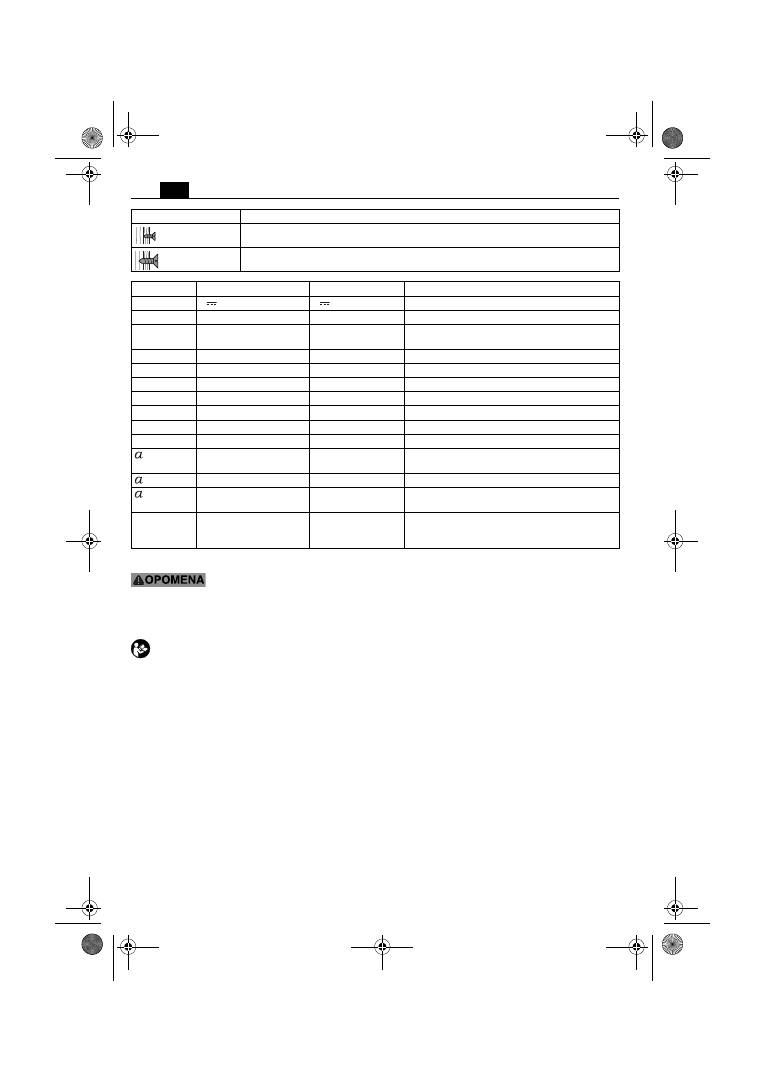
88
sr
Za Vašu sigurnost.
Čitajte sva sigurnosna upozorenja i
uputstva.
Propusti kod održavanja
sigurnosnih upozorenja i uputstava mogu prouzrokovati
električni udar, požar i/ili teške povrede.
Čuvajte sva sigurnosna upozorenja i uputstva za
budućnost.
Ne upotrebljavajte ovaj električni alat, pre nego što
temeljno ne pročitate i potpuno razumete ovo
uputstvo za rad kao i priložena „Opšta sigurnosna
upozorenja“ (broj spisa 3 41 30 054 06 1). Čuvajte
navedenu dokumentaciju za kasniju upotrebu i predajte
je kod nekog otudjenja ili davanja električnog alata.
Pazite isto tako na važeće nacionalne propise o zaštiti na
radu.
Odredjivanje električnog alata:
ABS14, ABS18:
Ručno vodjeni uvrtač za bušenje, uvrtanje i odvrtanje
zavrtanja i navrtki i za bušenje i uvrtanje zavrtanja u
metalu, drvetu, plastici i keramici kao i sečenje navoja u
okruženju zaštićenom od uticaja vremenskih uslova, bez
dotoka vode uz upotrebu alata i pribora koje je
preporučio FEIN.
ASB14, ASB18:
Ručno vodjeni uvrtač za bušenje sa udarcima za uvrtanje
i odvrtanje zavrtanja i navrtki i za bušenje i uvrtanje
zavrtanja u metalu, drvetu, plastici i keramici kao i sečenje
navoja i bušenje sa udarcima u betonu, kamenu i opeci u
okruženju zaštićenom od uticaja vremenskih uslova,
bez dotoka vode uz upotrebu alata i pribora koje je
preporučio FEIN.
Specijalna sigurnosna upozorenja.
Držite uredjaj za izolovane hvataljke, ako izvodite radove, pri
kojima zavrtanj može sresti skrivene vodove struje.
Kontakt
sa vodom koji može provoditi struju može staviti pod
napon i metalne delove uredjaja i uticati na električni udar.
Pazite na skrivene postavljene električne vodove,
gasovode i vodovodne cevi.
Konrolišite pre početka rada
radno područje na primer sa nekim uredjajem za potragu
metala.
Nosite ličnu zaštitnu opremu. Upotrebljavajte zavisno od
namene potpunu zaštitu za lice, zaštitu za oči ili zaštitne
naočare. Ako odgovara, nosite masku za prašinu, zaštitu
za sluh, zaštitne rukavice ili specijalnu kecelju, koja male
čestice od brušenja i materijal drže na odstojanju od Vas.
Oči treba da budu zaštićene od stranih tela koja bi letela
okolo, koja nastaju pri različitim radovima. Maska za
prašinu ili disanje mora filtrirati prašinu koja nastaje
prilikom rada. Ako ste izloženi dugo glasnoj buci, možete
izgubiti i sluh.
Nosite zaštitu za sluh pri bušenju sa udarcima.
Uticaj
buke može uticati na gubitak sluha.
Obezbedite radni komad.
Radni komad koji drži neki
zatezni uredjaj se sigurnije drži nego sa Vašom rukom.
Dobro i čvrsto držite električni alat.
Mogu na kratko
nastupiti veliki reakcioni momenti.
Smanjivanje obrtnog momenta
Povećavanje obrtnog momenta
Znak
Jedinica internacionalna
Jedinica nacionalna
Objašnjenje
U
V
V
Električni jednosmerni napon
f
Hz
Hz
Frekvencija
n
0
/min, min
-1
, rpm, r/min
/min
Broj obrtaja u praznom hodu (kod potpuno
napunjenog akumulatora)
n
S
/min, min
-1
/min
Broj udaraca
M...
Nm
Nm
Obrtni momenat (tvrdji/mekši slučaj zavrtnja)
Ø
mm
mm
Presek nekog okruglog dela
L
pA
dB
dB
Nivo zvučnog pritiska
L
wA
dB
dB
Brzi nivo snage
L
pCpeak
dB
dB
Vršni nivo zvučnog pritiska
K...
Nesigurnost
m/s
2
m/s
2
Emisiona vrednost vibracija je prema EN 60745
(Zbir vektora tri pravca)
h,D
m/s
2
m/s
2
Srednja vrednost vibracija za bušenje u metalu
h,ID
m/s
2
m/s
2
Srednja vrednost vibracija za bušenje sa udarcima
u betonu
m, s, kg, A, mm, V,
W, Hz, N, °C, dB,
min, m/s
2
m, s, kg, A, mm, V,
W, Hz, N, °C, dB,
min, m/s
2
Bazne i izvedene jedinice iz internacionalnog
sistema jedinica
SI
.
Simbol, znak
Objašnjenje
OBJ_BUCH-0000000105-001.book Page 88 Thursday, April 4, 2013 10:23 AM
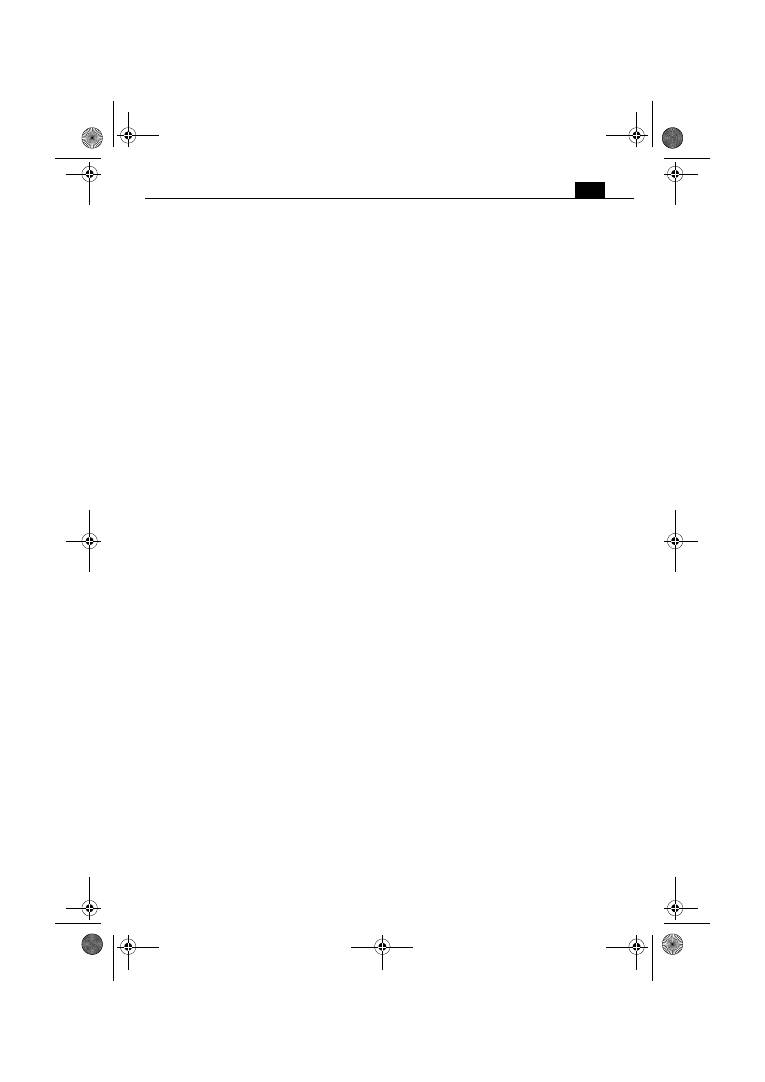
89
sr
Ne obradjujte nikakav materijal koji sadrži azbest.
Azbest
važi kao izazivač raka.
Zabranjeno je zavrtati tablice i znake na električni alat ili
ih nitovati.
Oštećena izolacija ne pruža neku zaštitu
protiv električnog udara. Upotrebljavajte lepljive tablice.
Ne upotrebljavajte neki pribor koji nije specijalno
proizveden od proizvodjača električnog alata ili odobren.
Siguran rad nije samo zbog toga, što neki pribor odgovara
Vašem električnom alatu.
Čistite redovno otvore za provetravanje električnog alata
sa nemetalnim alatima.
Motorna duvaljka vuče vazduh u
kućište. Ovo može kod prekomernog sakupljanja
metalne prašine prouzrokovati električnu opasnost.
Ne gledajte nikada sa malih rastojanja u svetlo lampe
električnog alata. Ne upravljajte svetlo lampe nikada na
oči drugih osoba, koje se nalaze u blizini.
Zračenje koje
proizvodi svetlosno sredstvo može biti štetno za oko.
Ne upravljajte električni alat na sebe samog, druge osobe
ili životinje.
Postoji opasnost od povrede usled oštrih ili
vrelih upotrebljenih alata.
Upotreba i rad sa akumulatorom
(akumulatorski blok).
Da bi izbegli opasnosti kao što su opekotine, požar,
eksploziju, povrede kože i druge povrede pri ophodjenju
sa akumulatorom, obratite pažnju na sledeća uputstva:
Akumulatori se ne smeju rastavljati, otvarati ili smanjivati.
Ne izlažite akumulatore mehaničkim udarima.
Pri
oštećenju i nestručnoj upotrebi akumulatora mogu izlaziti
štetna isparenja i tečnosti. Isparenja mogu nadraživati
disajne puteve. Tečnost akumulatora koja izlazi može
uticati na nadražaje kože ili opekotine na koži.
U slučaju da iz oštećenog akumulatora izadje tečnost i
ovlaži ivične predmete, prekontrolišite odgovarajuće
delove, očistitre ih ili ih u datom slučaju zamenite.
Ne izlažite akumulator toploti ili vatri. Ne čuvajte
akumulator na sunčevom svetlu.
Izvadite akumulator tek onda iz njegovog originalnog
pakovanja, kada treba da se koristi.
Izvadite akumulator pre rada na električnom alatu iz
električnog alata.
Ako električni alat krene slučajno,
postoji opasnost od povreda.
Izvadite akumulator samo pri isključenom električnom
alatu.
Držite akumulatore što dalje od dece.
Držite akumulator čist i zaštićen od vlage i vode.
Čistite
zaprljane priključke akumulatora i električnog alata sa
nekom suvom, čistom krpom.
Upotrebljavajte samo neoštećene originalne FEIN-
akumulatore, koji su odredjeni za Vaš električni alat.
Pri
radu sa i punjenju pogrešnih, oštećenih, popravljanih ili
doradjenih akumulatora, imitacija i stranih fabrikata
postoji opasnost od požara i/ili opasnost od eksplozije.
Sledite sigurnosne savete u uputstvu za rad uredjaja za
punjenje akumulatora.
Vibracije ruke i šake
Nivo vibracija naveden u ovim upozorenjima je izmeren
prema jednom mernom postupku koji je standardizovan
u EN 60745 i može se upotrebiti za poredjenje
električnih alata jedan sa drugim. Pogodno je i za
privremenu procenu opterećenja vibracijama.
Navedeni nivo vibracija predstavlja glavne primene
električnog alata. Ako se svakako električni alat
upotrebljava za druge namene, sa upotrebljenim alatima
koji odstupaju ili nedovoljnim održavanjem, može nivo
vibracija odstupati. Ovo može opterećenje vibracijama
značajno povećati preko celog radnog vremena.
Za neku tačnu procenu opterećenja vibracijama trebalo bi
uzeti u obzir i vreme, u kojem je uredjaj isključen, ili
doduše radi, medjutim nije stvarno u upotrebi. Ovo
može značajno redukovati opterećenje vibracijama preko
celog radnog vremena.
Utvrdite dodatne sigurnosne mere za zaštitu radnika pre
delovanja vibracija kao na primer: Održavanje električnih
alata i alata za upotrebu, održavajte ruke tople,
organizacija radnog postupka.
Ophodjenje sa opasnom prašinom
Kod rada sa skidanjem materijala sa ovim alatom nastaju
prašine, koje mogu biti opasne.
Dodir ili udisanje nekih prašina na primer azbesta i
materijala koji sadrže azbest, prezama koji sadrže olovo,
metala, nekih vrsta drveta, minerala, čestica silikata
materijala koji sadrže kamen, rastvarača za boju, sredstava
za zaštitu drveta, sredstava za upotrebu vodenih vozila
može izazvati kod osoba alergijske reakcije i/ili obolenja
disajnih puteva, rak, oštećenja rasplodjavanja. Rizik usled
udisanja prašine zavisi od ekspozicije. Koristite jedno
usisivanje koje odgovara nastaloj prašini kao i ličnu
zaštitnu opremu i pobrinite se za dobro provetravanje
radnog mesta. Prepustite rad sa azbestnim materijalom
samo stručnjacima.
Drvenu prašinu i prašinu lakih metala, vreme mešavine
brušene prašine i hemijskih materijala mogu pod
nepovoljnim uslovima podleći samopaljenju ili
prouzrokovati eksploziju. Izbegavajte varničenje u pravcu
rezervoara sa prašinom kao i pregrevanje električnog
alata i materijala koji se brusi, praznite na vreme rezervar
za prašinu, pazite na uputstva za preradu proizvodjača
materijala kao i na propise koji važe u Vašoj zemlji za
materijale koje treba preradjivati.
Uputstva za rad.
Aktivirajte preklopnik za pravac obrtaja i prekidač za
biranje brzine samo u stanju mirovanja motora.
Gurnite prekidač za biranje brzine odn. okrenite prekidač
za biranje vrste rada (ASB14/18) uvek do graničnika.
Električni alat se može inače oštetiti.
Kod preopterećenja isključuje se električni alat.
Dovedite preklopnik smera okretanja u srednju poziciju
da bi izbegli slučajno puštanje u rad, na primer pri
transportu.
Podešavanje obrtnog momenta
Podešavanje u fabrici odgovara području za manje
zavrtnje i do zavrtanja srednje veličine.
Zatezni momenat zavisi od sile, sa kojom se pritiska
električni alat na zavrtanj.
OBJ_BUCH-0000000105-001.book Page 89 Thursday, April 4, 2013 10:23 AM
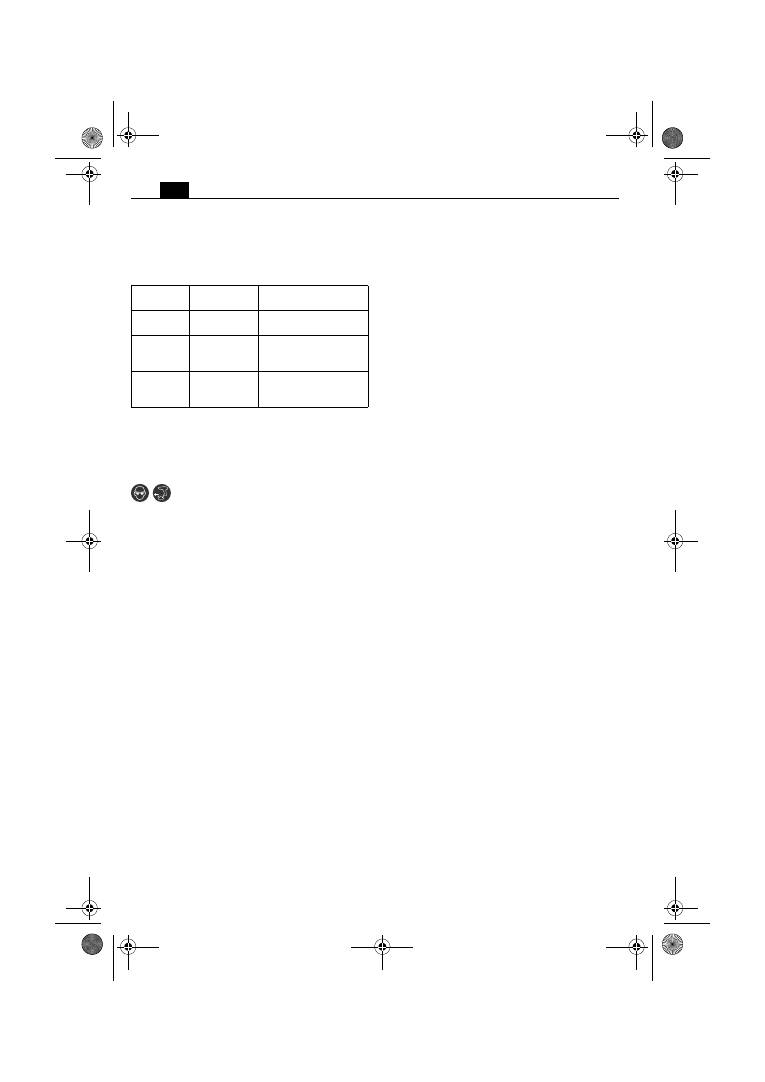
90
sr
Ophodjenje sa akumulatorom.
Radite sa akumulatorom i punite ga samo u radnom
temperaturnom području akumulatora od 0 °C – 45 °C
(32 °F – 113 °F). Temperatura akumulatora mora na
početku radnje punjenja biti u radnom temperaturnom
području akumulatora.
Pravo procentualno stanje punjenja akumulatora prikazuje
se samo pri zaustavljenom motoru električnog alata.
Kod predstojećeg dubokog pražnjenja akumulatora
elektronika automatski zaustavlja motor.
Održavanje i servis.
Kod ekstremnih uslova korišćenja može se pri
obradi metala nataložiti lagana prašina u
unutrašnjosti električnog alata. Izduvavajte
često unutrašnjost električnog alata kroz proreze za
ventilaciju sa suvim i komprimovanim vazduhom bez
pritiska.
Aktuelna lista rezervnih delova ovoga električnog alata
naći ćete na Internetu pod www.fein.com.
Sledeće delove možete pri potrebi sami zameniti:
alati za umetanje, akumulator
Jemstvo i garancija.
Garancija na proizvod važi prema zakonskim
regulativama u zemlji gde se pušta u rad. Pored toga daje
FEIN garanciju prema FEIN garantnoj izjavi proizvodjača.
U obimu isporuke Vašeg električnog alata može biti čak
samo jedan deo pribora koji je opisan u uputstvu za rad
ili koji je prikazan na slikama.
Izjava o usaglašenosti.
Firma FEIN izjavljuje na vlastitu odgovornost, da ovaj
proizvod odgovara važećim propisima koji su navedeni
na poslednjoj stranici ovoga uputstva za rad.
Tehnička dokumentacija kod: C. & E. FEIN GmbH,
C-DB_IA, D-73529 Schwäbisch Gmünd
Zaštita čovekove okoline, uklanjanje
djubreta.
Pakovanja, sortirani električni alati i pribor odvozite
nekoj reciklaži koja odgovara zaštiti čovekove okoline.
Odvozite akumulatore samo u ispražnjenom stanju nekoj
propisanoj reciklaži.
Kod nepotpuno ispražnjenih akumulatora da bi se
obezbedili od kratkih spojeva izolirajtre utičnice sa
lepljivom trakom.
LED-
pokazivač
Značenje
Akcija
1 – 4 zeleni
LED
procentualno
stanje punjenja
Rad
cveno
trajno
svetlo
Akumulator je
skoro prazan
Napuniti akumulator
crveno
trepćuće
svetlo
Akumulator
nije spreman
za rad
Dovesti akumulator u
radno temperaturno
područje, potom puniti
OBJ_BUCH-0000000105-001.book Page 90 Thursday, April 4, 2013 10:23 AM
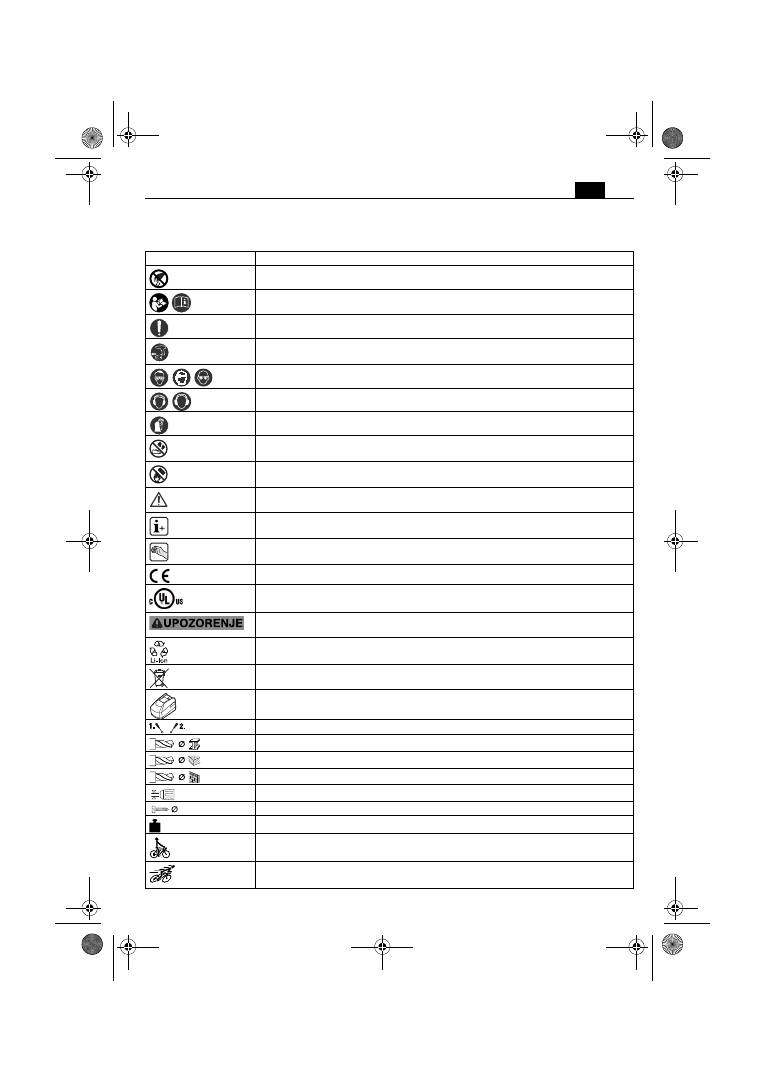
91
hr
hr
Originalne upute za rad.
Korišteni simboli, kratice i pojmovi.
Simbol, znak
Objašnjenje
Ne dodirivati rotirajuće dijelove električnog alata.
Neizostavno treba pročitati priložene dokumente, kao što su upute za rukovanje i opće
napomene za sigurnost.
Treba se pridržavati uputa u tekstu ili na slikama!
Prije ove radne operacije aku-bateriju treba izvaditi iz električnog alata. Inače postoji
opasnost od ozljeda zbog nehotičnog pokretanja električnog alata.
Kod rada treba nositi zaštitne naočale.
Kod rada treba nositi štitnik za sluh.
Pri radovima treba koristiti zaštitne rukavice.
Ne punite oštećenu aku-bateriju.
Aku-bateriju ne bacajte u vatre. Aku-bateriju zaštitite od djelovanja topline, npr. i od
stalnog Sunčevog zračenja.
Treba se pridržavati uputa u tekstu!
Dodatna informacija.
Površina zahvata
Potvrđuje usklađenost električnog alata sa smjernicama Europske unije.
Ovim se simbolom potvrđuje certifikacija ovih proizvoda u SAD i Kanadi.
Ove upute pokazuju moguće opasne situacije koje mogu dovesti do ozbiljnih ozljeda ili
do smrtnog slučaja.
Znak reciklaže: označava materijale koji se mogu reciklirati
Neuporabive električne alate i ostale elektrotehničke i električne proizvode treba
odvojeno sakupiti i dovesti na ekološki prihvatljivo recikliranje.
Tip aku-baterije
1. brzina/2. brzina
Promjer bušenja čelika
Promjer bušenja drva
Promjer bušenja kamena
Područje stezanja stezne glave
Promjer vijaka
Težina prema EPTA postupku 01/2003
Mali broj okretaja
Veliki broj okretaja
Fe
OBJ_BUCH-0000000105-001.book Page 91 Thursday, April 4, 2013 10:23 AM
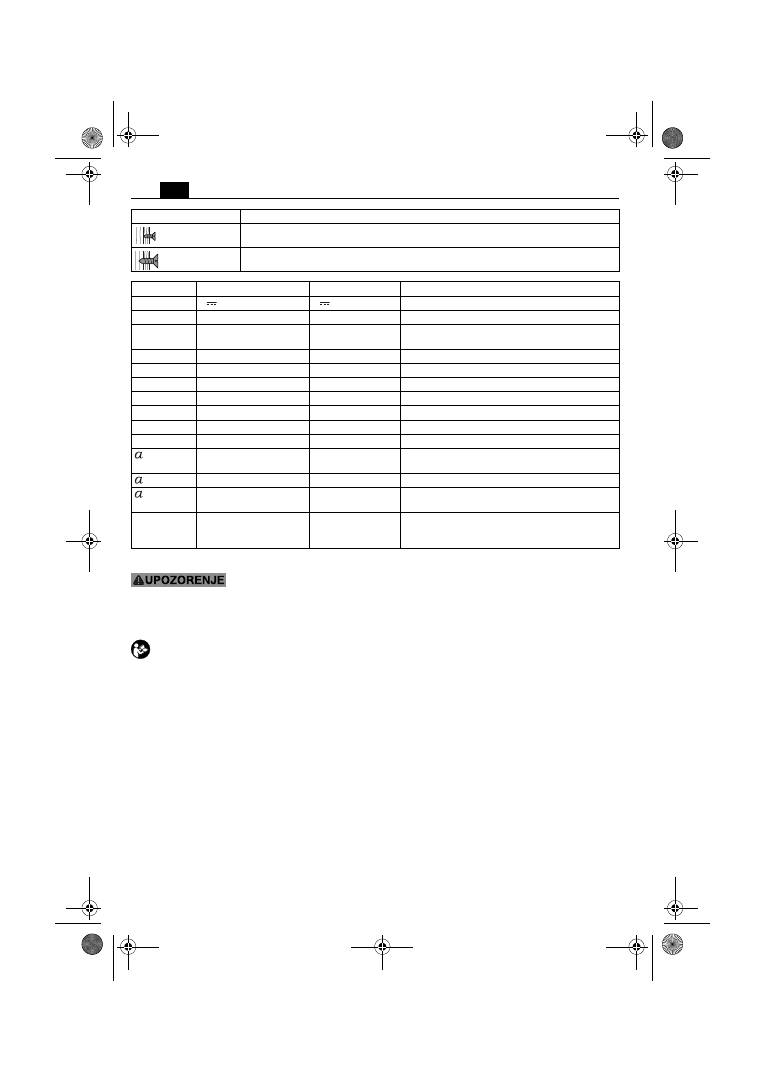
92
hr
Za vašu sigurnost.
Pročitajte sve upute za sigurnost
i upute za uporabu.
Propusti kod
poštivanja napomena za sigurnost i uputa mogu
prouzročiti strujni udar, požar i/ili teške ozljede.
Sve napomene za sigurnost i upute spremite za buduću
uporabu.
Ovaj električni alat ne koristite prije nego što ste
temeljito pročitali i razumjeli ove upute za
rukovanje kao i priložene „Opće napomene za
sigurnost“ (br. tiska. 3 41 30 054 06 1). Spomenutu
dokumentaciju spremite za kasniju uporabu i predajte je
novom vlasniku kod predaje ili prodaje električnog alata.
Također, pridržavajte se važećih nacionalnih propisa
zaštite pri radu.
Definicija električnog alata:
ABS14, ABS18:
Ručna bušilica i odvijač za uvijanje i odvijanje vijaka i
matica i za bušenje i uvijanje vijaka u metal, drvo, plastiku
i keramiku, kao i za rezanje navoja, s radnim alatima i
priborom odobrenim od FEIN, bez dovoda vode i u
radnoj okolini zaštićenoj od vremenskih utjecaja.
ASB14, ASB18:
Ručna udarna bušilica i odvijač za uvijanje i odvijanje
vijaka i matica i za bušenje i uvijanje vijaka u metal, drvo,
plastiku i keramiku, kao i za rezanje navoja i udarno
bušenje u beton, kamen i opeku, s radnim alatima i
priborom odobrenim od FEIN, bez dovoda vode i u
radnoj okolini zaštićenoj od vremenskih utjecaja.
Posebne napomene za sigurnost.
Kada radite na mjestima gdje bi vijak mogao oštetiti
skrivene električne kablove, električni alat držite na
izoliranim površinama zahvata.
Kontakt sa vodom pod
naponom može i metalne dijelove uređaja staviti pod
napon i dovesti do strujnog udara.
Pazite na skrivene električne kablove, plinske i
vodovodne cijevi.
Prije početka rada kontrolirajte radno
područje, npr. sa uređajem za lociranje metala.
Nosite osobnu zaštitnu opremu. Ovisno od primjene
koristite masku za zaštitu lica i zaštitne naočale. Ukoliko
je to potrebno, nosite masku za zaštitu od prašine,
štitnike za sluh, zaštitne rukavice ili specijalne pregače,
koje će vas zaštititi od sitnih čestica od brušenja i
materijala.
Oči treba zaštiti od letećih stranih tijela koja
nastaju kod različitih primjena. Zaštitne maske protiv
prašine ili za disanje moraju profiltrirati prašinu nastalu
kod primjene. Ako ste dulje vrijeme izloženi buci, mogao
bi vam se pogoršati sluh.
Kod udarnog bušenja nosite štitnike za sluh.
Djelovanje
buke može oštetiti slušne organe.
Osigurajte izradak.
Izradak koji se drži sa steznom
napravom sigurnije se drži nego sa rukom.
Električni alat držite čvrsto.
Kratkotrajno se mogu
pojaviti visoki momenti reakcije.
Ne obrađujte materijal koji sadrži azbest.
Azbest se
smatra kancerogenim.
Smanjenje okretnog momenta
Povećanje okretnog momenta
Znak
Međunarodna jedinica
Nacionalna jedinica Objašnjenje
U
V
V
Električni istosmjerni napon
f
Hz
Hz
Frekvencija
n
0
/min, min
-1
, rpm, r/min
/min
Broj okretaja pri praznom hodu (kod potpuno
napunjene aku-baterije)
n
S
/min, min
-1
/min
Broj udaraca
M...
Nm
Nm
Okretni moment (tvrđeg/mekšeg slučaja uvijanja)
Ø
mm
mm
Promjer okruglog dijela
L
pA
dB
dB
Razina zvučnog tlaka
L
wA
dB
dB
Razina učinka buke
L
pCpeak
dB
dB
Razina max. zvučnog tlaka
K...
Nesigurnost
m/s
2
m/s
2
Vrijednost emisija vibracija prema EN 60745
(vektorski zbroj u tri smjera)
h,D
m/s
2
m/s
2
Srednja vrijednost vibracija za bušenje metala
h,ID
m/s
2
m/s
2
Srednja vrijednost vibracija za udarno bušenje
betona
m, s, kg, A, mm, V,
W, Hz, N, °C, dB,
min, m/s
2
m, s, kg, A, mm, V,
W, Hz, N, °C, dB,
min, m/s
2
Osnovne i izvedene jedinice iz Međunarodnog
sustava jedinica
SI
.
Simbol, znak
Objašnjenje
OBJ_BUCH-0000000105-001.book Page 92 Thursday, April 4, 2013 10:23 AM
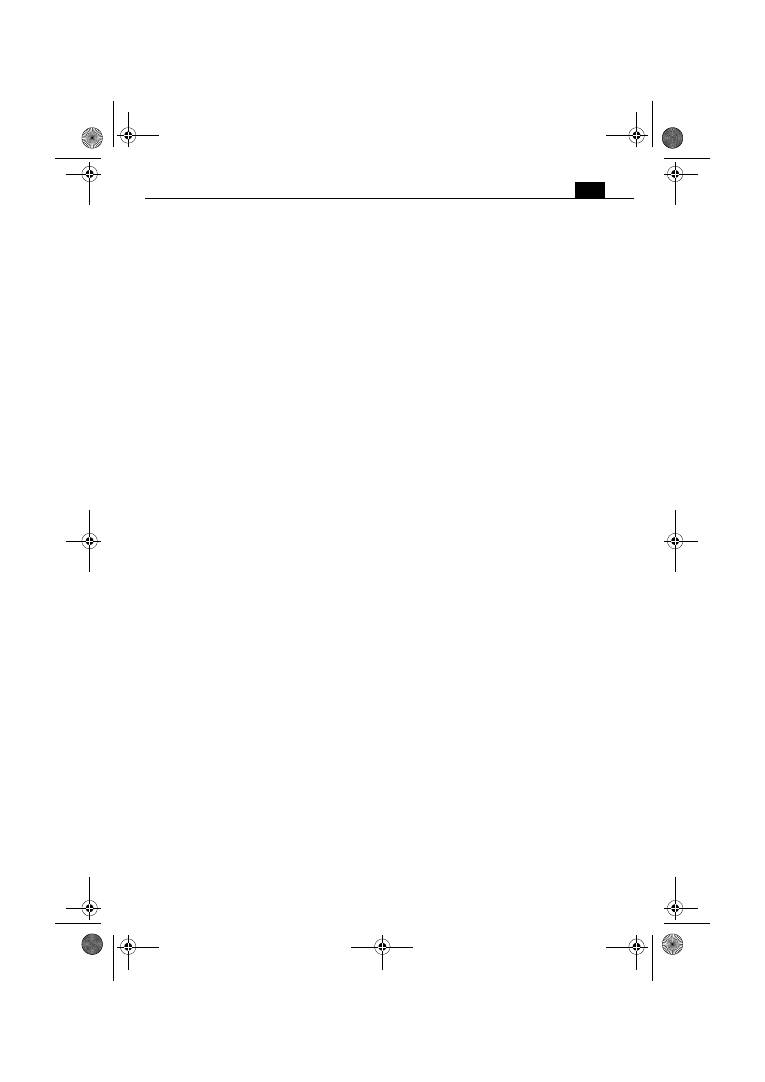
93
hr
Zabranjeno je natpise i znakove pričvršćivati na električni
alat vijcima ili zakovicama.
Oštećena izolacija ne pruža
nikakvu zaštitu od strujnog udara. U tu svrhu koristite
naljepnice.
Ne koristite pribor koji nije proizveo ili odobrio proizvođač
električnog alata.
Siguran rad se ne postiže samo ako
pribor odgovara vašem električnom alatu.
Redovito čistite otvore za hlađenje električnog alata sa
nemetalnim alatima.
Ventilator motora uvlači prašinu u
kućište. To kod prekomjernog nakupljanja metalne
prašine može dovesti do električnog ugrožavanja.
Nikada iz manje udaljenosti ne gledajte u svjetlo
svjetiljke električnog alata. Svjetlo svjetiljke nikada ne
usmjeravajte u oči drugih osoba koje se nalaze u blizini.
Nastale svjetlosne zrake mogle bi oštetiti oči.
Električni alat ne usmjeravajte prema sebi, drugim
osobama ili životinjama.
Postoji opasnost od ozljeda na
oštrim ili zagrijanim radnim alatima.
Primjena i tretman aku-baterija (aku-blokova).
Kako bi se izbjegle opasnosti, kao što su opekline, požar,
eksplozija, ozljede kože i ostale ozljede kod rukovanja sa
aku-baterijom, treba se pridržavati slijedećih napomena:
Aku-baterije se ne smiju rastavljati, otvarati ili drobiti.
Aku-baterije ne izlažite mehaničkim udarima.
Kod
oštećenja i nestručne uporabe aku-baterije, iz nje mogu
izaći štetne pare i tekućine. Pare mogu nadražiti dišne
putove. Istekla tekućina iz aku-baterije može dovesti do
nadražaja kože ili opeklina.
Ako bi tekućina istekla iz oštećene aku-baterije nakvasila
okolne predmete, nakon toga kontrolirajte takove
dijelove, očistite ih ili prema potrebi zamijenite.
Aku-bateriju ne izlažite djelovanju topline ili vatre. Aku-
bateriju ne spremajte na mjestima izloženim izravnom
djelovanju Sunčevih zraka.
Aku-bateriju izvadite iz originalne ambalaže tek kada
ćete je koristiti.
Aku-bateriju prije radova na električnom alatu izvadite iz
električnog alata.
Ako bi se električni alat nehotično
pokrenuo, postoji opasnost od ozljeda.
Aku-bateriju izvadite samo kod isključenog električnog
alata.
Aku bateriju držite dalje od dosega djece.
Aku-bateriju održavajte u čistom stanju i zaštitite je od
vlage i vode.
Zaprljane priključke aku-baterije i
električnog alata očistite sa suhom čistom krpom.
Koristite samo ispravne, originalne FEIN aku-baterije
predviđene za vaš električni alat.
Kod radova i punjenja
pogrešnih, oštećenih, popravljanih ili prerađenih aku-
baterija, imitacija i proizvoda drugih proizvođača, postoji
opasnost od požara i/ili eksplozije.
Pridržavajte se uputa za sigurnost u uputama za uporabu
punjača aku-baterija.
Vibracije ruke i šake
Prag vibracija naveden u ovim uputama izmjeren je
postupkom mjerenja propisanom u EN 60745 i može se
primijeniti za međusobnu usporedbu električnih alata.
Prikladan je i za privremenu procjenu opterećenja od
vibracija.
Navedeni prag vibracija predstavlja glavne primjene
električnog alata. Ako se ustvari električni alat koristi za
druge primjene sa radnim alatima koji odstupaju od
navedenih ili se nedovoljno održavaju, prag vibracija
može odstupati. Na taj se način može osjetno povećati
opterećenje od vibracija tijekom čitavog vremenskog
perioda rada.
Za točnu procjenu opterećenja od vibracija trebaju se
uzeti u obzir i vremena u kojima je uređaj isključen, ili
doduše radi ali stvarno nije u primjeni. Na taj se način
može osjetno smanjiti opterećenje od vibracija tijekom
čitavog vremenskog perioda rada.
Prije djelovanja vibracija utvrdite dodatne mjere
sigurnosti za zaštitu korisnika, kao npr.: održavanje
električnog alata i radnih alata, kao i organiziranje radnih
operacija.
Manipuliranje sa opasnom prašinom
Kod materijala na kojima kod rezanja sa ovim alatom
nastaje prašina koja može biti opasna.
Dodirivanje ili udisanje nekih vrsta prašine, npr. od
azbesta i materijala sa sadržajem azbesta, premaza sa
sadržajem olova, metala, nekih vrsta drva, minerala,
čestica silikata od materijala sa sadržajem kamena,
razrjeđivača boje, zaštitnih sredstava za drvo, Antifouling
za vodene alate, kod nekih osoba može prouzročiti
alergijske reakcije i/ili oboljenja dišnih organa, rak,
reproduktivne poteškoće. Opasnost od udisanja prašine
ovisi od izlaganja prašini. Koristite usisavanje prilagođeno
nastaloj prašini, kao i osobna zaštitna sredstva i osigurajte
dobro provjetravanje radnog mjesta. Obradu materijala
sa sadržajem azbesta prepustite samo stručnim osobama.
Drvena prašina i prašina od lakih metala, zagrijane prašine
od brušenja i kemijskih tvari, pod nepovoljnim uvjetima
mogu se same zapaliti i prouzročiti eksploziju.
Izbjegavajte iskrenje u smjeru spremnika sa prašinom, kao
i pregrijavanje električnog alata i izratka, pravovremeno
ispraznite spremnik za prašinu, pridržavajte se uputa za
obradu od proizvođača materijala, kao i propisa za
obradu materijala u vašoj zemlji.
Upute za rukovanje.
Preklopku smjera rotacije i birač za biranje brzine
pritisnite samo u stanju mirovanja elektromotora.
Prekidač za biranje brzine uvijek pomaknite do
graničnika, odnosno prekidač za biranje načina rada
(ASB14/18) uvijek okrenite do graničnika. Električni alat
bi se inače mogao oštetiti.
U slučaju preopterećenja električni alat će se isključiti.
Kako bi se izbjeglo nehotično puštanje u rad, npr. pri
transportu, preklopku smjera rotacije prebacite u srednji
položaj.
Namještanje okretnog momenta
Tvorničko namještanje odgovara području za manje do
srednje velike vijke.
Moment pritezanja također je ovisan od sile kojom se
električni alat pritišće na vijak.
OBJ_BUCH-0000000105-001.book Page 93 Thursday, April 4, 2013 10:23 AM
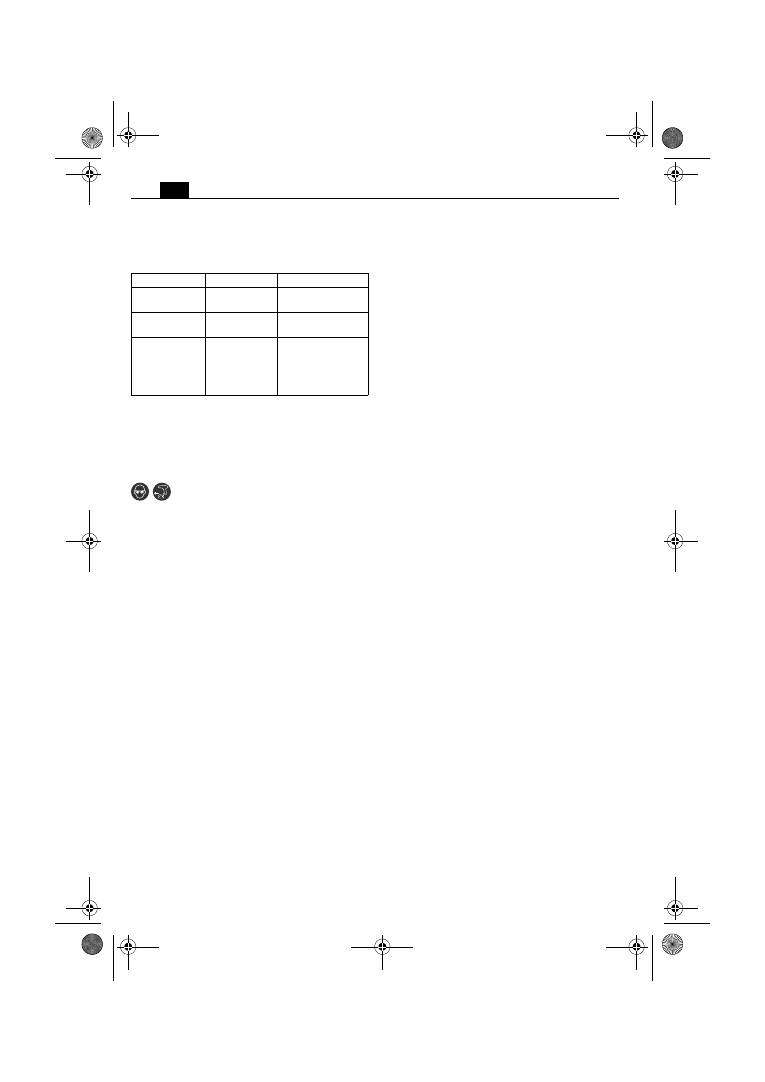
94
hr
Rukovanje sa aku-baterijom.
Aku-bateriju koristite i punite samo u području radnih
temperatura aku-baterije od 0 °C – 45 °C (32 °F – 113 °F).
Temperatura aku-baterije na početku procesa punjenja
mora biti u području radnih temperatura aku-baterije.
Ispravno procentualno stanje napunjenosti aku-baterije
pokazat će se samo u stanju isključenog elektromotora
električnog alata.
Ako bi se prethodno aku-baterija dubinski ispraznila,
elektronika će automatski zaustaviti motor.
Održavanje i servisiranje.
Kod ekstremnih uvjeta primjene kod obrade
metala, u unutrašnjosti električnog alata može
se nakupiti električno vodljiva prašina. Sa
suhim komprimiranim zrakom i bez sadržaja ulja često
ispuhujte unutrašnjost električnog alata kroz otvore za
hlađenje.
Najnoviji popis rezervnih dijelova ovog električnog alata
možete naći na internetu, na adresi www.fein.com.
Sljedeće dijelove možete prema potrebi sami zamijeniti:
radni alati, aku-baterija
Jamstvo.
Jamstvo za proizvod vrijedi prema zakonskim propisima
u zemlji korisnika električnog alata. Tvrtka FEIN daje
jamstvo prema FEIN izjavi proizvođača o jamstvu.
U opsegu isporuke vašeg električnog alata može biti
sadržan i samo jedan dio pribora opisanog ili prikazanog
u ovim uputama za rukovanje.
Izjava o usklađenosti.
Tvrtka FEIN izjavljuje uz punu odgovornost da ovaj
proizvod prikazan na zadnjoj stranici ovih uputa za
rukovanje odgovara navedenim važećim propisima.
Tehnička dokumentacija se može zatražiti od:
C. & E. FEIN GmbH, C-DB_IA,
D-73529 Schwäbisch Gmünd
Zaštita okoliša, zbrinjavanje u otpad.
Ambalažu, neuporabive električne alate i pribor treba
dovesti na ekološki prihvatljivo recikliranje.
Aku-bateriju zbrinuti u otpad samo u ispražnjenom
stanju.
Za slučaj nepotpuno ispražnjenih aku-baterija, kao mjeru
zaštite od kratkih spojeva, utičnu spojnicu izolirajte sa
ljepljivim trakama.
LED-pokazivač
Značenje
Aktivnost
1 – 4 zelena
LED
postotak
napunjenosti
Rad
crveno stalno
svjetlo
Aku-baterija je
gotovo prazna
Punjenje baterije
crveno
treperavo
svjetlo
Aku-baterija
nije spremna za
rad
Aku-bateriju
dovesti u područje
radnih temperatura
aku-baterije i nakon
toga je napuniti
OBJ_BUCH-0000000105-001.book Page 94 Thursday, April 4, 2013 10:23 AM
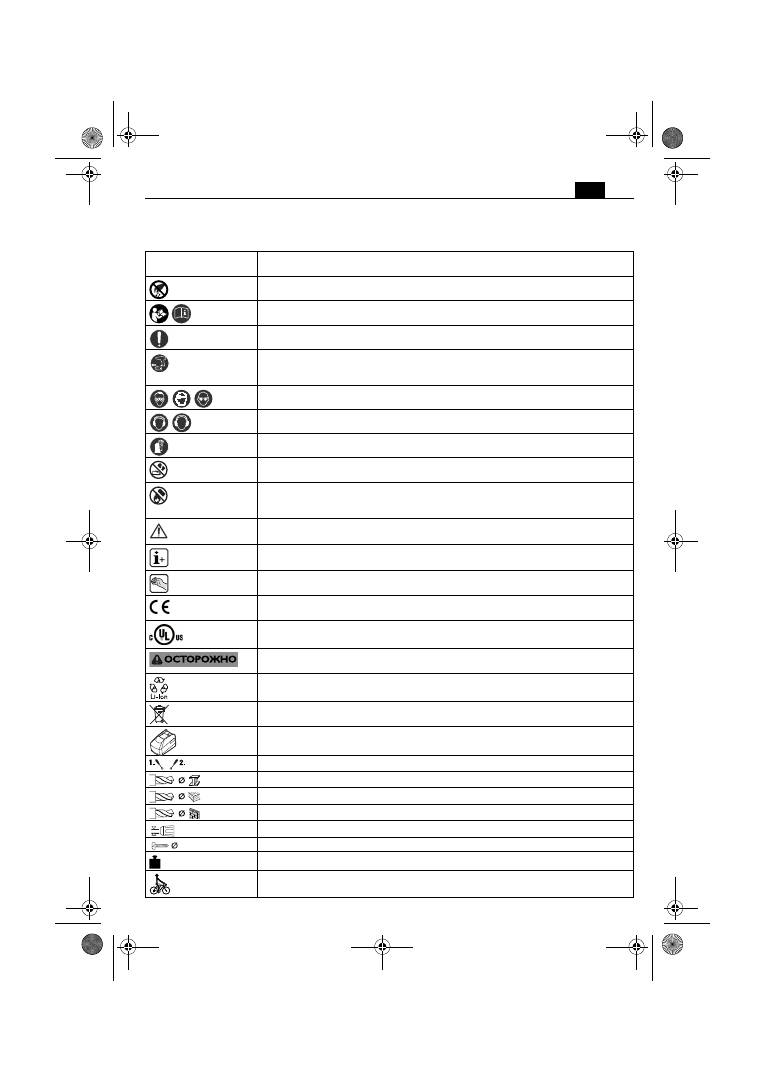
95
ru
ru
Оригинальное руководство по эксплуатации.
Использованные условные обозначения, сокращения и понятия.
Символическое изобра-
жение, условный знак
Пояснение
Не прикасайтесь к вращающимся частям.
Обязательно прочтите прилагаемые документы, такие как руководство по
эксплуатации и общие инструкции по безопасности.
Соблюдайте указания, содержащиеся в тексте и на рисунке рядом!
Перед выполнением этой операции выньте аккумулятор из электроинструмента.
В противном случае возможно получение травм при непреднамеренном
включении электроинструмента.
При работе использовать средства защиты глаз.
При работе использовать средства защиты органов слуха.
Защищайте при работе руки.
Не заряжайте поврежденные аккумуляторные батареи.
Не подвергайте аккумуляторную батарею воздействию огня. Защищайте
аккумуляторную батарею от высоких температур, напр., от длительного
нагревания на солнце.
Соблюдайте приведенные рядом указания!
Дополнительная информация.
Зона удержания
Подтверждает соответствие электроинструмента директивам Европейского
Сообщества.
Этот символ подтверждает сертификацию этого продукта в США и Канаде.
Это указание предупреждает о возможной опасной ситуации, которая может
привести к серьезным травмам или смерти.
Знак вторичной переработки: обозначает пригодные для повторного
использования материалы
Отработавшие свой ресурс электрические изделия следует собирать и сдавать
отдельно на экологически чистую переработку.
Тип аккумулятора
1-ая ступень редуктора/2-ая ступень редуктора
Диаметр сверления в стали
Диаметр сверления в древесине
Диаметр отверстия в камне
Диапазон зажима сверлильного патрона
Диаметр шурупа
Вес согласно EPTA-Procedure 01/2003
Низкое число оборотов
Fe
OBJ_BUCH-0000000105-001.book Page 95 Thursday, April 4, 2013 10:23 AM
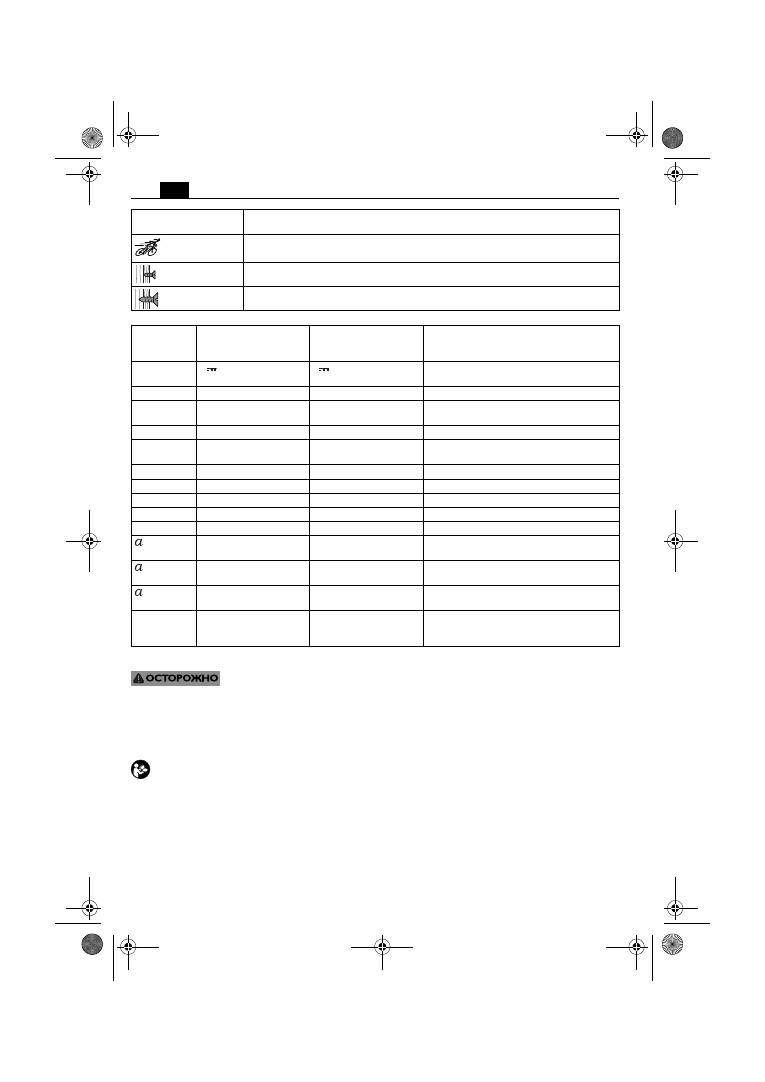
96
ru
Для Вашей безопасности.
Прочтите все указания и
инструкции по технике
безопасности.
Упущения, допущенные при
соблюдении указаний и инструкций по технике
безопасности, могут стать причиной поражения
электрическим током, пожара и тяжелых травм.
Сохраняйте эти инструкции и указания для будущего
использования.
Не применяйте настоящий
электроинструмент, предварительно не изучив
основательно и полностью не усвоив это
руководство по эксплуатации, а также приложенные
«Общие указания по технике безопасности» (номер
публикации 3 41 30 054 06 1). Сохраняйте
названные документы для дальнейшего
использования и приложите их к
электроинструменту при его передаче другому лицу
или при его продаже.
Учитывайте также соответствующие национальные
правила по охране труда.
Назначение электроинструмента:
ABS14, ABS18:
Ручная дрель-шуруповерт для закручивания и
выкручивания винтов и гаек, сверления и
закручивания/выкручивания винтов в металле,
древесине, пластмассе и керамике, а также для
нарезания резьбы, для использования в закрытых
помещениях с допущенными фирмой FEIN рабочими
инструментами и принадлежностями без подвода
воды.
ASB14, ASB18:
Ручная ударная дрель-шуруповерт для закручивания
и выкручивания винтов и гаек, сверления и
закручивания/выкручивания винтов в металле,
древесине, пластмассе и керамике, а также для
нарезания резьбы и ударного сверления в бетоне,
кирпиче и камне для использования в закрытых
помещениях с допущенными фирмой FEIN рабочими
инструментами и принадлежностями без подвода
воды.
Высокое число оборотов
Уменьшение величины крутящего момента
Увеличение величины крутящего момента
Условный
знак
Eдиница измерения,
международное
обозначение
Eдиница измерения,
русское обозначение
Пояснение
U
V
В
Электрическое напряжение постоянного
тока
f
Hz
Гц
Частота питающей сети
n
0
/min, min
-1
, rpm, r/min
/мин
Число оборотов на холостом ходу (при
полностью заряженном аккумуляторе)
n
S
/min, min
-1
/мин
Частота ударов
M...
Nm
Нм
Крутящий момент (завинчивание в
твердые/мягкие материалы)
Ø
mm
мм
Диаметр круглой части
L
pA
dB
дБ
Уровень звукового давления
L
wA
dB
дБ
Уровень звуковой мощности
L
pCpeak
dB
дБ
Макс. уровень звукового давления
K...
Погрешность
m/s
2
м/с
2
Вибрация в соответствии с EN 60745
(векторная сумма трех направлений)
h,D
m/s
2
м/с
2
Среднее значение взвешенного
ускорения при сверлении металла
h,ID
m/s
2
м/с
2
Среднее значение взвешенного
ускорения при ударном сверлении бетона
m, s, kg, A, mm, V,
W, Hz, N, °C, dB,
min, m/s
2
м, с, кг, A, мм, В,
Вт, Гц, Н, °C, дБ,
мин, м/с
2
Основные и производные единицы
измерения Международной системы
единиц
СИ
.
Символическое изобра-
жение, условный знак
Пояснение
OBJ_BUCH-0000000105-001.book Page 96 Thursday, April 4, 2013 10:23 AM
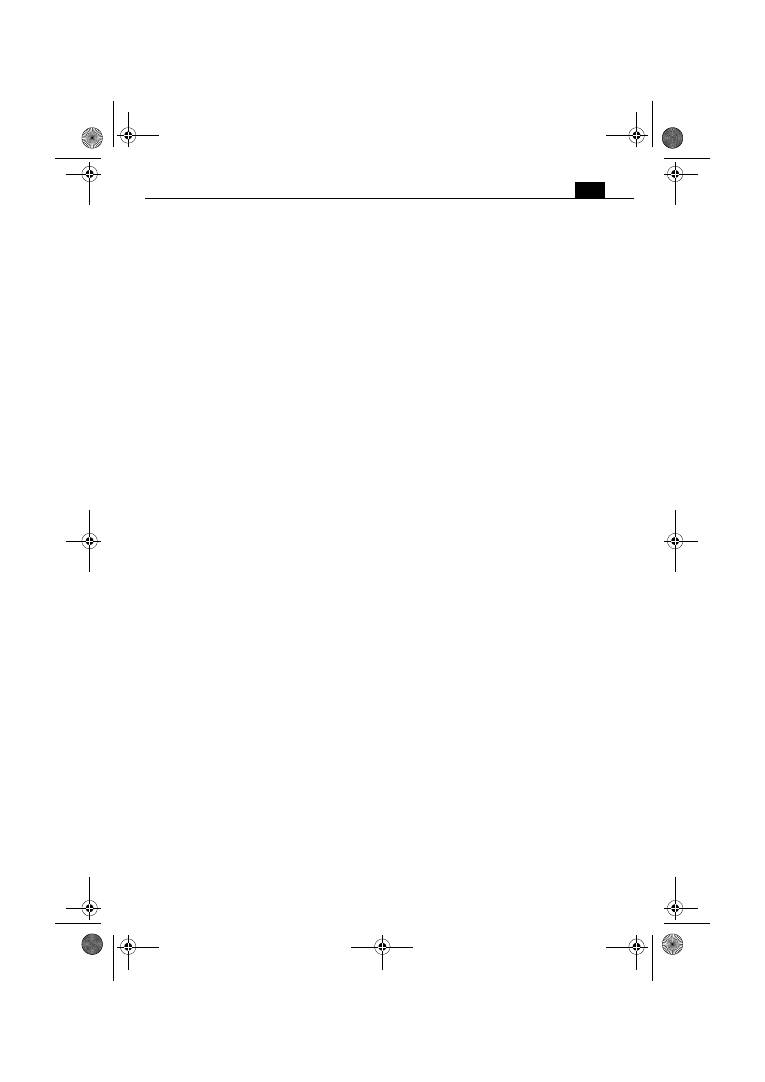
97
ru
Специальные указания по технике
безопасности.
При выполнении работ, при которых шуруп может
задеть скрытую электропроводку, держите
электроинструмент за изолированные ручки.
Контакт
с находящейся под напряжением проводкой может
привести к поражению электрическим током.
Следите за скрытой электрической проводкой,
газопроводом и водопроводом.
До начала работы
проверить рабочий участок, например,
металлоискателем.
Применяйте средства индивидуальной защиты. В
зависимости от выполняемой работы применяйте
защитный щиток для лица, защитное средство для
глаз или защитные очки. Насколько уместно, при-
меняйте противопылевой респиратор, средства
защиты органов слуха, защитные перчатки или
специальный фартук, которые защищают Вас от
абразивных частиц и частиц материала.
Глаза
должны быть защищены от летающих в воздухе
посторонних частиц, которые могут образовываться
при выполнении различных работ. Противопылевой
респиратор или защитная маска органов дыхания
должны задерживать образующуюся при работе
пыль. Продолжительное воздействие сильного
шума может привести к потере слуха.
При ударном сверлении одевайте наушники.
Шум
может повредить слух.
Закрепляйте обрабатываемую деталь.
Закрепленная,
например, в тисках деталь удерживается надежнее,
чем в Вашей руке.
Крепко держите электроинструмент в руках.
Не
исключено возникновение отдачи.
Не обрабатывайте материалы с содержанием асбеста.
Aсбест является возбудителем рака.
Запрещается закреплять на электроинструменте
таблички и обозначения с помощью винтов и
заклепок.
Поврежденная изоляция не защищает от
поражения электрическим током. Применять
приклеиваемые таблички.
Не применяйте принадлежности, которые не были
специально сконструированы изготовителем
электроинструмента или на применение которых нет
разрешения изготовителя.
Безопасная эксплуатация
не обеспечивается только тем, что принадлежности
подходят к Вашему электроинструменту.
Регулярно очищайте вентиляционные отверстия
электроинструмента неметаллическим инструментом.
Вентилятор двигателя затягивает пыль в корпус.
Чрезмерное скопление металлической пыли может
стать причиной поражения электрическим током.
Никогда не смотрите с небольшого расстояния на свет
лампы электроинструмента. Никогда не направляйте
свет лампы в глаза других людей, которые находятся
вблизи Вас.
Исходящее от лампы излучение может
повредить глаза.
Не направляйте электроинструмент на себя, других
лиц и животных.
Это чревато травмами от острых
или горячих режущих или шлифовальных
инструментов.
Использование и обращение с аккумуляторами
(аккумуляторными блоками).
В целях исключения при обращении с
аккумуляторами таких опасностей, как получение
ожогов, возгорание, взрыв, повреждение кожи и
получение других травм, соблюдайте следующие
указания:
Аккумуляторы нельзя разбирать, открывать или
раскалывать. Не подвергайте аккумуляторы
механическим ударам.
При повреждении
аккумулятора и ненадлежащем его использовании
возможно выделение паров и жидкостей. Вдыхание
паров может привести к раздражению дыхательных
путей. Вылившаяся аккумуляторная жидкость
способна вызвать кожные раздражения и ожоги.
Если вылившаяся из поврежденного аккумулятора
жидкость попадет на окружающие предметы и
детали, проверьте их, очистите и при необходимости
поменяйте.
Не подвергайте аккумуляторную батарею
воздействию тепла и огня. Не храните аккумуляторы
под прямыми солнечными лучами.
Вынимайте аккумуляторы из оригинальной упаковки
только лишь непосредственно перед их
использованием.
Перед выполнением любых манипуляций с
электроинструментом извлекайте из него
аккумуляторную батарею.
Самопроизвольное
включение электроинструмента чревато опасностью
травм.
Вынимайте аккумулятор только при выключенном
электроинструменте.
Не допускайте попадания аккумуляторов в руки
детей.
Содержите аккумуляторы в чистоте, защищайте их от
воздействия влаги и попадания на них воды.
Очищайте загрязненные контакты аккумулятора и
электроинструмента сухой, чистой тряпкой.
Используйте только исправные оригинальные
аккумуляторы фирмы FEIN, предназначенные для
данного электроинструмента.
При работе с
неподходящими, поврежденными,
отремонтированными или восстановленными
аккумуляторами, подделками или аккумуляторами
других производителей, а также при их зарядке
существует опасность возгорания и/или взрыва.
Соблюдайте указания по технике безопасности,
содержащиеся в руководстве по эксплуатации
зарядного устройства для аккумуляторов.
Вибрация, действующая на кисть-руку
Указанный в этих инструкциях уровень вибрации
определен в соответствии с методикой измерений,
предписанной EN 60745, и может использоваться
для сравнения электроинструментов. Он пригоден
также для предварительной оценки вибрационной
нагрузки.
OBJ_BUCH-0000000105-001.book Page 97 Thursday, April 4, 2013 10:23 AM
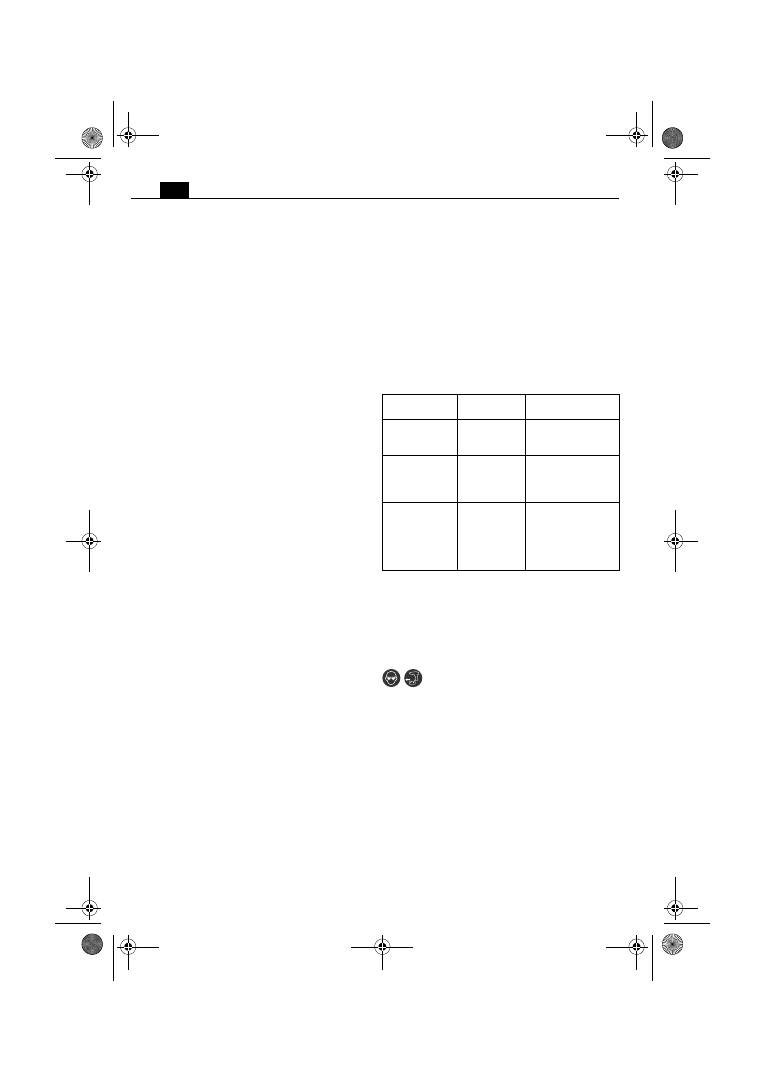
98
ru
Уровень вибрации указан для основных областей
применения электроинструмента. Он может
отличаться при использовании электроинструмента
для других применений, использовании иных
рабочих инструментов или недостаточном
техобслуживании. Следствием может явиться
значительное увеличение вибрационной нагрузки в
течение всей продолжительности работы.
Для точной оценки вибрационной нагрузки нужно
учитывать также и время, когда инструмент
выключен или, хоть и включен, но не находится в
работе. Это может снизить среднюю вибрационную
нагрузку в течение всей продолжительности
работы.
Предусмотрите дополнительные меры
предосторожности для защиты пользователя от
воздействия вибрации, как напр.: техобслуживание
электроинструмента и принадлежностей, теплые
руки, организация труда.
Обращение с опасной пылью
При работах со снятием материала с использованием
данного инструмента образуется пыль, которая
может представлять собой опасность.
Контакт с некоторыми видами пыли или вдыхание
некоторых видов пыли как, напр., асбеста и
асбестосодержащих материалов,
свинцовосодержащих лакокрасочных покрытий,
металлов, некоторых видов древесины, минералов,
каменных материалов с содержанием силикатов,
растворителей красок, средств защиты древесины,
средств защиты судов от обрастания, может
вызывать у людей аллергические реакции и/или
стать причиной заболеваний дыхательных путей,
рака, а также отрицательно сказаться на
репродуктивности. Степень риска при вдыхании
пыли зависит от экспозиционной дозы. Используйте
соответствующее данному виду пыли
пылеотсасывающее устройство и индивидуальные
средства защиты и хорошо проветривайте рабочее
место. Поручайте обработку содержащего асбест
материала только специалистам.
Древесная пыль и пыль легких металлов, горячие
смеси абразивной пыли и химических веществ могут
самовоспламеняться при неблагоприятных условиях
или стать причиной взрыва. Избегайте искрения в
сторону контейнера для пыли, перегрева
электроинструмента и шлифуемого материала,
своевременно опорожняйте контейнер для пыли,
соблюдайте указания производителя материала по
обработке, а также действующие в Вашей стране
указания для обрабатываемых материалов.
Указания по пользованию.
Приводите в действие переключатель направления
вращения и переключатель передач только при
остановленном двигателе.
Перемещайте переключатель
передач/поворачивайте переключатель режимов
работы (ASB14/18) всегда до упора. Иначе возможно
повреждение электроинструмента.
При перегрузке электроинструмент отключается.
Установите переключатель направления вращения в
среднее положение, чтобы избежать
непреднамеренного включения, напр., при
транспортировке.
Настройка крутящего момента
Заводская настройка рассчитана на небольшие и
средние шурупы.
Крутящий момент зависит также и от силы, с
которой электроинструмент прижимается к шурупу.
Обращение с аккумулятором.
Пользуйтесь аккумулятором и заряжайте его только
в диапазоне рабочей температуры аккумулятора
0 °C – 45 °C (32 °F – 113 °F). В начале процесса зарядки
температура аккумулятора должна находиться в
рабочем диапазоне.
Действительная степень зарядки аккумулятора в
процентах отображается только при остановленном
двигателе электроинструмента.
Прежде чем аккумулятор сможет достичь состояния
глубокой разрядки, электроника автоматически
выключает двигатель.
Техобслуживание и сервисная служба.
В экстремальных условиях работы при
обработке металлов внутри
электроинструмента может собираться
токопроводящая пыль. Регулярно продувайте
внутреннюю полость электроинструмента через
вентиляционные щели сухим и не содержащим
масла сжатым воздухом.
Актуальный список запчастей к этому
электроинструменту Вы найдете в Интернете по
адресу: www.fein.com.
При необходимости Вы можете самостоятельно
заменить следующие части:
сменную оснастку, аккумуляторную батарею
Светодиодный
индикатор
Значение
Действие
1 – 4 зеленых
светодиода
степень
зарядки в
процентах
Эксплуатация
красный
немигающий
световой
сигнал
Аккумулятор
почти
разряжен
Зарядите
аккумулятор
красный
мигающий
световой
сигнал
Аккумулятор
не готов к
работе
Подождите, пока
аккумулятор не
достигнет
диапазона рабочей
температуры, и
затем зарядите
OBJ_BUCH-0000000105-001.book Page 98 Thursday, April 4, 2013 10:23 AM
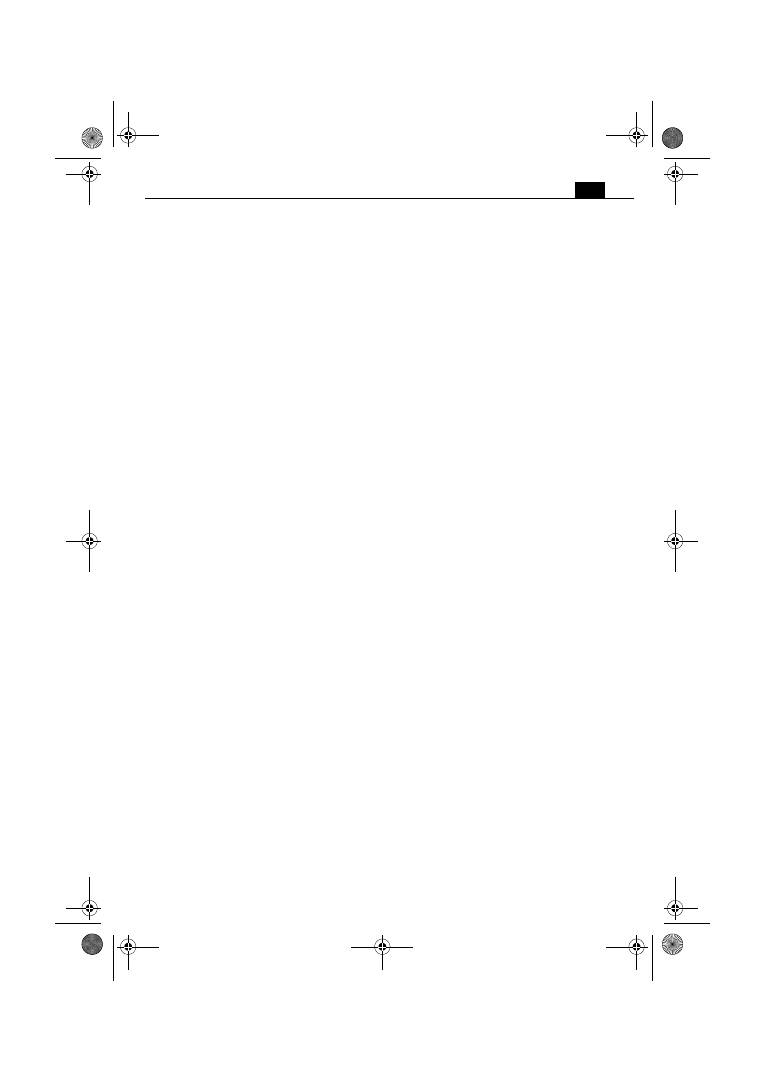
99
ru
Обязательная гарантия и
дополнительная гарантия
изготовителя.
Обязательная гарантия на изделие предоставляется
в соответствии с законоположениями в стране
пользователя. Сверх этого, FEIN предоставляет
дополнительную гарантию в соответствии с
гарантийным обязательством изготовителя FEIN.
Комплект поставки Вашего электроинструмента
может не включать весь набор описанных или
изображенных в этом руководстве по эксплуатации
принадлежностей.
Декларация соответствия.
С исключительной ответственностью фирма FEIN
заявляет, что настоящее изделие соответствует
нормативным документам, приведенным на
последней странице настоящего руководства по
эксплуатации.
Техническая документация: C. & E. FEIN GmbH,
C-DB_IA, D-73529 Schwäbisch Gmünd
Охрана окружающей среды,
утилизация.
Упаковку, пришедшие в негодность
электроинструменты и принадлежности следует
собирать для экологически чистой утилизации.
Сдавайте аккумуляторы на утилизацию только в
разряженном состоянии.
Для предотвращения коротких замыканий в
неполностью разряженных аккумуляторах
изолируйте штекерные соединения клейкой лентой.
OBJ_BUCH-0000000105-001.book Page 99 Thursday, April 4, 2013 10:23 AM
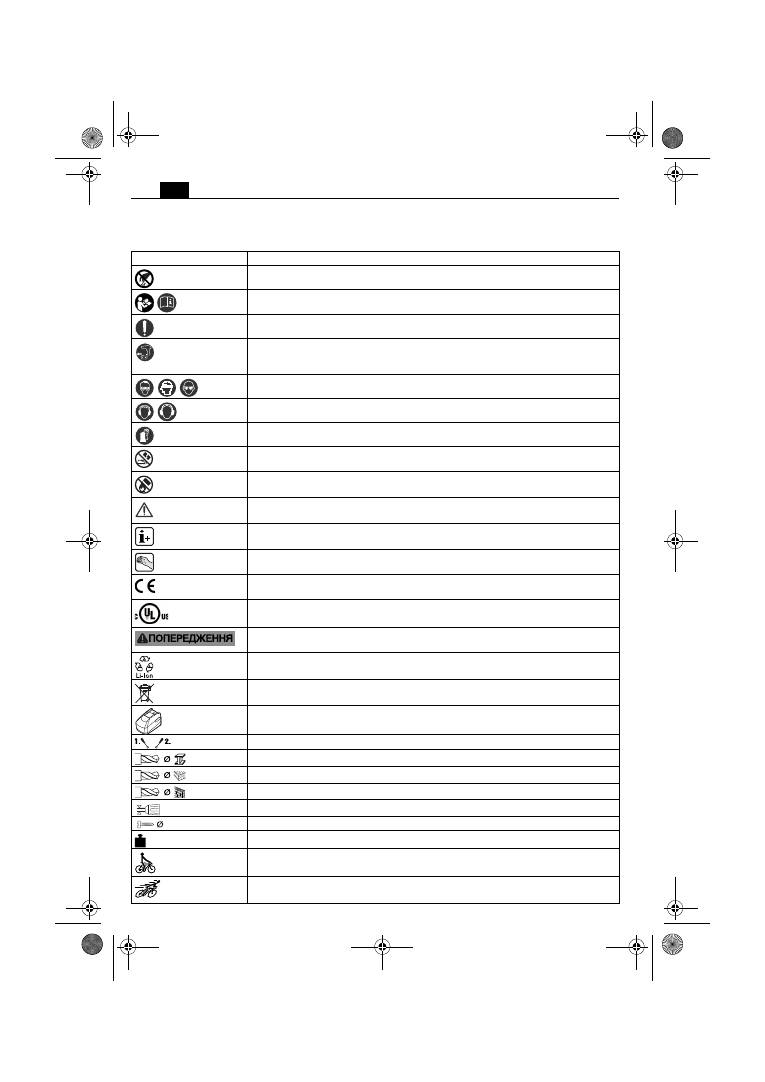
100
uk
uk
Оригінальна інструкція з експлуатації.
Використані символи, скорочення та поняття.
Символ, позначка
Пояснення
Не торкайтеся до деталей електроінструменту, що обертаються.
Обов’язково прочитайте додані документи, напр., інструкцію з експлуатації та
загальні вказівки з техніки безпеки.
Дотримуйтеся інструкцій, які містяться в тексті та на малюнку поруч!
Перед виконанням цієї робочої операції витягніть акумуляторну батарею із
електроінструменту. Інакше виникне небезпека поранення внаслідок
ненавмисного запуску електроінструменту.
Під час роботи одягайте захисні окуляри.
Під час роботи одягайте навушники.
Під час роботи захищайте руки.
Не заряджайте пошкоджені акумуляторні батареї.
Захищайте акумуляторну батарею від вогню. Захищайте акумуляторну батарею
від тепла, напр., від тривалого нагрівання на сонці.
Дотримуйтеся вказівок, що зазначені поруч!
Додаткова інформація.
Зона тримання
Підтвердження відповідності електроінструменту положенням директив
Європейського Співтовариства.
Цей символ підтверджує сертифікацію цього продукту в США і Канаді.
Ця вказівка повідомляє про можливість виникнення небезпечної ситуації, яка
може привести до серйозних травм або смерті.
Знак вторинної переробки: позначає матеріали, що придатні для повторного
використання
Відпрацьовані електроінструменти та інші електротехнічні і електронні вироби
повинні здаватися окремо і утилізуватися екологічно чистим способом.
Тип акумуляторної батареї
1-а передача/2-а передача
Діаметр свердління в сталі
Діаметр свердління в дереві
Діаметр свердління в камені
Діапазон затиску свердлильного патрона
Діаметр шурупа
Вага відповідно до EPTA-Procedure 01/2003
Мала кількість обертів
Велика кількість обертів
Fe
OBJ_BUCH-0000000105-001.book Page 100 Thursday, April 4, 2013 10:23 AM
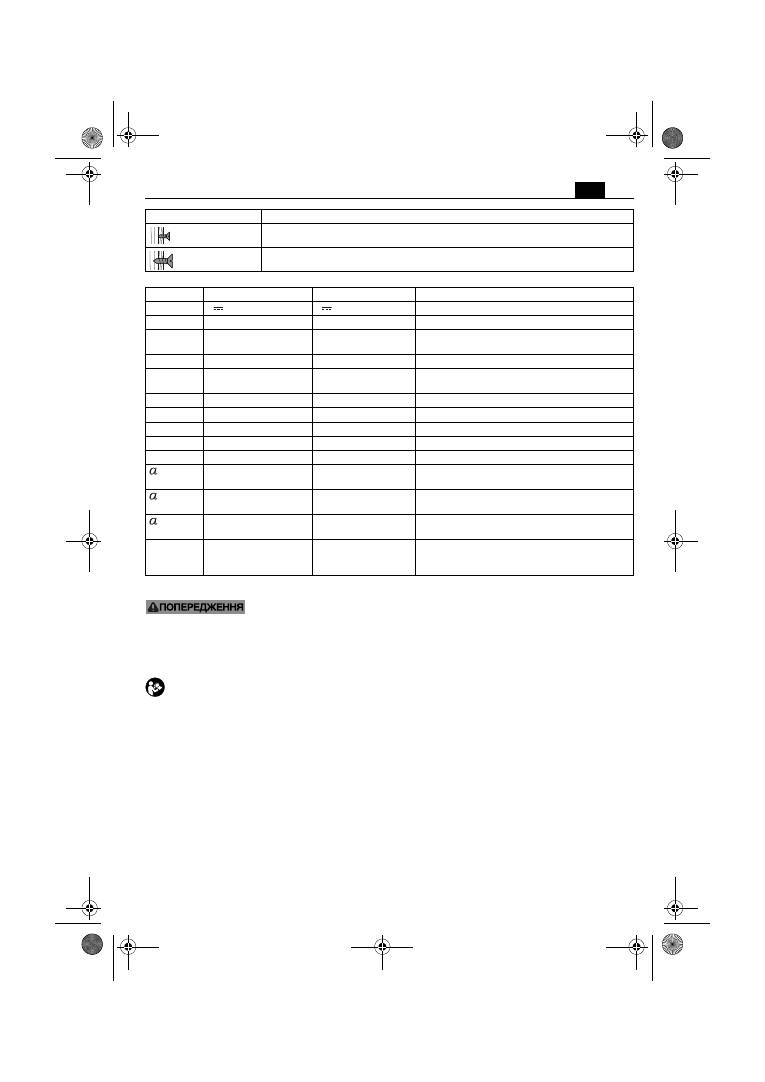
101
uk
Для Вашої безпеки.
Прочитайте всі правила з
техніки безпеки і вказівки.
Невиконання правил з техніки безпеки і вказівок
може призводити до удару електричним струмом,
пожежі та/або важких травм.
Зберігайте всі правила з техніки безпеки і вказівки на
майбутнє.
Не застосовуйте цей електроінструмент, не
прочитавши уважно та не зрозумівши дану
інструкцію з експлуатації та додані «Загальні
вказівки з техніки безпеки» (номер документа
3 41 30 054 06 1). Зберігайте названі документи для
подальшого використання та додавайте їх до
електроінструменту при його передачі в
користування або при продажу.
Зважайте також на чинні національні приписи з
охорони праці.
Призначення електроінструменту:
ABS14, ABS18:
Ручний дриль-шуруповерт для закручування та
відкручування гвинтів/шурупів і гайок, свердлення і
закручування гвинтів в металі, деревині, пластмасі і
кераміці, а також для нарізання різьби в закритих
приміщеннях без подачі води з допущеними фірмою
FEIN робочими інструментами та приладдям.
ASB14, ASB18:
Ручний ударний дриль-шуруповерт для
закручування та відкручування гвинтів/шурупів і
гайок, для свердлення і закручування гвинтів в
металі, деревині, пластмасі і кераміці, а також для
нарізання різьби і ударного свердлення в бетоні,
камені і цеглі в закритих приміщеннях без подачі
води з допущеними фірмою FEIN робочими
інструментами та приладдям.
Специфічні вказівки з техніки безпеки.
При роботах, коли гвинт може зачепити заховану
електропроводку, тримайте електроінструмент за
ізольовані рукоятки.
Зачеплення проводки, що
знаходиться під напругою, може заряджувати також
і металеві частини електроінструмента та
призводити до ураження електричним струмом.
Звертайте увагу на приховану електропроводку,
газопроводи та водопроводи.
Перед початком
роботи перевірте зону роботи, напр., за допомогою
металошукача.
Вдягайте особисте захисне спорядження. В
залежності від виду робіт використовуйте захисну
маску, захист для очей або захисні окуляри. За
необхідністю вдягайте респіратор, навушники,
захисні рукавиці або спеціальний фартух, щоб
захистити себе від невеличких частинок, що утворю-
ються під час шліфування, та частинок матеріалу.
Зменшення обертального моменту
Збільшення обертального моменту
Позначка
Міжнародна одиниця
Національна одиниця Пояснення
U
V
В
Електрична напруга постійного струму
f
Hz
Гц
Частота
n
0
/min, min
-1
, rpm, r/min
/хвил.
Швидкість обертів на холостому ході (при
повністю зарядженій акумуляторній батареї )
n
S
/min, min
-1
/хвил.
Кількість ударів
M...
Nm
Нм
Обертальний момент (закручування в
тверді/м’які матеріали)
Ø
mm
мм
Діаметр круглої частини
L
pA
dB
дБ
Рівень звукового тиску
L
wA
dB
дБ
Рівень звукової потужності
L
pCpeak
dB
дБ
Піковий рівень звукового тиску
K...
Похибка
m/s
2
м/с
2
Вібрація у відповідності до EN 60745
(сума векторів трьох напрямків)
h,D
m/s
2
м/с
2
Середнє значення зваженого прискорення при
свердлінні в металі
h,ID
m/s
2
м/с
2
Середнє значення зваженого прискорення при
ударному свердлінні в бетоні
m, s, kg, A, mm, V,
W, Hz, N, °C, dB,
min, m/s
2
м, с, кг, A, мм, В,
Вт, Гц, Н, °C, дБ,
хвил., м/с
2
Основні та похідні одиниці Міжнародної
системи одиниць
SI
.
Символ, позначка
Пояснення
OBJ_BUCH-0000000105-001.book Page 101 Thursday, April 4, 2013 10:23 AM
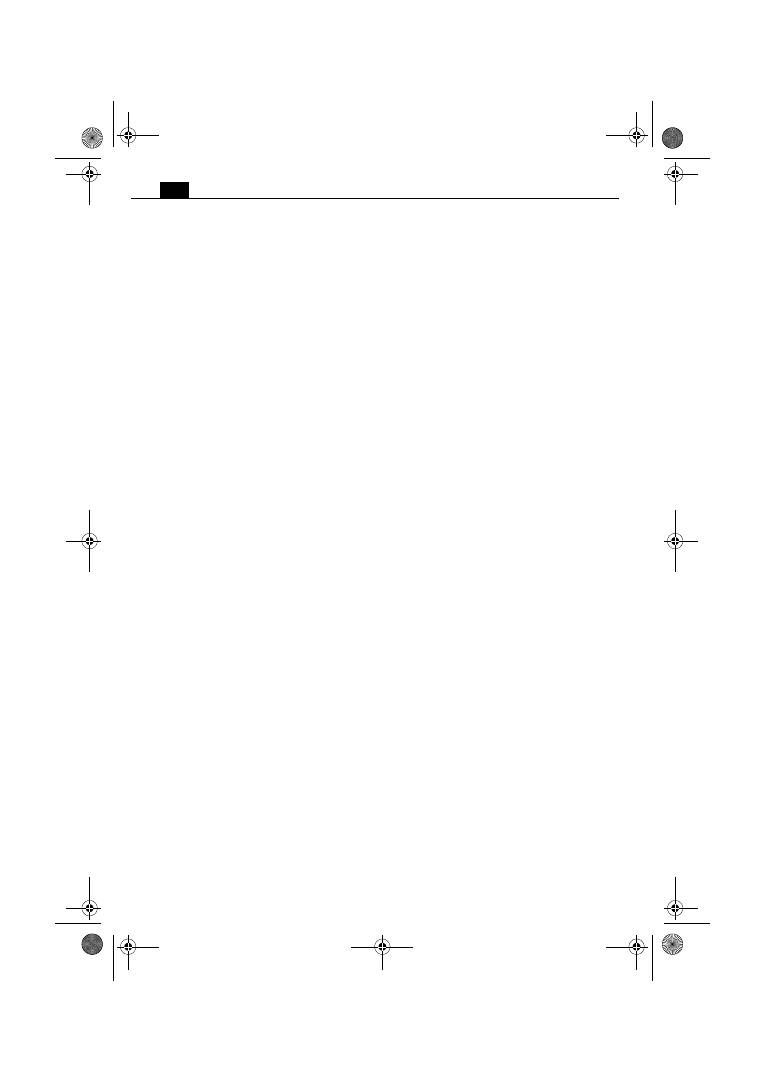
102
uk
Очі повинні бути захищені від відлетілих
чужорідних тіл, що утворюються при різних видах
робіт. Респіратор або маска повинні
відфільтровувати пил, що утворюється під час
роботи. При тривалій роботі при гучному шумі
можна втратити слух.
При ударному свердленні вдягайте навушники.
Шум
може пошкодити слух.
Фіксуйте оброблювану деталь.
Закріплена в
затискному пристрої деталь утримується надійніше,
ніж у Вашій руці.
Добре тримайте електроінструмент.
Можливі короткі,
але сильні реакційні моменти.
Не обробляйте матеріали, що містять азбест.
Азбест
вважається канцерогенним.
Забороняється закріплювати на електроінструменті
таблички та позначки за допомогою гвинтів або
заклепок.
Пошкоджена ізоляція не захищає від
ураження електричним струмом. Таблички треба
приклеювати.
Не використовуйте приладдя, яке не було
сконструйоване виробником електроінструменту саме
для даного електроінструменту або на застосування
якого немає дозволу виробника.
Сама лише можливість
закріплення приладдя на Вашому електроінструменті
не є гарантією його безпечної експлуатації.
Регулярно очищайте вентиляційні щілини
електроінструменту неметалевими інструментами.
Вентилятор двигуна затягує пил в корпус. Сильне
накопичення металевого пилу може призвести до
електричної небезпеки.
Ніколи не дивіться на світло лампи
електроінструменту з невеликої відстані. Ніколи не
направляйте світло лампи в очі інших осіб, що
знаходяться коло Вас.
Випромінювання від лампи
може пошкодити очі.
Не направляйте електроінструмент на себе, інших осіб
або тварин.
Це несе в собі небезпеку поранення
гострими або гарячими робочими інструментами.
Використання та поводження з акумуляторними
батареями (акумуляторними блоками).
Для уникнення небезпек, таких, напр., як опіків, пожеж,
вибухів, пошкоджень шкіряного покриву та інших травм,
що можуть виникнути при використанні акумуляторних
батарей, дотримуйтеся наступних вказівок:
Не розбирайте, не відкривайте і не розколюйте
акумуляторні батареї. Не піддавайте акумуляторні
батареї впливу механічних ударів.
При пошкодженні
або неправильній експлуатації акумуляторних
батарей може виходити шкідливий пар або рідина.
Пар може подразнювати дихальні шляхи. Витекла
рідина з акумуляторної батареї може викликати
подразнення шкіри або хімічні опіки.
Якщо рідина, що витекла із пошкодженої
акумуляторної батареї, потрапила на оточуючі
предмети, огляньте ці предмети, за необхідністю
очистіть їх або замініть.
Не піддавайте акумуляторну батарею впливу високих
температур або вогню. Не зберігайте акумуляторну
батарею під впливом прямих сонячних променів.
Виймайте акумуляторну батарею із оригінальної
упаковки лише перед її безпосереднім використанням.
Перед будь-якими маніпуляціями з електро-
інструментом виймайте акумуляторну батарею з
електроінструменту.
При самовільному увімкненні
електроінструменту існує небезпека поранення.
Виймайте акумуляторну батарею лише тоді, коли
електроінструмент вимкнений.
Зберігайте акумуляторні батареї в недосяжному для
дітей місці.
Тримайте акумуляторну батарею в чистоті і захищайте
її від вологи та води.
Очищайте забруднені контакти
акумуляторної батареї та електроінструменту сухою,
чистою ганчіркою.
Використовуйте лише справні оригінальні
акумуляторні батареї фірми FEIN, які передбачені для
Вашого електроінструменту.
При використанні та
заряджанні невідповідних, пошкоджених,
відремонтованих або відновлених акумуляторних
батарей, підробок та акумуляторних батарей інших
виробників існує небезпека пожежі та/або вибуху
акумуляторної батареї.
Дотримуйтеся вказівок з техніки безпеки, які описані
в інструкції з експлуатації зарядного пристрою
акумуляторної батареї.
Вібрація руки
Зазначений в цих вказівках рівень вібрації
вимірювався за процедурою, визначеною в
EN 60745; нею можна користуватися для порівняння
приладів. Цією цифрою можна користуватися також
і для попередньої оцінки вібраційного
навантаження.
Зазначений рівень вібрації стосується головних
робіт, на які розрахований електроінструмент.
Однак при застосуванні електроінструменту для
інших робіт, роботі з іншими робочими
інструментами або при недостатньому технічному
обслуговуванні рівень вібрації може бути іншим. Це
може значно збільшити вібраційне навантаження
протягом всього часу роботи.
Для точної оцінки вібраційного навантаження треба
ураховувати також і інтервали, коли прилад вимкнутий
або коли він хоч і увімкнутий, але не використовується.
Це може значно зменшити вібраційне навантаження
протягом всього часу роботи.
Визначте додаткові заходи безпеки для захисту від
вібрації працюючого з інструментом, як напр.:
технічне обслуговування електроінструменту і
робочих інструментів, тримання рук у теплі,
організація робочих процесів.
Поводження з небезпечним пилом
Під час робіт із зніманням матеріалу з використанням
даного інструменту утворюється пил, що може бути
небезпечним.
Контакт з деякими видами пилу або вдихання
деяких видів пилу, як напр., пилу від азбесту та
матеріалів, що містять азбест, лакофарбових
покриттів, що містять свинець, металу, деяких видів
деревини, мінералів, кам’яних матеріалів із вмістом
силікатів, розчинників фарб, засобів захисту
деревини, засобів захисту суден від обростання,
OBJ_BUCH-0000000105-001.book Page 102 Thursday, April 4, 2013 10:23 AM
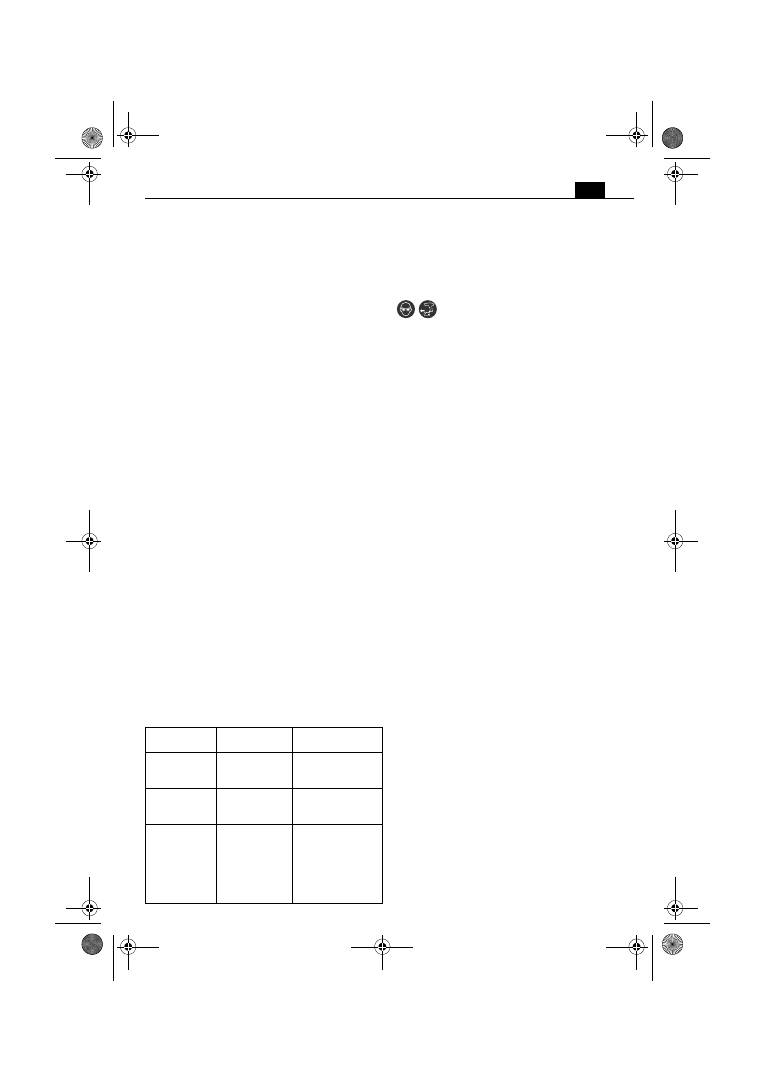
103
uk
може викликати у людей алергічні реакції та/або
стати причиною захворювань дихальних шляхів,
раку, а також негативно позначитися на
репродуктивності. Ступінь ризику при вдиханні
пилу залежить від експозиційної дози.
Використовуйте пиловідсмоктувальний пристрій,
що відповідає даному виду пилу, особисте захисне
спорядження та добре провітрюйте робоче місце.
Доручайте обробку матеріалу, що містить азбест,
лише фахівцям.
Деревний пил та пил легких металів, гарячі суміші
абразивного пилу і хімічних речовин можуть за
несприятливих умов самозайматися або стати
причиною вибуху. Уникайте розлітання іскор в
напрямку ємності для пилу, перегрівання
електроприладу і матеріалу, що шліфується,
своєчасно спорожнюйте ємність для пилу,
дотримуйтеся вказівок виробника матеріалу та
чинних у Вашій країні приписів щодо обробки
матеріалу.
Вказівки з експлуатації.
Приводьте в дію перемикач напрямку обертання і
перемикач швидкості лише при зупиненому двигуні.
Пересувайте перемикач швидкості/повертайте
перемикач режимів роботи (ASB14/18) завжди до
упору. В противному разі можливе пошкодження
електроінструменту.
При перевантаженні електроінструмент
автоматично вимикається.
Установіть перемикач напрямку обертання в середнє
положення, щоб запобігти ненавмисному вмиканню,
напр., під час транспортування.
Регулювання обертального моменту
Заводські настройки розраховані на шурупи
невеликого та середнього розміру.
Момент затягування залежить також і від сили, з
якою електроприлад притискується до шурупа.
Поводження із акумуляторною батареєю.
Користуйтеся акумуляторною батареєю і
заряджайте її лише в діапазоні робочої температури
акумуляторної батареї 0 °C – 45 °C (32 °F – 113 °F). На
початку процесу заряджання температура
акумуляторної батареї повинна знаходитися в
робочому діапазоні.
Дійсний ступінь зарядженості акумуляторної батареї
у відсотках відображається лише при зупиненому
двигунові електроінструменту.
Якщо акумуляторна батарея починає сідати,
електроніка електроінструменту автоматично
зупиняє двигун.
Ремонт та сервісні послуги.
В екстремальних умовах застосування для
обробки металів усередині
електроінструменту може осідати
електропровідний пил. Часто продувайте внутрішні
частини інструменту через вентиляційні щілини
сухим та нежирним стисненим повітрям.
Актуальний перелік запчастин до цього
електроінструменту Ви знайдете в Інтернеті за
адресою: www.fein.com.
За необхідністю Ви можете самостійно замінити
наступні деталі:
робочі інструменти, акумуляторну батарею
Гарантія.
Гарантія на виріб надається відповідно до
законодавчих правил країни збуту. Крім цього, фірма
FEIN надає заводську гарантію відповідно до
гарантійного талона виробника.
Можливо, що в обсяг поставки Вашого
електроінструменту входить не все описане або
зображене в даній інструкції з експлуатації
приладдя.
Заява про відповідність.
Фірма FEIN заявляє під свою особисту
відповідальність, що цей виріб відповідає чинним
приписам, викладеним на останній сторінці цієї
інструкції з експлуатації.
Технічна документація: C. & E. FEIN GmbH, C-DB_IA,
D-73529 Schwäbisch Gmünd
Захист навколишнього середовища,
утилізація.
Упаковку, відпрацьовані електроінструменти та
приладдя потрібно утилізувати екологічно чистим
способом.
Здавайте акумуляторні батареї на відповідну
утилізацію лише в розрядженому стані.
Для уникнення коротких замикань в неповністю
розряджених акумуляторних батареях ізолюйте
штекерні роз’єми клейкою стрічкою.
Світлодіодний
індикатор
Значення
Дія
1 – 4 зелені
світлодіоди
ступінь
зарядженості у
відсотках
Експлуатація
світіння
червоного
світлодіода
Акумуляторна
батарея майже
розрядилася
Зарядіть
акумуляторну
батарею
мигання
червоного
світлодіода
Акумуляторна
батарея не
готова до
роботи
Зачекайте, поки
акумуляторна
батарея не
досягне діапазону
робочої
температури, і
потім зарядіть її
OBJ_BUCH-0000000105-001.book Page 103 Thursday, April 4, 2013 10:23 AM
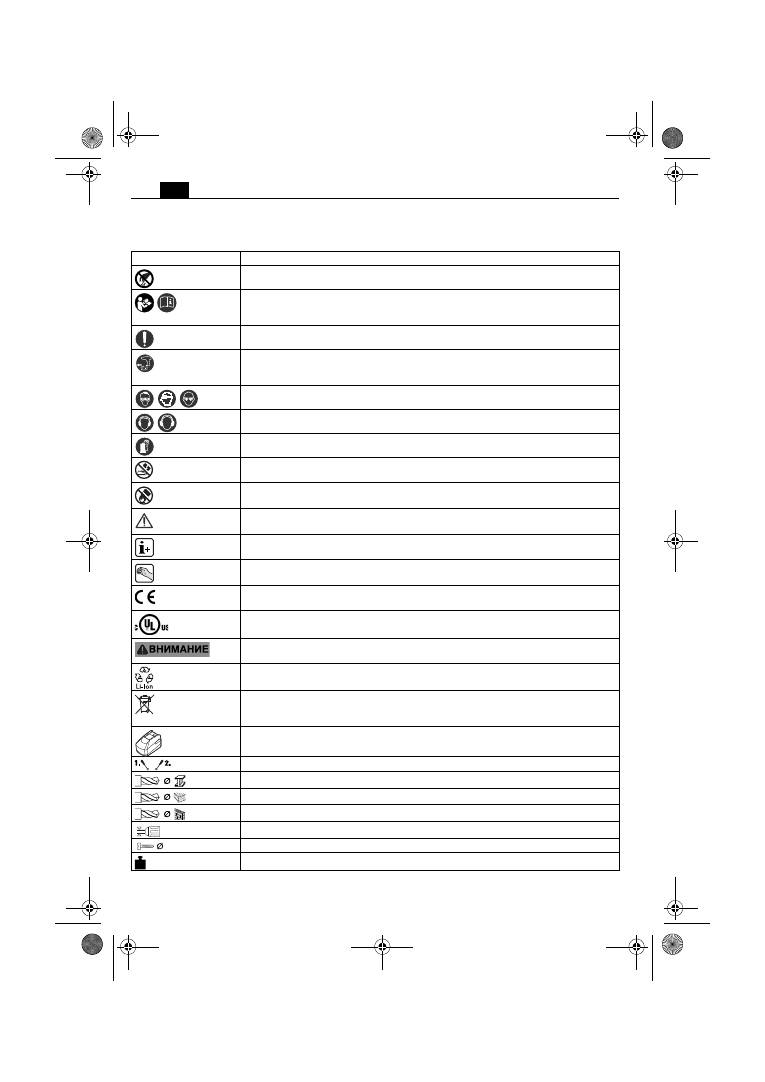
104
bg
bg
Оригинална инструкция за експлоатация.
Използвани символи, съкращения и термини.
Символ, означение
Пояснение
Не допирайте въртящите се детайли на електроинструмента.
Непременно прочетете всички включени в окомплектовката на
електроинструмента документи, като ръководство за експлоатация и общи
указания за безопасна работа.
Следвайте указанията на текста, респ. фигурите в съседство!
Преди тази стъпка извадете акумулаторната батерия от електроинструмента. В
противен случай съществува опасност от нараняване вследствие на неволно
включване на електроинструмента.
Работете с предпазни очила.
Работете с шумозаглушители (антифони).
Работете с предпазни ръкавици.
Не зареждайте повредени акумулаторни батерии.
Не оставяйте акумулаторната батерия в близост до открит огън. Предпазвайте я от
нагряване, напр. също и от продължително въздействие на преки слънчеви лъчи.
Спазвайте стриктно указанията в съседния текст!
Допълнителна информация.
Зона на ръкохватката
Удостоверява съответствието на електроинструмента на директиви на
Европейския съюз.
Този символ удостоверява сертифицирането на продукта в САЩ и Канада.
Този знак указва възможна опасна ситуация, която може да предизвика тежки
травми или смърт.
Знак за рециклиране: обозначава рециклируеми материали
Амортизирани електроинструменти и други електронни и електрически продукти
трябва да бъдат събирани отделно от битовите отпадъци и да бъдат предавани за
вторична преработка на съдържащите се в тях суровини.
Тип на акумулаторната батерия
1. Предавка/2. Предавка
Макс. диаметър на пробиван отвор в стомана
Макс. диаметър на пробиван отвор в дърво
Макс. диаметър на пробиван отвор в каменни материали
Диапазон на захващане на патронника
Диаметър на винт
Маса съгласно EPTA-Procedure 01/2003
Fe
OBJ_BUCH-0000000105-001.book Page 104 Thursday, April 4, 2013 10:23 AM
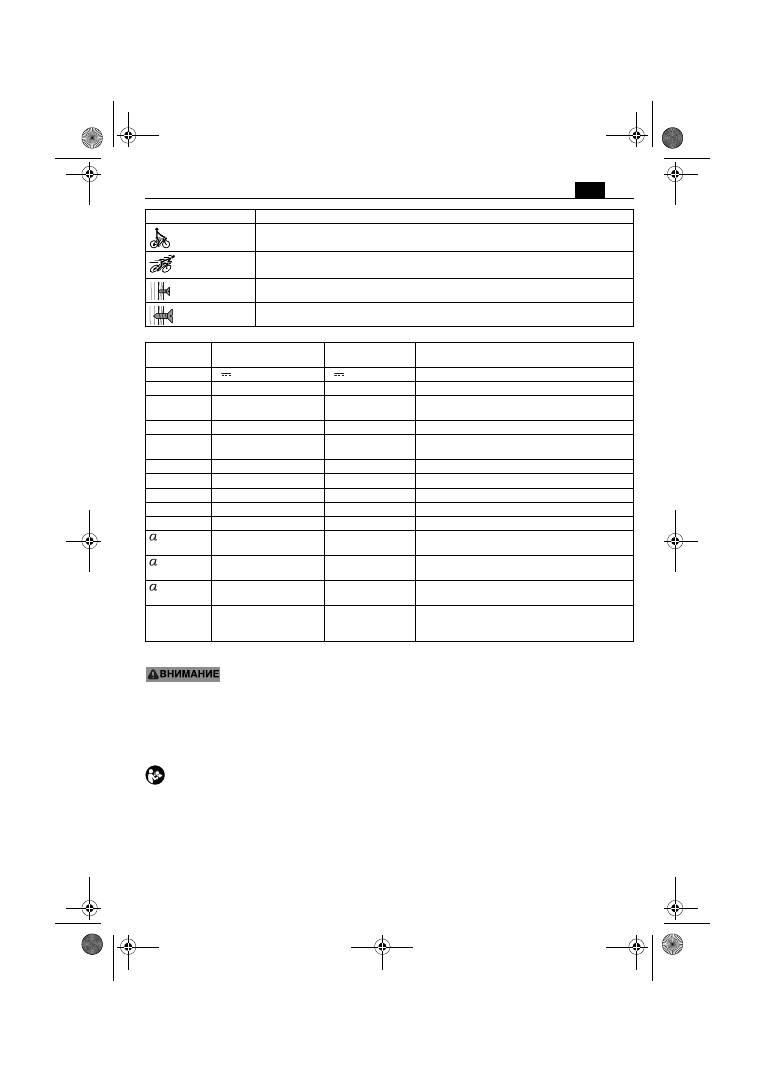
105
bg
За Вашата сигурност.
Прочетете всички указания за
безопасна работа и за работа с
електроинструмента.
Пропуски при спазването на
указанията за безопасна работа и за работа с
електроинструмента могат да предизвикат токов
удар, пожар и/или тежки травми.
Съхранявайте всички указания за безопасна работа и
за работа с електроинструмента за ползване в
бъдеще.
Не използвайте този електроинструмент,
преди внимателно да прочетете и напълно да
разберете това ръководство за експлоатация,
както и приложените «Общи указания за безопасна
работа» (Номер на публикация 3 41 30 054 06 1).
Съхранявайте посочените материали за ползване по-
късно и при продажба на електроинструмента или
когато го давате за ползване от други лица ги
предавайте заедно с него.
Съблюдавайте също валидните национални
разпоредби по охрана на труда.
Предназначение на електроинструмента:
ABS14, ABS18:
Ръчен винтоверт за завиване и развиване в закрити
помещения без подаване на вода на винтове и гайки
и за пробиване и завиване в метални, дървени,
пластмасови и керамични детайли, както и за
нарязване на резба с утвърдените от фирма FEIN
работни инструменти.
ASB14, ASB18:
Ръчен винтоверт за завиване и развиване в закрити
помещения без подаване на вода на винтове и гайки
и за пробиване и завиване в метални, дървени,
пластмасови и керамични детайли, както и за
нарязване на резба и ударно пробиване в бетон,
каменни материали и зидария с утвърдените от
фирма FEIN работни инструменти.
Ниска скорост на въртене
Висока скорост на въртене
Намаляване на въртящия момент
Увеличаване на въртящия момент
Символ
Международно
означение
Национално
означение
Пояснение
U
V
V
Електрическо напрежение
f
Hz
Hz
Честота
n
0
/min, min
-1
, rpm, r/min
/min
Скорост на въртене на празен ход (при
напълно заредена акумулаторна батерия)
n
S
/min, min
-1
/min
Честота на ударите
M...
Nm
Nm
Въртящ момент (твърдо/меко винтово
съединение)
Ø
mm
mm
Диаметър на кръгъл детайл
L
pA
dB
dB
Равнище на звуковото налягане
L
wA
dB
dB
Равнище на мощността на звука
L
pCpeak
dB
dB
Пиково равнище на звуковото налягане
K...
Неопределеност
m/s
2
m/s
2
Генерирани вибрации съгласно EN 60745
(векторна сума по трите направления)
h,D
m/s
2
m/s
2
средна стойност на вибрациите при пробиване
в метал
h,ID
m/s
2
m/s
2
средна стойност на вибрациите при ударно
пробиване в бетон
m, s, kg, A, mm, V,
W, Hz, N, °C, dB,
min, m/s
2
m, s, kg, A, mm, V,
W, Hz, N, °C, dB,
min, m/s
2
Основни и производни единици от
Международната система за мерни единици
SI
.
Символ, означение
Пояснение
OBJ_BUCH-0000000105-001.book Page 105 Thursday, April 4, 2013 10:23 AM
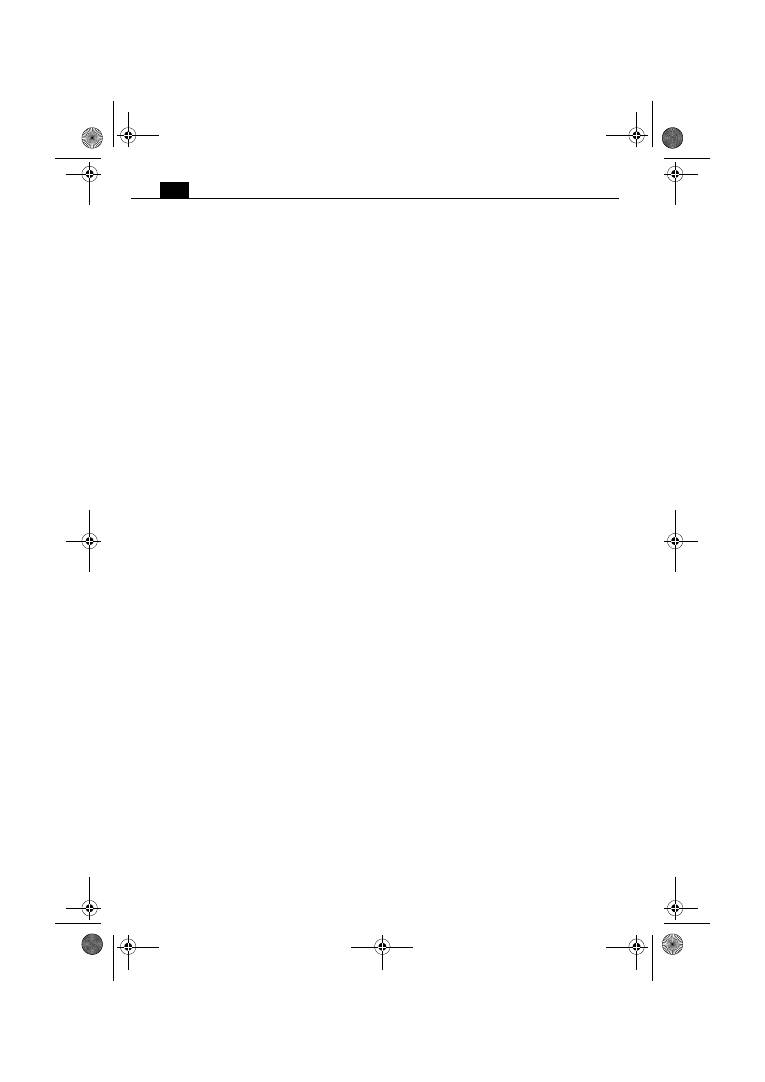
106
bg
Специални указания за безопасна работа.
Когато съществува опасност по време на работа
винтът да засегне скрити под повърхността
проводници под напрежение, допирайте
електроинструмента само до изолираните ръкохватки.
При съприкосновение с проводник под напрежение
то може да се предаде и по металните повърхности
на електроинструмента и това да предизвика токов
удар.
Внимавайте за скрити под повърхността електрически
проводници, газопроводни и водопроводни тръби.
Преди да започнете работа проверявайте работната
зона, напр. с металотърсач.
Работете с лични предпазни средства. В зависимост от
приложението работете с цяла маска за лице, защита
за очите или предпазни очила. Ако е необходимо,
работете с дихателна маска, шумозаглушители
(антифони), работни обувки или специализирана
престилка, която Ви предпазва от малки откъртени
при работата частички.
Очите Ви трябва да са защи-
тени от летящите в зоната на работа частички.
Противопраховата или дихателната маска
филтрират възникващия при работа прах. Ако
продължително време сте изложени на силен шум,
това може да доведе до загуба на слух.
При ударно пробиване работете с шумозаглушители
(антифони).
Продължителното въздействие на шума
може да предизвика загуба на слух.
Осигурявайте добре обработвания детайл.
Детайл,
захванат с подходящо приспособление, се държи
по-сигурно и безопасно, отколкото, ако го държите
с ръка.
Дръжте електроинструмента здраво.
Съществува
опасност от внезапното възникване на силни
краткотрайни реакционни моменти.
Не обработвайте съдържащ азбест материал.
Азбестът се счита за канцерогенен.
Забранява се захващането към корпуса на
електроинструмента на табелки или знаци с винтове
или нитове.
Повредена изолация не осигурява защита
от токов удар. Използвайте самозалепващи се
табелки.
Не използвайте допълнителни приспособления, които
не са изрично проектирани или допуснати за употреба
от производителя на електроинструмента.
Фактът, че
дадено приспособление може да бъде монтирано
към електроинструмента, не означава, че ползването
му е безопасно.
Редовно почиствайте вентилационните отвори на
електроинструмента с неметални инструменти.
Турбинката на електродвигателя засмуква прах в
корпуса. При прекомерна запрашеност с метален
прах това може да увреди електроизолацията на
електроинструмента.
Никога не поглеждайте от малко разстояние срещу
светещата лампа на електроинструмента. Никога не
насочвайте светлинната струя към очите на други
лица, които се намират в близост.
Лъчите, излъчвани
от лампата, могат да увредят очите.
Не насочвайте електроинструмента към себе си, към
други лица или животни.
Съществува опасност от
нараняване с нагорещени работни инструменти или
работни инструменти с остри ръбове.
Работа с и ползване на акумулаторни батерии.
За да избягвате опасности като изгаряния, пожар,
експлозия, кожни рани и други наранявания при
работа с акумулаторни батерии, спазвайте следните
указания:
Не се допуска отварянето, разглобяването или
разчупването на акумулаторните батерии. Не
излагайте акумулаторните батерии на силни
механични въздействия.
При повреждане и
неправилна експлоатация на акумулаторните
батерии могат да се отделят вредни пари и течности.
Парите могат да раздразнят дихателните пътища.
Изтичащ от акумулаторната батерия електролит
може да предизвика зачервяване на кожата или
изгаряния.
Ако изтичащият от повредена акумулаторна батерия
електролит е намокрил съседни елементи, ги
прегледайте внимателно, почистете ги, а при
необходимост ги заменете.
Не излагайте акумулаторната батерия на прякото
въздействие на отоплителни тела или огън. Не я
оставяйте на директна слънчева светлина.
Изваждайте акумулаторната батерия от оригиналната
й опаковка едва когато трябва да я използвате.
Преди да извършвате каквито и да е дейности по
електроинструмента, изваждайте акумулаторната
батерия.
Ако включите неволно електро-
инструмента, съществува опасност от нараняване.
Изваждайте акумулаторната батерия само когато
електроинструментът е изключен.
Дръжте акумулаторната батерия далеч за деца.
Поддържайте акумулаторната батерия чиста и я
предпазвайте от овлажняване.
Почиствайте
замърсени контакти на акумулаторната батерия и на
електроинструмента с чиста суха кърпа.
Използвайте само изправни акумулаторни батерии на
FEIN, които са предназначени за електроинструмента.
При работа с и при зареждане на акумулаторни
батерии, които са неподходящи, повредени, били са
ремонтирани или са т.нар. «съвместими» и чуждо
производство съществува опасност от пожар и/или
експлозия.
Спазвайте указанията в ръководството за
експлоатация на акумулаторната батерия.
Предавани на ръцете вибрации
Посоченото в това ръководство за експлоатация
равнище на вибрациите е определено съгласно
процедура, посочена в стандарта EN 60745, и може
да бъде използвана за сравняване на различни
електроинструменти. То е подходящо също и за
груба предварителна оценка на натоварването от
вибрации.
OBJ_BUCH-0000000105-001.book Page 106 Thursday, April 4, 2013 10:23 AM
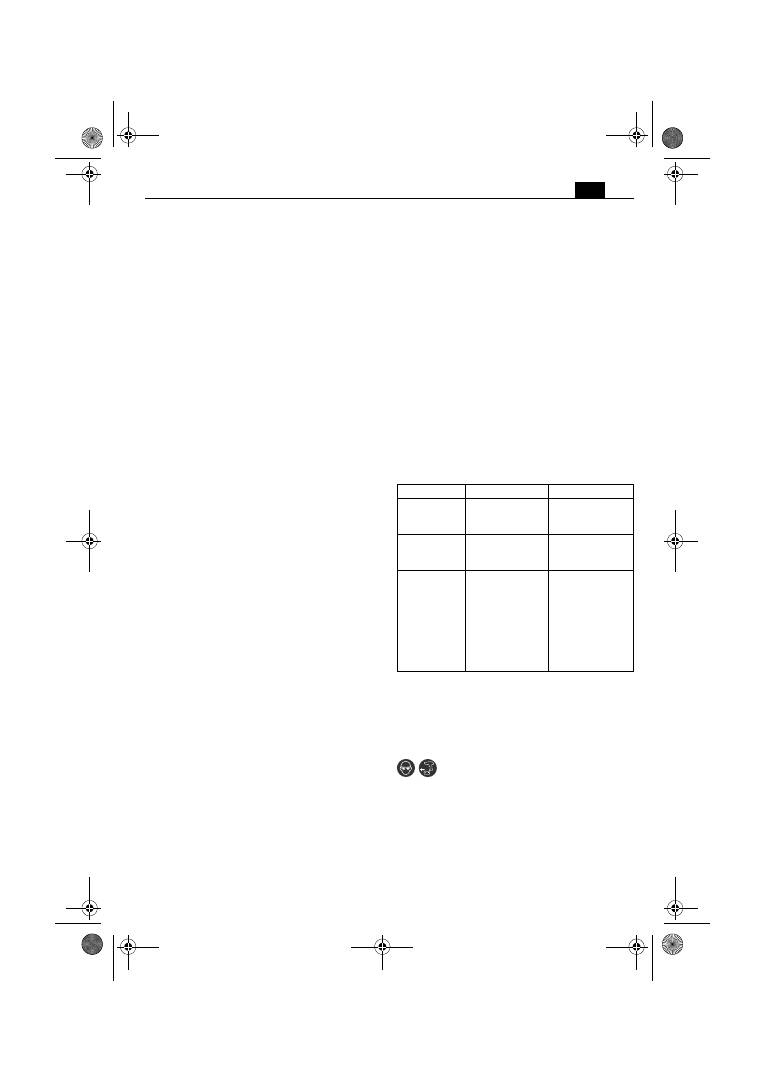
107
bg
Посоченото равнище на вибрациите е
представително за най-често срещаните
приложения на електроинструмента. Ако обаче
електроинструментът се използва при други
работни условия и за други приложения, с различни
работни инструменти или ако не бъде поддържан в
изрядно състояние, равнището на вибрациите може
да се отличава съществено от посоченото. Това би
могло значително да увеличи натоварването от
вибрации за целия производствен цикъл.
За точната преценка на натоварването от вибрации
трябва да се отчитат и интервалите от време, през
които електроинструментът е изключен или работи,
но не се използва. Това може значително да намали
натоварването от вибрации за целия производствен
цикъл.
Взимайте допълнителни мерки за предпазване на
работещия с електроинструмента от влиянието на
вибрациите, напр.: поддържане на
електроинструмента и работните инструменти в
изрядно състояние, подгряване и поддържане на
ръцете топли, подходяща организация на
последователността на работните цикли.
Работа с опасни за здравето прахове
При работа с този електроинструмент възникват
прахове, които могат да бъдат опасни.
Допирът или вдишването на някои прахове, напр.
отделящи се при работа с азбест и
азбестосъдържащи материали, съдържащи олово
лакови покрития и бои, метали, някои видове
дървесина, минерали, силикатни частици от инертни
материали, разтворители за някои видове боя,
консерванти за дървесина, противообрастващи
средства за плавателни съдове може да предизвика
алергични реакции и/или заболявания на
дихателните пътища, рак, увреждане на половата
система и др.п. Рискът вследствие на вдишването на
праховете зависи от експозицията. Използвайте
подходяща за вида на отделяните прахове
аспирационна система, както и лични предпазни
средства и осигурявайте добро проветряване на
работното място. Оставяйте обработването на
азбестосъдържащи материали да се извършва само
от квалифицирани техници.
При неблагоприятни обстоятелства прах от
дървесни материали или от леки метали, горещи
смеси от шлифоване и химикали могат да се
самовъзпламенят или да предизвикат експлозия.
Внимавайте образуващата се по време на работа
струя искри да не е насочена към кутии за събиране
на отпадъчна прах, избягвайте прегряването на
електроинструмента и на обработвания детайл,
своевременно изпразвайте прахоуловителната
кутия, спазвайте указанията за обработване на
производителя на материала, както и валидните във
Вашата страна предписания за обработваните
материали.
Указания за ползване.
Задействайте превключвателя за посоката на
въртене и превключвателя за предавките само когато
електродвигателят е в покой.
Винаги премествайте превключвателя за предавките,
респ. завъртайте превключвателя за режима на
работа (ASB14/18) до упор. В противен случай
електроинструментът може да бъде повреден.
При претоварване електроинструментът се
изключва.
Поставете превключвателя за посоката на въртене в
средно положение, за да предотвратите опасността
от включване на електроинструмента по
невнимание, напр. при пренасяне.
Регулиране на въртящия момент
Настройката в завода-производител съответства на
диапазона за малки до средно големи винтове.
Въртящият момент на затягане зависи също и от
силата, с която електроинструментът се притиска
към винта.
Работа с акумулаторната батерия.
Ползвайте акумулаторната батерия и я зареждайте
само когато температурата й е в допустимия работен
интервал от 0 °C – 45 °C (32 °F – 113 °F). В началото на
процеса на зареждане температурата на
акумулаторната батерия трябва да е в рамките на
допустимия температурен интервал.
Реалният процент на зареденост на батерията се
показва само когато електродвигателят не работи.
Ако съществува опасност от дълбоко разреждане на
акумулаторната батерия, електронното управление
спира електродвигателя автоматично.
Поддържане и сервиз.
При екстремно тежки работни условия
при обработване на метали по вътрешните
повърхности на корпуса на
електроинструмента може да се отложи
токопровеждащ прах. Продухвайте често
вътрешното пространство на електроинструмента
със сух и обезмаслен сгъстен въздух.
Актуален списък с резервни части за този
електроинструмент можете да намерите в интернет
на адрес www.fein.com.
При необходимост можете сами да замените следните
елементи:
работни инструменти, акумулаторна батерия
Светодиод
Значение
Действие
1 – 4 зелени
светодиода
процентна
степен на
зареденост
Работа
червена
непрекъсната
светлина
Акумулаторната
батерия е почти
празна
Заредете
аукмулаторната
батерия
червена
мигаща
светлина
Акумулаторната
батерия не е
готова за работа
Изчакайте
температурата на
акумулаторната
батерия да
достигне
допустимия
работен
интервал и след
това я заредете
OBJ_BUCH-0000000105-001.book Page 107 Thursday, April 4, 2013 10:23 AM
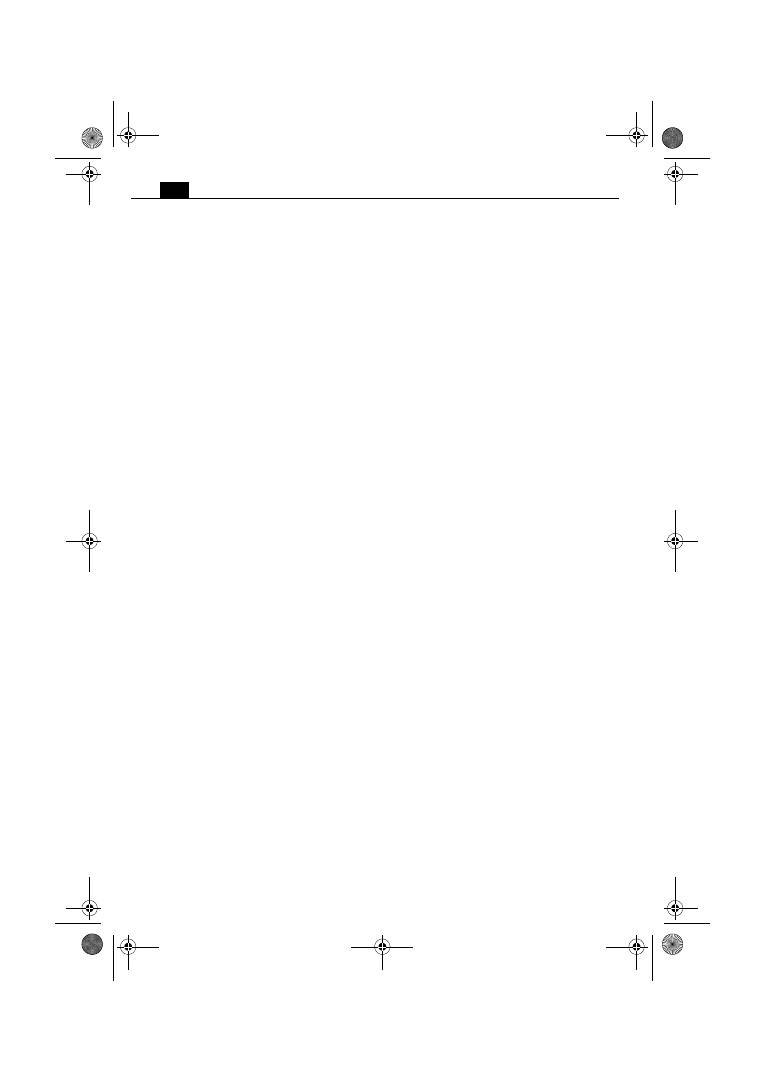
108
bg
Гаранция и гаранционно обслужване.
Гаранционното обслужване на електроинструмента
е съгласно законовите разпоредби в страната-
вносител. Освен това фирма FEIN осигурява
гаранционно обслужване съгласно Гаранционната
декларация на производителя на FEIN.
В окомплектовката на Вашия електроинструмент
може да са включени само част от описаните в това
ръководство и изобразени на фигурите
допълнителни приспособления.
Декларация за съответствие.
Фирма FEIN гарантира с пълна отговорност, че този
продукт съответства на валидните нормативни
документи, посочени на последната страница на
това ръководство за експлоатация.
Техническа документация при: C. & E. FEIN GmbH,
C-DB_IA, D-73529 Schwäbisch Gmünd
Опазване на околната среда,
бракуване.
Опаковките, излезлите от употреба
електроинструменти и допълнителни
приспособления трябва да се предават за
оползотворяване на съдържащите се в тях суровини.
Предавайте повредени акумулаторни батерии за
вторична преработка само напълно разредени.
Когато акумулаторната батерия не е напълно
разредена, като предпазна мярка срещу къси
съединения облепяйте контактите с изолираща
лента.
OBJ_BUCH-0000000105-001.book Page 108 Thursday, April 4, 2013 10:23 AM
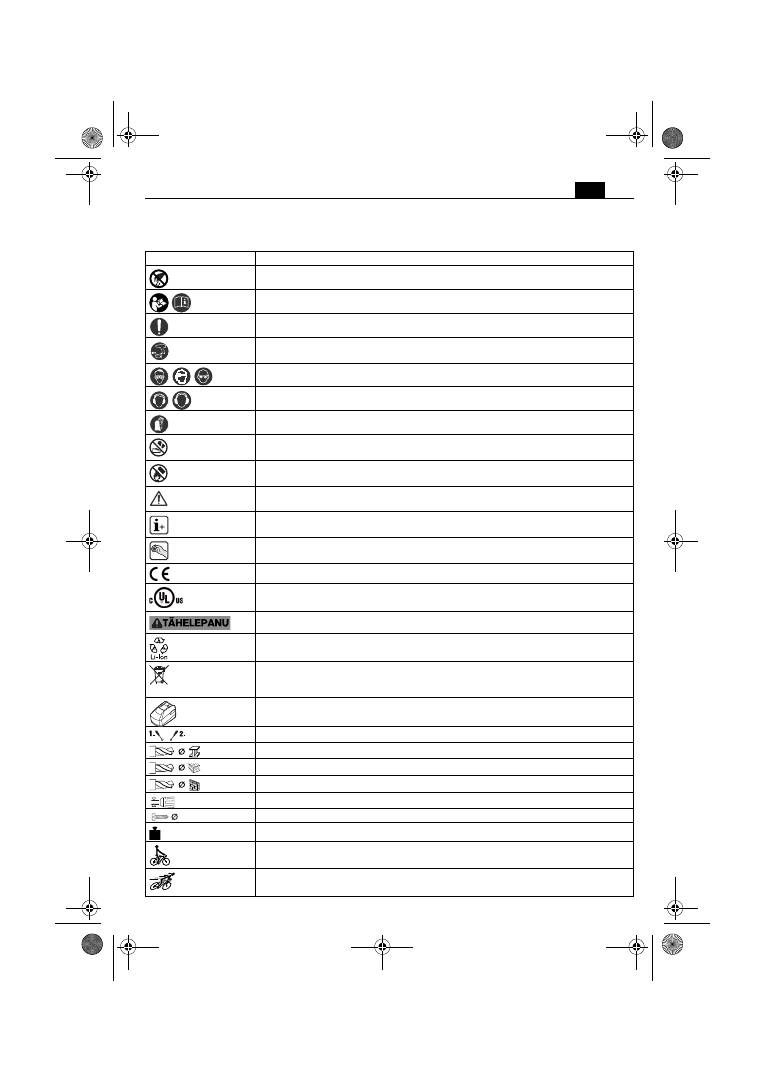
109
et
et
Algupärane kasutusjuhend.
Kasutatud sümbolid, lühendid ja mõisted.
Sümbol, tähis
Selgitus
Ärge puudutage elektrilise tööriista pöörlevaid osi.
Lugege tingimata läbi seadmele lisatud kasutusjuhend ja üldised ohutusnõuded.
Järgige kõrvaltoodud tekstis või joonisel sisalduvaid juhiseid!
Enne selle tööoperatsiooni tegemist eemaldage seadmest aku. Vastasel korral võib
elektriline tööriist soovimatult käivituda ja kasutajat vigastada.
Töötades kandke kaitseprille.
Töötades kandke kõrvaklappe või -troppe.
Töötades kandke kaitsekindaid.
Ärge laadige vigastatud akusid.
Ärge jätke akut tule kätte. Kaitske akut kuumuse, sealhulgas pideva päikesekiirguse eest.
Järgige kõrvaltoodud tekstis sisalduvaid juhiseid!
Lisateave.
Haardepiirkond
Kinnitab elektrilise tööriista vastavust Euroopa Liidu direktiividele.
See sümbol tõendab, et toode on sertifitseeritud Ameerika Ühendriikides ja Kanadas.
Märkus viitab võimalikule ohuolukorrale, mis võib kaasa tuua tõsised vigastused või surma.
Ringlussevõtu tähis: tähistab korduskasutatavaid materjale
Kasutusressursi ammendanud elektrilised tööriistad ja teised elektrotehnilised ja
elektrilised seadmed tuleb sorteeritult kokku koguda ja keskkonnahoidlikult ringlusse
võtta.
Aku tüüp
1. käik/2. käik
Puuri läbimõõt terases
Puuri läbimõõt puidus
Puuri läbimõõt kivis
Tarviku padrunisse kinnitatava saba läbimõõt
Kruvi läbimõõt
Kaal EPTA-Procedure 01/2003 järgi
Madalad pöörded
Kõrged pöörded
Fe
OBJ_BUCH-0000000105-001.book Page 109 Thursday, April 4, 2013 10:23 AM
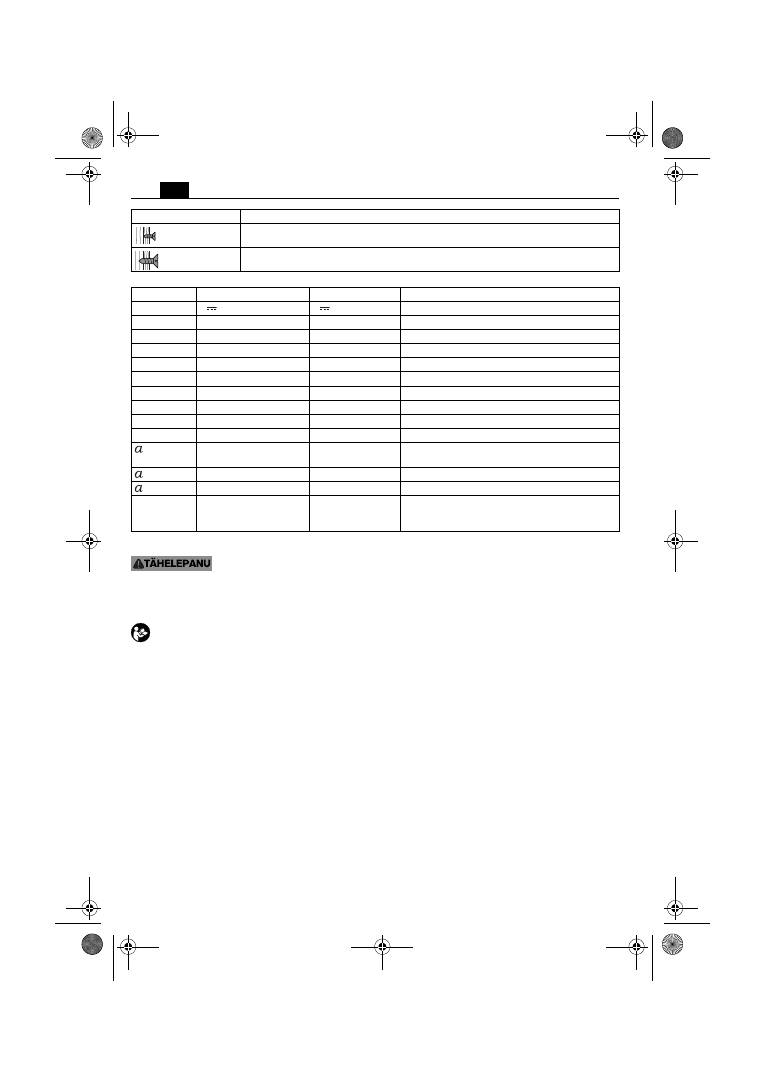
110
et
Tööohutus.
Lugege läbi kõik ohutusnõuded ja
juhised.
Ohutusnõuete ja juhiste
eiramine võib tuua kaasa elektrilöögi, tulekahju ja/või
rasked vigastused.
Hoidke kõik ohutusnõuded ja juhised edaspidiseks
kasutamiseks alles.
Enne elektrlise tööriista kasutuselevõttu lugege
põhjalikult läbi kasutusjuhend ja juurdekuuluvad
üldised ohutusnõuded (dokumendi nr
3 41 30 054 06 1). Hoidke kõik juhised edaspidiseks
kasutamiseks alles ja elektrilise tööriista edastamisel
kolmandatele isikutele pange kaasa ka nimetatud
dokumendid.
Pidage kinni ka asjaomastest siseriiklikest
töökaitsenõuetest.
Elektrilise tööriista otstarve:
ABS14, ABS18:
käsitsi juhitav puurtrell-kruvikeeraja kruvide ja mutrite
sisse- ja väljakeeramiseks ning metalli, puidu, plasti ja
keraamiliste materjalide kuivpuurimiseks ja nimetatud
materjalidesse kruvide keeramiseks, samuti keermete
lõikamiseks, kasutades FEIN poolt heakskiidetud
tarvikuid ja lisaseadised, töötada tuleb kuivas ja
ilmastikutingimuste eest kaitstud keskkonnas.
ASB14, ASB18:
käsitsi juhitav löökpuurtrell-kruvikeeraja kruvide ja
mutrite sisse- ja väljakeeramiseks ning metalli, puidu,
plasti ja keraamiliste materjalide kuivpuurimiseks ja
nimetatud materjalidesse kruvide keeramiseks, samuti
keermete lõikamiseks, kasutades FEIN poolt
heakskiidetud tarvikuid ja lisaseadised, töötada tuleb
kuivas ja ilmastikutingimuste eest kaitstud keskkonnas.
Ohutusalased erinõuded.
Kui teostate töid, mille puhul võib kruvi tabada varjatud
elektrijuhtmeid, hoidke seadet ainult isoleeritud
käepidemetest.
Kontakt pinge all oleva elektrijuhtmega võib
pingestada seadme metallosad ja põhjustada elektrilöögi.
Pöörake tähelepanu varjatult paiknevatele
elektrijuhtmetele, gaasi- ja veetorudele.
Enne töö algust
kontrollige tööpiirkond üle nt metalliotsijaga.
Kandke isikukaitsevahendeid. Kasutage vastavalt
kasutusotstarbele näomaski, silmakaitset või
kaitseprille. Vajaduse korral kandke tolmukaitsemaski,
kuulmiskaitsevahendeid, kaitsekindaid või kaitsepõlle,
mis kaitseb Teid lihvimisel eralduvate väikeste osakeste
eest.
Silmad peavad olema kaitstud seadme kasutamisel
eralduvate võõrkehade eest. Tolmu- või hingamisteede
kaitsemaskid peavad filtreerima kasutamisel tekkiva
tolmu. Pikaajaline vali müra võib kahjustada kuulmist.
Löökpuurimisel kandke kuulmiskaitsevahendeid.
Müra
võib kahjustada kuulmist.
Kinnitage töödeldav toorik.
Kinnitusvahendite abil
kinnitatud toorik püsib paremini paigal kui käega hoides.
Hoidke elektrilist tööriista kindlalt käes.
Lühiajaliselt võib
tekkida suuri reaktsioonimomente.
Asbesti sisaldava materjali töötlemine on keelatud.
Asbest võib tekitada vähki.
Elektrilisele tööriistale ei tohi kruvide või neetidega
kinnitada silte ja märgiseid.
Kahjustatud isolatsioon ei
taga kaitset elektrilöögi eest. Kasutage kleebiseid.
Pöördemomendi vähendamine
Pöördemomendi suurendamine
Tähis
Rahvusvaheline ühik
Riiklik ühik
Selgitus
U
V
V
Alalispinge
f
Hz
Hz
Sagedus
n
0
/min, min
-1
, rpm, r/min
/min
Tühikäigupöörded (laetud aku puhul)
n
S
/min, min
-1
/min
Löökide arv
M...
Nm
Nm
Pöördemoment (tugev/nõrk kruvikeeramisrežiim)
Ø
mm
mm
Detaili läbimõõt
L
pA
dB
dB
Helirõhu tase
L
wA
dB
dB
Helivõimsuse tase
L
pCpeak
dB
dB
Helirõhu maksimaalne tase
K...
Mõõtemääramatus
m/s
2
m/s
2
Vibratsioonitase EN 60745 järgi (kolme suuna
vektorsumma)
h,D
m/s
2
m/s
2
keskmine vibratsioon metalli puurimisel
h,ID
m/s
2
m/s
2
keskmine vibratsioon betooni löökpuurimisel
m, s, kg, A, mm, V,
W, Hz, N, °C, dB,
min, m/s
2
m, s, kg, A, mm, V,
W, Hz, N, °C, dB,
min, m/s
2
Rahvusvahelise mõõtühikute süsteemi
SI
põhiühikud ja tuletatud ühikud.
Sümbol, tähis
Selgitus
OBJ_BUCH-0000000105-001.book Page 110 Thursday, April 4, 2013 10:23 AM

111
et
Ärge kasutage teiste tootjate tarvikuid, mida elektrilise
tööriista tootja ei ole heaks kiitnud.
Asjaolu, et tarvikut
saab tööriista külge kinnitada, ei taga veel tööriista ohutut
tööd.
Puhastage seadme ventilatsiooniavasid regulaarselt
mittemetalliliste tööriistadega.
Mootori ventilaator
tõmbab tolmu korpusse. Metallitolmu liigne kogunemine
võib olla ohtlik.
Ärge kunagi laske elektrilise tööriista lambi tulel väikese
vahemaa tagant endale silmale paista. Ärge suunake
lambi tuld kunagi läheduses paiknevate inimeste poole.
Valgusallika poolt tekitatav valguskiirgus võib silmi
kahjustada.
Ärge suunake elektrilist tööriista iseenda, teiste inimeste
ega loomade poole.
Teravad või kuumad tarvikud võivad
tekitada vigastusi.
Aku kasutamine ja käsitsemine (akud).
Selleks et vältida akude käsitsemisest tingitud põletusi,
tulekahju, plahvatust, nahavigastusi ja teisi vigastusi,
pidage kinni järgmistest juhistest:
Akusid ei tohi lahti võtta, avada aga tükeldada. Akudele
ei tohi avalduda mehaanilised mõjutused, nt löögid.
Aku
vigastamisel ja ebaõigel käsitsemisel võib akust eralduda
kahjulikke aure ja vedelikke. Aurud võivad ärritada
hingamisteid. Väljavoolav akuvedelik võib põhjustada
nahaärritust või söövitust.
Kui vigastatud akust väljavoolanud vedelik on puutunud
kokku läheduses olevate esemetega, kontrollige
asjaomased detailid üle, puhastage ja vahetage vajaduse
korral välja.
Ärge jätke akut kuumuse või tule kätte. Ärge hoidke akut
otsese päikesekiirguse käes.
Võtke aku originaalpakendist välja alles vahetult enne
kasutuselevõttu.
Enne mis tahes tööde teostamist elektrilise tööriista
kallal eemaldage aku.
Elektrilise tööriista soovimatu
käivitumise korral tekib vigastuste oht.
Eemaldage aku üksnes siis, kui elektriline tööriist on
välja lülitatud.
Tõkestage laste ligipääs akudele.
Hoidke aku puhas ja kaitske akut niiskuse ja vee eest.
Aku ja elektrilise tööriista määrdunud kontakte puhastage
kuiva puhta lapiga.
Kasutage ainult veatuid FEIN originaalakusid, mis on ette
nähtud Teie elektrilise tööriista jaoks.
Valede,
kahjustatud, parandatud või muudetud akude, samuti
järeletehtud akude või teiste tootjate akude kasutamisel
tekib tulekahju ja/või plahvatuse oht.
Järgige akulaadija kasutusjuhendis toodud
ohutusnõudeid.
Käe-randme-vibratsioon
Käesolevas juhendis toodud vibratsioon on mõõdetud
standardi EN 60745 kohase mõõtemeetodi järgi ja seda
saab kasutada elektriliste tööriistade omavaheliseks
võrdlemiseks. See sobib ka vibratsiooni esialgseks
hindamiseks.
Toodud vibratsioonitase kehtib tööriista kasutamisel
ettenähtud otstarbel. Kui aga elektrilist tööriista
kasutatakse muudeks töödeks, rakendatakse teisi
tarvikuid või kui tööriista hooldus pole piisav, võib
vibratsioonitase kõikuda. See võib vibratsiooni töö
koguperioodi jooksul tunduvalt suurendada.
Vibratsiooni täpseks hindamiseks tuleks arvesse võtta ka
aega, mil seade oli välja lülitatud või küll sisse lülitatud,
kuid tegelikult tööle rakendamata. See võib vibratsiooni
töö koguperioodi jooksul tunduvalt vähendada.
Kasutaja kaitsmiseks vibratsiooni eest võtke tarvitusele
täiendavad ohutusabinõud, näiteks: hooldage tööriistu ja
tarvikuid piisavalt, hoidke käed soojas, tagage sujuv
töökorraldus.
Ohtliku tolmu käitlemine
Elektrilise tööriistaga töötamisel tekkib tolm, mis võib
olla ohtlik.
Teatava tolmu, nt asbesti või asbesti sisaldavate
materjalide töötlemisel tekkiva tolmu, pliid sisaldavate
värvide tolmu, metallitolmu, mõnda liiki puidu,
mineraalide, kivisisaldusega materjalide räniosakeste
tolmu, lahustite, puidukaitsevahendite, veesõidukite
lakkide tolm võib põhjustada allergilisi reaktsioone,
hingamisteede haigusi ja vähki ning kahjustada
sigimisvõimet. Haigestumise oht sõltub sissehingatavast
kogusest. Kasutage tekkiva tolmu jaoks sobivaid
isikukaitsevahendeid ning tagage töökohal hea
ventilatsioon. Asbesti sisaldavate materjalide töötlemine
on lubatud vaid vastava väljaõppega isikutele.
Puidutolm ja kergmetallide tolm, lihvimistolmu ja
keemiliste ainete kuumad segud võivad ebasoodsates
tingimustes iseeneslikult süttida või plahvatada. Vältige
sädemete lendumist tolmumahutite suunas ning elektrilise
tööriista ja lihvitava detaili ülekuumenemist, tühjendage
õigeaegselt tolmumahutit, pidage kinni materjali tootja
juhistest ning riigis kehtivatest ohutusnõuetest.
Tööjuhised.
Reverslülitit ja käiguvalikulülitit käsitsege ainult siis, kui
mootor seisab.
Lükake käiguvalikulüliti ja pöörake töörežiimilüliti
(ASB14/18) alati lõpuni. Vastasel korral võib elektriline
tööriist kahjustada saada.
Ülekoormuse korral lülitub elektriline tööriist välja.
Viige reverslüliti keskasendisse, et vältida seadme
soovimatut käivitumist näiteks transportimisel.
Pöördemomendi seadistamine
Vaikimisi on seadistatud väikestele kuni keskmise
suurusega kruvidele sobiv pöördemoment.
Pöördemoment sõltub ka jõust, millega seade vastu kruvi
surutakse.
OBJ_BUCH-0000000105-001.book Page 111 Thursday, April 4, 2013 10:23 AM
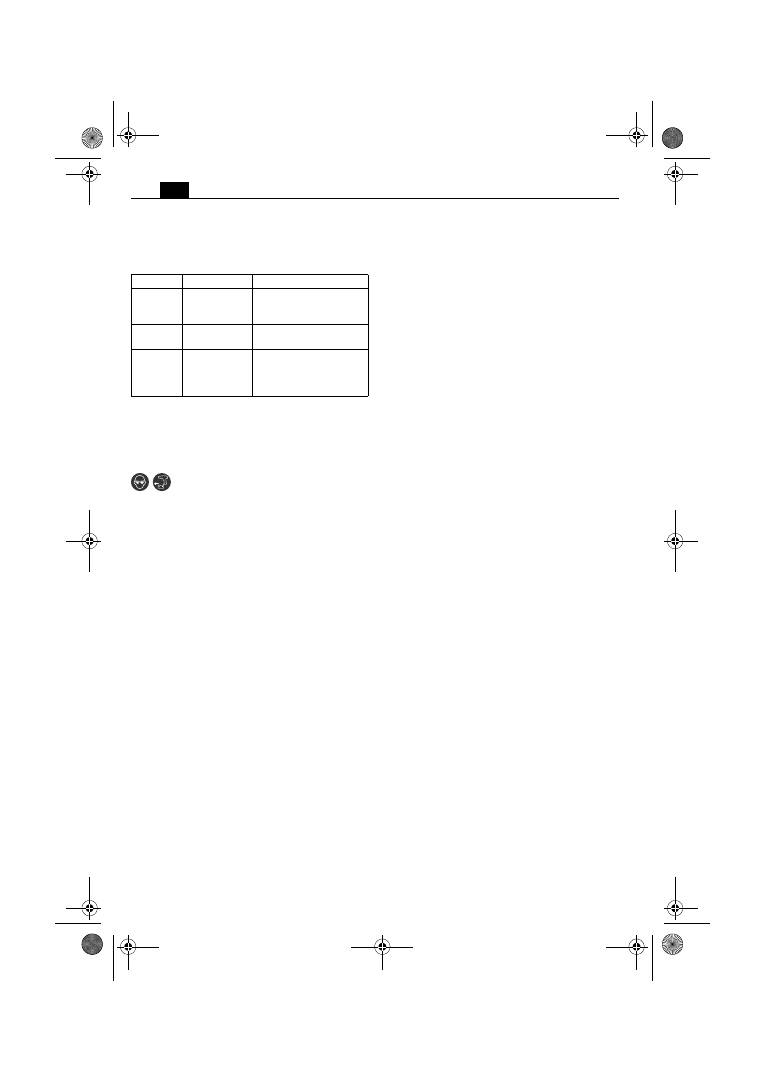
112
et
Aku käsitsemine.
Käsitsege ja laadige akut üksnes siis, kui aku temperatuur
on vahemikus 0 °C – 45 °C (32 °F – 113 °F).
Laadimisprotsessi alguses peab aku temperatuur olema
ettenähtud vahemikus.
Aku tegelikku laetuse astet näidatakse vaid siis, kui
elektrilise tööriista mootor ei tööta.
Enne aku täielikku tühjenemist seiskab elektroonika
mootori automaatselt.
Korrashoid ja hooldus.
Äärmuslike töötingimuste korral võib
metallide töötlemisel koguneda seadmesse
elektrit juhtivat tolmu. Puhastage tööriista
sisemust ventilatsiooniavade kaudu korrapäraselt kuiva ja
õlivaba suruõhuga.
Elektrilise tööriista varuosade ajakohastatud loetelu leiate
Internetist veebilehelt www.fein.com.
Vajaduse korral võite ise välja vahetada järgmisi detaile:
tarvikud, aku
Garantii.
Tootele antakse garantii vastavalt maaletooja riigis
kehtivatele nõuetele. Lisaks sellele annab FEIN garantii
vastavalt FEIN tootjavastutuse deklaratsioonile.
Elektrilise tööriista tarnekomplekt ei pruugi sisaldada
kõiki käesolevas kasutusjuhendis kirjeldatud või
kujutatud tarvikuid.
Vastavusdeklaratsioon.
Firma FEIN kinnitab ainuvastutusel, et käesolev toode
vastab kasutusjuhendi viimasel leheküljel toodud
asjaomastele nõuetele.
Tehnilised dokumendid on saadaval aadressil:
C. & E. FEIN GmbH, C-DB_IA,
D-73529 Schwäbisch Gmünd
Keskkonnakaitse, utiliseerimine.
Pakendid, kasutusressursi ammendanud elektrilised
tööriistad ja tarvikud tuleb keskkonnahoidlikult ümber
töödelda ja ringlusse võtta.
Viige kogumispunkti ainult täiesti tühjad akud.
Kui akud ei ole täiesti tühjad, isoleerige pistik
lühiühinduse vältimiseks teibiga.
LED-tuli
Tähendus
Toiming
1 – 4
rohelist
LED-tuld
protsentuaalne
laetuse aste
Töötamine
punane
pidev tuli
Aku on
peaaegu tühi
Laadige aku täis
punane
vilkuv tuli
Aku ei ole
töövalmis
Laske akul soojeneda või
jahtuda, kuni aku
temperatuur on ettenähtud
vahemikus, seejärel laadige
OBJ_BUCH-0000000105-001.book Page 112 Thursday, April 4, 2013 10:23 AM
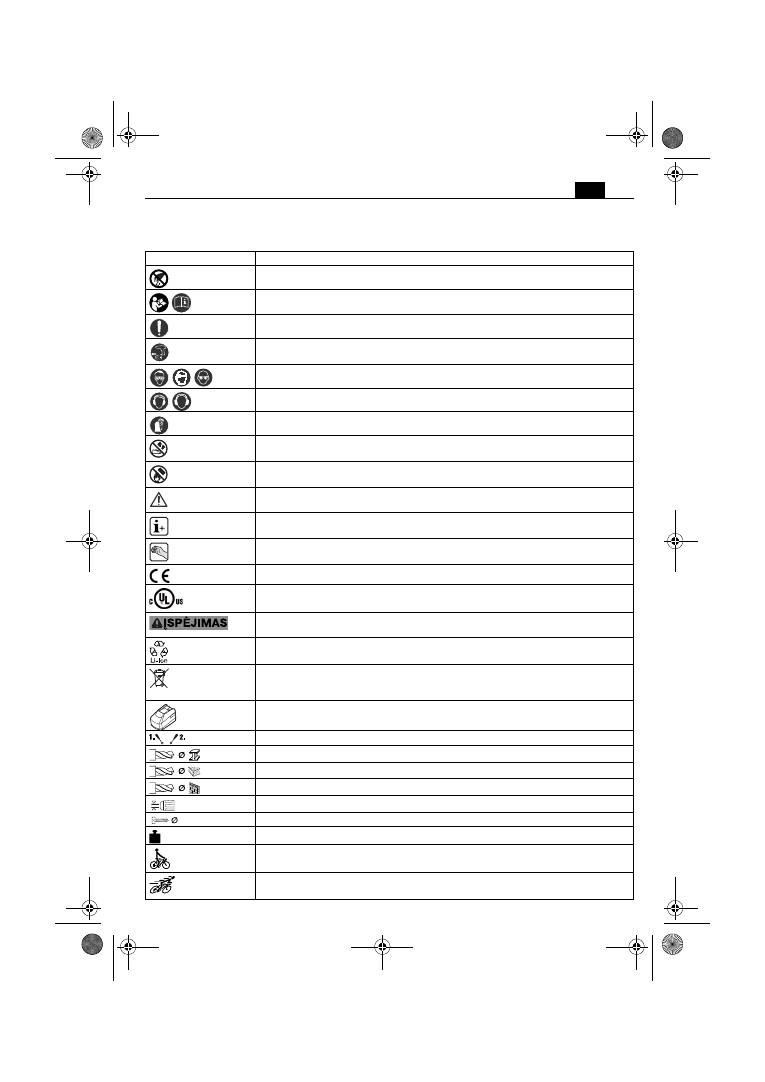
113
lt
lt
Originali instrukcija.
Naudojami simboliai, trumpiniai ir terminai.
Simbolis, ženklas
Paaiškinimas
Nelieskite besisukančių elektrinio įrankio dalių.
Būtinai perskaitykite pridėtus dokumentus, pvz., naudojimo instrukciją ir bendrąsias
saugos nuorodas.
Laikykitės šalia esančiame tekste ar grafiniame vaizde pateiktų reikalavimų!
Prieš pradėdami šį darbo žingsnį, iš elektrinio įrankio išimkite akumuliatorių. Priešingu
atveju, elektriniam įrankiui netikėtai įsijungus iškyla sužalojimo pavojus.
Dirbkite su akių apsaugos priemonėmis.
Dirbkite su klausos apsaugos priemonėmis.
Dirbkite su rankų apsaugos priemonėmis.
Nekraukite pažeistų akumuliatorių.
Saugokite akumuliatorių nuo ugnies. Saugokite akumuliatorių nuo karščio, pvz., taip pat ir
nuo nuolatinio saulės spindulių poveikio.
Laikykitės šalia esančiame tekste pateiktų reikalavimų!
Papildoma informacija.
Laikymo sritis
Patvirtina elektrinio įrankio atitiktį Europos Bendrijos direktyvoms.
Šis simbolis patvirtina, kad gaminys sertifikuotas JAV ir Kanadoje.
Ši nuoroda įspėja apie galimą pavojingą situaciją, kuriai susidarius galima sunkiai ar mirtinai
susižaloti.
Utilizavimo ženklas: ženklina pakartotinai panaudojamas medžiagas.
Nebetinkamus naudoti elektrinius įrankius bei kitus elektrinius ir elektroninius gaminius
surinkite atskirai ir nugabenkite į antrinių žaliavų tvarkymo vietas perdirbti aplinkai
nekenksmingu būdu.
Akumuliatoriaus tipas
1-asis greitis/2-asis greitis
Gręžimo skersmuo, gręžiant plieną
Gręžimo skersmuo, gręžiant medieną
Gręžimo skersmuo, gręžiant plieną
Griebtuvo užveržimo intervalas
Varžtų skersmuo
Masė pagal „EPTA-Procedure 01/2003“
Mažas sūkių skaičius
Didelis sūkių skaičius
Fe
OBJ_BUCH-0000000105-001.book Page 113 Thursday, April 4, 2013 10:23 AM
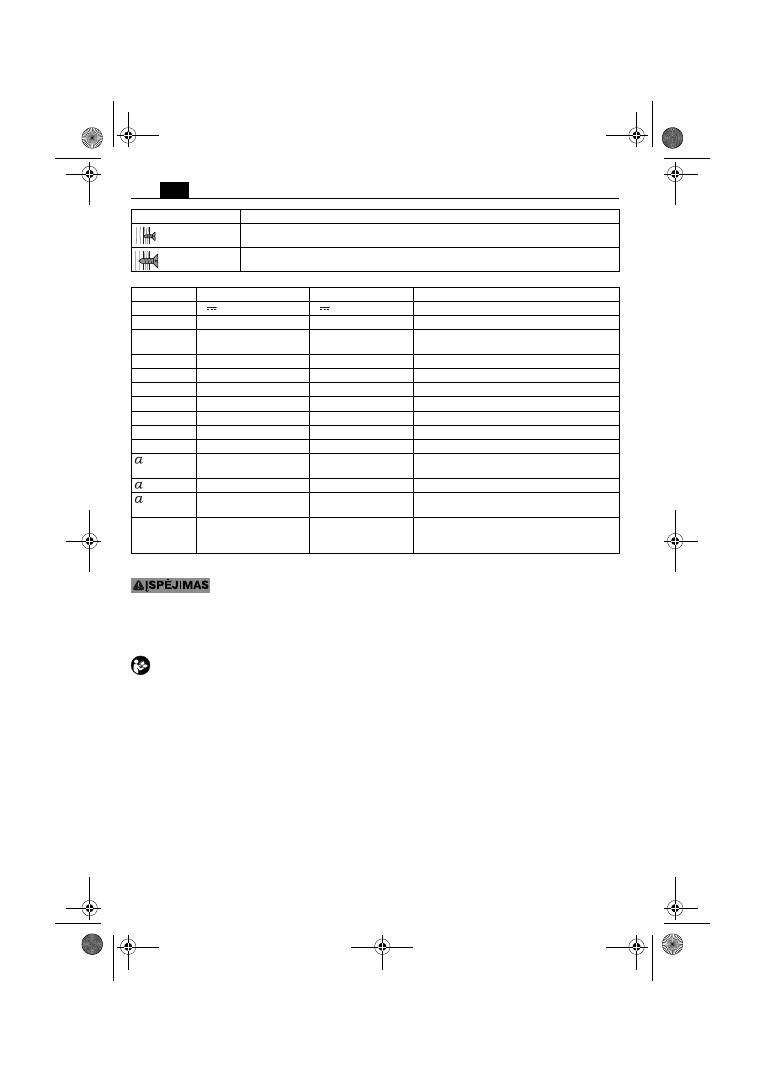
114
lt
Jūsų saugumui.
Perskaitykite visas saugos
nuorodas ir reikalavimus.
Nesilaikant saugos nuorodų ir reikalavimų gali trenkti
elektros smūgis, kilti gaisras, galima susižaloti ar sužaloti
kitus asmenis.
Išsaugokite šią instrukciją, kad ir ateityje galėtumėte ja
pasinaudoti.
Nepradėkite naudoti šio elektrinio įrankio, kol
atidžiai neperskaitėte ir gerai nesupratote šios
naudojimo instrukcijos bei pridėtų „Bendrųjų
saugos nuorodų“ (leidinio numeris 3 41 30 054 06 1).
Išsaugokite išvardytus dokumentus, kad ir ateityje
galėtumėte jais pasinaudoti, ir atiduokite juos kartu su
elektriniu įrankiu, jei perduodate ar parduodate jį kitam
savininkui.
Taip pat laikykitės specialiųjų nacionalinių darbo saugos
reikalavimų.
Elektrinio įrankio paskirtis:
ABS14, ABS18:
Rankomis valdomas gręžtuvas-suktuvas, skirtas varžtams
įsukti bei išsukti ir veržlėms užveržti bei atsukti, taip pat
gręžti metalą, medieną, plastiką, keramiką ir varžtus šiose
medžiagose įsukti ir sriegti sriegius su FEIN aprobuotais
darbo įrankiais ir papildoma įranga be vandens tiekimo
nuo atmosferos poveikio apsaugotoje aplinkoje.
ASB14, ASB18:
Rankomis valdomas smūginis gręžtuvas-suktuvas, skirtas
varžtams įsukti bei išsukti ir veržlėms užveržti bei atsukti,
gręžti metalą, medieną, plastiką, keramiką ir varžtus šiose
medžiagose įsukti, sriegti sriegius ir gręžti su smūgiu
betoną, akmenį ir plytas su FEIN aprobuotais darbo
įrankiais ir papildoma įranga be vandens tiekimo nuo
atmosferos poveikio apsaugotoje aplinkoje.
Specialiosios saugos nuorodos.
Jei atliekate darbus, kurių metu varžtas gali kliudyti
paslėptus elektros laidus, tai elektrinį įrankį laikykite už
izoliuotų rankenų.
Prisilietus prie laido, kuriuo teka
elektros srovė, metalinėse prietaiso dalyse gali atsirasti
įtampa ir trenkti elektros smūgis.
Atkreipkite dėmesį į paslėptus elektros laidus, dujų
vamzdynus ir vandentiekio vamzdžius.
Prieš pradėdami
dirbti, darbo sritį patikrinkite, pvz., metalo ieškikliu.
Dirbkite su asmeninėmis apsaugos priemonėmis.
Atitinkamai pagal atliekamą darbą užsidėkite viso veido
apsaugos priemones, akių apsaugos priemones ar
apsauginius akinius. Jei nurodyta, užsidėkite apsauginį
respiratorių nuo dulkių, klausos apsaugos priemones,
apsaugines pirštines ir specialią prijuostę, kuri apsaugos
jus nuo smulkių šlifavimo ir ruošinio dalelių.
Akys turi
būti apsaugotos nuo skriejančių svetimkūnių,
atsirandančių atliekant įvairius darbus. Respiratorius arba
apsauginė kaukė turi išfiltruoti darbo metu kylančias
dulkes. Dėl ilgalaikio ir stipraus triukšmo poveikio galite
prarasti klausą.
Sukimo momentą mažinti
Sukimo momentą didinti
Ženklas
Tarptautinis vienetas
Nacionalinis vienetas
Paaiškinimas
U
V
V
Elektros nuolatinė įtampa
f
Hz
Hz
Dažnis
n
0
/min, min
-1
, rpm, r/min
/min
Tuščiosios eigos sūkių skaičius
(kai akumuliatorius visiškai įkrautas)
n
S
/min, min
-1
/min
Smūgių skaičius
M...
Nm
Nm
Sukimo momentas (standžioji/tamprioji jungtis)
Ø
mm
mm
Apskritos dalies skersmuo
L
pA
dB
dB
Garso slėgio lygis
L
wA
dB
dB
Garso galios lygis
L
pCpeak
dB
dB
Aukščiausias garso slėgio lygis
K...
Paklaida
m/s
2
m/s
2
Vibracijos emisijos vertė pagal EN 60745
(trijų krypčių atstojamasis vektorius)
h,D
m/s
2
m/s
2
Vidutinė vibracijos vertė, gręžiant metalą
h,ID
m/s
2
m/s
2
Vidutinė vibracijos vertė, gręžiant su smūgiu
betoną
m, s, kg, A, mm, V,
W, Hz, N, °C, dB,
min, m/s
2
m, s, kg, A, mm, V,
W, Hz, N, °C, dB,
min, m/s
2
Tarptautinės matavimo vienetų sistemos
SI
baziniai ir išvestiniai vienetai.
Simbolis, ženklas
Paaiškinimas
OBJ_BUCH-0000000105-001.book Page 114 Thursday, April 4, 2013 10:23 AM
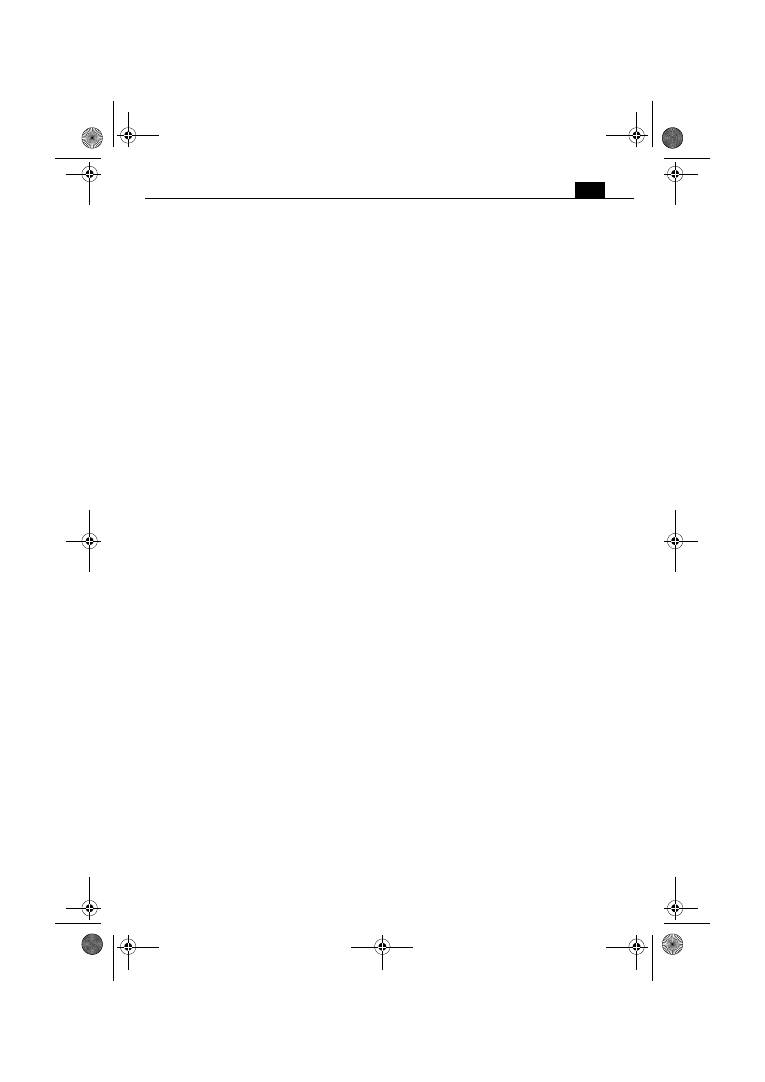
115
lt
Gręždami su smūgiu dėvėkite klausos apsaugos
priemones.
Dėl triukšmo poveikio galima prarasti klausą.
Įtvirtinkite ruošinį.
Saugiau dirbti, kai ruošinys įtvirtintas
veržimo įrangoje nei laikomas rankoje.
Tvirtai laikykite elektrinį įrankį.
Galimas trumpalaikis
didelis reakcijos jėgų momentas.
Neapdorokite medžiagų, kurių sudėtyje yra asbesto.
Asbestas yra vėžį sukelianti medžiaga.
Draudžiama prie elektrinio įrankio prisukti ar prikniedyti
lenteles ar ženklus.
Pažeista izoliacija neapsaugo nuo
elektros smūgio. Naudokite klijuojamuosius ženklus.
Nenaudokite jokios papildomos įrangos, kurios specialiai
nesukūrė arba neaprobavo elektrinio įrankio gamintojas.
Tai, kad papildomą įrangą galima pritvirtinti prie įrankio,
nereiškia, kad bus saugu naudoti.
Nemetaliniais įrankiais reguliariai valykite elektrinio
įrankio ventiliacines angas.
Variklio ventiliatorius į
korpusą traukia dulkes. Jei metalo dulkių prisirenka per
daug, iškyla elektros smūgio pavojus.
Niekada iš arti nežiūrėkite į elektrinio įrankio lempos
šviesą. Lempos šviesos niekada nenukreipkite į kitų
netoli esančių žmonių akis.
Apšvietimo priemonės
sukurta spinduliuotė gali būti kenksminga akims.
Nenukreipkite elektrinio įrankio į save, kitus asmenis,
gyvūnus.
Aštrūs ir įkaitę darbo įrankiai kelia sužalojimo
pavojų.
Akumuliatoriaus (akumuliatorių bloko)
naudojimas.
Kad dirbdami su akumuliatoriais išvengtumėte
nudegimo, gaisro, sprogimo, odos sužalojimo ir kitokių
pavojų, laikykitės šių nuorodų:
Akumuliatorius išardyti, atidaryti ar pjaustyti
draudžiama. Saugokite akumuliatorius nuo mechaninių
smūgių.
Pažeidus akumuliatorių ar netinkamai jį
naudojant, gali susidaryti kenksmingi garai ir ištekėti
skystis. Garai gali sudirginti kvėpavimo takus. Ištekėjęs
akumuliatoriaus skystis gali sudirginti arba nudeginti odą.
Jei iš pažeisto akumuliatoriaus ištekėjęs skystis apliejo
šalia esančius daiktus, užterštas dalis patikrinkite,
nuvalykite arba, jei reikia, pakeiskite.
Saugokite akumuliatorių nuo karščio ir ugnies.
Nelaikykite akumuliatoriaus tiesioginiuose saulės
spinduliuose.
Akumuliatorių iš originalios pakuotės išimkite tik tada,
kai jį reikia naudoti.
Prieš pradėdami elektrinio įrankio priežiūros ar remonto
darbus, išimkite iš jo akumuliatorių.
Netikėtai įsijungus
elektriniam įrankiui, iškyla sužalojimo pavojus.
Akumuliatorių išimkite tik tada, kai elektrinis įrankis
išjungtas.
Akumuliatorius saugokite nuo vaikų.
Akumuliatorių laikykite švarų ir apsaugotą nuo drėgmės
bei vandens.
Užterštas akumuliatoriaus ir elektrinio
įrankio jungtis nuvalykite sausu, švariu skudurėliu.
Naudokite tik nepažeistus originalius FEIN akumuliatorius,
skirtus jūsų elektriniam įrankiui.
Dirbant su netinkamais,
pažeistais, remontuotais, perdarytais, falsifikuotais ar kitų
gamintojų akumuliatoriais arba tokius akumuliatorius
kraunant, iškyla gaisro ir (arba) sprogimo pavojus.
Laikykitės akumuliatoriaus kroviklio naudojimo
instrukcijoje pateiktų saugos nuorodų.
Plaštakas ir rankas veikianti vibracija
Šioje instrukcijoje pateiktas vibracijos lygis buvo
išmatuotas pagal EN 60745 normoje standartizuotą
matavimo metodą, ir lyginant elektrinius įrankius jį galima
naudoti. Jis skirtas vibracijos poveikiui laikinai įvertinti.
Nurodytas vibracijos lygis atspindi pagrindinius elektrinio
įrankio naudojimo atvejus. Tačiau jeigu elektrinis įrankis
naudojamas kitokiai paskirčiai, su kitokiais darbo įrankiais
arba jeigu jis nepakankamai techniškai prižiūrimas,
vibracijos lygis gali kisti. Tokiu atveju vibracijos poveikis
per visą darbo laikotarpį gali žymiai padidėti.
Norint tiksliai įvertinti vibracijos poveikį, reikia atsižvelgti
ir į laiką, per kurį prietaisas buvo išjungtas arba, nors ir
veikė, bet nebuvo naudojamas. Tai įvertinus, vibracijos
poveikis per visą darbo laiką žymiai sumažės.
Dirbančiajam nuo vibracijos poveikio apsaugoti paskirkite
papildomas apsaugos priemones, pvz.: elektrinių ir darbo
įrankių techninę priežiūrą, rankų šildymą, darbo eigos
organizavimą.
Kaip elgtis su kenksmingomis dulkėmis
Šiuo įrankiu apdorojant medžiagas susidaro dulkės.
Pavojingos gali būti dulkės, pvz., asbesto ir medžiagų,
kurių sudėtyje yra asbesto, dažų, kurių sudėtyje yra švino,
metalų, kai kurių rūšių medienos, mineralų, medžiagų,
kurių sudėtyje yra uolienų, silikato dalelių, dažų tirpiklių,
medienos apsaugos priemonių, neapaugančių dažų.
Įkvėpus tokių dulkių ir nuo sąlyčio su tokiomis dulkėmis
gali kilti alerginės reakcijos, kvėpavimo takų ligos, vėžiniai
susirgimai ir vaisingumo sutrikimai. Rizika, kylanti įkvėpus
dulkių, priklauso nuo dulkių koncentracijos darbo
vietoje. Naudokite esamoje situacijoje tinkamą įrangą
susidarančioms dulkėms nusiurbti bei asmenines
apsaugos priemones ir pasirūpinkite geru vėdinimu darbo
vietoje. Medžiagas, kurių sudėtyje yra asbesto, apdoroti
patikėkite specialistams.
Medienos ir lengvųjų metalų dulkės, karšti šlifavimo
dulkių ir cheminių medžiagų mišiniai, esant nepalankioms
sąlygoms, gali savaime užsidegti ar sukelti sprogimą.
Saugokite, kad kibirkščių srautas nebūtų nukreiptas į
dulkių surinkimo dėžutę, kad elektrinis įrankis ir
šlifuojamas ruošinys neįkaistų; laiku ištuštinkite dulkių
surinkimo dėžutę, laikykitės ruošinio gamintojo pateiktų
apdorojimo nuorodų bei jūsų šalyje galiojančių
atitinkamų medžiagų apdorojimo taisyklių.
Valdymo nuorodos.
Sukimosi krypties perjungiklį ir greičių perjungiklį
perjunkite tik tada, kai variklis neveikia.
Greičių perjungiklį stumkite ir veikimo režimų perjungiklį
(ASB14/18) sukite visada iki atramos. Priešingu atveju
galite pažeisti elektrinį įrankį.
Jei perkraunamas, elektrinis įrankis išsijungia savaime.
Sukimosi krypties perjungiklį nustatykite į vidurinę
padėtį, kad, pvz., transportuodami, išvengtumėte
netikėto įjungimo.
OBJ_BUCH-0000000105-001.book Page 115 Thursday, April 4, 2013 10:23 AM
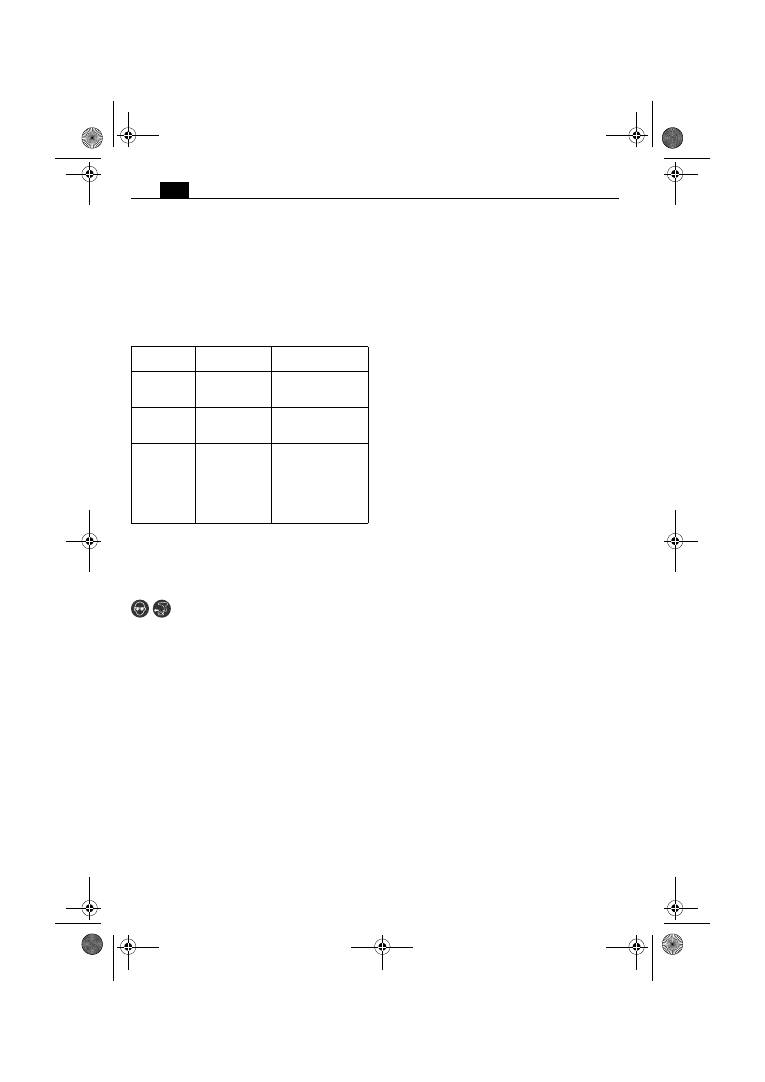
116
lt
Sukimo momento nustatymas
Gamykloje nustatytas sukimo momentas skirtas mažiems
ir vidutinio dydžio varžtams sukti.
Užveržimo momentas taip pat priklauso nuo jėgos, kuria
elektrinis įrankis spaudžiamas į varžtą.
Kaip elgtis su akumuliatoriumi.
Akumuliatorių naudokite ir kraukite tik akumuliatoriaus
temperatūrai esant eksploatavimo temperatūros ribose
nuo 0 °C iki 45 °C (nuo 32 °F iki 113 °F). Akumuliatoriaus
temperatūra įkrovimo operacijos pradžioje turi būti
eksploatavimo temperatūros ribose.
Tikroji akumuliatoriaus įkrovos būklė procentais rodoma
tik esant sustabdytam elektrinio įrankio varikliui.
Nustačius, kad netrukus akumuliatorius visiškai išsikraus,
elektroninis įtaisas automatiškai išjungia variklį.
Techninė priežiūra ir remonto dirbtuvės.
Esant ekstremalioms eksploatavimo sąlygoms,
apdorojant metalus elektrinio įrankio viduje
gali susikaupti laidžių dulkių. Elektrinio įrankio
vidų per ventiliacines angas dažnai prapūskite sausu
suslėgtu oru, kuriame nėra alyvos.
Šio elektrinio įrankio atsarginių dalių naujausią sąrašą
rasite internete www.fein.com.
Šias dalis, jei reikia, galite pakeisti patys:
darbo įrankius, akumuliatorių
Įstatyminė garantija ir savanoriška
gamintojo garantija.
Gaminiui įstatyminė garantija suteikiama pagal šalyje,
kurioje buvo pateiktas rinkai, galiojančius įstatyminius
aktus. Be to, FEIN suteikia garantiją pagal FEIN gamintojo
garantinį raštą.
Jūsų elektrinio įrankio tiekiamame komplekte gali būti tik
dalis šioje naudojimo instrukcijoje aprašytos ar
pavaizduotos papildomos įrangos.
Atitikties deklaracija.
Firma FEIN savo atsakomybės ribose patvirtina, kad šis
produktas atitinka šios instrukcijos paskutiniame
puslapyje nurodytus specialiuosius reikalavimus.
Techninė byla laikoma: C. & E. FEIN GmbH, C-DB_IA,
D-73529 Schwäbisch Gmünd
Aplinkosauga, šalinimas.
Pakuotės, nebetinkami naudoti elektriniai įrankiai ir
papildoma įranga turi būti perdirbami aplinkai
nekenksmingu būdu.
Utilizuoti atiduokite tik išsikrovusius akumuliatorius.
Jei akumuliatoriai nėra visiškai išsikrovę, kad
apsaugotumėte nuo trumpojo jungimo, kištukines jungtis
izoliuokite lipniąja juosta.
Šviesadiodis
indikatorius
Reikšmė
Operacija
1 – 4 žali
šviesadiodžiai
indikatoriai
Procentinė
įkrova
Eksploatavimas
Raudona
nuolatinė
šviesa
Akumuliatorius
beveik
išsikrovęs
Akumuliatorių
įkraukite
Raudona
mirksinti
šviesa
Akumuliatorius
nėra paruoštas
naudoti
Palaukite, kol
akumuliatoriaus
temperatūra pasieks
eksploatavimo
temperatūros ribas,
ir akumuliatorių
įkraukite
OBJ_BUCH-0000000105-001.book Page 116 Thursday, April 4, 2013 10:23 AM
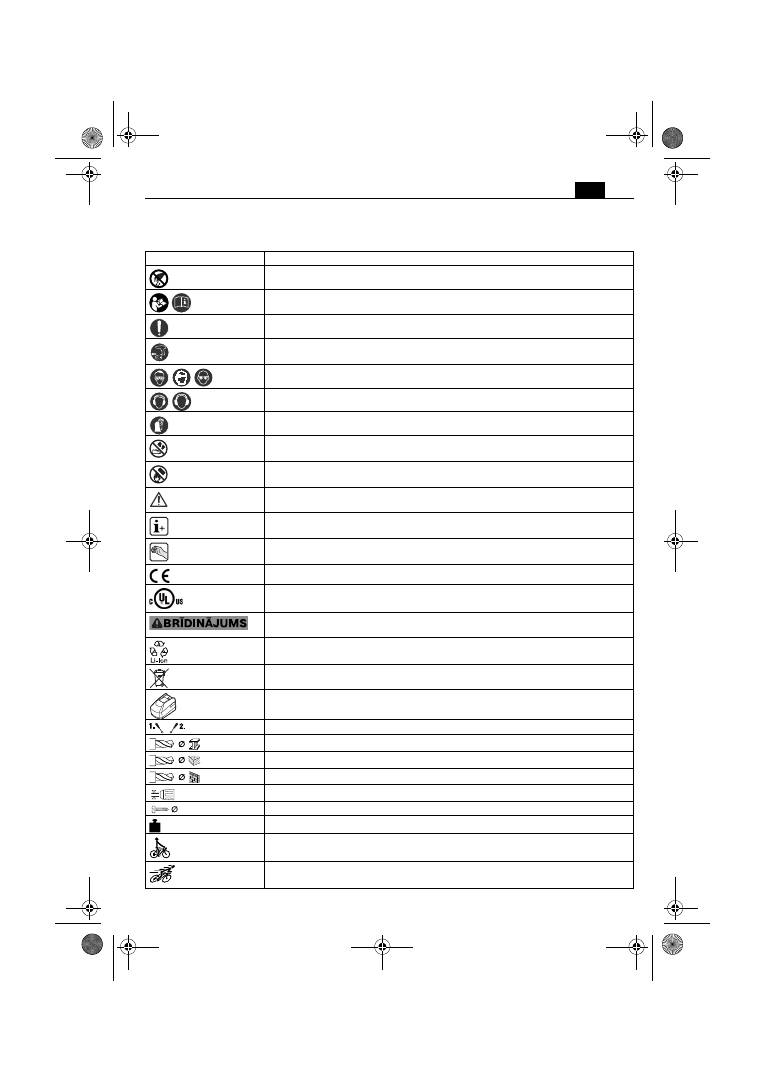
117
lv
lv
Oriģinālā lietošanas pamācība.
Lietotie simboli, saīsinājumi un jēdzieni.
Simbols, apzīmējums
Izskaidrojums
Nepieskarieties elektroinstrumenta rotējošajām daļām.
Noteikti izlasiet izstrādājumam pievienotos dokumentus, tai skaitā lietošanas pamācību
un vispārējos drošības noteikumus.
Ievērojiet blakusesošajā tekstā vai grafiskajā attēlā sniegtos norādījumus!
Pirms šīs darba operācijas izņemiet akumulatoru no elektroinstrumenta. Pretējā
gadījumā elektroinstruments var pēkšņi sākt darboties, radot savainojumus.
Darba laikā izmantojiet ierīces acu aizsardzībai.
Darba laikā izmantojiet ierīces ausu aizsardzībai.
Darba laikā izmantojiet roku aizsargu.
Nemēģiniet uzlādēt bojātus akumulatorus.
Neievietojiet akumulatoru ugunī. Sargājiet akumulatoru no karstuma, piemēram, no
ilgstošas atrašanās saules staros.
Ievērojiet blakusesošajā tekstā sniegtos norādījumus!
Papildu informācija.
Noturvirsma
Šis apzīmējums norāda uz elektroinstrumenta atbilstību Eiropas Kopienas direktīvām.
Šis simbols liecina, ka izstrādājums ir sertificēts ASV un Kanādā.
Šis norādījums ir saistīts ar iespējamu bīstamu situāciju, kas var izraisīt smagu
savainojumu vai pat nāvi.
Reciklēšanas zīme: šādi tiek apzīmēti atkārtoti pārstrādājamie materiāli.
Nolietotie elektroinstrumenti, kā arī citi elektrotehniskie un elektriskie izstrādājumi
jāsavāc atsevišķi un jānogādā otrreizējai pārstrādei apkārtējai videi nekaitīgā veidā.
Akumulatora tips
1. pārnesums/2. pārnesums
Urbumu diametrs tēraudā
Urbumu diametrs kokā
Urbumu diametrs akmenī
Urbjpatronas aptverspēja
Skrūvju diametrs
Svars atbilstoši EPTA-Procedure 01/2003
Neliels griešanās ātrums
Liels griešanās ātrums
Fe
OBJ_BUCH-0000000105-001.book Page 117 Thursday, April 4, 2013 10:23 AM
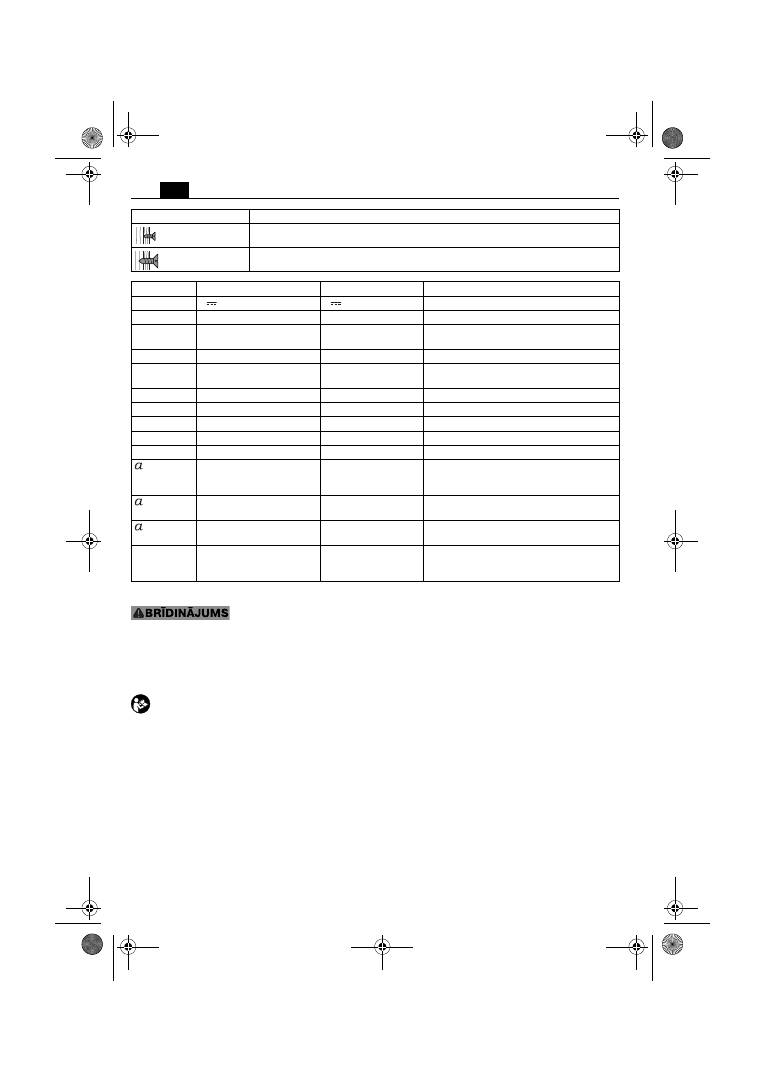
118
lv
Jūsu drošībai.
Uzmanīgi izlasiet visus
drošības noteikumus un
norādījumus.
Drošības noteikumu un norādījumu
neievērošana var radīt priekšnoteikumus elektriskajam
triecienam, izraisīt aizdegšanos un/vai būt par cēloni
smagam savainojumam.
Uzglabājiet drošības noteikumus un norādījumus
turpmākai izmantošanai.
Nelietojiet šo elektroinstrumentu, pirms uzmanīgi
un ar pilnīgu izpratni nav izlasīta šī lietošanas
pamācība, kā arī tai pievienotie „Vispārējie drošības
noteikumi“ (izdevuma numurs 3 41 30 054 06 1).
Uzglabājiet minētos pavaddokumentus turpmākai
izmantošanai un elektroinstrumenta tālāknodošanas vai
pārdošanas gadījumā nododiet tos jaunajam īpašniekam.
Ievērojiet arī spēkā esošos nacionālos darba aizsardzības
likumdošanas aktus.
Elektroinstrumenta pielietojums:
ABS14, ABS18:
ar roku vadāma urbjmašīna-skrūvgriezis, kas paredzēta
skrūvju ieskrūvēšanai un izskrūvēšanai, uzgriežņu
pieskrūvēšanai un atskrūvēšanai, urbšanai un skrūvēšanai
metālā, kokā, plastmasā un keramikā, kā arī vītņu
iegriešanai, izmantojot darbinstrumentus un piederumus,
kuru lietošanu atļāvusi firma FEIN, un strādajot bez ūdens
pievadīšanas apstrādes vietai no nelabvēlīgiem laika
apstākļiem pasargātās vietās.
ASB14, ASB18:
ar roku vadāma urbjmašīna-skrūvgriezis, kas paredzēta
skrūvju ieskrūvēšanai un izskrūvēšanai, uzgriežņu
pieskrūvēšanai un atskrūvēšanai, urbšanai un skrūvēšanai
metālā, kokā, plastmasā un keramikā, kā arī vītņu
iegriešanai un triecienurbšanai betonā, akmenī un ķieģeļu
mūrī, izmantojot darbinstrumentus un piederumus, kuru
lietošanu atļāvusi firma FEIN un strādajot bez ūdens
pievadīšanas apstrādes vietai no nelabvēlīgiem laika
apstākļiem pasargātās vietās.
Īpašie drošības noteikumi.
Veicot darbu, kura laikā ieskrūvējamā skrūve var skart
slēptus elektriskos vadus, turiet instrumentu tikai aiz
izolētajām virsmām.
Darbinstrumentam skarot
spriegumnesošus vadus, spriegums var nonākt arī uz
elektroinstrumenta metāla daļām un kļūt par cēloni
elektriskajam triecienam.
Ievērojiet piesardzību, strādājot vietās, kuru tuvumā var
būt slēpti elektriskie vadi, kā arī gāzes vai ūdens
cauruļvadi.
Pirms darba pārbaudiet šādas vietas,
izmantojot, piemēram metālmeklētāju.
Lietojiet individuālos darba aizsardzības līdzekļus.
Atkarībā no veicamā darba rakstura izvēlieties pilnu sejas
aizsargu, noslēdzošās aizsargbrilles vai parastās aizsarg-
brilles. Lai aizsargātos no lidojošajām slīpēšanas darb-
instrumenta un apstrādājamā materiāla daļiņām, pēc
vajadzības lietojiet putekļu aizsargmasku, ausu aizsargus
Griezes momenta samazināšana
Griezes momenta palielināšana
Apzīmējums
Starptautiskā mērvienība
Nacionālā mērvienība
Izskaidrojums
U
V
V
Elektriskais līdzspriegums
f
Hz
Hz
Frekvence
n
0
/min, min
-1
, rpm, r/min
/min
Griešanās ātrums brīvgaitā (ar pilnīgi uzlādētu
akumulatoru)
n
S
/min, min
-1
/min
Triecienu biežums
M...
Nm
Nm
Griezes moments (cietam/mīkstam
skrūvēšanas režīmam)
Ø
mm
mm
Apaļās daļas diametrs
L
pA
dB
dB
Trokšņa spiediena līmenis
L
wA
dB
dB
Trokšņa jaudas līmenis
L
pCpeak
dB
dB
Trokšņa spiediena pīķa vērtību līmenis
K...
Izkliede
m/s
2
m/s
2
Vibrācijas paātrinājuma vērtība atbilstoši
standartam EN 60745 (vektoru summa trim
virzieniem)
h,D
m/s
2
m/s
2
Vidējais svārstību paātrinājums, veicot
urbšanu metālā
h,ID
m/s
2
m/s
2
Vidējais svārstību paātrinājums, veicot
triecienurbšanu betonā
m, s, kg, A, mm, V,
W, Hz, N, °C, dB,
min, m/s
2
m, s, kg, A, mm, V,
W, Hz, N, °C, dB,
min., m/s
2
Pamata un atvasinātās mērvienības atbilst
starptautiskajai mērvienību sistēmai
SI
.
Simbols, apzīmējums
Izskaidrojums
OBJ_BUCH-0000000105-001.book Page 118 Thursday, April 4, 2013 10:23 AM

119
lv
un aizsargcimdus vai arī īpašu priekšautu.
Lietotāja acis
jāpasargā no lidojošajiem svešķermeņiem, kas dažkārt
rodas darba gaitā. Putekļu aizsargmaskai vai respiratoram
jāpasargā lietotāja elpošanas ceļi no putekļiem, kas
veidojas darba laikā. Ilgstoši atrodoties stipra trokšņa
iespaidā, var rasties paliekoši dzirdes traucējumi.
Triecienurbšanas laikā nēsājiet ausu aizsargus.
Trokšņa
iedarbība var izraisīt dzirdes traucējumus.
Nostipriniet apstrādājamo priekšmetu.
Spīļierīcē
iestiprināts priekšmets ir apstrādājams daudz drošāk,
nekā tad, ja tas tiek turēts ar roku.
Stingri turiet elektroinstrumentu.
Darba gaitā uz
strādājošās personas rokām var īslaicīgi iedarboties
ievērojams griezes moments.
Neapstrādājiet materiālus, kas satur azbestu.
Tiek
uzskatīts, ka azbests izraisa vēzi.
Nav atļauts pie elektroinstrumenta pieskrūvēt vai
piekniedēt marķējuma plāksnītes un apzīmējumus.
Bojātā izolācija nenodrošina pietiekošu aizsardzību pret
elektrisko triecienu. Lietojiet uzlīmes.
Neizmantojiet piederumus, kas nav īpaši izstrādāti šim
elektroinstrumentam vai ieteikti lietošanai kopā ar to.
Piederuma drošu lietošanu vēl nenosaka apstāklis, ka to
var iestiprināt elektroinstrumentā.
Regulāri tīriet elektroinstrumenta ventilācijas atveres,
izmantojot nemetāla rīkus.
Dzinēja dzesēšanas
ventilators ievelk putekļus elektroinstrumenta korpusā.
Metāla putekļu uzkrāšanās korpusā var būt par cēloni
paaugstinātai elektrobīstamībai.
Neskatieties elektroinstrumenta apgaismošanas lampas
gaismā no neliela attāluma. Nevirziet apgaismošanas
lampas gaismu acīs citām tuvumā esošajām personām.
Apgaismošanas lampas radītais starojums var izrādīties
kaitīgs acīm.
Nevērsiet elektroinstrumentu pret sevi, citām personām
vai mājdzīvniekiem.
Asie vai karstie darbinstrumenti var
izraisīt savainojumus.
Akumulatoru (bloku) lietošana un pareiza
apiešanās ar tiem.
Lai nepieļautu aizdegšanos vai sprādzienu un novērstu
ādas apdegumus vai citus savainojumus, rīkojoties ar
akumulatoriem, ievērojiet šādus noteikumus:
Akumulatorus nedrīkst izjaukt, atvērt vai sadalīt.
Nepakļaujiet akumulatorus mehāniskiem triecieniem.
Bojājuma gadījumā vai nepareizas apiešanās dēļ no
akumulatora var izplūst veselībai kaitīgi tvaiki vai kodīgs
šķidrums. Tvaiki var izsaukt elpošanas ceļu kairinājumu.
Izplūdušais šķidrais akumulatora elektrolīts var izraisīt
ādas kairinājumu vai pat apdegumus.
Ja no bojāta akumulatora izplūdušais šķidrais elektrolīts
ir saslapinājis tuvumā esošus priekšmetus, pārbaudiet
un notīriet elektrolīta skartās daļas vai, ja nepieciešams,
nomainiet tās.
Neturiet akumulatoru karstumā, neievietojiet to ugunī.
Neturiet akumulatoru tiešā saules gaismā.
Uzsākot akumulatora lietošanu, izņemiet to no oriģinālā
iesaiņojuma.
Pirms elektroinstrumenta apkalpošanas izņemiet no tā
akumulatoru.
Ja elektroinstruments patvaļīgi sāk
darboties, tas var radīt savainojumus.
Izņemiet akumulatoru no elektroinstrumenta tikai laikā,
kad tas ir izslēgts.
Neļaujiet bērniem rīkoties ar akumulatoru.
Uzturiet akumulatoru tīru un sargājiet no mitruma un
ūdens.
Ja akumulatora vai elektroinstrumenta kontakti ir
kļuvuši netīri, notīriet tos ar sausu, tīru audumu.
Izmantojiet tikai nebojātus oriģinālos firmas FEIN
akumulatorus, kas ir piemēroti Jūsu
elektroinstrumentam.
Lietojot un uzlādējot
nepiemērotus, bojātus vai savu laiku nokalpojušus
akumulatorus, to pakaļdarinājumus un citu zīmolu
akumulatorus, tie var aizdegties vai sprāgt.
Ievērojiet drošības noteikumus, kas sniegtas uzlādes
ierīces lietošanas pamācībā.
Vibrācijas iedarbība uz rokām un delnām
Šajā pamācībā norādītais vibrācijas līmenis ir izmērīts
atbilstoši standartā EN 60745 noteiktajai procedūrai un
var tikt lietots elektroinstrumentu salīdzināšanai. To var
izmantot arī vibrācijas radītās papildu slodzes iepriekšējai
novērtēšanai.
Norādītais vibrācijas līmenis ir attiecināms uz
elektroinstrumenta galvenajiem pielietojuma veidiem. Ja
elektroinstruments tiek lietots netipiskiem mērķiem,
kopā ar netipiskiem darbinstrumentiem vai nav
vajadzīgajā veidā apkalpots, tā vibrācijas līmenis var
atšķirties no šeit norādītajām vērtībām. Tas var ievērojami
palielināt vibrācijas radīto papildu slodzi zināmam darba
laika posmam.
Lai precīzi izvērtētu vibrācijas radīto papildu slodzi
zināmam darba laika posmam, jāņem vērā arī laiks, kad
elektroinstruments ir izslēgts vai arī darbojas, taču faktiski
netiek izmantots paredzētā darba veikšanai. Tas var
ievērojami samazināt vibrācijas radīto papildu slodzi
zināmam darba laika posmam.
Veiciet papildu pasākumus, lai pasargātu strādājošo
personu no vibrācijas kaitīgās iedarbības, piemēram,
šādus: savlaicīgi veiciet elektroinstrumenta un
darbinstrumentu apkalpošanu, novērsiet roku atdzišanu
un pareizi plānojiet darbu.
Rīkošanās ar veselībai kaitīgiem putekļiem
Ar šā instrumenta palīdzību veicot darbības, kuru
rezultātā notiek materiāla daļiņu atdalīšanās, rodas
putekļi, kas var būt bīstami veselībai.
Saskaršanās ar dažu materiālu putekļiem vai to ieelpošana
var izraisīt alerģiskas reakcijas, elpošanas ceļu saslimšanas,
vēzi vai reproduktīvās sistēmas bojājumus; pie šādiem
materiāliem pieder azbests un to saturoši materiāli, svinu
saturošas krāsas, metāli, dažas koka sugas, minerāli,
akmens materiālos esošās silikāta daļiņas, krāsu
šķīdinātāji, koksnes konservanti un pretapaugšanas
līdzekļi, ar kuriem tiek apstrādātas ūdens
transportlīdzekļu zemūdens daļas. Saslimšanas riska
pakāpe ir atkarīga no putekļu ieelpošanas ilguma. Lietojiet
putekļu veidam atbilstošas uzsūkšanas ierīces un
individuālo aizsargaprīkojumu, kā arī parūpējieties par
labu ventilāciju darba vietā. Uzticiet azbestu saturošu
materiālu apstrādi tikai profesionāļiem.
OBJ_BUCH-0000000105-001.book Page 119 Thursday, April 4, 2013 10:23 AM
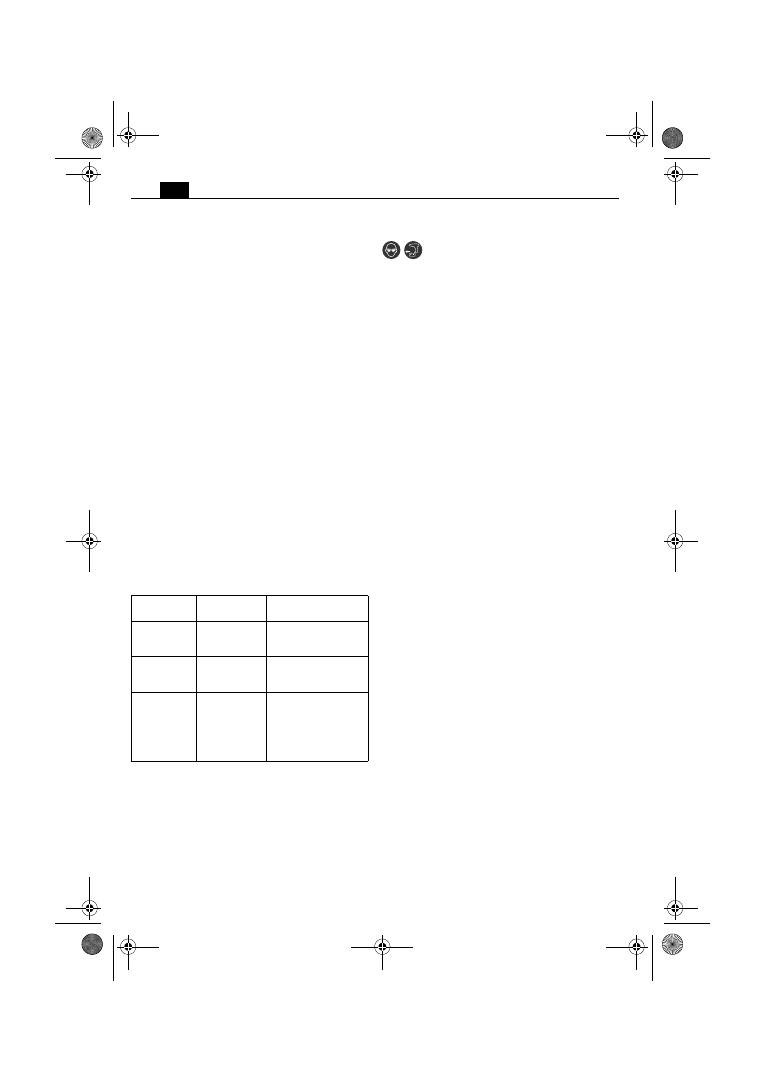
120
lv
Koka un vieglo metālu putekļi, kā arī karsts apstrādājamā
materiāla putekļu un dažu ķīmisko vielu maisījums
noteiktos nelabvēlīgos apstākļos var izraisīt aizdegšanos
vai sprādzienu. Nepieļaujiet dzirksteļu lidošanu putekļu
konteinera virzienā, kā arī elektroinstrumenta un
apstrādājamā materiāla pārkaršanu, savlaicīgi iztukšojiet
putekļu konteineru; ņemiet vērā apstrādājamā materiāla
ražotāja sniegtos norādījumus par materiāla apstrādi un
Jūsu valstī spēkā esošos priekšrakstus, kas attiecas uz
apstrādājamo materiālu.
Norādījumi lietošanai.
Pārvietojiet griešanās virziena pārslēdzēju un pārnesumu
pārslēdzēju tikai laikā, kad nedarbojas dzinējs.
Vienmēr līdz galam pārbīdiet pārnesumu pārslēdzēju vai
pagrieziet darba režīmu pārslēdzēju (ASB 14/18). Pretējā
gadījumā elektroinstruments var tikt bojāts.
Pārslodzes gadījumā elektroinstruments izslēdzas.
Lai novērstu instrumenta nejaušu ieslēgšanos, piemēram,
transportēšanas laikā, pārvietojiet griešanās virziena
pārslēdzēju vidējā stāvoklī.
Griezes momenta iestatīšana
Ražotājrūpnīcā tiek iestatīts elektroinstrumenta griezes
moments, kas piemērots nelielu un vidēja izmēra skrūvju
ieskrūvēšanai.
Skrūvju pievilkšanas moments ir atkarīgs arī no spēka, ar
kādu elektroinstruments tiek piespiests skrūvei.
Apiešanās ar akumulatoru.
Lietojiet un uzlādējiet akumulatoru tikai tad, ja tā
temperatūra atrodas darba temperatūras diapazona
robežās, kas ir 0 °C – 45 °C (32 °F – 113 °F). Akumulatora
temperatūrai jātrodas darba temperatūras diapazona
robežās jau uzlādes procesa sākumā.
Akumulatora uzlādes pakāpes patiesā procentuālā vērtība
tiek parādīta tikai pie izslēgta elektroinstrumenta dzinēja.
Akumulatora dziļās uzlādes gadījumā elektroniskais
mezgls automātiski izslēdz elektroinstrumenta dzinēju.
Uzturēšana darba kārtībā un klientu
apkalpošanas dienests.
Ekstremālos darba apstākļos, izmantojot
elektroinstrumentu metāla apstrādei, tā
korpusa iekšpusē var uzkrāties strāvu vadoši
putekļi. Pietiekoši bieži caur ventilācijas atverēm izpūtiet
elektroinstrumenta iekšpusi ar sausu, saspiestu gaisu, kas
nesatur eļļu.
Šā elektroinstrumenta aktuālais rezerves daļu saraksts ir
atrodams interneta vietnē www.fein.com.
Vajadzības gadījumā lietotājs var saviem spēkiem
nomainīt šādas daļas:
nomaināmos darbinstrumentus, akumulatoru
Garantija.
Garantija izstrādājumam tiek noteikta atbilstoši spēkā
esošajai tās valsts likumdošanai, kurā izstrādājums ir ticis
laists pārdošanā. Bez tam firma FEIN nosaka
izstrādājumam garantiju atbilstoši FEIN garantijas
deklarācijai.
Elektroinstrumenta piegādes komplektā var netikt
iekļautas visas šajā lietošanas pamācībā aprakstītās un
attēlotās daļas.
Atbilstības deklarācija.
Firma FEIN ar pilnu atbildību deklarē, ka šis izstrādājums
atbilst šīs lietošanas pamācības pēdējā lappusē minētajām
spēkā esošajām direktīvām.
Tehniskā dokumentācija no: C. & E. FEIN GmbH,
C-DB_IA, D-73529 Schwäbisch Gmünd
Vides aizsardzība, atbrīvošanās no
nolietotajiem izstrādājumiem.
Nolietotie elektroinstrumenti, to iesaiņojums un
piederumi jānogādā otrreizējai pārstrādei apkārtējai videi
nekaitīgā veidā.
Akumulatori jānogādā otrreizējai pārstrādei tikai izlādētā
stāvoklī.
Ja akumulatori nav pilnīgi izlādēti, tie jāpasargā no
iespējama īsslēguma, pārlīmējot pāri kontaktiem līmlenti.
Mirdzdiodes
indikators
Nozīme
Darbība
1 – 4 zaļās
mirdzdiodes
Norāda
procentuālo
uzlādes pakāpi
Cēlonis
Sarkanā
mirdzdiode
deg pastāvīgi
Akumulators
ir gandrīz
izlādēts
Uzlādējiet
akumulatoru
Sarkanā
mirdzdiode
mirgo
Akumulators
nav gatavs
darbam
Nogaidiet, līdz
akumulatora
temperatūra atgriežas
darba temperatūras
diapazona robežās, un
tad to uzlādējiet
OBJ_BUCH-0000000105-001.book Page 120 Thursday, April 4, 2013 10:23 AM
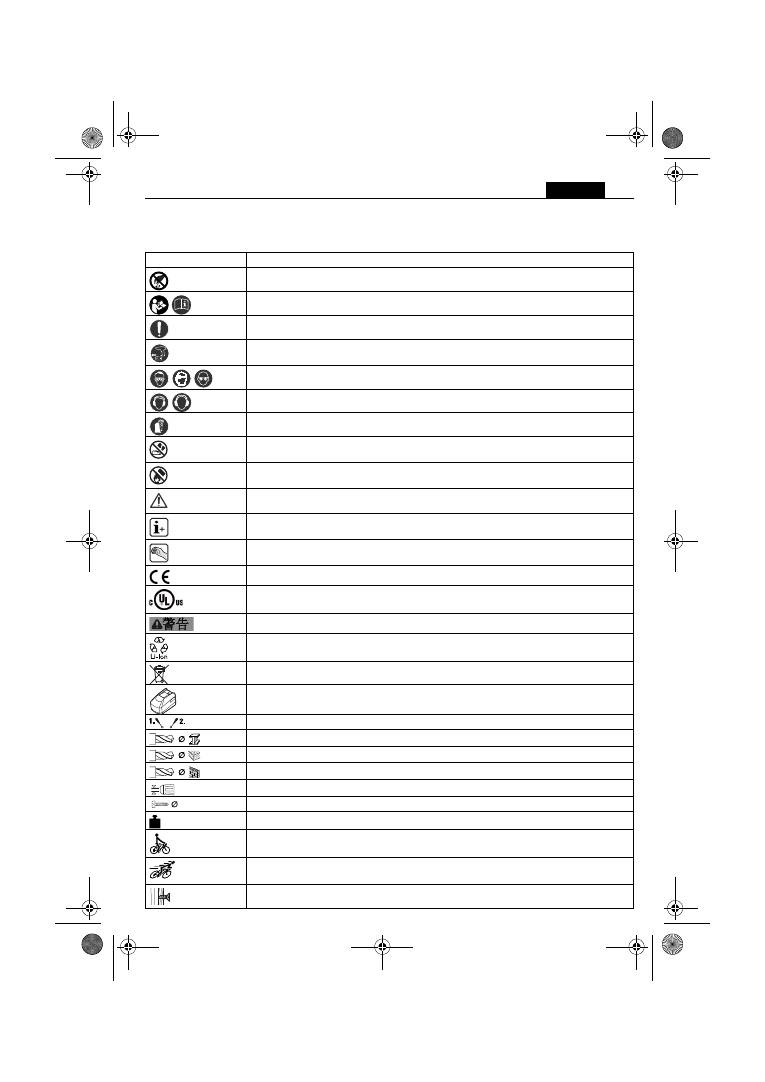
121
zh (CM)
zh (CM)
正本使用说明书。
使用的符号,缩写和代名词。
符号,图例
解说
不可以触摸电动工具的转动部件。
务必阅读附带的文件,例如使用说明书以及一般性的安全提示。
请遵循旁边文字或插图的指示!
进行这个步骤前先从电动工具上取出蓄电池。否则可能因为不小心启动电动工具而造成伤害。
工作时必须戴上护目镜。
工作时必须戴上耳罩。
工作时要戴上工作手套。
不可以为损坏的蓄电池充电。
不可以把蓄电池抛入火中。 蓄电池不可以靠近高温,例如 避免长期日照。
请留意注文上的提示!
附加资讯。
握持部位
证明此电动工具符合欧洲共同体的规定标准。
此标志证实本产品在美国和加拿大完成认证。
本提示指出潜伏的危险状况。它们可能导致严重的伤害甚至造成死亡。
回收图案:标明可以再利用的物料
分开收集损坏的电动工具,电子和电动产品,並且以符合环保要求的方式回收可利用的资源。
蓄电池类型
1 档 /2 档
在钢材上的钻孔直径
在木材上的钻孔直径
在石材上的钻孔直径
夹头夹紧范围
螺丝直径
重量符合 EPTA-Procedure 01/2003 的规定
小转速
大转速
缩小扭力
Fe
OBJ_BUCH-0000000105-001.book Page 121 Thursday, April 4, 2013 10:23 AM
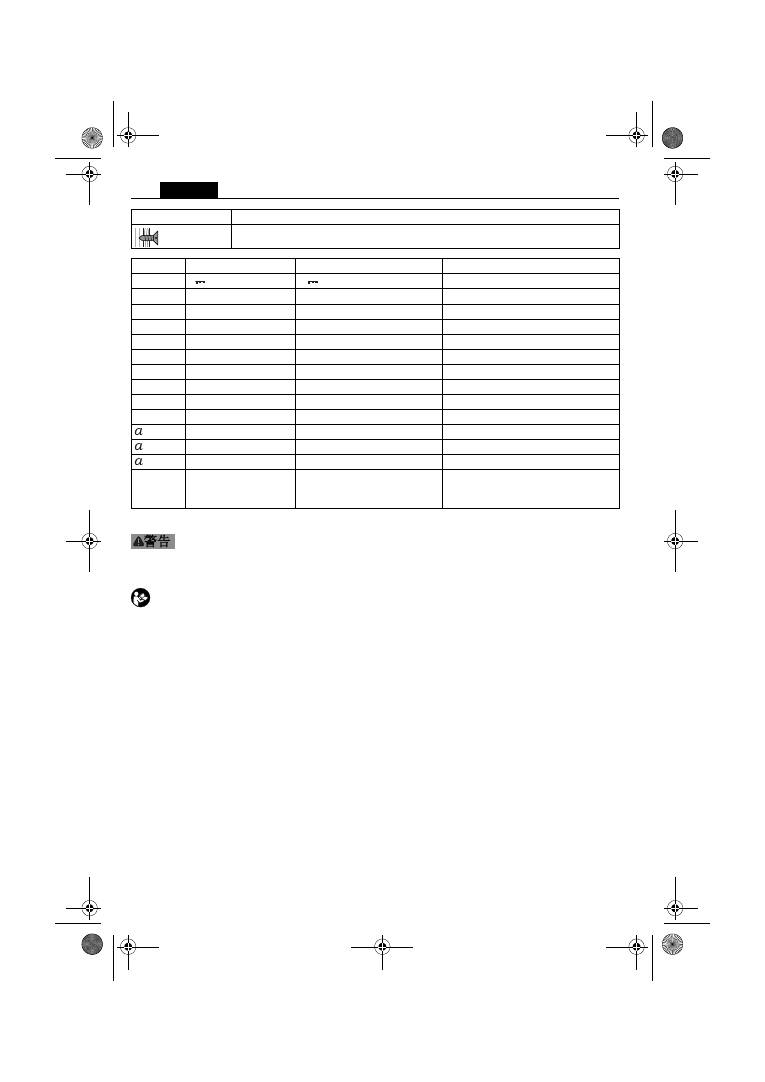
122
zh (CM)
有关您的安全。
阅读所有的安全规章和指示。如未遵循安全规
章和指示,可能遭受电击,产生火灾和 / 或造
成严重伤害。
妥善保存所有的安全规章和指示以便日后查阅。
详细阅读並彻底了解本使用说明书和附带的
" 一般性安全规章 " (书目码 3 41 30 054 06 1)
后,才可以使用本电动工具。妥善保存上述文件以方便日
后查阅。赠送或贩卖本电动工具时,务必把这些文件转交
给受赠者或买主。
同时也要注意各国有关的工作安全规定。
电动工具的用途:
ABS14, ABS18:
手提式电钻起子机,如果安装了 FEIN 许可的安装件和附
件,便可以在能够遮蔽风雨的工作场所操作。它可以拧入 /
拧出螺丝和螺母,也可以在金属,木材,塑料和陶制品上
钻孔及拧转螺丝,另外还可以攻丝。
ASB14, ASB18:
手提式冲击电钻起子机,如果安装了 FEIN 许可的安装件
和附件,便可以在能够遮蔽风雨的工作场所操作。它可以
拧入 / 拧出螺丝和螺母,也可以在金属,木材,塑料和陶
制品上钻孔及拧转螺丝,另外还可以使用本机器攻丝以及
在混凝土,石头和砖头上进行冲击钻孔。
特殊的安全指示。
工作时如果电动起子机可能割断隐藏的电线, 一定 要握住
绝缘手柄操作机器。 电动起子机如果接触了带电的线路,
电动工具上的金属部件会导电,可能造成操作者触电。
注意隐藏的电线,瓦斯管和水管。 工作前必须先检查工作
范围,例如使用金属探测仪。
戴上防护用品。根据适用情况,使用面罩,安全护目镜或
安全眼镜。适用时,戴上防尘面具,听力保护器,手套和
能挡小磨料或工件碎片的工作围裙。 眼防护罩必须挡住各
种操作产生的飞屑。防尘面具或口罩必须能够过滤操作产
生的颗粒。长期暴露在高强度噪音中会引起失聪。
进行冲击钻孔时要佩戴护耳罩。 噪音可能影响您的听力。
固定好工件。 使用固定装置比用手更能够夹紧工件。
好好地握牢电动工具。 可能会出现短暂的高反应力矩。
不可以加工含石棉的物料。 石棉是致癌物质。
切勿使用螺丝或钉子在电动工具上固定铭牌和标签。 如果
破坏了机器的绝缘功能便无法防止电击。请使用自粘铭牌
或标签。
只能使用电动工具制造商特别设计和许可的附件。 即使能
够将其它的工具安装到本电动工具上,並不代表能够确保
操作安全。
定期使用非金属工具清洁电动工具的通风孔。 马达的风扇
会把灰尘吸入机壳中。机器内部如果堆积了大量的金属尘
容易造成触电。
不可以近距离的直视电动工具灯泡所发出的灯光。勿将灯
光对准在工地附近停留的旁观者眼睛。 照明装置投射的光
线可能有害眼睛。
电动工具不可以指向您自己,其他人或动物。 锋利或炙热
的安装工具可能造成伤害。
加大扭力
符号
国际通用单位
本国使用单位
解说
U
V
伏
电压
f
Hz
赫兹
频率
n
0
/min, min
-1
, rpm, r/min
/ 分钟
空转转速 (使用完全充电的蓄电池)
n
S
/min, min
-1
/ 分钟
冲击次数
M...
Nm
牛顿米
扭力 ( 硬 / 软连接 )
Ø
mm
毫米
圆形零件的直径
L
pA
dB
分贝
声压水平
L
wA
dB
分贝
声功率水平
L
pCpeak
dB
分贝
最高声压水平
K...
不确定性系数
m/s
2
米 / 秒
2
振荡发射值根据 EN 60745 ( 三向矢量和 )
h,D
m/s
2
米 / 秒
2
在金属上钻孔时的平均振荡值
h,ID
m/s
2
米 / 秒
2
在混泥土上钻孔时的平均振荡值
m, s, kg, A, mm, V,
W, Hz, N, °C, dB,
min, m/s
2
米 , 秒 , 公斤 , 安培 , 毫米 , 伏特 ,
瓦 , 赫兹 , 牛顿 , 摄氏 , 分贝 ,
分 , 米 / 秒
2
国际性单位系统 SI 中的标准单位和引用
单位。
符号,图例
解说
OBJ_BUCH-0000000105-001.book Page 122 Thursday, April 4, 2013 10:23 AM

123
zh (CM)
使用和处理蓄电池 (蓄电池块)。
为了避免使用蓄电池时可能发生的意外状况,例如起火,
火灾,爆炸,皮肤灼伤以及其它的伤害等,请注意以下的
指示:
不可以拆解,打开或缩小蓄电池。不可以让蓄电池遭受撞
击。 电池如果损坏了或者未按照规定使用蓄电池, 可能产
生蒸汽并 且渗出液体。这种蒸汽可能刺激呼吸道,蓄电池
渗出的液体会引起皮肤痒或造成皮肤灼伤。
如果从损坏的电池所渗出的液体沾湿了邻近的部件, 必须
检查被沾污的部件,清洁这些部件,必要的话得更换它
们。
不可以让蓄电池遭受高温或火焰的侵害。 不可以在直接的
日照下为蓄电池充电。
使用蓄电池时,才将它从原始包装中取出。
为电动工具做任何维修工作之前,必须从机器中取出蓄电
池。 如果电动工具被意外地启动了,可能造成伤害。
先关闭电动工具然後再取出蓄电池。
蓄电池必须远离儿童。
蓄电池必须保持清洁,并保护它免受湿气或水侵入。 使用
干燥清洁的布抹除蓄电池接头和电动工具接头上的污垢。
电动工具必须配上
FEIN
原厂蓄电池一起使用。 使用以下的
蓄电池和替以下的蓄电池充电有火灾和 / 或爆炸的危险:
不苻的电池 , 已经损坏的电池,经过修理或改装过的电池,
仿冒品和其它品牌的电池。
遵循充电器的使用说明书中的安全规章。
手掌 - 手臂 - 震动
本说明书中引用的震动水平,是采用 EN 60745 中规定的
测量方式所测得。这个震动水平值可以作为电动工具之间
的比较标准。您也可以拿它来推测机器目前的震动受荷状
况。
此震动水平只适用在以电动工具进行规定的用途时。如果
未按照规定使用电动工具,在机器上安装了不合适的工
具,或者未确实执行机器的维修工作,实际的震动水平会
异于提供的震动水平。因此在操作过程结束后,机器的震
动受荷状况会明显提高。
为了准确地评估机器的震动受荷状况,还必须考虑以下的
时间因素:例如关机的时间或机器空转待命的时间等。如
果把整个工作过程中累加的关机或待命时间列入考虑,则
可以明显地降低机器的震动受荷状况。
为了保护操作者免受机器震动危害,必须另外采行防护措
施,例如:做好电动工具和安装工具的维修工作,手掌要
保持温暖,安排好工作的流程。
处理对身体有危害的废尘
使用本机器锯削时可能会产生有害健康的废尘。
接触或呼吸了某些废尘,例如:石棉尘和有石棉成分的废
尘,含铅的颜料尘,金属尘,某些种类的木尘,矿物尘,
研磨含矿物工件而产生的矽尘,含颜料稀释剂的废尘,含
木材保护剂的废尘以及含防腐蚀剂的废尘等,可能出现过
敏现象和 / 或造成呼吸道疾病,癌症以及影响生殖能力。
吸入废尘后的致病可能性,需视曝露在危尘中的程度而
定。操作机器时必须使用合适而且合格的吸尘装备,以及
佩戴个人的防护装备,另外也要保持工作场所的良好通风
状况。加工含石棉工件的工作必须交给专业人员执行。木
尘和轻建材尘,研磨热尘和化学材料的混合物,都可能在
特定状况下产生自燃或者造成爆炸。避免让火花喷向集尘
箱。防止电动工具和被研磨物过热。定时清倒集尘箱。注
意工件制造商所提出的有关加工时的注意事项,而且要兼
顾贵国有关加工该工件的法规。
操作指示。
等待马达完全静止之后才可以使用转向变换开关和换档开
关。
必须将换档开关推到底,而操作功能转换开关 (ASB14/18)
也要拧转到底。否则电动工具会受损。
过载时电动工具会自动关闭。
把转向变换开关调整在中央的位置,以避免无意间开动机
器,例如搬运机器时。
设定扭力
机器出厂时设定的范围相当於小螺丝到中型的大螺丝。
拧紧扭力也会受电动工具施加在螺丝上的力量影响。
正确地使用蓄电池
当蓄电池的温度位于操作温度范围 0 °C – 45 °C (32 °F –
113 °F) 内时,才可以使用蓄电池以及替蓄电池充电。在充
电初期,蓄电池的温度必须位于操作温度范围内。
蓄电池的充电进度是以百分比的方式显示,当电动工具的
马达停止运转时才能够显示充电实况。
在蓄电池即将进入过度放电的状况时,机器的电子装备会
自动关闭马达。
LED 指示灯 含意
措施
1 – 4 绿色
LED
电量现况的百
分比
操作
红色持续亮
着
蓄电池几乎没
电了
替蓄电池充电
红灯闪烁
无法使用蓄电
池
先让蓄电池的温度恢复
到蓄电池的操作温度范
围内,然后再替蓄电池
充电
OBJ_BUCH-0000000105-001.book Page 123 Thursday, April 4, 2013 10:23 AM
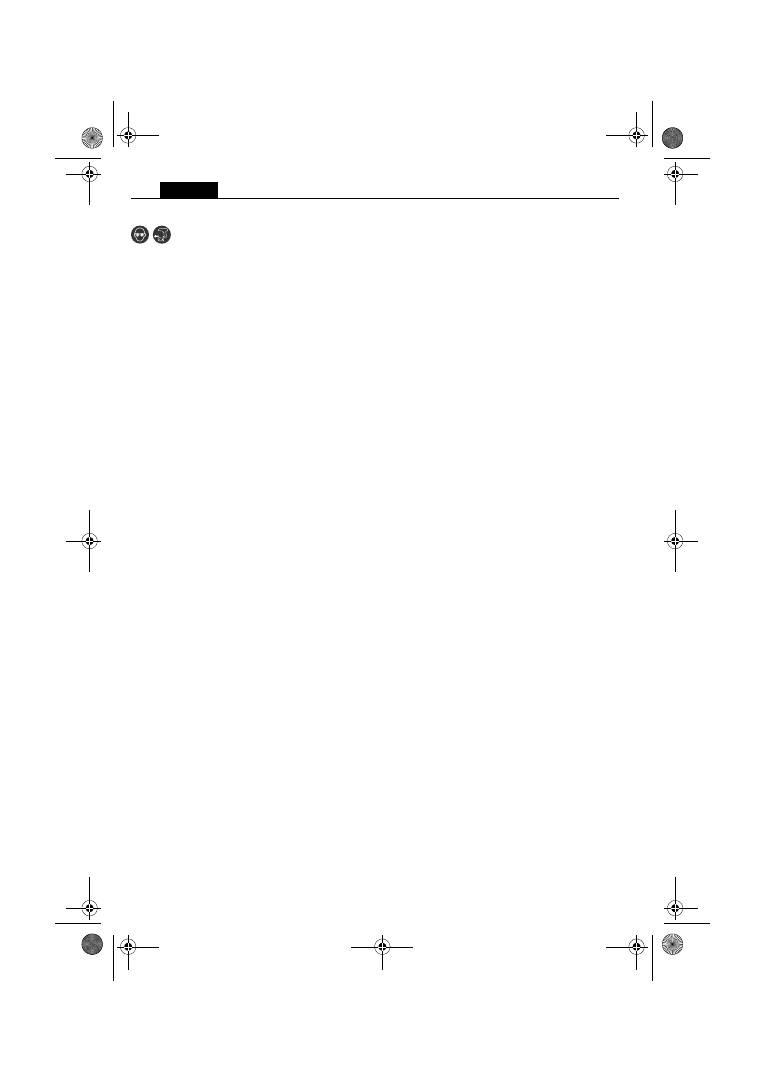
124
zh (CM)
维修和顾客服务。
在某些特殊的工作状况下, 例如加工金属物料
时 , 可能在机器内部堆积大量的金属废尘。 因此
必须经常使用干燥无油的压缩空气, 从机器的通气孔 吹除
电动工具内部的废尘。
从以下的网址 www.fein.com 可以找到本电动工具目前的
备件清单。
以下零件您可以根据需要自行更换 :
机器的安装工具 , 蓄电池
保修。
有关本产品的保修条件,请参考购买国的相关法律规定。
此外 FEIN 还提供制造厂商的保修服务。有关保修的细节,
请向您的专业经销商,FEIN 在贵国的代理或您的 FEIN 顾
客服务中心询问。
在本使用说明书上提到的和标示的附件,並非全部包含在
电动工具的供货范围中。
合格说明。
FEIN 公司单独保证,本产品符合说明书末页上所列出的各
有关规定的标准。
技术性文件存放在 : C. & E. FEIN GmbH, C-DB_IA,
D
-
73529 Schwäbisch Gmünd
环境保护和废物处理。
必须以符合环保要求的方式处理包装材料和废弃的电动工
具与附件。
放空蓄电池的电并根据规定处理待废弃的蓄电池。
如果蓄电池未完全放空电量, 为了安全的理由可以使用胶
带贴住蓄电池的触点 ,以防止发生短路。
OBJ_BUCH-0000000105-001.book Page 124 Thursday, April 4, 2013 10:23 AM
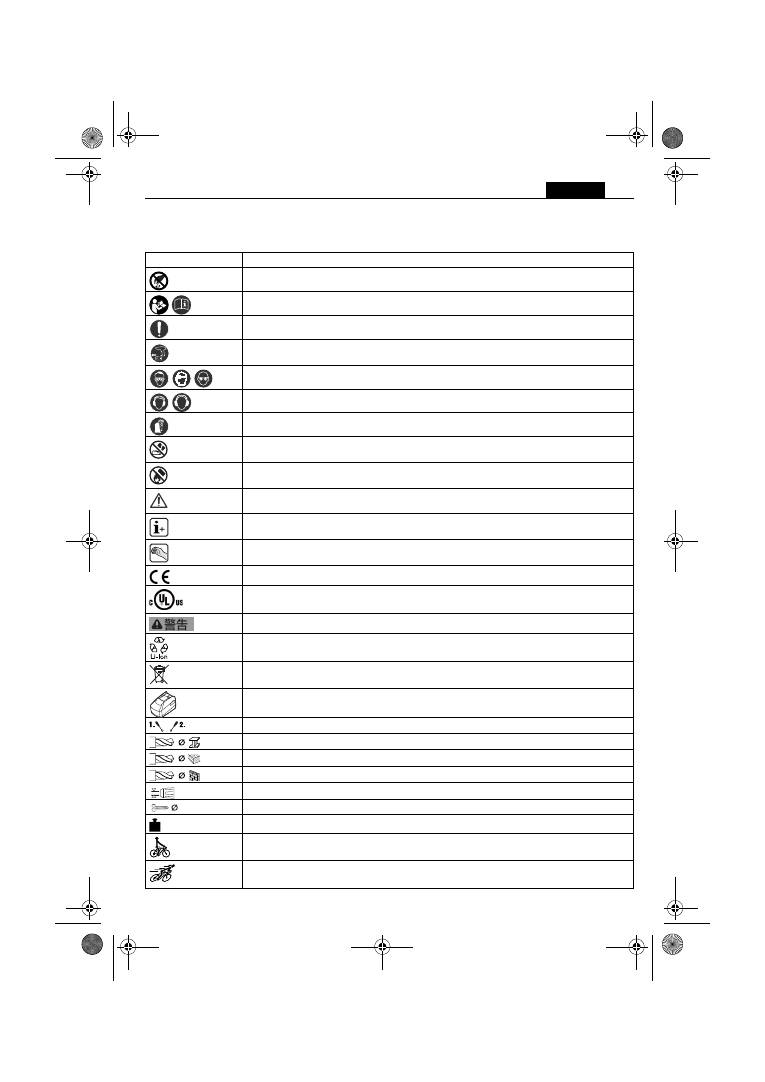
125
zh (CK)
zh (CK)
正本使用說明書。
使用的符號,縮寫和代名詞。
符號 , 圖例
解說
不可以觸摸電動工具的轉動部件。
必須閱讀附帶的文件,例如使用說明書以及一般性的安全提示。
請遵循旁邊文字或插圖的指示!
進行這個步驟前先從電動工具上取出蓄電池。否則可能因為不小心啟動電動工具而造成傷害。
工作時必須戴上護目鏡。
工作時必須戴上耳罩。
工作時要戴上工作手套。
不可以為損壞的蓄電池充電。
不可以把蓄電池拋入火中。蓄電池不可以靠近高溫,例如 避免長期日照。
請遵循注文上的指示!
附加資訊。
握持部位
證明此電動工具符合歐洲共同體的規定標準。
此標志證實本產品在美國和加拿大完成認證。
本標示提示潛伏的危險狀況。它們可能導致嚴重的傷害甚至造成死亡。
回收圖案:標明可以再利用的物料
分類收集已損壞的電動工具,電子和電動產品,並且以符合環保要求的方式回收 , 可使有用物
料循環再用。
蓄電池類型
1 檔 / 2 檔
在鋼材上的鑽孔直徑
在木材上的鑽孔直徑
在石材上的鑽孔直徑
夾頭夾緊範圍
螺絲直徑
重量符合 EPTA-Procedure 01/2003 的規定
慢速
快速
Fe
OBJ_BUCH-0000000105-001.book Page 125 Thursday, April 4, 2013 10:23 AM
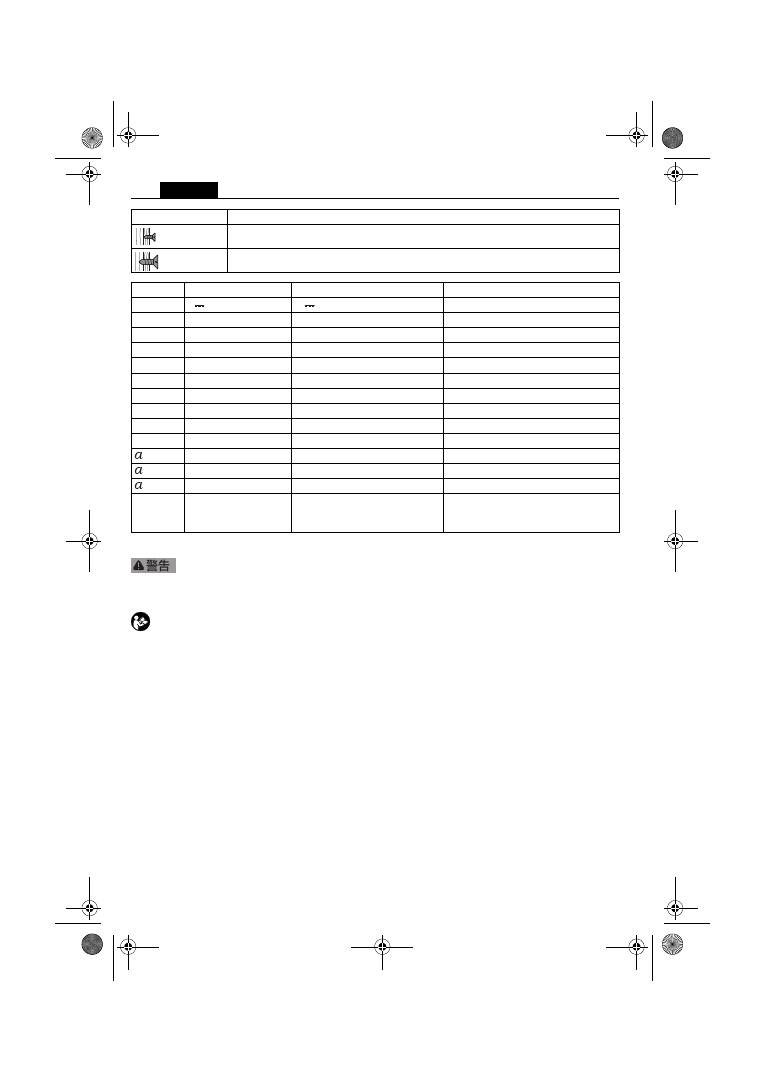
126
zh (CK)
有關您的安全。
閱讀所有的安全規章和指示。如未遵循安全
規章和指示,可能遭受電擊,產生火災和 /
或造成嚴重傷害。
妥善保存所有的安全規章和指示以便日后查閱。
詳細閱讀並徹底了解本使用說明書和附帶的
" 一般性安全規章 " (文件編號 3 41 30 054 06 1)
後,才可以使用本電動工具。妥善保存上述文件以方便日
后查閱。贈送或售賣本電動工具時,務必把這些文件轉交
給受贈者或用家。
同時也要注意各國有關的工作安全規定。
電動工具的用途 :
ABS14, ABS18:
手提式電鑽起子機,如果安裝了 FEIN 許可的安裝件和附
件,便可以在能夠遮蔽風雨的工作場所操作。它可以擰入 /
擰出螺絲和螺母,也可以在金屬,木材,塑料和陶制品上
鑽孔及擰轉螺絲,另外還可以攻絲。
ASB14, ASB18:
手提式衝擊電鑽起子機,如果安裝了 FEIN 許可的安裝件
和附件,便可以在能夠遮蔽風雨的工作場所操作。它可以
擰入 / 擰出螺絲和螺母,也可以在金屬,木材,塑料和陶
製品上鑽孔及擰轉螺絲,另外還可以使用本機器攻絲以及
在混凝土,石頭和磚頭上進行衝擊鑽孔。
特別安全說明。
工作時如果電動起子機可能割斷隱藏的電線, 一定要握住
絕緣手柄操作機器。 電動起子機如果接觸了帶電的線路,
電動工具上的金屬部件會導電,可能 成操作者觸電。
注意隱藏的電線,瓦斯管和水管。 工作前必須先檢查工作
範圍,例如使用金屬探測儀。
戴上防護用品。根據適用情況,使用面罩,安全護目鏡或
安全眼鏡。適用時,戴上防塵面具,聽力保護器,手套和
能擋小磨料或工件碎片的工作圍裙。 眼防護罩必須擋住各
種操作產生的飛屑。防塵面具或口罩必須能夠過濾操作產
生的顆粒。長期暴露在高強度噪音中會引起失聰。
進行衝擊鑽孔時要佩戴護耳罩。 噪音可能影響您的聽力。
固定好工件。 使用固定夾具或鉗台比用手持更能夠夾緊工
件。
穩固地握牢電動工具。 可能會出現短速的高反應力矩。
不可以加工含石棉的物料。 石棉是致癌物質。
切勿使用螺絲或鉚釘在電動工具上固定名牌和標籤。 如果
破壞了機器的絕緣功能便無法防止電擊。請使用自粘名牌
或標籤。
只能使用電動工具制造商特定設計和認可的附件。 即使能
夠將其它的工具安裝到本電動工具上, 並不代表能夠確保
操作安全。
定期使用非金屬工具清潔電動工具的通風孔。 馬達的風扇
會把灰塵吸入機殼中。機器內部如果堆積了大量的金屬塵
容易造成觸電。
縮小扭力
加大扭力
符號
國際通用單位
本國使用單位
解說
U
V
伏
電壓
f
Hz
赫茲
頻率
n
0
/min, min
-1
, rpm, r/min
/ 分鐘
空轉轉速 (使用完全充電的蓄電池)
n
S
/min, min
-1
/ 分鐘
衝擊次數
M...
Nm
牛頓米
扭力 ( 硬 / 軟連接 )
Ø
mm
毫米
圓形零件的直徑
L
pA
dB
分貝
聲壓水平
L
wA
dB
分貝
聲壓功率水平
L
pCpeak
dB
分貝
最高聲壓水平
K...
不確定系數
m/s
2
米 / 秒
2
振蕩發射值根據 EN 60745 ( 三向矢量和 )
h,D
m/s
2
米 / 秒
2
在金屬上鑽孔時的平均振蕩值
h,ID
m/s
2
米 / 秒
2
在混泥土上鑽孔時的平均振蕩值
m, s, kg, A, mm, V,
W, Hz, N, °C, dB,
min, m/s
2
米 , 秒 , 公斤 , 安培 , 毫米 , 伏特 ,
瓦 , 赫茲 , 牛頓 , 攝氏 , 分貝 ,
分 , 米 / 秒
2
國際性單位系統 SI 中的標準單位和引用
單位。
符號 , 圖例
解說
OBJ_BUCH-0000000105-001.book Page 126 Thursday, April 4, 2013 10:23 AM
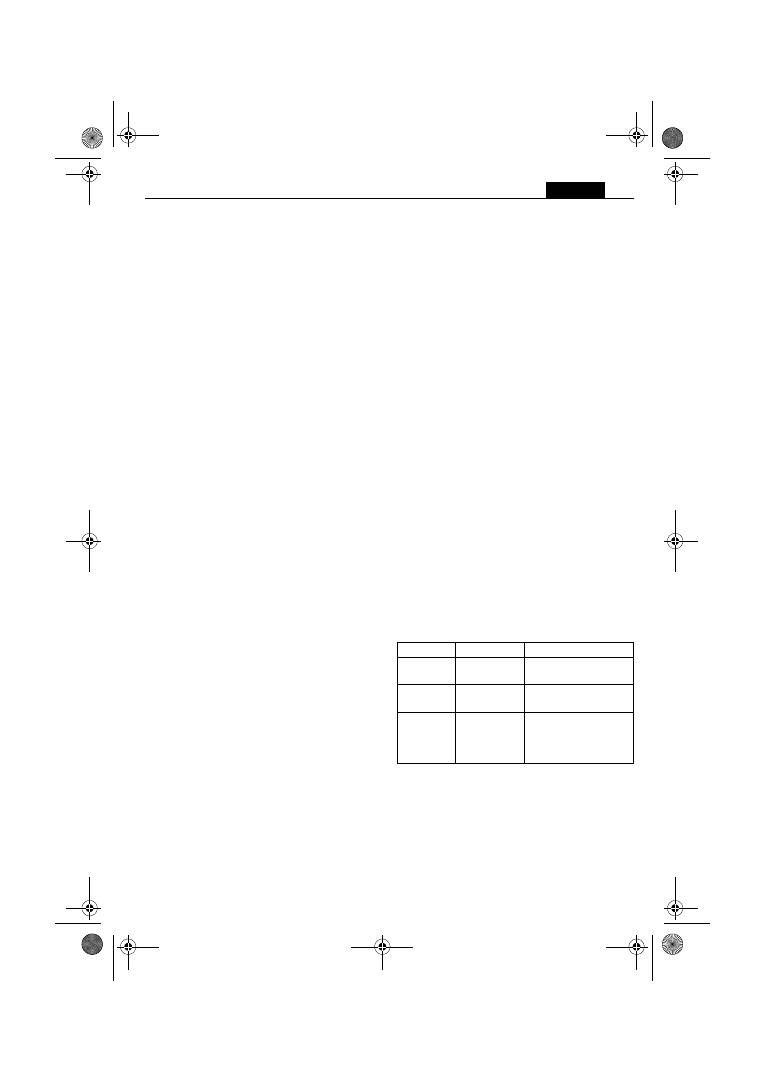
127
zh (CK)
不可以近距離的直視電動工具燈泡所發出的燈光。勿將燈
光對准在工地附近停留的旁觀者眼睛。 照明裝置投射的光
線可能有害眼睛。
電動工具不可以指向您自己,其他人或動物。 鋒利或炙熱
的安裝工具可能造成傷害。
使用和處理蓄電池 (蓄電池塊)。
為了避免使用蓄電池時可能發生的意外狀況,例如起火,
火災,爆炸,皮膚灼傷以及其它的傷害等,請注意以下的
指示:
不可以拆解,打開或縮小蓄電池。不可以讓蓄電池遭受撞
擊。 電池如果損壞了或者未按照規定使用蓄電池, 可能產
生蒸汽並 且滲出液體。 這種蒸汽可能刺激呼吸道,蓄電池
滲出的液體會引起皮膚癢或造成皮膚灼傷。
如果從損壞的電池所滲出的液體沾濕了鄰近的部件, 必須
檢查被沾污的部件,清潔這些部件,必要的話得更換它
們。
不可以讓蓄電池遭受高溫或火焰的侵害。 不可以在直接的
日照下為蓄電池充電。
使用蓄電池時,才將它從原始包裝中取出。
為電動工具做任何維修工作之前,必須從機器中取出蓄電
池。 如果電動工具被意外地啟動了,可能造成傷害。
先關閉電動工具然後再取出蓄電池。
蓄電池必須遠離兒童。
蓄電池必須保持清潔,並保護它免受濕氣或水侵入。 使用
干燥清潔的布抹除蓄電池接頭和電動工具接頭上的污垢。
電動工具必須配上 FEIN 原廠蓄電池一起使用。 使用以下
的蓄電池和替以下的蓄電池充電有火災和 / 或爆炸的危險:
不苻的電池 , 已經損壞的電池,經過修理或改裝過的電池,
仿冒品和其它品牌的電池。
遵循充電器的使用說明書中的安全規章。
手掌 - 手臂 - 震動
本說明書中引用的震動水平,是采用 EN 60745 中規定的
測量方式所測得。這個震動水平值可以作為電動工具之間
的比較標準。您也可以拿它來推測機器目前的震動受荷狀
況。
此震動水平只適用於電動工具規定的用途。如果未按照規
定使用電動工具,在機器上安裝了不合適的工具,或者未
確實執行機器的維修工作,實際的震動水平會異于提供的
震動水平。因此在操作過程結束后,機器的震動受荷狀況
會明顯提高。
為了準確地評估機器的震動受荷狀況,還必須考慮以下的
時間因素 ﹕ 例如關機的時間或機器空轉待命的時間等。如
果把整個工作過程中累加的關機或待命時間列入考慮,則
可以明顯地降低機器的震動受荷狀況。
為了保護操作者免受機器震動危害,必須另外采行防護措
施,例如 ﹕ 做好電動工具和安裝工具的維修工作,手掌要
保持溫暖,安排好工作的流程。
處理對身體有危害的廢塵
使用本機器鋸削時可能會產生有害健康的廢塵。
接觸或呼吸了某些廢塵,例如:石棉塵和有石棉成分的廢
塵,含鉛的顏料塵,金屬塵,某些種類的木塵,礦物塵,
研磨含礦物工件而產生的矽塵,含顏料稀釋劑的廢塵,含
木材保護劑的廢塵以及含防腐蝕劑的廢塵等,可能出現過
敏現像和 / 或造成呼吸道疾病,癌症以及影響生殖能力。
吸入廢塵後的致病可能性,需視曝露在危塵中的程度而
定。操作機器時必須使用合適而且合格的吸塵裝備,以及
佩戴個人的防護裝備,另外也要保持工作場所的良好通風
狀況。加工含石棉工件的工作必須交給專業人員執行。木
塵和輕建材塵,研磨熱塵和化學材料的混合物,都可能在
特定狀況下產生自燃或者造成爆炸。避免讓火花噴向集塵
箱。防止電動工具和被研磨物過熱。定時清倒集塵箱。注
意工件制造商所提出的有關加工時的注意事項,而且要兼
顧貴國有關加工該工件的法規。
操作指示。
等待馬達完全靜止之後才可以使用轉向變換開關和換檔開
關。
必須將換檔開關推到底,而操作功能轉換開關 (ASB14/18)
也要擰轉到底。否則電動工具會受損。
過載時電動工具會自動關閉。
把轉向變換開關調整在中央的位置,以避免無意間開動機
器,例如搬運機器時。
設定扭力
機器出廠時設定的範圍相當於小螺絲到中型的螺絲。
擰緊扭力也會受電動工具施加在螺絲上的力量影響。
正確地使用蓄電池。
當蓄電池的溫度位於操作溫度範圍 0 °C – 45 °C (32 °F –
113 °F) 內時,才可以使用蓄電池以及替蓄電池充電。在充
電初期,蓄電池的溫度必須位於操作溫度範圍內。
蓄電池的充電進度是以百分比的方式顯示,當電動工具的
馬達停止運轉時才能夠顯示充電實況。
在蓄電池即將進入過度放電的狀況時,機器的電子裝備會
自動關閉馬達。
LED 指示燈 含意
措施
1 – 4 綠色
LED
電量現況的百
分比
操作
紅色持續亮
著
蓄電池幾乎沒
電了
替蓄電池充電
紅燈閃爍
無法使用蓄電
池
先讓蓄電池的溫度恢復
到蓄電池的操作溫度範
圍內,然後再替蓄電池
充電
OBJ_BUCH-0000000105-001.book Page 127 Thursday, April 4, 2013 10:23 AM
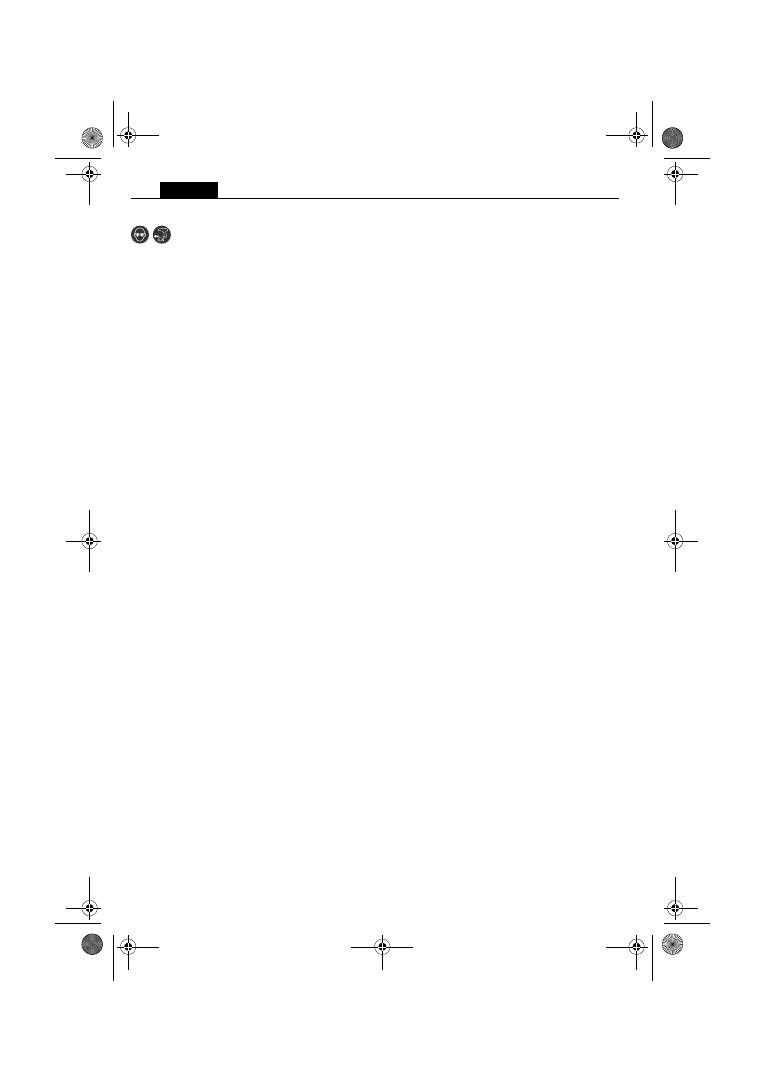
128
zh (CK)
維修和顧客服務。
在某些特殊的工作狀況下, 例如加工金屬物料
時 , 可能在機器內部堆積大量的金屬廢塵。 因此
必須經常使用干燥無油的壓縮空氣, 從機器的通氣孔 吹除
電動工具內部的廢塵。
從以下的網址 www.fein.com 可以找到本電動工具目前的
備件清單。
以下零件您可以根據需要自行更換 :
機器的安裝工具,蓄電池
保修。
有關本產品的保修條件,請參考購買國的相關法律規定。
此外 FEIN 還提供制造廠商的保修服務。有關保修的細節,
請向您的專業經銷商,FEIN 在貴國的代理或您的 FEIN 顧
客服務中心詢問。
在本使用說明書上提到的和標示的附件,並非全部包含在
電動工具的供貨範圍中。
合格說明。
FEIN 公司單獨保證,本產品符合說明書末頁上所列出的各
有關規定的標準。
技術性文件存放在 : C. & E. FEIN GmbH, C-DB_IA,
D
-
73529 Schwäbisch Gmünd
環境保護和廢物處理。
必須以符合環保要求的方式處理包裝材料和廢棄的電動工
具與附件。
放空蓄電池的電並根據規定處理待廢棄的蓄電池。
如果蓄電池未完全放空電量, 為了安全的理由可以使用膠
帶貼住蓄電池的觸點 ,以防止發生短路。
OBJ_BUCH-0000000105-001.book Page 128 Thursday, April 4, 2013 10:23 AM
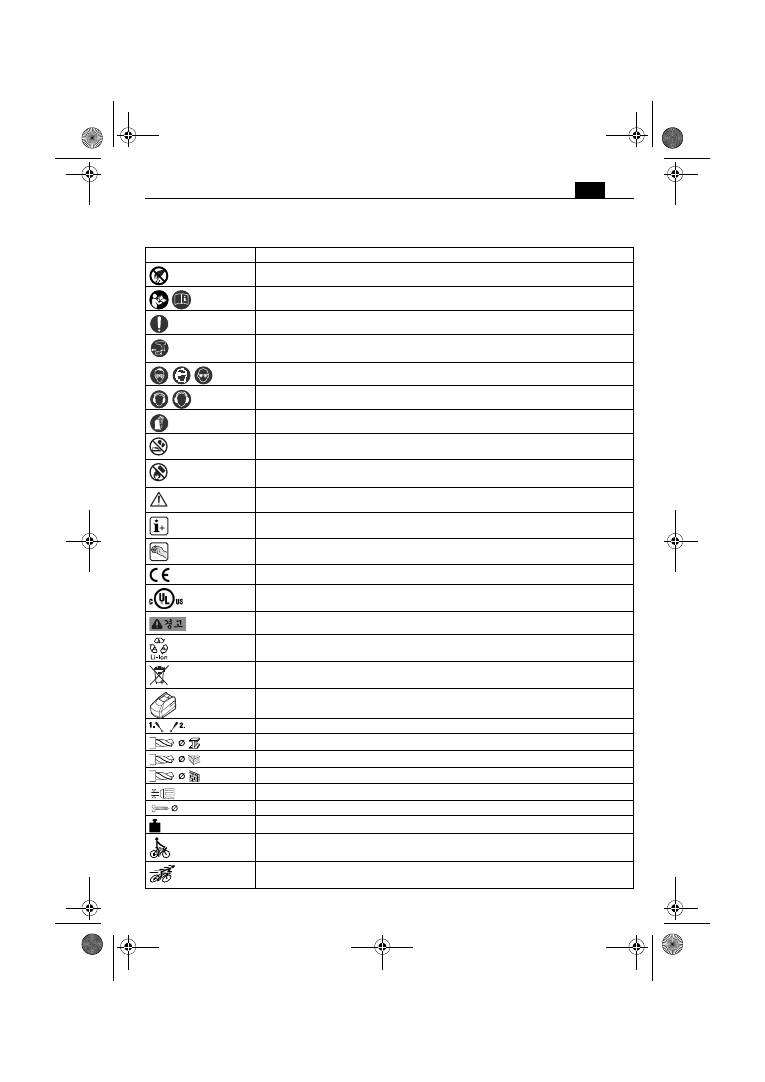
129
ko
ko
사용
설명서
원본
.
사용
기호
,
약어와
의미
.
기호
,
부호
설명
전동공구의
회전하는
부위를
만지지
마십시오
.
반드시
첨부되어
있는
사용
설명서와
일반
안전수칙을
읽으십시오
.
문장이나
그림에
나와있는
지시
사항을
반드시
준수하십시오
!
이
작업을
하기
전에
배터리를
전동공구에서
빼어
놓으십시오
.
그렇지
않으면
전동공구가
실
수로
작동하게
되어
상해를
입을
수
있습니다
.
작업할
때
보안경을
착용하십시오
.
작업할
때
귀마개를
사용하십시오
.
작업할
때
보호장갑을
착용하십시오
.
손상된
배터리는
충전하지
마십시오
.
배터리를
불에
가까이
두지
마십시오
.
배터리를
열에
노출되지
않도록
하고
또한
장시간
강
한
햇볕에
두지
마십시오
.
옆에
나와있는
사항을
준수해야
합니다
!
추가
정보
.
손잡이
면
전동공구가
EU (
유럽연합
)
해당
지침에
적합하다는
것을
증명합니다
.
이
표시는
본
제품이
미국과
캐나다에서
인가
받았음을
확인합니다
.
이
표시는
중상이나
사망을
유발할
수
있는
위험한
상황이
될
수
있다는
것을
나타냅니다
.
리사이클링
표시
:
재생
가능한
소재임을
나타냅니다
.
폐기용
전동공구와
기타
전기
및
전동
제품은
별도로
수거하여
환경
친화적인
방법으로
재생
할
수
있도록
해야
합니다
.
배터리
타입
1.
단
/2.
단
드릴
직경
,
철재
드릴
직경
,
목재
드릴
직경
,
석재
척
고정
부위
스크류
직경
EPTA-Procedure 01/2003
에
따른
중량
저속
고속
Fe
OBJ_BUCH-0000000105-001.book Page 129 Thursday, April 4, 2013 10:23 AM
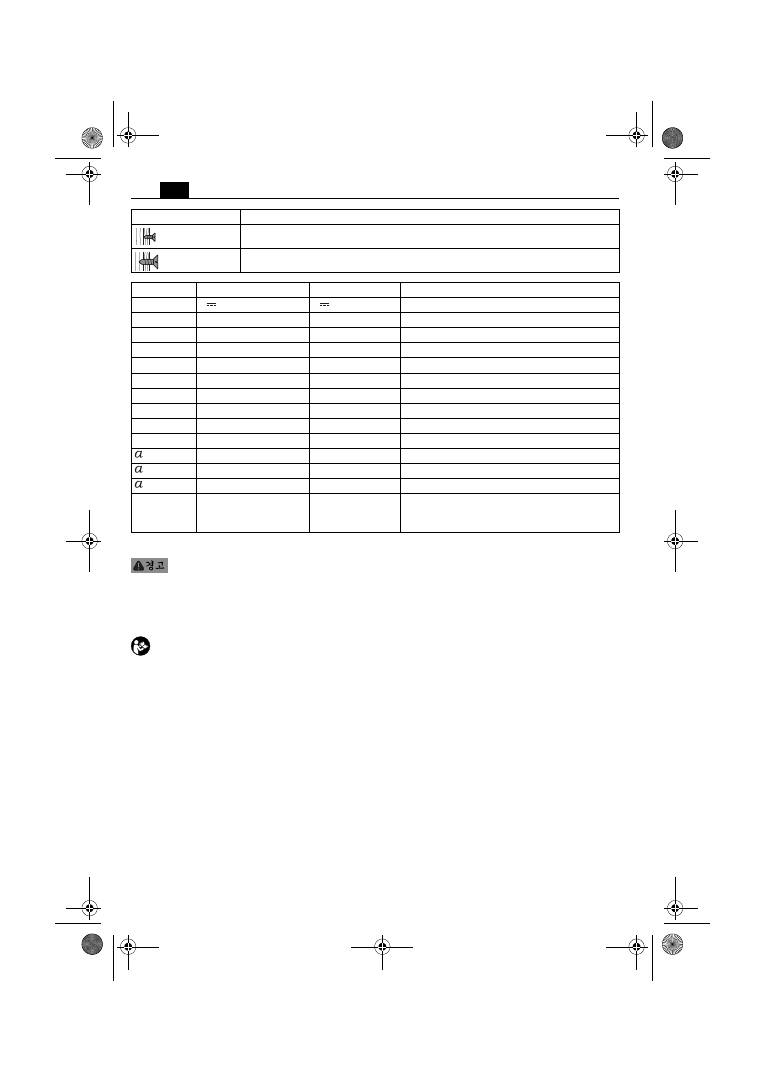
130
ko
안전
수칙
.
모든
안전
수칙과
지시
사항을
상세히
읽고
준수
해야
합니다
.
안전
수칙과
지시
사항을
지키지
않으면
화재
위험이
있으며
감전
혹은
중상을
입을
수
있습
니다
.
추후
참고용으로
모든
안전
수칙과
지시
사항을
잘
보관하
십시오
.
이
전동공구의
사용
설명서와
첨부된
“
일반
안전
수
칙
” (
문서
번호
3 41 30 054 06 1)
을
자세히
읽고
완
전히
이해한
후에
기기를
사용하십시오
.
나중에
사용할
경
우를
위해
위의
자료를
잘
보관하고
전동공구를
인도하거나
매각할
경우
설명서도
함께
전달하십시오
.
또한
국내의
해당
작업
안전
규정을
준수하십시오
.
전동공구의
사용
분야
:
ABS14, ABS18:
휴대용
충전
드릴
/
드라이버는
날씨와
관계
없는
환경에서
FEIN
사가
허용하는
비트와
액세서리를
사용하여
,
나사못
이나
너트를
조이고
푸는
작업
,
금속
,
목재
,
플라스틱
및
세
라믹에
드릴작업
및
스크류작업
,
그리고
나사산
절삭
(
태
핑
)
작업을
하는데
사용해야
합니다
.
ASB14, ASB18:
휴대용
충전
해머드릴은
날씨와
관계
없는
환경에서
FEIN
사가
허용하는
비트와
액세서리를
사용하여
,
나사못이나
너트를
조이고
푸는
작업
,
금속
,
목재
,
플라스틱
및
세라믹
에
드릴작업
및
스크류작업
,
나사산
절삭
(
태핑
)
작업
,
그
리고
콘크리트
,
석재
및
벽돌에
임팩트작업을
하는데
사용
해야
합니다
.
특별
안전
수칙
.
작업할
때
볼트로
보이지
않는
전선에
닿을
위험이
있으면
전동공구의
절연된
손잡이
면을
잡으십시오
.
전류가
흐르
는
전선에
닿게되면
기기의
금속
부위에도
전기가
통해
감
전될
수
있기
때문입니다
.
보이지
않는
부위에
있는
배선
및
배관
여부를
확인하십시
오
.
작업을
시작하기
전에
금속
탐지기
등을
사용하여
작업
분야를
점검하십시오
.
작업자는
보호장비를
착용해야
합니다
.
작업에
따라
안면
마스크나
보안경을
사용하십시오
.
필요한
경우
분진
마스
크
,
귀마개
,
보호장갑을
사용하고
연마로
인한
미세한
소재
분자에
접하게
되는
것을
방지하는
특수
작업용
애프런을
착용하십시오
.
다양한
작업을
할
때
공중에
떠다니는
이물
질로부터
눈을
보호해야
합니다
.
분진
마스크나
호흡
마스
크로
기기
사용
시
발생하는
분진을
여과해야
합니다
.
작업
자가
장기간
강한
소음
환경에서
작업하면
청력을
상실할
수도
있습니다
.
임팩트
드릴작업을
할
때
귀마개를
착용하십시오
.
소음의
영향으로
청각을
상실할
수
있습니다
.
작업물을
잘
고정하십시오
.
고정장치에
장착하여
작업하면
손으로
잡는
것보다
더
안전합니다
.
전동공구를
꽉
잡으십시오
.
갑자기
강한
반동력이
생길
수
있습니다
.
석면이
함유된
소재에
작업하지
마십시오
.
석면은
발암성
으로
간주됩니다
.
토크
하향
토크
상향
부호
국제
단위
국내
단위
설명
U
V
V
전기
직류
전압
f
Hz
Hz
주파수
n
0
/min, min
-1
, rpm, r/min
/min
무부하속도
(
완전히
충전된
배터리
경우
)
n
S
/min, min
-1
/min
타격률
M...
Nm
Nm
토크
(
경질
/
연질
시트의
스크류작업
)
Ø
mm
mm
원형
부품의
직경
L
pA
dB
dB
음압
레벨
L
wA
dB
dB
음향
레벨
L
pCpeak
dB
dB
최고
음압
레벨
K...
불확정성
m/s
2
m/s
2
EN 60745
에
따른
진동
방출치
(3
방향의
벡터값
)
h,D
m/s
2
m/s
2
금속에
드릴작업
시
평균
진동치
h,ID
m/s
2
m/s
2
콘크리트에
임팩트
드릴작업
시
평균
진동치
m, s, kg, A, mm, V,
W, Hz, N, °C, dB,
min, m/s
2
m, s, kg, A, mm, V,
W, Hz, N, °C, dB,
min, m/s
2
국제
단위
시스템
SI
의
기본
및
유도
단위
기호
,
부호
설명
OBJ_BUCH-0000000105-001.book Page 130 Thursday, April 4, 2013 10:23 AM

131
ko
레벨이나
표지를
전동공구에
스크류로
고정하거나
리벳으
로
접합하는
것은
금지되어
있습니다
.
절연장치가
파손되
면
감전될
위험이
있습니다
.
접착
레벨을
사용하십시오
.
전동공구
제조사가
특별히
개발하거나
허용하지
않은
액세
서리를
사용하지
마십시오
.
액세서리가
귀하의
전동공구에
맞는다고
해서
안전한
작동을
보장하는
것이
아닙니다
.
정기적으로
전동공구의
환기구를
비금속
공구를
사용하여
닦아
주십시오
.
전동
블로어로
인해
하우징
안으로
먼지가
모입니다
.
금속성
분진이
지나치게
쌓이면
감전될
위험이
있습니다
.
절대로
가까운
거리에서
전동공구의
램프
불빛
안으로
들여
다보지
마십시오
.
또한
주위에
있는
다른
사람의
눈에
불빛
을
비추지
마십시오
.
조명
기기에서
발사되는
광선이
눈에
유해할
수
있기
때문입니다
.
전동공구를
작업자
자신이나
다른
사람
혹은
동물에
향하게
하지
마십시오
.
날카롭거나
뜨거운
액세서리로
인해
상해
를
입을
수
있습니다
.
배터리
(
배터리
팩
)
의
사용과
취급
.
배터리를
사용하여
작업할
때
화상
,
화재
,
폭발
,
피부의
상
처
등
기타
상해
위험을
방지하려면
다음
사항을
준수해야
합니다
:
배터리를
분해하거나
절단하지
마십시오
.
배터리에
기계적
인
충격을
가하지
마십시오
.
손상되었거나
규정대로
사용
하지
않은
경우
배터리에서
유해한
증기나
유체가
발생할
수
있습니다
.
증기로
인해
호흡기가
자극될
수
있습니다
.
배터리에서
나오는
유체로
인해
피부에
자극
현상이
생기거
나
화상을
입을
수
있습니다
.
손상된
배터리에서
나오는
유체가
인접해
있는
물체에
닿은
경우
,
해당되는
부위에
이상이
없는지
확인하고
깨끗이
닦
아
주십시오
.
경우에
따라
이를
교환해
주어야
합니다
.
배터리를
고열이나
불에
가까이
두지
마십시오
.
배터리를
직사광선이
드는
곳에서
보관하지
마십시오
.
배터리를
사용하기
바로
전에
정품
포장에서
꺼내십시오
.
전동공구에
작업하기
전에
배터리를
전동공구에서
분리하
십시오
.
실수로
전동공구가
작동하게
되면
상해를
입을
수
있습니다
.
배터리는
전동공구의
스위치가
꺼진
상태에서만
빼십시오
.
배터리는
어린이들의
손이
닿지
않는
곳에
보관하십시오
.
배터리를
깨끗이
유지하고
수분이나
물에
가까이
두지
마십
시오
.
배터리와
전동공구의
오염된
연결
부위를
마른
깨끗
한
천으로
닦아
주십시오
.
귀하의
전동공구용으로
나온
하자가
없는
파인
(FEIN)
정품
배터리만을
사용하십시오
.
적합하지
않은
,
손상되거나
수
리한
배터리
,
모조품이나
타사의
배터리를
사용하여
작업
하거나
충전하면
,
화재
그리고
/
혹은
폭발
위험이
있습니
다
.
배터리
충전기의
사용
설명서에
나와있는
안전수칙을
준수
하십시오
.
손과
팔에
가해지는
진동
이
사용
설명서에
나와있는
진동
측정치는
EN 60745
의
규
정에
따라
측정한
것이므로
전동공구를
서로
비교하는데
사
용할
수
있습니다
.
또한
진동
부하를
측정하는데도
적당합
니다
.
기재된
진동
측정치는
전동공구의
주요
사용
분야의
경우입
니다
.
전동공구를
적당하지
않은
액세서리를
장착하여
사
용하거나
제대로
정비하지
않은
상태에서
비정상적으로
사
용하면
진동
측정치가
달라질
수
있습니다
.
이로
인해
전체
작업
시간의
진동
부하가
훨씬
높아질
수
있습니다
.
진동
부하를
정확히
측정하려면
기기의
스위치가
꺼져있는
시간과
무부하
상태로
가동하는
시간까지
고려해야
합니다
.
그렇게
하면
전체
작업
시간의
진동
부하가
훨씬
낮아집니
다
.
더불어
작업자의
안전을
위해
진동
효과가
생기기
전에
추
가
안전
수칙을
세우십시오
.
예를
들면
전동공구와
액세서
리를
정비하고
,
손을
따뜻하게
하며
작업
순서를
정하십시
오
.
위험한
분진의
취급
이
전동공구를
사용하여
소재를
제거하는
작업을
할
경우
유해한
분진이
발생할
수
있습니다
.
석면과
석면을
포함한
소재
,
납
성분을
포함한
페인트
,
금
속
,
몇가지
목재
종류
,
광물
,
석재
함유
소재의
규산염
입
자
,
도료
용매
,
목재
보호재
,
선박용
방오
도료
등에서
발생
하는
분진에
접촉하거나
이를
호흡하게
되면
작업자나
주변
사람들까지
알레르기
반응
그리고
/
또는
호흡기
질환
,
암
및
생식기
장애가
생길
수
있습니다
.
분진을
호흡하게
될
위
험은
노출
정도에
따라
좌우됩니다
.
발생하는
분진에
적합
한
분진
추출장치와
작업자
보호
장비를
사용하고
,
작업장
환기가
잘
되도록
하십시오
.
아스베스트
성분을
함유한
소
재는
반드시
전문가에게
맡겨
작업하도록
하십시오
.
목재나
경금속에서
발생하는
분진
혹은
연마
시
생기는
분
진과
화학
성분의
뜨거운
혼합물은
좋지
않은
환경에서
저
절로
점화하거나
폭발할
수
있습니다
.
분진
처리
용기쪽으
로
불꽃이
튀지
않도록
하고
,
전동공구와
연마
작업물이
과
열되지
않도록
하며
,
정기적으로
분진
용기를
비워주십시
오
.
작업
소재
제조사의
사용
방법과
작업하려는
소재에
관
한
해당
국가의
규정을
준수하십시오
.
사용
방법
.
회전
방향
선택
스위치와
기어
선택
스위치는
모터가
정지
된
상태에서만
작동해야
합니다
.
기어
선택
스위치를
밀거나
작동
모드
선택
스위치
(ASB14/18)
를
돌릴
때
항상
끝까지
밀거나
돌려주십시오
.
그렇지
않으면
전동공구가
손상될
수
있습니다
.
전동공구가
과부하되면
자동으로
꺼집니다
.
운반
시
기기가
실수로
작동하는
것을
방지하려면
회전방향
선택
스위치를
가운데로
두십시오
.
토크
설정하기
제품
출시
초기값은
소형
및
중형
사이즈의
스크류에
맞게
설정되어
있습니다
.
조이는
토크는
전동공구로
스크류를
누르는
힘에
좌우됩니
다
.
OBJ_BUCH-0000000105-001.book Page 131 Thursday, April 4, 2013 10:23 AM
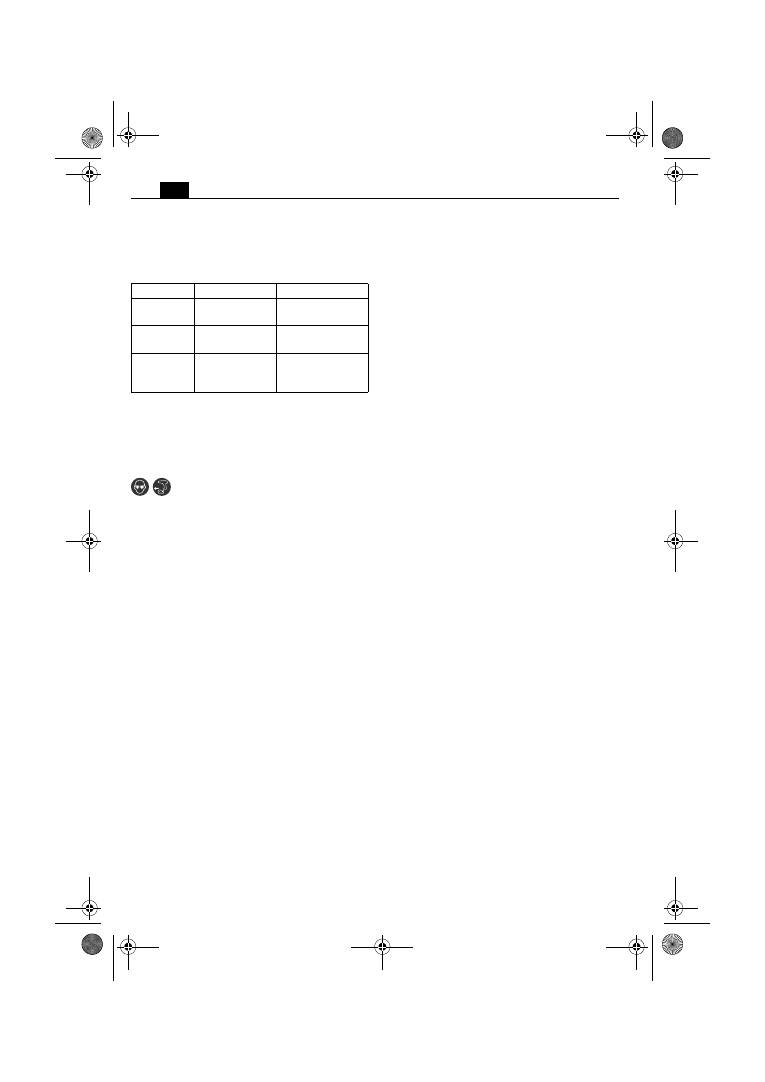
132
ko
배터리
취급
.
0 °C – 45 °C (32 °F – 113 °F)
사이의
배터리
작동
온도
범위
에서만
배터리를
사용하고
충전하십시오
.
배터리
온도는
충전을
시작할
때부터
배터리
작동
온도
범위
내에
있어야
합니다
.
배터리의
실제
충전
상태
(
퍼센트
)
는
전동공구가
정지한
상태에서만
보입니다
.
배터리가
과방전되기
전에
전자장치가
자동으로
모터의
스
위치를
끕니다
.
보수
정비
및
고객
서비스
.
극심한
작업
환경조건에서
금속에
작업할
경우
전도성
분진이
전동공구
안에
쌓일
수
있습니다
.
자주
전동공구의
내부로
환기구를
통해
습기와
오일
성분이
없는
압축
공기를
불어
넣으십시오
.
본
전동공구의
부품
목록은
인터넷
www.fein.com
에
나와
있습니다
.
다음
부속품은
필요에
따라
직접
교환하실
수
있습니다
:
장착용
액세서리
,
배터리
품질
보증
및
법적
책임
.
제품에
대한
품질
보증은
유통하는
국가의
법적
규정에
따
라
유효합니다
.
더불어
FEIN
사는
FEIN
제조사
보증서에
부응하는
품질
보증을
합니다
.
귀하의
전동공구
공급
내역에는
이
사용
설명서와
그림에
나와있는
액세서리
중
일부만
들어있을
수도
있습니다
.
적합성에
관한
선언
.
FEIN
사는
단독
책임
하에
본
제품이
이
사용
설명서
후면에
나와있는
관련된
규정과
일치함을
자체
선언합니다
.
기술
자료
문의
: C. & E. FEIN GmbH, C-DB_IA,
D
-
73529 Schwäbisch Gmünd
환경
보호
,
처리
.
포장재
,
폐기용
전동공구
및
액세서리는
친환경적인
방법
으로
재활용할
수
있도록
분류해야
합니다
.
배터리를
반드시
방전된
상태로
폐기하십시오
.
완전히
방전되지
않은
배터리는
단락되는
것을
방지하기
위
해
끼워넣는
연결
부위에
접착
테이프를
붙여
절연하십시
오
.
LED
표시기
의미
조치
1 – 4
녹색
LED
배터리
충전
단계
작동
적색
연속등
배터리가
거의
방
전
상태입니다
배터리를
충전하십
시오
적색
깜박등
배터리가
작동
상
태가
아닙니다
배터리가
작동
온도
범위에
있도록
한
다
음
,
충전하십시오
OBJ_BUCH-0000000105-001.book Page 132 Thursday, April 4, 2013 10:23 AM
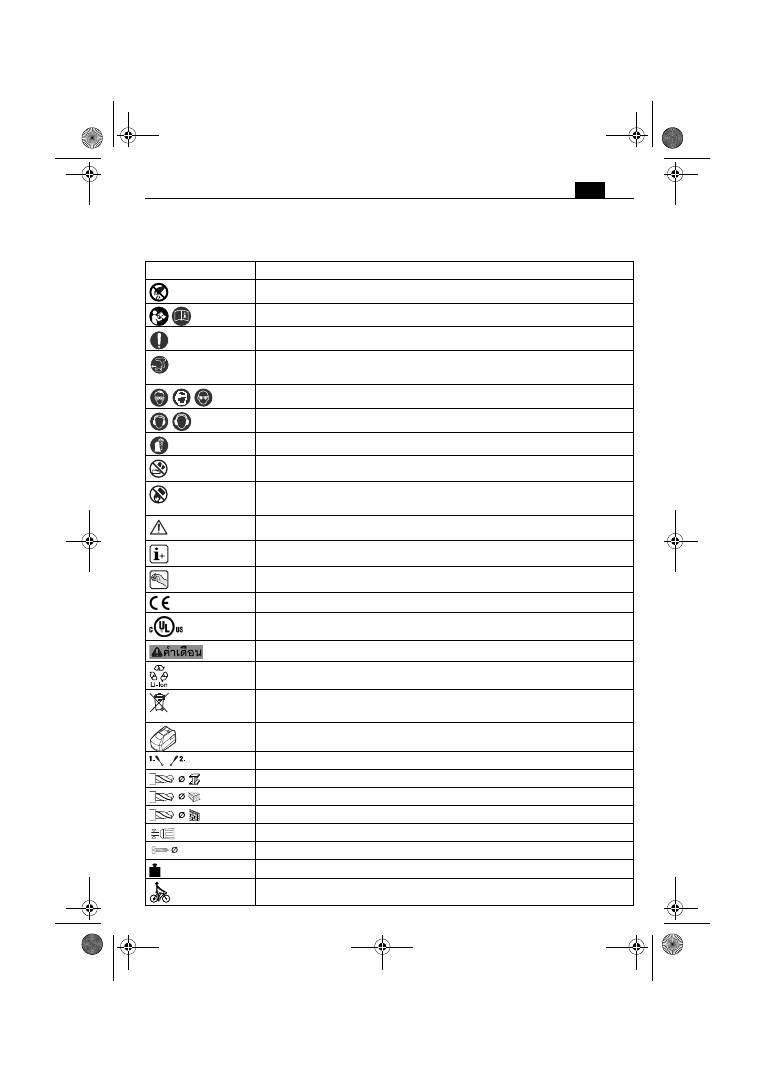
133
th
th
หนังสือคูมือการใชงานฉบับตนแบบ
สัญลักษณ อักษรยอ และคําศัพทที่ใช
สัญลักษณ
ตัวอักษร
คําอธิบาย
อยาสัมผัสสวนที่หมุนของเครื่องมือไฟฟา
ตองอานเอกสารที่แนบมา
เชน
หนังสือคูมือการใชงาน
และคําเตือนทั่วไปเพื่อความปลอดภัย
ปฏิบัติตามคําสั่งที่เปนตัวหนังสือหรือรูปภาพดานตรงขาม
!
กอนเริ่มขั้นตอนการทํางานนี้
ตองถอดแบตเตอรี่ออกจากเครื่องมือไฟฟา
มิฉะนั้นจะไดรับอันตราย
จากการบาดเจ็บอันเกิดจากเครื่องมือไฟฟาติดขึ
นโดยไมตั้งใจ
สวมอุปกรณปองกันตาขณะปฏิบัติงาน
สวมอุปกรณปองกันหูขณะปฏิบัติงาน
สวมถุงมือปองกันขณะปฏิบัติงาน
อยาชารจแบตเตอรี่ที่ชํารุด
เอาแบตเตอรี่ออกหางจากเปลวไฟ
ปกปองแบตเตอรี่จากความรอน
ต
.
ย
.
เชน
จากแสงแดดจานาน
ตอเนื่อง
ปฏิบัติตามขอสังเกตตามเนื้อหาที่อยูขางเคียง
!
ขอมูลเพิ่มเติม
พื้นผิวจับ
ยืนยันวาเครื่องมือไฟฟาสอดคลองกับระเบียบของสหภาพยุโรป
สัญลักษณนี้ยืนยันการรับรองของผลิตภัณฑนี้ในประเทศสหรัฐอเมริกาและแคนาดา
เครื่องหมายนี้แจงถึงสถานการณที่อาจเปนอันตราย
ที่อาจทําใหบาดเจ็บอยางรายแรงหรือถึงตายได
สัญลักษณรีไซเคิล
:
วัสดุที่ระบุนี้เปนวัสดุท
ี่รีไซเคิลได
ตองคัดแยกเครื่องมือไฟฟา
และผลิตภัณฑไฟฟาและอิเล็กทรอนิกสอื่นๆ
ที่เสื่อมสภาพ
เพื่อสงเขาสู
กระบวนการนํากลับมาใชใหมโดยไมทําลายสภาพแวดล
อม
ประเภทแบตเตอรี่
เกียร
1
/
เกียร
2
เสนผาศูนยกลางการเจาะ
เหล็ก
เสนผาศูนยกลางการเจาะ
ไม
เสนผาศูนยกลางการเจาะ
หิน
ชวงหนีบหัวจับดอก
เสนผาศูนยกลางสกรู
น้ําหนักตามระเบียบการ
EPTA-Procedure 01/2003
ความเร็วต่ํา
Fe
OBJ_BUCH-0000000105-001.book Page 133 Thursday, April 4, 2013 10:23 AM
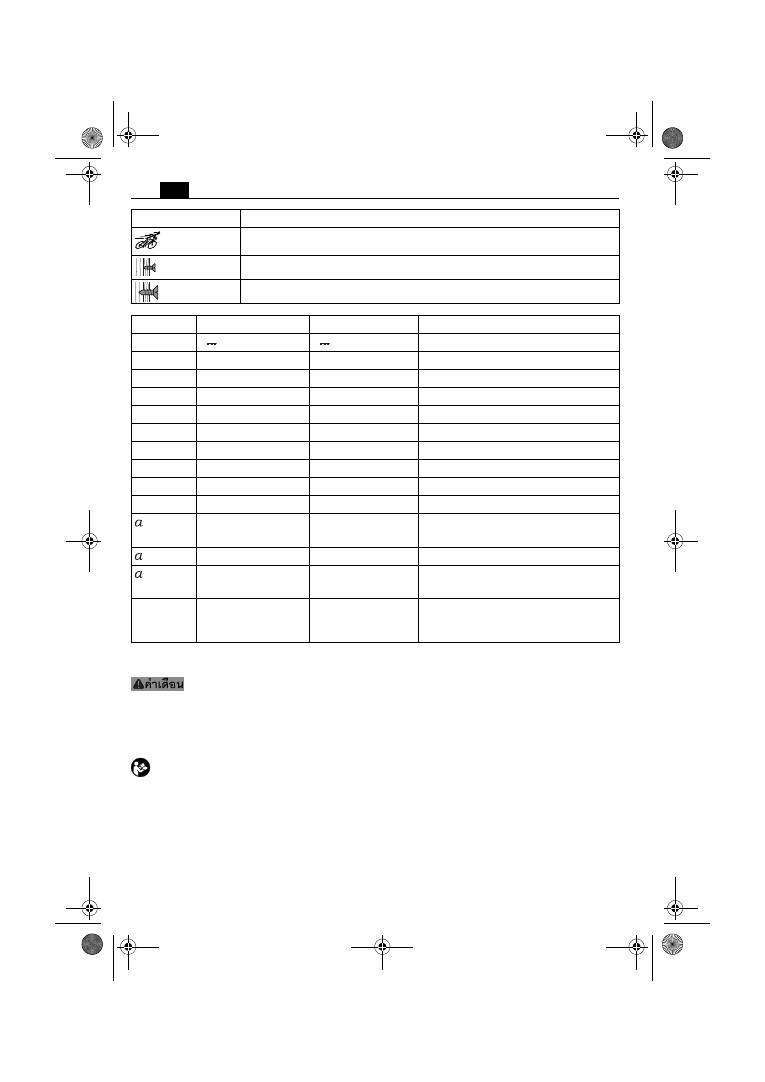
134
th
เพื่อความปลอดภัยของทาน
ตองอานคําเตือนเพื่อความปลอดภัยและคําสั่ง
ทั้งหมด
การไมปฏิบัติตามคําเตือนและคําสั่ง
อาจเปนสาเหตุใหถูกไฟฟาดูด
เกิดไฟไหม
และ
/
หร
ือไดรับ
บาดเจ็บอยางรายแรง
เก็บรักษาคําเตือนและคําสั่งทั้งหมดสําหรับใชอางอิงในภายหลัง
อยาใชเครื่องมือไฟฟา
กอนไดอานหนังสือคูมือ
การใชงานนี้
รวมทั้ง
"
คําเตือนทั่วไปเพื่อความปลอดภัย
"
ที่แนบมา
(
เอกสารเลขที่
3 41 30 054 06 1
)
อยางละเอียดและ
เขาใจอยางครบถวนแลว
เก็บรักษาเอกสารดังกลาวสําหรับใชใน
ภายหลัง
และใหแนบไปกับเครื่องมือไฟฟาหากนําไปแจกจาย
หรือขาย
กรุณาปฏิบัติตามกฎระเบียบเพื่อความปลอดภัยทางอุตสาหกรรม
ที่ใชในประเทศที่เกี่ยวเนื่องดวยเชนกัน
ประโยชนการใชงานของเครื่องมือไฟฟา
ABS14, ABS18
ไขควง
/
สวานไรสายขนาดมือถือ
สําหรับขันเขาและคลาย
สกรูและนอตออก
และสําหรับเจาะและขันสกรูในโลหะ
ไม
พลาสติก
เซรามิก
รวมทั้งสําหรับทําเกลียว
ทํางานโดยไมตอง
ใชน้ํา
ใหทํางานในบริเวณปลอดภัยจากสภาพอากาศ
โดยใช
เครื่องมือและอุปกรณประกอบที่
FEIN
แนะนํา
ASB14, ASB18
สวานกระแทกไรสายขนาดมือถือ
สําหรับขันเขาและคลาย
สกรูและนอตออก
และสําหรับเจาะและขันสกรูในโลหะ
ไม
พลาสติก
เซรามิก
รวมทั้งสําหรับทําเกลียวและเจาะกระแทก
ในคอนกรีต
หิน
และอิฐ
ทํางานโดยไมตองใชน้ํา
ใหทํางานใน
บริเวณปลอดภัยจากสภาพอากาศ
โดยใชเครื่องมือและอุปกรณ
ประกอบที่
FEIN
แนะนํา
ความเร็วสูง
ลดแรงบิด
เพิ่มแรงบิด
ตัวอักษร
หนวยการวัด
สากล
หนวยการวัด
แหงชาติ
คําอธิบาย
U
V
V
แรงดันไฟฟากระแสตรง
f
Hz
Hz
ความถี่
n
0
/min, min
-1
, rpm, r/min
rpm
ความเร็วรอบเดินตัวเปลา
(
แบตเตอรี่ชารจเต็ม
)
n
S
/min, min
-1
/min
อัตรากระแทก
M...
Nm
Nm
แรงบิด
(
การขันสกรูแบบแข็ง
/
แบบนุม
)
Ø
mm
mm
เสนผาศูนยกลางของชิ้นสวนกลม
L
pA
dB
dB
ระดับความดันเสียง
L
wA
dB
dB
ระดับความดังเสียง
L
pCpeak
dB
dB
ระดับความดันเสียงสูงสุด
K...
ความคลาดเคลื่อน
m/s
2
m/s
2
คาความสั่นสะเทือนตามมาตรฐาน
EN 60745
(
ผลรวมเชิงเวกเตอรของสามทิศทาง
)
h,D
m/s
2
m/s
2
คาเฉลี่ยความสั่นสะเทือนสําหรับการเจาะในโลหะ
h,ID
m/s
2
m/s
2
คาเฉลี่ยความสั่นสะเทือนสําหรับการเจาะกระแทก
ในคอนกรีต
m, s, kg, A, mm, V,
W, Hz, N, °C, dB,
min, m/s
2
m, s, kg, A, mm, V,
W, Hz, N, °C, dB,
min, m/s
2
หนวยฐาน
และ
หนวยอนุพันธ
จากระบบหนวย
ระหวางประเทศ
SI
สัญลักษณ
ตัวอักษร
คําอธิบาย
OBJ_BUCH-0000000105-001.book Page 134 Thursday, April 4, 2013 10:23 AM
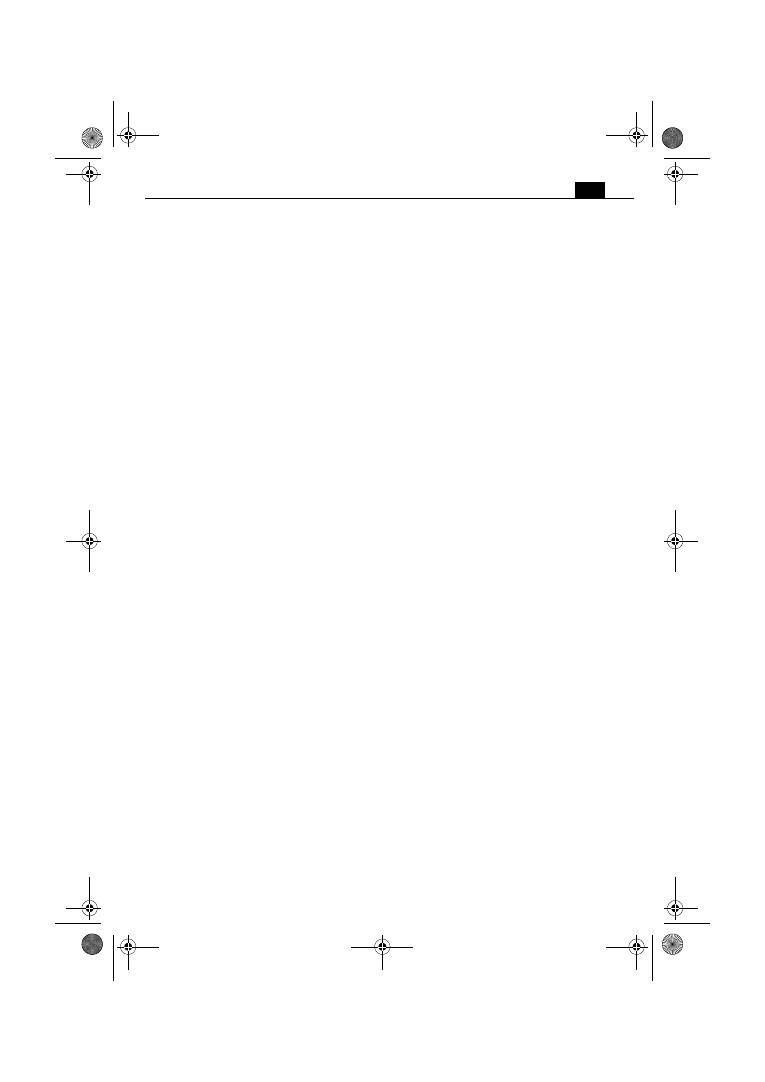
135
th
คําเตือนพิเศษเพื่อความปลอดภัย
เมื่อทํางานในบริเวณที่สกรูอาจสัมผัสกับสายไฟฟ
าที่ซอนอยู
ตองจับเครื่องมือไฟฟาตรง
ดามจับที่หุมฉนวน
การสัมผัสลวด
ไฟฟาที่มี
"
กระแสไฟฟาไหลผาน
"
จะทําใหสวนที่เปนโลหะ
ของเครื่องมือไฟฟาเกิดมี
"
กระแสไฟฟาไหลผาน
"
ทำใหผูใช
เครื่องถูกไฟฟาดูดได
ระวังสายไฟฟา
ทอแกซ
หรือทอน้ําที่ถูกปดบังอยู
ตรวจสอบ
บริเวณทํางานดวยเครื่องตรวจหาโลหะ
ตัวอยาง
เช
น
กอน
เริ่มตนทํางาน
สวมอุปกรณปองกันเฉพาะตัว
สุดแลวแตกรณีใหใชกระบัง
ปองกันหนา
สวมแวนตากันลมและฝุน
หรือ
แวนตาปองกัน
อันตราย
สุดแลวแตความเหมาะสมใหสวมหนากากกันฝุน
สวม
ประกบหูปองกันเสียงดัง
สวมถุงมือ
และสวมผากันเปอน
พิเศษที่สามารถกันผงขัดหรือเศษชิ้นงานออกจากต
ัวทานได
แวนปองกันตาตองสามารถหยุดเศษผงที่ปลิววอนที่เกิดจาก
การปฏิบัติงานแบบตางๆ
ได
การไดยินเสียงดังมากเปนเวลา
นานอาจทําใหทานสูญเสียการไดยิน
สวมอุปกรณปองกันหูเมื่อเจาะกระแทก
การไดรับเสียงดังอาจ
ทําใหสูญเสียการไดยิน
ยึดชิ้นงานใหมั่นคง
ชิ้นงานที่ถูกจับดวยอุปกรณยึดหนีบหรือ
ปากกาจับ
จะมั่นคงกวาการจับดวยมือ
ถือเครื่องมือไฟฟาใหมั่นคง
อาจเกิดแรงบิดตานสูงในเวลาสั้นๆ
อยาทํางานกับวัสดุที่มีแอสเบสทอส
แอสเบสทอสนับเปนสารที่
กอใหเกิดมะเร็ง
อยาตอกหมุดหรือขันสกรูเพื่อติดปายชื่อและเครื่องหมายใดๆ
เขากับเครื่องมือไฟฟา
หากฉนวนหุมชํารุด
จะปองกันไฟฟาดูด
ไมได
ขอแนะนําใหใชปายติดกาว
อยาใชอุปกรณประกอบที่บริษัทผูผลิตเครื่องมือไฟฟาไมได
ออกแบบไวโดยเฉพาะและไมไดแนะนําใหใช
ดวยเหตุผลเพียง
เพราะวาอุปกรณประกอบมีขนาดเขาพอเหมาะกับเครื่องมือ
ไฟฟาของทานก็ไมไดเปนการรับรองความปลอดภัยการทํางาน
แตอยางใด
ทําความสะอาดชองระบายอากาศที่เครื่องมือไฟฟาตามชวง
เวลาเปนประจําโดยใชเครื่องมือที่ไมใชโลหะ
เครื่องเปาลมของ
มอเตอรจะดูดฝุนเขาในครอบเครื่อง
หากฝุนที่ประกอบดวย
โลหะสะสมกันมากเกินไป
อาจทําใหเกิดอันตรายจากไฟฟาได
อยามองหรือจองในระยะใกลเขาไปในแสงจากหลอดไฟของ
เครื่องมือไฟฟา
อยาเล็งแสงจากหลอดไฟเขาไปในดวงตาของ
บุคคลอื่นในบริเวณใกลเคียงอยางเด็ดขาด
รังสีที่ผลิตจาก
หลอดไฟอาจเปนอันตรายตอดวงตา
อยาหันเครื่องมือไฟฟาไปยังตัวทานเอง
บุคคลอ
ื่น
หรือสัตว
อันตรายจากการไดรับบาดเจ็บจากเครื่องมือที่ร
อนหรือแหลมคม
การใชและการจัดการกับแบตเตอรี่
(
แบตเตอรี่แพ็ค
)
เพื่อหลีกเลี่ยงสถานการณอันตราย
ตัวอยาง
เชน
การเผาไหม
เปลวไฟ
การระเบิด
การบาดเจ็บที่ผิวหนัง
และการบาดเจ็บอื่นๆ
เมื่อหยิบจับและใชงานแบตเตอรี่
ใหปฏิบัติตามคําสั่งดังตอไปนี้
:
อยาแยกหรือถอดสวนประกอบแบตเตอรี่
เปด
หรือทำเปน
เศษเล็กเศษนอย
อยาใหแบตเตอรี่ถูกกระทบทางกลไกหรือถูก
กระแทกอยางแรง
ไอระเหยและของเหลวที่เปนอันตราย
สามารถลอดออกมาในกรณีที่แบตเตอรี่ชํารุดและใชงานอยาง
ไมถูกตอง
ไอระเหยสามารถทําใหระบบหายใจระคายเคือง
ของเหลวที่ขับออกมาจากแบตเตอรี่อาจทําใหผิวหน
ังระคาย
เคืองหรือถูกเผาไหม
เมื่อของเหลวแบตเตอรี่จากแบตเตอรี่ที่ชํารุดไปถูกวัตถุบริเวณ
ใกลเคียง
ใหตรวจสอบสวนประกอบนั้น
ทําความสะอาด
หรือ
เปลี่ยนใหม
ตามจําเปน
เอาแบตเตอรี่ออกหางจากความรอนและเปลวไฟ
อยาเก็บรักษา
แบตเตอรี่ในสถานที่แสงแดดสองโดยตรง
อยาเอาแบตเตอรี่ออกจากหีบหอที่มีมาแตเดิมจนกวาจะนํา
ออกมาใชงาน
นําแบตเตอรี่ออกจากเครื่องมือไฟฟา
กอนปรับแตงเครื่อง
หาก
เครื่องมือไฟฟาติดขึ้นโดยไมตั้งใจ
จะเกิดอันตรายจาก
การบาดเจ็บ
ถอดแบตเตอรี่ออก
เมื่อเครื่องมือไฟฟาปดสวิทช
อยูเทานั้น
เอาแบตเตอรี่ออกหางจากเด็กๆ
รักษาแบตเตอรี่ใหสะอาด
และปกปองแบตเตอรี่จากความชื้น
และน้ํา
ทําความสะอาดขั้วที่สกปรกของแบตเตอรี่และเครื่องมือ
ไฟฟาดวยผาแหงที่สะอาด
ใชเฉพาะแบตเตอรี่ที่มีสภาพสมบูรณแบบของแทของ
FEIN
ที่ผลิตสําหรับเครื่องมือไฟฟาของทาน
เทานั้น
หากทํางานกับ
แบตเตอรี่ที่ชารจอยางไมถูกตอง
ชํารุด
ไดรับการซอมแซมหรือ
ปรับปรุงสภาพ
แบตเตอรี่เลียนแบบ
หรือยี่หออื่น
จะมีอันตราย
จากไฟไหม
และ
/
หรือ
การระเบิด
ปฏิบัติตามคําแนะนําเพื่อความปลอดภัยในหนังสือค
ูมือ
การใชงานของเครื่องชารจแบตเตอรี่
OBJ_BUCH-0000000105-001.book Page 135 Thursday, April 4, 2013 10:23 AM
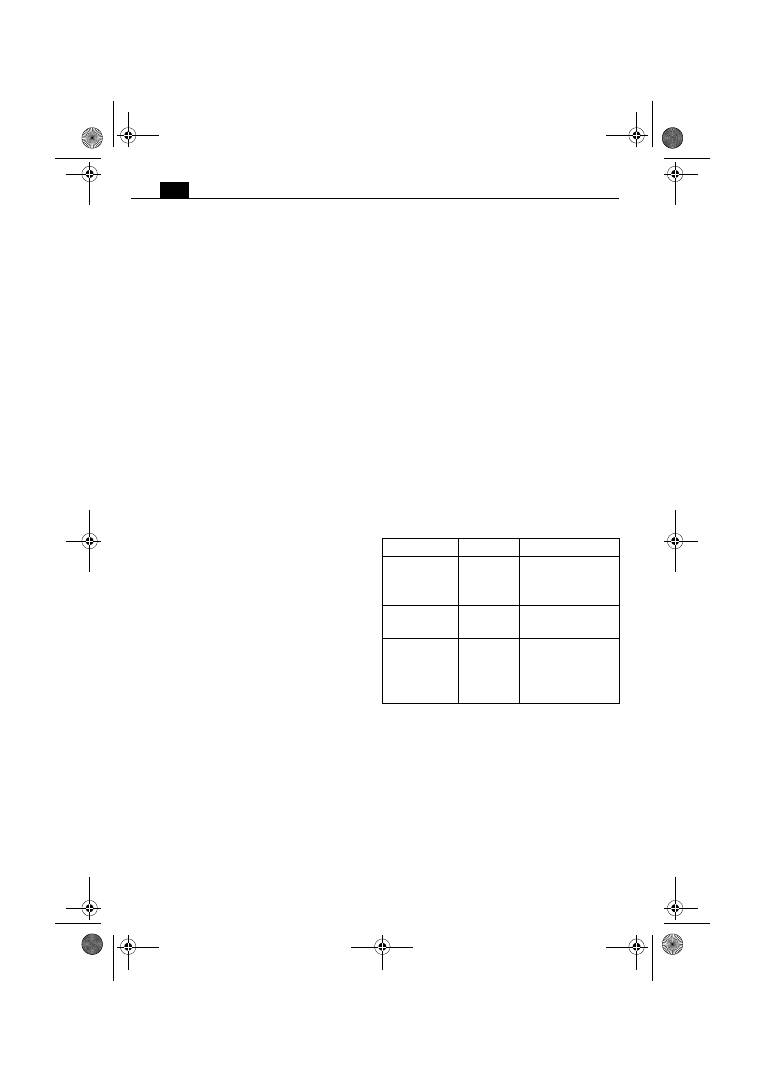
136
th
การสั่น
มือ
/
แขน
ระดับการสั่นที่ใหไวในแผนขอมูลนี้วัดตามการทดสอบที่ได
มาตรฐานที่ระบุใน
EN 60745
และอาจใชสําหรับเปรียบเทียบ
เครื่องมือไฟฟาหนึ่งกับเครื่องอื่นๆ
ได
ระดับการสั่นยังอาจใช
สําหรับประเมินการสั่นของเครื่องเมื่อใชงานในเบื้องตนได
อีกดวย
ระดับการสั่นที่ใหไวนี้แสดงการใชงานสวนใหญของ
เครื่องมือไฟฟา
อยางไรก็ดี
หากเครื่องมือไฟฟ
าถูกใชเพื่อทํางาน
ประเภทอื่น
ใชรวมกับอุปกรณประกอบที่ผิดแปลกไป
หรือ
ไดรับการบํารุงรักษาไมดีพอ
ระดับการสั่นอาจผิดแผกไป
ปจจัย
เหลานี้อาจเพิ่มระดับการสั่นอยางชัดเจนตลอดระยะเวลา
ทํางานทั้งหมด
เพื่อประมาณระดับการสั่นใหไดแนนอน
ควรนําเวลาขณะ
เครื่องมือไฟฟาปดสวิทชทํางานหรือขณะเครื่องกําลังวิ่งแต
ไมไดทํางานจริงมาพิจารณาดวย
ปจจัยเหลานี้อาจลดระดับ
การสั่นอยางชัดเจนตลอดระยะเวลาทํางานทั้งหมด
วางมาตรการเพื่อความปลอดภัยเพิ่มเติมเพื่อปกป
องผูใชงาน
เครื่องจากผลกระทบของการสั่น
เชน
:
บํารุงรักษาเครื่องมือ
ไฟฟาและอุปกรณประกอบ
ทํามือใหอุนไว
จัดระเบียบลําดับงาน
การจัดการกับฝุนอันตราย
เมื่อใชเครื่องมือไฟฟานี้สําหรับไสวัสดุออก
อาจเกิดฝุนที่เปน
อันตรายตอสุขภาพ
การสัมผัสหรือหายใจเอาฝุนบางประเภทเขาไป
ต
.
ย
.
เชน
แอสเบสทอส
หรือวัสดุที่มีแอสเบสทอส
เคลือบผิวท
ี่มีสารตะกั่ว
โลหะ
ไมบางประเภท
แรธาตุ
และอนุภาคซิลิเกตจากวัสดุผสม
หิน
ตัวทําละลายสี
ผลิตภัณฑรักษาเนื้อไม
สีกันเพรียงสําหรับ
เรือเดินสมุทร
สามารถกระตุนใหเกิดปฏิกิริยาแพแกผูใชเครื่อง
หรือผูที่ยืนอยูใกลเคียง
และ
/
หรือนํามาซึ่งโรคติดเชื้อระบบ
หายใจ
มะเร็ง
ความผิดปกติแตกําเนิด
หรืออันตรายตอการ
เจริญพันธุอื่นๆ
อันตรายจากการหายใจเอาฝุนเข
าไปขึ้นอยูกับ
การรับฝุน
ใหใชอุปกรณดูดฝุนที่กําหนดใหใช
ไดกับฝุนที่เกิดขึ้น
รวมทั้งใชอุปกรณปองกันรางกาย
และจัดสถานที
ทํางานใหมี
การระบายอากาศที่ดี
ปลอยใหวัสดุที่มีแอสเบสทอสเปนงาน
ของผูเชี่ยวชาญ
ฝุนไมและฝุนที่เปนโลหะเบา
สวนผสมรอนๆ
ของผงขัด
และ
เคมีวัสดุ
สามารถลุกไหมดวยตนเองภายใตสภาพแวดลอมที่
ไมพึงประสงค
หรืออาจทําใหเกิดระเบิดได
หลีกเลี่ยงไมให
ประกายไฟแลบไปยังทิศทางอุปกรณเก็บผง
รวมทั้งอยาให
เครื่องมือไฟฟาและวัสดุที่ขัดรอนเกินไป
ถายอุปกรณเก็บผง
/
ถังผงใหทันทวงที
ปฏิบัติตามคําแนะนําในการทํางานของบริษัท
ผูผลิตวัสดุ
รวมทั้งกฎขอบังคับที่เกี่ยวกับว
ัสดุชิ้นงาน
ที่บังคับ
ใชในประเทศของทาน
คําแนะนําในการปฏิบัติงาน
ปรับสวิทชเลือกการหมุนและสวิทชเลือกเกียรเมื่อเครื่องหยุด
นิ่งอยูกับที่แลวเทานั้น
ดันสวิทชเลือกเกียรและหมุนสวิทชเลือกวิธีการปฏิบัติการ
(ASB14/18)
ไปจนสุดเสมอ
มิฉะนั้นเครื่องอาจไดรับความ
เสียหาย
ในกรณีที่ทํางานเกินกําลัง
เครื่องจะปดสวิทช
ตั้งสวิทชเลือกการหมุนไวที่ตําแหนงกลางเพื่อหลีกเลี่ยงการติด
เครื่องเองโดยไมตั้งใจ
ต
.
ย
.
เชน
ในระหวางการขนยาย
การตั้งแรงบิด
โรงงานผลิตตั้งแรงบิดไวสําหรับใชกับสกรูขนาดเล็กจนถึง
ขนาดกลาง
คาแรงบิดขึ้นอยูกับกําลังที่ใชกดเครื่องมือไฟฟาลงบนสกรูดวย
การจัดการกับแบตเตอรี่
ใชงานและชารจแบตเตอรี่เฉพาะภายในชวงอุณหภูมิการทํางาน
ของแบตเตอรี่
คือ
0 °C – 45 °C (32 °F – 113 °F)
เทานั้น
เมื่อ
เริ่มตนกระบวนการชารจ
อุณหภูมิแบตเตอรี่ตองอยูภายในชวง
อุณหภูมิการทํางานของแบตเตอรี่
เปอรเซ็นตที่แทจริงของสภาพการชารจแบตเตอร
ี่จะแสดงเมื่อ
มอเตอรของเครื่องมือไฟฟาหยุดนิ่งเทานั้น
ระบบอิเล็กทรอนิกสจะปดสวิทชมอเตอรโดยอัตโนมัติ
กอนที่
แบตเตอรี่จะคายประจุออกเกือบหมด
ไฟสัญญาณ
LED
ความหมาย
ลักษณะการดําเนินการ
ไฟสีเขียว
LED
1 – 4
อัตรารอยละ
ของสถานะ
การชารจ
การปฏิบัติการ
ไฟสีแดงติด
ตอเนื่อง
แบตเตอรี่
ใกลหมด
ชารจแบตเตอรี่
ไฟกะพริบสีแดง แบตเตอรี่
ไมพรอม
ปฏิบัติการ
ทําแบตเตอรี่ใหเขาสูชวง
อุณหภูมิการทํางานของ
แบตเตอรี่
จากนั้นจึง
ชารจ
OBJ_BUCH-0000000105-001.book Page 136 Thursday, April 4, 2013 10:23 AM
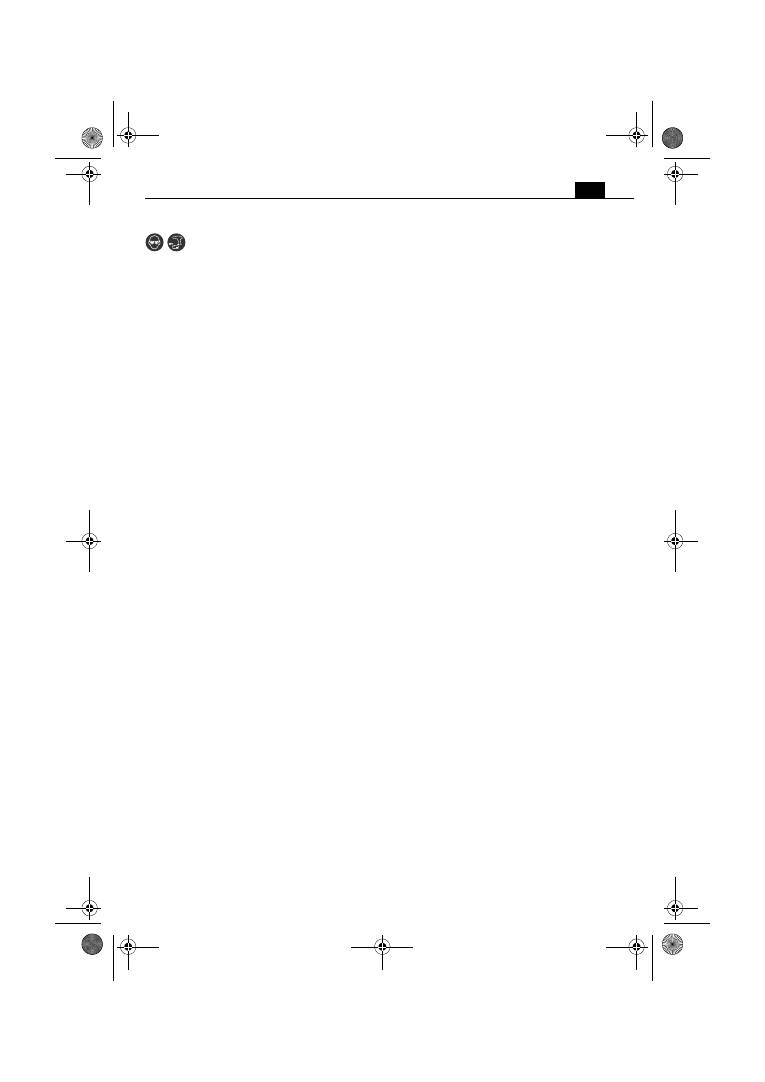
137
th
การซอมบํารุงและการบริการลูกคา
เมื่อทํางานกับโลหะในสภาวะการใชงานหนัก
ฝุนนํา
ไฟฟาอาจเขามาอยูขางในเครื่องมือไฟฟา
ใหใช
อากาศอัดที่แหงและปราศจากน้ํามันเปาทําความสะอาดดานใน
ของเครื่องมือไฟฟาผานชองระบายอากาศบอยๆ
รายการอะไหลที่มีอยูในปจจุบันสําหรับเครื่องมือไฟฟานี้
กรุณาดูในอินเทอรเน็ตที่
www.fein.com
หากตองการ
ทานสามารถเปลี่ยนชิ้นสวนดังตอไปนี้เองได
:
เครื่องมือ
แบตเตอรี่
การรับประกันและความรับผิดชอบ
การรับประกันสําหรับผลิตภัณฑใหมีผลบังคับตามกฎระเบียบ
ทางกฎหมายในประเทศที่จําหนายผลิตภัณฑ
นอกจากน
ี้
บริษัท
FEIN
ยังใหการรับประกันตามคําประกาศรับประกันของบร
ิษัท
ผูผลิต
FEIN
อีกดวย
อาจมีเพียงบางสวนของอุปกรณประกอบที่บรรยายหรือแสดง
ในหนังสือคูมือการใชงานนี้
รวมอยูในการจัดส
งเครื่องมือไฟฟา
ของทาน
การรับรองการปฏิบัติตามมาตรฐาน
บริษัท
FEIN
ขอรับรองโดยรับผิดชอบแตเพียงผูเดียววา
ผลิตภัณฑนี้สอดคลองกับขอกําหนดที่เกี่ยวเนื
องกันที่ระบุ
ไวในหนาสุดทายของหนังสือคูมือการใชงานนี้
เอกสารทางเทคนิคที่
:
C. & E. FEIN GmbH, C-DB_IA,
D-73529 Schwäbisch Gmünd
การรักษาสภาพแวดลอมและการกําจัดขยะ
ตองคัดแยกหีบหอ
เครื่องมือไฟฟา
และอุปกรณประกอบที่
เสื่อมสภาพ
เพื่อสงเขาสูกระบวนการนํากลับมาใชใหมโดยไม
ทําลายสภาพแวดลอม
ตองคายประจุออกกอนนําแบตเตอรี่ไปทิ้งอยางถูกตอง
สําหรับแบตเตอรี่ที่คายประจุออกไมหมดสิ้น
ใหห
อหุมขั้วดวย
ฉนวนเทปเพื่อปองกันการลัดวงจร
OBJ_BUCH-0000000105-001.book Page 137 Thursday, April 4, 2013 10:23 AM
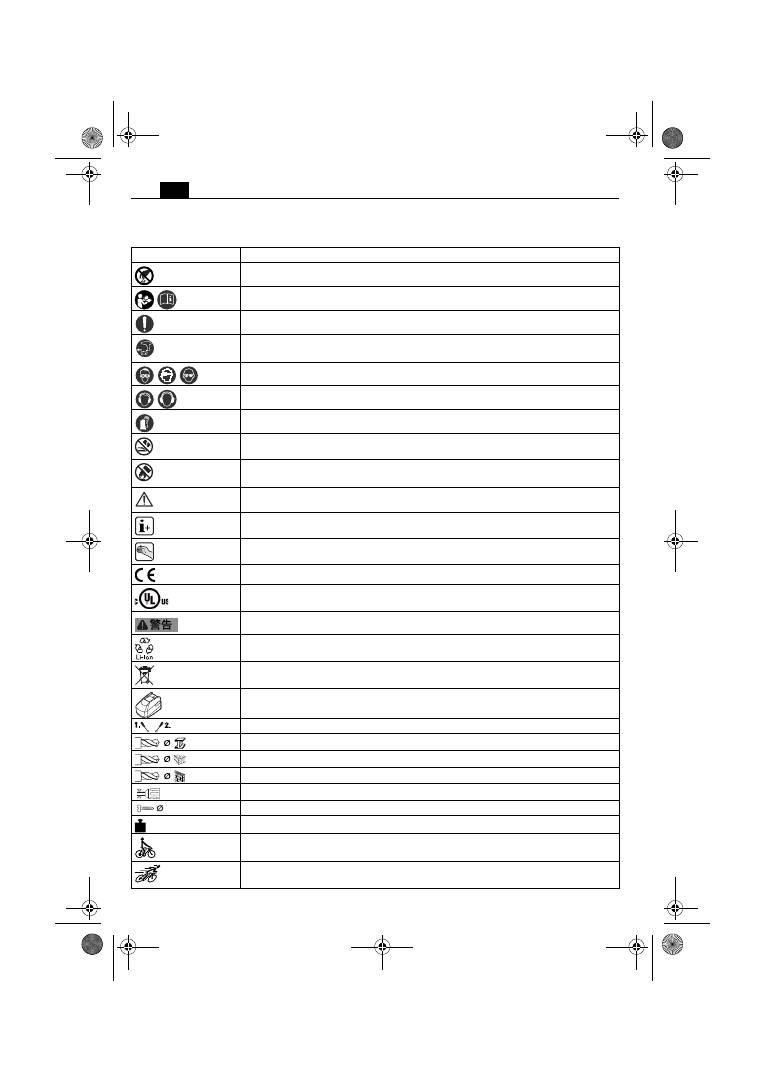
138
ja
ja
取扱説明書。
本説明書で使用中のマーク、略号および用語
マーク、記号
説明
電動工具の回転部に触らないでください。
取扱説明書や安全上の一般注意事項などの付属文書を必ずお読みください。
ここに記載された文章または図に従ってください。
作業を開始する前に電動工具からバッテリーを取り外してください。この注意を怠ると、
電動工具が不意に作動して負傷する恐れがあります。
作業時には保護メガネを着用してください。
作業時には防音保護具を着用してください。
作業時には保護手袋を着用してください。
破損したバッテリーを充電しないでください。
バッテリーを火気にさらさないでください。 温度の高い場所 (長時間にわたって直射日
光があたる場所など)からバッテリーを保護してください。
ここに記載された注意事項に注意してください!
付随情報。
グリップ領域
本電動工具が CE に準拠していることを示しています。
このシンボルは、本製品がアメリカ合衆国とカナダで認証を取得していることを示してい
ます。
この表示は死傷事故の原因となりかねない危険な状況であることを示しています。
リサイクルマーク: 再利用が可能な材料を示しています
使用できなくなった電動工具やその他の電子・電気機器は分別回収し、再利用させてくだ
さい。
バッテリータイプ
1 段 /2 段
ドリル径 鋼材
ドリル径 木材
ドリル径 石材
チャック装着領域
ネジ径
重量 (EPTA-Procedure 01/2003 に準拠して測定されています)
低速
高速
Fe
OBJ_BUCH-0000000105-001.book Page 138 Thursday, April 4, 2013 10:23 AM
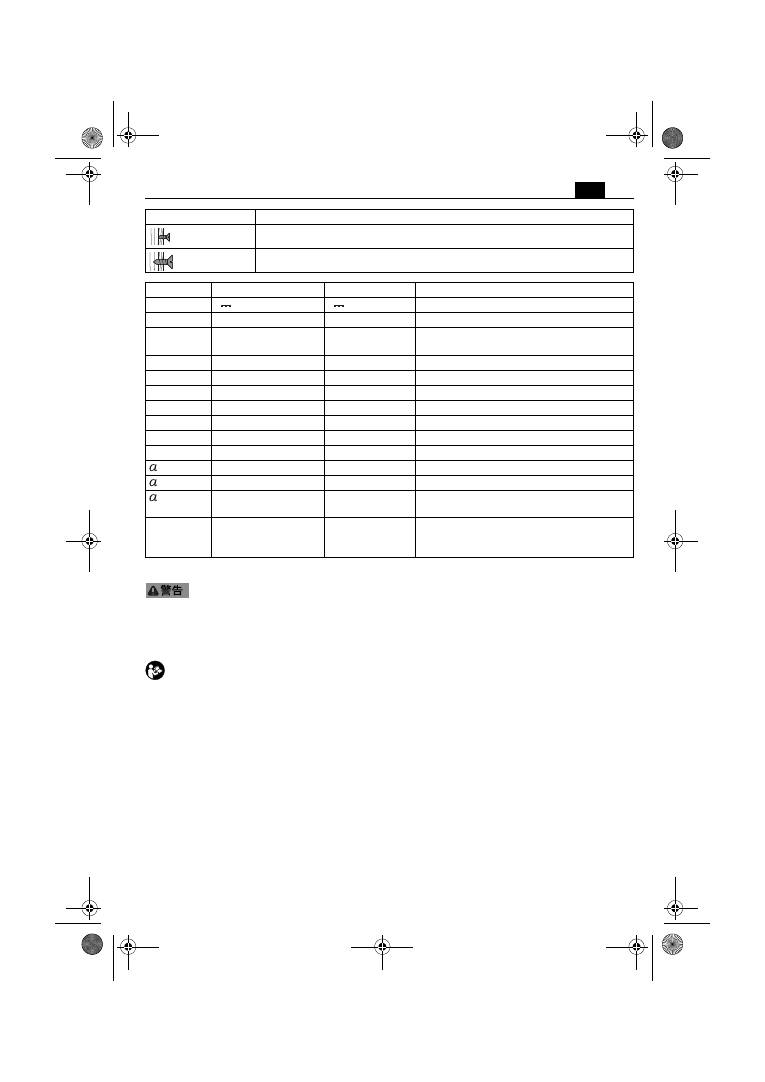
139
ja
安全のために
安全上の注意と使用方法をすべてよくお読
みください。安全上の注意と使用方法を厳
守しないと、感電、火災、怪我等の事故発生の恐れがあ
ります。
お読みになった後は、お使いになる方がいつでも見られ
る所に必ず保管してください。
この取扱説明書および付属の 「安全上のご注意」
( 文書番号 3 41 30 054 06 1) をよくお読みになり、
理解したうえで本電動工具をご使用ください。 取扱説明
書や安全上の注意に関する書類はいつでも読み返せるよ
うに保管し、電動工具を譲渡または売却する際には必ず
これらの書類も添えてください。
国内で適用されている一連の労働安全衛生規則にも留意
してください。
電動工具について:
ABS14、ABS18:
手持ち式ドリルスクリュードライバーは、ネジおよびナ
ットの締め付け、緩め、および金属、木材、合成物質、
セラミック材における穴あけとネジ締め、ネジ切りに使
用します。雨風から保護された場所で水を供給せずにご
使用ください。また、必ず FEIN が許可する先端工具お
よびアクセサリーをご使用ください。
ASB14、ASB18:
手持ち式インパクトドリルスクリュードライバーは、ネ
ジおよびナットの締め付け、緩め、および金属、木材、
合成物質、セラミック材における穴あけとネジ締め、ネ
ジ切り、さらにコンクリート、石材、レンガ石における
穴あけ作業に使用します。雨風から保護された場所で水
を供給せずにご使用ください。また、必ず FEIN が許可
する先端工具およびアクセサリーをご使用ください。
特殊な安全注意事項
ネジが埋設電線に触れる恐れのある場合には、電動工具
上のプラスチック製のハンドルを保持してください。 電
線に触れると、電動工具の金属部分を通じて感電する恐
れがあります。
埋設された電線、ガス・水道管にご注意ください。 作業
開始前に、メタル探知器等を使用しながら作業領域を確
認してください。
個人防護具を着用してください。 用途に応じてフェイス
シールド、保護ゴーグルおよび保護メガネを着用してく
ださい。 各用途に適した防じんマスク、防音保護具、作
業手袋または特殊な作業エプロンなどを着用し、研削時
に発生する粉じんから身体を守ってください。 作業中に
飛散する様々な異物から目を守ってください。 粉じんマ
スクおよび呼吸マスクなどを着用し、作業中に発生する
粉じんから防護してください。 騒音の激しい場所で作業
を長時間続けると、聴力損失の原因となることがありま
す。
回転卜ルクを下げる
回転トルクを上げる
記号
国際単位
国内単位
説明
U
V
V
直流電圧
f
Hz
Hz
周波数
n
0
/min, min
-1
, rpm, r/min
回/分
(完全に充電された状態のバッテリーにおける)
空回転数
n
S
/min, min
-1
/min
打撃数
M...
Nm
Nm
締付けトルク (ハード / ソフト締付け)
Ø
mm
mm
円形部品の直径
L
pA
dB
dB
音圧レベル
L
wA
dB
dB
音量レベル
L
pCpeak
dB
dB
ピーク音圧レベル
K...
不的確
m/s
2
m/s
2
EN 60745 準拠振動加速度 (3 方向のベクトル和)
h,D
m/s
2
m/s
2
金属への穴あけ平均振動値
h,ID
m/s
2
m/s
2
コンクリートへの穴あけ (振動ドリル使用)平均
振動値
m, s, kg, A, mm, V,
W, Hz, N, °C, dB,
min, m/s
2
m, s, kg, A, mm, V,
W, Hz, N, C, dB,
min, m/s
2
国際単位系 (SI)で使用されている基本単位およ
び組立単位。
マーク、記号
説明
OBJ_BUCH-0000000105-001.book Page 139 Thursday, April 4, 2013 10:23 AM
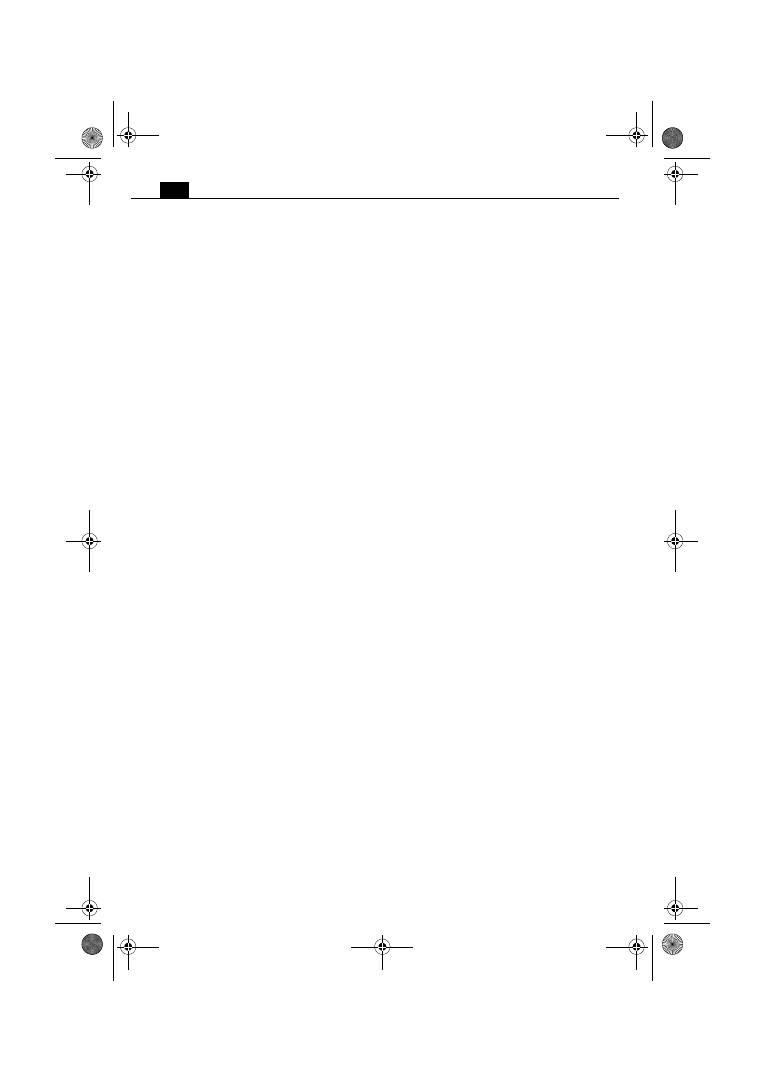
140
ja
振動ドリルをご使用の際には防音保護具を着用してくだ
さい。 騒音により聴力障害が生じる恐れがあります。
材料をしっかりと固定してください。 材料をクランプ等
で固定すると、手で保持する場合よりも安全です。
電動工具をしっかりと保持してください。 急に高い反動
トルクが発生する場合があります。
アスベストを含有する材料を使用して作業しないでくだ
さい。 アスベストはガンを誘発するとされています。
電動工具上に銘板やマークを固定する際には、ネジやリ
ベッ卜を使用しないでください。 電気的な絶縁を破壊
し、感電を防げなくなる恐れがあります。貼付方式の銘
板を使用してください。
電動工具メーカーが認証していないアクセサリーは使用
しないでください。 アクセサリーが電動工具に取り付け
られるだけでは、安全な作業がおこなえるとは限りませ
ん。
非金属製工具で電動工具の通気孔を定期的に掃除してく
ださい。 モーターファンは粉じんを装置内へ吸引しま
す。 金属粉じんが多く蓄積されると、感電を発生する恐
れがあります。
電動工具のランプ光に目を近づけないでください。ラン
プ光を付近の人物の目に近づけないでください。 光源か
ら生じる照射光は目に害を与えることがあります。
電動工具をご自分、他の人物または動物に向けないでく
ださい。 先のとがった、または熱くなった先端工具で怪
我をする恐れがあります。
バッテリー (バッテリーブロック)の使用と取り
扱い
バッテリー使用時の火傷、火災、爆発、皮膚その他の負
傷発生を回避するため、以下の注意に従ってください。
バッテリーの改造、解体、破砕はお避けください。 バッ
テリーに機械的衝撃を与えないでください。 バッテリー
が破損していたり、不適切な使用方法をとったりする
と、有害な煙および液体が発生する恐れがあります。 こ
こから発生する煙は呼吸器官を刺激する恐れがありま
す。 バッテリーから漏れ出た液体は肌に刺激を与えたり
火傷の原因となったりすることがあります。
破損したバッテリーから液体が発生し、隣接物に接触し
た場合、該当部品への危害を確認し、これを洗浄または
交換してください。
バッテリーを熱または火気にさらさないでください。 バ
ッテリーを直射日光にさらさないでください。
バッテリーはご使用になる直前にオリジナル包装から取
り出してください。
電動工具での作業を開始する前に電動工具からバッテリ
ーを取り出してください。 電動工具が不意に始動すると
負傷事故が発生する恐れがあります。
電動工具のスイッチが切れていることを確認してからバ
ッテリーを取り出してください。
バッテリーはお子様の手に届かないようにしてくださ
い。
バッテリーを清潔に保ち、湿気および水から保護してく
ださい。 バッテリーコンタクトおよび電動工具に汚れが
付着している場合には、乾燥した清潔な布でこれを除去
してください。
お手持ちのツールに適した正常な純正
FEIN
バッテリーの
みをご使用ください。 不適切な、または破損した、もし
くは修理・改造されたバッテリーや模造品、他社製品で
作業を行ったり、充電したりすると、火災や爆発の事故
が発生する危険があります。
バッテリー充電器の取扱説明書に記載された安全上の注
意に従ってください。
手に伝わる振動
本説明書上に記載された振動レベルは EN 60745 の規格
に準拠した測定方法で測定されているため、この情報は
他の電動工具との比較時にご使用いただけます。 また、
振動負荷の事前調査にもご使用いただけます。
記載中の振動レベルは電動工具を主な用途にご使用にな
った場合の代表値を示しています。用途やご使用になる
先端工具、保守状況によっては、記載中の振動レベルと
異なることがあります。 このような場合、作業中の振動
負荷が大幅に高くなることがあります。
振動負荷を正確に推測する場合には、電動工具のスイッ
チを切っている時間やスイッチは入っていても実際に使
用していない時間も考慮に入れる必要があります。これ
により、作業中の振動負荷は大幅に低下することがあり
ます。
電動工具や先端工具の保守、手の保温、作業フローの計
画などの追加的措置を定めることで、作業員を振動負荷
から保護してください。
危険粉じんの取り扱い
本工具を使用して工作物を加工すると、危険な粉じんが
発生することがあります。
岩石含有物質、塗料溶剤、木材保護剤、船舶用防汚材の
アスベスト、アスベスト含有物質、鉛含有塗料、金属、
一部の木材、鉱物、ケイ素粒子等の粉じんと接触した
り、これらを吸引するとアレルギー反応、気管支炎、
癌、不妊の原因となる場合があります。 粉じんの吸引に
よるリスクは暴露状態に依存します。 発生する粉じんに
適した吸じん方法、防護具を使用し、作業場の換気を充
分に行ってください。 アスベスト含有材の加工は専門家
にご依頼ください。環境によっては、木粉じんや軽金属
粉じん、研磨粉じんおよび化学材の高温混合気が引火ま
たは爆発の原因となることがあります。 粉じん容器の方
向への火花飛散、電動工具や研磨物の過剰加熱を回避し
てください。粉じん容器内の粉じんは適時に除去してく
ださい。物質メーカーの加工指示および加工材に定めら
れた各国の規定に従ってください。
OBJ_BUCH-0000000105-001.book Page 140 Thursday, April 4, 2013 10:23 AM
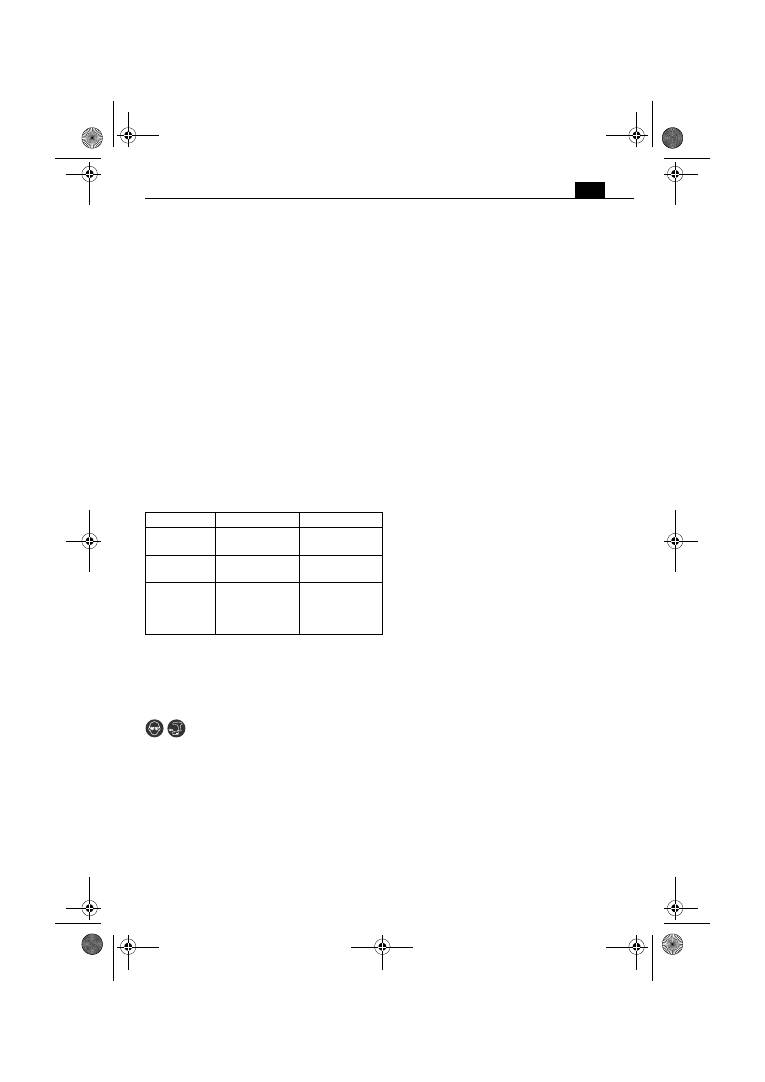
141
ja
取り扱いにあたっての注意
正転・逆転切り替えスイッチおよびギア選択スイッチの
操作は必ずモーターが停止した状態でおこなってくださ
い。
ギア選択スイッチまたはモード選択スイッチ
(ASB14/18)は、必ずストッパーまで完全にずらすか回
してください。これを怠ると、本体が故障する恐れがあ
ります。
過負荷状態になると、電導工具のスイッチが切れます。
運搬時などに電動工具が不意に作動しないよう、正転・
逆転切り替えスイッチを中央位置にしてください。
トルクセッティング
工場出荷時、同工具は小〜中サイズのネジ用として設定
されています。
締付け卜ルクは電動工具がネジを押さえつける力によっ
ても変化します。
バッテリーの取り扱い
バッテリー温度が 0 °C – 45 °C (32 °F – 113 °F) の状態での
みバッテリーを使用および充電してください。バッテリ
ー充電を開始する時点でバッテリーがこの温度範囲内に
あることが必要です。
実際のバッテリー充電状況 (パーセント表示)は電動工
具のモーターが停止した状態でのみ表示されます。
バッテリーが極度に放電されることが予測されると、モ
ーターが自動停止します。
メンテナンスおよび顧客サービス
過度な環境条件下で金属材料を加工すると、
電動工具内部に誘電性を持つ粉じんが溜まる
ことがあります。 このため、電動ツールの通気孔から乾
燥したオイルフリーエアーを頻繁に吹き付けて、内部の
粉じんを除去してください。
この電動工具に適用される最新の交換パーツリストは、
インターネットサイト www.fein.com をご覧ください。
以下の部品は、必要に応じてお客様ご自身で交換してい
ただけます :
先端工具、バッテリー
保証
製品保証に関しては、本製品が販売される国で定められ
た法的規定が適用されます。 さらに FEIN 社の保証内容
に従い、保証が適用されます。
本電動工具の標準付属品には、本取扱説明書に記載また
は図示されたアクセサリーの一部のみが含まれることが
あります。
準拠宣言
FEIN 社は、本製品が本取扱説明書の最終頁に記載された
一連の基準に準拠していることを宣言します。
技術資料発行者:C. & E. FEIN GmbH, C-DB_IA,
D
-
73529 Schwäbisch Gmünd
環境保護、処分
梱包資材、使用済みの電動工具およびアクセサリーは、
環境にやさしい資源リサイクルのために分別してくださ
い。
バッテリーは必ず完全放電した状態で分別回収用として
処分してください。
バッテリーが完全放電されていない場合には、短絡予防
措置としてコネクター部に接着テープを貼り、絶縁して
ください。
LED 表示
意味
措置
1 – 4個の緑色
LED
充電状態率
運転
赤色の継続点
灯光
バッテリーがほぼ
空になっています
バッテリーを充電
してください
赤色の点滅光
バッテリーが使用
可能な状態にあり
ません
バッテリーの温度
を作動可能温度に
し、充電してくだ
さい
OBJ_BUCH-0000000105-001.book Page 141 Thursday, April 4, 2013 10:23 AM
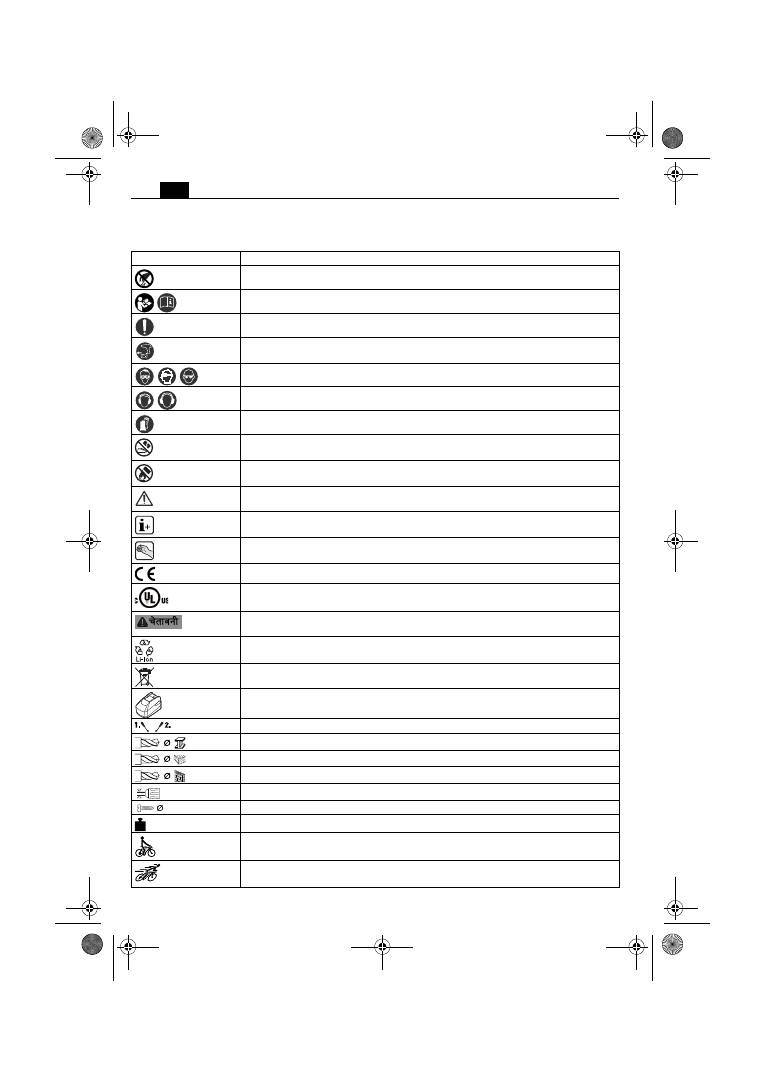
142
hi
hi
मूल
िनदेर्श
.
ूयुक्त
िचन्ह
,
संक्षेपण
और
शब्दावली
.
िचन्ह
,
संकेत
ःपष्टीकरण
औजार
की
घूणीर्
को
हाथ
नही
लगायें।
ध्यान
रहे
,
साथ
के
कागजात
,
िनदेर्श
और
सामन्य
सूचनांए
अवँय
पढ़ें
.
साथ
के
लेख़
और
फ़ोटो
में
िलख़े
िनदेर्श
का
पालन
करे
!
यह
कायर्
करने
से
पहले
मशीन
में
से
बैटरी
िनकाल
लें।
नही
तो
मशीन
के
अचानक
चल
जाने
से
चोट
लगने
का
ख़तरा
हो
सकता
है।
काम
करते
समय
आंखों
पर
सुरक्षा
-
चँमें
पहन
लें।
काम
करते
समय
कानों
के
बचाव
के
िलए
सुरक्षा
-
िगयर
पहन
लें
.
काम
करते
समय
हाथों
के
बचाव
के
िलए
सुरक्षा
-
दःताने
पहन
लें
.
ख़राब
िरचाजेर्बल
बैटरी
को
चाजर्
नही
करें।
िरचाजेर्बल
बैटरी
को
आग
में
नही
डालें।
िरचाजेर्बल
बैटरी
को
ताप
से
दर
रख़ें
ू
,
जैसे
लगातार
धूप
में
या
सूयर्
की
िकरणों
में
न
रख़ें।
साथ
में
िलख़ी
सूचनाओं
पर
ध्यान
दें
!
अितिरक्त
सूचना
पकड़ने
की
जगह
यूरोिपयन
संघ
के
िनयमों
अनुसार
िवद्युत
उपकरण
की
अनुरूपता
ूमािणत
की
जाती
है
.
यह
िचन्ह
अमेिरका
और
कनाडा
के
िलए
इस
उत्पाद
के
ूम ◌ाणीकरण
की
पुिष्ट
करता
है
.
इस
संकेत
का
अथर्
है
िक
सम्भव
खतरनाक
िःथित
पैदा
हो
सकती
है
िजससे
खतरनाक
चोट
लग
सकती
है
या
मॄत्यु
भी
हो
सकती
है
.
पुन
:
उपयोग
के
िचन्ह
:
पुन
:
उपयोग
करने
वाले
पदाथोर्ं
का
िचऽण
खराब
िवद्युत
मशीनों
और
अन्य
इलेिक्शक
उपकरणों
्
को
अलग
से
इकठ्ठा
कर
लें
तथा
पयार्वरण
के
िहत
में
उनके
पुन
:
उपयोग
के
िलए
उपयुक्त
ःथान
पर
जमा
करवा
दें
.
िरचाजेर्बल
बैटरी
का
टाइप
पहला
िगयर
/
दसरा
िगयर
ू
िसल
करने
का
व्यास
,
ःटील
िसल
करने
का
व्यास
,
लकड़ी
िसल
करने
का
व्यास
,
पत्थर
चक
क्लैम्प
करने
का
क्षेऽ
पेच
का
व्यास
भार
EPTA-Procedure
-
िबयािविध
01/2003
अनुसार
धीमी
गित
तेज़
गित
Fe
OBJ_BUCH-0000000105-001.book Page 142 Thursday, April 4, 2013 10:23 AM
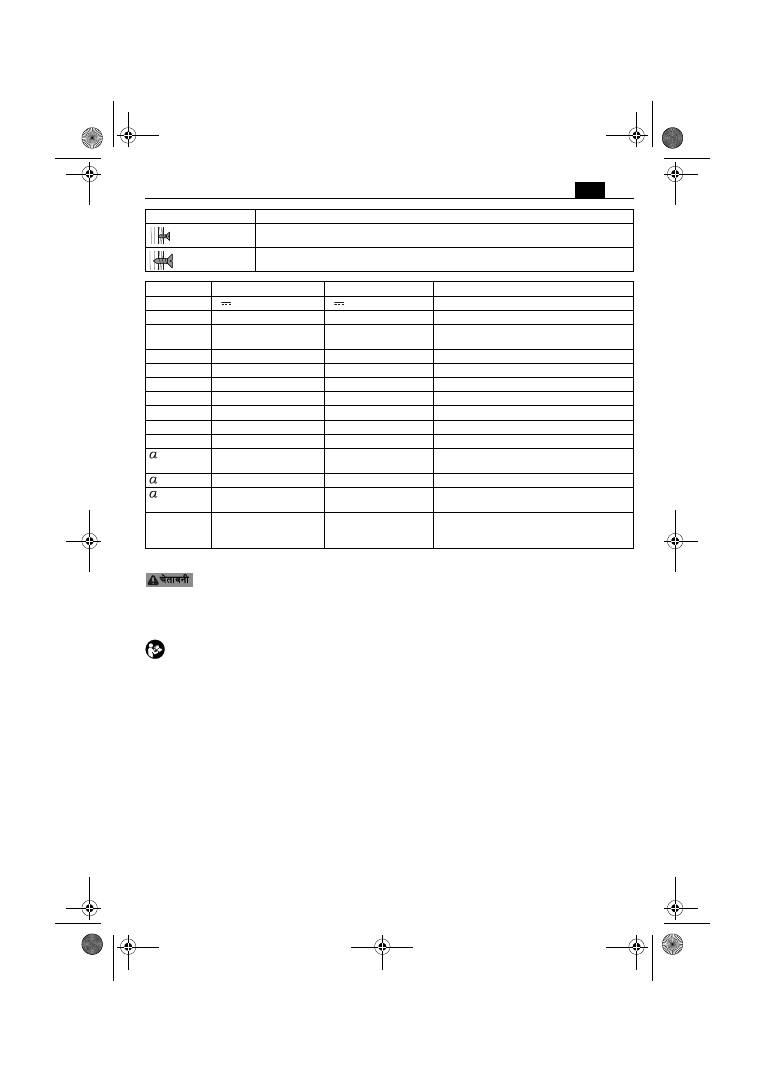
143
hi
आपकी
सुरक्षा
के
िलए
.
समःत
सुरक्षा
सूचनांए
और
िनदेर्श
पढ़े
.
सुरक्षा
सूचनांए
और
िनदेर्शों
का
पालन
नही
करने
से
इलैिक्शक
करंट
,
आग
और
/
या
खतरनाक
चोट
लगने
की
सम्भावना
हो
सकती
है
.
समःत
सुरक्षा
सूचनांए
और
िनदेर्शों
को
भिवंय
के
िलए
संम्भाल
कर
रखें
.
इस
िनदेर्श
और
सलंग्न
"
सामन्य
सुरक्षा
सूचनांए
"
(
लेख
-
बम
नंबर
3 41 30 054 06 1
)
को
पढ़ने
तथा
उनको
सही
समझने
से
पहले
इस
िवद्युत
उपकरण
का
ूयोग
न
करें
.
इन
सूचनाओं
को
भिवंय
में
ूयोग
करने
के
िलए
सम्भाल
कर
रखें
और
िवद्युत
उपकरण
िकसी
और
को
देने
या
बेचने
के
समय
यह
कागजात
अवँय
साथ
दें
.
संबंिधत
राष्टर्ीय
औद्योिगक
सुरक्षा
िनयमों
पर
भी
ध्यान
दें
.
िवद्युत
उपकरण
का
लआय
:
ABS14, ABS18:
हाथ
से
चलाने
वाला
कोडर्लेस
िसल
और
ःबू
-
साई वर
िजसे
FEIN
से
अनुिमत
उपयुक्त
टल्स
और
सहायक
ू
उपकरणों
के
साथ
मौसम
-
रक्षक
वातावरण
में
िबना
पानी
के
पेंच
और
नट
को
कसने
और
खोलने
तथा
धातु
,
लकड़ी
,
प्लािःटक
,
िसरेिमक
में
िसल
करने
और
पेंच
कसने
के
िलए
और
चूड़ी
काटने
के
िलए
उपयोग
िकया
जा
सकता
है
.
ASB14, ASB18:
हाथ
से
चलाने
वाला
कोडर्लेस
हैमर
िसल
िजसे
FEIN
से
अनुिमत
उपयुक्त
टल्स
और
सहायक
उपकरणों
के
साथ
ू
मौसम
-
रक्षक
वातावरण
में
िबना
पानी
के
पेंच
और
नट
कसने
और
खोलने
,
तथा
धातु
,
लकड़ी
,
प्लािःटक
,
िसरेिमक
में
िसल
करने
और
पेंच
कसने
के
िलए
तथा
चूड़ी
काटने
के
िलए
और
इसके
अलावा
कंकरीट
,
पत्थर
और
ईंटों
में
इम्पैक्ट
िसिलंग
के
िलए
उपयोग
िकया
जा
सकता
है
.
िवशेष
सुरक्षा
सूचनांए
.
पॉवर
टल
को
उसके
इन्सुलेिटड
हैंडल
से
पकड़ें
अगर
आप
ू
ऐसा
काम
कर
रहे
हैं
िजस
से
पेच
िछपी
िवद्युत
तारें
को
छू
सके
.
पेच
के
छू
जाने
से
करंट
वाली
िबजली
की
तार
से
मशीन
के
धातुक
िहःसे
पर
भी
करंट
आ
सकता
है
और
इस
से
मशीन
ऑपरेटर
को
इलैिक्शक
करंट
लग
सकता
है
.
िछपे
इलेिक्शकल
,
गैस
या
पानी
के
कनेक्शनों
और
पाइपों
पर
ध्यान
दें
.
कायर्
आरम्भ
करने
से
पहले
कायर्
-
क्षेऽ
को
धातु
-
िडटेक्टर
से
परीक्षण
कर
लें।
अपनी
नीजी
रक्षा
के
िलए
सुरक्षा
िगयर
पहनें
.
काम
करने
की
िबया
अनुसार
फ़ेस
-
शील्ड
,
सुरक्षा
-
चँमे
पहनें
.
िबया
अनुसार
धूल
से
बचने
के
िलए
डःट
-
माःक
,
कानों
की
रक्षा
के
सुरक्षा
-
िगयर
,
सुरक्षा
-
दःताने
या
खास
सुरक्षा
-
एून
पहनें
िजस
से
छोटे
-
छोटे
रगढाई
के
और
काम
करने
वाले
पदाथर्
के
कण
दर
रहें
ू
.
िविभन्न
कायोर्ं
को
करने
के
दौरान
जो
असामान्य
चीज़ें
बाहर
िनकलती
हैं
उनसे
आँखों
की
रक्षा
करने
की
ज़रूरत
होती
है।
इःतेमाल
िकए
जाने
वाले
धूलरोधी
माःक
या
श्वसन
-
मुखौटे
ऐसे
होने
चािहए
,
जो
काम
करने
के
दौरान
बनने
वाली
धूल
को
अवँय
िफ़ल्टर
करें।
बहत
तेज़
शोर
ु
वाले
वातावरण
में
काम
करने
पर
बहरापन
आ
सकता
है
.
िसल
करते
समय
कानों
की
रक्षा
के
िलए
सुरक्षा
-
िगयर
पहनें
.
मशीन
के
शोर
से
आपकी
सुनने
की
शिक्त
खत्म
हो
सकती
है
.
टॉकर्
कम
करना
टॉकर्
बढ़ाना
संकेत
अंतरार्िष्टर्य
मानक
राष्टर्ीय
मानक
ःपष्टीकरण
U
V
V
डीसी
वोल्टेज
f
Hz
Hz
६ीक्वेन्सी
n
0
/min, min
-1
, rpm, r/min
/min
िबना
लोड
पर
गित
(
पूरी
तरह
चाजर्ड
बैटरी
के
साथ
)
n
S
/min, min
-1
/min
इम्पैक्ट
रेट
M...
Nm
Nm
टॉकर्
(
हाडर्
/
साझट
पेचकस
िबया
)
Ø
mm
mm
गोल
िहःसे
का
व्यास
L
pA
dB
dB
साउंड
ूैशर
लेवल
L
wA
dB
dB
साउंड
पावर
लेवल
L
pCpeak
dB
dB
साउंड
ूैशर
का
उच्चतम
लेवल
K...
आशंका
m/s
2
m/s
2
EN 60745
अनुसार
वाईॄेशन
ऐिमशन
मान
(
तीनों
िदशाओं
का
वैक्टर
जोड़
)
h,D
m/s
2
m/s
2
धातु
में
िसल
करने
का
औसतन
वाईॄेशन
मान
h,ID
m/s
2
m/s
2
कंकरीट
में
िसल
करने
का
औसतन
वाईॄेशन
मान
m, s, kg, A, mm, V,
W, Hz, N, °C, dB,
min, m/s
2
m, s, kg, A, mm, V,
W, Hz, N, °C, dB,
min, m/s
2
अंतरार्िष्टर्य
मानक
ूणाली
SI
के
अधािरक
और
व्युत्पन्न
मानक
.
िचन्ह
,
संकेत
ःपष्टीकरण
OBJ_BUCH-0000000105-001.book Page 143 Thursday, April 4, 2013 10:23 AM
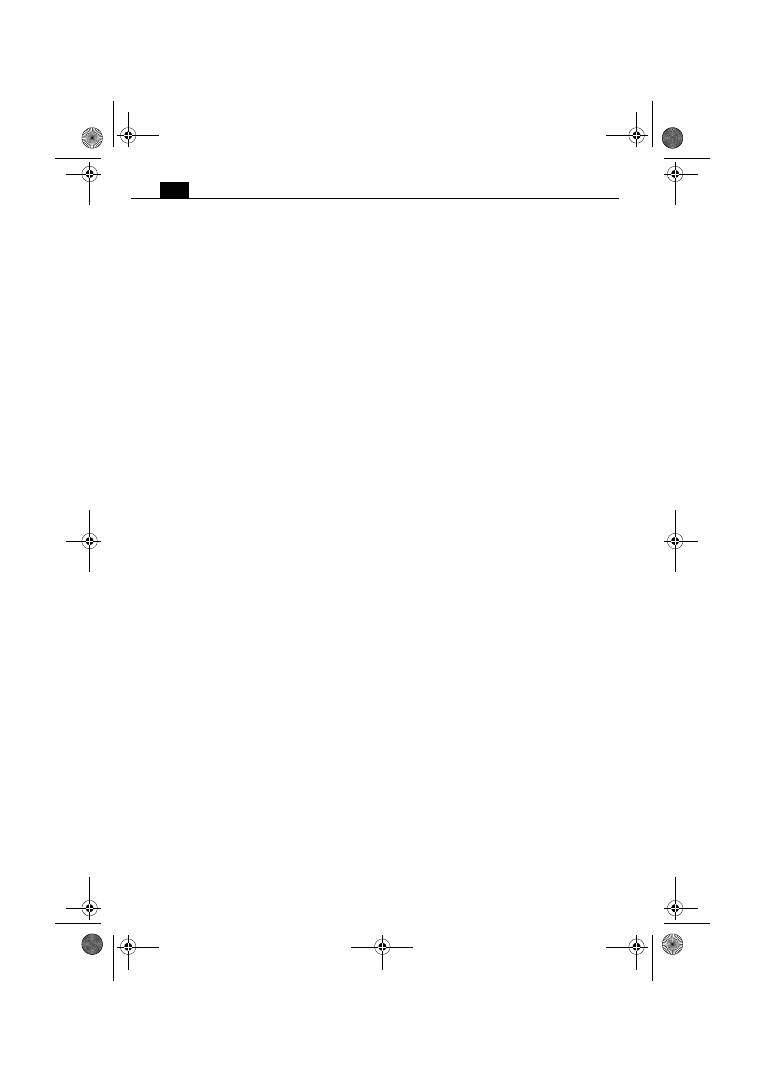
144
hi
काम
करने
वाले
टकड़े
को
जकड़
के
रखें।
ु
अपने
हाथ
में
पकड़ने
से
बेहतर
है
िक
काम
करने
वाला
टकड़ा
िकसी
ु
तानकर
रखने
वाले
उपकरण
में
जकड़
कर
रखा
जाए।
मशीन
को
कस
के
पकड़ें।
कुछ
समय
के
िलए
बहत
उच्च
ु
बल
-
आघूणर्
उत्पन्न
हो
सकते
हैं।
ऐःबेःटॉस
से
िमले
उत्पादनों
के
साथ
काम
न
करें।
ऐःबेःटॉस
से
कैंसर
हो
सकता
है।
मशीनों
पर
पेच
या
कील
से
नाम
-
प्लेट
या
संकेत
लगाना
मना
है।
इलैिक्शक
करंट
लगने
के
समय
टटेु
-
फ़ूटे
रोधक
से
कोई
सुरक्षा
नही
होती
.
िचपकाने
वाली
संकेत
पट्टी
का
ूयोग
करें
.
मशीन
के
साथ
कोई
ऐसे
सहायक
उपकरण
ूयोग
न
करें
जो
इस
कंपनी
के
न
बने
हों
या
िजनका
ूयोग
कंपनी
द्वारा
अनुिमत
न
हों
.
मशीन
पर
िफ़ट
हो
जाने
से
यह
नही
समझा
जा
सकता
िक
सहायक
उपकरण
सुरिक्षत
िबया
में
काम
करेगा।
मशीन
के
वायु
-
िछिों
को
िनयिमत
रूप
से
गैर
-
धातु
यंऽ
के
साथ
साफ़
करें
.
मोटर
का
पंखा
चलने
से
मशीन
के
अंदर
बूरा
चला
जाता
है
.
अिधक
बूरा
जम
जाने
से
िबजली
द्वारा
खतरा
हो
सकता
है
.
कम
दरी
से
लैंप
की
बत्ती
में
कभी
नहीं
देखें
या
ू
घूरें
.
लैंप
की
बत्ती
को
कम
दरी
से
िकसी
व्यिक्त
की
ू
आँखों
में
नहीं
डालें
.
लैंप
की
िकरणें
आँखों
के
िलए
खतरनाक
हो
सकती
हैं
.
टल
को
अपने
शरीर
की
ू
,
अन्य
व्यिक्तयों
की
या
जानवरों
की
ओर
नही
िदखांए
.
नुकीले
या
गमर्
अनुूयोग
उपकरणों
से
चोट
लग
जाने
का
खतरा
है
.
िरचाजेर्बल
बैटरी
का
ूयोग
और
उसकी
देख़
-
रेख़
(
ब्लॉक
बैटरी
)
िरचाजेर्बल
बैटरी
के
ूयोग
में
आग
लगने
से
,
धमाका
होने
से
,
शरीर
के
जलने
से
या
अन्य
ख़तरों
से
बचने
के
िलए
नीचे
िलख़ी
सूचना
पर
अवँय
ध्यान
दें
:
िरचाजेर्बल
बैटरी
को
ख़ोलना
और
तोड़ना
सउत
मना
है।
िरचाजेर्बल
बैटरी
पर
िकसी
ूकार
का
झटका
दे
कर
जोर
न
डालें।
िरचाजेर्बल
बैटरी
के
टटने
ू
-
फ़ूटने
से
और
उसके
दरूपयोग
से
ख़तरनाक
भाप
या
तरल
पदाथर्
का
बाहर
ु
िनकलने
का
ख़तरा
होता
है।
इन
भापों
के
कारण
श्वास
-
मागर्
में
जलन
पैदा
हो
सकती
है।
बाहर
िनकल
रहे
तरल
पदाथोर्ं
से
शरीर
पर
जलन
या
सूजन
हो
सकती
है।
अगर
िरचाजेर्बल
बैटरी
में
से
िनकले
तरल
पदाथर्
कही
आस
-
पास
की
अन्य
वःतुओं
पर
िगर
जाए
या
आस
-
पास
उनकी
कही
छीटें
पड़
जांए
तो
उन
वःतुओं
की
जांच
कर
के
उन्हें
साफ़
कर
दें
या
आवँयकतानुसार
उन्हें
बदल
दें।
िरचाजेर्बल
बैटरी
को
ताप
से
दर
रख़ें
या
आग
में
नही
ू
डालें
.
िरचाजेर्बल
बैटरी
को
धूप
में
न
रख़ें।
िरचाजेर्बल
बैटरी
को
उसकी
पैिकंग
में
से
तब
बाहर
िनकालें
जब
उसका
ूयोग
करना
हो
.
मशीन
में
कोई
काम
करने
से
पहले
िरचाजेर्बल
बैटरी
को
मशीन
में
से
बाहर
िनकाल
लें।
नही
तो
मशीन
के
अचानक
चल
जाने
से
चोट
लगने
का
ख़तरा
हो
सकता
है।
िरचाजेर्बल
बैटरी
को
मशीन
में
से
तब
बाहर
िनकाले
जब
मशीन
ऑफ़
हो
.
िरचाजेर्बल
बैटरी
को
बच्चों
से
दर
रख़ें
ू
.
िरचाजेर्बल
बैटरी
को
साफ़
तथा
पानी
और
नमी
से
दर
ू
रख़ें।
िरचाजेर्बल
बैटरी
और
मशीन
के
गंदे
हो
गये
कनेक्षन
को
िकसी
सूख़े
और
साफ़
कपड़े
से
साफ़
कर
दें।
केवल
FEIN
कंपनी
की
ठीक
-
ठाक
और
ऑिरजनल
िरचाजेर्बल
बैटिरयों
का
ूयोग
करें
जो
आपकी
मशीन
के
िलए
उिचत
हैं।
गलत
,
टटी
ू
-
फ़ूटी
,
िरपेयर
या
दररूःत
की
ु
गयी
अन्य
कंपिनयों
की
या
नकल
से
बनायी
गयी
बैटिरयों
के
ूयोग
से
या
उन्हें
िरचाजर्
करने
से
आग
लगने
का
और
धमाका
होने
का
ख़तरा
हो
सकता
है।
बैटरी
-
चाजर्र
के
ूयोग
करने
के
िनदेर्शों
और
सुरक्षा
सूचनाओं
का
पालन
करें
.
हाथ
-
बाजू
में
वाईॄेशन
इन
सूचनाओं
में
िदयावाईॄेशन
-
लेवल
EN 60745
मानदंड
अनुसार
मापा
गया
है
और
िवद्युत
मशीनों
की
आपस
में
तुलना
करने
मेंूयोग
िकया
जा
सकता
है
.
उसे
वाईॄेशन
-
लेवल
की
जांच
करने
के
िलए
भी
अन्तिरम
रूप
से
ूयोग
िकया
जा
सकता
है
.
िलखा
गया
वाईॄेशन
-
लेवल
पॉवर
टल
की
मुख्य
िबया
ू
में
ूदिशर्त
िकया
गया
है
.
अगर
पॉवर
टल
को
अन्य
ू
िबयाओं
,
िभन्न
यंऽों
या
खराब
हालत
के
उपकरणों
के
साथूयोग
िकया
जाए
तो
वाईॄेशन
-
लेवल
बदल
भी
सकता
है
.
इस
से
काम
की
पूरी
अविध
में
वाईॄेशन
-
ऐिमशन
काफ़ी
बढ़
सकती
है
.
वाईॄेशन
-
ऐिमशन
का
सही
अनुमान
लगाने
के
िलए
वह
समय
भी
ध्यान
में
रखना
चािहए
जब
पॉवर
टल
का
िःवच
ू
बंद
यािन
ऑफ़
है
या
चाहे
ऑन
भी
हो
,
लेिकन
पॉवर
टल
ू
ूयोग
नही
हो
रहा
हो
.
इससे
काम
की
पूरी
अविध
में
वाईॄेशन
-
ऐिमशन
काफ़ी
कम
हो
जाती
है
.
ऑपरेटर
को
वाईॄेशन
के
असर
से
बचाने
के
िलए
सुरक्षा
के
अन्य
उपाय
ूयोग
करें
जैसे
िक
िवद्युत
उपकरणों
कीिनयिमत
देख
-
रेख
करना
,
हाथों
को
गमर्
रखना
और
कायर्
-
िबयाओं
का
ठीक
आयोजन
करना
.
ख़तरनाक
बुरादे
के
साथ
चाल
-
चलन
इस
मशीन
के
साथ
काम
करते
समय
जब
पदाथर्
हटाये
जाते
हैं
,
तो
वहां
धूल
और
बुरादापैदा
होने
से
ःवाःथ्य
को
हािन
पहंच
सकती
है
ु
.
िभन्नबुरादों
पर
हाथ
लगने
से
या
उनके
सांस
लेने
से
जैसे
ऐःबेःटॉसया
ऐःबेःटॉस
से
िमले
उत्पाद
,
िससे
की
परतें
,
धातु
,
कई
ूकार
की
लकिड़यां
,
ख़िनज
पदाथर्
,
पत्थर
के
पदाथर्
िजन
में
िसिलकेट
कण
हों
,
पेंट
सॉलवंट
,
लकड़ी
संरक्षक
,
समुिी
जहाजों
की
दगर्न्ध
से
रक्षा
करने
के
पेंट
ु
-
इन
सब
से
ऑपरेटर
या
आस
-
पास
ख़ड़े
लोगों
को
एलजीर्
हो
सकती
है
और
श्वास
-
रोग
,
केंसर
,
पैदाइशी
रोग
या
अन्य
जननीय
रोग
हो
सकते
हैं
.
रोग
का
ख़तरा
सांस
से
ली
गयी
बुरादे
की
माऽा
पर
िनभर्र
होता
है
.
काम
करते
समय
िनकल
रही
बुरादे
की
धूल
को
उपयुक्सक्शन
पंप
के
ूयोग
से
हटांए
और
अपने
िनजी
बचाव
के
िलए
सुरक्षा
िगयर
पहनें
और
कायर्
-
ःथल
पर
वायुसंचार
का
ूबंध
करें
.
ऐःबेःटॉस
से
िमले
पदाथोर्ं
का
काम
इस
क्षेऽ
के
िवशेषज्ञ
पर
छोड़
दें
.
लकड़ी
और
हल्के
धातुयों
की
धूल
,
बुरादों
के
तप्त
िमौण
और
रासायिनक
पदाथर्ूितकूल
िःथित
में
सुलग
सकते
हैं
या
धमाका
उत्पन्न
कर
सकते
हैं
.
धूल
जमा
करने
वाली
थैली
को
िचंगािरयों
सेबचांए
तथा
ध्यान
रहे
िक
मशीन
और
वह
वःतु
िजस
पर
काम
िकया
जा
रहा
हो
,
ज्यादा
गमर्
न
हो
जांए
.
समय
पर
धुल
की
थैली
को
ख़ाली
कर
दें
और
पदाथर्
िनमार्ताके
िनदेर्शों
का
पालन
करें
तथा
अपने
देश
में
लागू
िनयमों
का
पालन
करें
जो
ूयोग
िकए
जा
रहे
पदाथोर्ं
के
िलए
मान्य
है
.
OBJ_BUCH-0000000105-001.book Page 144 Thursday, April 4, 2013 10:23 AM
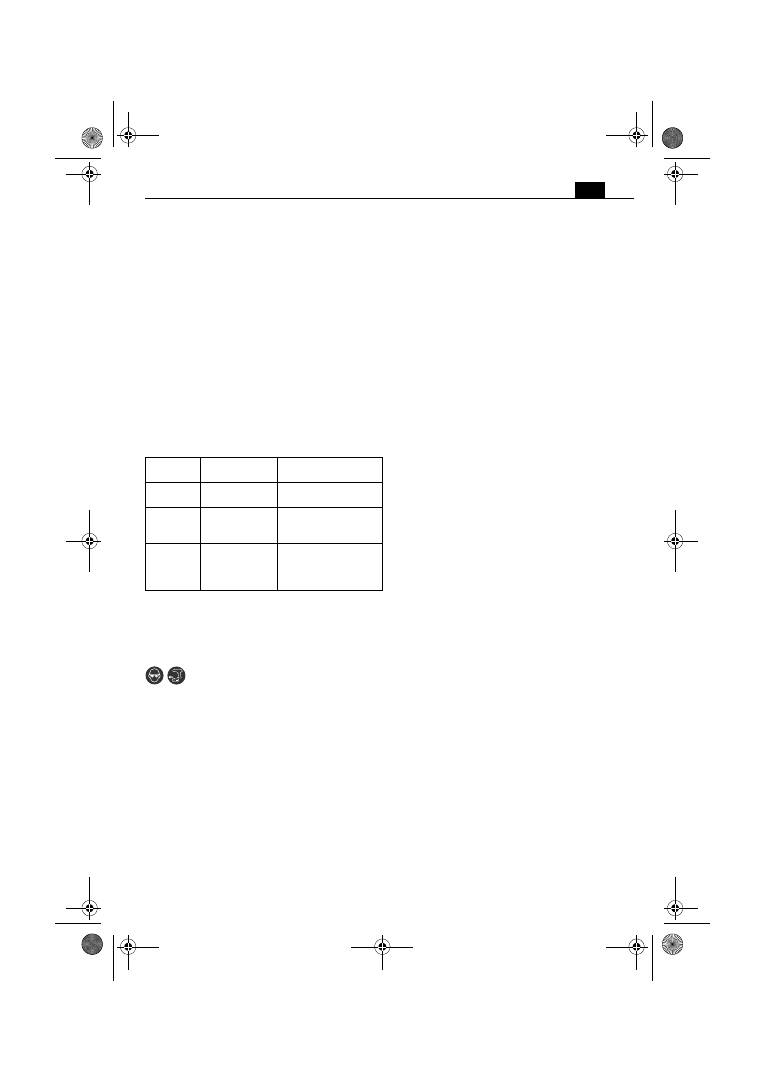
145
hi
मशीन
चलाने
के
िनदेर्श
.
मशीन
के
िबल्कुल
रुक
जाने
के
बाद
ही
घुमाने
वाला
डायरेक्षन
िःवच
और
िगयर
िःवच
सेट
करें
.
िगयर
िसलेक्टर
िःवच
को
ःटॉप
तक
दबाना
होगा
और
ऑपरेशन
मोड
िसलेक्टर
िःवच
(ASB14/18)
को
ःटॉप
तक
घुमाना
होगा
.
नहीं
तो
मशीन
को
नुकसान
हो
सकता
है
.
ओवरलोड
हो
जाने
पर
मशीन
ऑफ
हो
जाती
है
.
तािक
टल
अचानक
ना
चल
जाये
जैसे
िक
शांसपोटर्
के
ू
समय
,
इसिलए
रोटेशन
ःलेक्टर
िःवच
को
सेंटर
पोिसशन
पर
सेट
कर
दें
.
टॉकर्
सेट
करना
फ़ैक्टरी
से
मशीन
को
छोटे
से
मध्य्म
आकार
के
पेचों
के
िलए
सेट
िकया
गया
है
.
कसने
का
टॉकर्
उस
बल
पर
िनधर्र
है
िजससे
मशीन
को
पेच
पर
लगाया
जाता
है
.
िरचाजेर्बल
बैटरी
का
ूयोग
िरचाजेर्बल
बैटरी
को
केवल
िरचाजर्
करने
के
तापमान
क्षेत ्
0 °C – 45 °C (32 °F – 113 °F)
में
िरचाजर्
करें
.
िरचाजर्
करने
की
िबया
में
बैटरी
का
तापमान
िरचाजर्
करने
के
तापमान
क्षेऽ
में
होना
चािहए
.
िरचाजेर्बल
बैटरी
का
सही
बैटरी
ःटेटस
केवल
तब
देखा
जा
सकता
है
जब
टल
की
मोटर
बंद
हो
ू
.
बैटरी
को
डीप
िडःचाजर्
करने
के
समय
मशीन
की
इलेक्शोिनक
अपने
आप
बंद
हो
जाती
है
.
िरपेयर
और
सिवर्स
.
जोिख़म
िःथित
में
धातु
के
साथ
काम
करने
से
इलेिक्शक
मशीन
के
अंदर
कॉनडिक्टव
बुरादा
इकठ्ठा
हो
सकता
है
.
मशीन
के
वायु
िछिों
में
िनयिमत
रूप
से
सूख़ी
और
तेल
-
रिहत
कोम्ूेसड
हवा
फ़ूंक
दें
.
इस
पावर
टल
के
ःपेयर
पाट्सर्
की
वतर्मान
सूची
ू
आपको
इंटरनेट
में
www.fein.com
में
देखने
को
िमलेगी
.
आवँयकता
अनुसार
नीचे
िलखे
पाट्सर्
बदले
जा
सकते
हैं
:
टल
पर
लगाने
वाले
उपकरण
ू
,
िरचाजेर्बल
बैटरी
गारंटी
और
िजम्मेवारी
.
िजस
देश
में
मशीन
बेची
जाती
है
उस
देश
के
कानूनी
िनयमों
अनुसार
गारंटी
मान्य
होगी
.
इसके
अलावा
FEIN
द्वारा
FEIN
उत्पादक
गारंटी
भी
दी
जाती
है
.
सिचऽ
और
िववरण
के
साथ
दशार्ए
गये
सहायक
उपकरण
ःटेन्डडर्
िडिलवरी
में
सदा
शािमल
नही
िकए
जाते।
अनुरूपता
का
ःपष्टीकरण
.
FEIN
कंपनी
एकमाऽ
िजम्मेदार
है
िक
इस
उत्पाद
की
अनुरूपता
िनदेर्श
के
आिखरले
पॄष्ठ
पर
िलखे
िनयमों
अनुसार
है
.
तकनीकी
डेटा
यहां
उपलब्ध
है
:
C. & E. FEIN GmbH,
C-DB_IA, D-73529 Schwäbisch Gmünd
पयार्वरण
सुरक्षा
,
पुन
:
उपयोग
.
पैिकंग
सामान
,
खराब
िवद्युत
टल
और
उनके
पाटर्स
को
ू
पयार्वरण
की
रक्षा
हेतु
पुन
:
उपयोग
के
िलए
अलग
कर
दें
.
बैटरी
केवल
िडःचाजर्
िःथित
में
उपयुक्त
ःथान
पर
फ़ेंके
.
वे
िरचाजेर्बल
बैटिरयां
जो
पूरी
तरह
से
िडःचाजर्
नही
की
गयी
हो
,
उनके
पोल
पर
टेप
लगा
दें
तांिक
कही
शाटर्
सकर्ट
न
हो
जाए
.
एलईडी
िडसप्ले
इसका
अथर्
है
िबया
1
–
4
हरी
एलईडी
फ़ीसदी
अनुसार
चाजर्ड
बैटरी
कायर्
-
िविध
जल
रही
लाल
बत्ती
िरचाजेर्बल
बैटरी
िबल्कुल
खाली
हो
रही
है
िरचाजेर्बल
बैटरी
को
िरचाजर्
करें
लाल
चमचमाता
इिन्डकेटर
िरचाजेर्बल
बैटरी
ूयोग
के
िलए
तैयार
नही
है
िरचाजेर्बल
बैटरी
को
िरचाजर्
करने
के
तापमान
क्षेऽ
में
लाएं
,
उसके
बाद
िरचाजर्
करें
OBJ_BUCH-0000000105-001.book Page 145 Thursday, April 4, 2013 10:23 AM
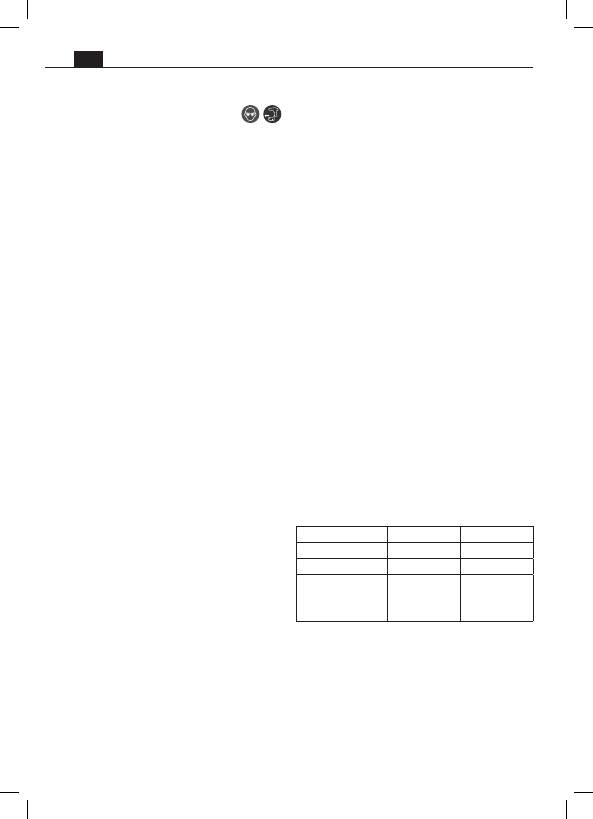
146
ar
ةبرغأ نم ةلكشتلما ةنخاسلا طئلالخاو ةفيفلخا نداعلما ةبرغأو بشلخا ةبرغأ نإ
ةمئلام يرغلا فورظلا في اهسفن ءاقلت نم لعتشت دق ةيومايكلا داولماو خللجا
رابغلا ءاعو هاتجا لىإ رشرلا رياطت بنتج .راجفنلاا لوصح لىإ يدؤت دق وأ
تقولا في رابغلا ءاعو غرفأو ،خللجا ددعو ةيئابرهكلا ةدعلا ءاحمإ ةدايز اضيأو
ماكحلأا اضيأو لغشلا ةدام جِتنم فرط نم ةلجاعلما تاظحلام ىعارت .بسانلما
.اهتلجاعم بوغرلما داولما ددصب مكدلب في ةيراسلا
.ليغشتلا تاداشرإ
امدنع طقف ةعسرلا سرت رايتخا حاتفمو نارودلا هاتجا يريغت حاتفم نم لك رادي
.ةكرلحا نع افقوتم كرحلما نوكي
ليغشتلا عون رايتخا حاتفم لتفا وأ ةعسرلا سرت رايتخا حاتفم عفدا
ديقتت لم نإ ةيئابرهكلا ةدعلا فلتت دق .مداصتلا دح لىإ مائاد
(ASB14/18)
.كلذب
.ليمحتلا طرف دنع ةيئابرهكلا ةدعلا أفطت
ليغشتلا بنجتت يكل ،طسوتلما عضولا لىع نارودلا هاتجا ليوتح حاتفم زكر
.لاثم لقنلا ءانثأ ،دوصقم يرغلا
نارودلا مزع طبض
ةطسوتلما بلاوللا دح لىإ ةيرغصلا بلاوللا لامج جتنلما فرط نم طبضلا قفاوي
.طقف
وحن ةيئابرهكلا ةدعلا ابه طغضت يتلا ةوقلاب اضيأ دشلا نارود مزع قلعتي
.بلوللا
.مكرلما ةلماعم
ليغشت ةرارح ةجرد لامج نمض دجاوتي امدنع طقف مكرلما نحشاو لغش
بيج .)ةيتيانهرف ةجرد
113
لىإ
32
( ةيوئم ةجرد
45
لىإ
0
نم ةغلابلا مكرلما
ةيادب ذنم مكرلما ليغشت ةرارح ةجرد لامج نمض مكرلما ةرارح ةجرد نوكت نأ
.نحشلا ةيلمع
لمعلا
ىنعلما
ءضيلما شرؤلما
ليغشتلا
ةيبسن نحش ةلاح
ضرخأ ءوض
1 – 4
مكرلما نحشا
غراف هبش مكرلما
رمتسم رحمأ ءوض
ةجرد لامج لىإ مكرلما لقنا
مث ،مكرلما ليغشت ةرارح
هنحشا
زهاج يرغ مكرلما
ليغشتلل
قافخ رحمأ ءوض
ةدعلا كرمح نوكي امدنع طقف ةيقيقلحا ةيبسنلا مكرلما نحش ةلاح ضرعت
.ةكرلحا نع افقوتم ةيئابرهكلا
.مكرلما غيرفت طارفإ لبق ليآ لكشب كرحلما ءافطإب ةينوتركللاا تازيهجتلا موقت
.ةمدلخاو ةنايصلا
ةلجاعم دنع ةيئابرهكلا ةدعلا لخاد لقانلا رابغلا بستري دق
ةدعلاب ليخادلا لاجلما خفنا .ةديدشلا لمعلا طوشرب نداعلما
ليالخاو فالجا طوغضلما ءاولها ةطساوب ةيوهتلا قوقش برع ماظتناب ةيئابرهكلا
.تيزلا نم
عقومب تِنترنلإا في ةيئابرهكلا ةدعلا هذله ةنهارلا رايغلا عطق ةمئاق لىع رثعُي
.
www.fein.com
:ةروضرلا دنع كسفنب ةيلاتلا عطقلا لدبتست نأ كنكمي
مكرلما ،لغشلا ددع
.نماضلاو ةلافكلا
دلب في ةينوناقلا ماكحلأا بسح لوعفلما ةيراس جتنلما اذله ةبسنلاب ةلافكلا نإ
نماض حيصرت بسح نماضلا حنتم نياف ةكشر نإف ،كلذ نع ةفاضإ .عيزوتلا
.نياف جِتنلما
عباوتلا نم طقف ةدحاو ةعطق ةيئابرهكلا كتدع ميلست راطإ نمضتي دق
.هذه ليغشتلا تمايلعت في ةموسرلما وأ ةفوصولما
.قفاوتلا حيصرت
ماكحلأا عم قفاوتي جتنلما اذه نأب ةصالخا اهتيلوؤسم لىع نياف ةكشر حصرت
.هذه ليغشتلا تمايلعتب ةيرخلأا ةحفصلا لىع ةروكذلما ةينعلما
C. & E. FEIN GmbH, C-DB_IA,
:ىدل ةينفلا قارولأا
D-73529 Schwäbisch Gmünd
.ةدعلا نم صلختلا ،ةئيبلا ةياحم
ةفصنم ةقيرطب ةيلابلا عباوتلاو ةيئابرهكلا ددعلاو فيلغتلا نم صلختلا يغبني
.عينصتلا ةداعلإ ةلباقلا تايافنلا قيرط نع ةئيبلاب
.ةغراف نوكت امدنع طقف يماظن لكشب مكارلما نم صلتخ
ةغراف مكارلما نكت لم نإ ةرادلا يرصقت بنجتل قصلا طيشرب طبرلا ةلصو لزعا
.لماك لكشب

147
ar
.ةصاخ نامأ تاظحلام
نم يتلا لماعلأا ءارجإ دنع ةلوزعلما ضبقلا حوطس لبق نم زاهلجاب كسما
عم بلوللا سملات نإ
.ةيفخلما ةيئابرهكلا طوطلخا بلوللا ابه بيصي نأ زئالجا
لىإ يدؤيف ،زاهلجاب ةيندعم ءازجأ اضيأ برهكي دق يئابرهك دهج هب يسري طخ
.ةيئابرهك ةمدص
لمعلا لامج صحفا
.ةيفخلما ءالماو زاغلا بيبانأو ةيئابرهكلا طوطلخا لىإ هبتنا
.لاثم نداعلما نع بيقنتلا زاهج ةطساوب ،لمعلاب ءدبلا لبق
ةيقاوو ،هجولل ةلماك ةياقو لماعتسلاا بسح مدختسا .صيخش ةياقو داتع دترا
ةيقاوو رابغلا نم ةياقولل عانق ةروضرلا دنع دترا .ةيقاو تاراظن وأ يننيعلل
داولماو خيلجتلا تمايسج كنع دعبي صاخ لويرم وأ ةيقاو تازافقو عمس
نع جتنت يتلا ةرياطتلما ةبيرغلا تمايسلجا نم يننيعلا ةياقو يغبني
.ةقيقدلا
رابغلا نم ةيقاولاو سفنتلل ةيقاولا ةعنقلأا موقت نأ بيج .ةفلتخلما تلاماعتسلاا
تضرعت نإ عمسلا نادقفب باصت دق .مادختسلاا نع ةتجانلا ةبرغلأا حيشترب
.ةليوط ةترفل لاع جيجضل
نادقف لىإ جيجضلا يرثأت يدؤي دق
.قدلاب قفرلما بقثلا ءانثأ عمس ةيقاو دترا
.عمسلا ةردق
ةزيهتج وأ ةمزلم ةطساوب اهتيبثت مت يتلا لغشلا ةعطق تبثت
.لغشلا ةعطق نمأ
.كديب اهتيبثت مت يتلا نع بركأ نامأب طمق
تاترفل ةيلاع لعف در موزع لكشتت دق
.ماكحإب ةيئابرهكلا ةدعلاب كسما
.ةيرصق
اببسم سوتسبسلأا برتعي
.سوتسبسلأا لىع يوتتح يتلا داولما جلاعت لا
.ناطسرلل
يرماسم وأ يغابرلا ةطساوب ةيئابرهكلا ةدعلاب تاراشلإا وأ تاتفلالا طبر عونمم
تاتفلالا مدختسا .ةيئابرهكلا تامدصلا نم يقي لا فلاتلا لزعلا نإ
.ةمشبرلا
.ةقصلالا
ةدعلا جِتنم الهماعتساب حمسي لم يتلا وأ اهروطي لم يتلا عباوتلا مدختست لا
ةيئابرهكلا كتدع لىع عباوتلا بيكرت ةيناكمإ درمج نإ
.صاخ لكشب ةيئابرهكلا
.نامأب اهليغشت ةيناكمإ نمؤي لا
لكشب ةيندعم يرغلا لغشلا ددع ةطساوب ةيئابرهكلا ةدعلاب ةيوهتلا تاحتف فظن
لىإ كلذ يدؤي دق .لكيلها لخاد لىإ رابغلا طفشي كرحلما خافنم نإ
.مظتنم
.ديدش لكشب ةيندعلما ةبرغلأا عمتج لاح في ةيئابرهكلا رطاخلما
ءوض هجوت لا .ادبأ بثك نع ةيئابرهكلا ةدعلا حابصم ءوض لىإ كرظن هجوت لا
عاعشلإا نإ
.ةبرقم لىع نيدوجولما نيرخلآا صاخشلأا نويع وحن حابصلما
.يننيعلا ضري دق حابصلما هجتني يذلا
.تاناويلحا وأ نيرخلآا صاخشلأا وحن وأ كسفن لىع ةيئابرهكلا ةدعلا هجوت لا
.ةنخاسلا وأ ةدالحا لغشلا ددع للاخ نم حورجب ةباصلإا رطخ لكشتي
)مكرلما ةلتك( مكرلما ةلماعمو مادختسا
قاترحلااك مكرلماب لماعتلا ءانثأ رطاخلما بنجتل ةيلاتلا تاظحلالما ةاعارم بيج
:تاباصلإا نم اهيرغو ةشربلا ةباصإو تاراجفنلااو قيرلحا علادناو
.ةيكيناكيلما تامدصلل مكارلما ضرعت لا .مكارلما ميطتحو حتف وأ كف زويج لا
همادختسا دنع وأ مكرلما فلت دنع ةراضلا لئاوسلاو ةرخبلأا بسرتت دق
لئاس نإ .ةيسفنتلا يراجلما جيته دق ةرخبلأا هذه نإ .ةحيحص يرغ ةقيرطب
.قاترحلاا وأ ةشربلا جيته لىإ يدؤي دق بسرتلما مكرلما
صحفاف ،ةروامج ضارغأ فلاتلا مكرلما نم ةبسرتلما لئاوسلا تسملا نإ
.ةروضرلا دنع الهدبتسا وأ اهفظنو ةباصلما ءازجلأا
.ةشرابلما سمشلا ةعشأب مكرلما نزخب موقت لا .رانلا وأ ةرارحلل مكرلما ضرعت لا
.هلمعتست نأ ديرت امدنع لاإ ليصلأا فيلغتلا نع مكرلما جرتخ لا
دق
.ةيئابرهكلا ةدعلاب لماعلأا ءارجإ لبق ةيئابرهكلا ةدعلا نع مكرلما عزنا
.دوصقم يرغ لكشب ةيئابرهكلا ةدعلا ةرادإ مت نإ حورجب ةباصلإا رطخ لكشتي
.ةأفطم نوكت امدنع طقف ةيئابرهكلا ةدعلا نع مكرلما عزنا
.لافطلأا نع مكرلما داعبإ لىع ظفاح
تلاصولا فظن
.ءالماو ةبوطرلا نم هتياقو لىعو مكرلما ةفاظن لىع ظفاح
.ةفاجو ةفيظن شماق ةعطق ةطساوب ةيئابرهكلا ةدعلابو مكرلماب ةخستلما
دق
.ةيئابرهكلا كتدعل ةصصخلماو ةميلسلا ةيلصلأا نياف مكارم طقف مدختسا
مكارلما ةطساوب لمعلا وأ نحش دنع راجفنلاا وأ/و قاترحلاا رطخ لكشتي
.عنصلا ةبيرغلاو ةدلقلماو ،اهتلجاعم وأ اهحيلصت داعلما ،ةفلاتلا ،ةئطالخا
.مكرلما نحش زاهج ليغشت تمايلعتب ناملأا تاظحلامب ديقت
عارذلا-ديلا تازازتها
سايق تاءارجا نمض تمايلعتلا هذه في روكذلما تازازتهلاا ىوتسم سايق مت
ةيئابرهكلا ددعلا ةنراقلم همادختسا نكميو
EN 60745
بسح ةيرايعم
.يئدبم لكشب تازازهلال ضرعتلا ىدم ريدقتل اضيأ حلصيو .اهضعبب
ةدعلل ةيساسلأا لماعتسلاا تلاامج روكذلما تازازتهلاا ىوتسم لثمي
ددعبو ىرخأ تلاماعتسلا ةيئابرهكلا ةدعلا مادختسا مت ول امأ .ةيئابرهكلا
.كلذ نع فلتيخ دق تازازتهلاا ىوتسم نإف ،ةيفاك يرغ ةنايصب وأ ةفلامخ لغش
.لمعلا ةدم لماك برع حوضوب تازازتهلال ضرعتلا ىدم كلذ ديزي دق
تاترفلا ةاعارم اضيأ يغبني قيقد لكشب تازازتهلال ضرعتلا ىوتسم ريدقتل
.لاعف هتطساوب لمعلا نود نكلو هترادإ ابه مت يتلا وأ زاهلجا ءافطإ ابه مت يتلا
.لمعلا ةدم لماك برع حوضوب تازازتهلال ضرعتلا ىدم كلذ ضفيخ دق
ةنايص :لاثم ،تازازتهلاا يرثأت نم مدختسلما ةياقول ةيفاضإ نامأ تاءارجا ددح
.لمعلا ىرمج ميظنتو نيديلا ةئفدت ،لغشلا ددعو ةيئابرهكلا ةدعلا
ةضرلما ةبرغلأا عم لماعتلا
،ةدعلا هذه ةطساوب لغشلا ةدام ةحازإب موقت يتلا لمعلا تايرمج ذيفنت دنع
.ةيرطخ نوكت دق يتلا ةبرغلأا لكشتت
يتلا داولماو سوتسبسلأا ةبرغأ :لاثم ،ةبرغلأا ضعب قاشنتسا وأ ةسملام نإ
عاونأ ضعبو نداعلماو صاصرلا لىع يوالحا ءلاطلاو سوتسبسلأا لىع يوتتح
داولماو رجلحا لىع ةيوالحا داولما نم تاكيليسلا تائيزجو تازلفلاو بشلخا
يدؤي دق ،براوقلا لفس ةياقو ءلاطو بشخلل ةيقاولا داولماو ،ءلاطلل ةلحلما
ةيسفنتلا يراجلما ضارمأ وأ/و ةيسستح لعف دودر لىإ صاخشلأا ضعب ىدل
ضرعتلا ىدمب ةبرغلأا قاشنتسا ةروطخ قلعتت .ةيثارولا راضرلأاو ناطسرلاو
ةيوته نمأو صيخش ةياقو داتع اضيأو جتانلا رابغلل ةمئلام ةطفاش مدختسا .اله
ابه موقيل سوتسبسلأل ةيوالحا داولما ةلجاعم لماعأ كرتا .لمعلا ناكلم ةديج
.طقف ينصصختلما لماعلا
Оглавление
- .ليغشتلا تاداشرإ
- .كتملاس لجأ نم
- .ةمدختسلما تاحلطصلماو تاراصتخلااو زومرلا

